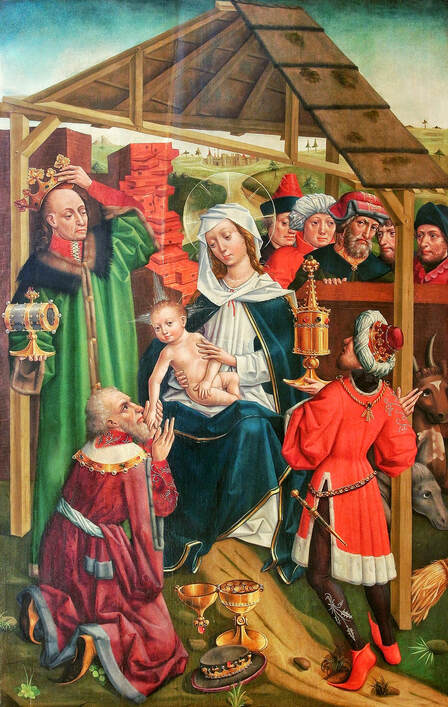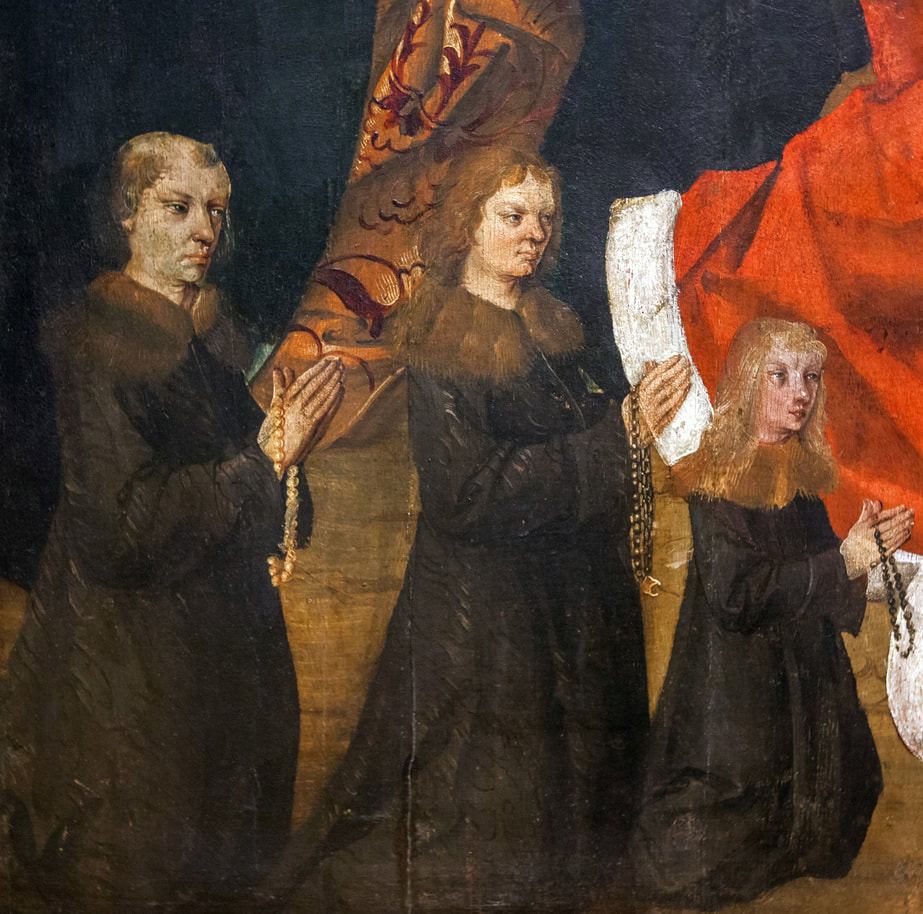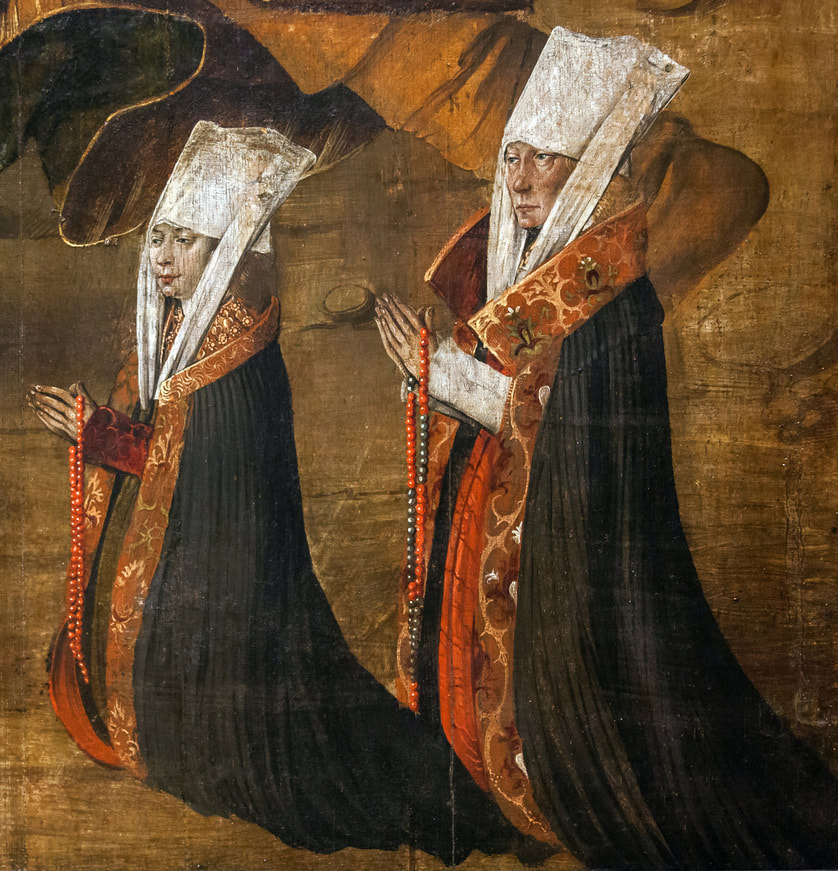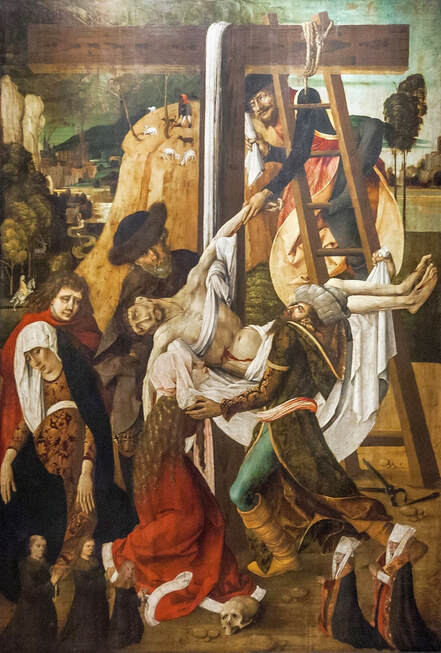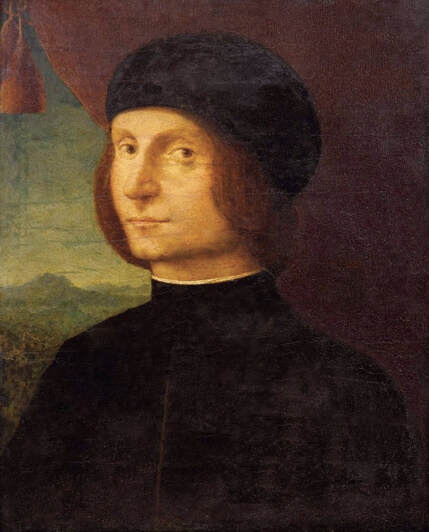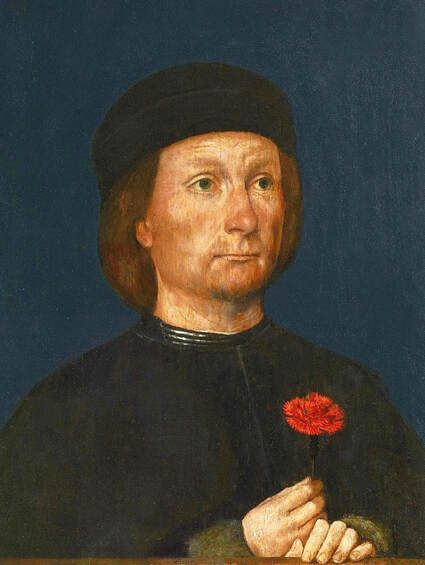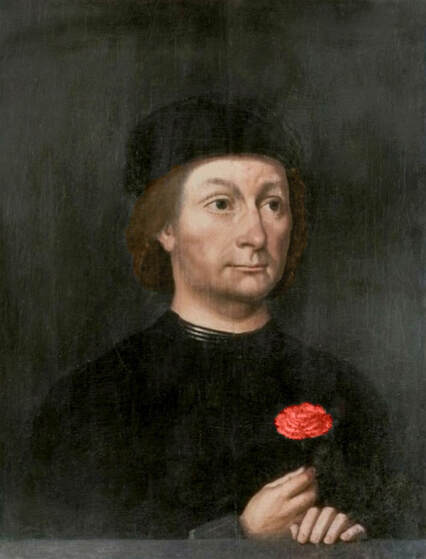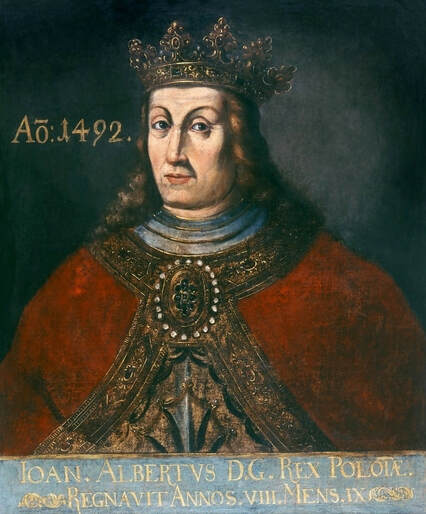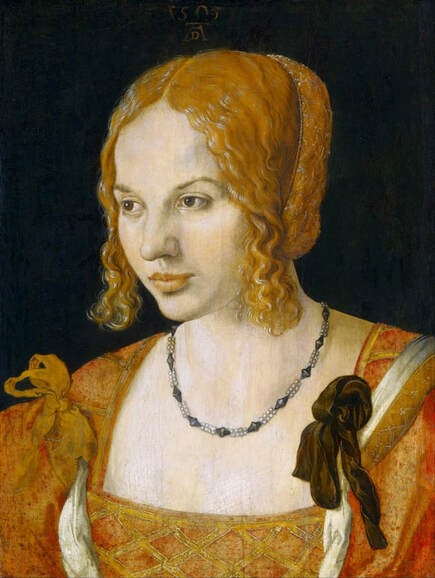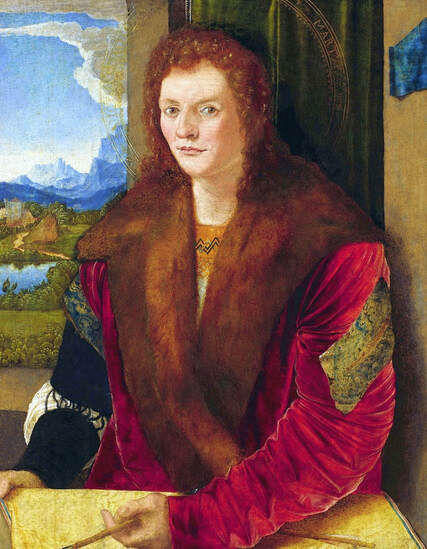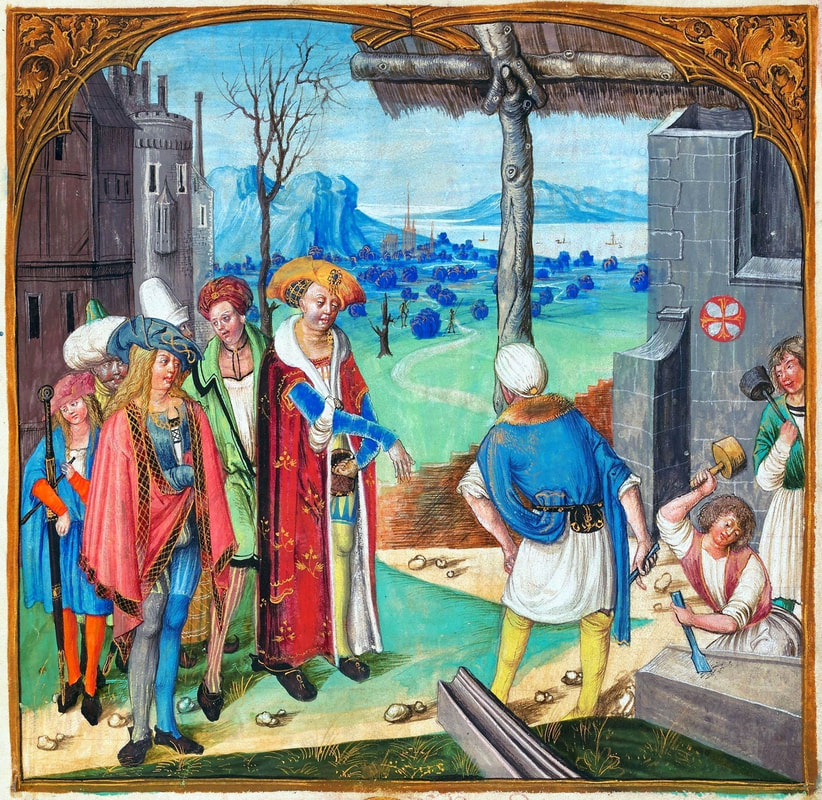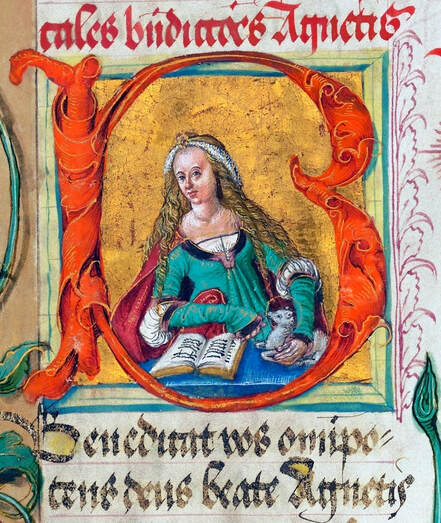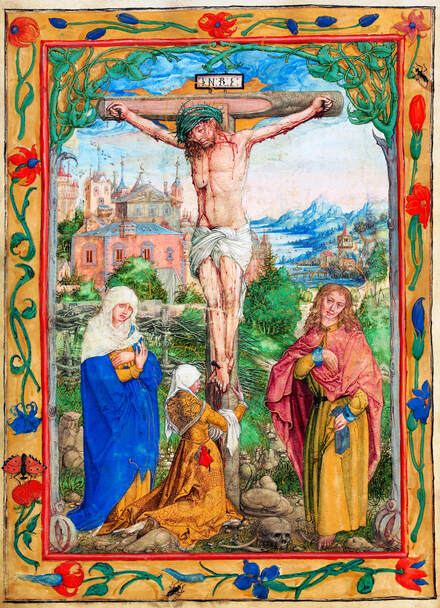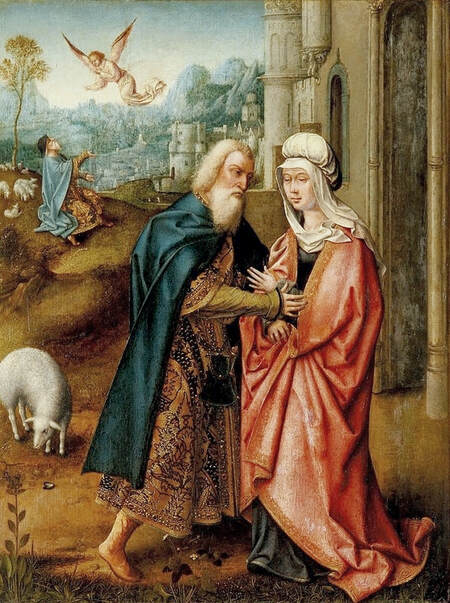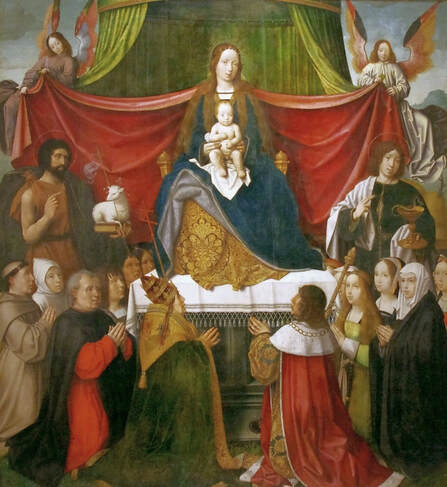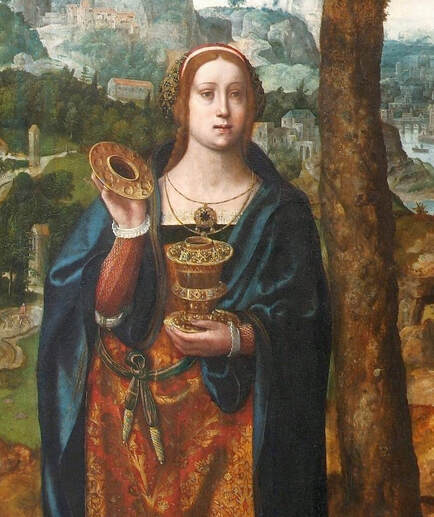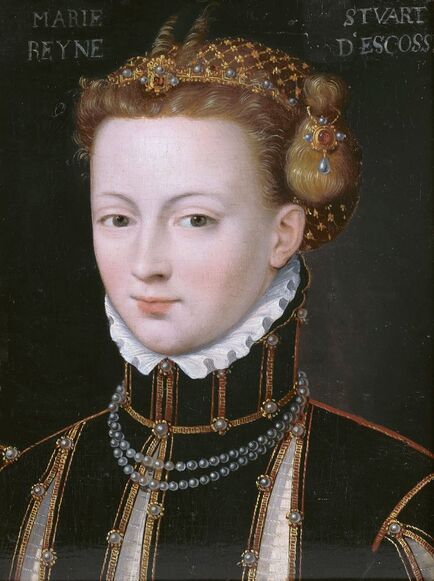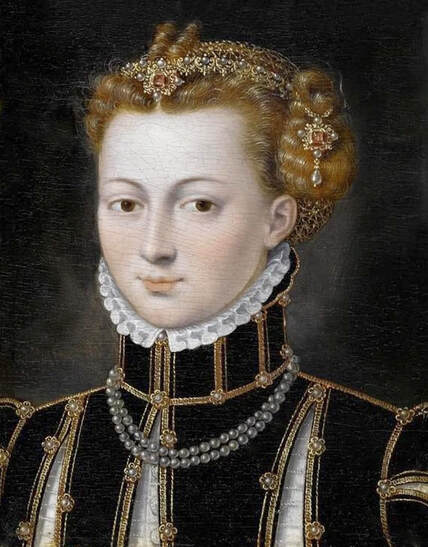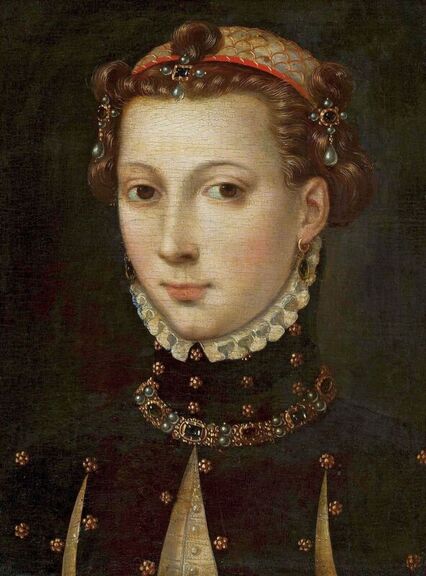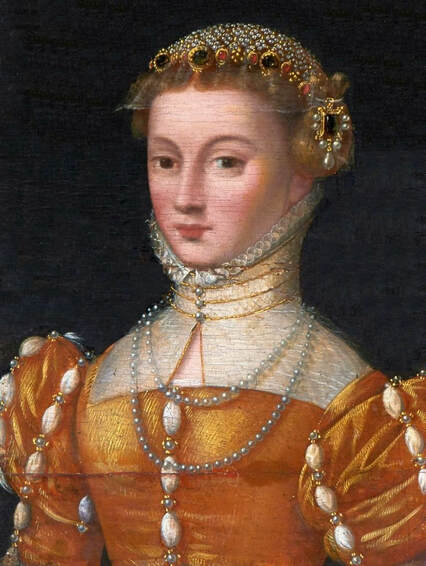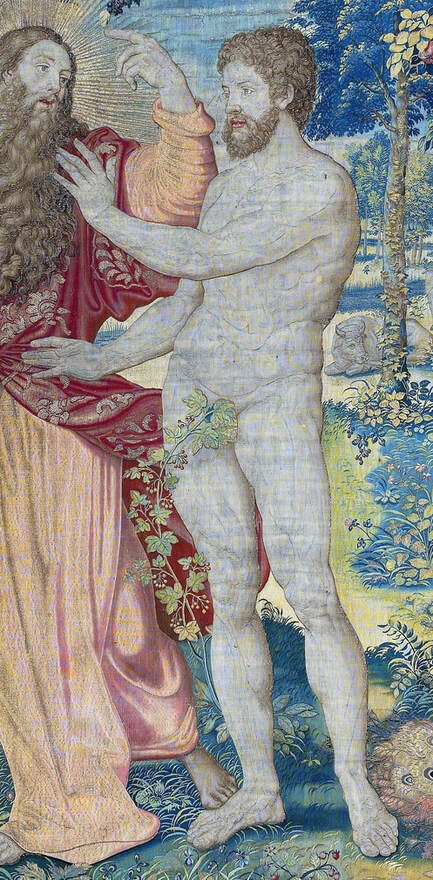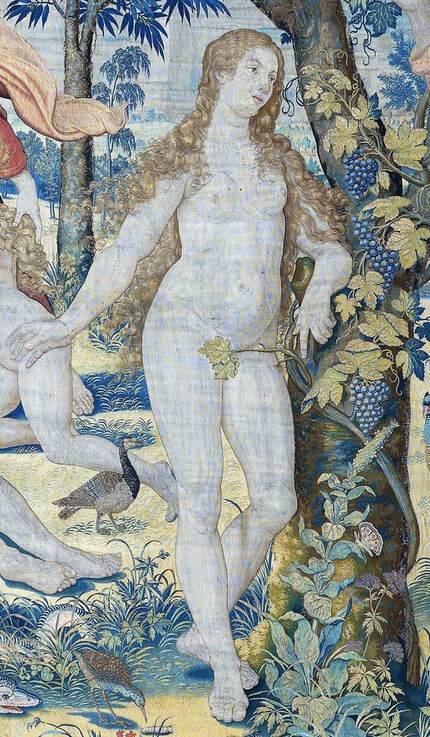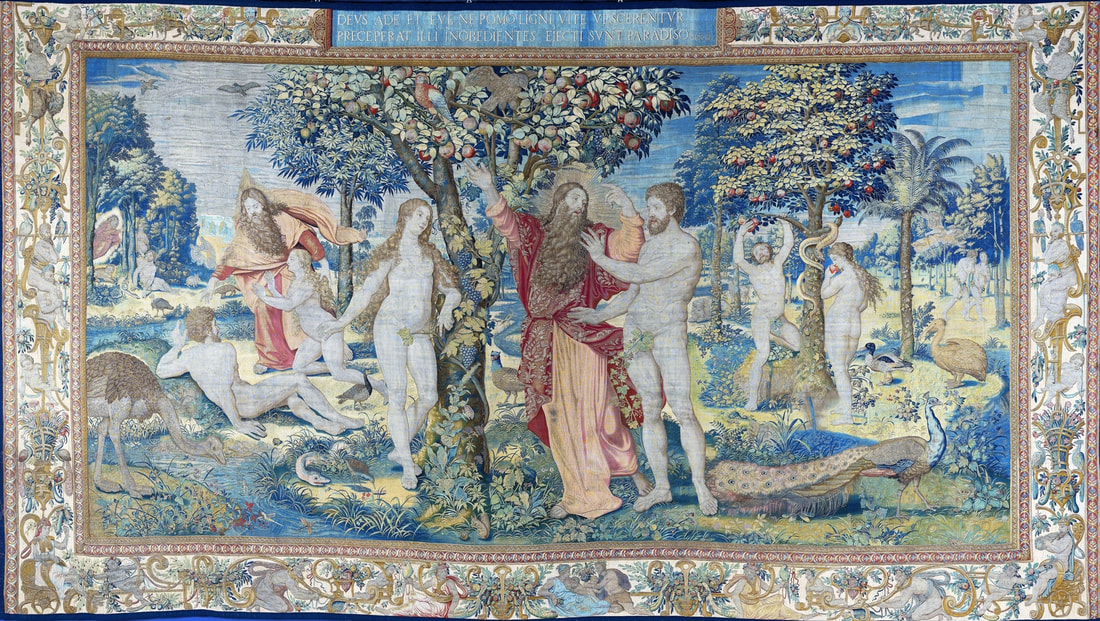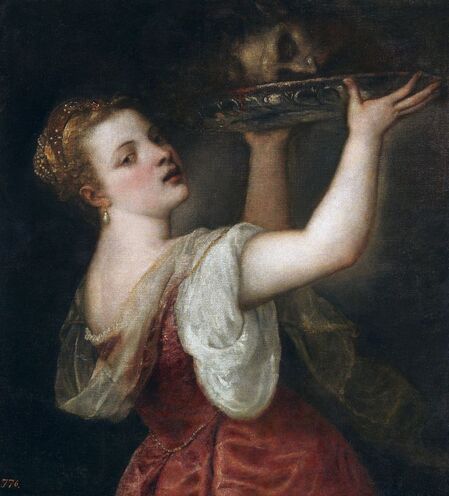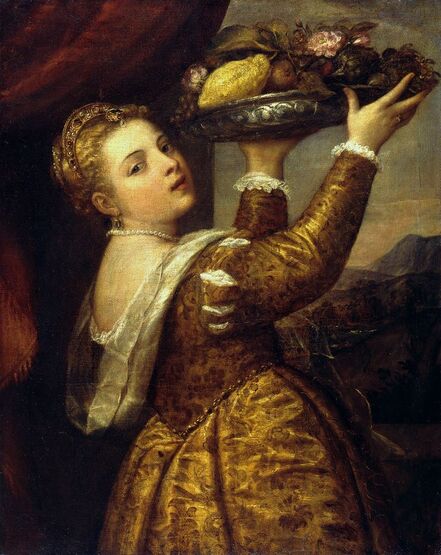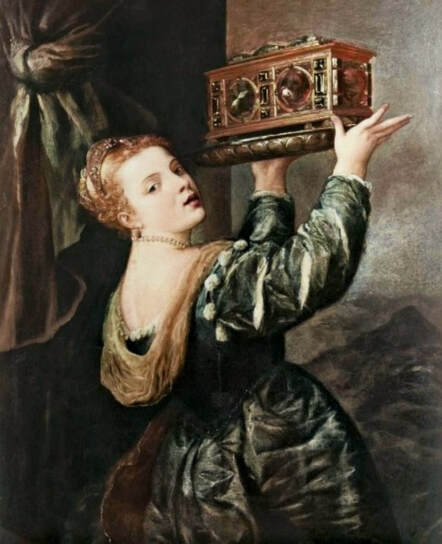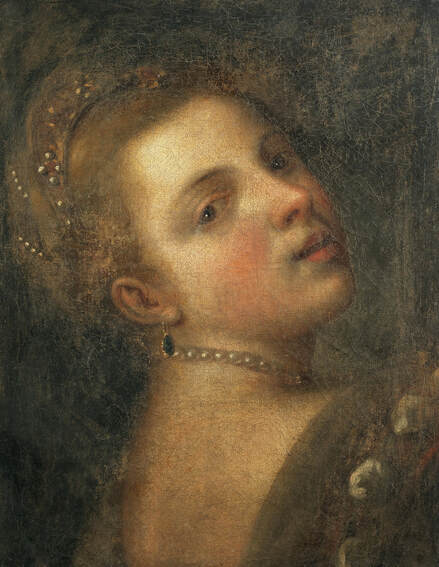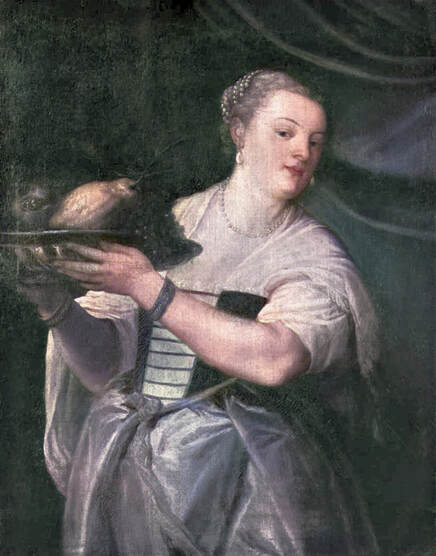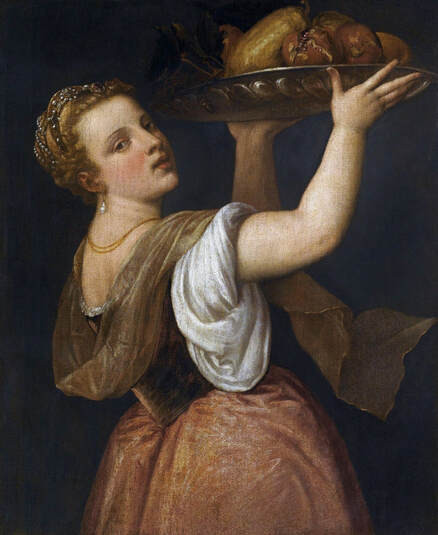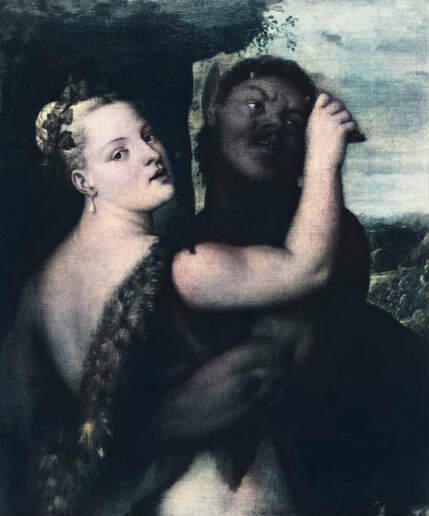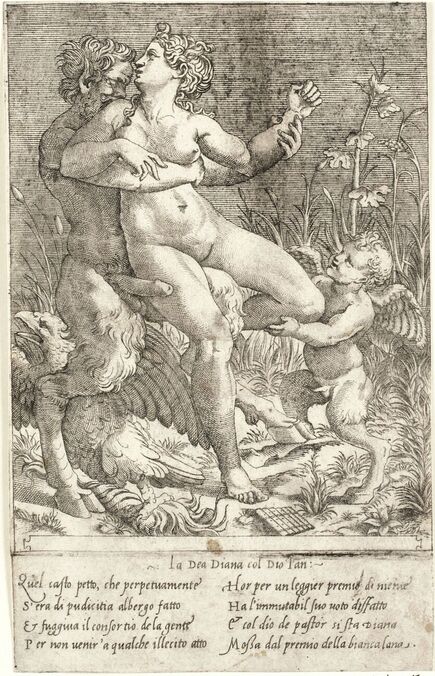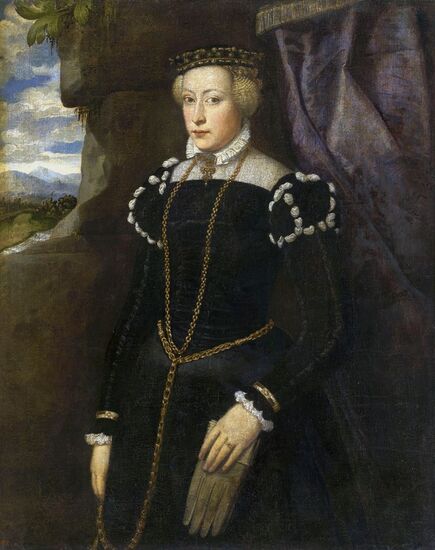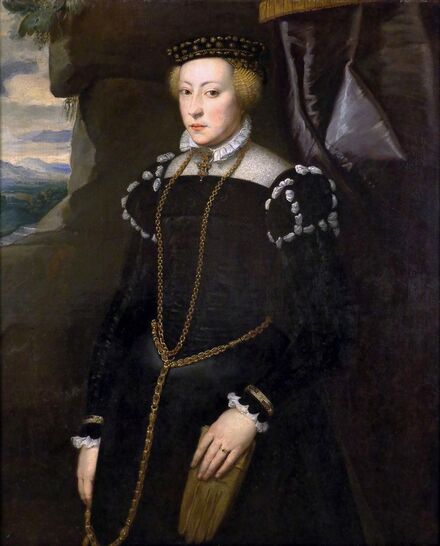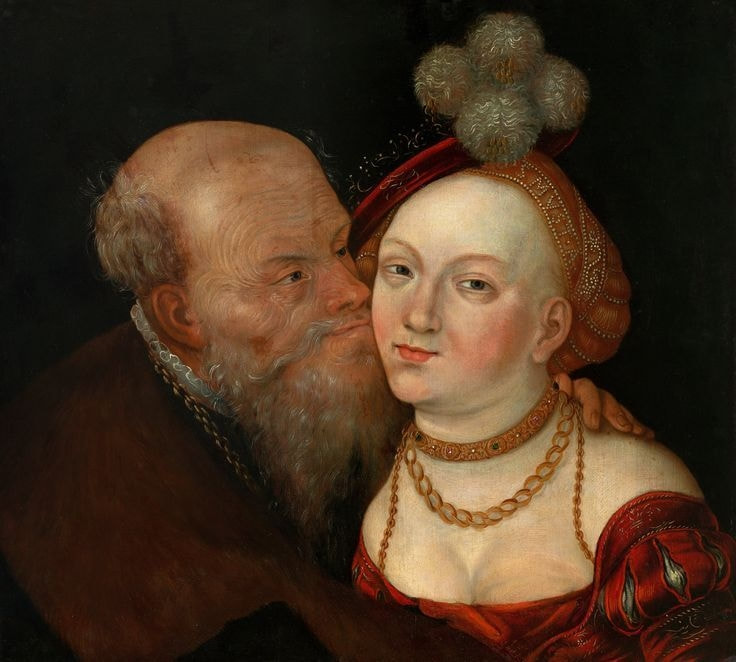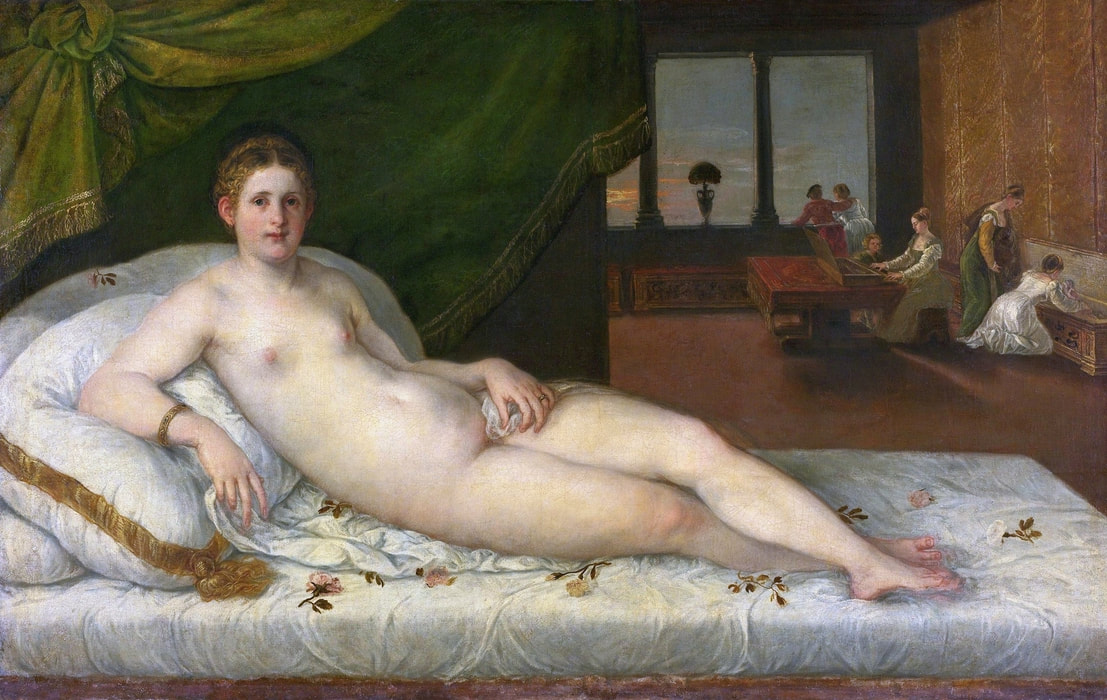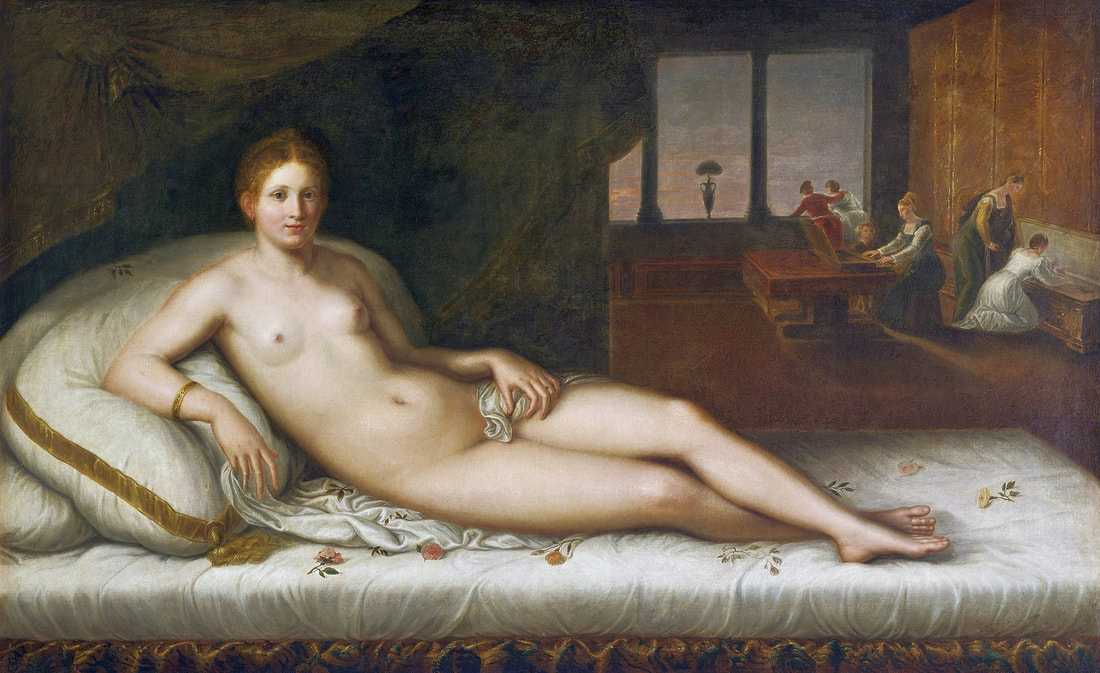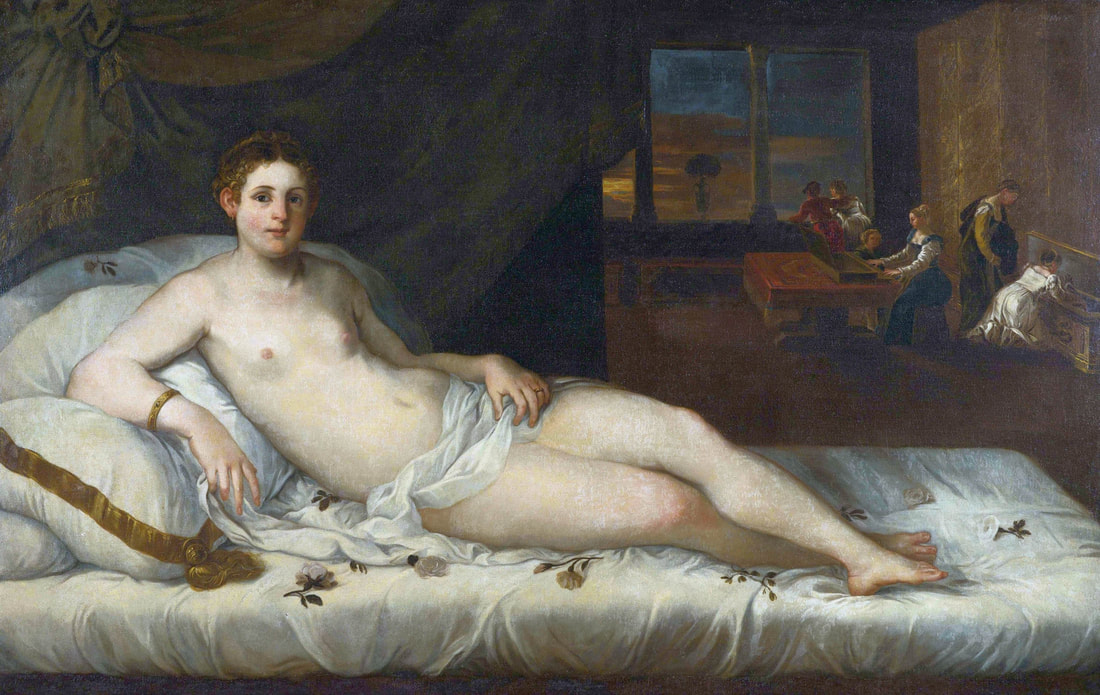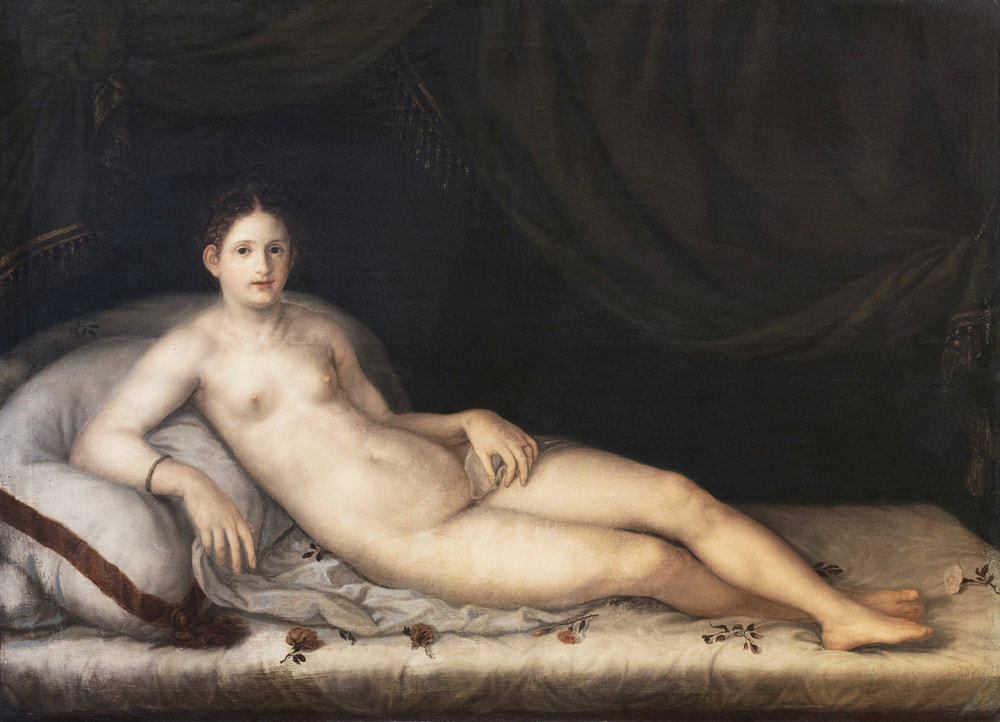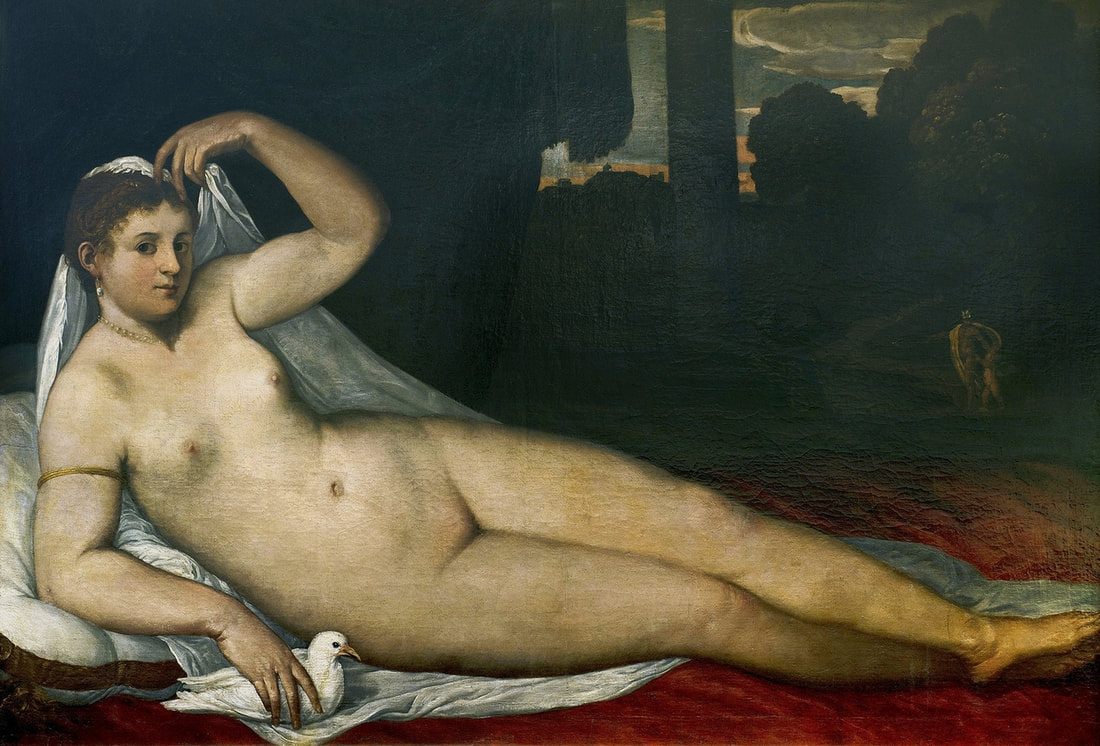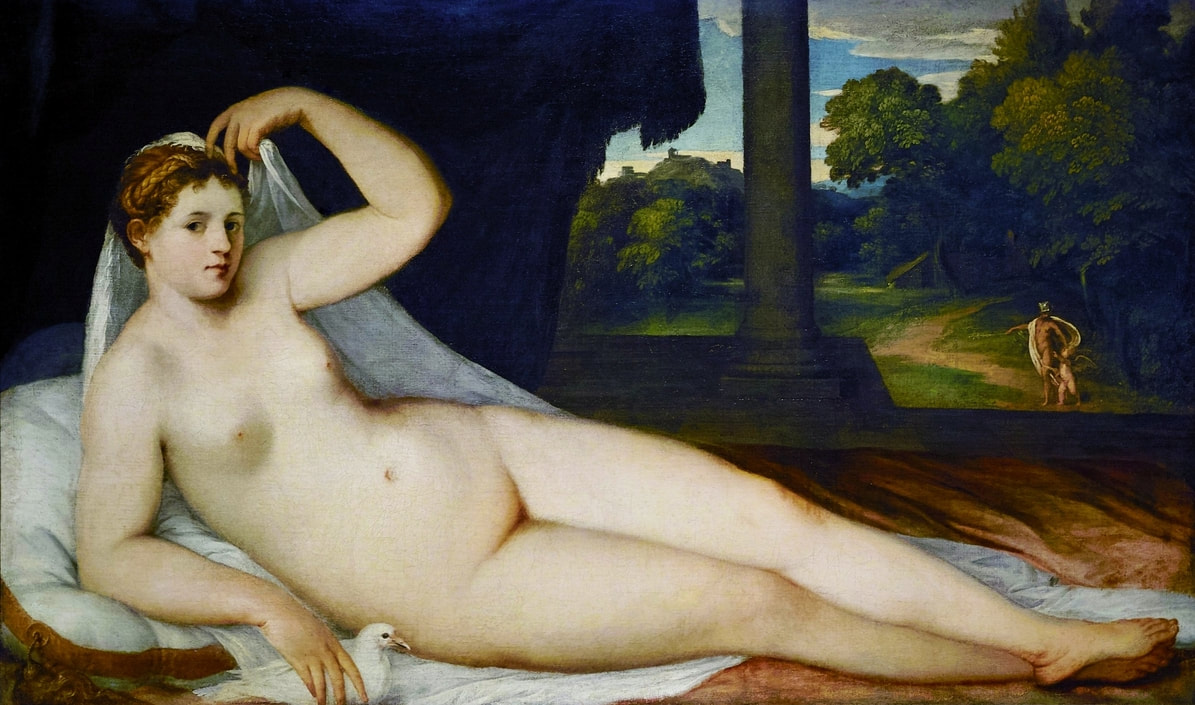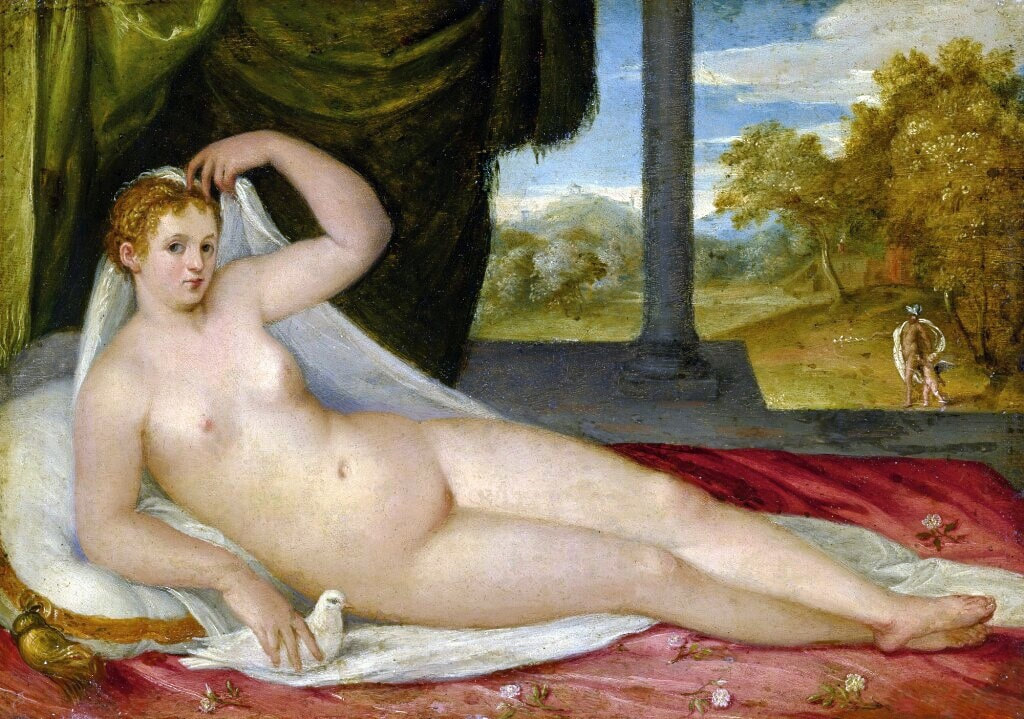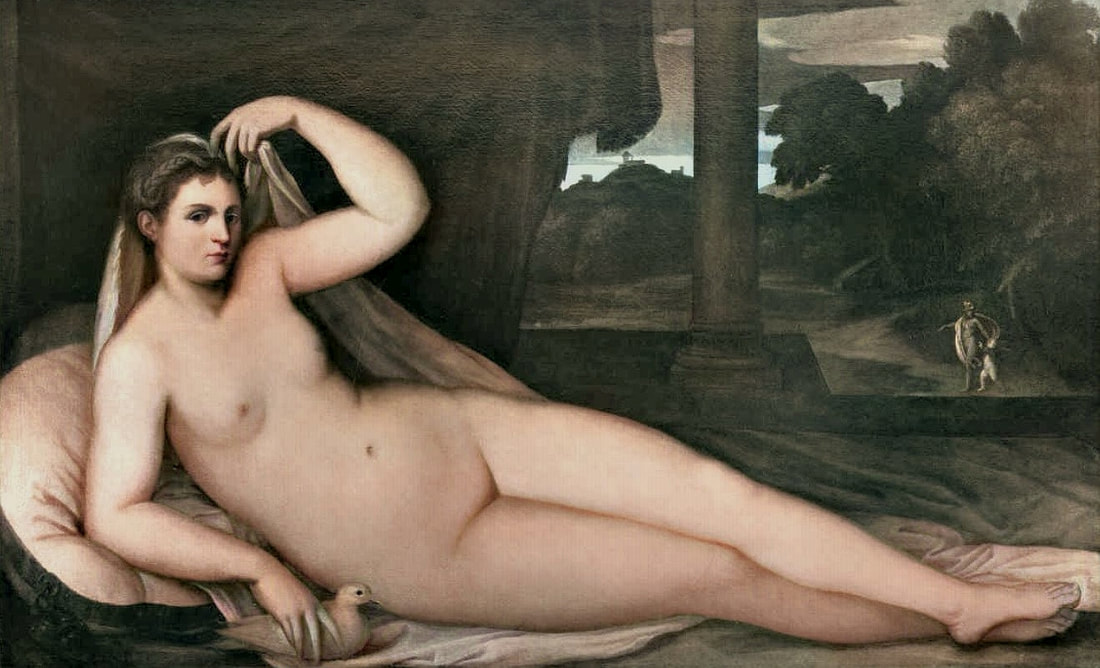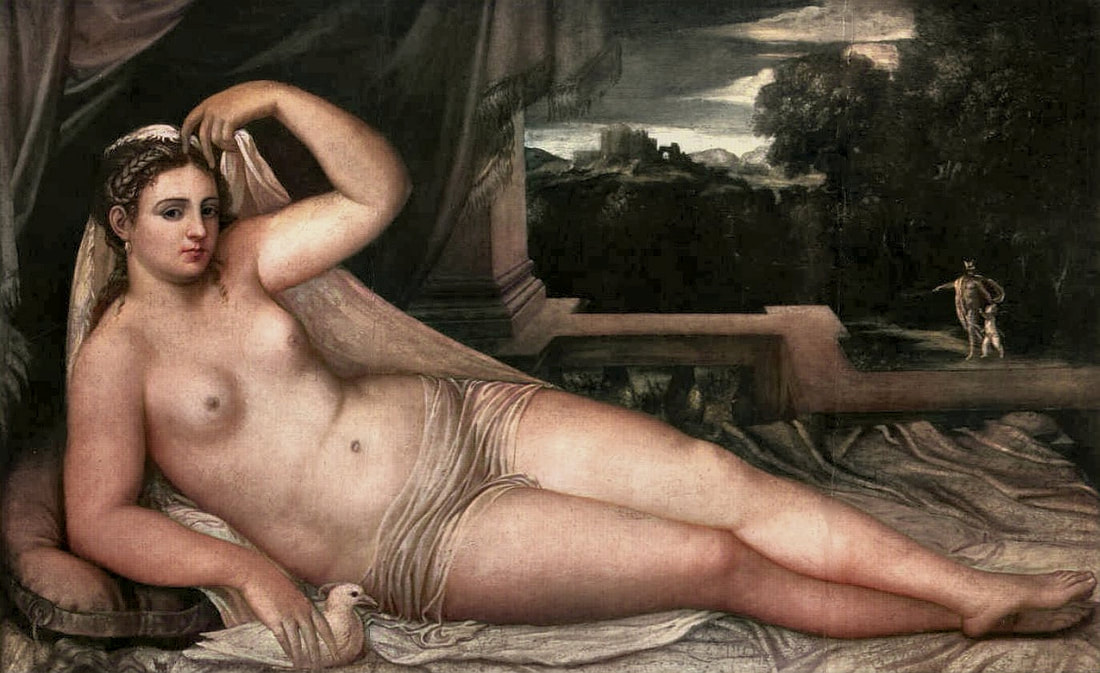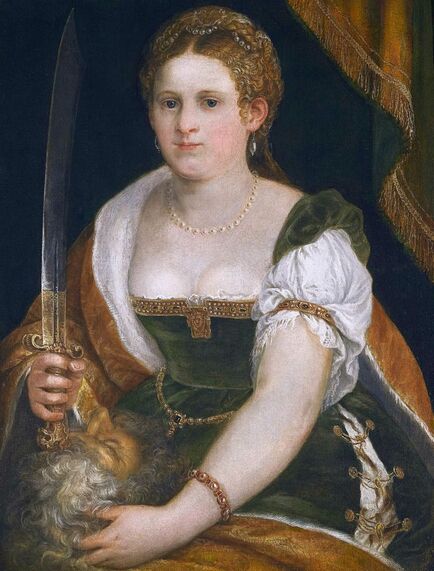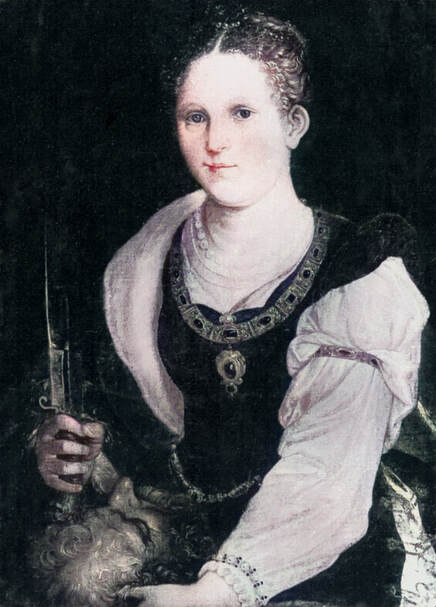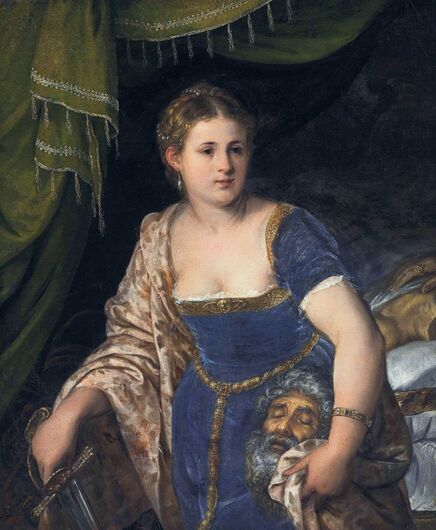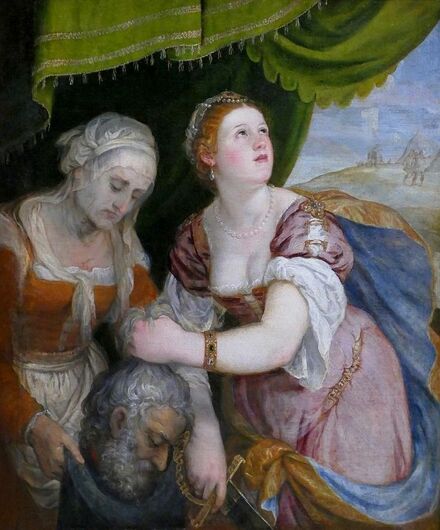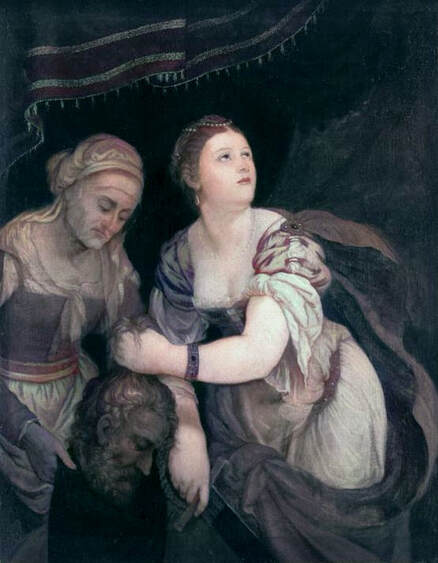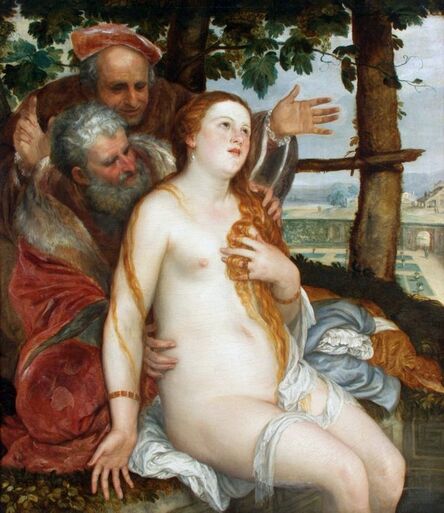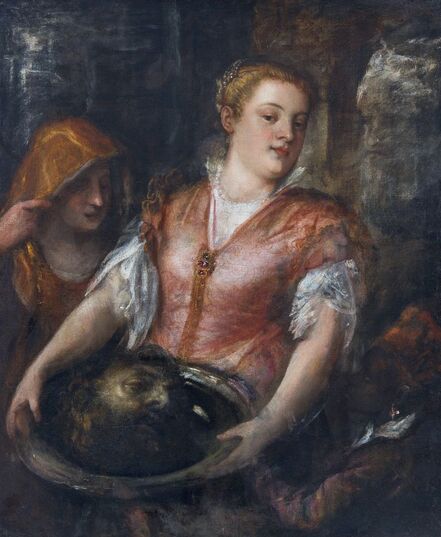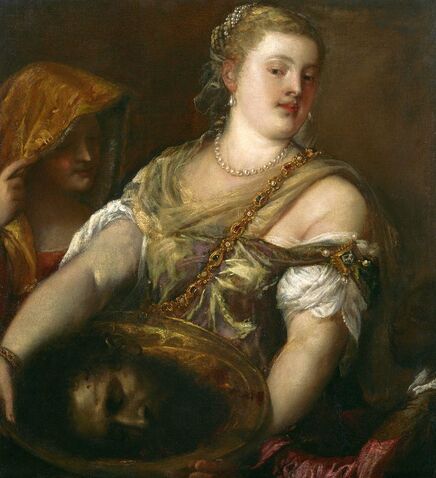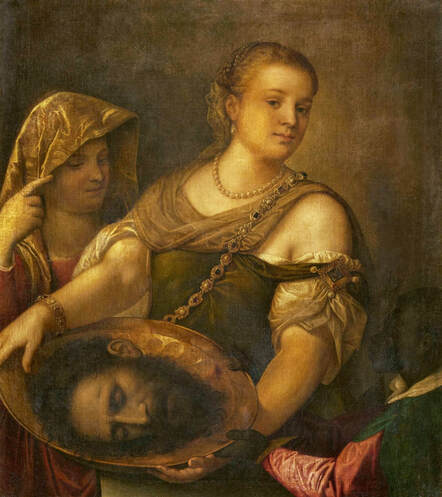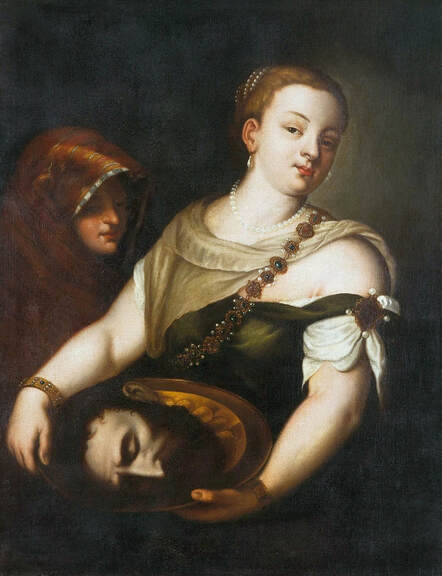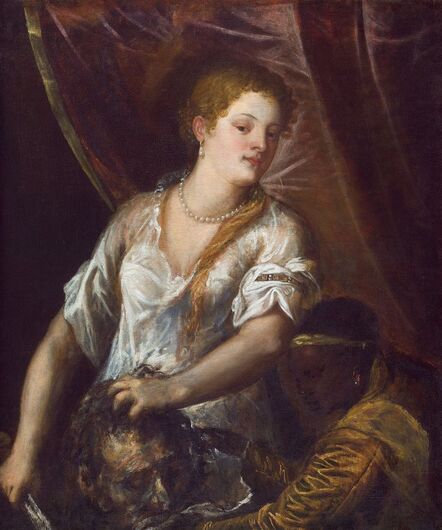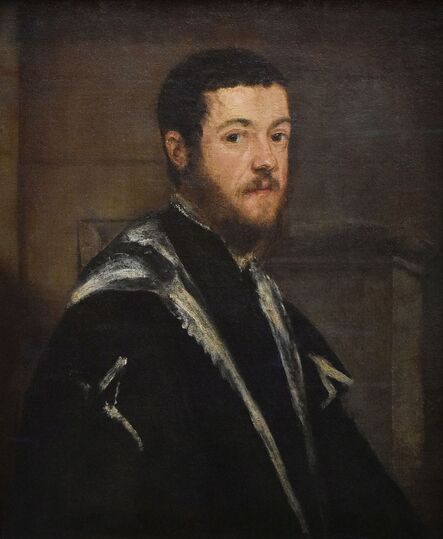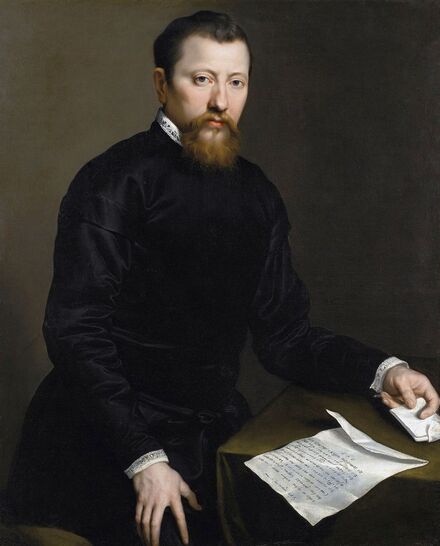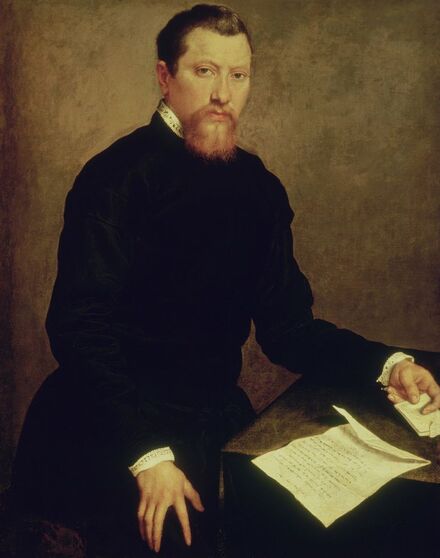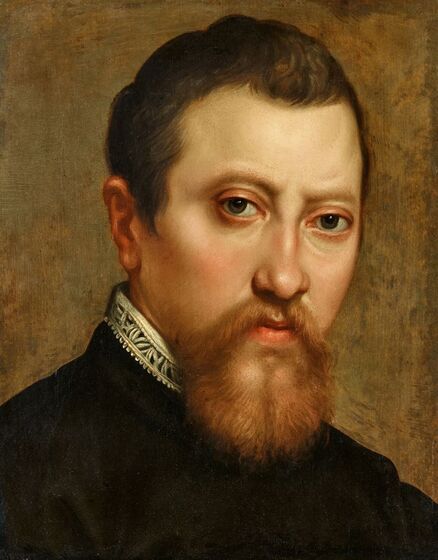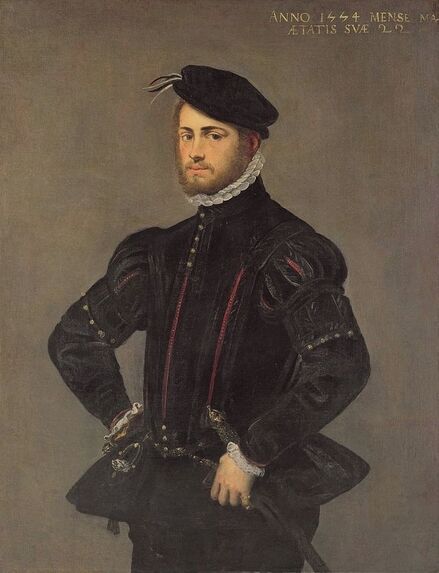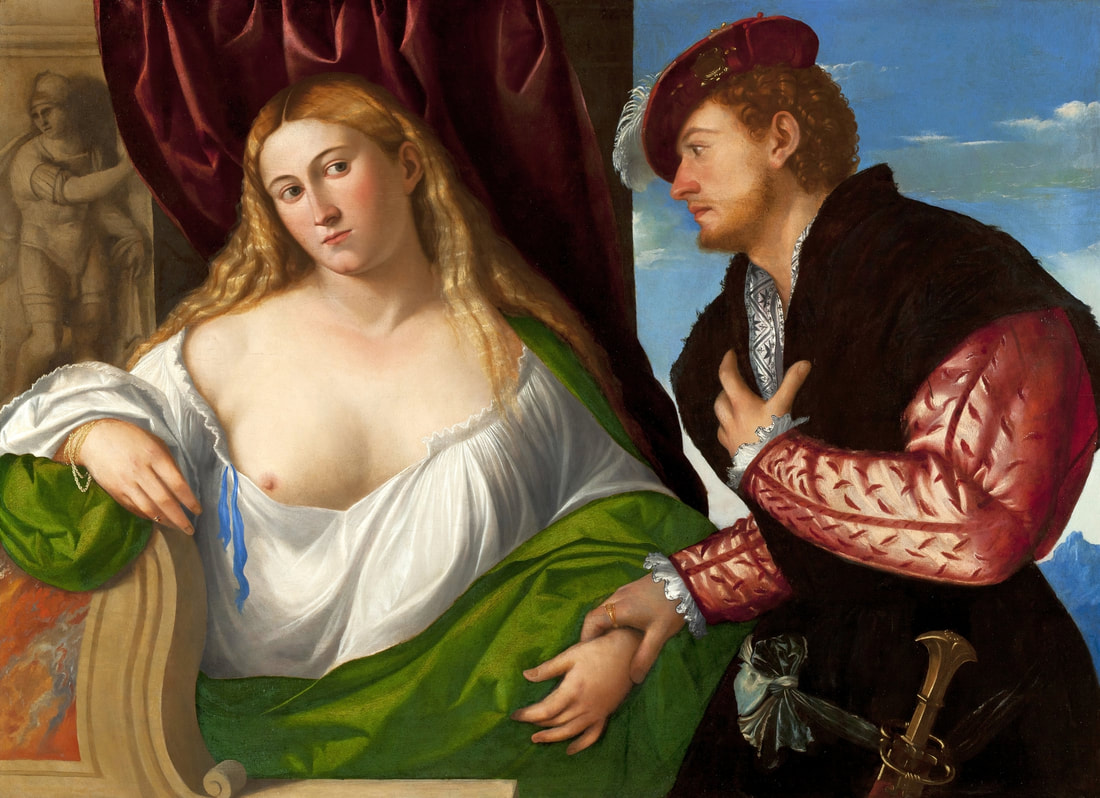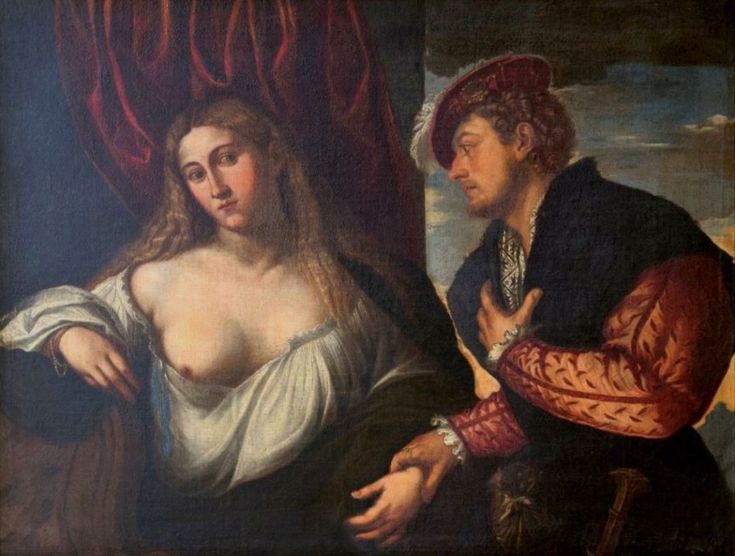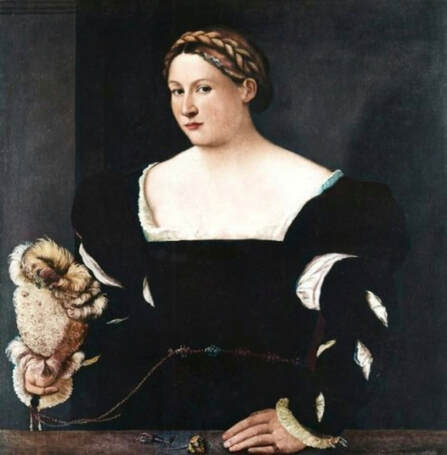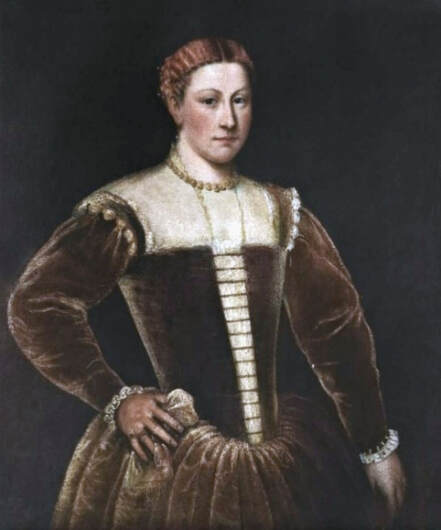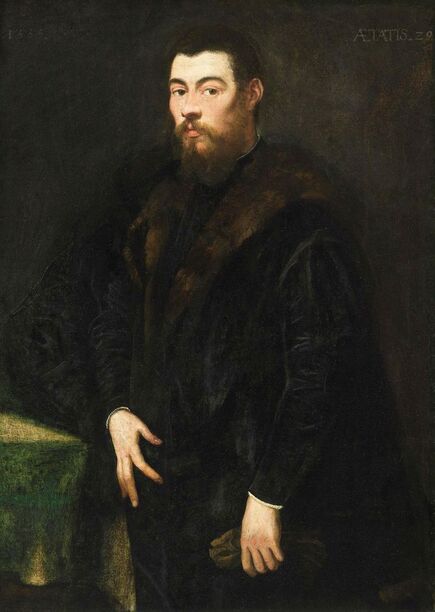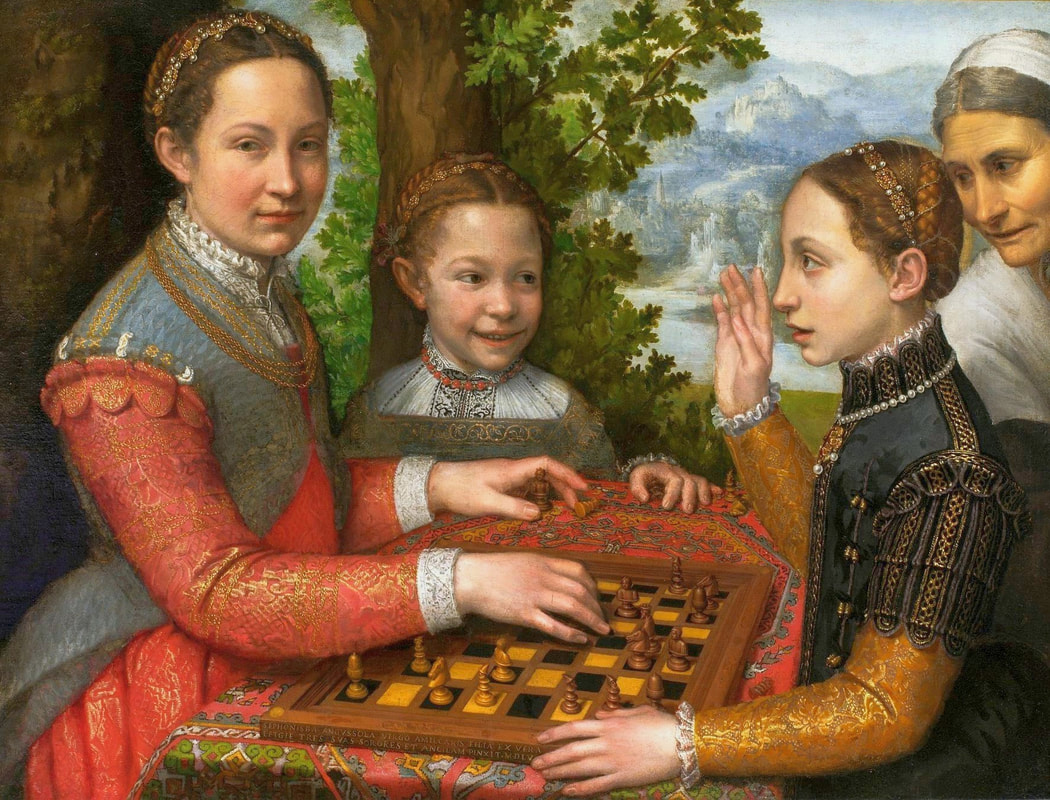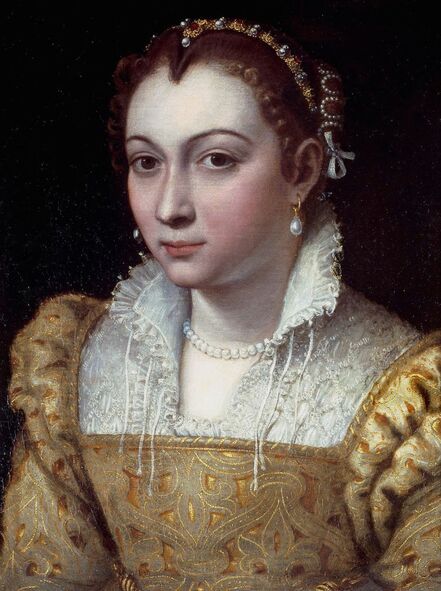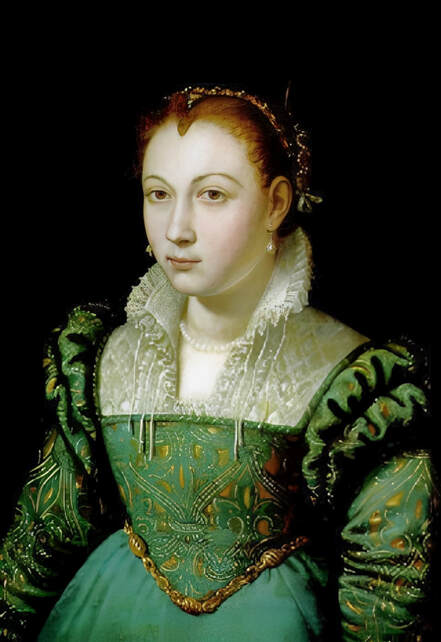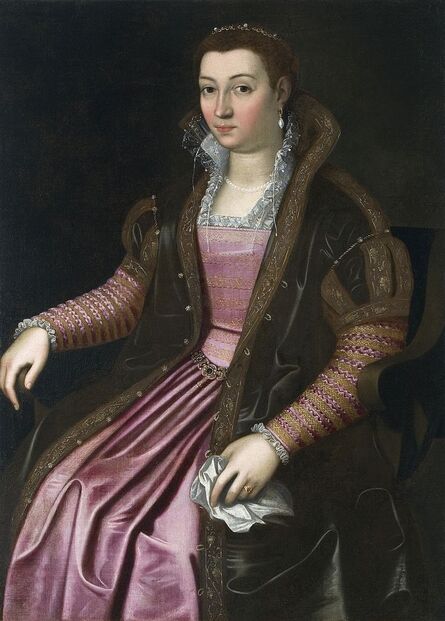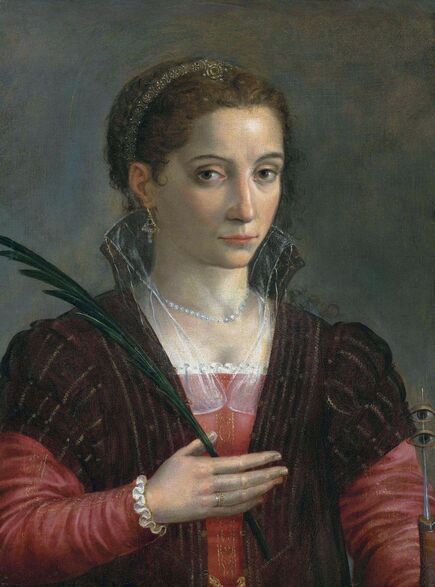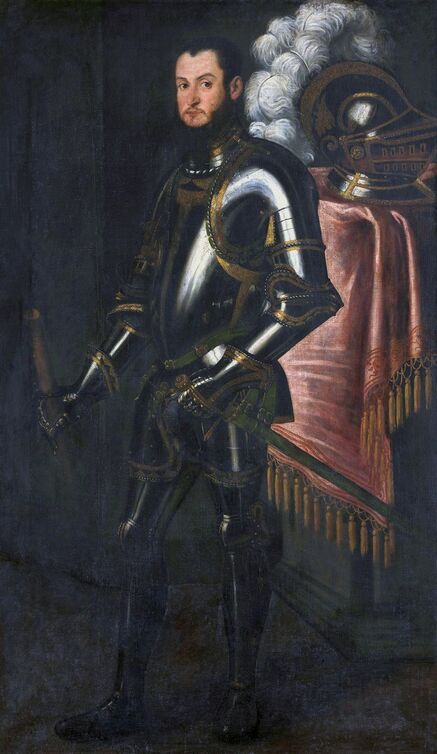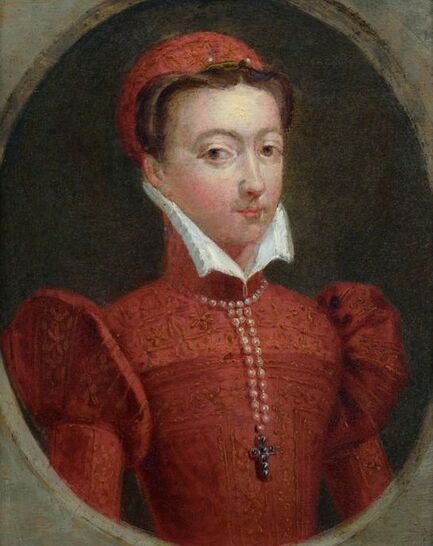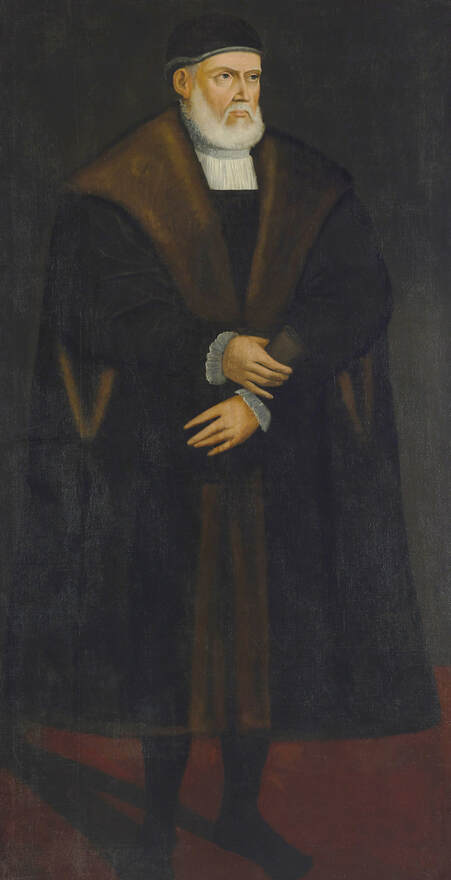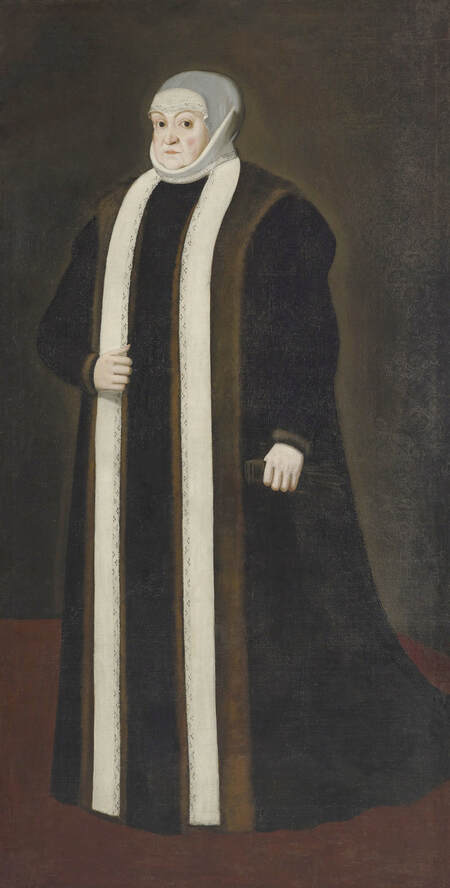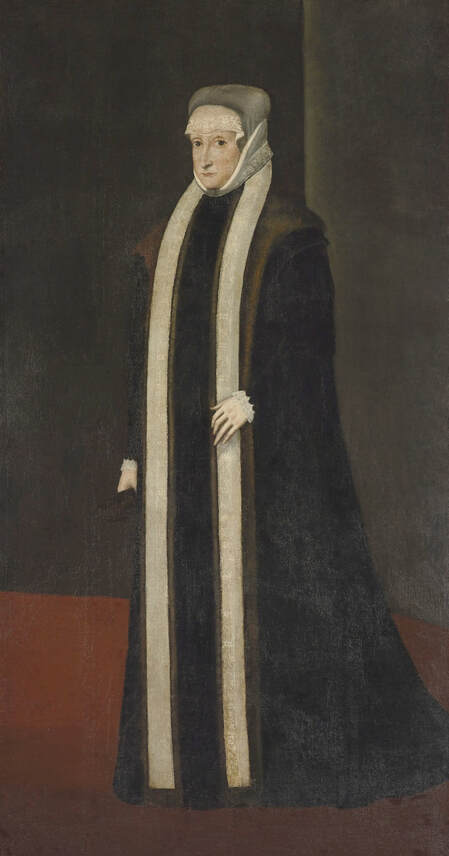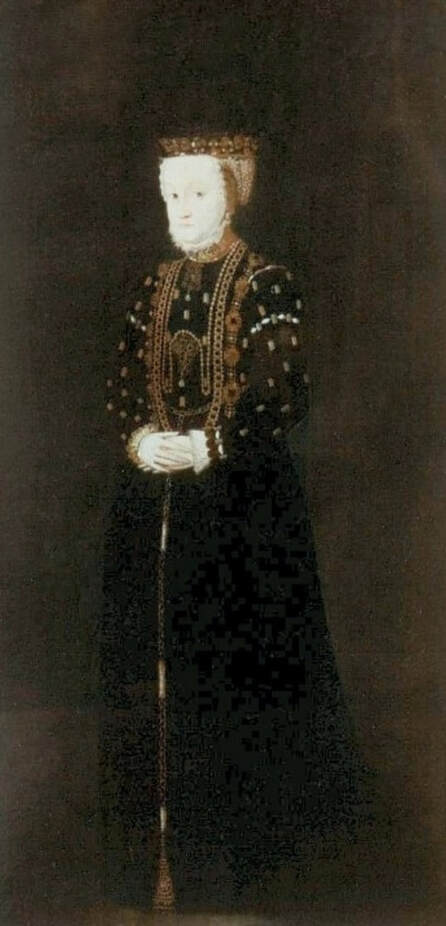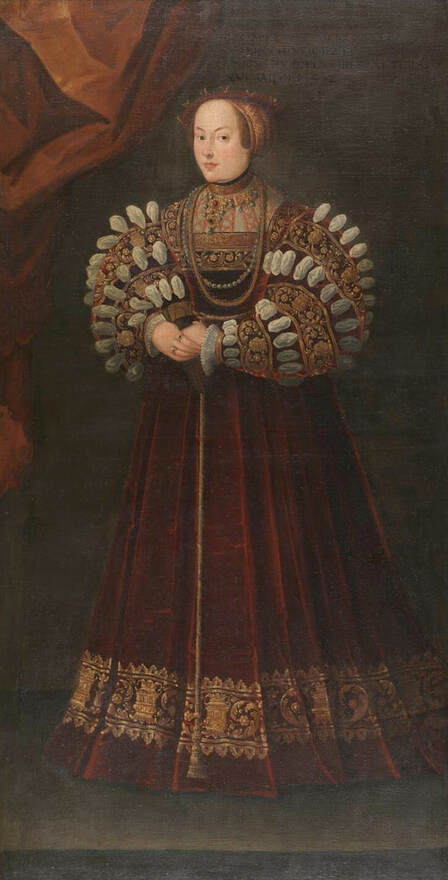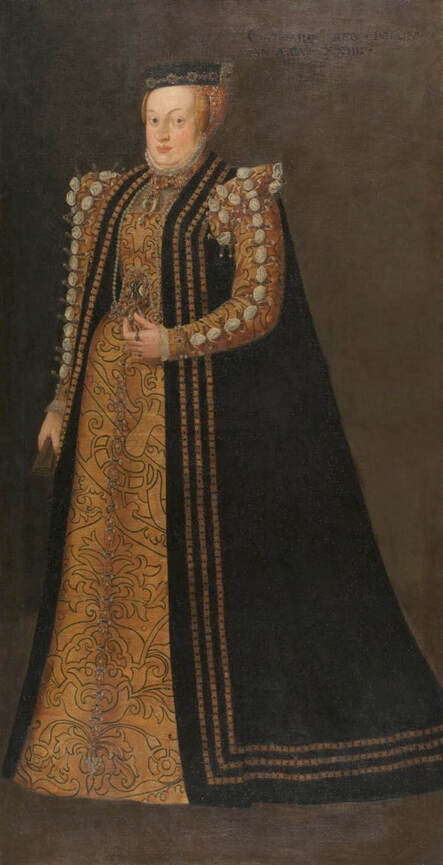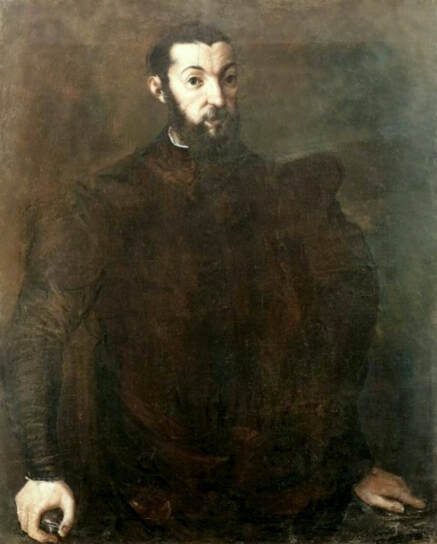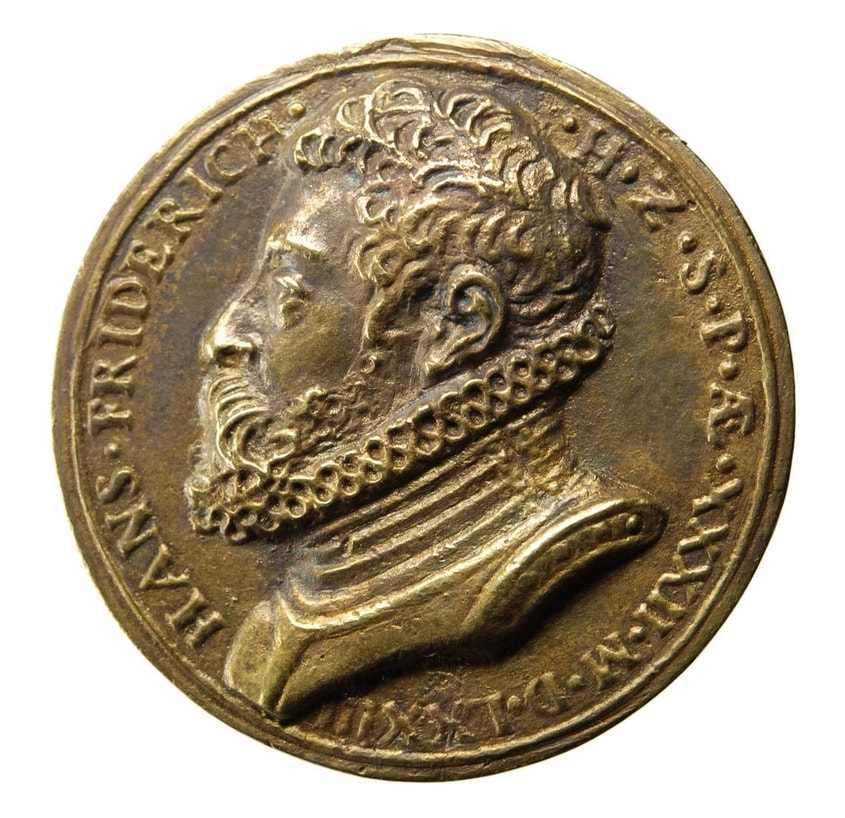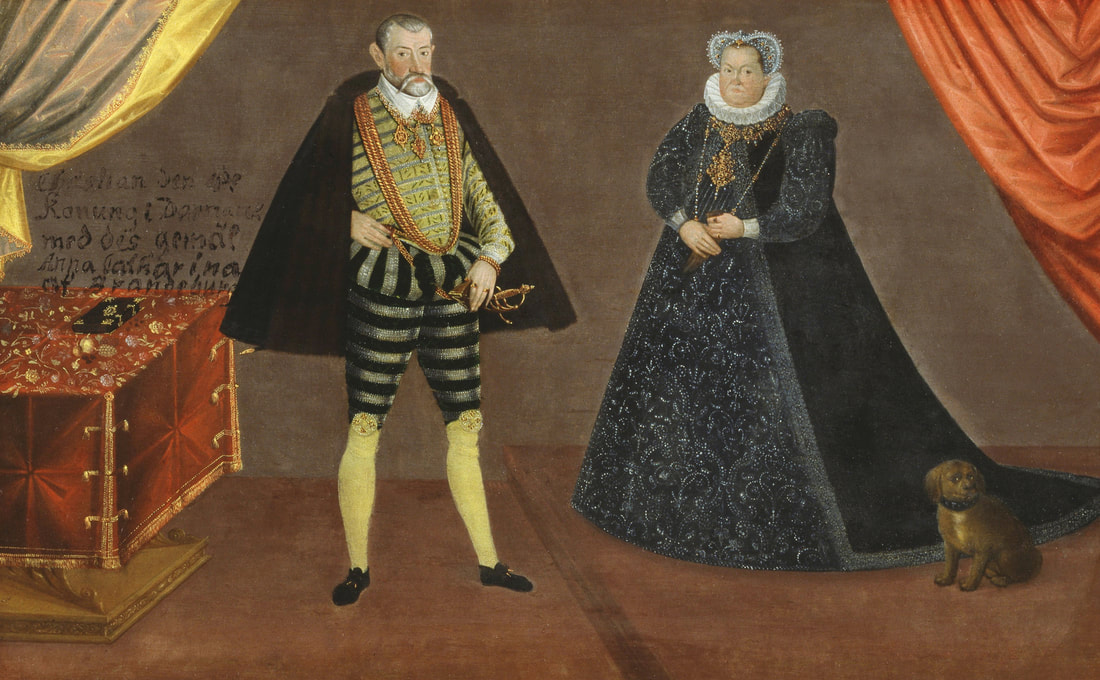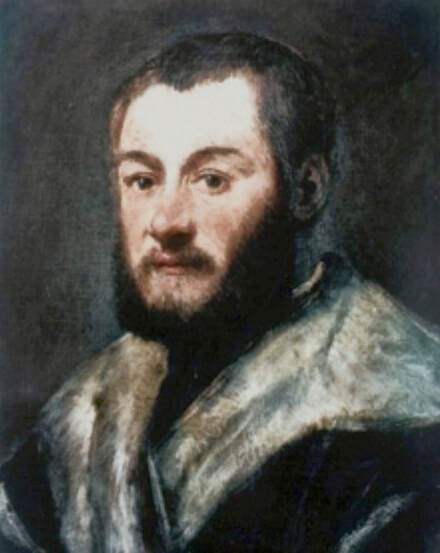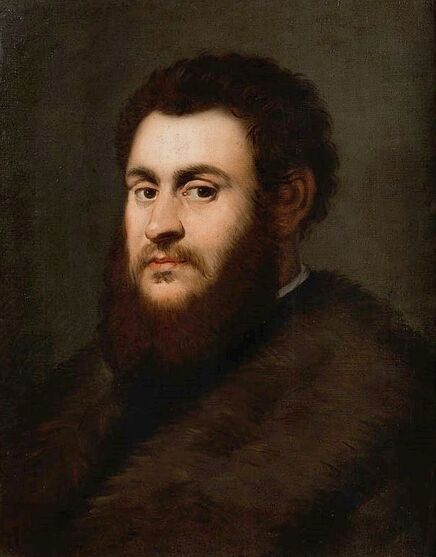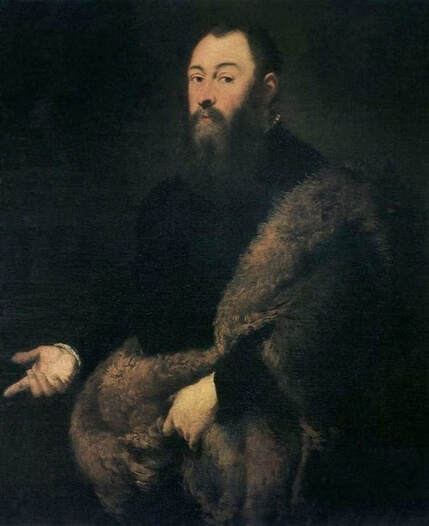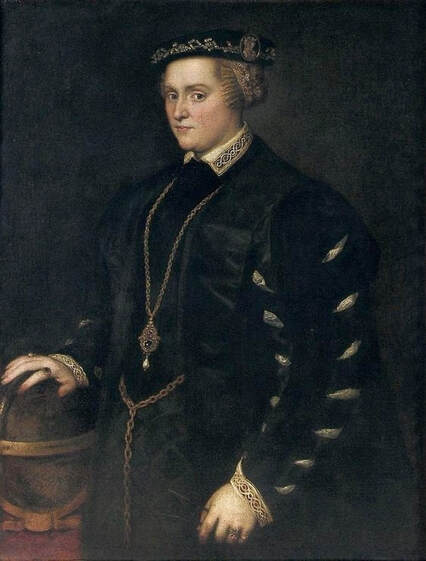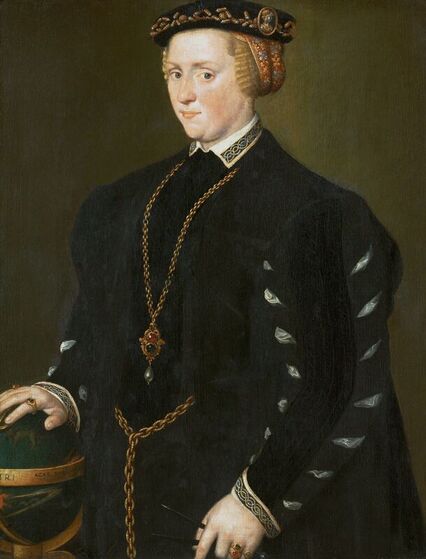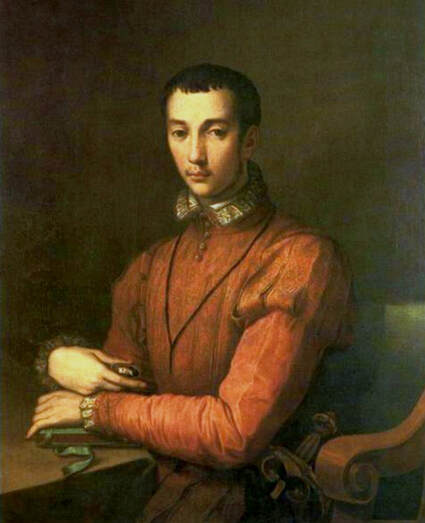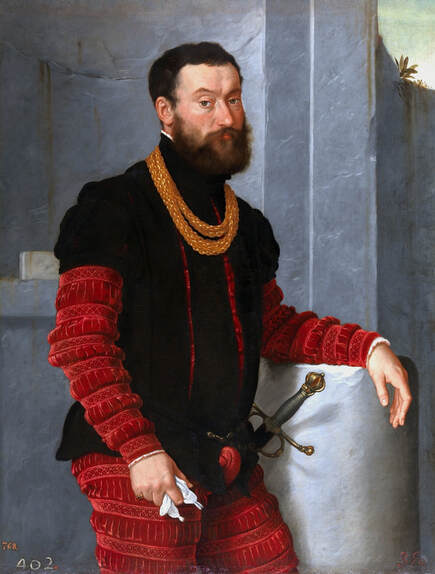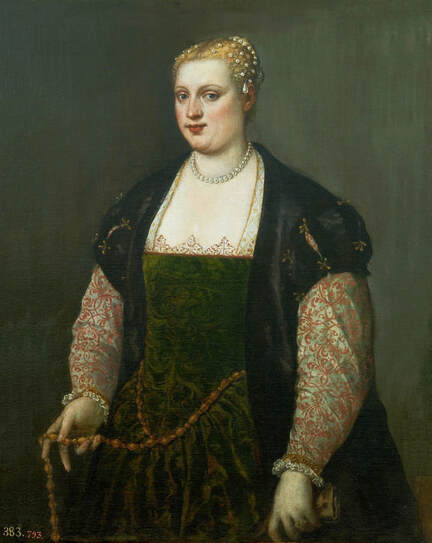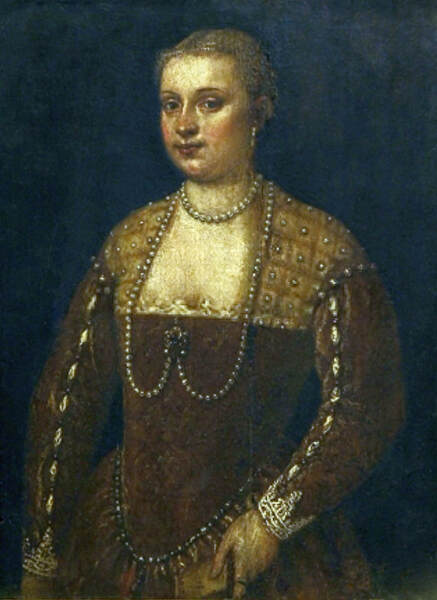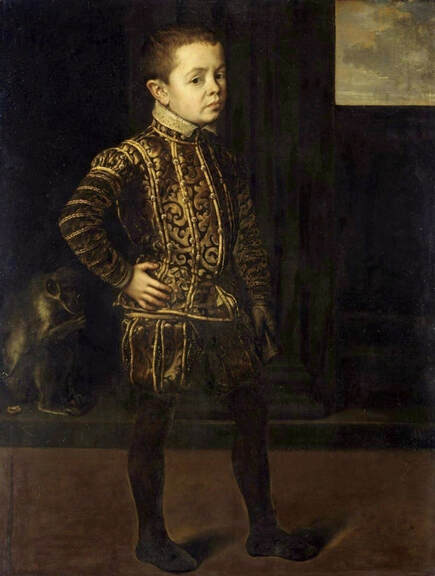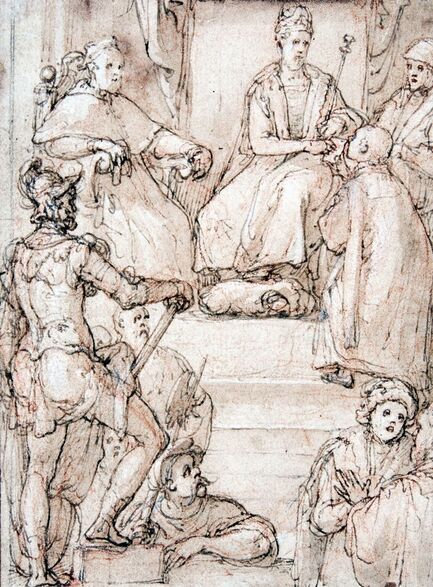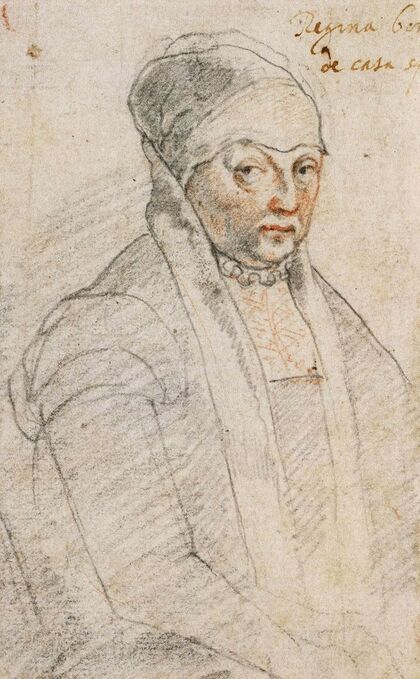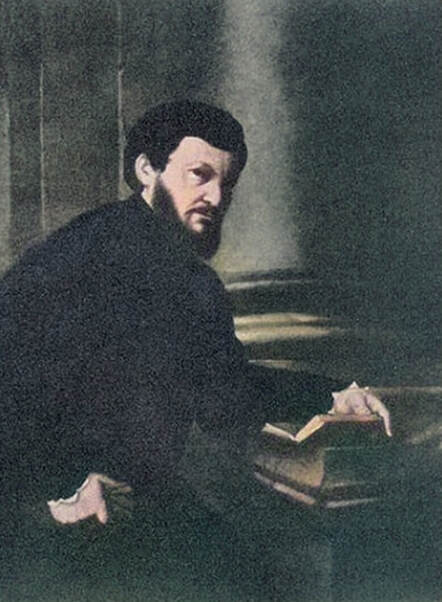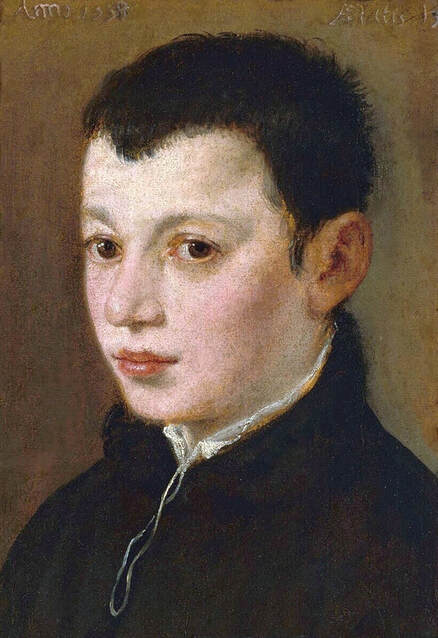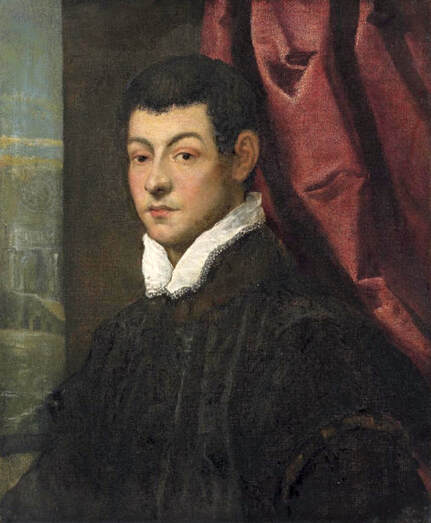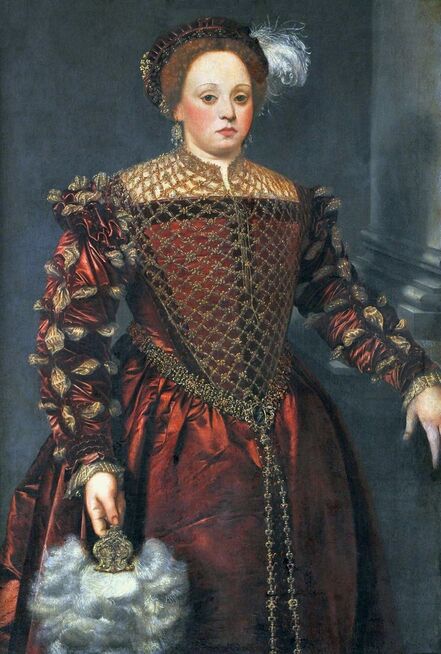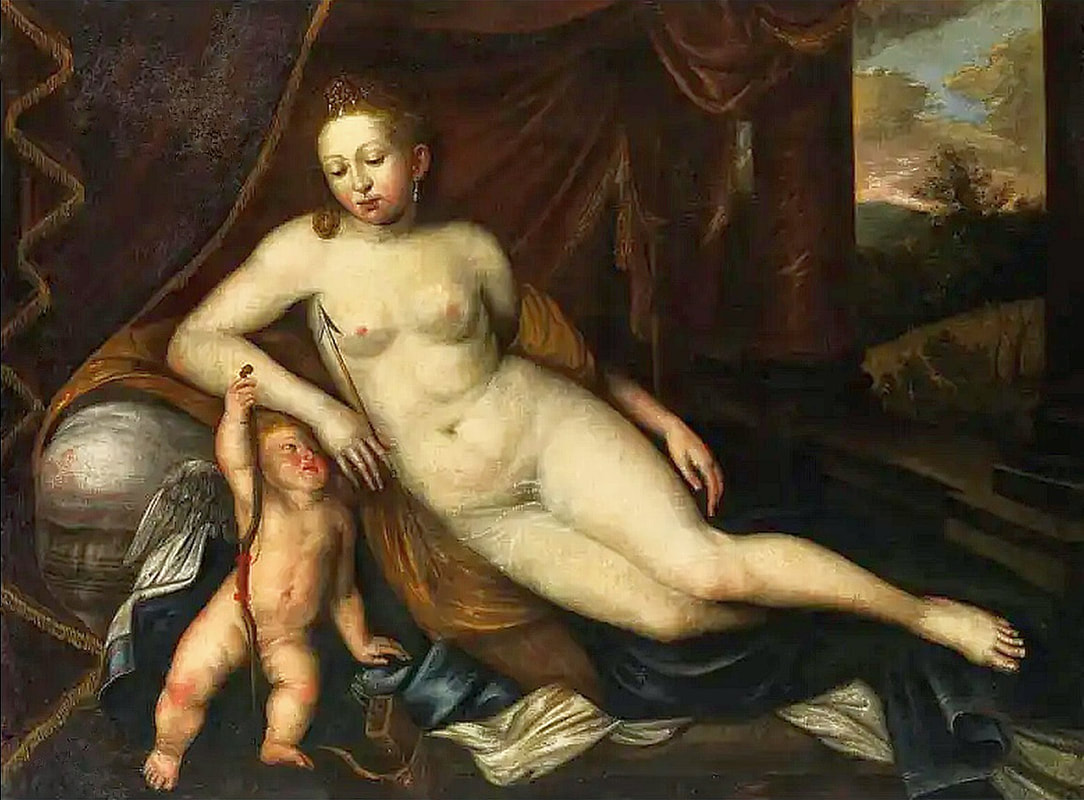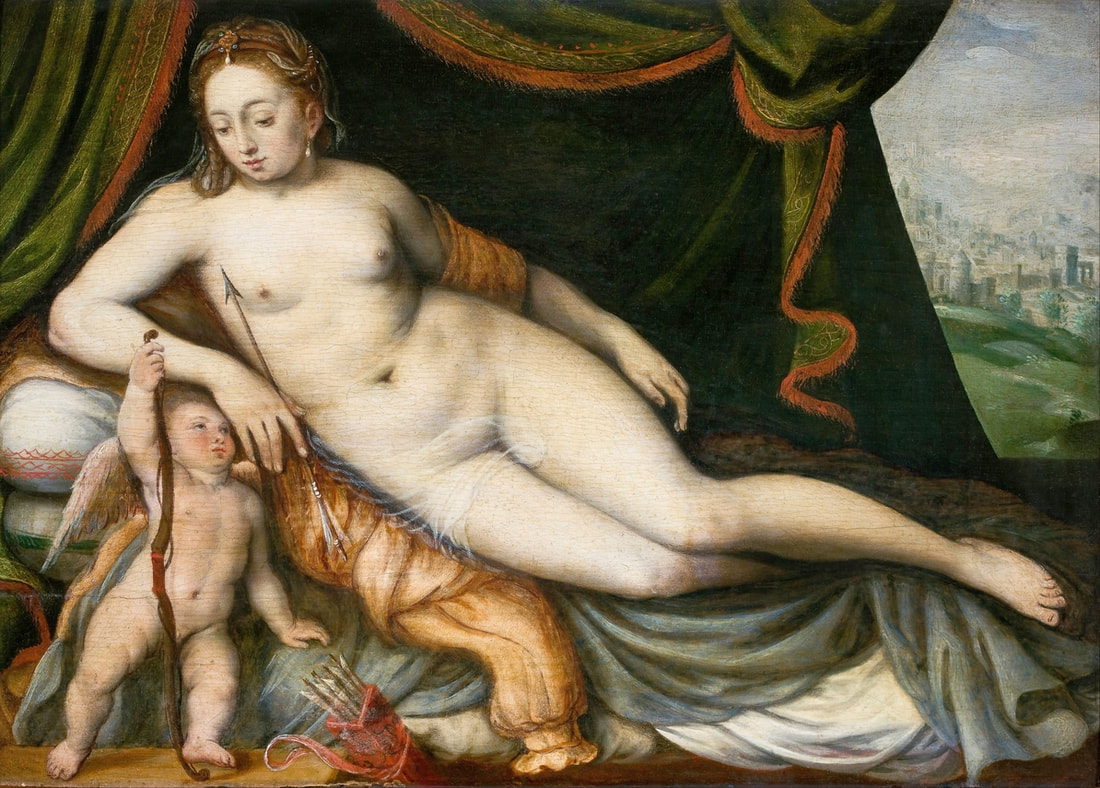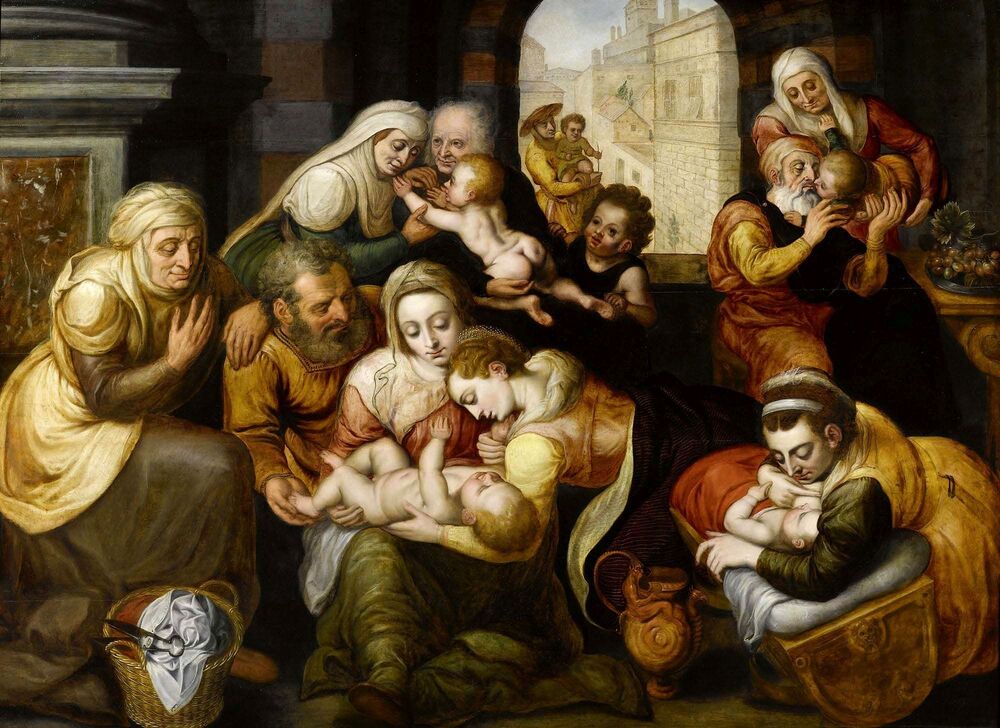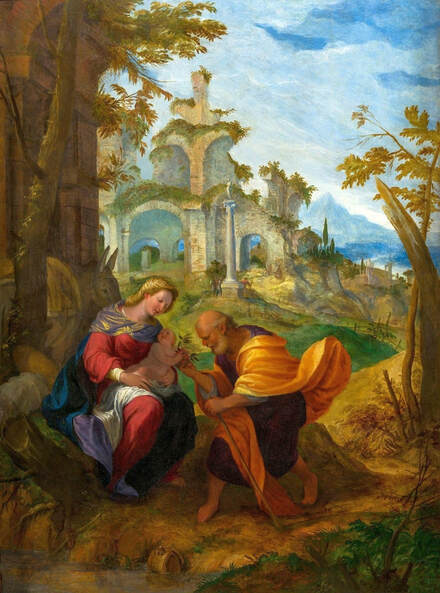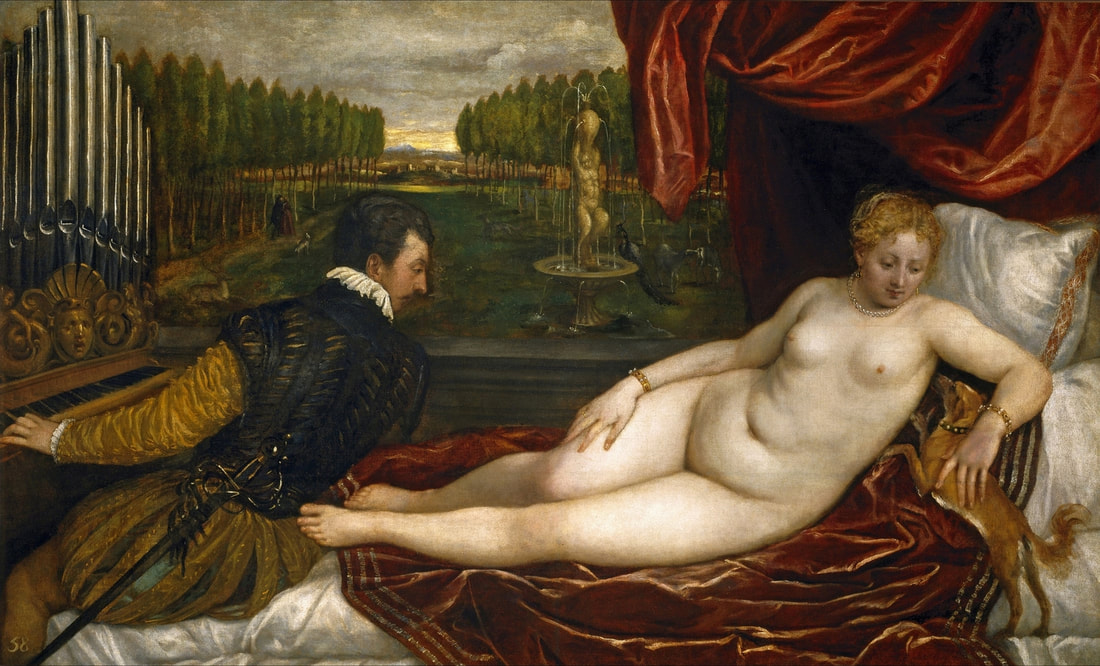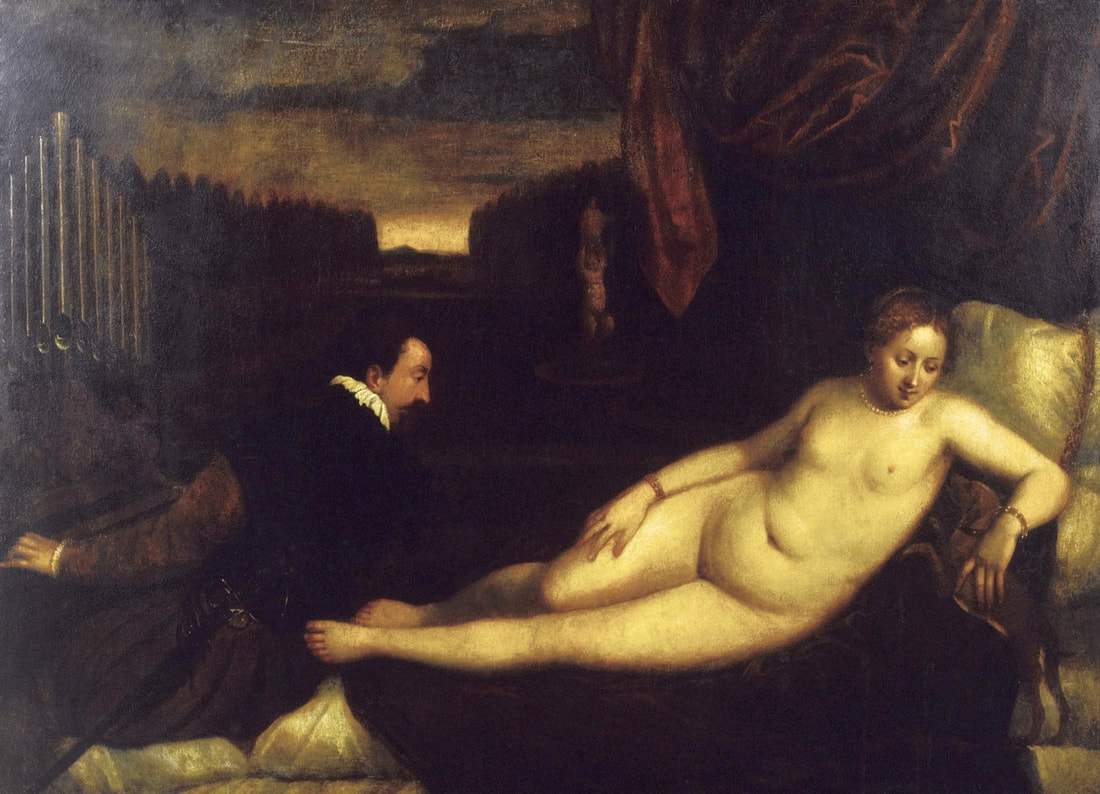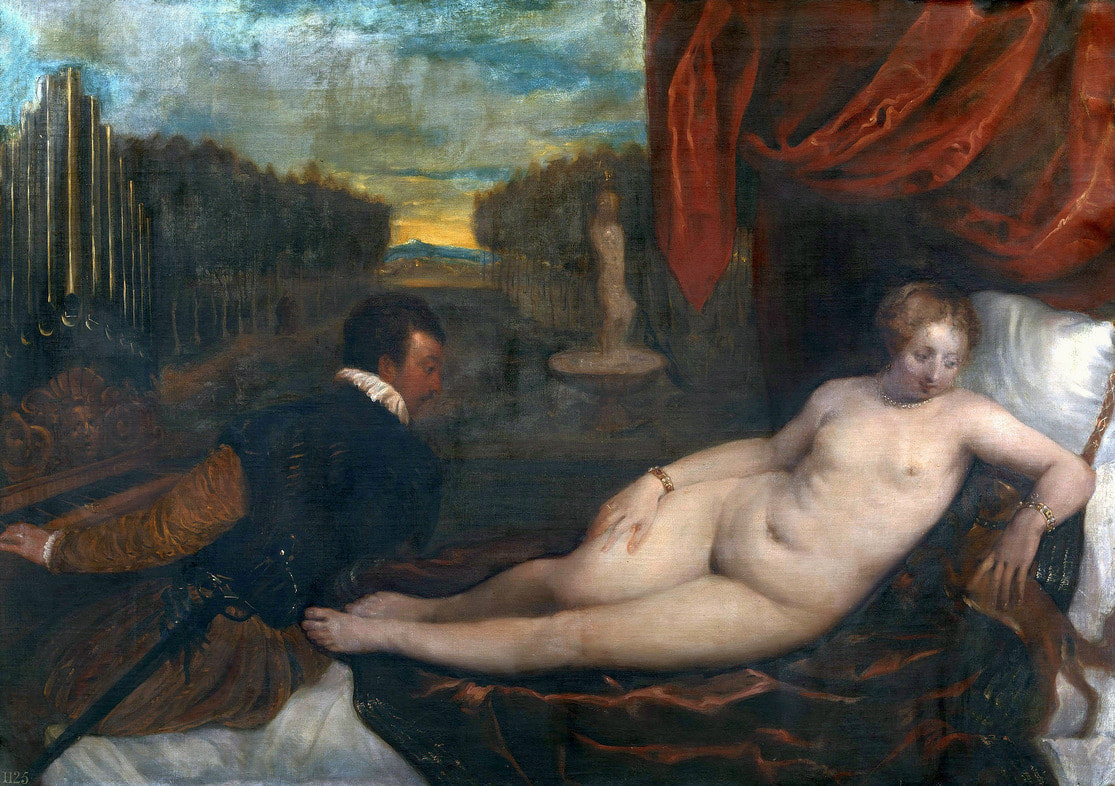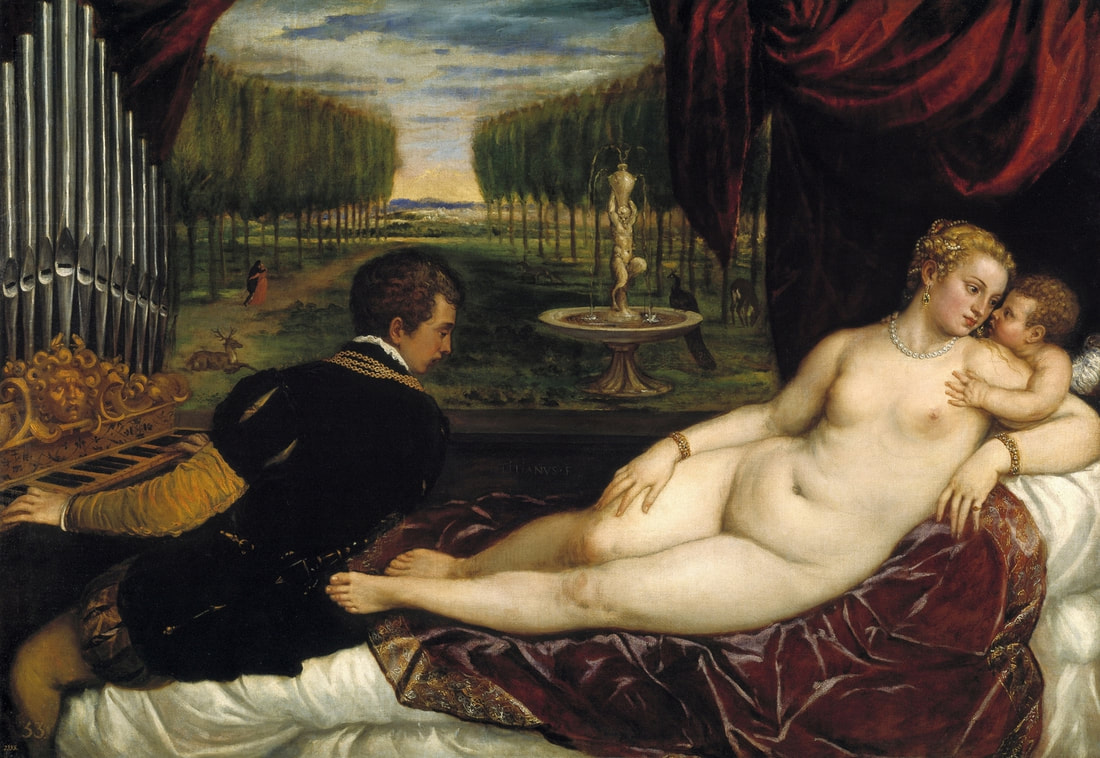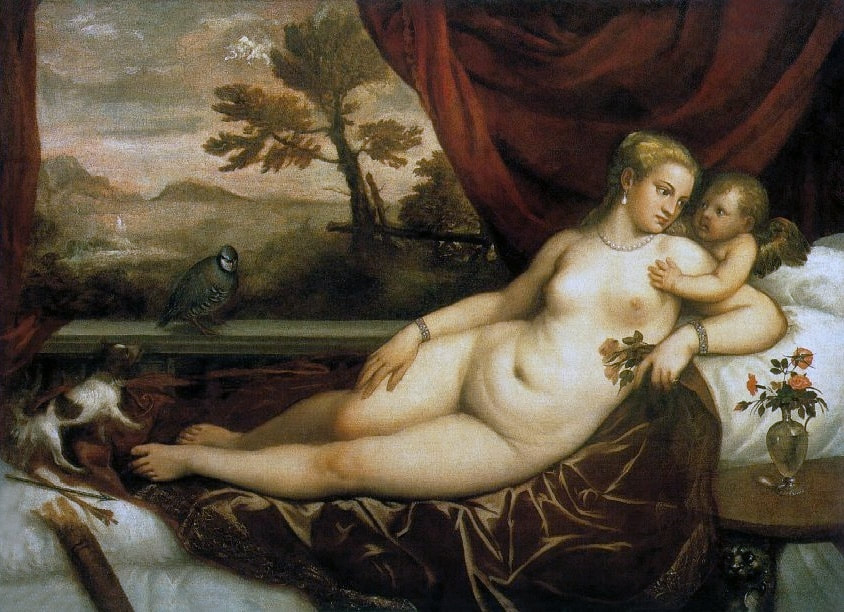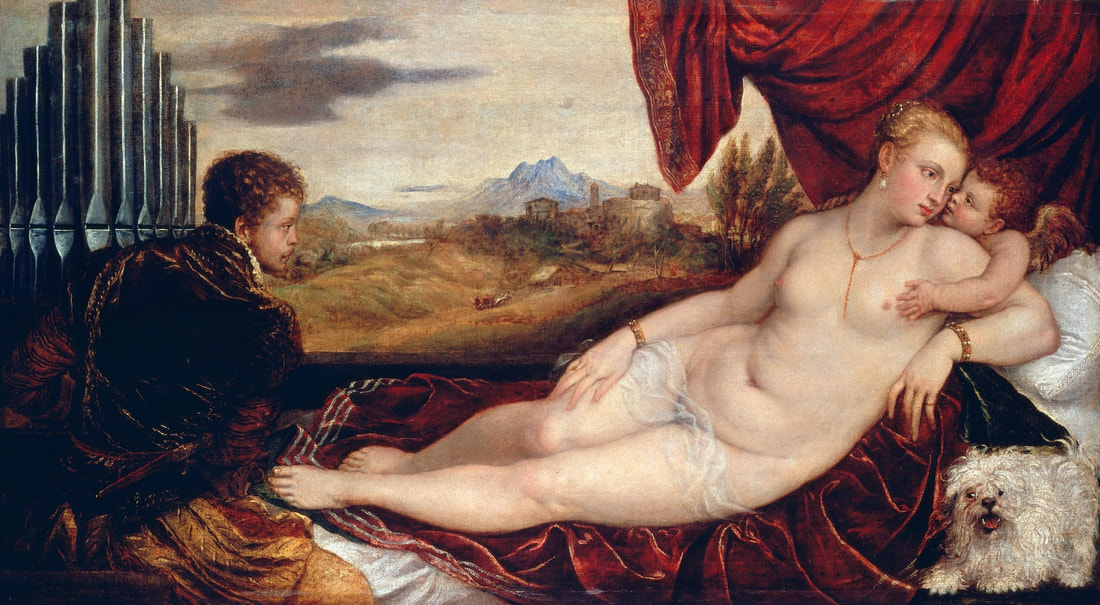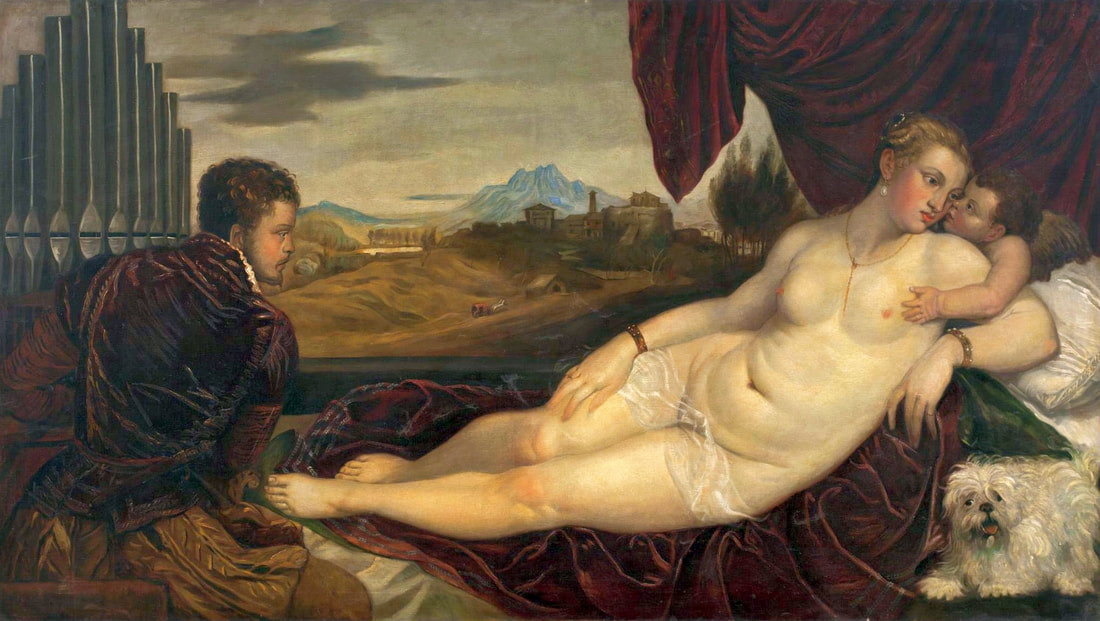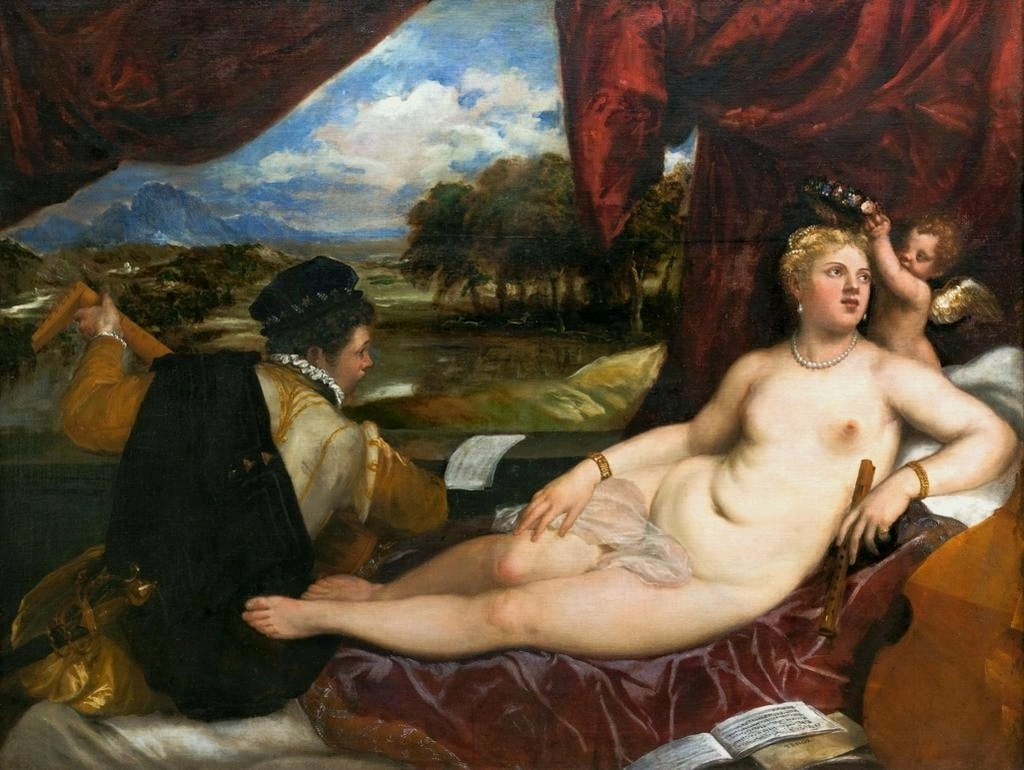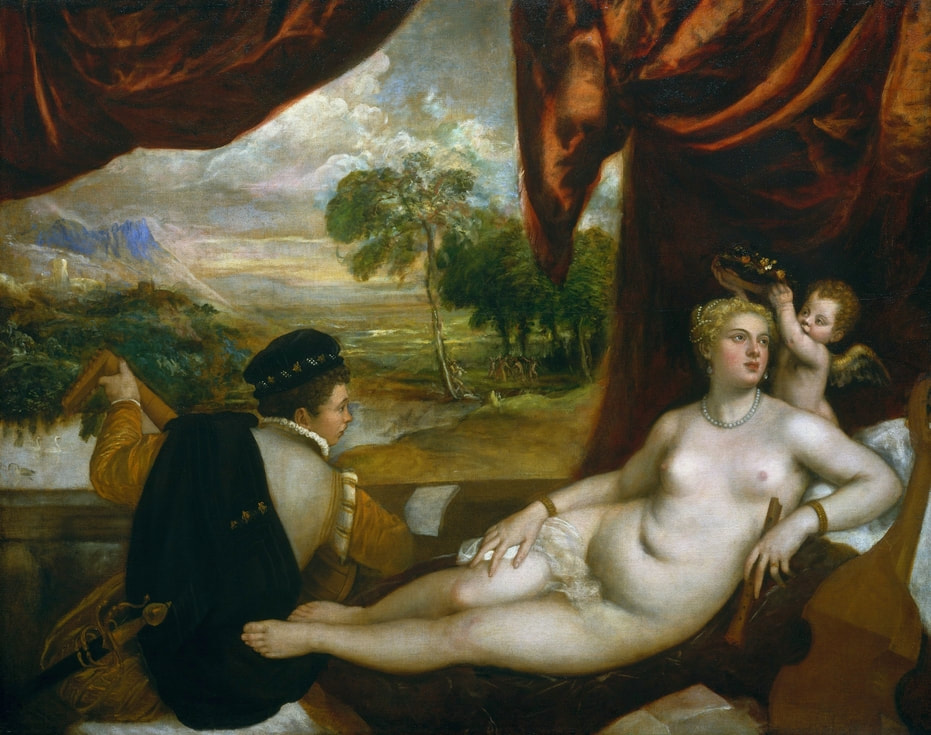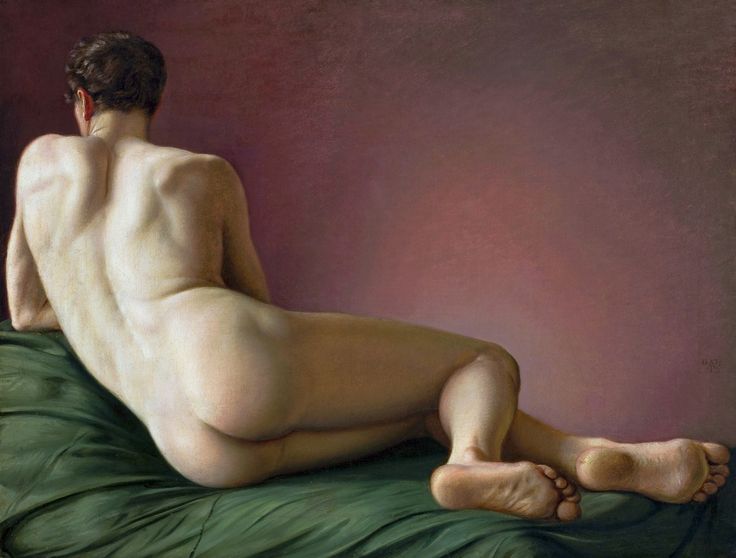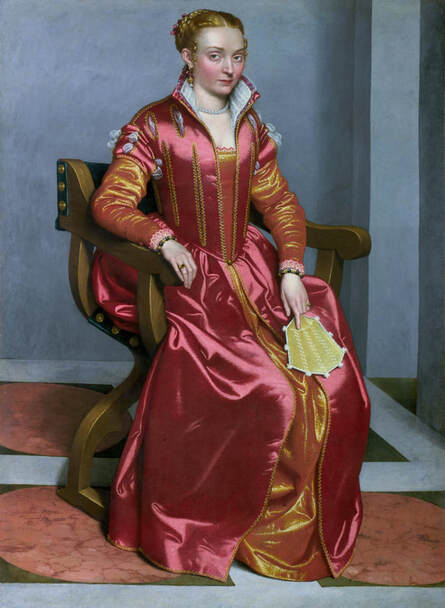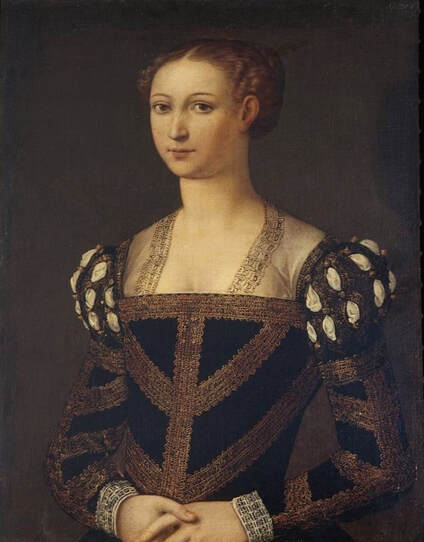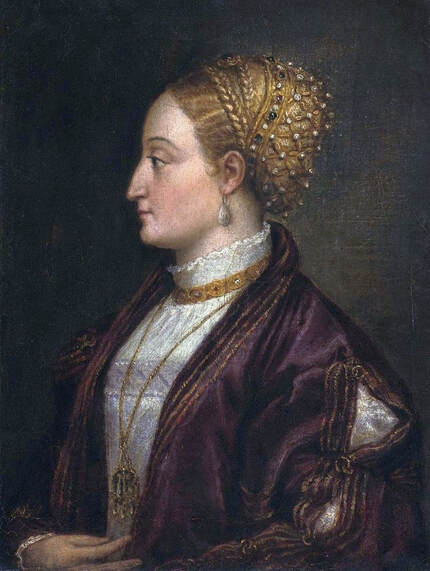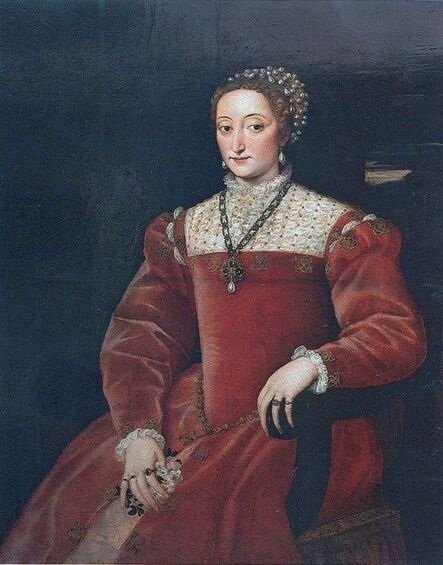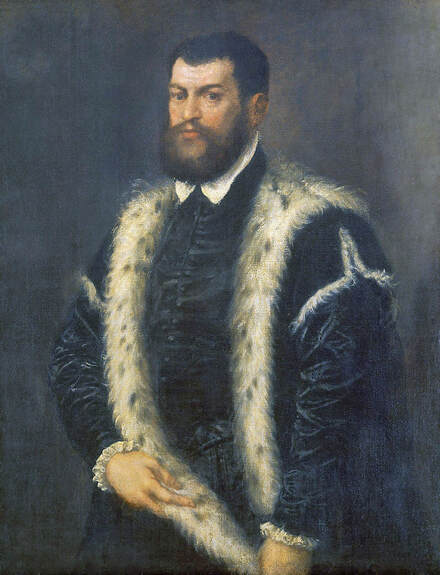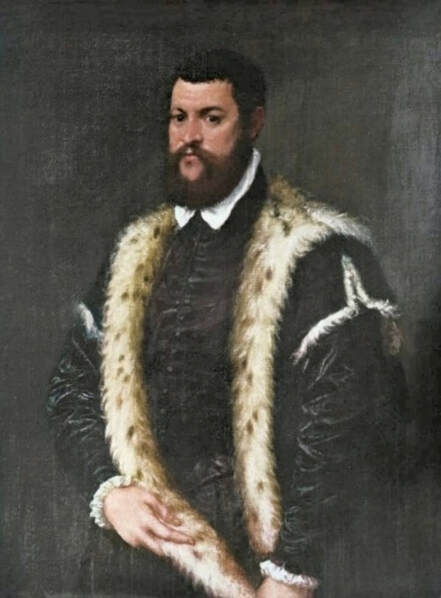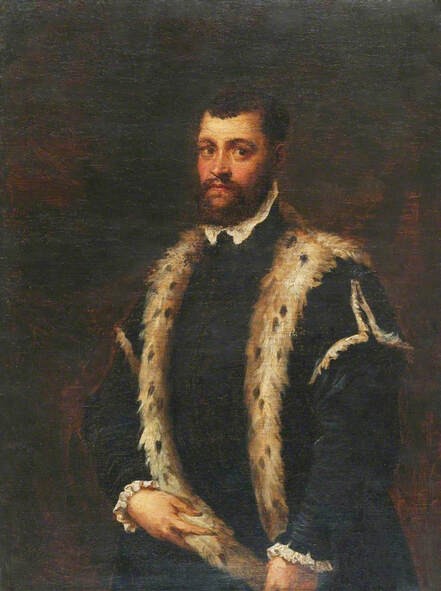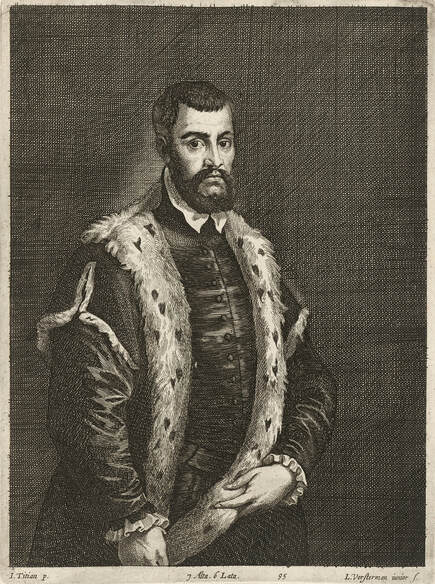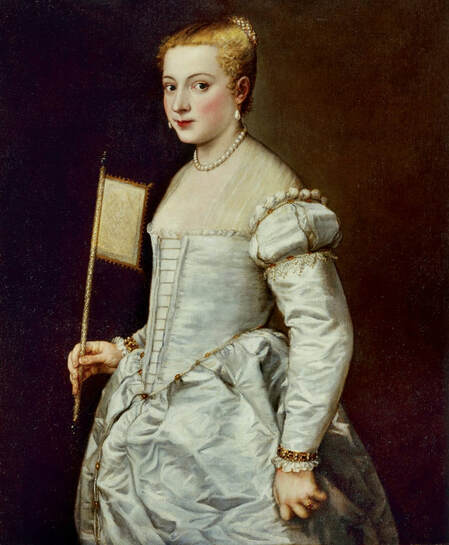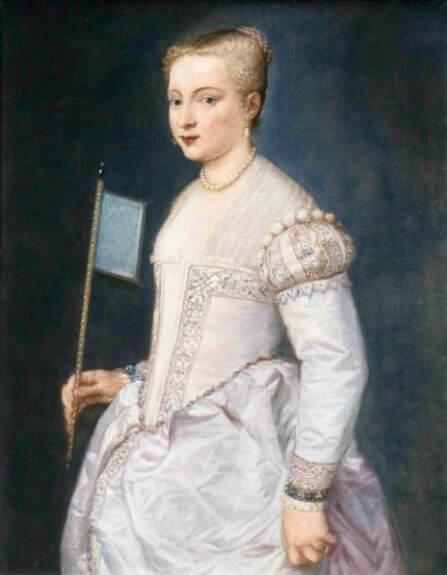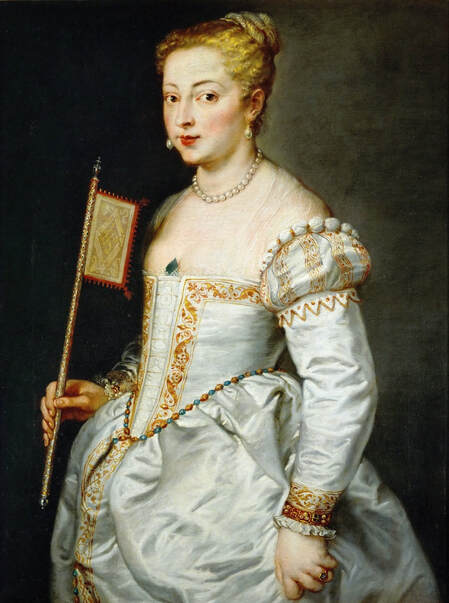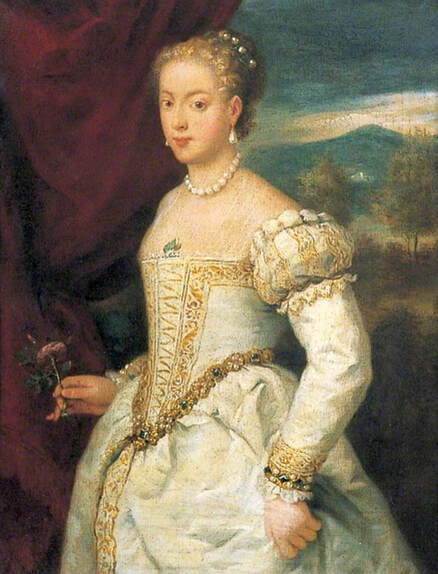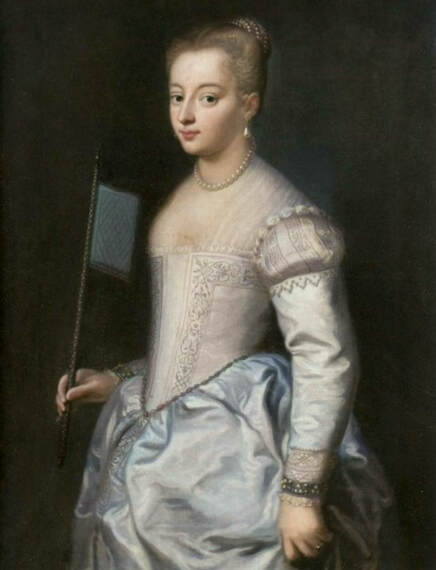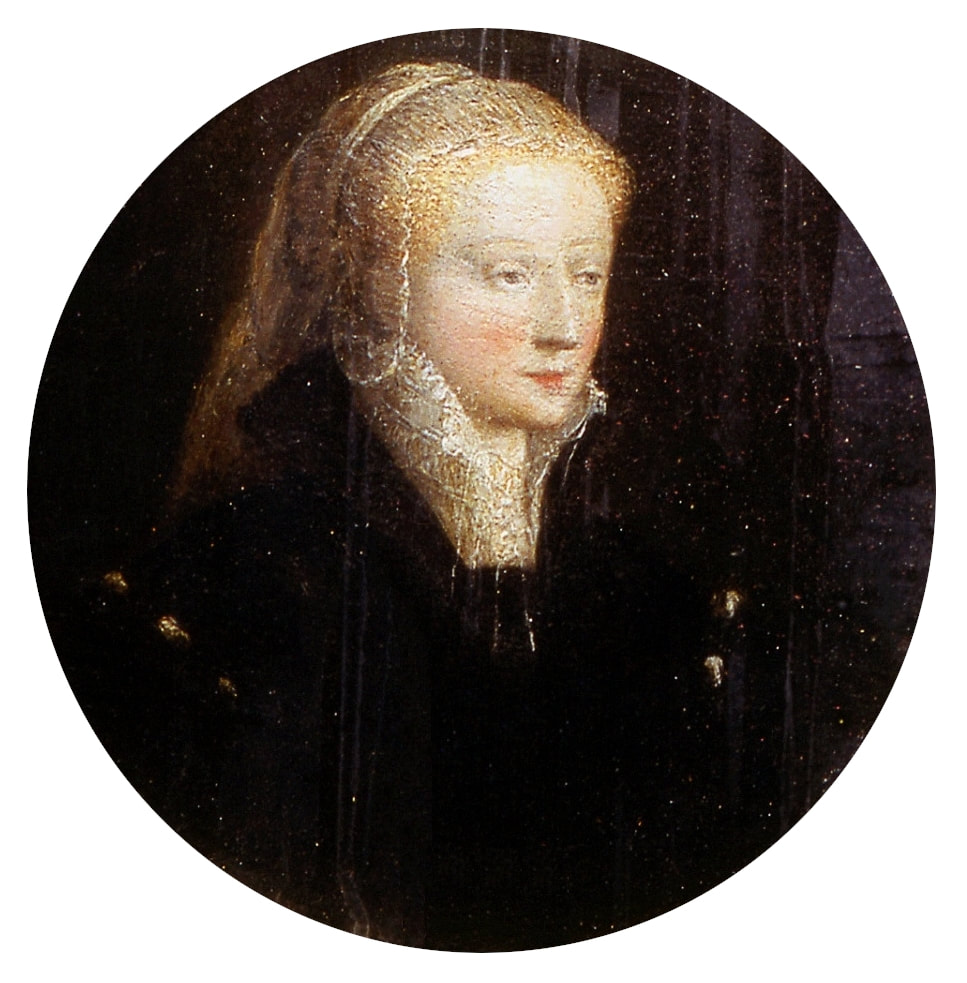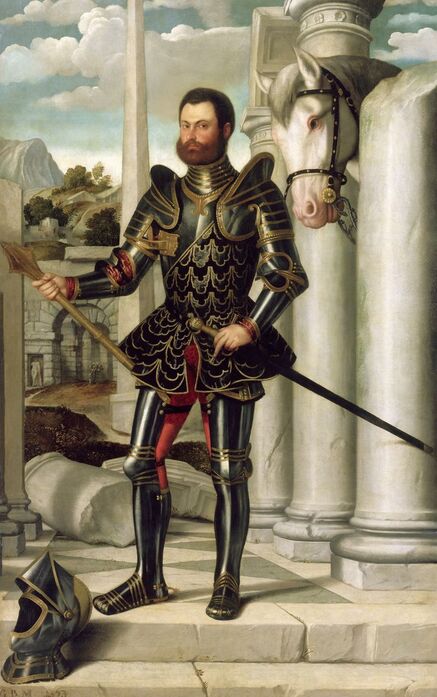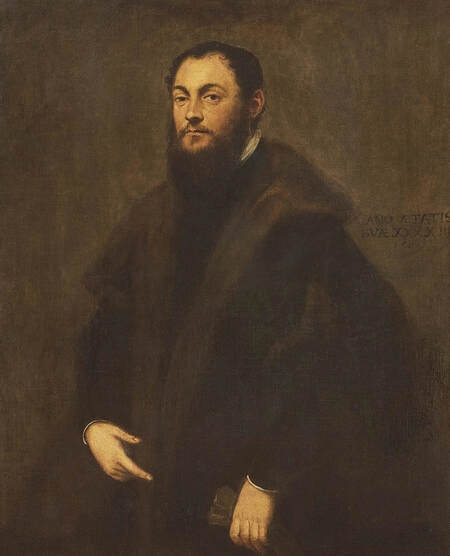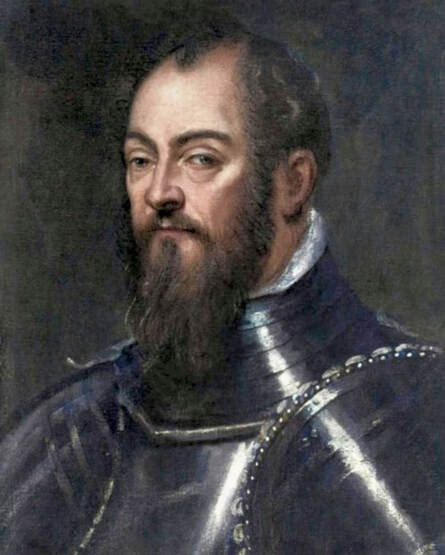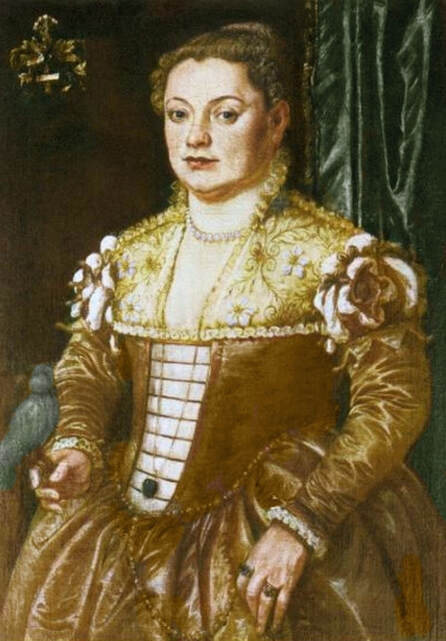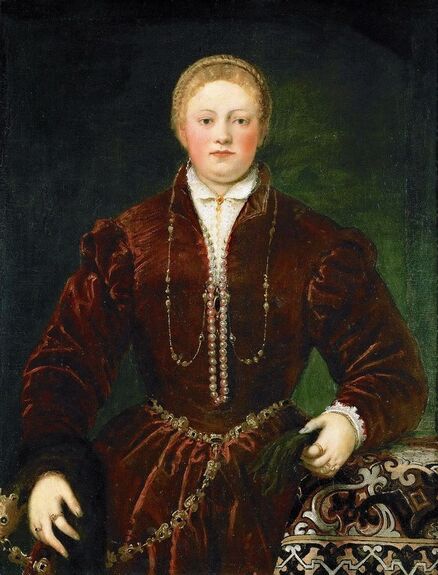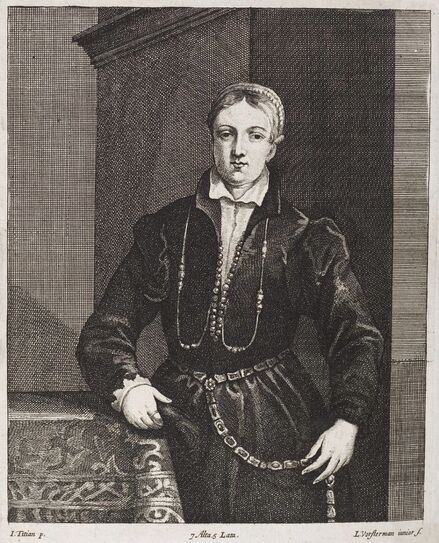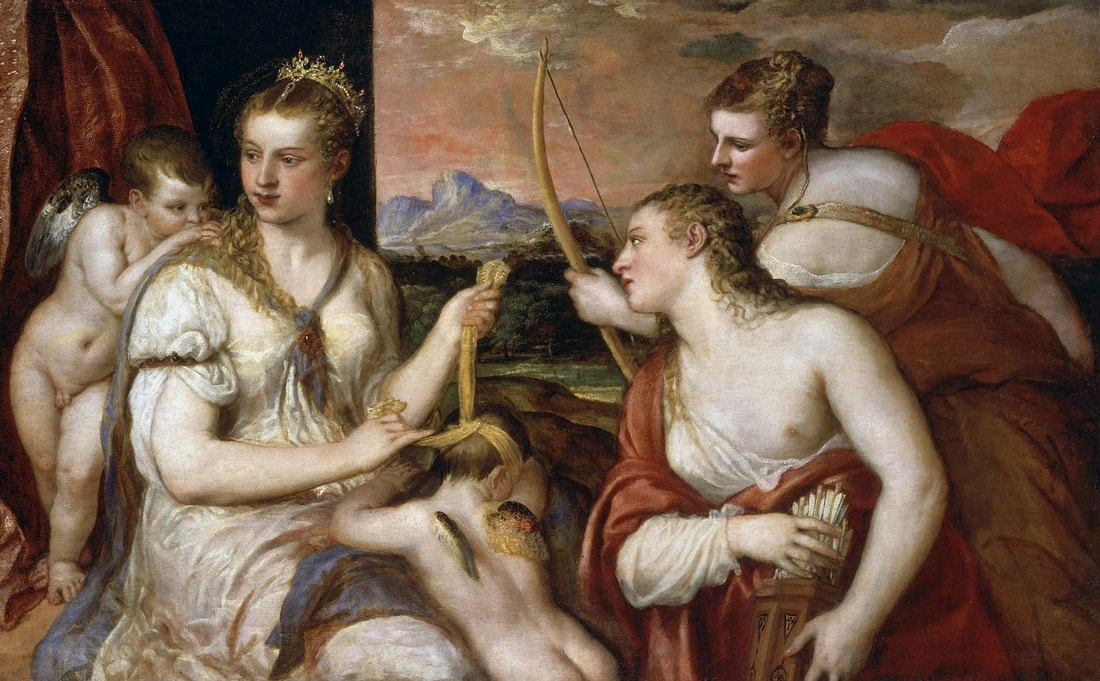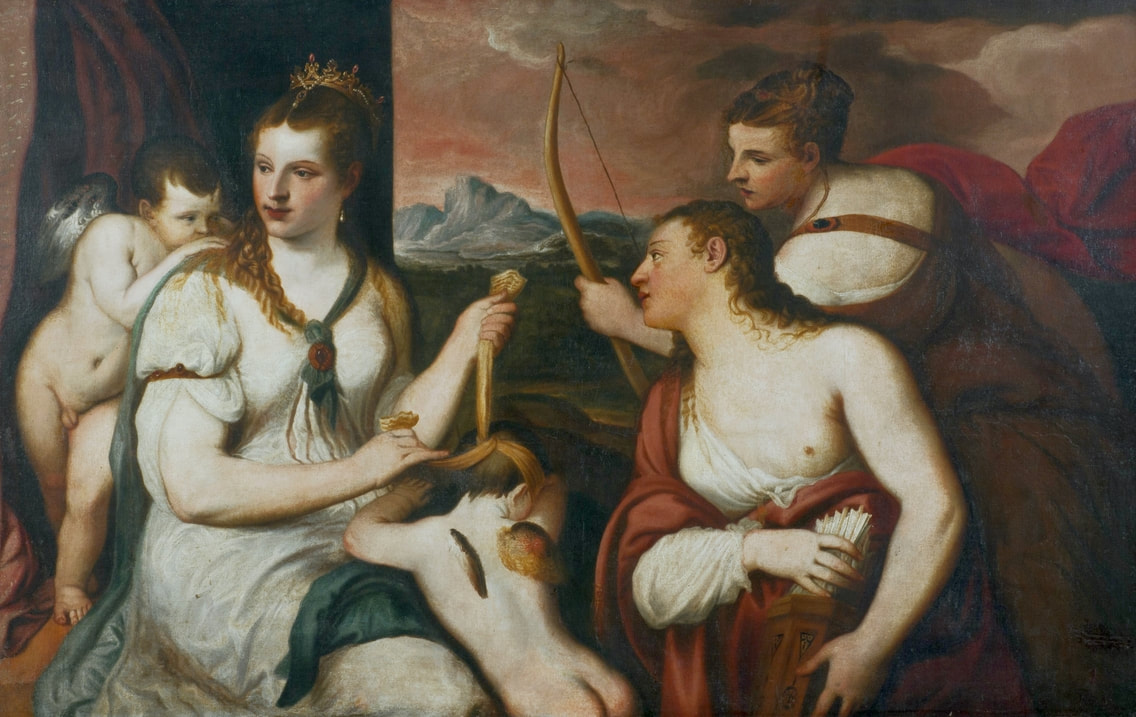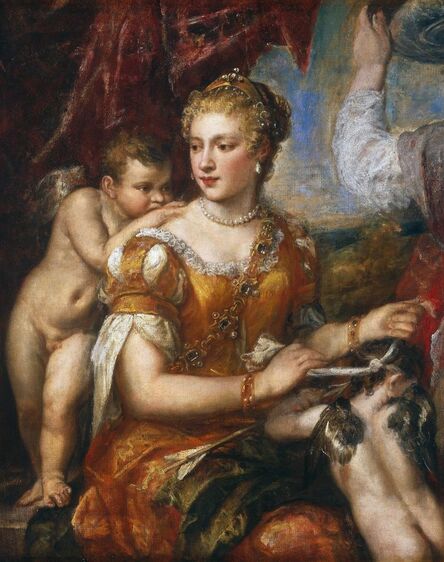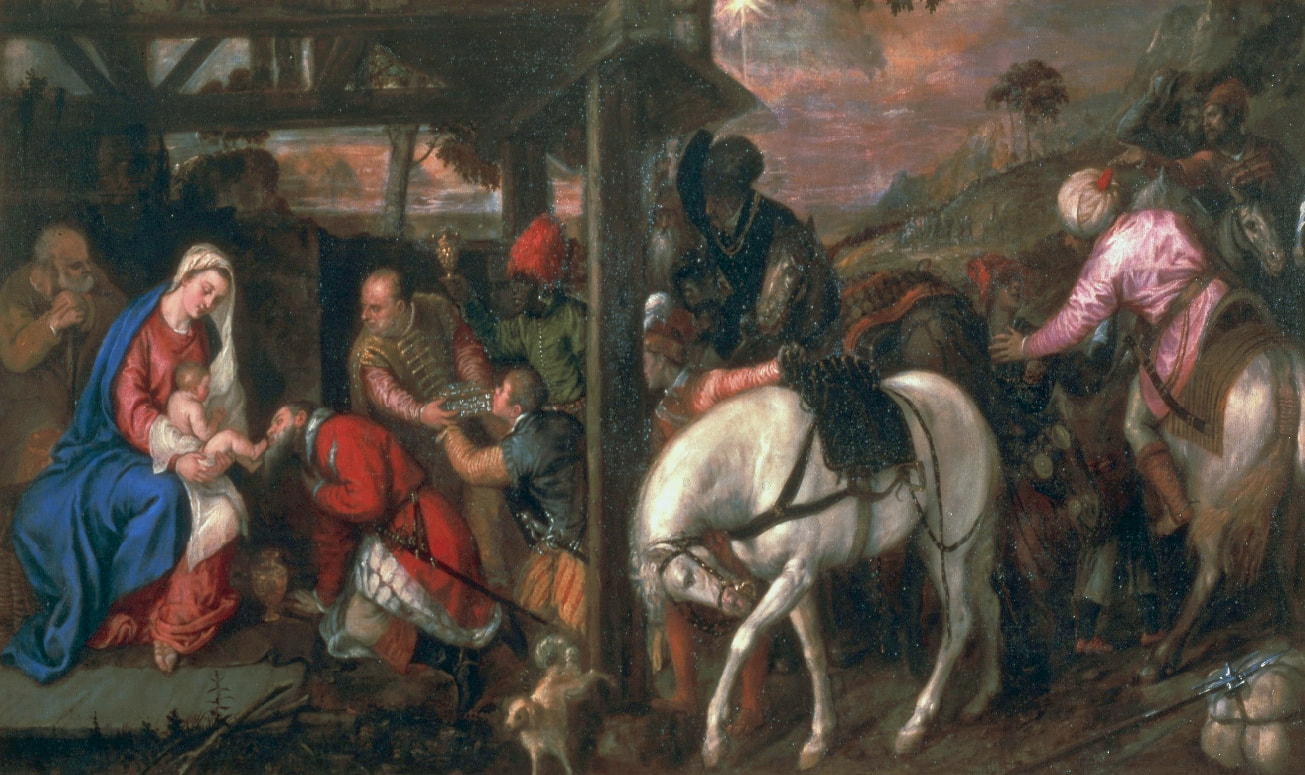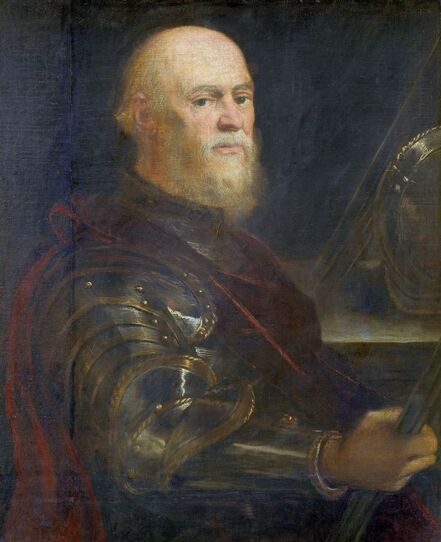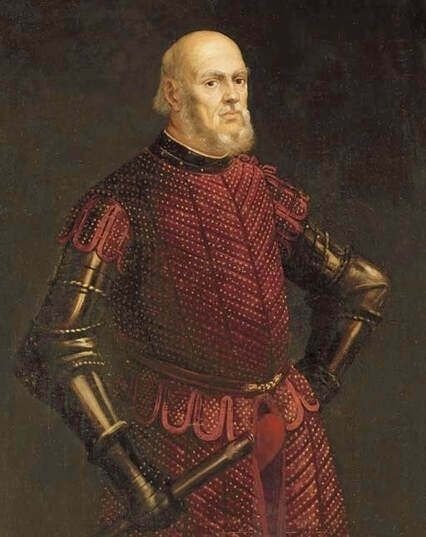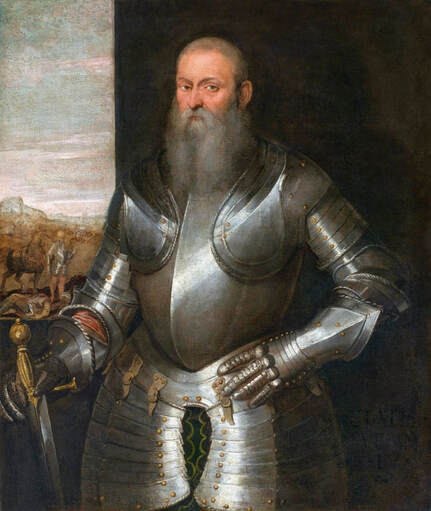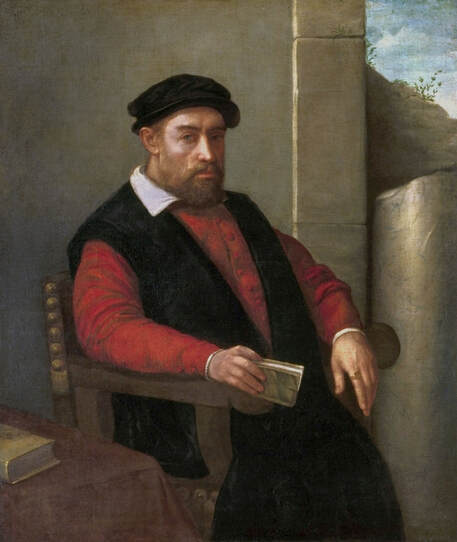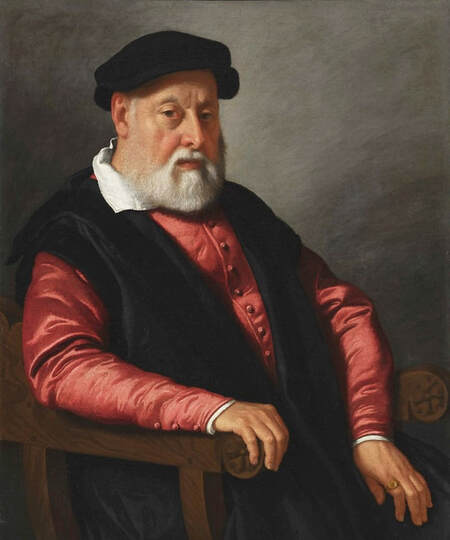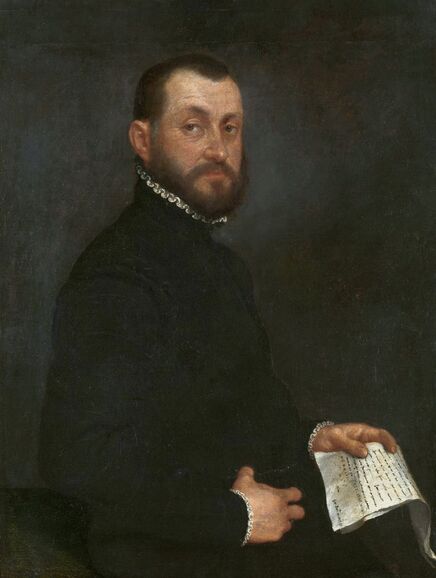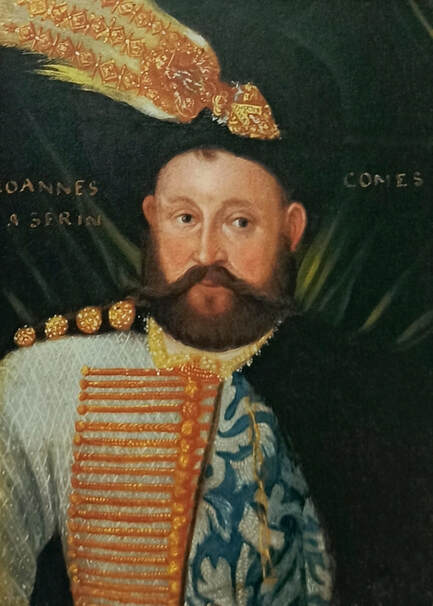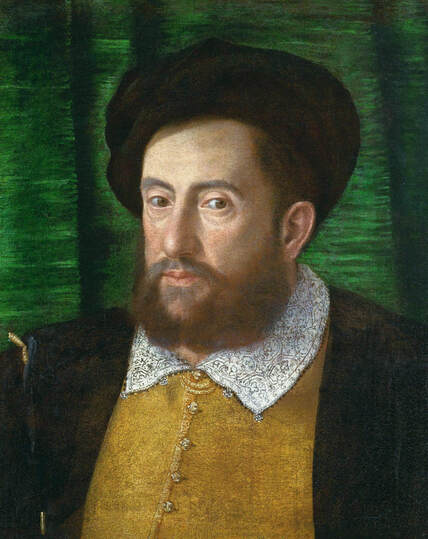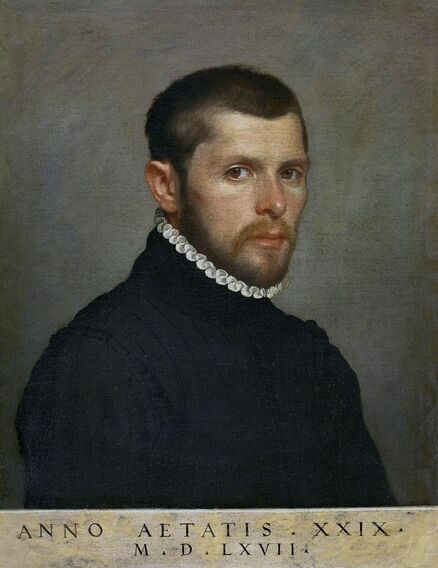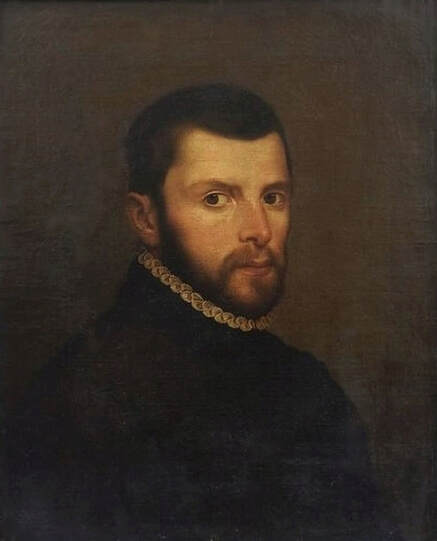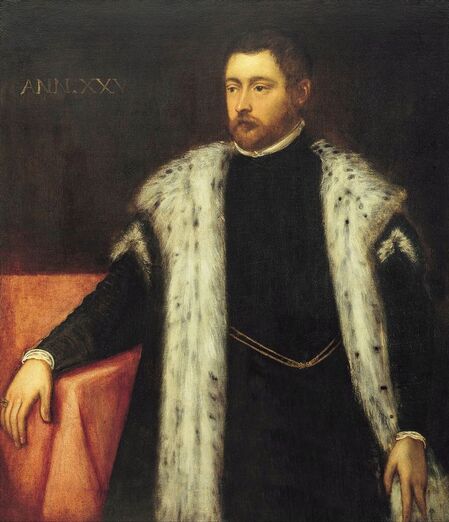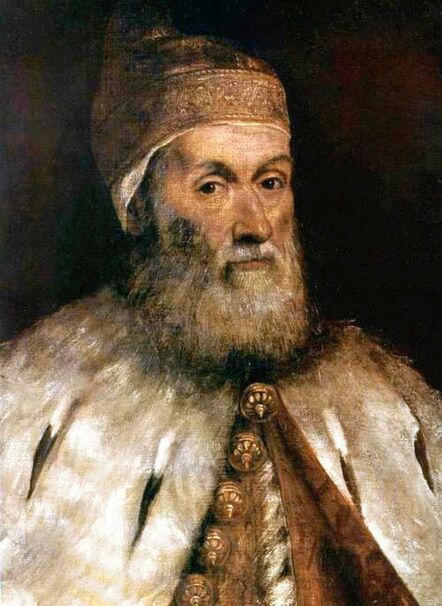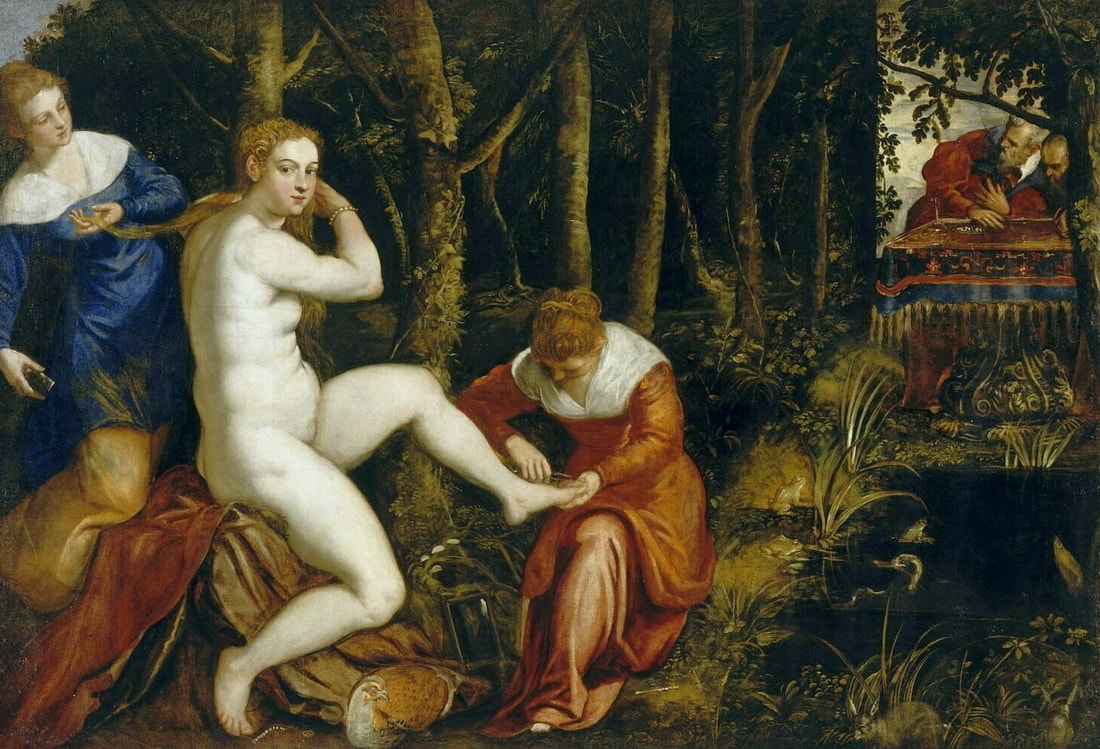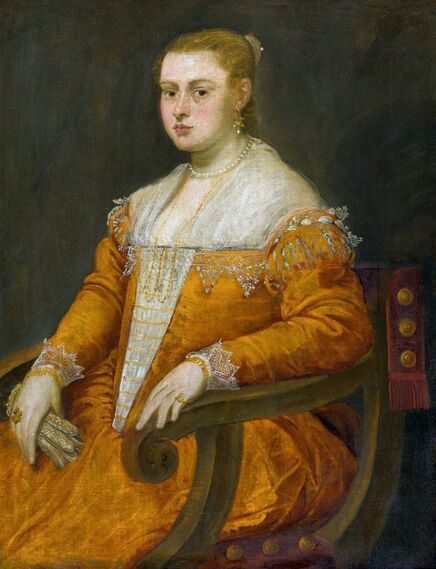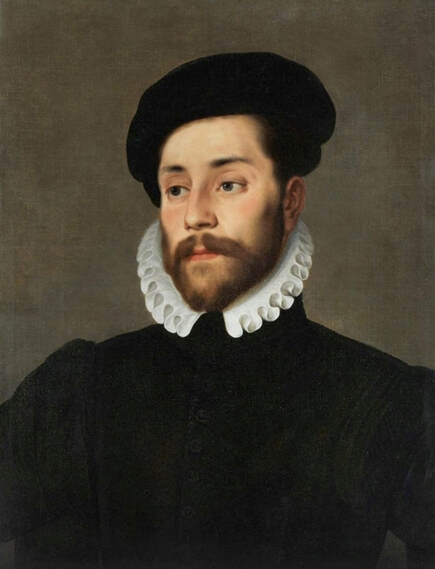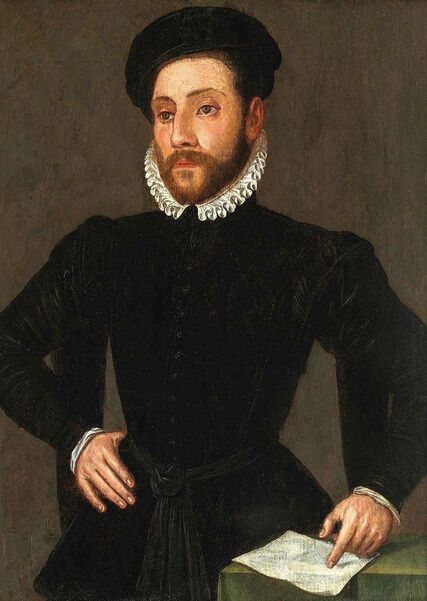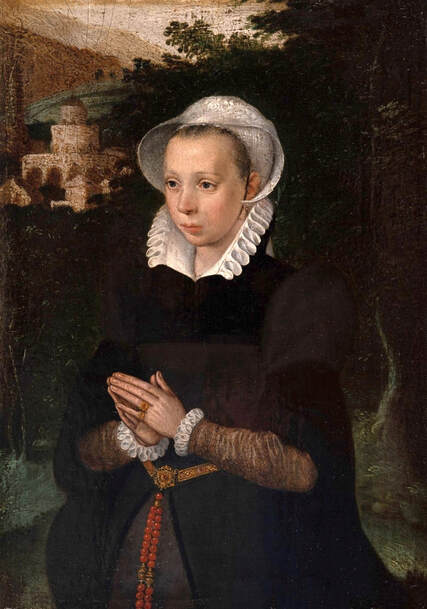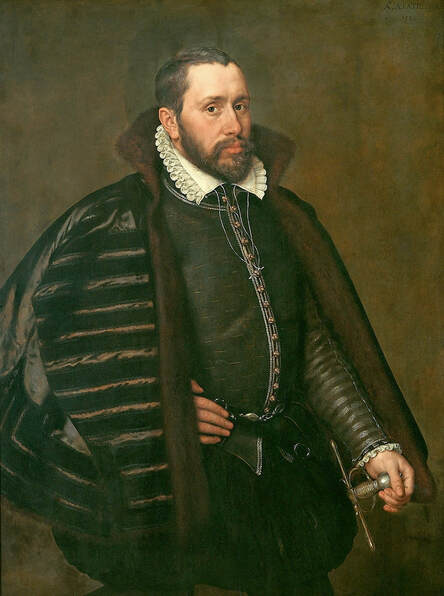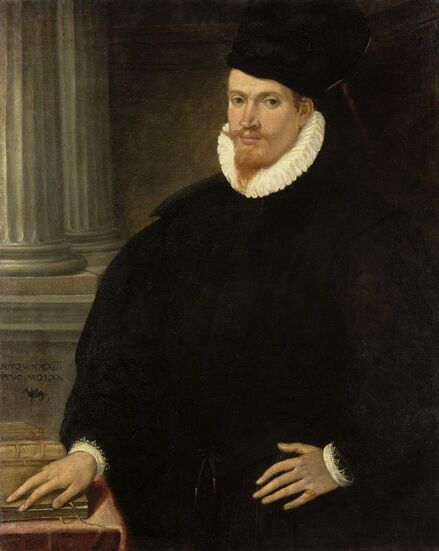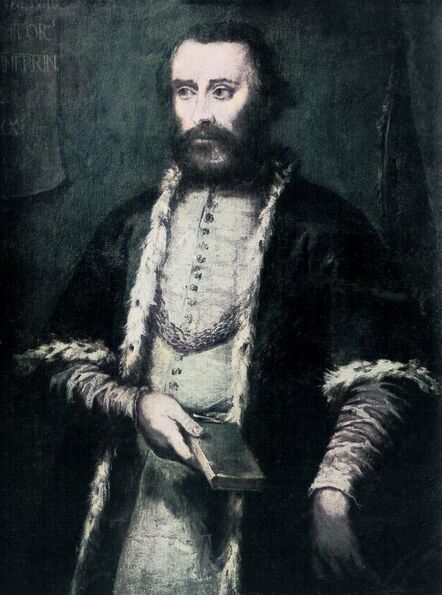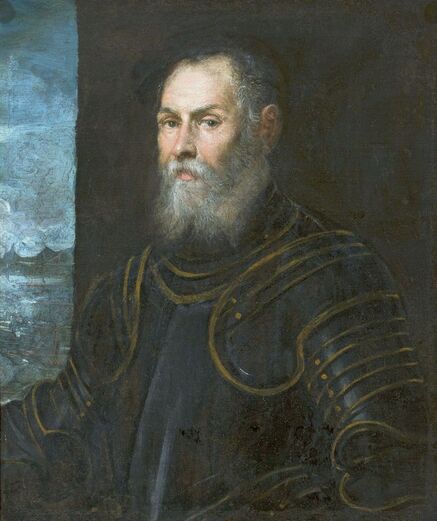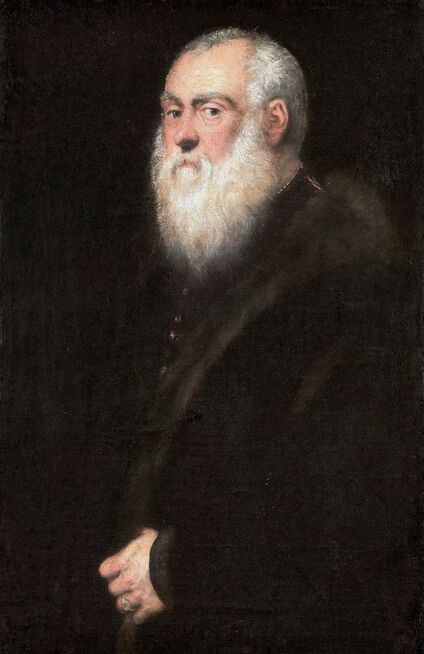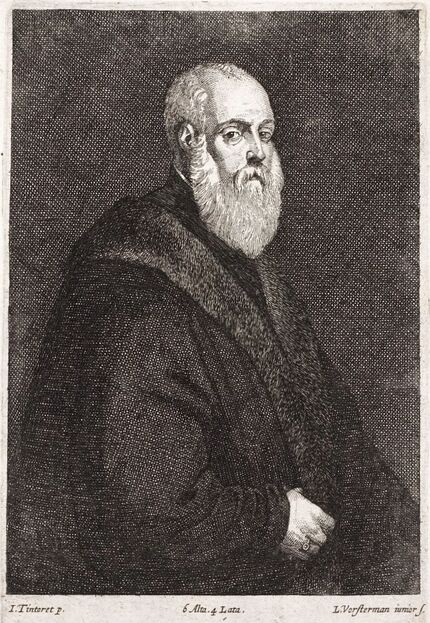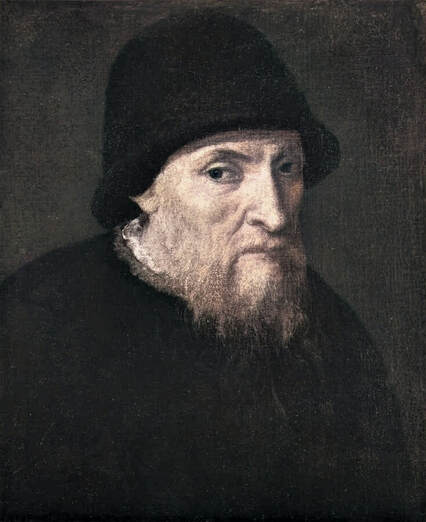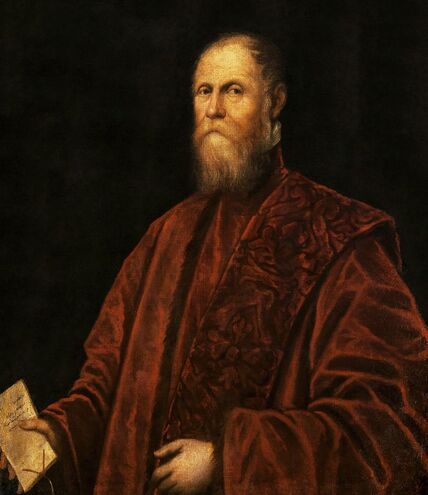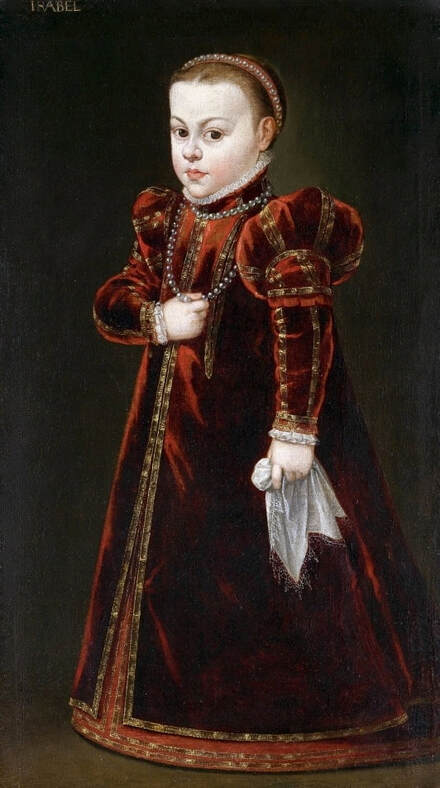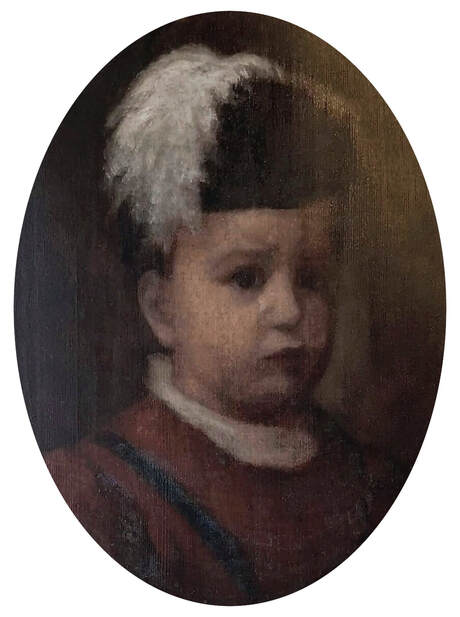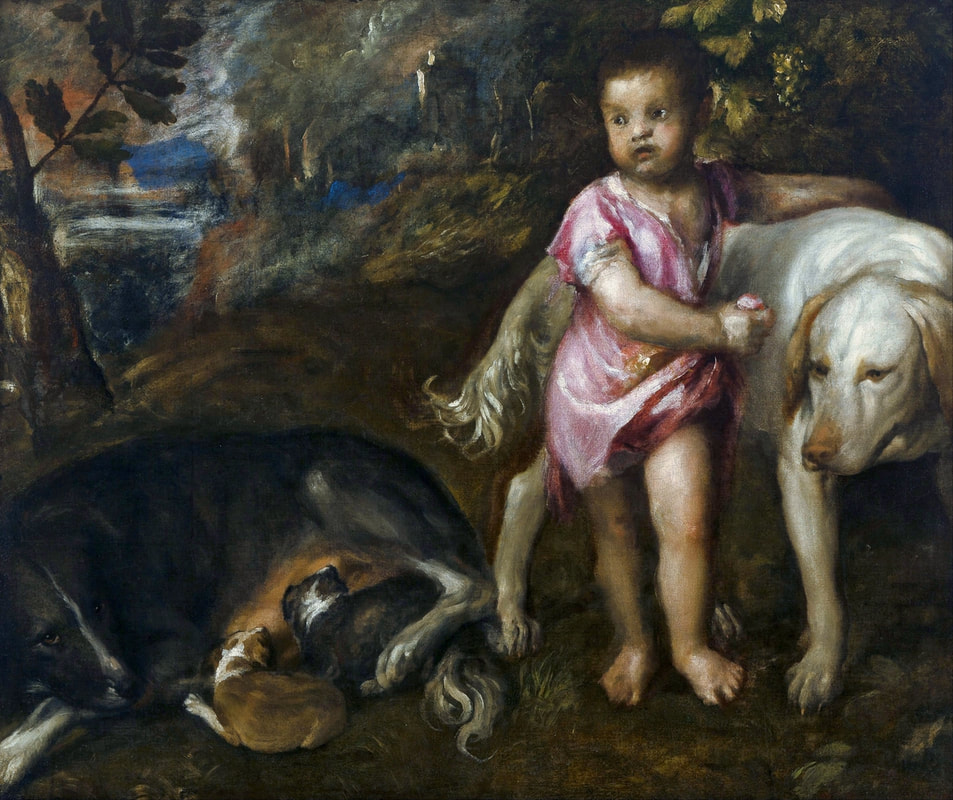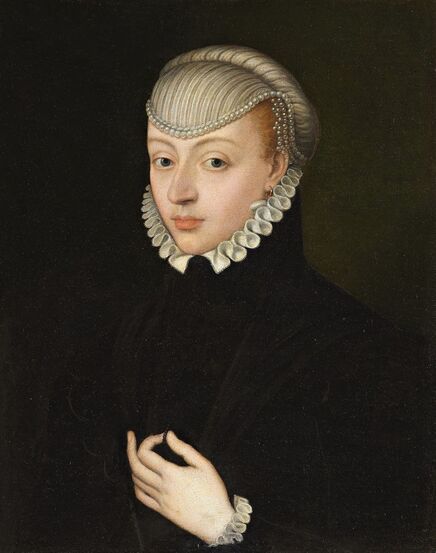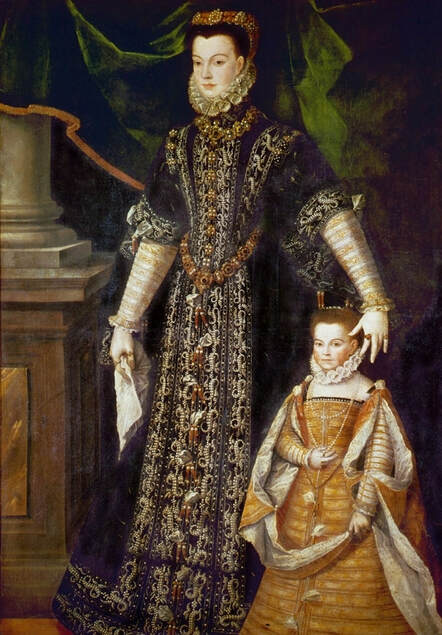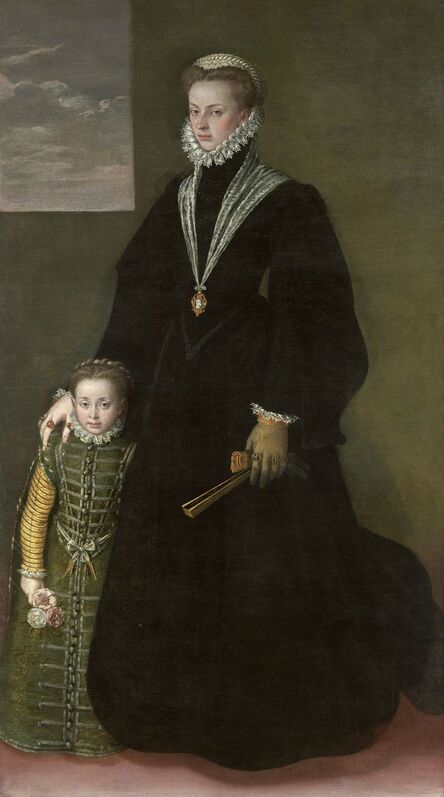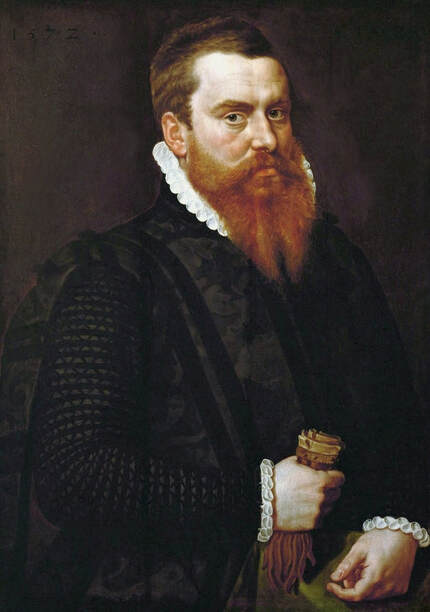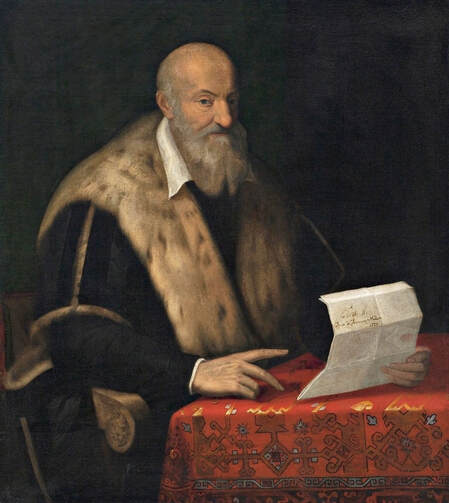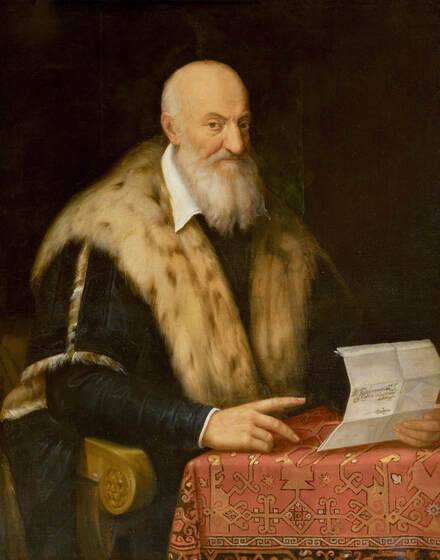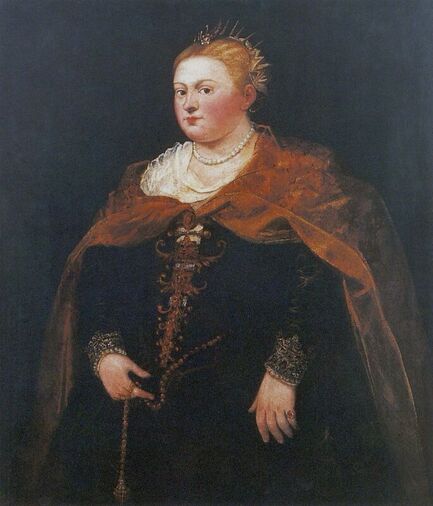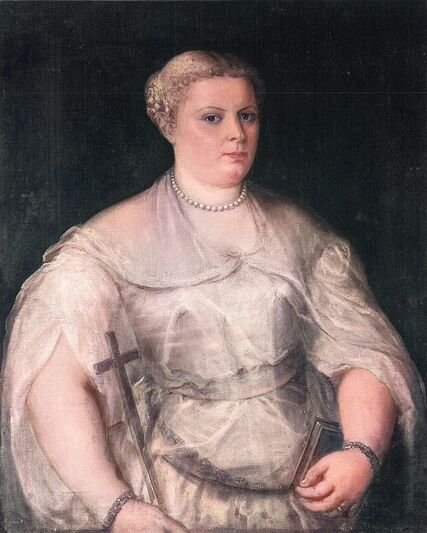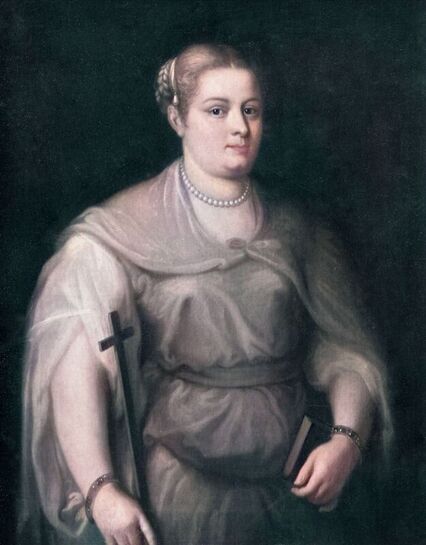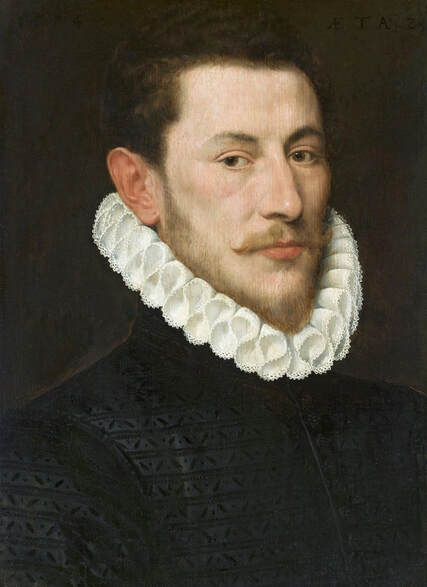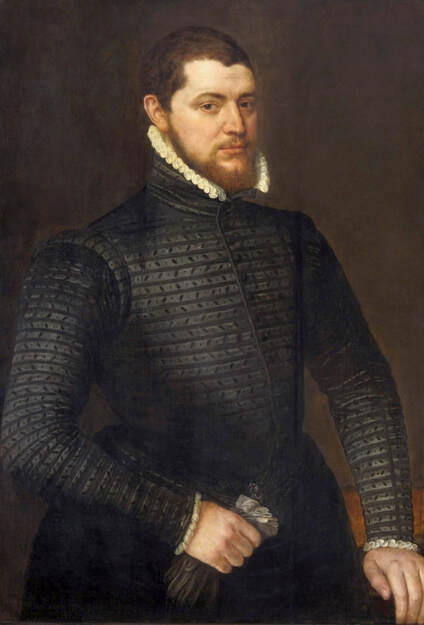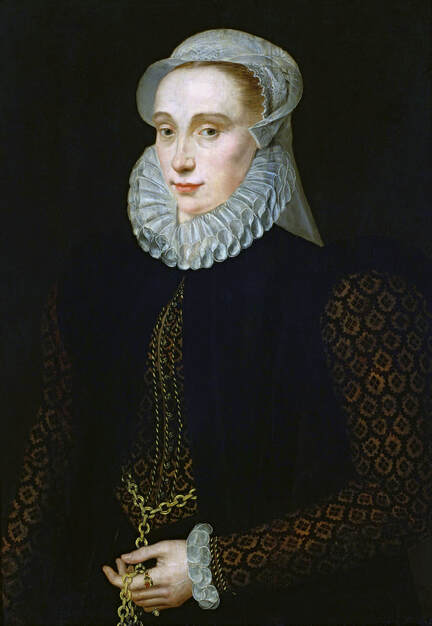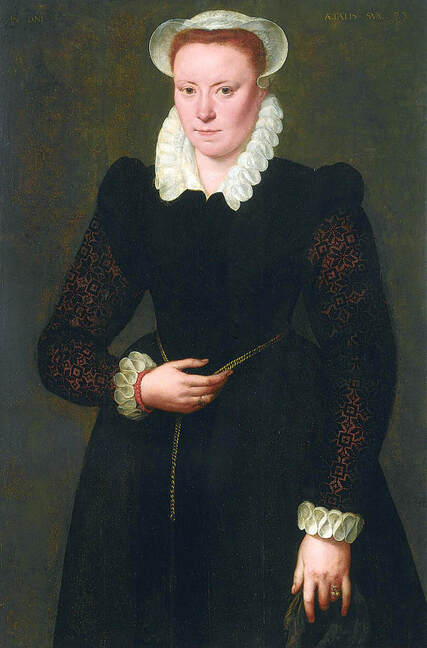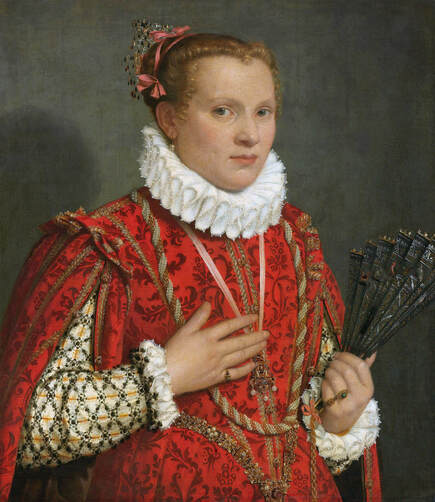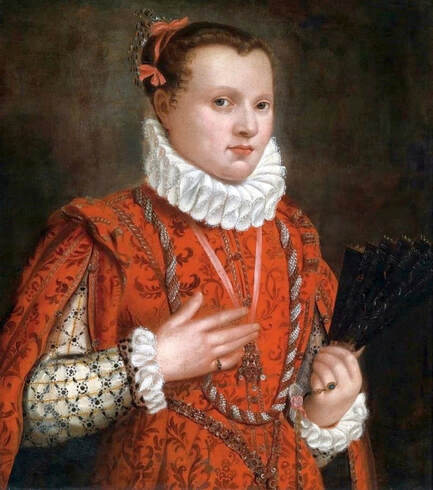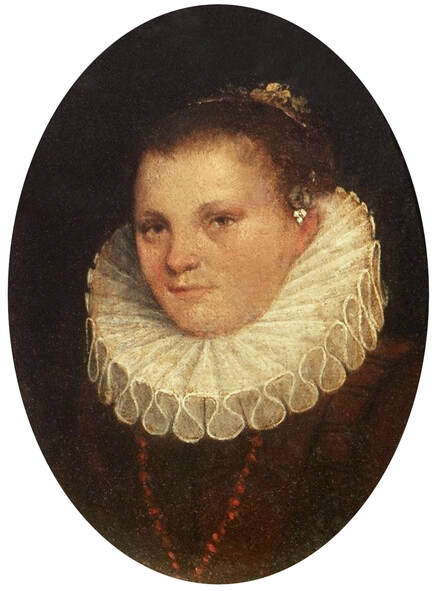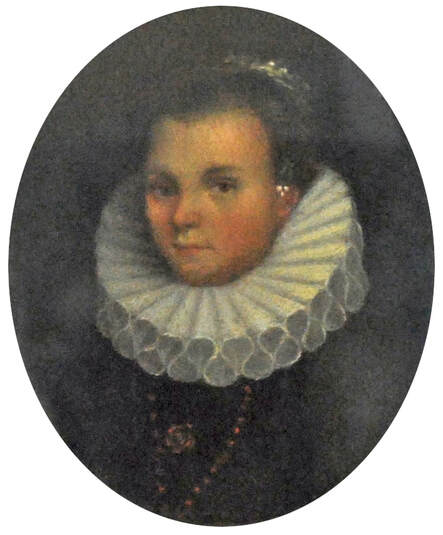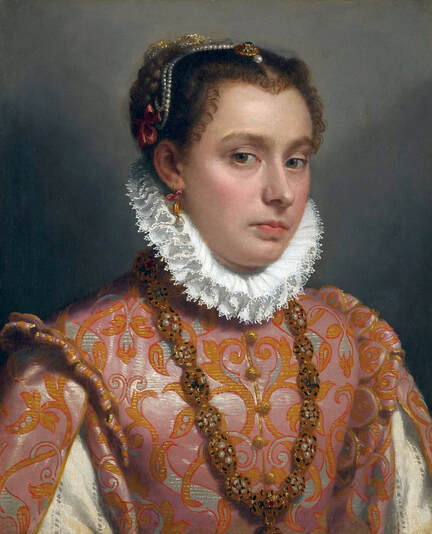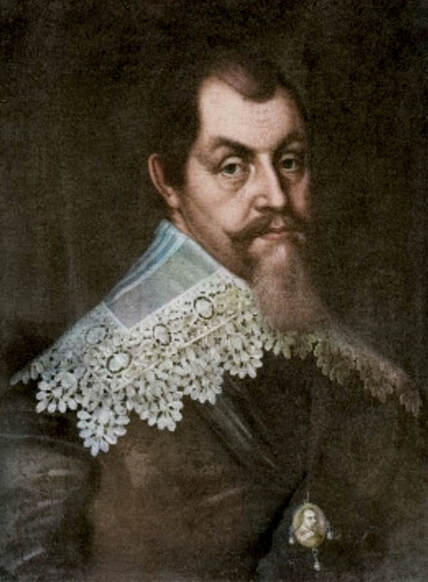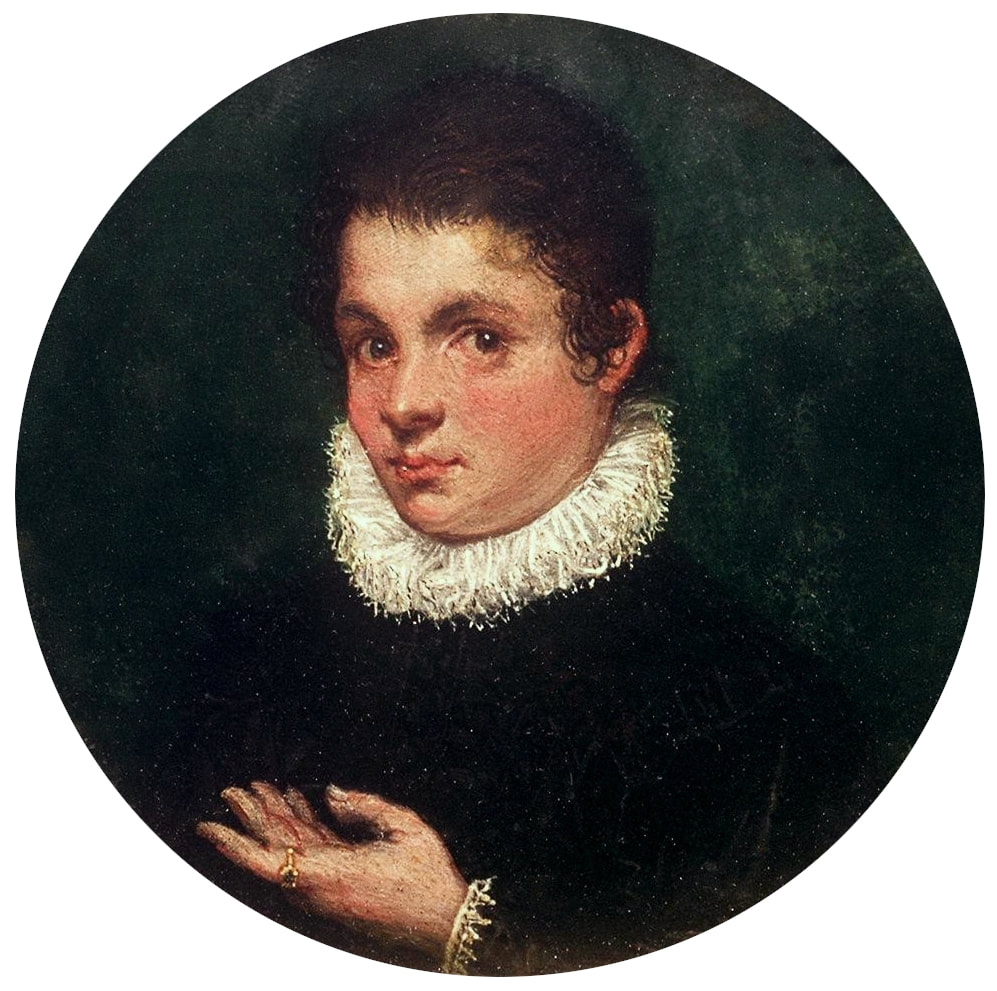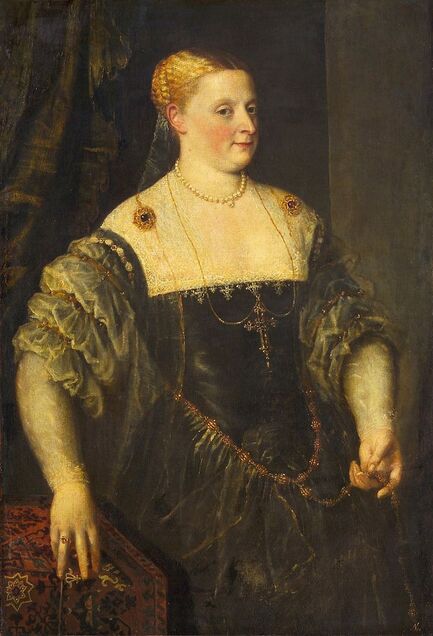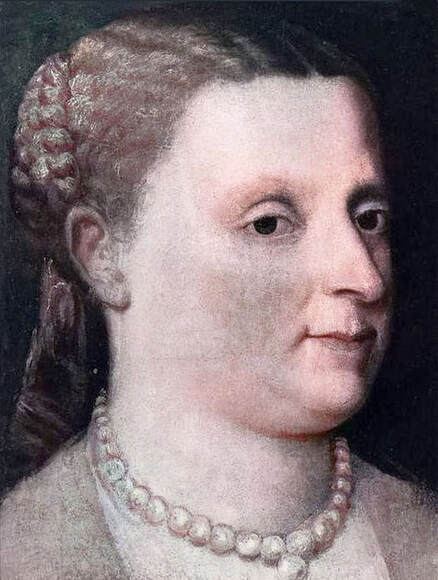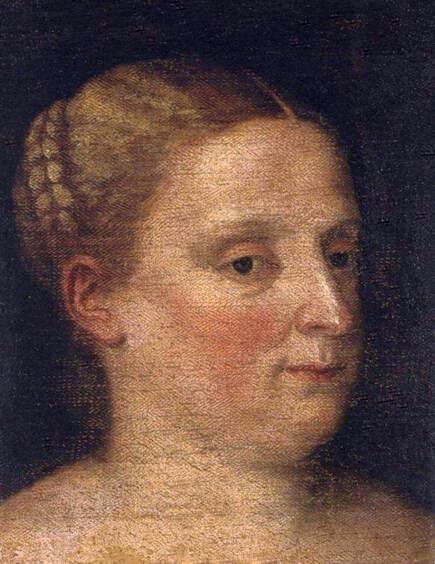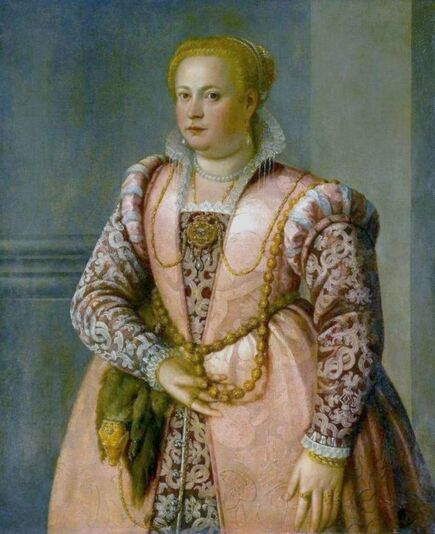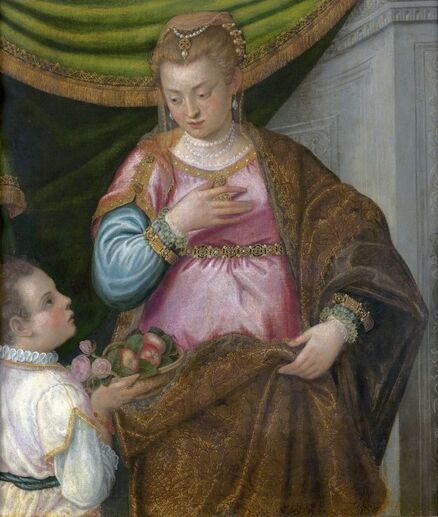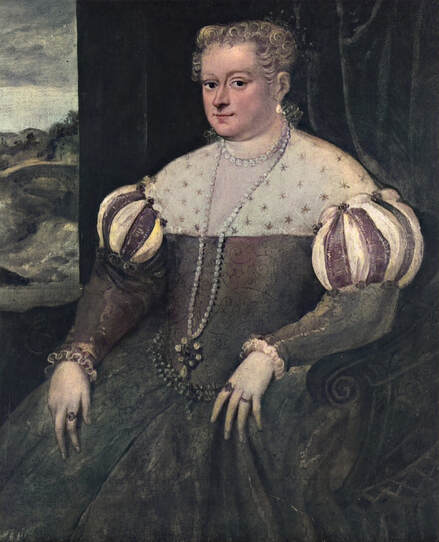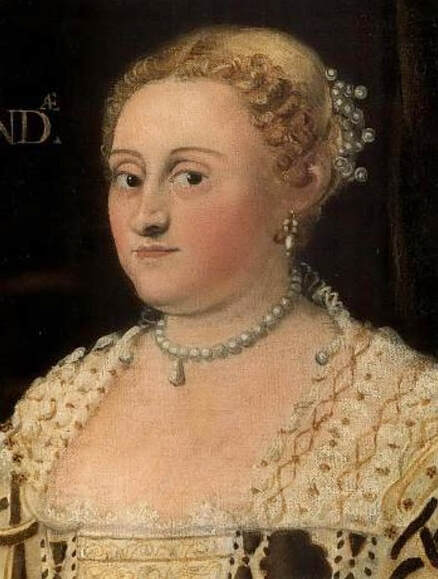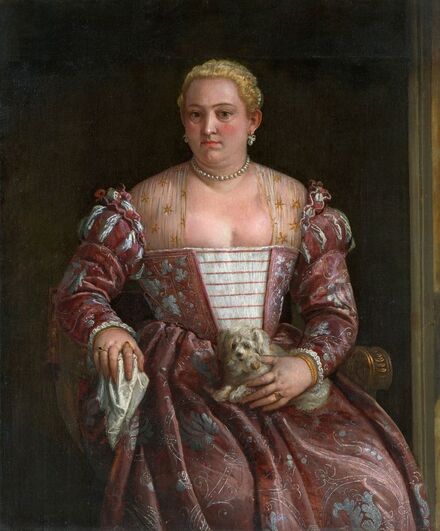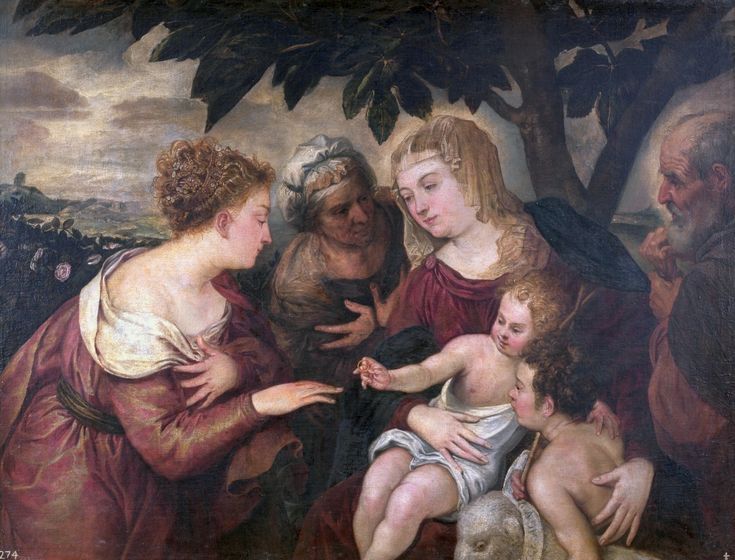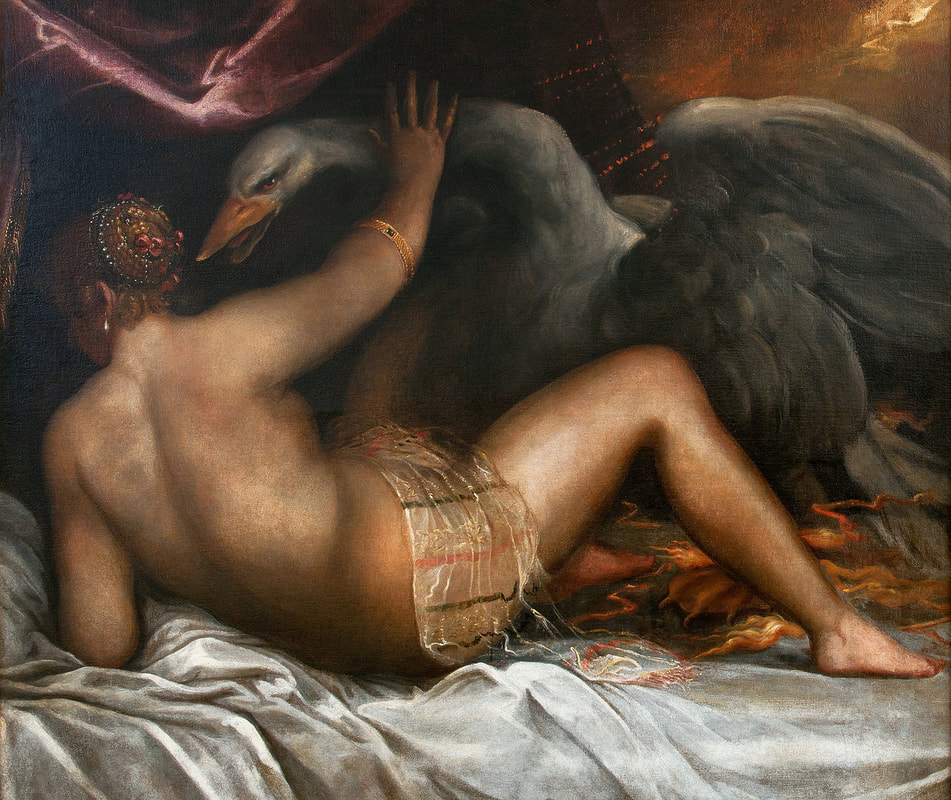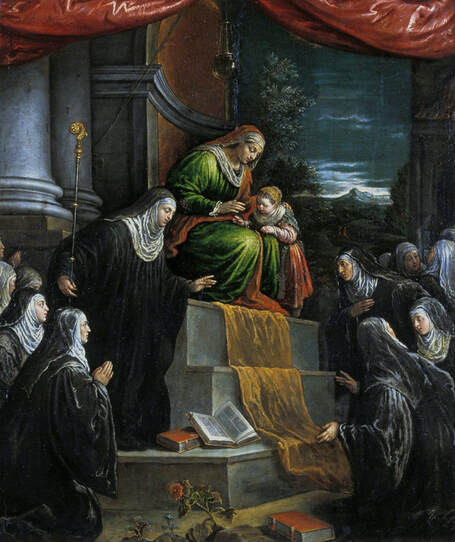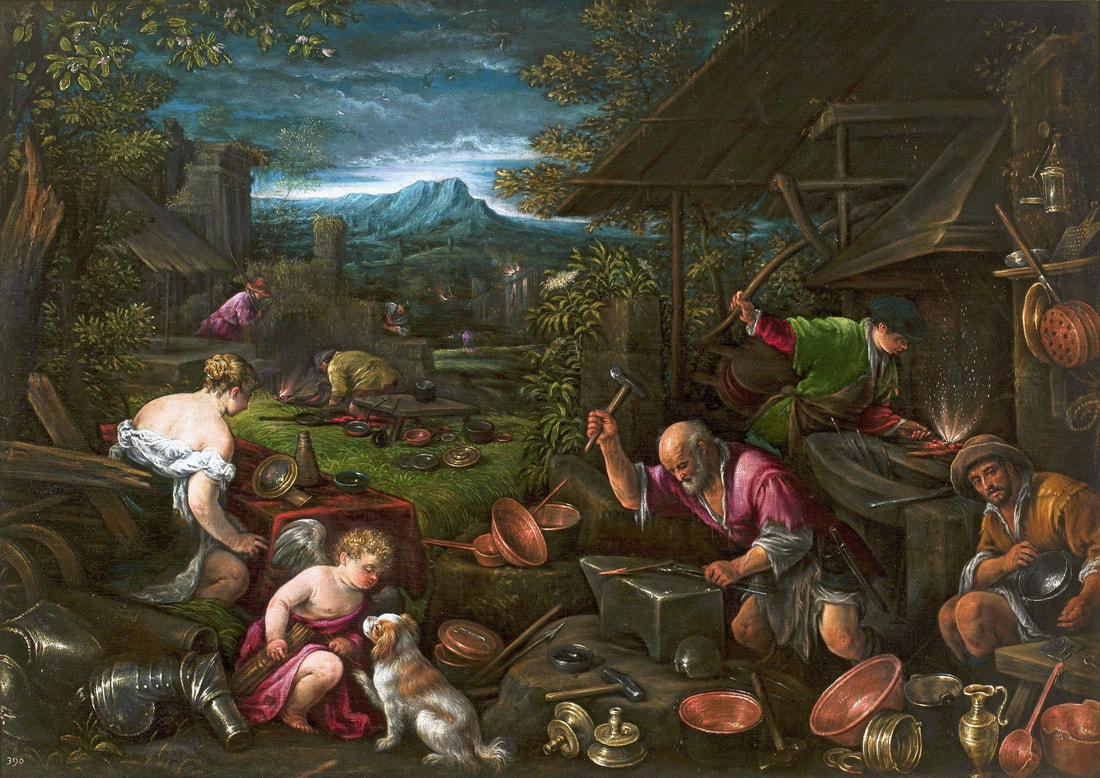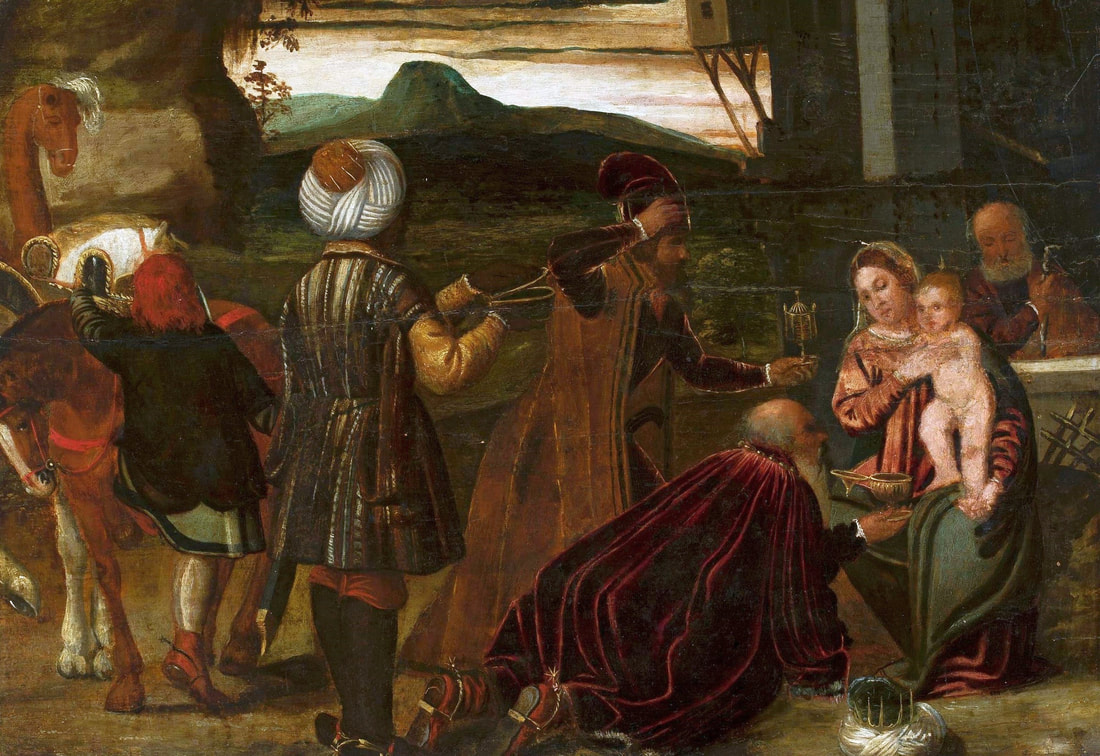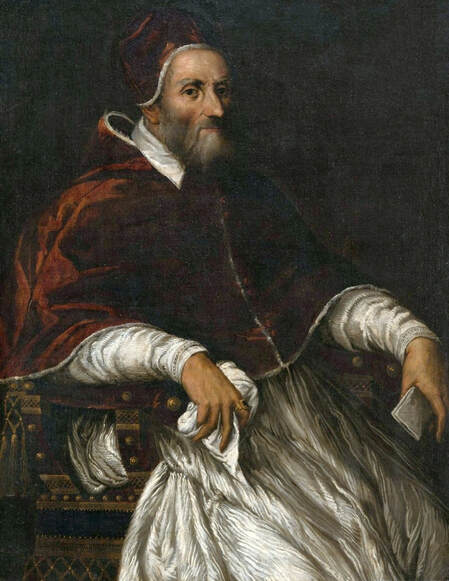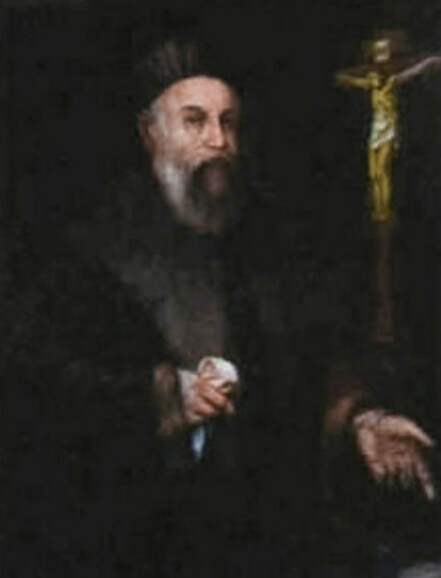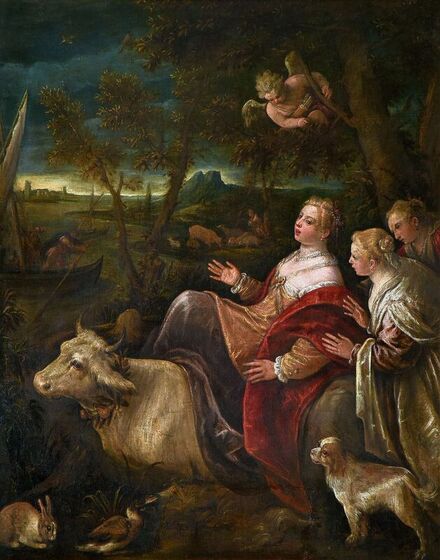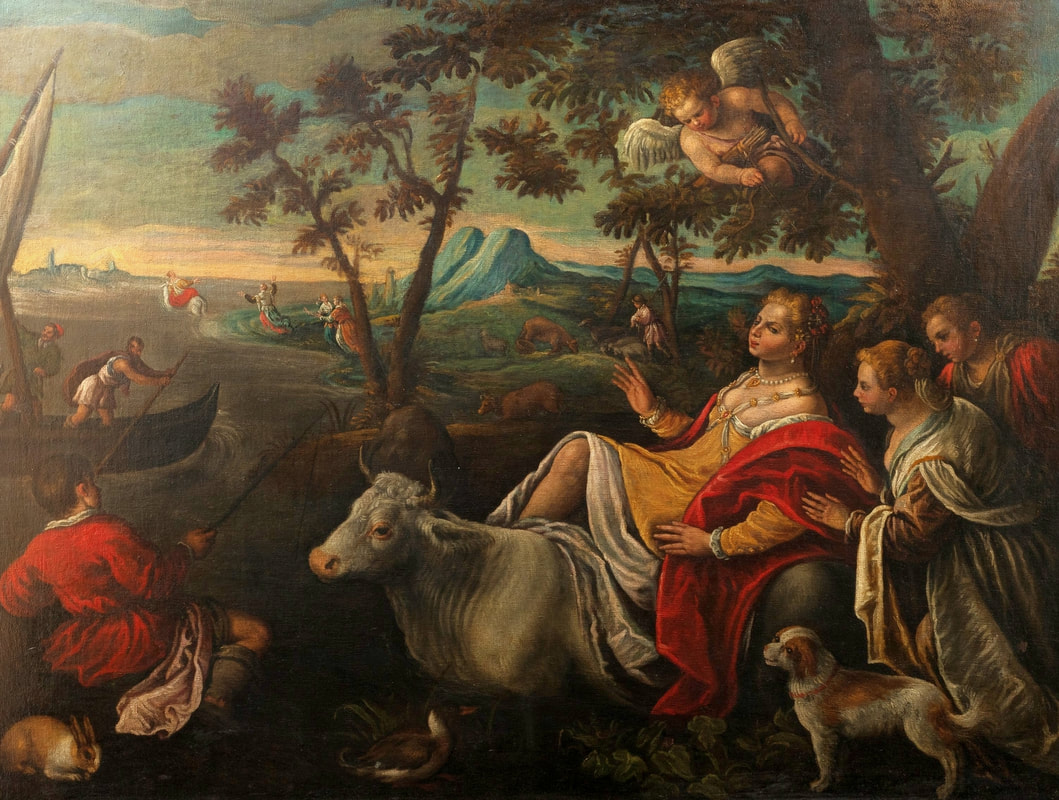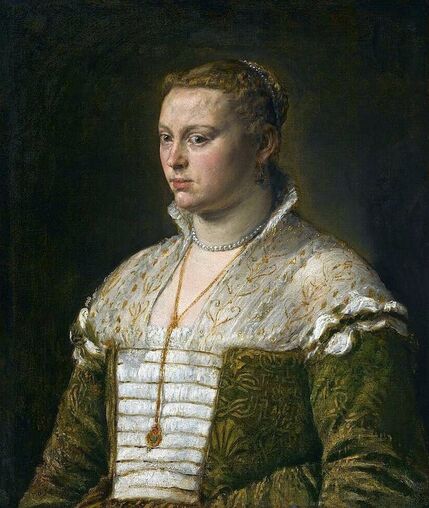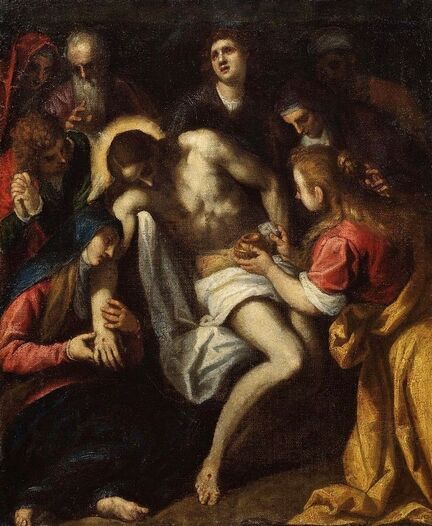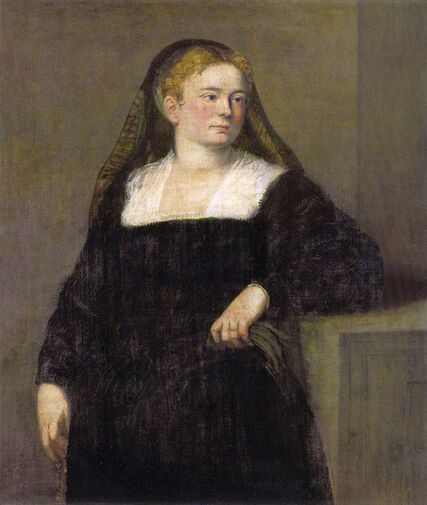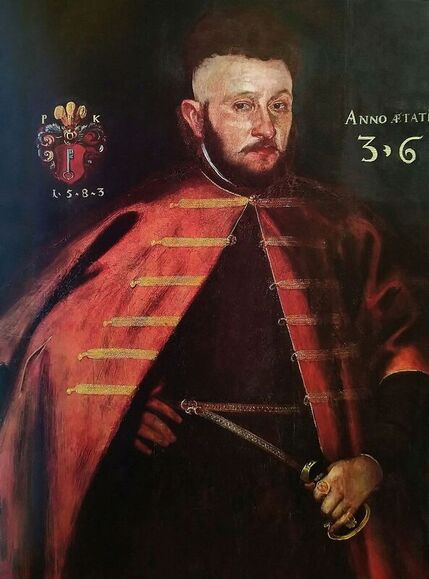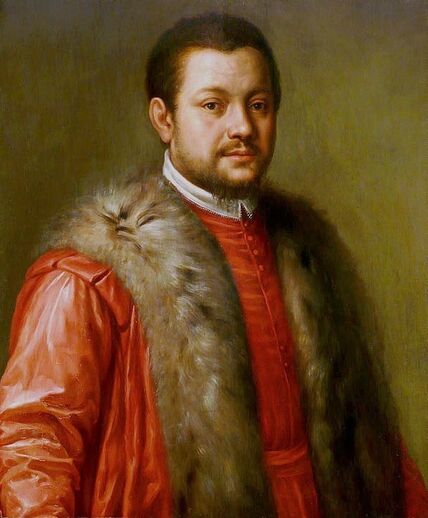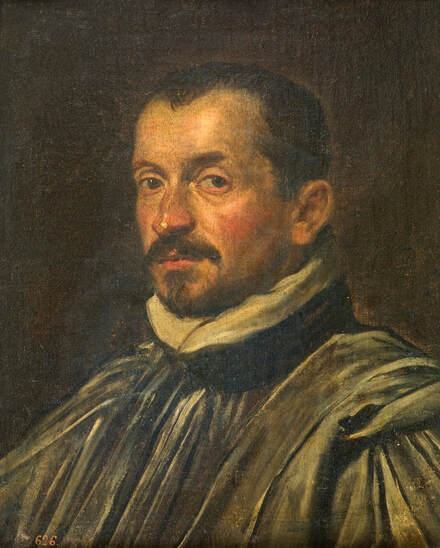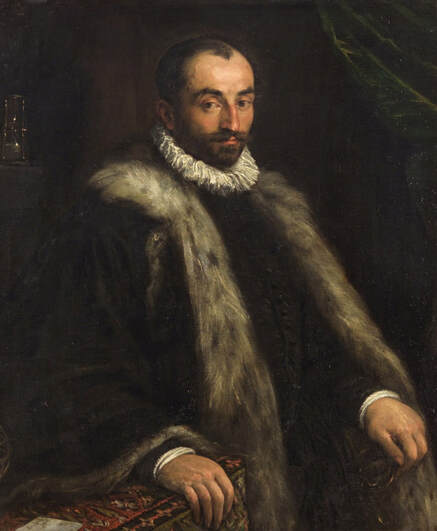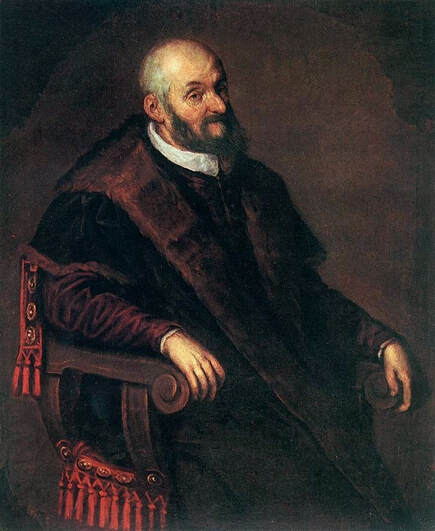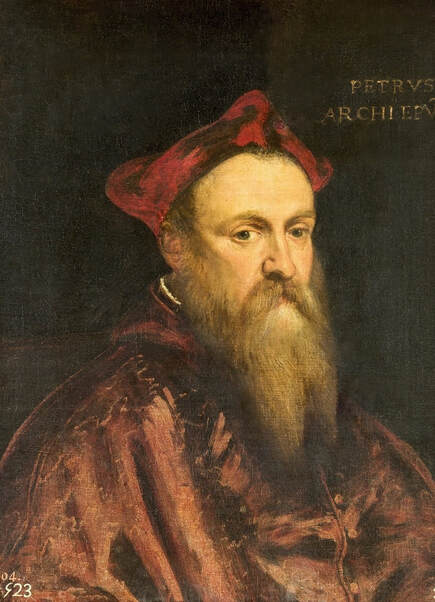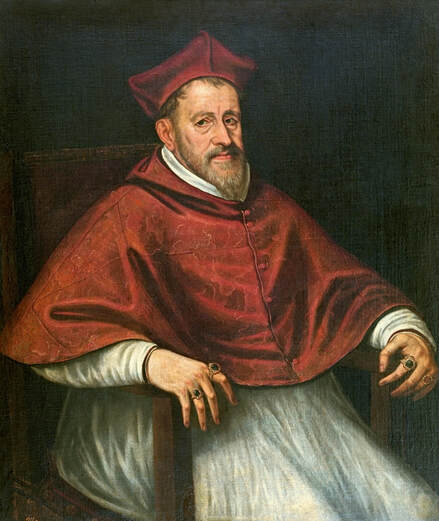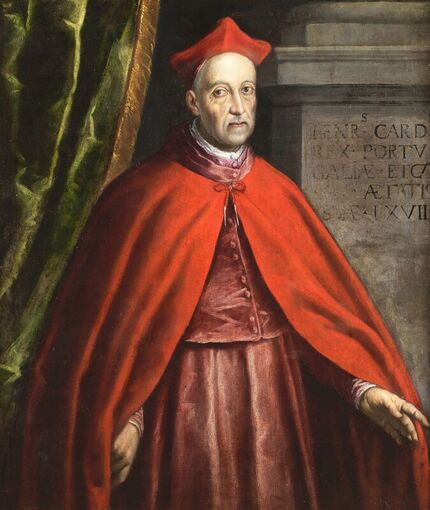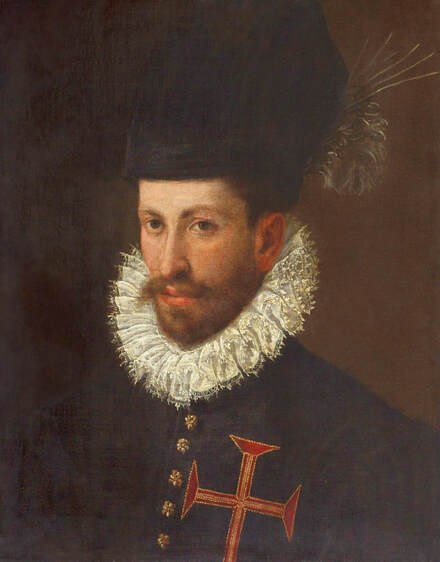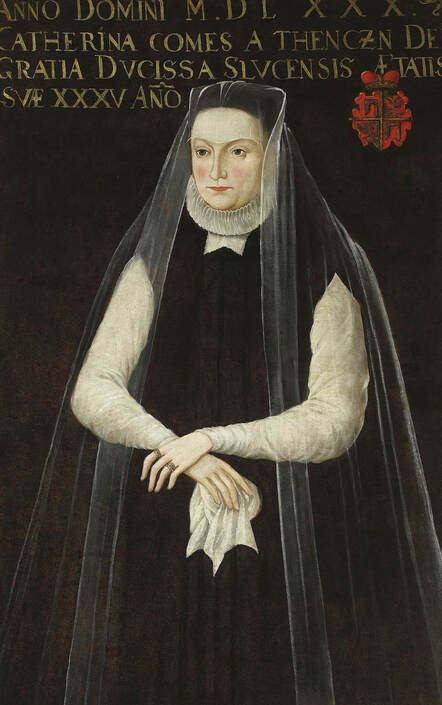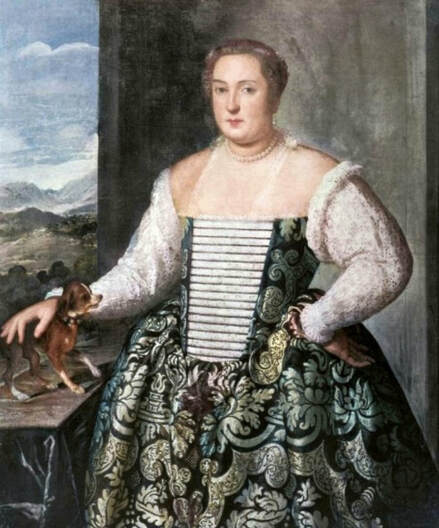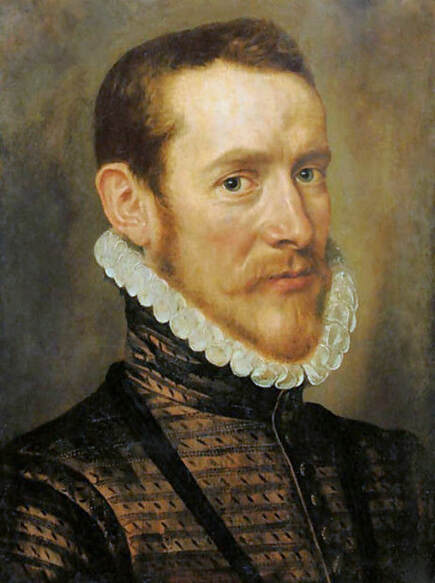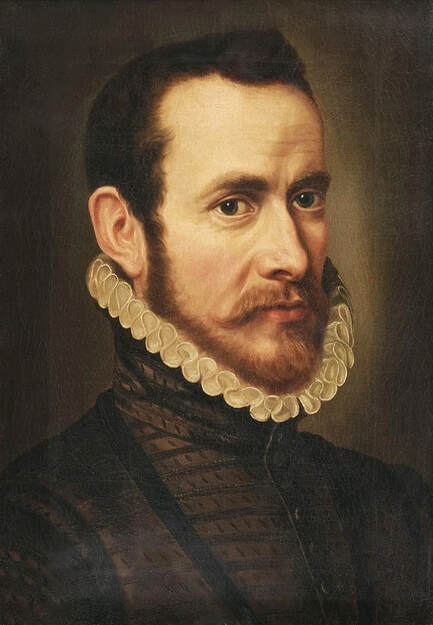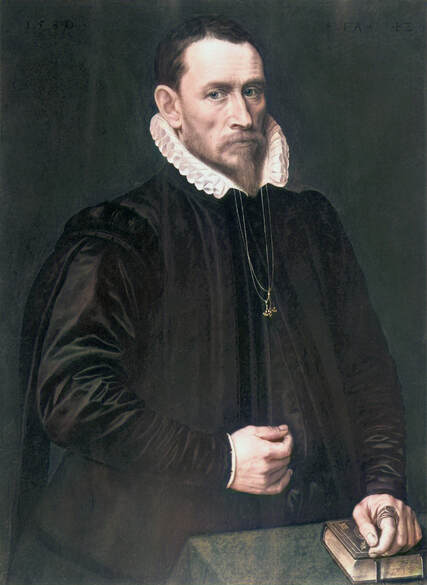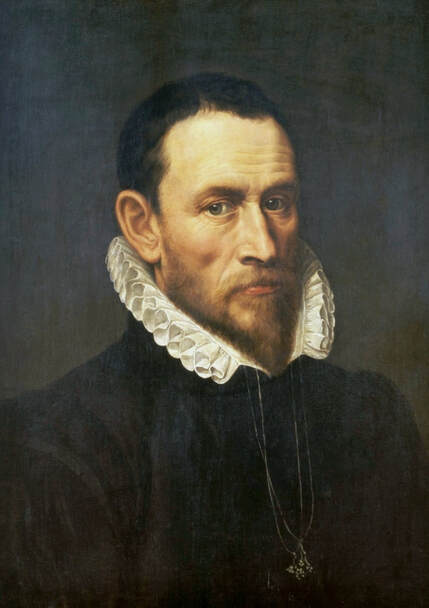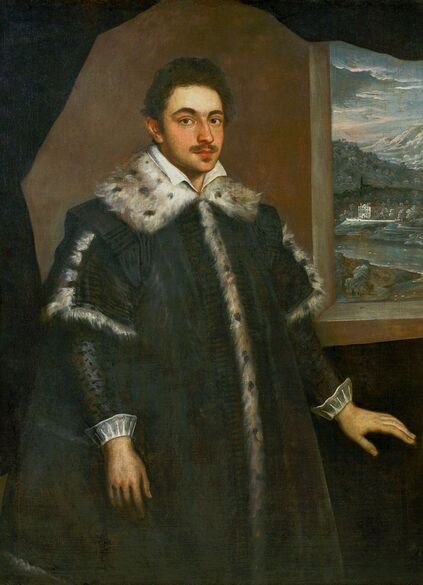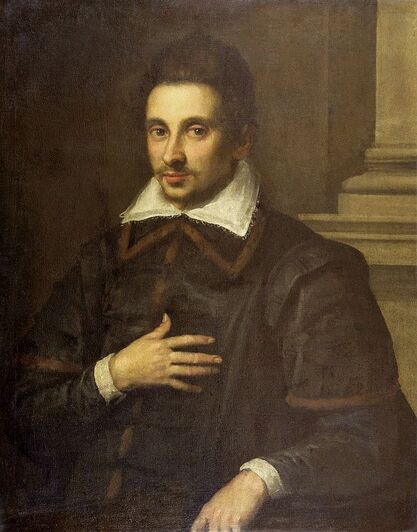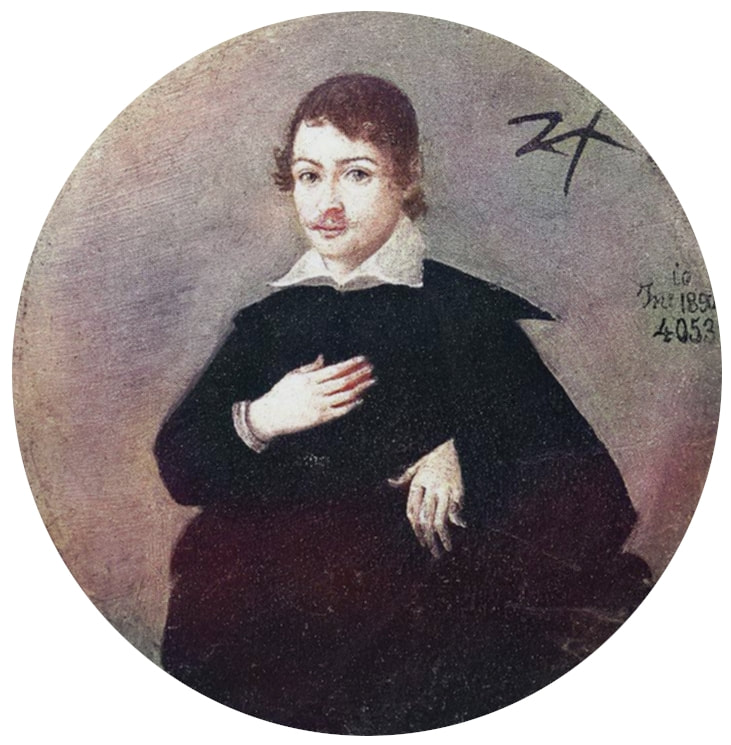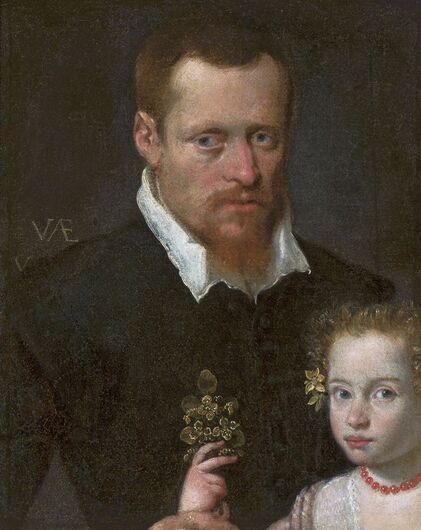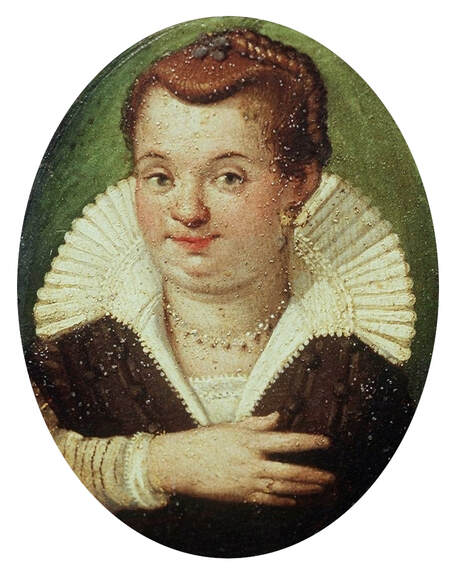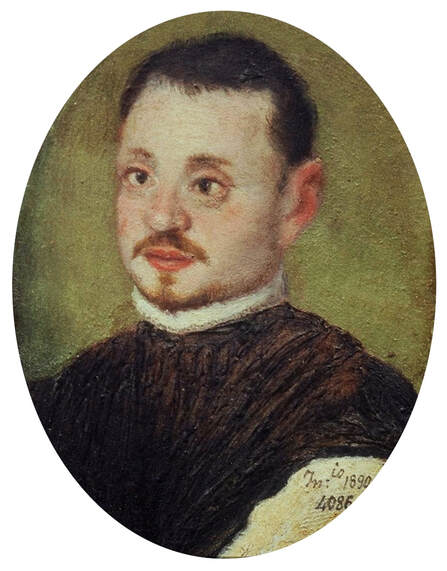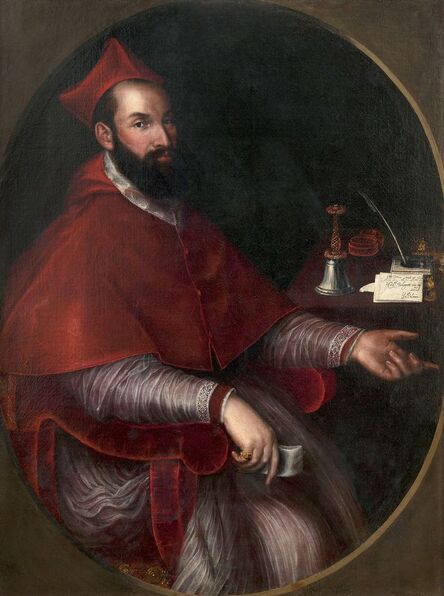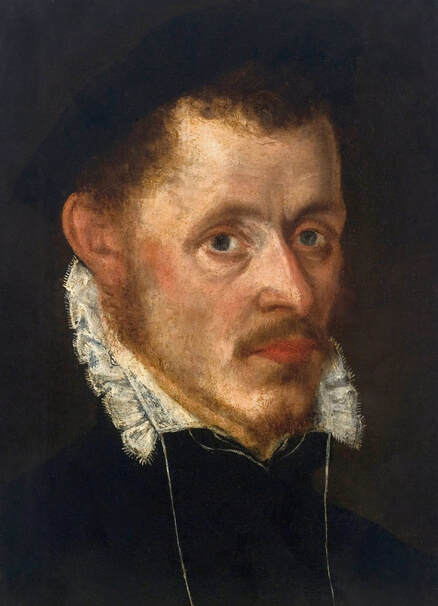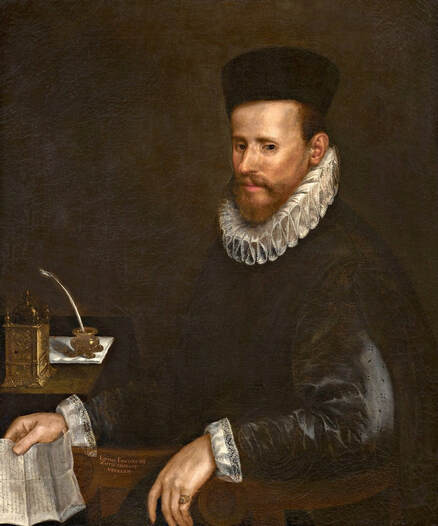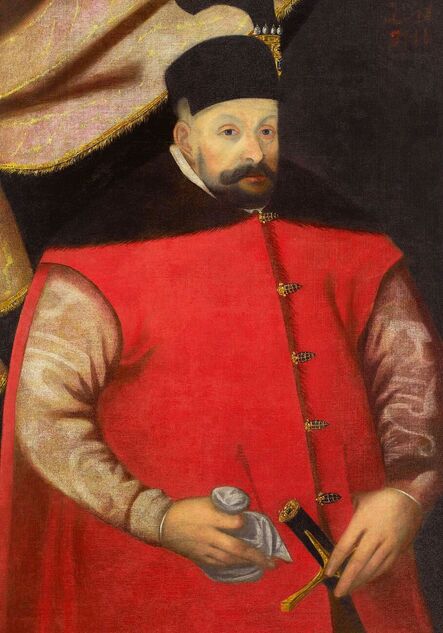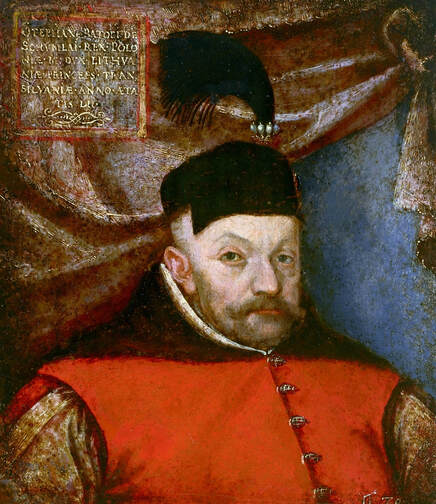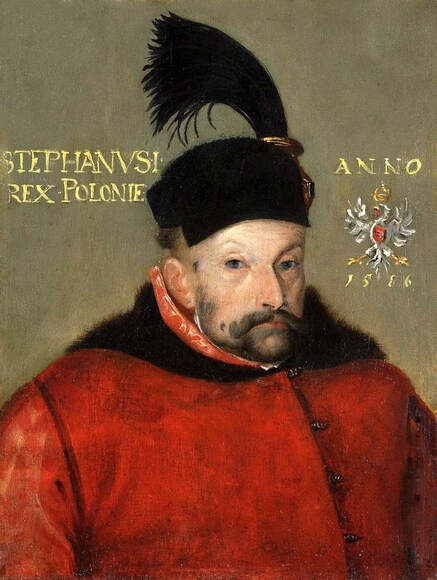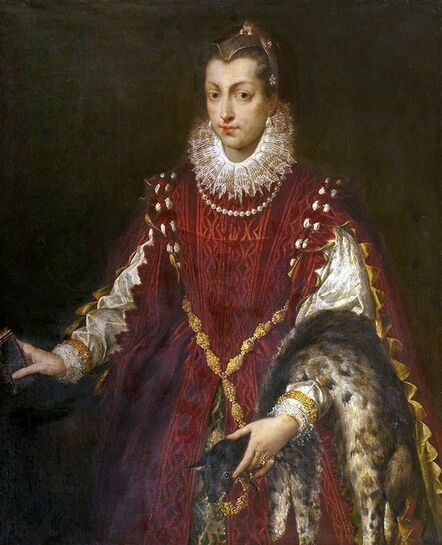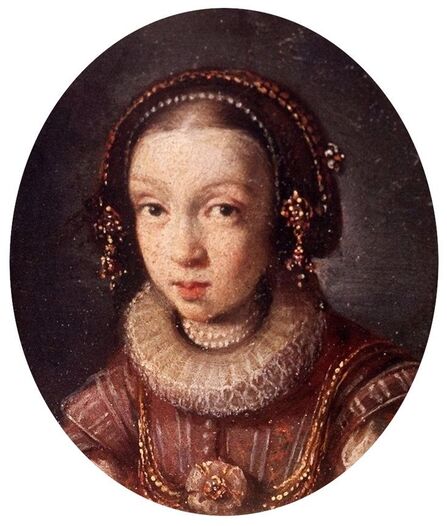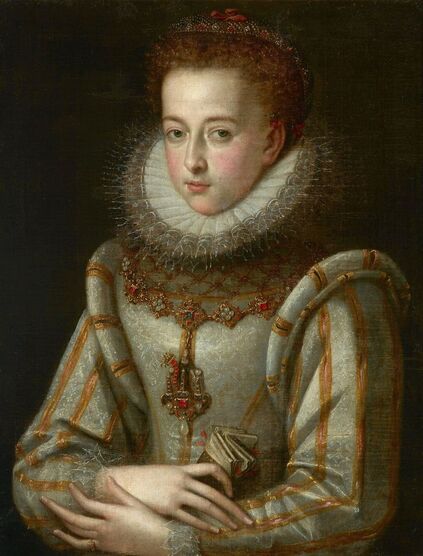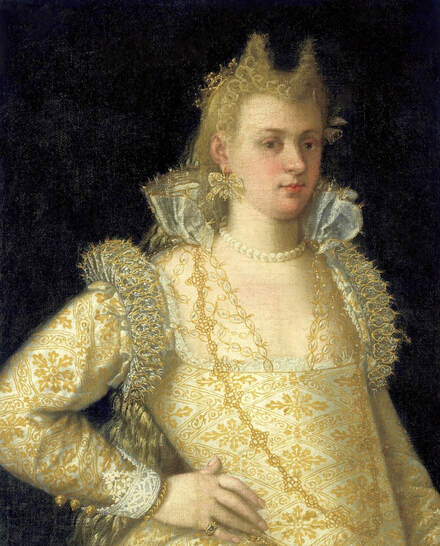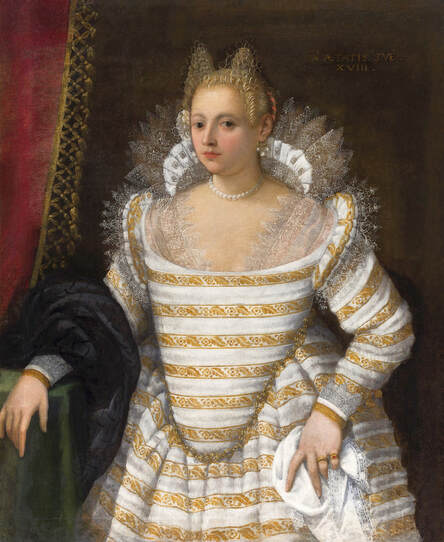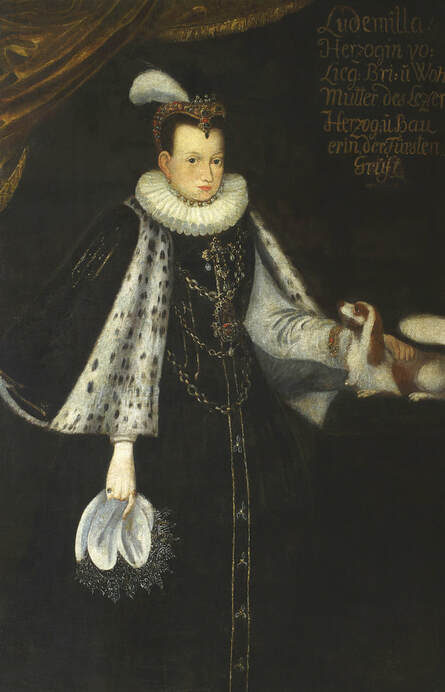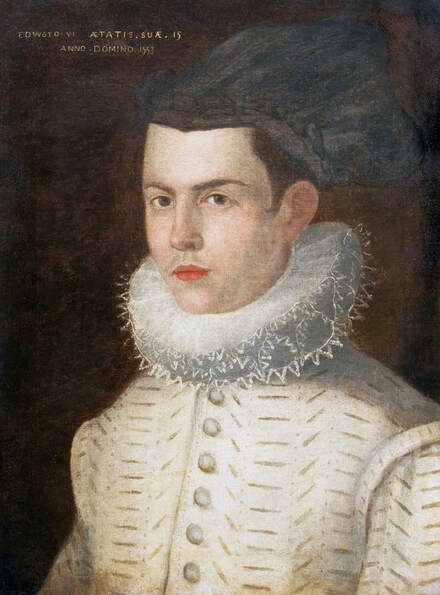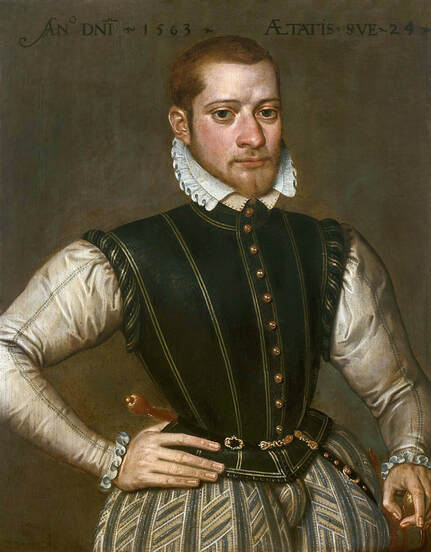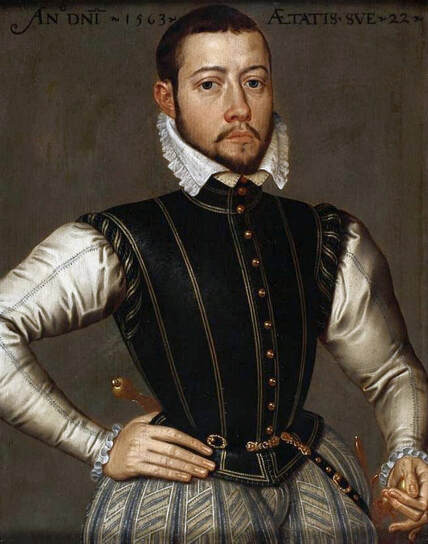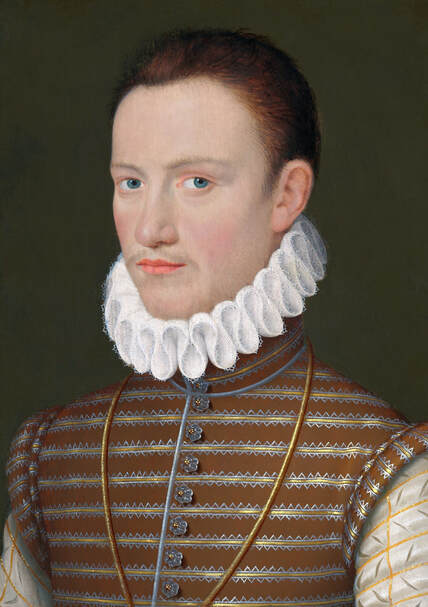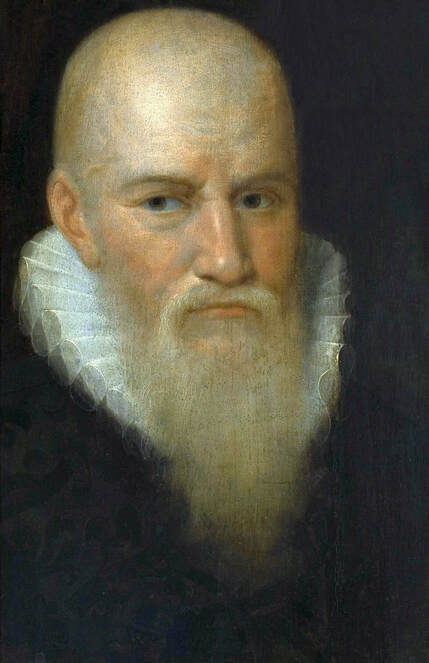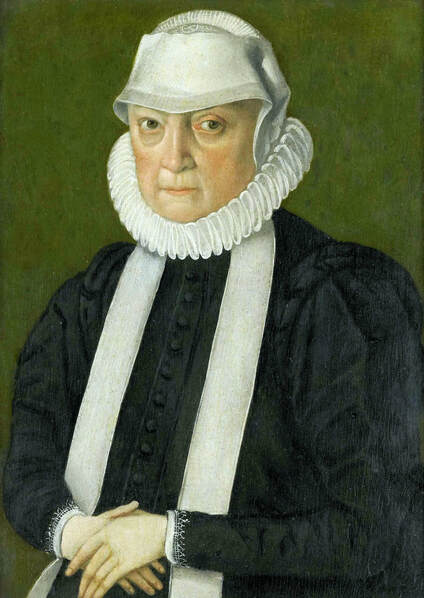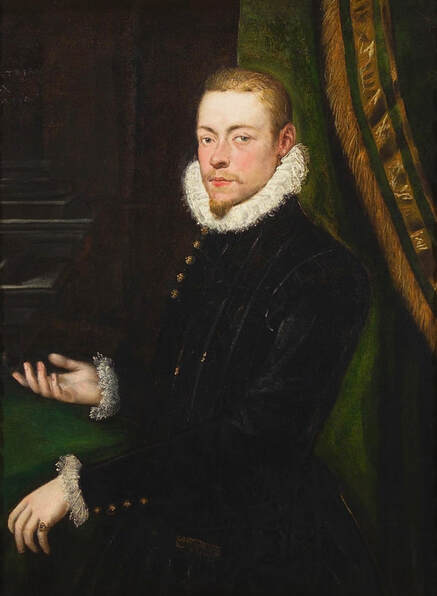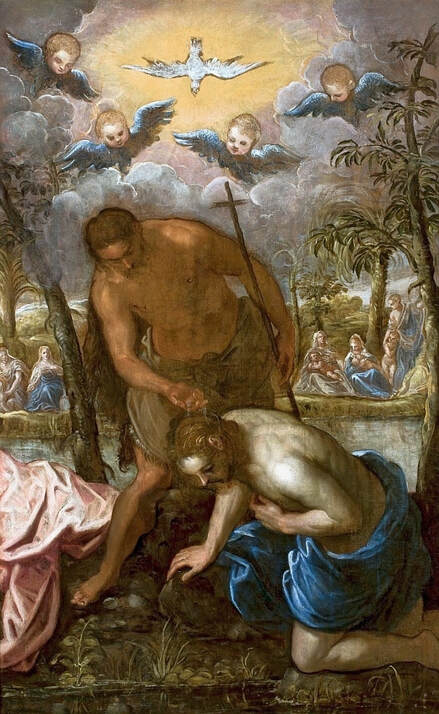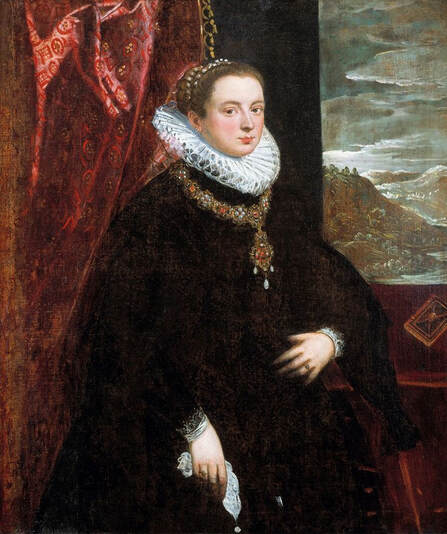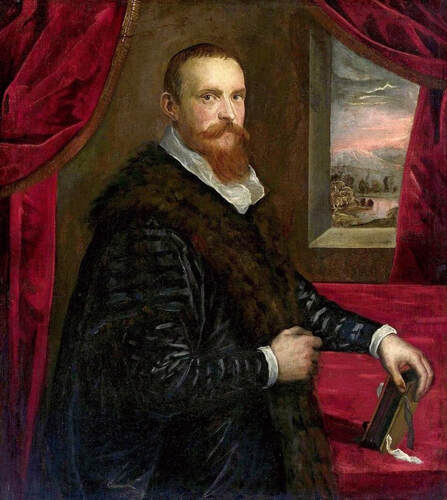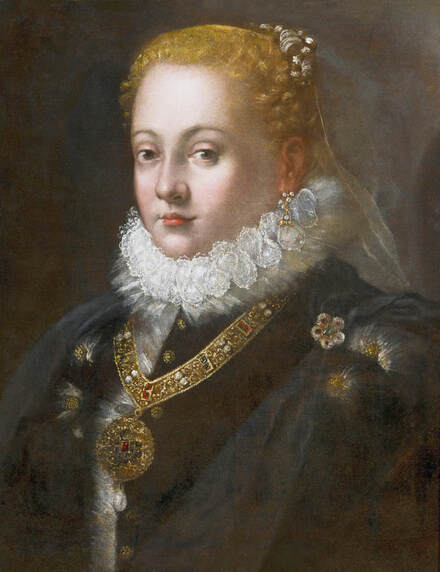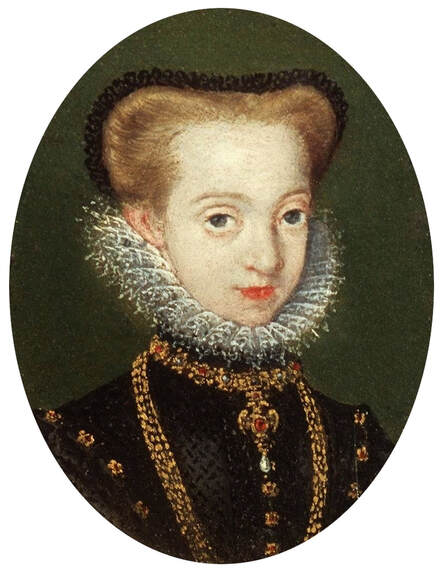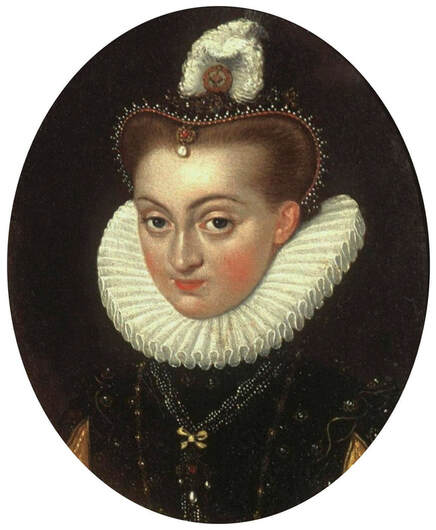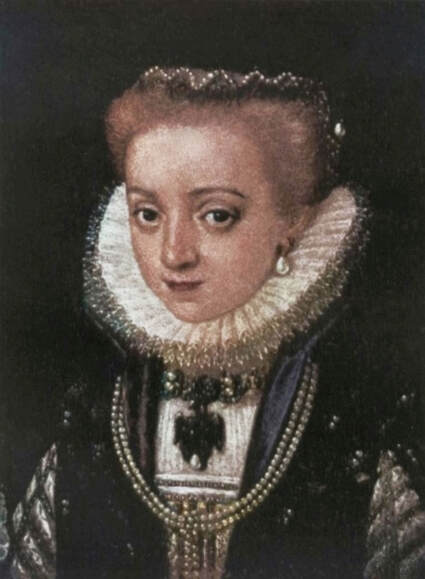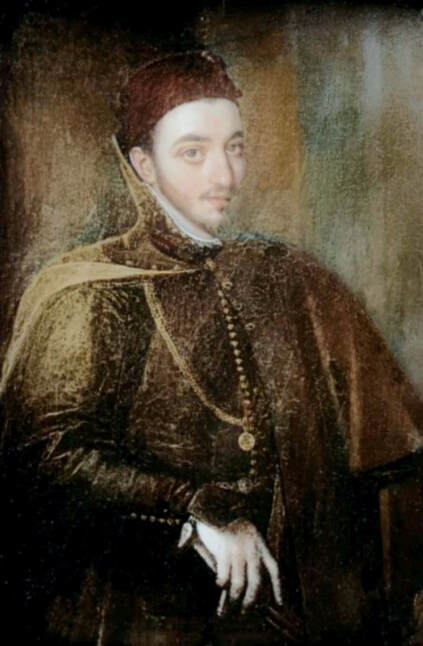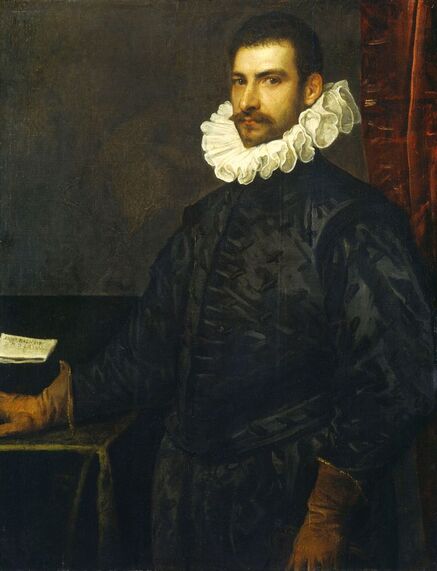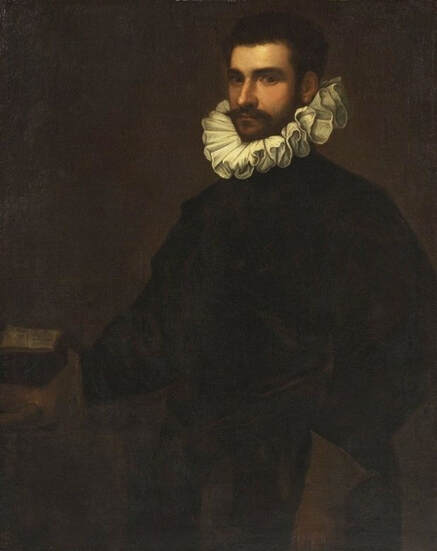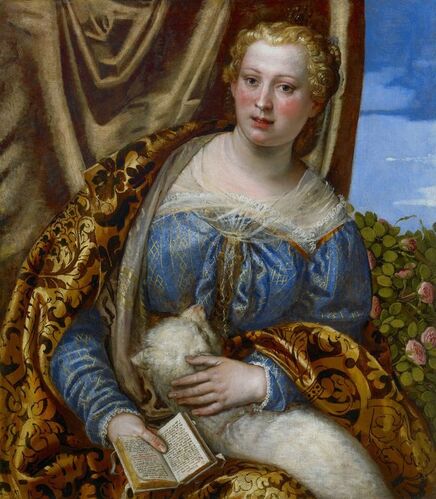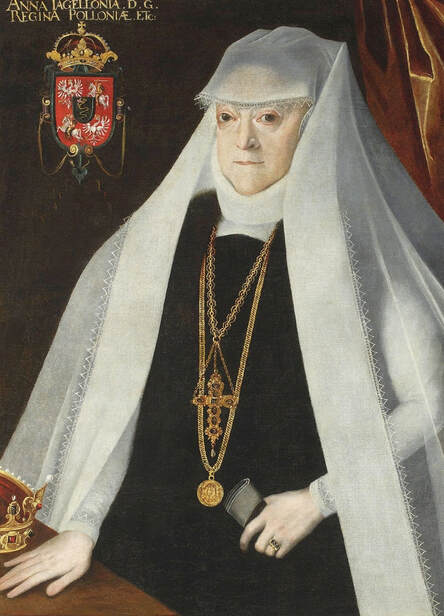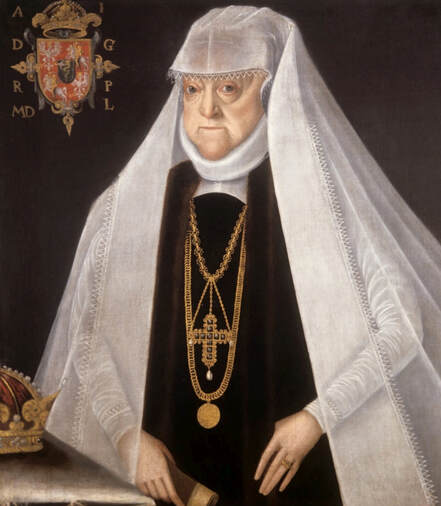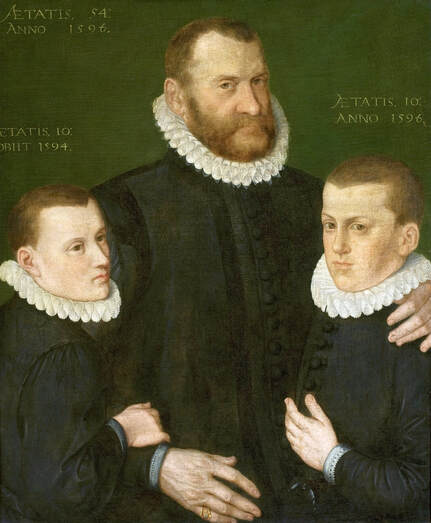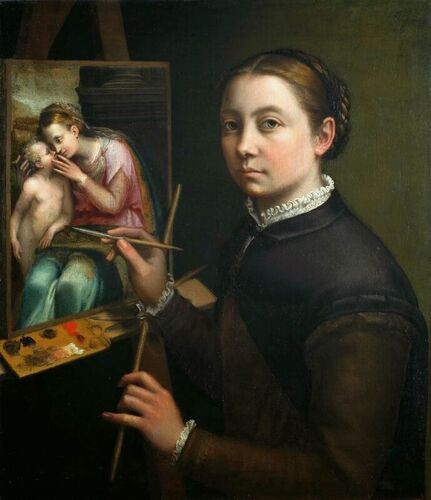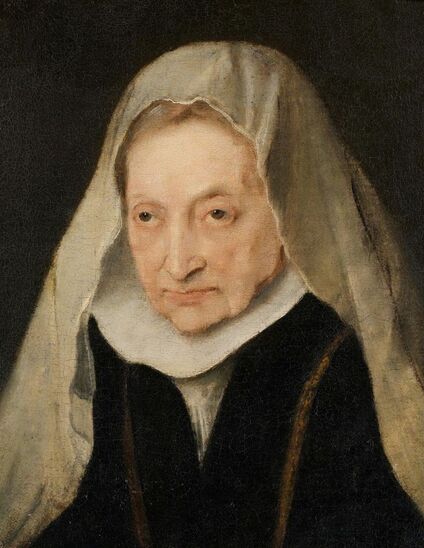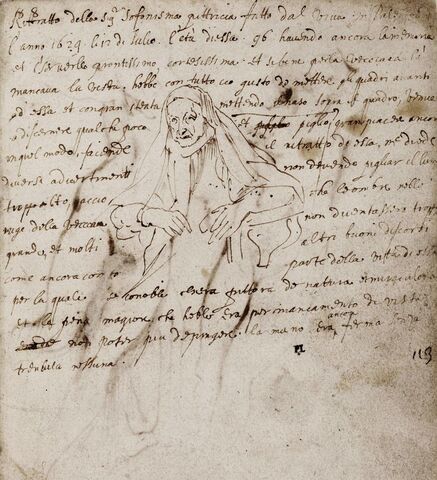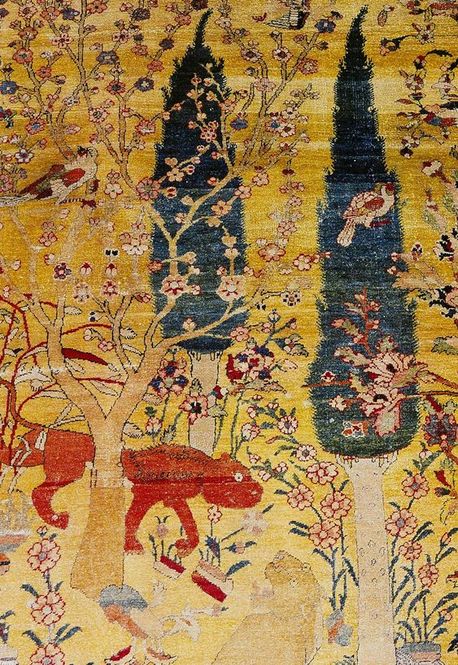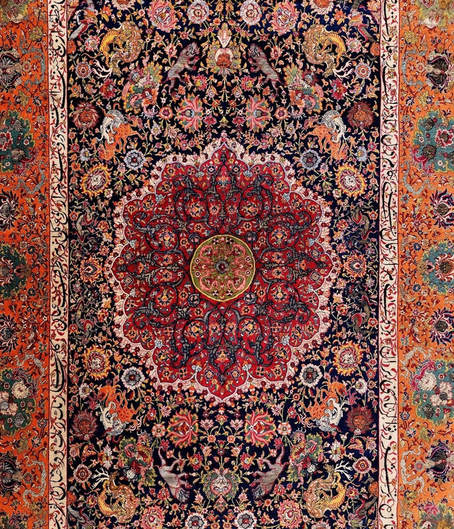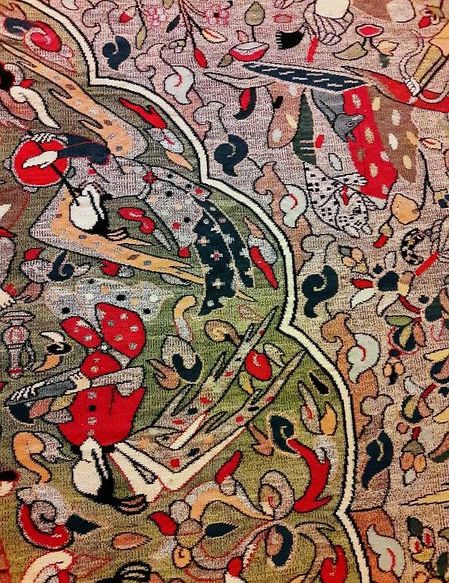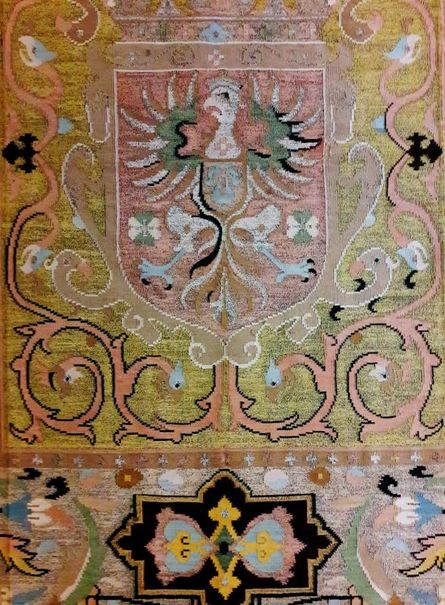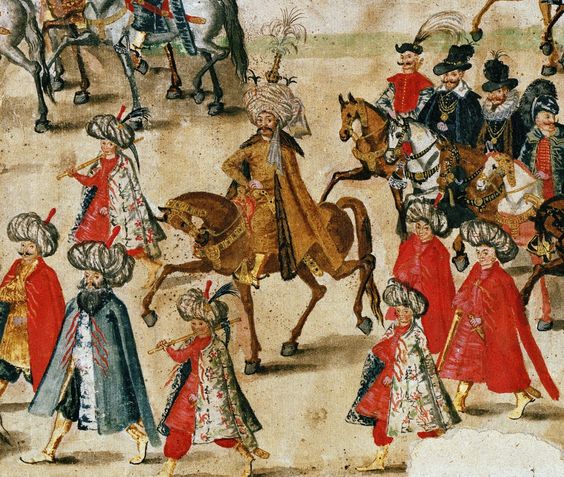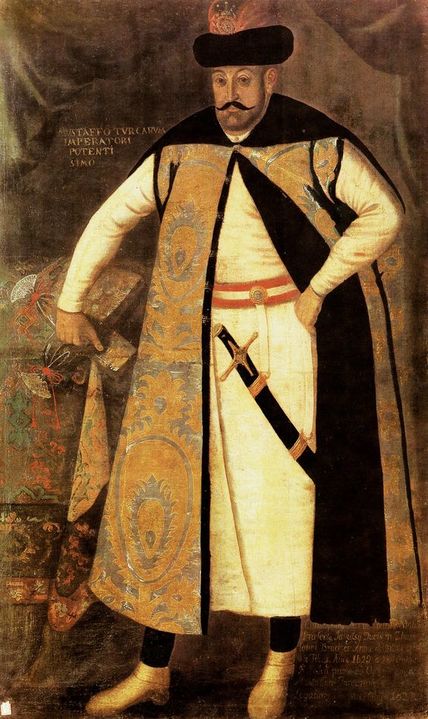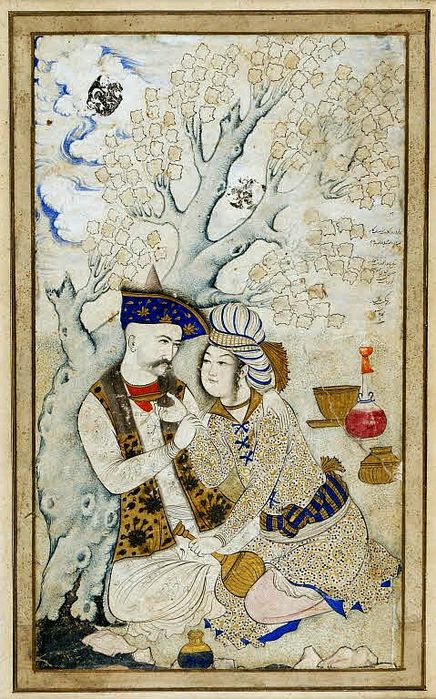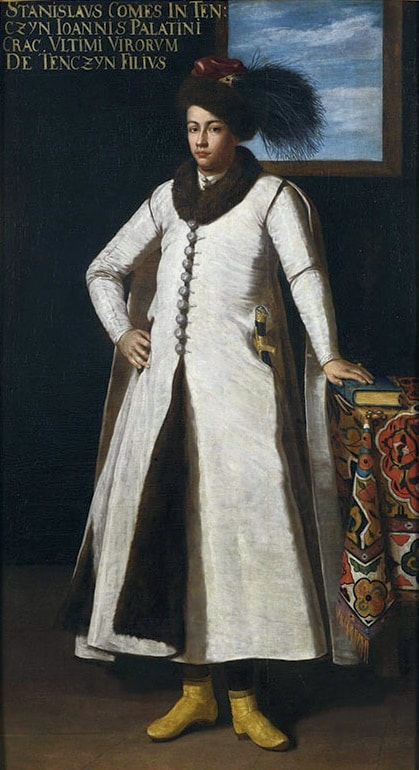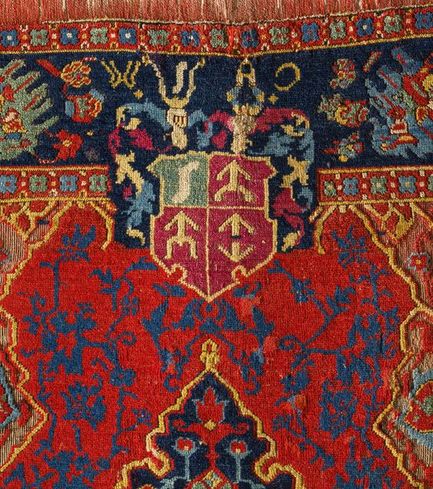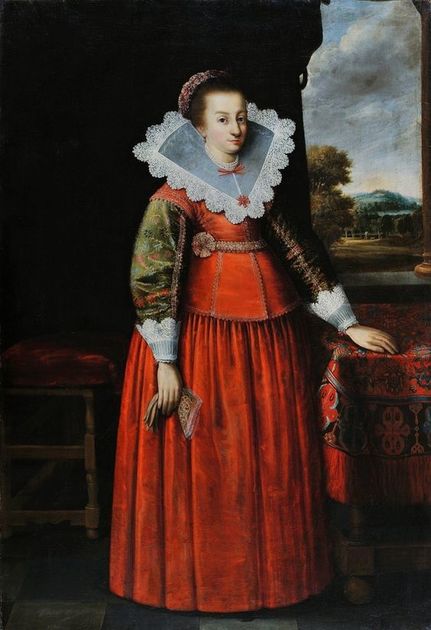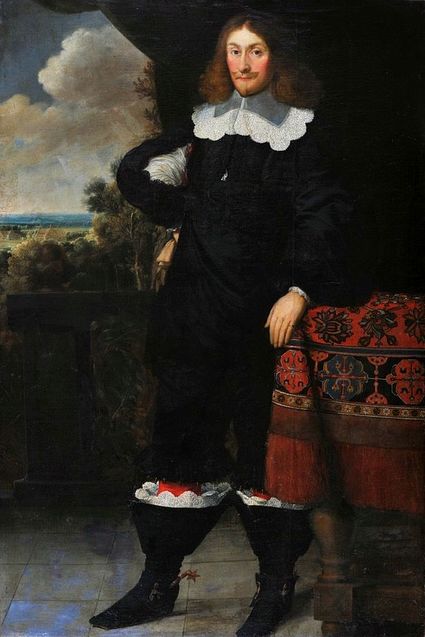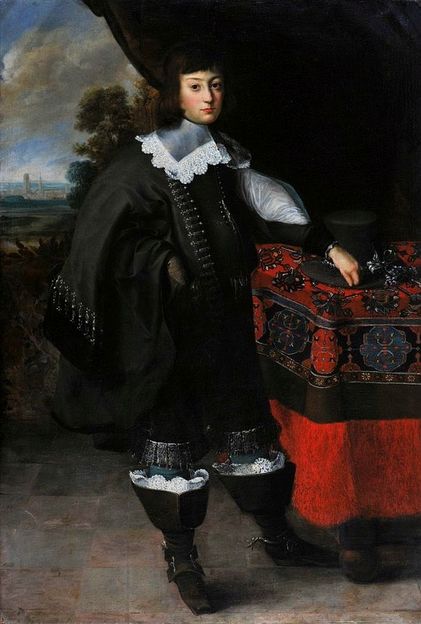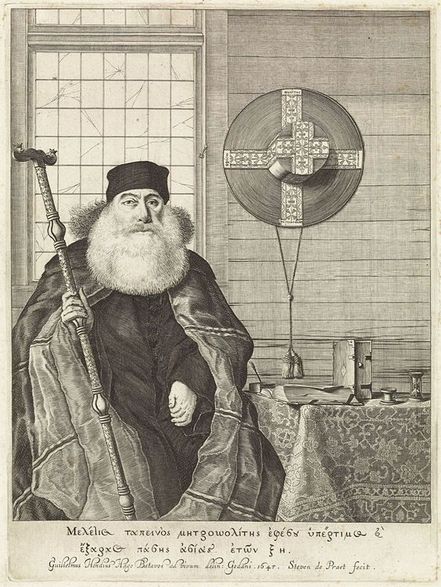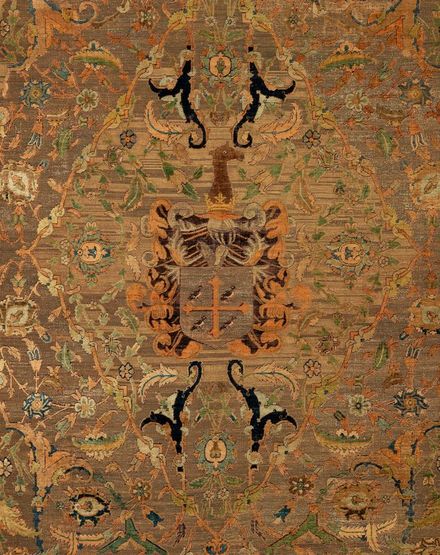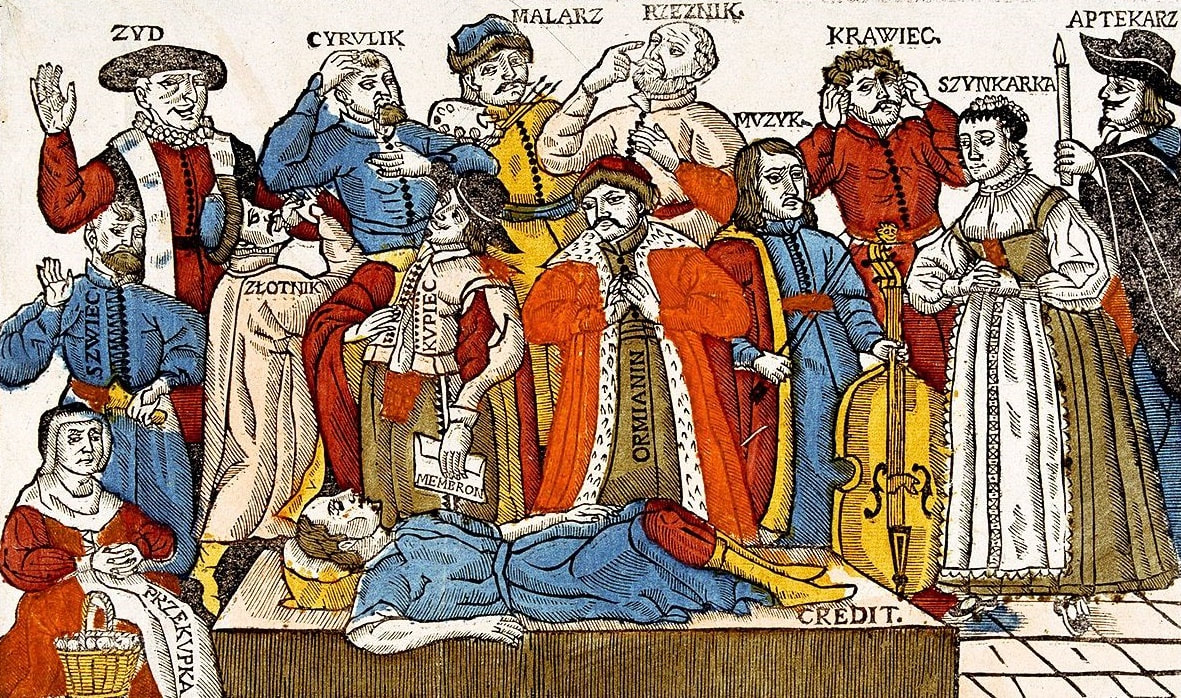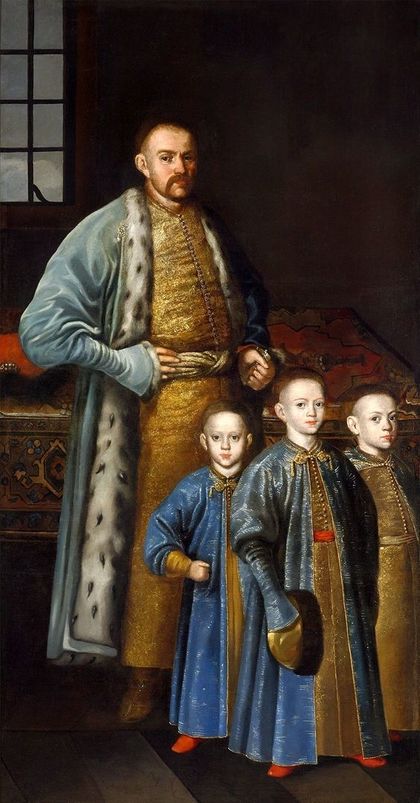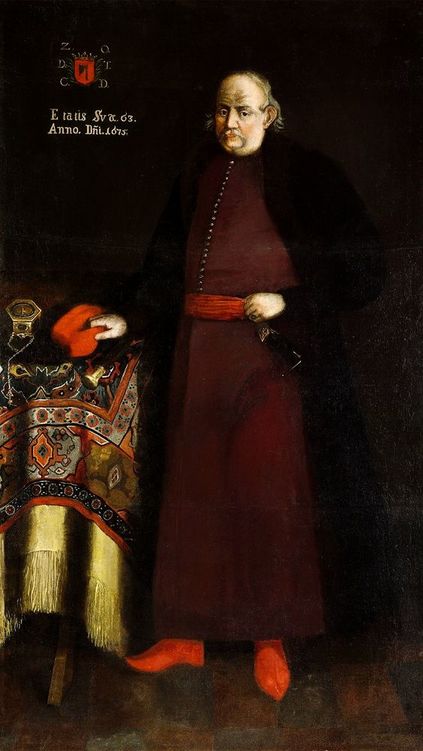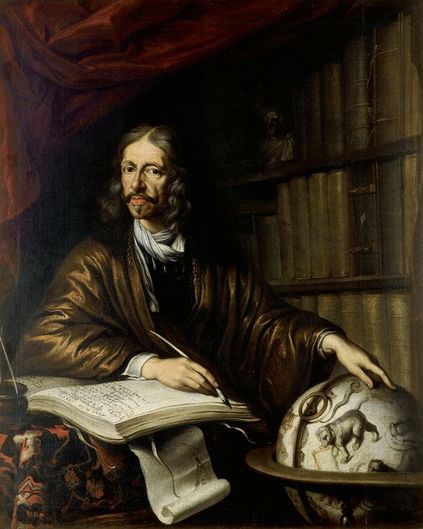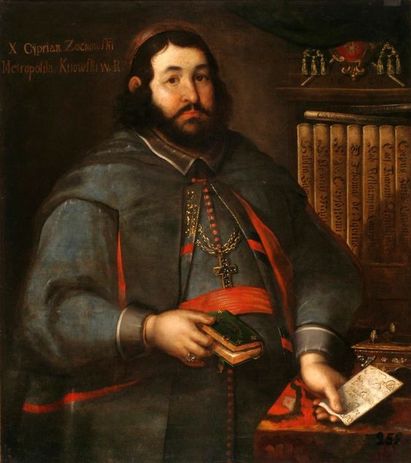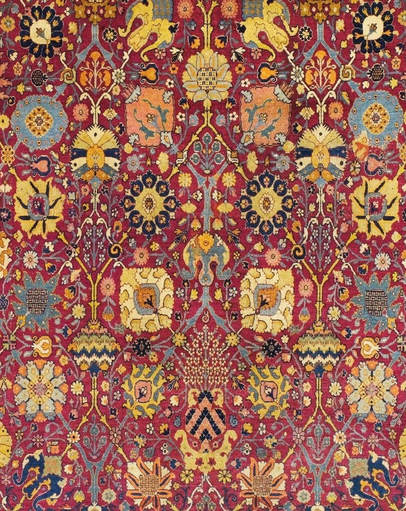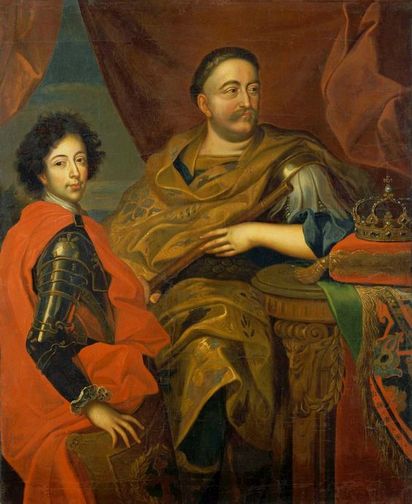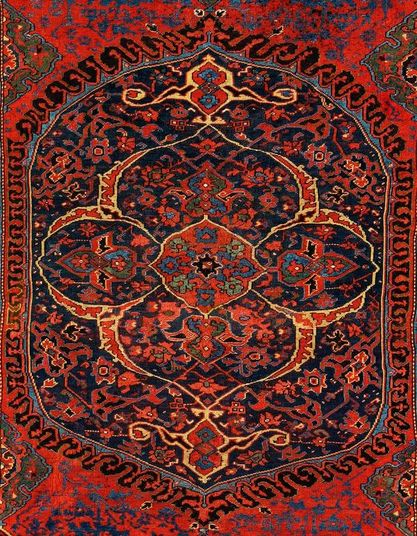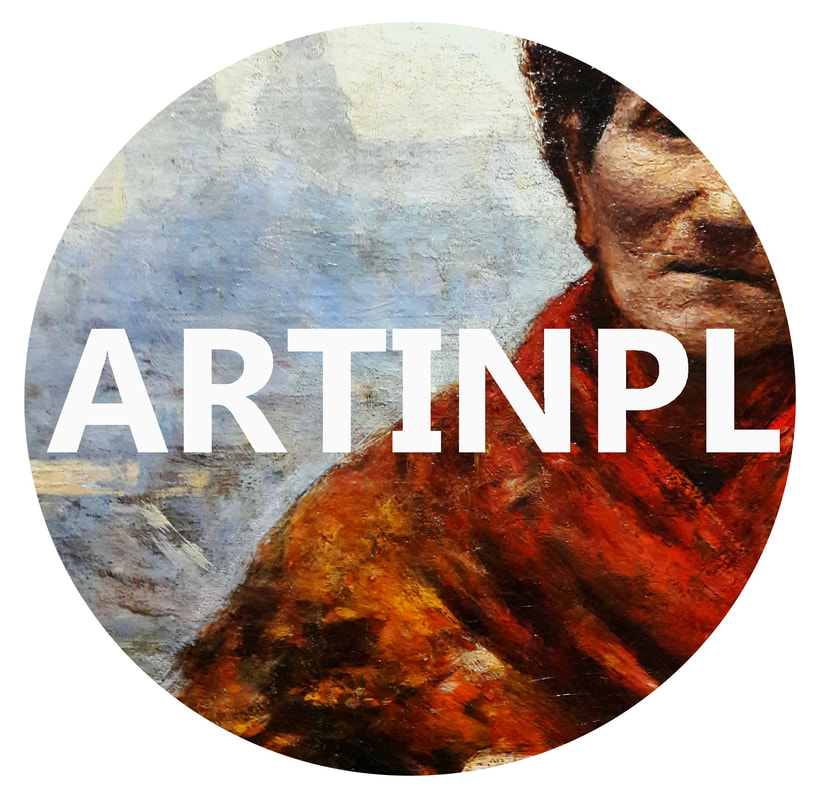|
Adoration of the Magi with portraits of Elizabeth of Austria, Casimir IV Jagiellon and Jogaila of Lithuania by Stanisław Durink
The portrait of King Ladislaus II Jagiello (Jogaila of Lithuania) as one of the Biblical Magi, venerated as saints in the Catholic Church, in the scene of the Adoration of the Magi is one of the oldest effigies of the first monarch of the united Poland-Lithuania. The painting is a section of the Our Lady of Sorrows Triptych in the Holy Cross Chapel (also known as the Jagiellon Chapel) at the Wawel Cathedral, which was built between 1467-1477 as a burial chapel for King Casimir IV Jagiellon (1427-1492) and his wife Elizabeth of Austria (1436-1505) - lower section, reverse of the right wing.
The triptych is considered the foundation of Queen Elizabeth mourning the death of her son Casimir Jagiellon (1458-1484), future Saint - her coat of arms, of the Habsburg family, as well as the Polish eagle and Lithuanian knight are in the lower part of the frame. The text of the Stabat Mater anthem on the frame could also indicate this (after "Malarstwo polskie: Gotyk, renesans, wczesny manieryzm" by Michał Walicki, p. 313). It is because of the great and unmistakable resemblance to the king's effigy on his tombstone in the same cathedral, the context and European tradition that one of the Magi is identified as a portrait of Jogaila. He was also depicted as one of the scholars in the scene of the Christ among the doctors in the same triptych. Consequently, the other two Magi are identified as effigies of other Polish rulers - Casimir the Great and Louis of Hungary. The other men in the background could be courtiers, including the painter's self-portrait (the man in the center, looking at the viewer), according to the well-known European tradition. Paintings in this triptych are attributed to Stanisław Durink (Durynk, Doring, Durniik, Durnijk, During, Dozinlk, Durimk), "painter and illuminator of king Casimir of Poland" (pictor et, illuminaitor Casimiri regnis Poloniae), as he is called in the documents of 1451, 1462 and 1463, born in Kraków (Stanislai Durimk de Cracovia). Durink was a son of Petrus Gleywiczer alias Olsleger, an oil merchant from Gliwice in Silesia. He died childless before 26 January 1492. If the majority of these effigies are disguised portraits of real people, why not the Madonna? This effigy seems too general, however, there are two important features that are not visible at first glance - the protruding lower lip of the Habsburgs and Dukes of Masovia and the depiction of the eyes, similar to the portrait of Queen Elizabeth, presumed founder of the triptych, in Vienna (Kunsthistorisches Museum, GG 4648). Therefore Melchior, the oldest member of the Magi, traditionally called the King of Persia, who brought the gift of gold to Jesus, is not Casimir the Great, but Casimir IV Jagiellon, Elizabeth's husband and the son of Jogaila. His effigy can also be compared to the counterpart of the portrait of Elizabeth in Vienna (GG 4649), which, like the Queen's portrait, was based on the depiction of the couple from the Family Tree of Emperor Maximilian I by Konrad Doll, painted in 1497 (Kunsthistorisches Museum in Vienna, reproduced in a lithograph by Joseph Lanzedelly from 1820). Casimir IV was depicted with a longer beard in a print in Theatrum virorum eruditione singulari clarorum by Paul Freher (Berlin State Library), published in 1688 in Nuremberg. The last monarch (Louis of Hungary on the right) was depicted from behind, so it is less likely to be a "disguised portrait". The purpose of these informal portraits was ideological - to legitimize the dynastic rule of the Jagiellons in the elective monarchy, a reminder that despite their rule is dependent on the will of the magnates, their power was bestowed on them by God. The Roman Catholic Chapel of the Holy Cross was decorated with Russo-Bizantine frescoes created by Pskov painters in 1470, so its ideological program was dressed for followers of the two main religions of Poland-Lithuania: Greek and Roman. Byzantine Patriarchal cross became the symbol of Jagiellonian dynasty (Cross of Jagiellons) and reliquary of the True Cross (Vera Crux) of Byzantine emperor Manuel I Komnenos (1118-1180), given to Jogaila in 1420 by emperor Manuel II Palaiologos (1350-1425), was a coronation cross of the Polish monarchs (today in the Notre-Dame de Paris - Croix Palatine).
Adoration of the Magi with portraits of Elizabeth of Austria as Madonna and Casimir IV Jagiellon and Jogaila of Lithuania as the Magi by Stanisław Durink, ca. 1484, Wawel Cathedral.
Portrait of Queen Elizabeth of Austria by Giovanni Bellini
"A large painting from His Majesty King Casimir in a box. Sub letter R. This image is of the Blessed Virgin, the Lord Jesus standing in front of her on a table covered with a carpet, there is a jug with flowers and behind him a beautiful landscape" (Obraz niemały od Krola Je° Mći Kazimierza w Puzdrze. Sub litera R. Ten Obraz iest Nayswiętsza Panna Pan Jezus przed nią stoi na stole Kobiercem przykrytym, y Dzban z Kwiatami i zanim pękny Lanszawt), this is how the inventory of the collection of paintings belonging to the influential Helena Tekla Lubomirska née Ossolińska (1622-1687), written in Wiśnicz on January 28, 1678 after the death of her husband, describes the painting which was offered to her by the last Vasa on the Polish-Lithuanian throne John II Casimir (1609-1672), descendant of the Jagiellons (National Archives in Kraków, Sanguszko Archive, WAP nr 201, p. 28). Helena Tekla put her signature under this entry, indicating that the painting may have been given to her directly by the king, perhaps shortly after his abdication and before departure for France in 1668. The king took many of his possessions, including those he had inherited from his ancestors and which he managed to evacuate during the Deluge (1655-1660). Many of these belongings were later sold in Paris in 1673. He also offered paintings to different monasteries (several paintings were given to the Visitandines Monastery in Warsaw) and friends. The Lubomirska's painting was probably destroyed during the Great Northern War (1700-1721) or during the great fire of Wiśnicz Castle in 1831.
Nothing more is known about this painting, but the description indicates that it was an Italian painting from the turn of the 15th-16th centuries, since such depictions with a standing Child are the most typical of Italian Renaissance painting. A somewhat similar composition was painted by Pinturicchio in the late 15th century, now in the National Gallery, London (tempera on panel, 53.5 x 35.5 cm, NG703), decorated with the coats of arms of the patrons, but this painting is rather small. At that time, larger Madonnas were "produced" in Venice. For example, the Virgin and Child enthroned with an oriental carpet, made by Gentile Bellini around 1475-85, in the same collection, is much larger (oil on panel, 121.9 x 82.6 cm, NG3911), as well as the Madonna and Child blessing, painted in 1510 by his brother Giovanni, today at the Pinacoteca di Brera in Milan (oil on panel, 85 x 115 cm, inv. 298, signed lower left: IOANNES / BELLINVS / M D X). Given Poland-Lithuania's contacts with Venice during the Renaissance, as well as those with the Bellini workshops, it is quite possible that the painting offered by John Casimir was created in their workshop. When I saw for the first time in November 2023 the painting by Giovanni Bellini, acquired by Wawel Castle, Virgin and Child in front of a green curtain and a landscape (oil on panel, 74.6 x 57.3 cm, ZKnW-PZS 10475, signed lower center: IOANNES BELLINVS P), I was struck by the great resemblance of the woman represented as the Virgin to Queen Elizabeth of Austria (1436/7-1505), wife of Casimir IV Jagiellon (1427-1492). In the effigy we can see a similar shape of the nose and protruding lower lip as in the later copy of the queen's effigy in the Kunsthistorisches Museum in Vienna (GG 4648) and in the portrait of her son Sigismund I in Gołuchów Castle (Mo 2185). The painting was also exhibited at the Palace of the Grand Dukes of Lithuania in Vilnius in 2024. What a coincidence that one of the most important female monarchs of Central Europe returned to Poland and Lithuania after several centuries of oblivion. This painting has probably never been here before, although we cannot exclude that other versions were in Poland-Lithuania. The sad thing about all this is that I seem to be the only one who noticed it. It is difficult, though, to believe in resemblance and an intuition, when it is not explicitly confirmed in the sources or in the painting itself (inscription, coat of arms) and experts say that it is not a portrait. It should be noted, however, that the general context and symbols are enough to identify the models in the paintings, but when it comes to Poland-Lithuania, it seems that many researchers want to believe that it was an artistic desert, especially before 1655-1660 and as regards the royal heritage. In recent years, research has revealed that the National Gallery of Victoria's "Portrait of a young man" (inv. 1587-5), attributed to Dosso Dossi or his younger brother Battista, is not a man at all but Lucrezia Borgia (1480-1519), daughter of Pope Alexander VI, called by a Venetian chronicler Girolamo Priuli (1476-1547) "the greatest courtesan of Rome" (Lucrezia la piú gran cortigiana che fosse in Roma, after "Lucrezia Borgia: La sua vita e i suoi tempi" by Maria Bellonci, p. 124). It contains symbolic references to Venus and the ancient Roman heroine Lucretia. The oldest known provenience of the Wawel painting is the collection of Henry Woods (1822-1882) or his son William at Warnford Park, Hampshire (compare "De la propriété de la Fondation collection Château de Rohoncz", p. 14) or the Moroni collection in Milan (a copy?), reported in 1934 (Fototeca Zeri, Numero scheda 28285) and although it is not confirmed, such a splendid painting was most likely owned by important patrons, such as the Tudor dynasty in England or the Sforza family that ruled Milan when the painting was executed in the late 15th or early 16th century. Portraits were part of diplomacy since the beginnings of portraiture as a distinct domain (portraits sent to allies, potential brides or grooms, influential family members abroad etc.) and the contacts of Poland-Lithuania with the Kingdom of England and with the Duchy of Milan are very old. In 1469, Alexander Soltan, son of the Ruthenian Orthodox boyar from Lithuania, visited England. He was sent there as an envoy of Casimir IV. The purpose of his trip was political negotiations and King Edward IV presented him with a gold chain. In December 1468, before arriving in England, Soltan was at the court of Galeazzo Maria Sforza, Duke of Milan, who recommended him to other rulers in a special document. Nearly two decades earlier, on August 4, 1450, the English King Henry VI had granted Casimir the Order of the Garter. Nicolaus von Popplau (Mikołaj z Popielowa), described as a Silesian born in Wrocław, who visited England in 1484, as well as several other European countries in the years 1483-1485, stated that "the English also do not regret spending a lot on feasts and a comfortable life, but they are not equal in this respect to the Poles" (after "Mikołaj z Popielowa" by Xawery Liske, p. 6), which gives an idea of the material status of Poland-Lithuania at the end of the 15th century. While in England it is not difficult to find traces of the country's wealth, such as numerous portraits of the queens of England - Elizabeth Woodville (d. 1492) or Elizabeth of York (1466-1503), what happened to the heritage of Poland-Lithuania? The painting is compared to very similar composition painted by Giovanni Bellini in 1487 - Madonna of the Small Trees (Madonna degli alberetti), which takes its name from the two poplar trees standing symmetrically on the sides of the green curtain which forms the backdrop to the group of the Virgin and Child, now kept in the Gallerie dell'Accademia in Venice (oil on panel, 71 x 58 cm, inv. 596, signed lower center: IOANNES BELLI ... / 1487). The Madonna of the Small Trees was gifted with other works by the aristocrat Girolamo Contarini, a member of one of Venice's founding families, in 1838, so it had probably been in the city since its creation and perhaps represents a member of the Contarini family. Another Contarini - Ambrogio (1429-1499), left a description of the court of Casimir IV during his visit to Poland-Lithuania in 1474 and 1477. The painter used the same set of study drawings for both compositions (Madonna of the Small Trees and the Wawel painting), changing only a few elements. Besides the trees in the background - poplar in the Madonna of the Small Trees and perhaps a chestnut tree or an oak at the beginning of winter in the Wawel painting, which undoubtedly has an important symbolic meaning, color of the child's hair, he notably changed the face of the Madonna. The lips, nose and eyebrows are different - she's definitely a different woman. If the Madonna was not a portrait, why did the painter change the face of a woman? Especially to the image with less classic features? He already had a beautiful model for his Madonna of the Small Trees, why look for another?, especially for a painting which probably left Venice shortly after its creation (possibly sent as a diplomatic gift). Each Madonna should be unique and the majority of Bellini's Madonnas are unique. Patrons paid to have a unique image, which is another indication that Wawel painting was not intended for Venetian customers, otherwise two Venetian noble families would have very similar paintings representing two different women. The Bellini workshop was very popular, so the artist and his students had to work quickly to meet the number of orders. This, however, means that they must rely on the reuse of other compositions. In the Madonna and Child with Saint Paul and Saint George in the same gallery (Gallerie dell'Accademia, inv. 610), which comes from the collection of Count Bernardino Renier, member of another old Venetian family, offered in 1850, they borrowed some elements from the Madonna of the Small Trees, notably the woman's face. Disguised portraits or cryptoportraits (kryptoportrety), from the Greek word kryptós meaning hidden, concealed, have been known in Polish literature on the subject since at least the mid-20th century and among the best known is the portrait of Jogaila of Lithuania (King Ladislaus II Jagiello) as one of the Biblical Magi in the triptych of Our Lady of Sorrows (Wawel Cathedral), the portrait of his descendant King Sigismund I as one of the Three Kings in the prayer book of the Chancellor of Lithuania Albertus Gastold/Vaitiekus Gostautas (University Library in Munich) or the Mystical marriage of Saint Catherine with the disguised portrait of Katarzyna Franciszka Denhoffowa née von Bessen (d. 1695), mistress of King John II Casimir Vasa, represented as Saint Catherine of Alexandria (compare "Dzieje sztuki polskiej ..." by Janusz Kębłowski, p. 143). Such representations have origins in ancient times (e.g. the sculptural self-portrait of Phidias on the shield of Athena Parthenos, as described by Plutarch, which depicts him naked in battle against the Amazons) and they often had additional meaning. One of Giovanni Bellini's best-known portraits - the portrait of Fra Teodoro of Urbino in the National Gallery, London (on loan from the Victoria and Albert Museum, L1115), painted in 1515 (M D XV), is in fact a disguised portrait. It represents the monk of the Dominican monastery of San Zanipolo, located not far from Bellini's workshop, with the attributes of Saint Dominic. More and more disguised portraits, many of which have been forgotten since the time of the Council of Trent (1545-1563), which indirectly prohibited such representations ("there be nothing seen that is disorderly, or that is unbecomingly or confusedly arranged, nothing that is profane, nothing indecorous", after "The Canons and Decrees ..." by James Waterworth, p. 236), are currently being rediscovered, such as the portrait of a lady as Saint Lucy by Giovanni Antonio Boltraffio, painted around 1509 (Museo Thyssen-Bornemisza, inv. 52 (1934.44)), portrait of a young woman as Saint Agatha by Giovanni Busi Cariani, painted between 1516-1517 (National Galleries Scotland, NG 2494) or portrait of a lady as Saint Agatha (probably Giulia Gonzaga), painted by Sebastiano del Piombo in Rome in the early 1530s (National Gallery, London, NG24), although the exact identity of many of these effigies still remains a mystery. "This painting, then, is not only a religious painting but also a portrait, bringing together in one canvas two categories of early modern image making that have long been understood as not only distinct but binarily opposed to each other", comments Adam Jasienski on the portrait of a woman in the guise of Saint Barbara from the first half of the 17th century (after "Praying to Portraits", p. 1-2). Church reformers could not openly prohibit such depictions, as this tradition largely concerned Europe's most powerful ruling dynasties, such as the Habsburgs and Medici. The woman with the jewelled headband, depicted as Madonna and Child, painted by Ercole de' Roberti, court painter of the Este family in Ferrara, between 1490-1496 (The Art Institute of Chicago, 1947.90), bears a strong resemblance to the effigies of Beatrice d Este (1475-1497), Duchess of Bari and Milan, who, on January 18, 1491, in Pavia, married Ludovico il Moro (1452-1508), regent of Milan. Some popes and other church officials also lent their features to images of saints (Pope Leo X as Saint Pope Leo I in the Meeting of Leo the Great and Attila by Raphael or the Supper of Saint Gregory the Great with portrait of Pope Clement VII by Giorgio Vasari). Many of these rediscovered disguised portraits can still be found in the temples for which they were painted or offered, such as Descent of Christ into Limbo with many contemporary portraits (Alessandro Allori as Isaac, Costanza da Sommaia as Judith), painted by Bronzino in 1552 (Medici Chapel at the Basilica of Santa Croce in Florence), Mystical marriage of Saint Catherine with the disguised portraits of counts of Silvano Pietra, painted by Lucrezia Quistelli della Mirandola in 1576 (Chiesa Santa Maria e San Pietro in Silvano Pietra, compare "In mostra a Milano la pala di Silvano Pietra" by Maurizio Ceriani), Adoration of the Magi with portraits of King Sigismund III Vasa, his son Prince Ladislaus Sigismund and their courtiers from the second quarter of the 17th century (Church of St. Nicholas and St. Lawrence in Dłużec near Olkusz, compare "W asystencji, w przebraniu ..." by Jacek Żukowski, p. 21) or mentioned triptych of Our Lady of Sorrows (Holy Cross Chapel at the Wawel Cathedral). Certain works by Giovanni Bellini, his workshop, his entourage or followers are present in different collections of the former Poland-Lithuania. A painting by Bellini is also linked to the Jagiellons - Lamentation of Christ, painted after 1475, which was located before the Second World War in the Kaunas Cathedral (oil? on wood, 90 x 74 cm). This painting was probably donated by King Alexander Jagiellon (1461-1506), son of Elizabeth of Austria, in 1503, and mentioned in the 1522 inventory of the Kaunas parish church made by Canon Joannes Albinus (Imago Depositionis de Cruce Domini Jesu Christi in assere, erecta a quo et quamdiu in hac ecclesia est, non constat, solum varij sexus hominum linguis et testimonijs fertur ab 80 plus minus annis in liac parochiali ecclesia existere ..., after "Viešpaties Jėzaus Kristaus apraudojimo ..." by Laima Šinkūnaitė, p. 156-158). While it should be noted that the Kaunas painting was a version of a painting generally attributed to the Florentine school (Davide Ghirlandaio and Bastiano Mainardi), the compositions were nevertheless frequently copied at that time by different painters, especially if they contained disguised portraits. In Kaunas there is also the Virgin and Child with Saint John the Baptist by the circle of Giovanni Bellini from the beginning of the 16th century (National Museum of Art, ČDM MŽ 1549) and in Kraków there is the Virgin with the Blessing Child by Giovanni Bellini from around 1480 (Czartoryski Museum, MNK XII-202). The latter painting comes from the Czartoryski collection and was mentioned in a register of paintings from their collection published in 1914 (compare "Galerja obrazów: katalog tymczasowy" by Henryk Ochenkowski, p. 37, item 158). The paiting was attributed to pupil of Giovanni Bellini, Niccolò Rondinelli (d. 1520), active mainly in Ravenna, similar to his composition in the Indianapolis Museum of Art (24.6) and repeating the Bellini's composition from Madonna and Child with St. John the Baptist and St. Anne or St. Elizabeth in Städel Museum (inv. 853) and another version from Fonte Avellana Monastery, now in the Galleria Nazionale delle Marche (inv. 643). Two similar Madonnas are in the Gemäldegalerie in Berlin (inv. III.126 and B.12). Earlier provenance has not been established, so an acquisition in the late 15th century and a provenance from the royal collection of Polish-Lithuania can be considered. The Holy Family from the collection of the architect Stanisław Zawadzki (1743-1806), today kept in the Church of Saint Catherine of Alexandria in Rzeczyca, is attributed to the circle of Giovanni Bellini (compare "Nieznane aspekty biografii architekta Stanisława Zawadzkiego" by Ryszard Mączyński, p. 72-73), but it is another version of a painting attributed to Francesco Bissolo, a student of Bellini, now kept in the Crema Cathedral. Aleksander Przezdziecki (1814-1871) provides some information on Queen Elizabeth's Italian connections in his article on the queen published in 1852. According to this author, Juan Andrés y Morell (1740-1817), director of the Royal Library of Naples, had a manuscript with the following title: Elisabeth Alberti secundi Imperatoris filia nupta Casimiro IV Poloniae Regi, Hungariae et Bohemiae haeres nata A. D. 1439, denata 1505, hanc institutionem conscripsit filio suo Wladislao Hungariae, Bohemiaeque Regi clarissimo ("Elizabeth, daughter of Albert the Second Emperor, married to Casimir IV, King of Poland, heiress of Hungary and Bohemia, born A. D. 1439, died in 1505, wrote this document to her son Wladislaus, the most serene king of Hungary and Bohemia"). The manuscript, written in beautiful and elegant Latin, had 140 pages and was acquired from the library of Pope Pius VI (1717-1799) by a citizen of Naples. In the former Habsburg collections in Vienna there is another manuscript under the title Helisabetha Poloniae Regina Wladislao Pannoniae, Воhemiaeque Regi, filio Carissimo S. P. D. De Institutione Regii Pueri, written by the queen (Austrian National Library, Cod. 10573). This small manuscript of 138 pages is decorated with a double coat of arms of Bohemia and Hungary on the first page and the crowned letters W and A (Wladislaus, Anna), undoubtedly belonging to Elizabeth's son King Vladislaus II Jagiellon (1456-1516), king of Bohemia, Hungary and Croatia. In this manuscript, written after September 1502 and before July 1503, before the expected childbirth of her daughter-in-law, Vladislas's second wife, Anne of Foix-Candale (1484-1506), Queen Elizabeth sends her son advice on the upbringing of the child, whom she calls a son and calls by her favorite name - Casimir. However, her premonition was wrong, because instead of a son, a daughter, Anna Jagiellonica, was born (July 23, 1503). The queen advises her eldest son: "Casimir, your father, congratulated himself and considered it a blessing that he had with him Callimachus [Filippo Buonaccorsi], the Italian poet, who taught you and your other brothers Latin literature" and "Casimir, your father, praised the custom of the Italians, who used to eat three or at most four kinds of dishes and add water to their wine; and he did not attribute this moderation in life to stinginess, as many people understand, but to temperance, the most beautiful virtue and care for health". She also adds that "Alexander, also your brother and the invincible King of Poland, who recently gave a certain young man as many pieces of gold and a beautiful horse for twenty-four poems published in his praise, shines with a similar generosity" and that "Often, in my presence, Callimachus told of a cardinal who was killed in the night by his bedchamber servant, simply because he never looked at him with a cheerful eye". "If Casimir and Albert [King John I Albert (1459-1501)] had not treated Callimachus generously and graciously, I don't think any memory of them would have come down to posterity. And you, if you despise the wisdom of scholars, consider what will happen to you after death!", she further praises the court poet (who commissioned portraits in Venice) basing the fame of her husband and son on his activities. She also mentions the Venetian diplomat Sebastiano Giustiniani (1460-1543), who was ambassador to the court of Vladislas for three years: "a learned and prudent man, I heard that he praises your seriousness in a strange way" and advises that the boy should learn Italian and German, in addition to Polish, French and Hungarian. The predominance of Italian and Venetian influences in this single document is astonishing. The queen also references ancient mythology, heroes and poets, such as Venus and her son Cupid, Artemis (Diana), Aeneas, Alexander the Great and Homer (p. 15 and 18 of the original manuscript), among others. Przezdziecki, praising the style of the manuscript and its "foreign elegance", speculates that it was not the queen herself who was the author, but her courtiers, supposedly one of the Florentines or other Italians, companions of Callimachus, many of whom were at the court of the Polish kings of the time, such as Arnolfo Tedaldi, to whom Callimachus dedicated his "Elegies of Love", Collenuccio da Pesaro, Ottaviano Calvani di Gucci, who wrote a letter in Italian on the death of Callimachus and Bernardino Galli, author of verses on Callimachus' tombstone. He also describes the wealth of the court of Casimir IV Jagiellon and the richness of the costumes, that in 1487 Elizabeth had a satin dress embroidered with pearls (Vestem ex athlassio et margaritis) and that Jakub Dembiński (1427-1490), chancellor in 1469, ordered from Florence silk fabrics for King Casimir, woven with gold, as evidenced by his letter to Lorenzo de' Medici, preserved in the Medici archives in Florence (after "O królowej Elżbiecie żonie Kazimierza Jagiellończyka ...", p. 524-527, 536, 543-547). Elizabeth was born in Vienna in 1436 or 1437 as the daughter of Duke Albert V of Austria (1397-1439), later king of Bohemia, Hungary and Croatia and king of the Romans from his union with Elizabeth of Luxembourg (1409-1442), the daughter of Emperor Sigismund (1368-1437). After death of their parents Elizabeth and her brother Ladislaus the Posthumous (1440-1457) were raised in the court of Frederick III (1415-1493), son of Cymburgis of Masovia (d. 1429). Frederick's secretary, Enea Silvio Piccolomini (1405-1464), future Pope Pius II, had an impact on their education and mentioned Juvenal, a Roman poet and author of the collection of satirical poems, as one of the authors for the young Ladislaus to study. Her marriage to Casimir was happy, although when he first saw Elizabeth he did not want to marry her. The queen also exercised some political influence. She gave birth to 13 children to her husband and thus she is known as the Mother of the Jagiellons and the Mother of Kings (Elizabeth regina Polonia mater plurium regum), because four of her sons became kings and Elizabeth's daughters, through their marriages, were associated with important ruling dynasties. Among the few artistic foundations of Queen Elizabeth that have been preserved, we can count the finest examples of late 15th and early 16th century art, such as the late Gothic tombstone of Casimir IV Jagiellon by Veit Stoss and Jörg Huber, made between 1492-1496, and the gold reliquary for the head of Saint Stanislaus by Marcin Marciniec, made in 1504, as well as the tombstone of King John Albert, created by Jörg Huber around 1502 and the niche sculpted by Francesco Fiorentino between 1502 and 1505, considered the first fully Renaissance work in Poland, all in Wawel Cathedral. In January 1504, Wojciech Krypa from Szamotuły (d. 1507), who had obtained his doctorate in Padua a year earlier, was appointed by King Alexander as his mother's physician (Albertus de Schamothuli, physicus regine Polonie Elizabeth). Based on examination of her skeleton discovered in 1972, scientists concluded that the queen suffered from a spinal abnormality, as well as a deformed skull and protruding teeth. Her known effigies confirm that an important feature of her face was prognathism, visible in the miniature in Vienna, in a woodcut from the so-called Łaski's Statute (Commune incliti Poloniae Regni privilegium ...), published in Kraków in 1506 and showing her as a progenitor of the Jagiellons, engraving with her portrait (Elisabetha, Imperatoris Alberti II filia, Casimiri Jagellonidis Uxor), made by the Flemish engraver Gilliam van der Gouwen in 1684 after an original from the second half of the 15th century (National Library of Poland, G.9796), representing her in a costume typical of European fashion of the time, and in a portrait taken from the family tree of Emperor Maximilian I, lithograph from 1820 by Joseph Lanzedelly after the original painting from 1497 by Konrad Doll (Austrian National Library). Protruding lower lip is also a feature visible in effigies of Elizabeth's father, Albert V. The queen undoubtedly gave her features to the Madonna in the scene of the Adoration of the Magi from the triptych of Our Lady of Sorrows in the Holy Cross Chapel (Wawel Cathedral), painted by Stanisław Durink around 1484. Facial expression with partially closed eyes looking down, resembles Bellini's painting. The Virgin from the Annunciation scene in the mentioned triptych is also strikingly similar. It is also worth noting a great resemblance to the features of Elizabeth's mother in a miniature from the same series in Vienna. The conclusion of a Latin poem written in her honor by an Italian poet, included by Elizabeth in her De Institutione Regii Pueri, also fits perfectly as a conclusion and summary for the description of this disguised portrait: "No mortal person receives such fame, such honors, You must be a Goddess!" (Non capit has laudes, non tot mortalis honores, / De superis aliquam te decet esse Deam!). Certainly, it was not only in poems that the great queen was a divine being.
Annunciation with disguised portrait of Queen Elizabeth of Austria (1436/7-1505) by Stanisław Durink, ca. 1484, Wawel Cathedral.
Portrait of Queen Elizabeth of Austria (1436/7-1505), the "Mother of Kings" (Mater Regum), as Madonna and Child in front of a green curtain and a landscape by Giovanni Bellini, after 1487, Wawel Royal Castle.
Family of Nicolaus Copernicus as donors by Michel Sittow
In 1484 Michel Sittow (ca. 1469-1525), a painter born in the Hanseatic city of Reval in Livonia (now Tallinn in Estonia) moved to Bruges in the Low Countries, at that time a leading economic center of Europe where painting workshops flourished. It is thought that he worked as an apprentice in the workshop of Hans Memling till 1488 and that he traveled to Italy. When in Bruges Sittow undoubtedly had the opportunity to meet Mikołaj Polak (Claeys Polains), a painter from Poland, who in 1485 was sued by the Bruges Guild of Saint Luke for using inferior Polish lazurite.
From 1492 Sittow worked in Toledo for Queen Isabella I of Castile as a court painter. He left Spain in 1502 and was presumably working in Flanders for Joanna of Castile and her husband Philip the Handsome. Michel probably visited London between 1503-1505, although this trip is not documented. Several portraits of English monarchs attributed to him could also have been made in Flanders on the basis of drawings sent from London. In 1506 the painter returned to Reval, where he joined the local guild of painters in 1507, and married in 1508. In 1514 he was called to Copenhagen to portray Christian II of Denmark. The portrait was intended to be a gift to Christian's fiancée, Isabella of Austria, a granddaughter of Isabella of Castile. From Denmark he traveled to Flanders, where he entered the service of Margaret of Austria, then regent of the Netherlands, and from there to Spain, where he returned to the service of Ferdinand II of Aragon, husband of Queen Isabella. When Ferdinand died in 1516, Sittow continued as court painter for his grandson Charles I, future Emperor Charles V. On an unknown date (between 1516 and 1518) Michel Sittow returned to Reval, where he married Dorothie, daughter of a merchant named Allunsze. In 1523, Sittow held the position of Aldermann (guild leader) and he died of plague in his hometown between December 20, 1525 and January 20, 1526. It is possible that between 1488-1492 Sittow returned to Tallinn. If he traveled by sea to or from Bruges or Spain, his possible stop was one of the largest seaports on the Baltic Sea - Gdańsk in Polish Prussia, the main port of Poland-Lithuania. If he traveled by land, he undoubtedly traveled through Polish Prussia and one of the biggest cities on the route from Bruges to Livonia - Toruń, where king Jagiello built a castle between 1424 and 1428 (Dybów Castle). One of the major works from this period in Toruń is a late Gothic painting depicting the Descent from the Cross with donors, today in the Diocesan Museum in Pelplin (tempera on oak panel, 214 x 146 cm, inventory number MDP/32/M, earlier 184984). It was earlier in the Toruń Cathedral and originally, probably, in the demolished church of St. Lawrence in Toruń or as the property of the Brotherhood of Corpus Christi at the Cathedral. The work was showcased during an international exhibition at the National Museum in Warsaw and the Royal Castle in Warsaw - "Europa Jagellonica 1386-1572" in 2012/2013, devoted to the period in which the "Jagiellonian dynasty was the dominant political and cultural force in this part of Europe". Many authors underline inspirations and influences of Netherlandish painting in this panel, especially by Rogier van der Weyden (after "Sztuka gotycka w Toruniu" by Juliusz Raczkowski, Krzysztof Budzowski, p. 58), the master of Memling, who had served his apprenticeship in his Brussels workshop. The landscape and technique can even bring to mind works by Giovanni Bellini (d. 1516), like Deposition (Gallerie dell'Accademia) and colors the works by Spanish masters of the late 15th century. It is known that in 1494 a Dutch painter named Johannes of Zeerug stayed at the court of king John I Albert. He could be the possible author of Sacra Conversazione with Saint Barbara and Saint Catherine and donors from Przyczyna Górna, created in 1496 (Archdiocesan Museum in Poznań). This painting was founded to the Parish church in Dębno near Nowe Miasto nad Wartą by Ambroży Pampowski of Poronia coat of arms (ca. 1444-1510), Starost General of Greater Poland, an important official close to the royal court, who was depicted as donor with his first wife Zofia Kot of Doliwa coat of arms (d. 1493). The style of the painting in Pelplin is different and resembles the works attributed to Michel Sittow - Portrait of a man with a pink - Callimachus (Getty Center), Portrait of King Christian II of Denmark (Statens Museum for Kunst), Madonna and Child (Gemäldegalerie in Berlin) and Portrait of Diego de Guevara (National Gallery of Art in Washington). He was also the only known artist of this level from this part of Europe, educated in the Netherlands, to whom the work can be attributed. The Descent from the Cross in Pelplin was a part of a triptych. However, the two other panels were created much later in different workshops. Basing on style and costumes these two other paintings are attributed to local workshop under Netherlandish and Westphalian influences and dated to around 1500. All three paintings were transferred to the Museum in Pelplin in 1928 and the central panel showing the Christ crowned with thorns was lost during World War II. The left wing representing Flagellation of Christ is now back in the Toruń Cathedral. This painting has almost identical dimensions as the Descent from the Cross (tempera on oak panel, 213 x 147 cm) and one of the soldiers tormenting Jesus has a royal monogram under crown embroidered with pearls on his chest. This intertwined monogram can be read as IARP (Ioannes Albertus Rex Poloniae), i.e. John I Albert, King of Poland from 1492 to his death in 1501. The founder of this painting depicted as kneeling donor in the right corner of the panel was therefore closely connected with the royal court. This man bears a striking resemblance to known likenesses of the most famous man from Toruń - Nicolaus Copernicus (born on 19 February 1473), who was baptized in the Toruń Cathedral. Some authors consider it to be an authentic image of the astronomer (after "Utworzenie Kociewskiego Centrum Kultury", 29.06.2022) founded by him in his lifetime. If the donor from the Flagellation painting is Copernicus, therefore the donors from the earlier Descent from the Cross should be his parents and siblings. Nicolaus' father, also Nicolaus was a wealthy merchant from Kraków, son of John. He was born around 1420. There is much debate as to whether he was German or Polish, perhaps he was just a typical representative of the Jagiellonian multiculturalism. He moved to Toruń before 1458 and before 1448 he traded in Slovak copper, which was transported by the Vistula to Gdańsk and then exported to other countries. In 1461, he granted a loan to the city of Toruń to fight against the Teutonic Order. Copernicus the Elder married Barbara Watzenrode, sister of Lucas Watzenrode (1447-1512), Prince-Bishop of Warmia, who studied in Kraków, Cologne and Bologna. The couple had four children, Andreas, Barbara, Catharina and Nicolaus. Copernicus the father died in 1483 and his wife, who died after 1495, founded him a portrait epitaph, known today only from a copy, on which we can see a man with a mustache, with folded hands in prayer, with similar features to his son. This copy was commissioned in about 1618 by astronomer Jan Brożek (Ioannes Broscius) for the Kraków Academy and it was repainted around 1873 (Jagiellonian University Museum, oil on canvas, 60 x 47 cm). The father of astronomer died at the age of about 63, while depicted man in much younger, therefore the original epithaph was probably based on some earlier effigy. The facial features of a man from the Descent from the Cross are very similar. Elongated face with wider cheekbones of the woman from the painting is similar to effigies of Barbara Watzenrode's brother Lucas and her famous son. As it was said Nicolaus the Elder died in 1483, while Sittow moved to the Netherlands in about 1484. Such a wealthy merchant or his widow could afford to order a painting from the artist, who at that time was possibly in Gdańsk or Toruń or even created in Bruges, when he settled there, and sent to Toruń. The appearance of younger of boys match the age of future astronomer, who was 10 when his father died. Barbara and Nicolaus had two daughters Barbara and Catharine, while on the painting there is only one. The elder Barbara, entered the convent in Chełmno, where she later became an abbess and died in 1517. It is generally believed that it was she who was mentioned in the list of nuns under the year 1450 there (after "Cystersi w społeczeństwie Europy Środkowej" by Andrzej Marek Wyrwa, Józef Dobosz, p. 114 and "Leksykon zakonnic polskich epoki przedrozbiorowej" by Małgorzata Borkowska, p. 287), therefore she "left" her family over 20 years before Nicolaus the astronomer was born. Apart from costly Polish azurite, painters in Bruges and other locations needed Copernicus' copper, which although is naturally green, "with the addition of ammonia (easily obtained from urine), it turns blue. The color became chemically stable if lime was added, and this chemistry process produced a cheap, bright blue that became an allpurpose paint for walls, wood, and books" (after "All Things Medieval" by Ruth A. Johnston, p. 551). In Gdańsk English and Dutch merchants purchased cenere azzurre, a blue pigment prepared from carbonate of copper (after "Original treatises dating from the XIIth to XVIIIth centuries on the arts of painting in oil ... ", p. cc - cci), similar to that visible in the Descent from the Cross in Pelplin.
Portrait of merchant Nicolaus Copernicus the Elder (d. 1483) and his two sons as donors from the Descent from the Cross by Michel Sittow, ca. 1483-1492, Diocesan Museum in Pelplin.
Portrait of Barbara Watzenrode and her daughter as donors from the Descent from the Cross by Michel Sittow, ca. 1483-1492, Diocesan Museum in Pelplin.
Descent from the Cross with family of Nicolaus Copernicus as donors by Michel Sittow, ca. 1483-1492, Diocesan Museum in Pelplin.
Portraits of Filippo Buonaccorsi, called Callimachus by Michel Sittow and workshop of Giovanni Bellini
"A face brighter than Venus' and the hair of Phoebus Apollo ... [more striking] than the stone polished by Phidias or the paintings of Apelles", this is how Philippus Callimachus Experiens (1437-1496) describes in his poem the beauty of the young clergyman Lucio Fazini Maffei Fosforo (Lucidus Fosforus, d. 1503), who became bishop of Segni near Rome in 1481. He advises elsewhere an elderly man: "Although the reverence of a wrinkled brow with white hair is esteemed ... Quintilius should prefer to be effeminate, so that he might always be ready for the prostitutes and the boys" (after "A Sudden Terror: The Plot to Murder the Pope in Renaissance Rome" by Anthony F. D'Elia, p. 96, 98).
Callimachus, humanist, writer and diplomat, was born Filippo Buonaccorsi de Tebadis Experiens in San Gimignano in Tuscany, in Italy. He moved to Rome in 1462 and he become a member of the Roman Academy of Giulio Pomponio Leto (Julius Pomponius Laetus, 1428-1498), who was later charged with sodomy, conspiracy against Pope Paul II and heresy. Filippo was accused of participating in the assassination attempt on the pope in 1468 and fled through southern Italy (Apulia-Sicily) to Greece (Crete-Cyprus-Chios) and Turkey, and then to Poland (1469/1470). The homo-erotic verses were discovered among his papers, including one dedicated to Fazini. The punishment for love between two men in Poland-Lithuania was similar as probably in most of the countries of Medieval/Renaissance Europe, nevertheless in Poland-Lithuania, like Rheticus almost a century later, he easly found powerful protectors, who undobtedly perfectly knew about his "inclinations". First he found work with the Bishop of Lviv, Gregory of Sanok (d. 1477), a professor at the Kraków Academy. Later he became tutor to the sons of the King of Poland Casimir IV Jagiellon and carried out various diplomatic missions. In 1474 he was appointed royal secretary, in 1476 he became ambassador to Constantinople and in 1486 he was the king's representative in Venice. With the accession to the throne of his former pupil John Albert, his power and influence reached its maximum. The envoy of the Republic of Venice, Signor Ambrogio Contarini (1429-1499), confirms the influences of Callimachus at the Polish-Lithuanian court: "On the 10th day (April 1474) I arrived in the land called Lublin. It is quite arable and has a decent castle where four of the king's sons stayed. [...] And they lived there in a castle with a very enlightened teacher who raised them. [...] One of them welcomed me with a short speech, as honorable and reasonable as one could ask for, and they showed extraordinary respect for their master". On his return from Persia, three years later, Contarini was again lavishly received by the king at Trakai in Lithuania and during the farewell, "the king charged me with greeting the most illustrious Signoria of Venice from His Majesty, and he added many kind words, and bade his sons speak to me in the same way" (after "Matka Jagiellonów" by Karol Szajnocha, p. 21, 23). In his writings, Buonaccorsi advocated the reinforcement of royal power. He also wrote poems and prose in Latin, although he is best known for his biographies of Bishop Zbigniew Oleśnicki, Bishop Gregory of Sanok, and King Ladislaus III Jagiellon. When in Poland, he also wrote love poems, many of which were addressed to his benefactress in Lviv with the name of Fannia Sventoka (Ad Fanniam Sventokam elegiacon carmen, In coronam sibi per Fanniam datam, In eum qui nive concreta collum Fanniae percusserat, De passere Fanniae, Narratio ad Fanniam de ejus errore, De gremio Fanniae, In picturam Fanniae, In reuma pro Fannia dolente oculos). This name is sometimes considered to be a pseudonym of Anna Ligęzina, daughter of Jan Feliks Tarnowski, or interpreted as Świętochna or Świętoszka (prude in Polish). The word Sventoka is also similar to Polish świntucha (rake, debauchee). Nevertheless, taking into consideration that some gay guys and transvestites like to use female nicknames, we cannot even be sure the "she" was indeed a woman. After the scandal in Rome, the poet had to be careful, fanatics could be anywhere. Almost two centries later, in 1647, transgender people were at the court of Crown Court Marshall Adam Kazanowski and Chancellor Jerzy Ossoliński. They were probably also at the royal court earlier. As a diplomat, Callimachus traveled a lot. His first stay in the royal city of Toruń is confirmed by his letter from this city to the Florentine merchant and banker Tommaso Portinari, dated June 4, 1474, regarding Hans Memling's altar "The Last Judgment", today in Gdańsk. In 1488 he settled for a few months, or maybe even longer, in the residence of bishop Piotr of Bnin, in Wolbórz near Piotrków and Łódź. That same year he went to Turkey and he took with him his young servant or secretary Nicholo (or Nicholaus), whom he calls "Nicholaus, my inmate", possibly Nicolaus Copernicus. Callimachus was on July 3, 1490 in Toruń and he lived there between 1494-1496, although in 1495 he left for Vilnius, Lublin, and finally to Kraków, where he died on September 1, 1496. Shortly before his death, on February 5, 1496, he purchased two houses in Toruń from Henryk Snellenberg, one was adjacent to the house of Lucas Watzenrode the Elder, maternal grandfather of Nicolaus Copernicus (after "Urania nr 1/2014", Janusz Małłek, p. 51-52). During his extended stay in Venice in 1477 and 1486, Callimachus established relations with the most eminent politicians, scholars and artists, like Gentile Bellini (d. 1507) and his younger brother Giovanni (d. 1516), a highly sought-after portraitist, who most probably created his portrait (after "Studia renesansowe", Volume 1, p. 135). In Getty Center in Los Angeles there is a "Portrait of a man with a pink", attributed to Michel Sittow (oil on panel, 23.5 cm x 17.4 cm, inventory number 69.PB.9). This painting was before 1938 in different collections in Paris, France and it was formerly attributed to Hans Memling. The man is holding a red carnation, a symbol of pure love (after "Signs & Symbols in Christian Art" by George Ferguson, p. 29). Clear inspiration of Venetian painting is visible in composition, especially by works of Giovanni Bellini (blue background, wooden parapet). The man's black costume, cap and hairstyle are also very Venetian, similar to that visible in Giovanni's self-portrait in the Capitoline Museums in Rome. The self-portrait shows Giovanni as a young man, hence it should be dated to about 1460, as it is generally belived that he was born in about 1430. The costume and apperence of a man from the portrait in Los Angeles also resemble that in bronze epitaph of Filippo Buonaccorsi, called Callimachus, created after 1496 by workshop of Hermann Vischer the Younger in Nuremberg to design by Veit Stoss (Basilica of Holy Trinity in Kraków). An exact copy of the Los Angeles portrait, attributed to Hans Memling or follower, is in the Czartoryski Museum in Kraków (oil on panel, 24.5 x 19 cm, inventory number V. 192). It was mentioned in a catalogue of the Museum from 1914 by Henryk Ochenkowski (Galerja obrazów: katalog tymczasowy) under the number 110 among other paintings by Italian school and a portrait of a man by school of Giovanni Bellini (oil on panel, 41 x 26.5 cm, item 4). The same catalogue catalogue also lists under number 158 a painting of Madonna and Child sitting before a curtain, which today is attributed to follower of Giovanni Bellini, and dated to about 1480 (Czartoryski Museum, inventory number MNK XII-202). The same man, although younger, was depicted in a painting attributed to Italian school, sold in Rudolstadt in Germany (oil on panel, 36 x 29 cm, Auktionshaus Wendl, October 29, 2022). His outfit, cap and hairstyle closely resemble those seen on the bronze medal with bust of Giovanni Bellini, created by Vittore Gambello and dated to about 1470/1480. The man stands in front of a curtain, which gives a view of a mountainous landscape. Inscription in English on verso on old adhesive label "The Portrait of Antonio Lanfranco ... at Palermo by J. Bellini", seems unreliable, because Jacopo Bellini, the father of Bellini brothers, died in about 1470 and no such inhabitant of Palermo who might have commissioned his portrait in Venice is mentioned in the sources. The style of this painting is close to workshop of Giovanni Bellini. It is highly possible that portrait of King John I Albert, Callimachus' pupil, commissioned by Toruń City Council to the Royal Chamber of the City Hall around 1645, which follows the same Venetian/Netherlandish pattern, was based on a lost original by Giovanni Bellini or Michel Sittow, created around 1492. If the author of inscription in English acquired the painting in Palermo, Sicily, then the mountin depicted in the background could be Mount Etna (Mongibello), an active volcano on the east coast of Sicily between the cities of Messina and Catania. In Quattrocento verse the hellishly boiling Mongibello was symbol of the vain torments of love and the insane fires of passion (after "Strong Words ..." by Lauro Martines, p. 135). The man's costume is also very similar to that seen in the portraits by Antonello da Messina (d. 1479), a painter from Messina, from the 1470s (Louvre Museum, MI 693 and Thyssen-Bornemisza Museum, 18 (1964.7)). "I said: It's a joke, he pretends to love [...] I believe that you burn not only with the dim, weak, gentle flame of love. But as much violent fire Has ever accumulated on earth, So much of it burns in you with all its might, Or how many islands of the Tyrrhenian Sea and Sicily, famous for their volcanoes Exploding fire, brought here From the depths and locked in you" (Dicebam: Iocus est, amare fingit [...] Flammis et placido tepere amore / Credam, sed rapidi quod ignis usquam / In terris fuerat simul cohactum / In te viribus extuare cunctis / Aut incendivomo inclitas camino / Tyreni ac Siculi insulas profundi), writes Callimachus about his torments in his poem "To Gregory of Sanok" (Ad Gregorium Sanoceum, ad eundem) (after "Antologia poezji polsko-łacińskiej: 1470-1543", Antonina Jelicz, Kazimiera Jeżewska, p. 59).
Portrait of Filippo Buonaccorsi, called Callimachus (1437-1496) by workshop of Giovanni Bellini, ca. 1477 or after, Private collection.
Portrait of Filippo Buonaccorsi, called Callimachus (1437-1496) holding a red carnation by Michel Sittow, ca. 1488-1492, Getty Center.
Portrait of Filippo Buonaccorsi, called Callimachus (1437-1496) holding a red carnation by workshop of Michel Sittow, ca. 1488-1492, Czartoryski Museum.
Portrait of John I Albert, King of Poland (1492-1501) in coronation robes by Toruń workshop, ca. 1645, Old Town City Hall in Toruń.
Portrait of Pope Alexander VI Borgia by the Vergós group and disguised portraits of Giulia Farnese by Pinturicchio
"Over the door of an apartment in the said palace he portrayed the Signora Giulia Farnese in the countenance of a Madonna, and, in the same picture, the head of Pope Alexander in a figure that is adoring her" (In detto palazzo ritrasse, sopra la porta d'una camera, la signora Giulia Farnese nel volto d'una Nostra Donna; e nel medesimo quadro, la testa d'esso papa Alessandro che l'adora), describes the fresco titled "The Divine Investiture" by Pinturicchio Giorgio Vasari (compare "Regesto dei documenti di Giulia Farnese" by Danilo Romei, Patrizia Rosini, p. 357 and "Le vite de' più eccellenti pittori, scultori e architetti" by Giorgio Vasari, Volume 5, National Library of Poland, 50.750, p. 269).
According to this description, published in 1568, this controversial fresco represented Giulia Farnese (1474-1524), mistress of Pope Alexander VI Borgia (1431-1503) and sister of Pope Pope Paul III Farnese (1468-1549), in the guise of the Madonna, in the scene of a intimate encounter of Pope Alexander and the Virgin Mary holding the Child Jesus. The Pope, kneeling before them, held the foot of the Child in his left hand, and little Jesus, holding a globus cruciger (cross-bearing orb), confirmed Alexander's authority in a gesture of blessing. Like other frescoes in the so-called Borgia Apartments of the Vatican Apostolic Palace, this one was also painted by Pinturicchio, painter active at the Vatican court under five popes, between 1491 and 1494 and the effigy of Borgia resembled his portrait in prayer in the fresco in the Room of the Mysteries of Faith (The Resurrection), kneeling at the feet of Christ. The pope wanted this family picture right in front of his bed where he could see it well, above the door that led to the dressing room. Upon his death, Julius II, does not want to sleep in the same bedroom with the work considered scandalous in front of his eyes. The new pope then commissioned Raphael to paint the upper rooms where he went to reside. The Borgia apartments were closed, no one could enter there except a very few absolutely trustworthy. Around 1612 the Duke of Mantua, Francesco IV Gonzaga (1586-1612), receives the news from his ambassador that the legendary fresco really exists and is hidden in the Vatican. After bribing a guardarobiere valet with a pair of silk stockings, his ambassador Aurelio Recordati manages to have the fresco, hidden with a piece of cloth, revealed and Pietro Facchetti, the painter and copyist, then makes a copy on canvas and sends it to Mantua. The Duke thus finds himself in the hands of a rather inconvenient testimony for the rival Farnese family, Dukes of Parma and Piacenza. Pope Alexander VII (1599-1667), after his inauguration, wanted to erase all traces of the infamous Borgia, in particular the much incriminated fresco, but his nephew prevented him from doing so. Rather than being destroyed, the work is removed by detaching the entire portion of the wall. The scene was divided into 3 parts, while the effigy of Alexander VI was certainly destroyed. The two parts, one with the Child Jesus and that of the Madonna, Chigi takes home to his personal collection at Palazzo Chigi, separated from each other by other works to disguise the recognition. And so it was for centuries, until in 1940 they were rediscovered in the Chigi collection and again after 2004 (compare "Il Bambin Gesù delle mani del Pinturicchio" by Isabella Ceccarelli). Giulia, a symbol of Renaissance beauty, that the populace called "the pope's concubine" (concubina papæ) or "the bride of Christ" (sponsa Christi) because of her well-known relationship with the pontiff, was married to Orsino Orsini, a relative of Alexander VI, on May 20, 1489, at the age of fifteen, in the palace of then Cardinal Rodrigo Borgia. The relationship between Giulia and Alexander VI could have been instrumental in the cardinal appointment for her brother, who later became pope under the name Paul III. The fresco in Borgia's bedroom was surely not the only effigy of Madonna Giulia Farnese (old Italian phrase ma donna means "my lady"). Researchers identify her effigies, or Vannozza Cattanei (1442-1518), chief mistress of Cardinal Borgia before he became pope, among the images of the Virgin in the Borgia Apartments, such as a tondo with the Virgin and Child with cherubim, scenes of Annunciation and Visitation. The effigy of Saint Catherine of Alexandria in the scene of the Dispute of Saint Catherine (Hall of the Saints) is considered to represent Pope Alexander VI's daughter Lucrezia Borgia (1480-1519), while the Mystical Marriage of Saint Catherine in the Vatican Museums (MV.40314.0.0) is most likely another disguised portrait of the pope's daughter as Saint Catherine and his mistress as the Virgin. Our Lady of the Fevers (Mare de Déu de les Febres) by Pinturicchio kept at the Museum of Fine Arts of Valencia (inv. 273), painted around 1495, should also be considered as Giulia's cryptoportrait. The painting was commissioned by Francisco de Borja (1441-1511), a relative of the pope, depicted as a donor kneeling before the Virgin and Child, to send to the family chapel of the collegiate church of Xativa in Spain, perhaps to celebrate his appointment as Bishop of Teano (Campania) in 1495. It includes the Borja/Borgia coat of arms with the typical bull (on a stool on which the Child stands), which is also a dominant motif of the Borgia Apartments. The painting was sent to Spain between 1497 and 1499 from Rome. Such disguised effigies, originating in antiquity, were certainly not a novelty in the Vatican. Many frescoes in the Borgia Apartments are directly inspired by the Roman statuary and one of the oldest mosaics from the St. Peter's Basilica - Mater Misericordie (Our Lady of Mercy) is most likely a disguised portrait of the Byzantine empress and wife of Emperor Justinian - Theodora (d. 548), a saint in the Eastern Orthodox Church, allegedly a former prostitute, known for her promiscuity. The mosaic comes from the Oratory of the Holy Door, built in 703 by Pope John VI, a Greek from Ephesus who reigned during the Byzantine Papacy (VETVSTA HÆC DEI GENITRICIS IMAGO, IN VATICANA BASILICA SVPRA PORTAM SCAM / ORATORIO OLIM A IOHANNE VII PONT-MAX SAL ANNO DCCIII CONSTRUCTO DIV SERVATA / ATQ. AD HVNC DIEM RELIGIOSISSIME CVLTA ...). It was removed in 1606, today in the Church of San Marco in Florence. The Madonna della Clemenza (Our Lady of Clemency), an encaustic painting on panel, in the Basilica of Santa Maria in Trastevere in Rome, possibly commissioned by the Greek-born Pope John VII, is another similar effigy. Pope Alexander VI was very active in European international relations. In a bull Inter cætera published on May 4, 1493, he divided the world outside Europe between Spain and Portugal by drawing a vertical line between the north and south poles. He encouraged the King of France in his plan to conquer Naples and even attempted to ally himself with the Ottoman Sultan Bayazid II. In Poland-Lithuania, the pope, known for his extremely promiscuous lifestyle and illegitimate children, ordered King Alexander Jagiellon (1461-1506) to confiscate the dowry and belongings of his wife Helena of Moscow (1476-1513), who refused to convert to Catholicism, and even "exclude her from the bed, home and any marital community" (compare "Jagiellonowie: leksykon biograficzny" by Małgorzata Duczmal, p. 254). Fortunately for the ruler, Erazm Ciołek obtained a rescission of Pope Alexander's orders to convert her from the next pope, Julius II, in August 1505. Such extensive international relations were undoubtedly accompanied by portraits. The counterparts were not only interested in the effigy of the pope, but also in the effigies of his family. Rodrigo Borgia undoubtedly had an interest in ensuring that the effigies were well distributed to his allies in Europe and Rome, as well as to members of his family and his entourage. A well-known portrait of Alexander VI in the Vatican Museums (oil and gold on panel, 40 x 29 cm, MV.40463.0.0) is a good example. The painting comes from the collection of Cardinal Stefano Borgia (1731-1804), member of the collateral branch of the House of Borgia of Velletri, so it was probably a family heirloom (since 1805 in the Congregation for the Evangelization of Peoples, n. 185). The style of this painting is clearly Spanish for the second half of the 15th century, it is thus conditionally attributed to a Spanish painter, whose stay in Italy is highly possible (and therefore the meeting with the pope) - Pedro Berruguete (d. 1504) or the Valencian School, as the pope was also Valencian (Valentinus - his epithet indicating his birth in the Kingdom of Valencia). It is speculated that Berruguete, a painter from the Kingdom of Castile, travelled to Italy in 1480 and worked in the court of Federico III da Montefeltro in Urbino, however he appears documented in Toledo in 1483, while the portrait of the pope can be dated between August 11, 1492 and August 18, 1503, the period of his pontificate. The style of the painting, with stucco reliefs and gold leaf in the background, is very similar to the painting kept in the National Art Museum of Catalonia in Barcelona depicting the Consecration of Saint Augustine, painted around 1463-1470/ 1475 (inv. 024140-000). This large painting, undoubtedly filled with several cryptoportraits of the local clergy, is attributed to the Catalan painter Jaume Huguet, who died between February 14, 1492, the date on which he made his will, and the month of May of the same year, when his wife is listed as a widow. The Consecration of Saint Augustine comes from the altarpiece of Saint Augustine, commissioned by the Guild of Tanners in 1463 from Jaume Huguet, but it was completed in 1486 and required the participation of several members of the Huguet workshop, as well as members of the Vergós group, to which another similar painting from this cycle is attributed - Saint Augustine disputing with the heretics (inv. 024141-000). Although it cannot be excluded that members of the Vergós group, such as Pau Vergós (died 1495), Rafael Vergós (died 1500) or Jaume Vergós (II) (died 1503), traveled to Italy during the pontificate of Alexander VI, it is more likely that they created the portrait in Barcelona based on other effigies, most likely by Pinturicchio. Battista Dossi or his circle (painted between 1535-1545, private collection) and Cristofano dell'Altissimo (second half of the 16th century, Uffizi Gallery, inv. 2989 - 1890), probably also based on the paintings of the Perugian painter creating their portraits of the pope. The question remains open as to why, having in his service a painter such as Pinturicchio, Borgia ordered his portrait (or portraits) abroad. Perhaps it was a gift from Barcelona, an advertisement of the Vergós workshop, or their fame prompted the Pope to order something in a different style, something more unusual or something from the country of his youth (in 1448 Rodrigo Borgia became canon of the cathedral chapters of Valencia, Barcelona and Segorbe, thanks to the influence of his uncle in Rome) and closer to his taste (glitter and abundance of gold in the decorations of the Borgia Apartments are attributed to the Hispano-Moorish taste of the Pope, compare "Pittori del Rinascimento: Pintoricchio" by Cristina Acidini, p. 192). Despite that, Pinturicchio and his workshop could not complain about the lack of work. In particular, they created numerous effigies of the Madonna, many of which closely resemble the "bride of Christ" from "The Divine Investiture", as if they were intentionally reusing the same face in different compositions. Some may argue that these compositions were not intended to depict Giulia, but the use of her features from the famous fresco indicates that they were in fact her cryptoportraits. We must keep in mind that since the time of Pope Julius II, effigies of Borgia and his family were subject to damnatio memoriæ and that many of these sometimes controversial effigies survived because people simply forgot that they were disguised portraits. While effigies of Alexander VI were easy to identify (and destroy) due to his characteristic features, the beautiful Madonna is only an effigy of the Virgin. We can identify the reuse of the same effigy in the Pinturicchio's Madonnas at the National Museum in Warsaw (tempera on panel, 45.5 x 37 cm, inv. M.Ob.4, earlier 5), Gemäldegalerie in Berlin (inv. 1481), Cleveland Museum of Art (inv. 1944.89), Isabella Stewart Gardner Museum (P15w35), Ashmolean Museum (WA1899.CDEF.P10), Fitzwilliam Museum (inv. 119) and others. The Warsaw Madonna is generally dated to around 1495 and is one of the first acquisitions of the Warsaw Museum of Fine Arts, purchased from the collection of Johann Peter Weyer (1794-1864) in Cologne in 1862, the year in which the museum was established (Partitioned Poland). Weyer, the city of Cologne's most notable architect, collected mainly paintings from the Germanic schools, which he undoubtedly acquired locally. Pinturicchio's painting could therefore come from the collection of Hermann IV of Hesse (1442-1508), archbishop-elector of Cologne from 1480 to 1508, who allied himself with Pope Alexander VI and thanks to whom he was elected bishop of Paderborn on March 7, 1498.
Portrait of Pope Alexander VI Borgia (1431-1503) by the Vergós group, ca. 1492, Paintings Gallery of the Vatican Museums.
Madonna bearing the features of Giulia Farnese (1474-1524), known as "the pope's concubine" (concubina papæ) or "the bride of Christ" (sponsa Christi), by Pinturicchio, ca. 1495, National Museum in Warsaw.
Portrait of Nicolaus Copernicus by Matthias Gerung after original by Giovanni Bellini or circle
Szto piszesz do nas o tot wschod, kotoryi esmo tam tobe u Wilni s palacu naszoho do sadu urobiti roskazali, comments in Belarusian (Old Ruthenian) the Italian-born Queen Bona Sforza on the alterations in the renaissance palace loggia in Vilnius, capital of Lithuania, to be made by Italian architect and sculptor Bernardo Zanobi de Gianottis, called Romanus in a letter of August 25, 1539 from Kraków in Poland (after "Królowa Bona ..." by Władysław Pociecha, p. 185). It is a perfect example of Polish-Lithuanian diversity in the 15th and 16th centuries.
Many material traces of this diversity and Polish-Italian connetions were lost. When the monarchs of Poland-Lithuania spoke and maintained chancelleries in different languages since the Middle Ages, the countries that partitioned the Polish-Lithuanian Commonwealth at the end of the 18th century, during the "Age of Enlightenment", tried to eradicate its culture and languages and all traces of its glorious past. Even today it is sometimes hard to believe that the great European artists and scientists could have had anything to do with poor and devastated Poland. Following Cicero's famous dictum "History is life's teacher" (Historia est magistra vitae) it is worth remembering controversial and painful facts, perhaps thanks to this they will not be repeated. According to some researchers, it was probably the young Nicolaus Copernicus (1473-1543) who accompanied Filippo Buonaccorsi, called Callimachus, tutor of king's sons and diplomat, on his mission to Turkey in 1488. He also sent him to Venice. Callimachus calls this boy "Nicholaus, my inmate" in a letter of May 15, 1488 from Piotrków to Lactantius Thedaldus (after "Urania nr 1/2014", Janusz Małłek, p. 51). From 1491 to 1494, Copernicus attended the University of Kraków with his brother Andreas and between 1496 and 1503 he studied in Italy, first in Bologna and from 1501 in Padua in the Venetian Republic. According to Jeremi Wasiutyński (1907-2005) it was him who was depicted in a portrait of a young man by Giorgione (Gemäldegalerie in Berlin, inventory number 12A). Nicolaus also travelled to other cities in Italy and Poland. In 1500 he left Bologna and spent some time in Rome on the occasion of the Holy Year, before returning to Frombork in 1501. He requested permission to extend his studies in Italy and that same year began studying medicine at the University of Padua. At the same time, he continued his law studies. During this time Copernicus was given the office of scholastic of the Church of the Holy Cross in Wrocław in Silesia, which he did not hold personally and he relinquished the sinecure in 1538. Copernicus and his brother Andreas, who had also received a study permit, also temporarily stayed with the curia in Rome as representatives of the Frombork cathedral chapter, it is however unclear whether Nicolaus was ever ordained a priest. Copernicus received his doctorate on May 31, 1503 at the University of Ferrara to become a Doctor of Canon Law (Doctor iuris canonici). Copernicus never married and is not known to have had children. Anna Schilling, a live-in housekeeper, is sometimes mentioned as his mistress, however, according to Copernicus' letter of December 2, 1538, she was "a related and honest housekeeper", i.e. his niece named Anna von den Schellings née Krüger (after "Anna Schilling nie była kochanką Mikołaja Kopernika" by Krzysztof Mikulski). It was most likely the young astronomer, who between 1492-1501 founded the painting of Flagellation of Christ, today in the Toruń Cathedral, where he was depicted as a kneeling donor. A soldier showing off his tight panties and buttocks just above his head, could be an allusion to his real "preferences". In 1554 Georg Joachim de Porris (1514-1574), also known as Rheticus, Nicolaus Copernicus's sole pupil, who was found guilty in his trial in absentia and consequently exiled from Leipzig for 101 years following the alleged drunken homosexual assault, relocated to Poland, where he continued his work within mathematics and astronomy, further compiling his calculations of trigonomic functions. Nicolaus undoubtedly also knew personally Callimachus, who wrote poetry with homosexual themes. The astronomer died at age 70 on 24 May 1543 in Frombork. Around 1580 the town physician and humanist, Melchior Pirnesius (1526-1589), who came to Toruń from Kraków founded an epitaph of Copernicus in the Toruń Cathedral. Later a portrait of King John I Albert was added to the epitaph in the form of a semi-circular element crowning it. Copernicus' epitaph in Frombork Cathedral was created in 1735. The earlier from 1580, founded by Bishop Marcin Kromer, was destroyed in 1626 by Swedish soldiers. People often require written confirmation that a particular painter painted a particular person, but there are many inaccuracies in the documents and, as with many works of art, many documents have been lost or destroyed. Princess Izabela Czartoryska saved many items from the royal collections in keeping with her motto: "The Past to the Future". She founded the museum in Puławy to preserve Polish heritage - Temple of the Sibyl, also known as the Temple of Memory, opened in 1801. Similar to the 1914 catalogue of the Czartoryski collection by Henryk Ochenkowski, the 1929 catalogue by Stefan Saturnin Komornicki (Muzeum Książąt Czartoryskich w Krakowie) also list two important portrait paintings from the collection, both created in the late 15th century. In this publication they were also reproduced - one is a portrait of Callimachus holding a red carnation, a symbol of pure love, by Michel Sittow (V. 192), attributed there to Hans Memling (item 67), the other is a portrait of a man by school of Giovanni Bellini (oil on panel, 41 x 26.5 cm, inventory number MNK XII-210), attributed in the 1929 catalogue to Filippo Mazzola (1460-1505), item 50: "School of Cremona; educated on the influences of Giovanni Bellini - Portrait of a young man, bust-length; a dark red cap on chestnut hair; an olive green caftan and a black cloak. Gray-brown background". This attribution was later rejected (after "Malarstwo weneckie ..." by Agnes Czobor, p. 51, and "Wystawa malarstwa Trecenta i Quattrocenta" by Marek Rostworowski, p. 100). All authors, however, emphasize the undeniable influence of Giovanni Bellini. Two paintings from old Polish collections are attributed to circle or workshop of Giovanni Bellini - The Holy Family (Madonna and Child with Saint John the Baptist and his parents Elizabeth and Zacharias) from the collection of Stanisław Zawadzki (1743-1806), today in the Saint Catherine of Alexandria church in Rzeczyca and Madonna and Child with Saints and a donor from the Potocki collection in Łańcut Castle, exhibited in 1940 in New York, lost. The young man is dressed in typical costume known from many Venetian portraits from the turn of the 15th and 16th century. His elongated face with wider cheekbones resemble greatly the features known from the portraits of Copernicus, especially the Gołuchów portrait by Crispin Herrant (inscription in Latin: R · D · NICOLAO COPERNICO), which was most probably commissioned by Jan Dantyszek (1485-1548) in about 1533 (collection of Izabella Działyńska née Czartoryska in the Gołuchów Castle, lost during World War II). A great resemblance to a portrait from the Town Hall in Toruń, created in 1580, can also be indicated, as well as to mentioned effigy as donor from the painting of Flagellation, today in the Toruń Cathedral. This latter painting reveals some similarities with works from Wrocław workshops from the end of the 15th century, notably paintings by Leonhart Hörlen. When he returned to Frombork in 1501 Copernicus possibly travelled via Wrocław and according to Aleksander Birkenmajer, he received the Wrocław sinecure already in 1501 through the intercession of his uncle, Lucas Watzenrode, Bishop of Warmia, who wanted to secure his nephew's Italian studies with the income from this benefice. On this occasion, Copernicus could have ordered a painting from local workshops. During the recent conservation of the painting from the Czartoryski Museum, some repaintings have been removed, which distances the work from Bellini's style and the man now has red hair and black eyebrows (it is possible that he dyed his hair which was popular in Venice), but the resemblance to the mentioned effigies of Copernicus, including that at early age by Sittow (Pelplin) is still unmistakable. As in the case of King Ladislaus IV Vasa and Elector Frederick William of Brandenburg, who have different hair colors (including mustache) in some of their portraits or Anna Jagiellon (1523-1596), who has brown eyes in portrait by Cranach and blue in later portrait by Kober, hair and eye color cannot be decisive for considering (or rejecting) the portrait as the effigy of Copernicus. Portraits of Emperor Maximilian I (1459-1519), produced by the circle of Bernhard Strigel, possibly entourage of the Master of Messkirch and Jörg Kölderer (Kunstmuseum Basel, inv. 2276, and Dorotheum in Vienna, June 8, 2021, lot 4), closer to the time of the execution of the Kraków portrait, are another perfect example. In both mentioned portraits, the emperor has dark facial hair and blonde hair, indicating that he dyed his hair or wore wigs. Additionally, Maximilian has different hair colors, from dark brown, red to blonde in many of his other portraits, such as in the paintings in the Gemäldegalerie in Berlin (inv. 2110, 2111) or in two very similar paintings in the Upton House, Warwickshire (NT 446803) and the Louvre Museum (INV 2073; C 325). His eye color also differs in these paintings, ranging from shades of brown to gray-blue. The fashion for hair dyeing was probably introduced to the emperor's court by his third wife Bianca Maria Sforza (1472-1510), whose stepsister Caterina Sforza (1463-1509), Countess of Forlì and lady of Imola, was the author of a treatise Experimenti, in which she explained the most renowned methods of her time in beauty care and hair dyeing, including various means by which the beard can be made black. Caterina also shared many of her alchemical secrets with the emperor (compare "Twenty-Five Women Who Shaped the Italian Renaissance" by Meredith K. Ray, p. 1480). Hair dyeing among men was popular in the second half of the 15th century, as confirmed by Janus Pannonius (1434-1472), Croatian-Hungarian Latinist, poet, diplomat and bishop of Pécs, in his poem Ad Galeottum addressed to the Italian poet, writer and physician Galeotto Marzio (Galeottus Martius Narniensis, ca. 1427-1497), who between 1460 and 1486 often traveled to Hungary: "You teach the boys the basics, Galeotto; If you taught them how to dye their hair, you would earn more" (Qui pueros elementa doces, rutilare capillum Si doceas, facias plus, Galeotte, lucri). The dark-haired Galeotto apparently lightened his hair, as evidenced by the word rutilare "to dye gold, to give the color of gold" or "to shine like gold" (aurum rutilat), and he frequently changed his hair color, because in the next poem Ad eundem Pannonius continues "What until recently was blacker than pitch, Galeotto's head suddenly turned yellowish-red?" (Unde tibi, ut, nuper quod erat pice nigrius atra, Tam subito rutilum sit, Galeotte caput? compare "Nauczyciele, uczeni i poeci ..." by Agata Łuka, p. 126). Regarding the authorship of the painting after restoration, an option now seems more likely, which had not been considered before, namely that it is not the Italian school but the German school of painting. The composition and costume of the sitter are clearly Italian from the turn of the 15th and 16th centuries, but the style of the painting is very similar to that of Portrait of a lady holding a book, signed and dated by Matthias Gerung (oil on panel, 60 x 42.3 cm, Sotheby's London, July 7, 2016, lot 107, monogram and date top left: ·1·5·2·5· / MG), which also more closely resembles works of the Italian school. Gerung, in older literature also Mathias Geron (d. 1570), painter and engraver from Nördlingen in Bavaria, was perhaps the apprentice of Hans Leonhard Schäufelein (d. 1540). In 1525 he moved to Lauingen and from 1530/31 he worked for Count Otto-Henry of Palatine (1502-1559), grandson of Hedwig Jagiellon (1457-1502), Duchess of Bavaria, who visited Kraków in 1536. If the German painter received a general painting or drawing by Bellini to copy, this would explain the difference in eye color, which was later corrected and removed during the recent conservation of the Copernicus portrait (the more expensive blue color was used less frequently in copies). The lady in the mentioned portrait sold in London wears a costume typical for Italy in the 1520s. Her dress is black and she is firmly holding a small prayer book, which indicates that she is in mourning, however her décolletage indicates she is probably not a widow. The lady could be of Spanish origin as a similar outfit in Habiti Antichi Et Moderni di tutto il Mondo ... by Cesare Vecellio, published in Venice in 1598 (National Library of Poland, 2434 I Cim) is described as Donna antica di Spagna. Around 1525, at the time of the painting's creation, Queen Bona Sforza (1494-1557) was mourning the death of her mother Isabella of Aragon (1470-1524), suo jure Duchess of Bari, who died in February 1524. On July 5, 1525, John of Brandenburg-Ansbach (1493-1525), viceroy of Valencia, cousin of King Sigismund I (as son of Sophia Jagiellon), died in Valencia. During her widowhood, the queen wore no jewelry and very modest clothing, as evidenced by her famous portrait painted by Lucas Cranach the Younger (Czartoryski Museum, MNK XII-537). The portrait also resembles the effigy of her mother created by an anonymous engraver (Austrian National Library in Vienna, inv. 00041426, inscription: ISABELLA ARAGONIA ALPHONSI REG · FILL · IO · GALEATII MA · VX), the cameo by Giovanni Jacopo Caraglio with the queen's bust (Metropolitan Museum of Art, 17.190.869) and medal by Pastorino dei Pastorini (National Museum in Kraków, MNK VII-Md-70). Both in terms of composition and the model's costume, the work also resembles two portraits of unknown women attributed to Piero di Cosimo, both in Florence - Portrait of a pregnant woman (Casa Martelli Museum in Florence, inv. Martelli 45) and Portrait of a woman in profile (Pitti Palace in Florence, inv. 1890, 604), being identified as Bona's aunt, Caterina Sforza, Countess of Forlì and Lady of Imola. If Gerung frequently worked for Polish-Lithuanian clients, many of his works were undoubtedly destroyed or are awaiting rediscovery hidden under the label "Italian school".
Portrait of Nicolaus Copernicus (1473-1543) as donor in the scene of Flagellation of Christ by workshop of Toruń or Wrocław, ca. 1501, Toruń Cathedral.
Portrait of Nicolaus Copernicus (1473-1543) by Matthias Gerung after original by Giovanni Bellini or circle, ca. 1525 after original from 1496-1503, Czartoryski Museum (before restoration).
Portrait of Nicolaus Copernicus (1473-1543) by Matthias Gerung after original by Giovanni Bellini or circle, ca. 1525 after original from 1496-1503, Czartoryski Museum (after restoration). Original photo: Archiwum Fotograficzne Muzeum Narodowego w Krakowie.
Portrait of a lady in mourning, probably Queen Bona Sforza (1494-1557) by Matthias Gerung, 1525, Private collection.
Portrait of Crown Prince Sigismund Jagiellon by Niklas Reiser
Like his Habsburg relatives, Crown Prince Sigismund Jagiellon (1467-1548), future king under the name Sigismund I, was a true Renaissance prince. The son of King Casimir IV (1427-1492) and Elizabeth of Austria (1436/7-1505) was Duke of Głogów from 1499, Duke of Opava from 1501 and governor of Silesia from 1504 in the name of his brother Vladislaus II (1456-1516), king of Bohemia, Hungary and Croatia.
During his stay in Buda, capital of Hungary, Vladislaus allocated many rooms to his brother, however, Sigismund was content with only a few of the most necessary ones for himself and his servants. He brought some of his household equipment from Kraków. He slept on a bed covered with a dark damask duvet, and the pillows were stuffed with light moss. In spring and summer there were always flowers scattered on the bedding. Right next to the bed was a large sword in a scabbard with an expensive hilt. Next to the sword, there was a Turkish saber, a heavy crossbow and a quiver full of arrows. In his room there was also a decorative Latin prayer book, made by a Hungarian illuminator, beautifully bound in leather and always kept in a suede bag to prevent damage. In addition, Sigismund had special correspondence boxes, one for private matters, the other for public affairs. In these years, Sigismund was always accompanied by his favorite little dog, called "Whitey" (Bielik). He liked to relax in the bathhouse, where he always took his dog with him, which was washed and bathed by the servants. The prince liked a certain luxury in clothing and dressed fashionably. Instead of armor he wore soft, sometimes silk robes. He usually put a velvet cap on his head and wore wreaths of roses, violets or other fragrant flowers. He didn't have much armor, but his treasury contained plenty of robes, bed and table linens, and anything that served the comforts of daily life, such as a beautifully polished steel mirror, in front of which the court barber rubbed the prince's long hair with egg yolk to make it stick better. Right next to the mirror there was also a special gold-framed toothbrushing device, an ordinary bone comb and a box in which scented oils were stored, as well as a tiny box where Sigismund kept small jewels, including a commemorative diamond ring, which was a gift from his mother (after "Zygmunt Stary w Głogowie" by Zygmunt Boras, p. 21-22). Prince Sigismund spent considerable amounts of money on the purchase of jewels. When he was prince of Głogów and Opava, he collected them in his apartments. From the preserved records, it is known that in the years 1500-1507, everyday items made of silver and gold as well as jewelry such as chains, belts and rings were purchased. In 1502, the goldsmith Marcin Marcinek worked for Prince Sigismund, making a gold chain for him (catena aurea domini principis) and also making and repairing many vessels (after "Klejnoty w Polsce" by Ewa Letkiewicz, p. 37). One of the earliest painted effigies of Sigismund, now kept at Wawel Castle in Kraków (oil on paper, mounted on panel, 49.5 x 34.1 cm, ZKnW-PZS 7029), confirms this information. It depicts Sigismund at a relatively young age, perhaps around 1499, when he became Duke of Głogów or around 1504, when he became governor of Silesia. He wears fashionable clothes, a jeweled gold chain with a pendant with Madonna on a crescent moon and a hat decorated with large pearls. Men with pearls or flowers in their hair, all of this seems unnatural today, like memories of a destroyed and long-forgotten civilization. The painting comes from the collection of Count Leon Jan Piniński (1857-1938) in Lviv and was offered together with a somewhat similar portrait of king's nephew Louis II Jagiellon (1506-1526), son of his brother Vladislaus (oil on paper, mounted on panel, 42 x 31.5 cm, ZKnW-PZS 7028), in 1935. Both paintings were previously thought to be 19th century copies, but the 2023 examination revealed that they were made in the 16th century (pigment analysis, after "Dziedzictwo zachowane i na nowo odkryte" by Oliwia Buchwald-Zięcina, p. 138). The inscription at the bottom of Sigismund's portrait was painted on a strip of paper and was probably added later. It titles Sigismund king of Poland and brother of his predecessor Alexander Jagiellon (SIGISMVNDVS POLONIAE REX / ALEXANDRI POL. REGIS FRATER.), so it was added in 1506 (Sigismund was elected king on December 8 of that year) or later. The two portraits were obviously made by different painters, which is visible not only in the composition but also in the style of the painting. The effigy of Louis, although heavily restored, resembles portraits of Emperor Maximilian I (1459-1519), made by circle of Bernhard Strigel (d. 1528), court painter of the emperor (Kunstmuseum Basel, inv. 2276, and Dorotheum in Vienna, June 8, 2021, lot 4). He was depicted by Strigel in the famous family portrait of Maximilian and in a separate portrait, both in the Kunsthistorisches Museum in Vienna (GG 832, GG 827). The earliest known portrait of young Louis, in the scene of Saint Ladislaus requesting the patronage of the Virgin Mary, is also attributed to Strigel (Budapest Museum of Fine Arts, inv. 7502). A portrait of him is also attributed to the Habsburg court painter in Brussels - Bernard van Orley (Budapest Museum of Fine Arts, inv. 77.6), who did not have the opportunity to meet the king in person. Therefore Orley or his workshop based on other effigies. A similar portrait by Bernard van Orley, clearly depicting the same man, is in the Lázaro Galdiano Museum in Madrid (oil on panel, 26.5 x 37 cm, inv. 02710). The man's pose, costume and jewelry are truly regal, which is why this "Portrait of a gentleman" (Retrato de caballero) was identified earlier as depicting Christian II of Denmark (1481-1559), however "this identification seems unfounded when compared with the portraits of the sovereign made in 1515 (Sittow) and 1523 (Cranach)" (esta identificación parece desprovista de fundamento al confrontarlo con los retratos del soberano realizados en 1515 (Sittow) y 1523 (Cranach), according to the catalog note). On the reverse is a Latin inscription: A . FRVCTIBVS. EORVM./. COGNOSCETIS. EOS ("You will know them by their fruits", Matthew, 7:15-20). The painting was acquired, through Luis Tristan, from the Duke of Ánsola in 1934, so an earlier provenance from the Spanish royal collection is possible. Through his marriage to Mary of Austria (1505-1558), also known as Mary of Hungary (later governor of the Habsburg Netherlands), Louis was a brother-in-law of Emperor Charles V (1500-1558), who frequently resided in Spain. Besides the mentioned portrait by Orley or circle in Budapest, in the Hungarian capital there are also two other portraits of Louis, apparently made by Netherlandish painters, both kept in the Hungarian National Museum (inv. MNB-letét 1, inv. 1391). One of them is dated "1526" (M D / XXVI), the other is undated, but it resembles the full-length portrait of Louis in the Nationalmuseum in Stockholm, which, according to the inscription, was made according to the original from 1525 (LVDOVICVS REX HUNGARIÆ / ET BOHEMIÆ. ÆTATIS. 20. / ANNO 1525, NMGrh 596). In the Stockholm portrait, like his uncle Sigismund I from the same series (NMGrh 570) and unlike the effigy of his brother-in-law Ferdinand I (NMGrh 598), he does not wear any order of the Golden Fleece. The style of Sigismund's portrait greatly resembles the profile portraits of Mary of Burgundy (1457-1482), first wife of Emperor Maximilian I, both kept at the Kunsthistorisches Museum in Vienna (GG 4400, GG 4402). These paintings are attributed to Niklas Reiser, an Austrian painter, active between 1498 and 1512 in Schwaz near Innsbruck. The portraits of Mary are dated around 1500, almost twenty years after her death. Stylistically close is also the profile portrait of Archduke Ferdinand of Austria (1503-1564), attributed to the South German school (Kunsthistorisches Museum, GG 6914), which, according to the inscription (top in the center: REX.PHILIPVS), depicts Philip the Handsome (1478-1506), Duke of Burgundy and King of Castile (son of Mary of Burgundy). The Wawel portrait is very unique for Sigismund's iconography, and does not resemble any other known effigy of the Jagiellon. Fortunately, the inscription was added, otherwise the model would be considered a man from Austria or Germany. For many art historians, the equation is simple: Germanic painter, therefore the model must also be Germanic. This is another factor contributing to the fact that fewer effigies of monarchs and aristocrats from Central Europe, particularly multicultural Poland-Lithuania, are known today.
Portrait of Crown Prince Sigismund Jagiellon (1467-1548), Duke of Głogów by Niklas Reiser, ca. 1499-1506, Wawel Royal Castle.
Portrait of Louis II Jagiellon (1506-1526), King of Bohemia, Hungary and Croatia by circle of Bernhard Strigel, ca. 1525, Wawel Royal Castle.
Portrait of Louis II Jagiellon (1506-1526), King of Bohemia, Hungary and Croatia by Bernard van Orley, ca. 1525, Lázaro Galdiano Museum in Madrid.
Disguised portraits of Casimir of Brandenburg-Kulmbach by Jacopo de' Barbari
"The person depicted does not appear as an ideal heavenly figure, but like a human being of flesh and blood" (Der Porträtierte wirkt nicht wie eine himmlische Idealfigur, sondern wie ein Mensch aus Fleisch und Blut), comments the author of the catalog note for a small painting by Jacopo de' Barbari representing Christ, now kept at the Klassik Stiftung Weimar (panel, 32.3 x 25.4 cm, inv. G2, signed with a caduceus and monogram I A [D B]). The painter, described as Venetian by his contemporaries, including Albrecht Dürer (einen man Jacobus genent, van Venedig geporn, ein liblicher moler), captured the specific facial features of a model, which was often the case in Renaissance painting.
The painting comes from the collection of Grand Duchess Maria Pavlovna (1786-1859), donated in 1838, who acquired it in Germany or Russia. It is also considered to come from the collection of the merchant Paulus II Praun (1548-1616), who died in Bologna, later transferred to Nuremberg (compare "Catalog des Grossh. Museums zu Weimar", p. 21). It is interesting to note that the painter or his workshop created a copy of this painting, which was however painted with cheaper pigments, notably with very less blue color (tempera on panel, 34 x 25.5 cm, Dorotheum in Salzburg, March 27, 2018, lot 3). Barbari, who moved to Germany in 1500, used the same model in another similar painting of Blessing Christ, now in the Gemäldegalerie Alte Meister in Dresden (oil, transferred from panel to canvas, 61 x 48 cm, inv. Gal.-Nr. 57), which comes from the Elector's Art Chamber in Dresden (added around 1588), and half a century later, in 1553, Lucas Cranach the Elder (ca. 1472-1553) or his son Lucas Cranach the Younger (1515-1586), copied the painting (or a copy of it) in a woodcut describing it as "Effigy of Our Savior Jesus Christ painted fifty years ago by the most excellent artist Iacobo de Barbaris Italo, recently copied, Wittenberg 1553" (Effigies Salvatoris Nostri lesv / Christi ante L. Annos Picta a Praestantissimo Artifice / Iacobo de Barbaris Italo, recens de exemplo illo foeliciter expressa / Vuitenbergae Anno 1553, British Museum, 1864,1210.489), signed with the winged serpent within the image. All these elements (specific facial features of the model, copies, as well as provenance from aristocratic collections), indicate that the effigies are portraits disguised as Christ rather than purely religious paintings. At first, Jacopo was employed as a "portrait painter and miniaturist" (Contrafeter und Illuminist) from April 8, 1500 in Nuremberg by king (and later emperor) Maximilian I. There he met Albrecht Dürer, who later reported that Jacopo de' Barbari had introduced him to the theory of proportion in painting. Barbari is also considered as a teacher of Hans von Kulmbach and Matthias Grünewald. From 1503 to 1505, he worked as court painter to Frederick the Wise (1463-1525), elector of Saxony. The man in the paintings bears a striking resemblance to Casimir of Brandenburg-Kulmbach (1481-1527), based on his portrait by Hans von Kulmbach in the Alte Pinakothek (inv. 9482, signed and dated: MARGGRAVE • CASIMIR • HET • DISE • GESTALT • ALS • ER • WAS • / DREISSICK • IAR • ALT • C • 1511 / HK). The eldest son of Sophia Jagiellon (1464-1512), received his first name in honor of his maternal grandfather, King Casimir IV Jagiellon (1427-1492). In 1498 Casimir's father Frederick I granted him the position of stadtholder of the margraviate and from 1502 he was involved in disputes with the imperial city of Nuremberg. Earlier, in May 1494, even Sophia's brothers, Vladislaus II (1456-1516), king of Bohemia, Hungary and Croatia, and John I Albert (1459-1501), king of Poland, had intervened in Frederick's disputes with Nuremberg. As a vassal of Emperor Maximilian I, who later married the emperor's niece, Susanna of Bavaria (1502-1543), Casimir was undoubtedly a frequent guest at Maximilian's court. His portrait by Kulmbach was painted either in Kraków, where the painter arrived in 1509, or in Nuremberg. Another portrait-like effigy of a Christian saint, made by Barbari, is in the Slovak National Museum in Bratislava, Castle Betliar (oil on panel, 51.4 x 40 cm, inv. VU 316). It represents the Anglo-Saxon king Oswald of Northumbria, venerated as a saint of whom there was a particular cult in the Middle Ages. Saint Oswald was often portrayed with a pet raven which carried his ring to the Wessex princess he intended to marry. The painting is signed with a caduceus and the number [5]00 on the left probably refers to the date of creation - 1500. It comes from the collection of the Hungarian noble Andrássy family. From the mid-19th century, the painting has long been considered as an effigy of a woman - Elizabeth Szilágyi (d. 1483), mother of King Matthias Corvinus (1443-1490) and was even published as such in 1857 in "The Hunyadi Era in Hungary" (Hunyadiak kora Magyarországon, XII) by József Teleki. The identification was linked to the coat of arms of the Hunyadis, which represents a raven (corvus in Latin) with a gold ring in its beak. In 1500, on the death of Leonard (Leonhard von Görz, 1444-1500), the last descendant of the junior branch of the counts of Gorica/Gorizia, Maximilian I succeeded to Gorizia, Gradiska, Pazin (Mitterburg), and the Puster Valley. Shortly after the death of his second wife Paola Gonzaga (1464-1496), daughter of Ludovico III Gonzaga, Marquis of Mantua, Count Leonard concluded an inheritance contract with Maximilian regarding the county (February 27, 1497). In the event of Leonard's death without children, the county was to be incorporated into the Habsburg domains. It appears that the fifty-three-year-old count was hoping for a third marriage. After his death Maximilian sent troops to occupy Gorizia to prevent Venice from claiming his newly inherited lands. The facial features of Saint Oswald resemble those of Count of Gorica from his votive statue by Master of the Sonnenberg-Künigl Altar, created around 1470 (Tyrolean State Museum "Ferdinandeum" in Innsbruck). The Count of Gorica was represented in a splendid costume embroidered with pearls, kneeling as a donor in the scene of the Dormition of the Virgin Mary, painted by Simon von Taisten around 1495 (Chapel of Bruck Castle in Lienz).
Portrait of a man as Saint Oswald, most probably Count Leonard of Gorica (1444-1500), by Jacopo de' Barbari, ca. 1500, Slovak National Museum.
Christ bearing the features of Casimir of Brandenburg-Kulmbach (1481-1527) by Jacopo de' Barbari, ca. 1503, Klassik Stiftung Weimar.
Christ bearing the features of Casimir of Brandenburg-Kulmbach (1481-1527) by workshop of Jacopo de' Barbari, ca. 1503, Private collection.
Christ bearing the features of Casimir of Brandenburg-Kulmbach (1481-1527) by Jacopo de' Barbari, ca. 1503, Gemäldegalerie Alte Meister in Dresden.
Christ bearing the features of Casimir of Brandenburg-Kulmbach (1481-1527) by workshop of Lucas Cranach the Younger after Jacopo de' Barbari, 1553, British Museum. © The Trustees of the British Museum
Venetian portraits by Albrecht Dürer and portraits of Bishop Erazm Ciołek and Agnieszka Ciołkowa
In 1923, the Kunsthistorisches Museum in Vienna acquired a portrait of a young "Venetian woman" by Albrecht Dürer from the collection of Witold Klemens Wańkowicz (1888-1948) in Warsaw, signed with a monogram and dated '1505'. Earlier it was most probably in the Potocki collection and in second half of the 18th century the portrait was owned by Gottfried Schwartz (1716-1777), Mayor of Gdańsk, then the main port of the Polish-Lithuanian Commonwealth. It is possible that the "Venetian woman" arrived to Poland already in the 16th century.
Dürer, famous painter and printmaker, arrived in Venice in the late autumn of 1505. As a son of a goldsmith, also Albrecht or Adalbert, who was born around 1427 in Ajtós, near Gyula in Hungary, he undoubtedly had some links with the Jagiellonian elective monarchies. Elder brother of king Sigismund I, Vladislaus II, ruled in Hungary from 1490. The reason for the trip to Venice is unknown. Perhaps Dürer wanted not only to make money, but was also going to solve the dispute over reprints and copies of his engravings by the artist Marcantonio Raimondi. He also received a commission from the German merchants based at the Fondaco dei Tedeschi to make a painting for their parish church - the Feast of the Rosary, now in the National Gallery in Prague. By the beginning of the 16th century, Venice become one of the main printing and publishing centers in Europe. Although the first printing house was probably established in Kraków as early as 1465, in the less densely populated Poland-Lithuania printing was still developing at that time, therefore many important publications were published in Venice. The printing shops there offered better quality and were undoubtedly much more competitive. In 1501 Sebastian Hyber, a citizen of Kraków (impensis Sebastiani Hyber Co[n]civis Kracovie[n]sis), publishes Viaticum Wratislaviense in Venice for the diocese of Wrocław. Four years later, in 1505, the same Hyber, together with Jan Haller from Rothenburg, undertakes to publish a missal for the Wrocław diocese (Missale Wratislavien[se]) in Kraków. The privilege for the sale of the missal granted by John V Thurzo, Bishop of Wrocław (and a son of a Hungarian nobleman), together with his coat of arms and effigy of Saint Stanislaus was included in the missal. In 1505 Haller obtained from the Kraków chapter the privilege for the exclusive sale of breviaries imported from Venice and on September 30, that year, Haller's publishing house was granted a royal privilege for the exclusive printing of state printed matter (after "Drukarze dawnej Polski od XV do XVIII wieku" by Alodia Kawecka-Gryczowa, Volume 1, Issue 1, p. 330). Both Haller and Hyber were undoubtedly interested in the work of a well-known graphic artist active in Venice at the time - Albrecht Dürer. Jan Haller become a citizen of Kraków in 1491 and married Barbara Kunosch, the daughter of a wealthy Kraków furrier and he made a fortune on trading wine and Hungarian copper. Of Hyber, also Hübner or Hybner, very little is known. Judging by his name, he belonged to the German-speaking community in the capital of Poland. Both undoubtedly traveled frequently to Venice. In the Accademia Carrara in Bergamo, a city once in the Republic of Venice, there is a portrait of a red-headed man by Albrecht Dürer or his workshop, created in about 1505. It was acquired in 1866 from Guglielmo Lochis' collection. The man in the picture is holding arrows and according to the inscription in a golden halo around his head - SANCTVS SEBASTIANVS MARTYR, he was depicted as Saint Sebastian. Among Venetian artists active at that time in Poland-Lithuania were goldsmith and jeweler of king Alexander Jagiellon (1461-1506), Hieronim Loncza or Leoncza (Hieronimus Leoncza aurifer), confirmed in Kraków in 1504 and in 1505, and his son Angelo. The Venetian glass workshops in Murano were the main suppliers of high-quality glass to the Polish-Lithuanian royal court. A Venetian goblet belonging to Alexander Jagiellon with the heraldic symbols of the Grand Duchy of Lithuania, created between 1501-1502, is in the Jagiellonian University Museum in Kraków and Bishop Erazm Ciołek ordered a whole service in Venice for Alexander (after "Z kręgu badań nad związkami polsko-weneckimi w czasach jagiellońskich" by Ewelina Lilia Polańska). Also other works of art were commissioned in Venice since the Middle Ages. Marble tomb monument of King Ladislaus II Jagiello (Jogaila of Lithuania) in the Wawel Cathedral, carved in about 1421, is attributed to an artist from Northern Italy, and, according to the hypothesis of Juliusz Chrościcki, Venetian painter Jacopo Bellini created around 1444 the design for the tomb of his son Ladislaus of Varna. The royal secretary and tutor to the sons of King Casimir IV Jagiellon, including mentioned Alexander and Sigismund I, Callimachus (Filippo Buonaccorsi, a Venetian after his father), eminently known as a homoerotic poet and a diplomat, is said to have returned from his mission to Venice in 1486 with his portrait probably made by Giovanni Bellini. In 1505, a young royal scribe Jan Dantyszek (1485-1548) from Gdańsk, who received a scholarship from the king, went to Italy to deepen humanistic studies. Having reached Venice, he boarded a ship and went on a pilgrimage to the Holy Land (after "Polacy na morzach i oceanach: Do roku 1795" by Jerzy Pertek, p. 79). That same year also Erazm Ciołek (1474-1522), known as Vitellius, Bishop of Płock, diplomat and patron of arts who amassed a large collection of books, visited Venice on his way to Rome. Some minatures in his beautiful missal (Missale Polonicum), created in about 1515 (National Library of Poland, Rps 3306 III), were inspired by Dürer's engravings. The popularity of Dürer's prints in Poland-Lithuania is perfectly illustrated by the case of the Prayer Books of Sigismund I the Old and his second wife Bona Sforza by Stanisław Samostrzelnik (British Library and Bodleian Library) in which also many scenes were inspired by his works. Another example is the so-called Trilogy of Piotr Wedelicki in the Museum of the Warsaw Archdiocese, a collection of Dürer's woodcuts: the Apocalypse (1498) - 15 woodcuts, Large Passion (1498-1510) - 11 woodcuts, the life of the Virgin (1501-1511) - 20 woodcuts, created for Piotr Wedelicki (1483-1544) from Oborniki near Poznań, a physician at the court of Sigismund I and Bona Sforza and a rector of the Kraków Academy. On Ciołek's initiative the Synod of 1506 decided that not only missals and breviaries should be printed, but also synodal statutes and agendas of the Diocese of Płock. It was probably he who commissioned the printing of the Płock Breviary (Breviarium Plocense) in Venice in 1506 (a unique copy from the National Library in Warsaw burned down during the Warsaw Uprising in 1944). In 1520 another Płock Breviary was printed in Venice and almost simultaneously in Kraków a missal for the Płock diocese. After the death of Bishop Ciołek in 1522, his magnificent collection of books, including many incunabula, mainly Venetian, became the property of the Collegiate Church in Pułtusk (after "Miejsce Płocka w kulturze średniowiecznej Polski" by Stefan Krzysztof Kuczyński, p. 25). One of the most sublime examples of his patronage is the Kraków Pontifical (Pontificale Cracoviense), created between 1506-1518 by anonymous master called the Master of the Bright Mountain Missal (considered sometimes to be Maciej Ryczyński), today in the Czartoryski Library (1212 V Rkps), with the scene of the Crucifixion being particularly beautiful and comparable to the works of Dürer (possibly created by young Samostrzelnik, as stylistically different from the others). Most of the miniatures in the Pontifical depict various activities of the bishop, like pontifical blessing or blessing of the image of the Virgin, the life of the Virgin, and the coronation and enthronement of the king, two, however, are particularly intriguing. One is a visitation of the construction of the church by the founder, the other is portrait-like miniature of Saint Agnes, the only female saint in the Pontifical. If we consider all miniatures as the accurate observation of real people and events from Ciołek's life including Coronation of the King of Poland (Accipe coronam Regni) as depicting the coronation of Alexander Jagiellon in 1501 or Sigismund I in 1507, also these two miniatures are closely related to him. Ciołek was the founder of many new churches, so the visitation of the construction of the church depicts him in princely attire in the company of his courtiers. The woman in guise of Saint Agnes was apparently very close to him, so that he ordered to put her image in the Pontifical. This effigy can be compared to Young woman with unicorn by Raphael (Galleria Borghese in Rome), created in about 1505-1506, and considered to be the effigy of Giulia Farnese (1474-1524), a mistress to Pope Alexander VI. Erazm was in Rome when this painting was created and his mother as well as his relative's wife, both were named Agnieszka, that is Agnes. The woman from the miniature is too young to be his mother and elderly women at the time, especially widows, wore bonnets, so she should be identified as Agnieszka Ciołkowa née Zasańska (Vitreator), who died in 1518. Agnieszka was a wife of a Kraków burgher, Maciej Ciołek, who made soap. She was a mother of three sons: Erazm Ciołek, born around 1492, abbot of Mogiła Abbey and suffragan of Kraków, Stanisław, canon of Pułtusk and Płock and Jan, a doctor in Kraków. So was Agnieszka a mistress to the Bishop of Płock and her son or sons, were his sons, as was almost customary at the time? While in Rome, Erazm probably had the opportunity to admire the beautiful decorations of the Borgia Apartments, commissioned by Pope Alexander VI, where a fresco in the Hall of the Saints, created by Pinturicchio between 1491-1494, shows the pope's son Cardinal Cesare Borgia (1475-1507) in guise of Roman Emperor Maxentius and his daughter Lucrezia (1480-1519) as Saint Catherine of Alexandria in the scene of Dispute of Saint Catherine. The young woman from Dürer's painting is dressed in an Italian outfit and her hair is bleached in the Venetian style. She may have been the wife of a wealthy merchant or printer, like Haller or Hyber, or to be a Venetian noblewoman or courtesan who caught the eye of a famous humanist, like Dantyszek or Ciołek, the last option with the rich bishop being the most likely.
Portrait of a young Venetian woman from the Wańkowicz collection by Albrecht Dürer, 1505, Kunsthistorisches Museum in Vienna.
Portrait of a man as Saint Sebastian, possibly Sebastian Hyber from Kraków by Albrecht Dürer or workshop, ca. 1505, Accademia Carrara.
Miniature portrait of Erazm Ciołek (1474-1522), Bishop of Płock in the scene of visitation of the construction of the church from the Kraków Pontifical by Master of the Bright Mountain Missal, 1506-1518, Czartoryski Library.
Miniature portrait of Agnieszka Ciołkowa née Zasańska (d. 1518) as Saint Agnes in the Kraków Pontifical by Master of the Bright Mountain Missal, 1506-1518, Czartoryski Library.
Crucifixion of Christ from Pontifical of Erazm Ciołek by Stanisław Samostrzelnik, 1506-1518, Czartoryski Library.
Portraits of Henrique Alemão and monarchs of Portugal by Netherlandish painters
On August 4, 1444 Cardinal Giuliano Cesarini (1398-1444), who insisted that Ladislaus III Jagiellon, King of Poland, Hungary and Croatia should break the treaty with the Turks, absolved the king of his oath given to the infidels with the power bestowed upon him by the pope. Cesarini did so after confirming that a fleet of Venetian galleys had set out for the Bosphorus to prevent the sultan from bringing in reinforcements by sea. Although Ladislaus and the majority of the War Council were in favor of peace, they wanted to comply with the papal will (after "Der Raub der Stephanskrone" by Franz Theuer, pp. 149-153). The decisive Battle of Varna took place on November 10, 1444 in present-day Bulgaria. Ladislaus led an outnumbered army against the Ottomans to attack. The battle ended in a crushing defeat of the Polish-Hungarian coalition and the king himself fell on the battlefield at the age of 20, his body was never found.
According to Turkish chronicles, Ladislaus' head was cut off and "to keep it from corruption, the king's head was immersed in honey". An envoy was sent from Venice, who was shown a preserved male head in Istanbul, however, it had bright curls, and the king was dark-haired (after "Odyseja ..." by Leopold Kielanowski, p. 19). Due to rumors that Ladislaus survived the battle, the interregnum after his death lasted three years and in 1447 his younger brother, Grand Duke of Lithuania Casimir IV Jagiellon, was elected and crowned. Around that time, the king's sarcophagus was also ordered in Venice, but probably due to the unsuccessful search for his body, it was not created. A drawing by the Venetian painter Jacopo Bellini showing the death of the king was most likely a design for one of the scenes to be placed on the royal tomb in the Wawel Cathedral (after "La vie et la mort de Ladislas III Jagellon ..." by Juliusz Chrościcki, p. 245-264). Ladislaus III was the eldest son of Ladislaus II Jagiello (Jogaila of Lithuania), King of Poland and Grand Duke of Lithuania, and princess Sophia of Halshany. He had no children and did not marry. The chronicler Jan Długosz alleged that "Ladislaus, King of Hungary and Poland, who was too inclined to the lust of men, himself was the principal author of the downfall of his whole army in his first and in that second campaign against the Turks, which he then continued, his incestuous and abominable pleasures" (ipsum Wladislaum Hungariae et Poloniae Regem suae et totius sui exercitus ruinae principalem auctorem fuisse, qui in marium libidinem proclivus, nec in priori sua contra Turcos, nec in ea secunda, quam tunc gerebat, expeditione incestus suos et abominabiles voluptates, in: "Joannis Długossii seu longini canonici ..." by Żegota Pauli, p. 729). This fragment is interpreted that the king was a homosexual (or bisexual). A letter found in the archives of the Teutonic Knights in the 20th century, dated 1452 (or 1472) and written from Lisbon by the Monk of the Predicant Order, Nicolau Floris to the Grand Master of the Order, indicates that King Ladislaus III managed to escape after the Battle of Varna and settled on a Portuguese island (vivit in insulis regni Portugaliae): "I personally heard from the owner of this letter, John the Pole, that you are a special friend of King Ladislaus, in another time honorable Sovereign and Lord, by the Grace of God, of the kingdoms of Poland and Hungary. I wish to reveal the miraculous news that king Ladislaus actually lives on the islands of the Kingdom of Portugal and I am his companion and comrade hermit" (after "Nieznana saga ..." by Jordan Michov, p. 36). This led to the identification of the king with a certain Henrique Alemão (Henry the German), one of the first settlers of Portuguese island of Madeira. Many Jagiellonian kings were fluent in German, as it was one of the languages of multicultural Poland-Lithuania and of Central Europe in general, which could be a possible explanation for this pseudonym. Henrique was also known as "Knight of Saint Catherine of Mount Sinai" (cavaleiro de Santa Catarina do Monte Sinai), which indicate that he made a pilgrimage to the Holy Land, and there he become a member of dynastic knightly order of the de Lusignan family, which has existed since the 12th century. The Knights of this Order protected the roads and ensured the safety of pilgrims traveling to Mount Sinai. Madeiran nobles referred to Henrique as príncipe polónio or prince of the nação polónia, i.e. Polish nation (after "Uma nuvem num pote de barro" by Miguel Castro Henriques, p. 13). Little is known about him apart from that in 1457 a land was assigned to him under a sesmaria regime by João Gonçalves Zarco and confirmed in a letter by Prince Henry the Navigator and by King Afonso V of Portugal, that same year. He married a woman from Algarve called Senhorinha Anes de Sá. The couple had two children, Segismundo (Sigismund) Henriques (the true identity of Christopher Columbus, according to Portuguese historian Manuel da Silva Rosa), who was lost at sea on his way to Lisbon, and Bárbara Henriques, who married Afonso Anes do Fraguedo. Called to the court by the king, Henrique died in a landslide, in the Cabo Girão area, when he was returning from Algarve. Senhorinha Anes later married João Rodrigues. Henrique ordered the construction of the first chapel in Madalena do Mar between 1454-1457. A small painting from the church in Madalena do Mar, today in the Museu de Arte Sacra do Funchal, is believed to represent the founder of the first temple - Henrique Alemão and his wife Anes de Sá in guise of biblical parents of the Virgin Mary - Saint Joachim and Saint Anne, in a popular scene of Meeting at the Golden Gate of Jerusalem, upon learning that she will bear a child (oil on panel, 51 x 39 cm, inventory number MASF26). The rich costume of Saint Joachim and the portrait like depiction of their faces reinforce this interpretation. This work is generally dated to the last decade of the 15th century or early 16th century and representation as parents of the Virgin suggest that it was probably the children of the couple that founded the painting. Henrique was also depicted in the background in the scene of the Annunciation of the Angel to Saint Joachim. The man bears a striking resemblance to the alleged father of Henrique Alemão - Jogaila of Lithuania from his tomb in the Wawel Cathedral, possibly by circle of Donatello, created in about 1421, and painted effigies in the scenes of Adoration of the Magi (as one of the Magi) and Christ among the doctors (as one of the scholars) by Stanisław Durink, also in the Wawel Cathedral, created between 1475-1485 (Triptych of Our Lady of Sorrows). The shape of the nose and the downward-pointing mouth are almost identical. It is often said that children resemble their parents. The prayer book of King Ladislaus III Jagiellon (of Varna) dealing with divination by means of a crystal (crystallomancy), created in Kraków between 1434-1440 (Bodleian Library), is filled with effigies of the owner in different poses. In most of the prayers Ladislaus, the unworthy sinner and servant of God, prays for the angels to clarify and illuminate the crystal in order that he may learn all the secrets of the world (after "Angels around the Crystal: the Prayer Book of King Wladislas ..." by Benedek Lang, p. 5). It is another mysterious aspect of the king's life and patronage. What is also intriguing about the painting from Madalena do Mar is that it is attributed to the so-called Master of Adoration of Machico, anonymous painter, active in Antwerp in the last decades of the 15th century and beginning of the 16th century, and his works show the influence of Joos van Cleve, as well as the Master of 1518 (after "Arte Flamenga, Museu de Arte Sacra do Funchal", Luiza Clode, Fernando António Baptista Pereira, p. 56). So the painting is an import to Madeira, like the Adoration of the Magi with a donor of Odrowąż coat of arms by Master of 1518 was an import to Poland (National Museum in Warsaw). There are two other important paintings by Master of the Adoration of Machico in the same museum - Adoration of the Magi and Saint Nicholas. The first is the central panel of what was probably a triptych ordered for the Chapel of the Magi at the Parish Church of Machico, founded by Branca Teixeira, daughter of the first donatory captain of Machico (most likely disguised portraits of Branca's family, including her father Tristão Vaz Teixeira). The other comes from the House of Mercy in Funchal (possibly a disguised portrait of Diogo Pinheiro Lobo, first bishop of Funchal). The style of all these paintings can be compared with works attributed to Jan Joest van Calcar (d. 1519), a Dutch painter born around 1455 in Kalkar or Wesel in the Duchy of Cleves, who visited Genoa and Naples, among other places, especially the wings of the high altar in the St. Nicholas' Church in Kalkar. The mentioned museum in Funchal (Museu de Arte Sacra) is a veritable treasure trove of early Netherlandish paintings. Large triptychs and other works by painters such as Dieric Bouts (Saint James from the former Chapel of Santiago at Funchal Cathedral), Jan Provoost (panels with Annunciation scene from the Matriz da Calheta church), Joos van Cleve (triptych of the Incarnation from the Church of Nossa Senhora da Encaração in Funchal, Annunciation from the Church of Bom Jesus da Ribeira in Funchal and triptych of Saint Peter, Saint Paul and Saint Andrew, commissioned by Simão Gonçalves da Câmara, Funchal's third captain-major) and follower of Jan Gossaert (Virgin of Amparo from the chapel of Nossa Senhora do Amparo in the Funchal Cathedral) are on display. Commissioning artworks from Flanders was widely practised among Madeiran merchants throughout the 15th and 16th centuries and some of these works could be disguised portraits, while in others the effigy of a patron was included in the sacred scene in the popular form of a donor. Triptych of the Descent from the Cross with portrait of Jorge Lomelino, the only son of Giovan Batista Lomellini from Genoa, and his wife Maria Adão Ferreira by Gerard David or workshop and triptych of Saint James the Minor and Saint Philip with portraits of D. Isabel Silva and her husband Simão Gonçalves da Câmara and members of their family as a donors by Pieter Coecke van Aelst, are the best examples. Art historians outside of Madeira often forget that the successful painting workshops of the 16th century were above all well-functioning businesses which, in order to gain a customer and money, could not look only locally. These portraits in religious scenes were therefore based on drawings sent from Madeira, made by a local painter or a member of the workshop sent from Flanders to the island, because it is difficult to imagine that the whole workshop would move from Flanders or the whole family from Madeira will travel to the Netherlands just to pose for a painting. Other exquisite Flemish orders from Madeira were presented during an exhibition on the occasion of the 600th anniversary of the discovery of Madeira and Porto Santo in the Museu Nacional de Arte Antiga in Lisbon - "The islands of the White Gold. Art Commissions in Madeira: 15th-16th Centuries" (November 16, 2017 to March 31, 2018). "The introduction of sugar cane farming into the archipelago of Madeira towards the end of the first half of the fifteenth century, coupled with the subsequent large-scale development of its production, meant that sugar could be exported, at first through Lisbon and then directly, to the ports of Flanders. [...] The newly-formed local elites cemented their status by commissioning works of art - paintings, sculptures and silverware - from Flanders, the Portuguese mainland, and even from the Orient" (description by curators Fernando António Baptista Pereira, Francisco Clode de Sousa). Flourishing sugar industry and export attracted foreigners, Flemings and Italians, such as Lomelino from Genoa and Acciaiuoli from Florence. One of such Madeiran commissions not in Funchal, displayed during the exhibition in Lisbon, is the triptych of Adoration of the Magi with portrait of a nobleman Francisco Homem de Gouveia and his wife Isabel Afonso de Azevedo as donors by circle of Pieter Coecke van Aelst, created in the 1520s (Reis Magos Chapel in Estreito da Calheta). The other is a large triptych of Our Lady of Mercy in the Museu Nacional de Arte Antiga in Lisbon, created by Jan Provoost, who run two workshops, one in Bruges, where he was made a burgher in 1494, the other simultaneously in Antwerp (oil on panel, 155 x 145 cm - central panel, inventory number 697 Pint). It comes from the church of Saint John Lateran (igreja de S. João de Latrão) in Gaula and was purchased in 1876 from Agostinho de Ornellas from Madeira. The triptych is most likely tantamount to the painting mentioned in the will of the wealthy merchant and sugar producer, Nuno Fernandes Cardoso and his wife, Leonor Dias, who ordered the building of the church of Saint John Lateran, in 1511, in the their lands of Gaula. It is dated to around 1515. The figures kneeling in veneration in the lower part of the painting are identified as Pope Leo X (1475-1521) and King Manuel I of Portugal (1469-1521), based on attributes (crowns) and traditional iconography. Similar effigy of the king was included in another large painting ordered in Flanders - the Fons Vitae (Fountain of Life), attributed to Colijn de Coter and dated to around 1515-1517 (oil on panel, 267 x 210 cm, Museu da Misericórdia do Porto). He is accompanied by his second wife Maria of Aragon (1482-1517), followed by king's daughters from the first marriage Isabella of Portugal (1503-1539), future empress, and Beatrice of Portugal (1504-1538), future Duchess of Savoy. Consequently the women behind the king in the Lisbon triptych by Jan Provoost are his wife, two daughters and his sister, the widowed queen Eleanor of Viseu (1458-1525). The young age of the king's wife, in green dress, indicates that it was based on an earlier effigy and unlike other women, she wears no headdress, indicating that this is her "heavenly effigy". This woman bear a great resemblance to effigies of Manuel's first wife (and elder sister of the second) Isabella of Aragon (1470-1498), especially in the painting of Virgin of Mercy with the Catholic Kings and their family by Diego de la Cruz (Abbey of Santa María la Real de Las Huelgas near Burgos). If the first wife was depicted as a donor near the king and her daughters, the second, Maria of Aragon, is depicted as the Virgin Mary. On October 7, 1515 Maria gave bith to her son Duarte (d. 1540), Duke of Guimarães. Later Duarte and his elder brother, Louis of Portugal (1506-1555), Duke of Beja, were depicted in guise of Christian saints - Saint Edward the Confessor and Saint Louis, King of France in paintings by Portuguese painter, today in the Museu Nacional de Arte Antiga (431 Pint, 188 Pint). The family resemblance of two women - Madonna and the first wife of king Manuel, to mother of the two queens, Isabella I of Castile (1451-1504), is undeniable. The shape of their nose and lower lip as well as the hair color is very similar to that seen in Isabella's portrait by Juan de Flandes (Royal Palace of Madrid). Like in the Fons Vitae by Colijn de Coter, Isabella of Portugal, future empress, the first daughter of king Manuel and Isabella of Aragon, in dark dress, was represented first, closer to her mother and father. The same woman, in similar costume, was depicted in another painting attributed to Jan Provoost - a portrait, traditionally identified as Queen Isabella of Castile, today in the Yale University Art Gallery in New Haven (oil on panel, 33.3 x 23.5 cm, 2020.37.4). It comes from the collection of German Emperor and King of Prussia Frederick III (1831-1888) and his wife Victoria, Princess Royal (1840-1901) in Schloss Friedrichshof (Friedrichshof Castle) in Kronberg im Taunus. Her attire is also similar to that visible in the Fons Vitae and facial features to the portrait of the empress by a follower of Titian from the English Royal collection, today in the Charlecote Park, Warwickshire (NT 533873, Charles II's inventory in Whitehall, number 223). Another interesting Flemish painting in the Museu de Arte Sacra in Funchal is very portrait like Saint Mary Magdalene, attributed to Jan Provoost (oil on panel, 216 x 120 cm, MASF29). It comes from the same church as effigy of Henrique Alemão and his wife - Church of Saint Mary Magdalene in Madalena do Mar, founded by Henrique. This large panel was commissioned by Isabel Lopes, according to her will dated 1524, intended for the high altar of the Church in Madalena do Mar. According to the terms of her will, the commission for the painting was to be completed within a maximum of two years of her death. Isabel Lopes was the maid of Dona Maria de Noronha, wife of Simão Gonçalves da Câmara, captain-major of Funchal. She was married to João Rodrigues de Freitas, a native of the Algarve and widower of Senhorinha Anes who, in turn, was the widow of Henrique Alemão. Exactly as in the triptych of Our Lady of Mercy by Provoost, it is also an effigy of a royal, and the face of the woman bears a strong resemblance to the portraits of Eleanor of Austria (1498-1558), third wife of king Manuel, by Joos van Cleve and his workshop (Museu Nacional de Arte Antiga - 1981 Pint, Kunsthistorisches Museum in Vienna - GG 6079 and Musée Condé - PE 98). She became a widow in 1521. As Queen Dowager of Portugal, she went to Xabregas (or Enxobregas), where she lived almost like a nun and left Portugal in May 1530 to marry King Francis I of France. Around that time, Eleanor's younger sister, Catherine of Austria (1507-1578), who married her cousin, King John III of Portugal (son of King Manuel I) in February 1525, was represented as Saint Catherine of Alexandria in a painting by the Portuguese painter Domingo Carvalho, which was sent to her relatives in Spain (Prado Museum in Madrid, P001320). Eleanor's husband, King Manuel I was also depicted in several religious scenes by Portuguese painters, most notably in the scene of Blessing of Saint Aukta by Pope Siricius from the St. Auta Altarpiece (Retábulo de Santa Auta) by Master of Santa Auta, possibly Cristóvão de Figueiredo, Gregório Lopes, Garcia Fernandes or several painters, painted between 1518-1525, founded by Queen Eleanor of Viseu (1458-1525), sister of King Manuel, as biblical King David in the Holy Trinity from the Monastery of the Trinity in Lisbon by Garcia Fernandes, painted in 1537, as one of the Magi in the Adoration of the Magi from the Monastery of Santos-o-Novo in Lisbon by Gregório Lopes, painted between 1540-1545, most probably commissioned by Jorge de Lencastre (1481-1550), Duke of Coimbra, cousin of King Manuel I, all three in the National Museum of Ancient Art in Lisbon, and finally as Saint Alexis in the scene of Wedding of Saint Alexis from the Holy House of Mercy in Lisbon by Garcia Fernandes, created in 1541, today in the Museu de São Roque in Lisbon. For a long time the latter painting was identified as depicting the third marriage of King Manuel I to Eleanor of Austria and is now believed to depict only a religious scene. Both interpretations are disputed by historians, however, no one takes into account that both are correct. Like in the disguised portrait of Alemão, also here there is a secondary scene of penitent Mary Magdalene, praying naked in front of a cave. Such naked effigies were known since the ancient times. "During the Republican period nudity and other divine guises as well as the cuirass were worn by generals and politicians as signs of outstanding, even super-human achievements, but during the imperial period, when displayed in public spaces, these costumes were reserved for members of the imperial family and very few high officials. In people's houses, villas, and tombs, other rules applied and freedmen typically preferred the divine guise for their tomb statues" (after "A Companion to Roman Art. Roman Portraits" by Jane Feifer, p. 245). Following death of his handsome favourite and lover Antinous (ca. 111-ca. 130 AD), the Roman emperor Hadrian (76-138) deified him and founded an organised cult devoted to his worship that spread throughout the Empire. The worship of Antinous proved to be one of the most enduring and popular of cults of deified humans in the Roman empire, and events continued to be founded in his honour long after Hadrian's death - "we have more portrait statues of Antinous than of anyone else in antiquity except Augustus and Hadrian himself" (after "Mark Golden on Caroline Vout, Power and Eroticism", pp. 64-66). Naked and disguised sculptures of this divine gay youth can be found in major museums around the world, including the National Museum in Warsaw (inventory number 148819 MNW). The renaissance "rediscovered" many forgotten aspects of Roman culture, such as the concept of "divine nakedness" or disguised portraits. Leonardo da Vinci used the effigy of his lover and lifelong companion Gian Giacomo Caprotti da Oreno (1480-1524), better known as Salaì, as the model for his Saint John the Baptist, Bacchus and Angelo incarnato (after "Leonardo da Vinci : l'Angelo incarnato & Salai ..." by Carlo Pedretti, Margherita Melani, Daniel Arasse, p. 201). Salaì, which means "little dirty one" or "little devil" and comes from Arabic (after "The Renaissance in Italy: A History" by Kenneth Bartlett, p. 138), portrayed himself as Monna Vanna (nude Mona Lisa, Museo Ideale Leonardo da Vinci), almost like a reminiscence of bust of Antinous Mondragone, similar to the Lemnian Athena (Louvre Museum). He also depicted himself as Christ the Redeemer and Saint John the Baptist in two paintings, now at the Pinacoteca Ambrosiana in Milan (inventory number 2686 and 98). According to Derek Bair's theory (Discovering da Vinci), Leonardo's famous Mona Lisa is an anagram of Mon Salai ("My Salai" in French) - "Leonardo was known for word and title games and the Mona Lisa is no different. [...] Since they were two men and could not have a child together they, instead, painted one". Other researchers also claim that the image was primarily based on a young man who was Leonardo's apprentice and lover (after "Was the 'Mona Lisa' Based on Leonardo's Male Lover?" by Sarah Cascone). Yet the renaissance was also a time when the majority of people unreservedly believed in traditional canons, so Copernicus with his theory that the sun, not the earth, is the center of the universe (Copernican heliocentrism) was considered a fool. Martin Luther referred to Copernicus as that fool who wished "to reverse the entire science of astronomy" (Der Narr will die ganze Kunst Astronomiae umkehren, 1539) and he was seconded by Philip Melanchthon, who cited the Bible at length on behalf of the traditional world view (1549). In 1616 the Holy Office branded the heliocentric theory as "foolish and absurd philosophically, and formally heretical" (after "Man and Nature in the Renaissance" by Allen G. Debus, p. 98). Many valuable works of art in Portugal were destroyed in horrific earthquakes (in 1531, 1755, 1761 in Lisbon and in 1748 in Madeira), but many have also been preserved. In Poland, wars, invasions and the subsequent impoverishment of the country, when many paintings that survived were sold, were much more effective in stripping it of the paintings of the so-called European Old Masters, so now very few original works ordered by the clienst from Poland-Lithuania can be seen. Among the few surviving orders from the territories of today's Poland to the Netherlands are the Pruszcz Polyptych by Colijn de Coter and Saint Reinhold Altar by Joos van Cleve (both in the National Museum in Warsaw), as well as pentaptych with Passion of Christ by workshop Jan de Molder (Church of the Assumption in Żukowo). The Baptism of Christ group by Dutch sculptor Nikolaus Gerhaert van Leyden in St. Florian's Collegiate Church in Kraków was most likely also an import as his stay in Poland is unconfirmed. Eleanor of Austria mentioned, before marrying King Manuel and becoming Queen of Portugal, was a candidate to marry widowed King Sigismund I. Her grandfather, Emperor Maximilian I, through Brzetysław Świchowski, urged Sigismund to marry Eleanor or Bona, the niece of his second wife Bianca Maria Sforza, and to meet in Vienna or elsewhere about it, where Sigismund could get to know the two princesses and decide on his choice. The emperor would also like the wedding to take place in his presence, but in the meantime he asks Sigismund for a decision before St. Martin (November 11), as there are many competitors for the hands of the aforementioned princesses. The king wrote letters to the most important senators, and among them to Krzysztof Szydłowiecki, officially communicating the imperial proposals and asking for their opinion. Meanwhile, Jan Boner, the Wieliczka żupnik, had already arranged for a portrait of Eleanor. The effigy pleases the king enough, but he doubted that it was painted "fairly and honestly". So the king asks Szydłowiecki to send him another portrait of the princess, to compare both and thus form a better, more truthful opinion. As the princess was living in the Netherlands at the time (at her aunt's court in Mechelen), both must have been made by Netherlandish painters, although it cannot be ruled out that Szydłowiecki arranged another painter, from the German or Italian school or sent a painter from Poland. The king decided to choose Princess Eleanor and to inform the emperor about it through his envoy Rafal Leszczyński. He also declared to Maximilian that due to the war with Moscow the wedding could not take place in the summer of 1517. Nevertheless, due to "unforeseen obstacles" on the side of the Habsburgs, this marriage was not contracted, so Sigismund decided to marry Bona Sforza, niece of Empress Bianca Maria. If Eleanor's portrait pleased Sigismund only "enough", then the king writes to the chancellor about Bona's portrait that he liked it very much (bene nobis placet). Nevertheless, in the country there were many people who were reluctant to Sigismund's marriage project. The most influential of them was Archbishop Jan Łaski (1456-1531), who would gladly have married the king to Princess Anna of Masovia. He allegedly received as a gift 1,000 ducats for supporting this candidature from Princess' mother Duchess Anna Radziwill (1476-1522). Already in 1504, as a prince, when he was in Kraków, Sigismund "had his portrait painted and ... sent it to Anna, Duchess of Masovia" (after "Kanclerz Krzysztof Szydłowiecki ..." by Jerzy Kieszkowski, Volume 1, pp. 211-214, 715). He undoubtedly received the likenesses of the Duchess and her daughters. Such effigies were frequently exchanged, unfortunately almost all of them from the Jagiellonian epoch in Poland-Lithuania have been lost or forgotten.
Portrait of Henrique Alemão (probably Ladislaus III Jagiellon) and his wife Anes de Sá as Saint Joachim and Saint Anne by Master of the Adoration of Machico, possibly Jan Joest van Calcar, 1490s or early 16th century, Museu de Arte Sacra in Funchal.
Central panel of triptych of Our Lady of Mercy with Queen Maria of Aragon (1482-1517) as Madonna and King Manuel I of Portugal (1469-1521) and members of his family as donors by Jan Provoost, ca. 1515, Museu Nacional de Arte Antiga in Lisbon.
Portrait of Infanta Isabella of Portugal (1503-1539) by Jan Provoost, ca. 1515-1517, Yale University Art Gallery in New Haven.
Detail of portrait of Eleanor of Austria (1498-1558) as Saint Mary Magdalene by Jan Provoost, ca. 1524-1526, Museu de Arte Sacra in Funchal.
Portraits of Sophia Jagiellon in Spanish costume
Daughters of Bona Sforza d'Aragona, Queen of Poland, Grand Duchess of Lithuania and Duchess of Bari and Rossano by her own right were descendants of Alfonso V, King of Aragon, Sicily and Naples.
Contacts with Spain intensified after 1550. In 1550 and 1553, Gian Lorenzo Pappacoda (1541-1576), a courtier of Queen Bona, was sent to the emperor with unknown instructions given to him by the queen. In March 1554, he also went to London and Brussels. Pappacoda's task was to convince the emperor and king of Spain to intervene on Bona's behalf at the court of Sigismund Augustus in order to facilitate her leaving Poland, and to obtain for her the position of viceroy of Naples, vacant since 1553 after the death of Pedro Álvarez de Toledo y Zúñiga (after "Odrodzenie i reformacja w Polsce", Volume 44, p. 201). In a letter dated May 11, 1550 from Valladolid, Juan Alonso de Gámiz, secretary of Charles V, informed King Ferdinand I of the arrival of the "secretary of the King of Poland with letters and gifts" (secretario del rey de Polonia con letras y presentes para sus altezas), including six horses with velvet tacks richly embroidered with royal emblems (seys cavallos portantes concubiertas de terciopelo morado y la devisa del rey bordada), as well as sable, ermine and wolf pelts for the king and queen (after "Urkunden und Regesten ..." by Hans von Voltelini, p. L-LI). The portrait of a blond lady in Spanish costume from the 1550s which exists in a number of copies, although idealized, bears a strong resemblance to the portrait of Sophia in French/German costume in Kassel by circle of Titian and her miniature in German/Polish dress by Cranach. At least two paintings are preserved in Poland (one in Kraków and the other in Warsaw) and one of inferior quality, most probably lost during World War II, was traditionally identified as Sophia (also similar to the very idealized portrait of Barbara Radziwill at the Musée Condé, known as "Anne Boleyn", inventory number PE 564). The Kraków painting was purchased between 1789 and 1791 by Princess Izabela Czartoryska in Edinburgh as a portrait of Mary, Queen of Scots, hence the inscription in French: MARIE STUART REYNE D'ESCOSSE, added in the 17th or 18th century (Czartoryski Museum, oil on panel, 22 x 17 cm, MNK XII-296). An almost exact copy of this effigy, attributed to circle of Jean Clouet, was sold in Zurich in 2011 (oil on panel, 23.3 x 18.2 cm, sold at Koller Auctions, April 1, 2011, lot 3012). The Warsaw version is slightly different and was purchased in 1972 from the Radziwill collection (National Museum in Warsaw, oil on panel, 24.5 x 19 cm, M.Ob.654). After marriage of Isabella Jagiellon in 1539, Sophia was the eldest daughter of Bona still unmarried. Three of Bona's younger daughters dressed identically, as evidenced by their miniatures by workshop of Lucas Cranach the Younger from about 1553 and inventory of dowry of the youngest Catherine includes many Spanish garments, like a black velvet coat with "53 Spanish buckles of 270 thalers worth", "buckles on (thirteen) French and Spanish robes", or "a robe of black velvet at the throat in Spanish style" with 198 buckles, etc. The fashion was udobtedly used in complex Jagiellonian politics and the portraits could be commissioned in the Spanish Netherlands and Italy. A portrait from the private collection in Sweden (oil on panel, 26 x 19 cm, sold at Metropol Auktioner in Stockholm, January 26, 2015, nr 938 5124), possibly taken from Poland-Lithuania during the Deluge (1655-1660), and created by the same workshop, showns Sophia in similar Spanish/French costume.
Portrait of Sophia Jagiellon (1522-1575) in Spanish costume by Flemish painter, 1550-1556, Czartoryski Museum in Kraków.
Portrait of Sophia Jagiellon (1522-1575) in Spanish costume by Flemish painter, 1550-1556, Private collection.
Portrait of Sophia Jagiellon (1522-1575) in Spanish costume by Flemish or Italian painter, 1550-1556, National Museum in Warsaw.
Portrait of Sophia Jagiellon (1522-1575) in Spanish/French costume by Flemish painter, 1550-1556, Private collection.
Portraits of Sigismund Augustus and Catherine of Austria as Adam and Eve from the Paradise Bliss tapestry
"Adam and Eve, the parents of calamity, stood both painted according to true image and the word all over the tapestries woven with gold. And since those portraits of the first parents, in addition to the other things to be seen, were of admirable material and workmanship, I will show them like Cebetis, so that from thence the work itself of an excellent artist, as well as the genius of the best king, may be perceived [...]. In the first tapestry, at the head of the nuptial bed, we saw the bliss in the faces of our parents; in which, when they were happy, they were not ashamed to be naked. Moreover, the nakedness of both of them so moved the spirits, especially that of Eve's husband, that lascivious girls would smile at Adam as they entered. For when the man's womb was opened, the sex of a woman is fulfilled" (calamitatis parentes Adam et Eva ad effigiem veritatis stabant textu picti ambo per omnes Cortinas, auro praetextati. Et quoniam illae primorum parentum effigies praeter caeteras res visendas, admirabili fuerunt materia et opere, eas ad Cebetis instar demonstrabo, ut inde cum opus ipsum praeclari artificis, tum vero ingenium optimi regis pernoscatis [...]. In prima Cortina, ad caput genialis lecti, parentum nostrorum contextu expressa felicitatis cernebatur effigies; in qua felices illi cum essent, non erubescebant nudi. Porro utriusque nuditas ita commovebat animos, ut viri Evae, Adamo vero lascivae introingressae arriderent puellae. Aperta enim pube ille viri, haec foeminae sexum sinu ostendebant pleno), thus praises the veracity of effigies of the figures of Adam and Eve in the tapestry commissioned by king Sigismund II Augustus, Stanisław Orzechowski (1513-1566) in his "Nuptial Panegyric of Sigismund Augustus, King of Poland" (Panagyricus Nuptiarum Sigimundi Augusti Poloniae Regis), published in Kraków in 1553.
Orzechowski (Stanislao Orichovio Roxolano or Stanislaus Orichovius Ruthenus), a Ruthenian Catholic priest, born in or near Przemyśl, educated in Kraków, Vienna, Wittenberg, Padua, Bologna, Rome and Venice and married to a noblewoman Magdalena Chełmska, described the festivities and decorations of the Wawel Royal Castle in Kraków during king's wedding celebrated on July 30, 1553. The bride was a sister of Sigismund Augustus first wife and widow of the Duke of Mantua, Catherine of Austria, daughter of Anna Jagellonica (1503-1547). Wedding chambers were adorned with tapestries from the series of the Story of Adam and Eve, created in Brussels by workshop of Jan de Kempeneer after cartoons by Michiel I Coxcie, most probably on this occasion, including the described Paradise Bliss. The author emphasizes that they were depicted naked, while both Eve and Adam's womb on this tapestry are today covered with vine branches. "A closer look at the technique of the fabric in these places reveals that the vine covering Eve's womb, and the other vine covering Adam's womb, are woven or embroidered separately and applied to the fabric itself", states Mieczysław Gębarowicz and Tadeusz Mańkowski in their publication from 1937 ("Arasy Zygmunta Agusta", p. 23). Vine branches were probably added in 1670 when the tapestry was transported to Jasna Góra Monastery for the wedding of king Michael Korybut Wiśniowiecki. Another intriguing aspect is the veracity of the images so underlined by Orzechowski. It is about the true image of the legendary first parents, a woman and a man or, most likely, the bride and groom? Adam's facial features are very reminiscent of images of king Sigismund Augustus, especially the portrait by Jan van Calcar against the Mausoleum of Empeor Augustus in Rome (private collection), while the face of Eve is very similar to that of Queen Catherine of Austria, depicted as Venus with the lute player by Titian (Metropolitan Museum of Art). These two effigies can be compared to the naked effigies of French monarchs from their tombs in the Basilica of Saint-Denis - tomb of Louis XII and Anne of Brittany (1515-1531), tomb of Francis I and Claude of France (1548-1570), and especially the tomb of Henry II and Catherine de' Medici (1560-1573), all inspired by Italian art.
Portrait of King Sigismund Augustus (1520-1572) as Adam from the Paradise Bliss tapestry by workshop of Jan de Kempeneer after design by Michiel I Coxcie, ca. 1553, Wawel Royal Castle.
Portrait of Queen Catherine of Austria (1533-1572) as Eve from the Paradise Bliss tapestry by workshop of Jan de Kempeneer after design by Michiel I Coxcie, ca. 1553, Wawel Royal Castle.
Tapestry with Paradise Bliss by workshop of Jan de Kempeneer after design by Michiel I Coxcie, ca. 1553, Wawel Royal Castle.
Portraits of Sophia Jagiellon and Catherine of Austria by Titian and workshop
"My heart moves me to tell of forms changed into new bodies" (In nova fert animus mutatas dicere formas corpora), states Ovid in the opening lines of his "Metamorphoses" (Transformations). If gods could turn into humans, why humans (and especially royals) could not turn into gods? At least in paintings.
When in June 1553 Sigismund II Augustus married his distant cousin Catherine of Austria, widowed duchess of Mantua, his three younger sisters Sophia, Anna and Catherine were not married. At the same time Catherine's cousin, Philip of Spain (1527-1598), Duke of Milan from 1540, son of Emperor Charles V, was unmarried after death of his first wife Maria Manuela (1527-1545), Princess of Portugal. Philip undeniably received a portrait of his distant relative Princess Sophia Jagiellon (1522-1575), the eldest of Bona Sforza's daughters, unmarried at that time. At the end of 1553 Philip's wedding to his second aunt, the Queen of England, Mary I (1516-1558), was announced. It turned out, however, that Philip was only a duke and there could be no marriage between the queen and someone of lower rank. Charles V solved the inconvenience by renouncing the Kingdom of Naples in favor of his son, so that he would be king. On July 25, 1554 Philip married the Queen of England. Painting of Salome with the head of John the Baptist by Titian in the Prado Museum in Madrid is dated to about 1550. Many authors underline an erotic dimension of the scene. The work was inventoried as part of the royal collection in the Alcazar of Madrid between 1666 and 1734, possibly acquired from the collection of the 1st Marquess of Leganés, between 1652-1655, who probaly bought it at the auction of collection Charles I of England. According to other sources "Salome, by Titian, painted around 1550, appears in an early inventory of the Lerma collection. In 1623 Philip IV gave it to the Prince of Wales, later Charles of England" (after "Enciclopedia del Museo del Prado", Volume 3, p. 805). Titian's workshop created several replicas of this painting transforming Salome into a girl holding a tray of fruit, most probably representing Pomona, a goddess of fruitful abundance and the wife of the god Vertumnus (Voltumnus), the supreme god of the Etruscan pantheon. According to Ovid's "Metamorphoses" (XIV), Vertumnus, after several unsuccessful advances, tricked Pomona into talking to him by disguising himself as an old woman and gaining entry to her orchard. The best version of this painting, acquired in 1832 from the Abate Luigi Celotti collection in Florence, is today in the Gemäldegalerie in Berlin. In both paintings the girl is wearing a rich jewelled tiara, so she is definitely a princess and the main fruit on her tray is a quince (or Cydonian apple), similar to that visible in watercolour paintings by Joris Hoefnagel from about 1595, one with Venus disarming Amor (National Gallery of Denmark), or less probably a lemon, a symbol of fidelity in love associated with Virgin Mary. A yellow lemon- or pear-shaped fruit, evocative of the female body, was sacred to Venus, herself often represented holding it in her right hand, as being the emblem of love, happiness, and faithfulness. "Both the Greeks and Romans used quince boughs and fruit to decorate the nuptial bedchamber. The fruit became an integral part of marriage ceremonies with the bride and groom partaking of honeyed quince. Eating the fruit was symbolic of consummating the marriage" (after Sandra Kynes' "Tree Magic: Connecting with the Spirit & Wisdom of Trees"). According to Columella (4 - ca. 70 AD), a prominent writer on agriculture in the Roman Empire, "Quinces not only yield pleasure, but health". "Romans would serve quince to their loved ones to encourage fidelity and those newly married would share a quince to ensure a happy marriage" (after Rachel Patterson's "A Kitchen Witch's World of Magical Food"). Around that time Titian's workshop created another version of this composition, which was before 1916 in the Volpi collection in Florence (hence both Pomonas were possibly initially in the Medici collection). The woman's face and pose is identical as in the Raczyński Herodias, which is the effigy of Queen Catherine of Austria. The face of the princess in the Prado painting bears great resemblance to effigies of Princess Sophia Jagiellon by Cranach and in Spanish costume by Flemish painter. Some of the copies of this Salome and Pomona were created by Titian's workshop, such as the Knebworth House copy, sold in 2003, or a reduced version, sold in 2020 (Bonhams London, October 21, 2020, lot 3), which also indicate that she was an important person. In another variant of Salome/Pomona by Titian's studio, the princess "metamorphoses" into another femme fatale - Pandora, now holding a rich jewelled box on her tray, like in later paintings by James Smetham (ca. 1865), Dante Gabriel Rossetti (1871), John William Waterhouse (1896) or Odilon Redon (1910/1912). Pandora was to be created by Hephaestus (Vulcan) on the order of Zeus (Jupiter), as the first human woman, to whom each of the gods gave some special gifts - Athena (Minerva) gave her intelligence, talent and manners and Aphrodite (Venus), beauty of a goddess, and she was also given a box containing all the evils that could afflict humanity, with a warning never to open it. In modern times, Pandora and her vessel have become, among other things, a symbol of the seductive power of women. This painting, from the French royal collection, mentioned among the paintings of Philippe II, Duke of Orléans (1674-1723), who was regent of the kingdom of France from 1715 to 1723, is today in a private collection in Milan. In the 19th and 20th centuries, many paintings returned to their place of origin, although this does not at all mean that the model was Italian (however, it is worth mentioning that through her mother, Princess Sophia was Italian). The fingers of her right hand, originally supporting larger tray in initial version (Salome) in this painting of Pandora, are eerily raised so that the girl is holding a heavy silver tray and a much heavier casket just by part of her hand. This is another proof that the painting was not taken from life, but based on study drawings sent from Poland-Lithuania, and it cannot be Titian's daughter posing for it, otherwise she would hurt herself holding these heavy objects like that. A version of a painting entitled "A Useless Moral Lesson" (allegorical subject of the loss of virginity and dangers of love) by Godfried Schalcken from 1690 (Mauritshuis) was sold in the United Kingdom in December 2020 as Pandora. Some copies of the painting by Titian's studio were sold as "Pandora's Box" (Manner of Guido Reni, 2014 and British School, 19th century, 2010) and Helena Tekla Lubomirska née Ossolińska (d. 1687), daughter of Chancellor Jerzy Ossoliński (1595-1650) was depicted in guise of Pandora, holding a bronze vase bearing the Lubomirski coat of arms - Szreniawa and inscription in Italian SPENTO E IE [IL] LUME / NON L'ADORE (the light is out, not the ardor), which is a paraphrase of a line from the poem Adone ("Adonis", 1623) by Giambattista Marino (attributed to Claude Callot and circle, National Museum and Wilanów Palace in Warsaw). Helena Tekla particularly liked different disguises in her effigies. In her portrait by Nicolas Mignard, thus ordered and created in France, she is depicted as Flora, Roman goddess of flowers and spring (inscribed on verso: Capitane Lubomirski / par Nic. Mignard., National Museum in Warsaw, M.Ob.1253 MNW) and inventory of Wiśnicz Castle from 1661 lists "a portrait of Her Highness, in the guise of Saint Helena" and "a full-length portrait of Her Highness, in the guise of Diana with greyhounds". Wanda Drecka interprets this representation of the widowed Princess Lubomirska "as the guardian of all virtues or Pandora who gives everything" (after "Dwa portrety księżnej na Wiśniczu", p. 386). It was not just a 17th century invention and such representations were known much earlier (Pandora from the French royal collection was considered to be the portrait of Titian's daughter Lavinia), also in Poland-Lithuania where Italian influences were so strong in the 16th century. Unfortunately, in Poland-Lithuania, the losses of cultural heritage during the Deluge (1655-1660) and the subsequent invasions were so great that everything was forgotten.
Portrait of Princess Sophia Jagiellon (1522-1575) as Salome by Titian, 1550-1553, Prado Museum in Madrid.
Portrait of Princess Sophia Jagiellon (1522-1575) as Pomona by workshop of Titian, 1550-1553, Gemäldegalerie in Berlin.
Portrait of Princess Sophia Jagiellon (1522-1575) as Pandora by workshop of Titian, 1550-1553, Private collection.
Portrait of Princess Sophia Jagiellon (1522-1575) by follower of Titian, after 1553, Private collection.
Portrait of Queen Catherine of Austria (1533-1572) as Pomona by workshop of Titian, 1553-1565, Private collection.
Allegorical portraits of Queen Catherine of Austria by workshop of Titian
Another version of the Pomona in Berlin by workshop of Titian was before 1970 in private collection in Vienna, Austria (oil on canvas, 99 × 82.5 cm), however, her facial features are slightly different, the face is more elongated and the lower lip is more protruding, as in most of the portraits of Catherine of Austria's relatives in Vienna. Her features are very similar to Saint Catherine of Alexandria in the Prado (inventory number P000447) and in the Raczyński Herodias. The same face and pose was copied in a painting of a nymph and a satyr which was before 1889 in James E. Scripps collection in Detroit (oil on canvas, 99 × 80.6 cm), attributed to follower of Titian, possibly by his student Girolamo Dente. The nymph playfully tugs at the ear of the satyr, who probably has the features of a court dwarf. Satyrs were nature deities and part of Bacchus's retinue. They were considered symbols of natural fertility or virility and were frequently portrayed chasing nymphs, symbolizing chastity.
Similar paintings were in royal and magnate collections in Poland-Lithuania. Inventory of the Kunstkammer of the Radziwill Castle in Lubcha from 1647 lists a painting of a "Naked lady with a satyr" offered by king John II Casimir Vasa and in 1633 a painting of "Diana with her maidens, the fauns laugh at" presented by his predecessor Ladislaus IV (after "Galerie obrazów i "Gabinety Sztuki" Radziwiłłów w XVII w." by Teresa Sulerzyska, p. 96). Inventory of paintings from the collection of princess Louise Charlotte Radziwill (1667-1695), drawn up in 1671, lists many nude and erotic paintings, some of which may be works by Titian: A lady half naked in sables (297, possibly a copy of a Girl in a fur by Titian in Vienna), Naked woman sleeps and two men watch (351), A naked woman sleeps and a lute and a flask with a drink is beside her and a man watches (370), A filthy image, Cupids and many naked people (371), Bacchanalia (372), Adonis wrestle with Venus (374, possibly a copy of Venus and Adonis by Titian in Madrid), A lady in flowers (375) and A lady with flowers (419, possibly a copy of Flora by Titian in Florence), Two naked women, one combs herself (420), A woman lying holding a glass, a man in front of her and Cupid embracing her (430), Three nymphs and Cupid (431), Two pictures on silver plates, one of Cupid with Venus, and the other with lustitia (628-629), Venus between two Cupids. A special image (762, most likely a painting from Bernardino Luini's workshop in the Wilanów Palace or a copy), A woman, naked, covered herself with cotton cloth, on a large panel (794, possibly a copy of a portrait of Beatrice of Naples as Venus by Lorenzo Costa in Budapest), Susanna and two old men, a large painting on canvas (815), Picture: a naked lady is sleeping and a satyr is next to her, this painting was given by King John Casimir (820), Three nymphs and Cupid (826), A lady with satyr, filthy (842), A lady lying. Small painting, golden frames (843), Naked lady with a swan, stone painting (844, possibly Leda by Alessandro Turchi, a pupil of Carlo Cagliari in Venice), A naked person in a red coat (863, possibly a copy of "Titian's Mistress" in Apsley House) (after "Inwentarz galerii obrazów Radziwiłłów z XVII w." by Teresa Sulerzyska). The inventory also includes several paintings which could be identified as Lucretia or Salome by Cranach and this is only a part of splendid collections of the Radziwlls that survived the Deluge (1655-1660). "The Goddess Diana with the God Pan / That chaste breast, which perpetually / Had made itself a shelter of modesty / And fled the consortium of people / To avoid some illicit act" (la Dea Diana col Dio Pan / Quel casto petto, che perpetuamente / S'era di pudicitia albergo fatto / E fuggiva il consortio de la gente / Per non venir a qualche illecito atto) is the inscription in Italian under an erotic (even obscene by some standards) print with Jupiter transformed into Satyr and Diana from the series of 15 sheets depicting the Loves of the gods (Gli amori degli dei). The version in the National Gallery of Denmark (Statens Museum for Kunst) in Copenhagen is attributed to Jacopo Caraglio, court goldsmith and medallist of King Sigismund II Augustus (inventory number KKSgb7584). Between 1527 and 1537 Caraglio was in Venice and from about 1539 in Poland-Lithuania, where he worked until his death on August 26, 1565.
Portrait of Queen Catherine of Austria (1533-1572) as Pomona by workshop of Titian, 1553-1565, Private collection.
Portrait of Queen Catherine of Austria (1533-1572) as a nymph with a satyr by follower of Titian, possibly Girolamo Dente, 1553-1565, Private collection.
Erotic print with Jupiter transformed into Satyr and Diana by Jacopo Caraglio, second quarter of the 16th century, National Gallery of Denmark.
Portrait of Sophia Jagiellon by circle of Titian
The portrait of Sophia Jagiellon (1522-1575), Duchess of Brunswick-Lüneburg from the Von Borcke Palace in Starogard, which was lost during World War II, was most probably the only signed effigy showing her features the most accurately. It bears a strong resemblance to the features of a lady by a Venetian painter from the circle of Titian in Kassel.
The portrait in Kassel is tentatively identified as effigy of Sophia's cousin Archduchess Eleanor of Austria (1534-1594), Duchess of Mantua (daughter of Anna Jagellonica, Queen of Germany, Bohemia, and Hungary), and a wife of Guglielmo Gonzaga, due to great similarity of garments and location, the Gonzagas of Mantua frequently commissioned their effigies in nearby Venice. However the face lacks an important feature, the notorious habsburg lip, allegedly stemming from Cymburgis of Masovia, a hallmark of prestige in the 16th century and inherited by Eleanor from her father, the Holy Roman Emperor Ferdinand I. The sitter's costume and features are very similar to these visible in a miniature showing Sophia's mother Bona Sforza (in the Czartoryski Museum in Kraków), who visited Venice in 1556, the year of Sophia's marriage with the 66-year-old Duke Henry V of Brunswick-Wolfenbüttel. It is highly possible that the painting was commissioned in Venice by Sophia's brother, king Sigismund II Augustus or her mother. In the same collection in Kassel, there are also two other portraits from the same period by Venetian painters, which are linked to Jagiellons, a portrait of Sophia's sister Anna Jagiellon (1523-1596) and a portrait of a general, which according to Iryna Lavrovskaya, could be an effigy of influential cousin of Barbara Radziwill (second wife of Sophia's brother), Nicholas "The Black" Radziwill (Heritage, N. 2, 1993. pp. 82-84). The marriage of a 34-year-old princess with an old man was mocked in a painting, created by workshop or follower of Lucas Cranach the Elder, preserved in the National Gallery in Prague. The work was acquired in 1945 from the Nostitz picture collection in Prague (first probable record 1738, definite record 1818). The painter used earlier effigies of the Princess in the popular subject of the "grotesque marriage", dating back to antiquity when Plautus, a Roman comic poet from the 3rd century BC, cautioned elderly men against courting younger ladies. The inscription SMVST.A. on her bonnet should be therefore interpreted as a satirical anagram.
Portrait of Sophia Jagiellon (1522-1575) in a black dress by circle of Titian, ca. 1553-1565, Gemäldegalerie Alte Meister in Kassel.
Portrait of Sophia Jagiellon (1522-1575) in black dress by circle of Titian, most probably Lambert Sustris, ca. 1553-1565, Memphis Brooks Museum of Art.
Ill-Matched Lovers, caricature of Sophia Jagiellon (1522-1575) and her husband Henry V of Brunswick-Wolfenbüttel (1489-1568) by follower of Lucas Cranach the Elder, ca. 1556, National Gallery in Prague.
Portraits of Zofia Tarnowska by Lambert Sustris and workshop of Titian
On January 18, 1553 the Sejm began in Kraków, but the proceedings were suspended immediately, as most of the deputies and senators went to Tarnów for the wedding of the nineteen-year-old daughter of Voivode of Kraków and Grand Hetman of the Crown. Zofia Tarnowska (1534-1570), the only daughter of Jan Amor Tarnowski and Zofia Szydłowiecka was marrying Constantine Vasily (1526-1608), son of Constantine, Prince of Ostroh and his wife Alexandra Olelkovich-Slutska.
In 1550, the twenty-five-year-old Constantine Vasily received from King Sigismund II Augustus the office of marshal of Volhynia. A year later he participated in the fight against the Tatars, who burned down the town and the castle in Bratslav, and probably met the Grand Hetman, Jan Amor Tarnowski, who came to the city with Polish reinforcements. Since the groom was Orthodox and the bride Catholic, the couple was blessed by priests of both rites. The celebrations must have been very impressive since Tarnowski borrowed 10,000 Hungarian zlotys from Queen Bona for this occasion or the wedding of his son just two years later. Emericus Colosvarinus (Imre Kolozsvár) from Cluj-Napoca, wrote a special speech, entitled De Tarnoviensibus nuptiis oratio, published in Kraków (he also published a speech on the occasion of the third marriage of King Sigismund Augustus that year). Taking Zofia Tarnowska as his wife, Constantine Vasily became the son-in-law of the highest secular dignitary of the Kingdom of Poland, the largest landowner, and a renowned military commander and military theoretician. Immediately after the wedding, Constantine Vasily and his wife went to his castle in Dubno in Volhynia. A year later, in 1554, Zofia gave birth to a son in Tarnów, who was named Janusz. Zofia's younger brother, Jan Krzysztof Tarnowski (1537-1567), become formal successor of his father, just few months after birth, after death of his brother Jan Amor (1516-1537). At the age of eleven, he was sent to Augsburg with his tutor Jakub Niemieczkowski, canon of Tarnów, where during the Diet of Augsburg on 25 February 1548, he witnessed the grand ceremony of inauguration of Duke Maurice (1521-1553) as Elector of Saxony. That same year also Titian and Lambert Sustris arrived to Augsburg. In December that year the young Tarnowski went to Vienna to continue his education at the court of King Ferdinand I. A year later, in November 1549, his father Hetman Jan Tarnowski bought Roudnice nad Labem estate in Bohemia for him. Between 1550-1556 Jan Krzysztof built the Renaissance eastern wing with arcades of the Roudnice nad Labem Castle. In 1553 he set off on another educational journey, which, according to Stanisław Orzechowski, was to cost his father a huge sum of 100,000 zlotys. He visited Germany, Brussels, where he was introduced to Emperor Charles V, and London. Then he went to Basel and to Italy, where he met a poet Jan Kochanowski. In Rome, he was a guest of Pope Julius III and in Parma of the Farnese princes. On April 22, 1551, died Zofia Szydłowiecka and she was buried in the collegiate church in Opatów. Peter a Rothis published in Vienna a panegyric on the deceased. A painting of a nude woman attributed to Lambert Sustris in the Rijksmuseum in Amsterdam is very similar to the portrait of Princess Isabella Jagiellon (Venus of Urbino), created few years earlier. In 1854 the painting, as by Titian, was in the collection of Joseph Neeld (1789-1856) in Grittleton House, near Chippenham. As in Venus of Urbino, all alludes to the qualities of a bride and the purpose of the painting. The pose of the woman, although inspired by Titian's painting, find its source in ancient Roman sculpture (e.g. statue of a young Roman lady from the Flavian period in the Vatican Museums). This pose was repeated in tomb monument of Barbara Tarnowska née Tęczyńska (d. 1521), first wife of Jan Amor in the Tarnów Cathedral, most probably created by Giovanni Maria Padovano in 1536 or earlier, monument to Urszula Leżeńska in the Church in Brzeziny by Jan Michałowicz of Urzędów, created between 1563-1568, and in the tomb monument of Zofia Tarnowska, Princess of Ostroh, daughter of Jan Amor, also in the Tarnów Cathedral, sculpted by Wojciech Kuszczyc, a collaborator of Padovano, after 1570. The face of a young woman with protruding ears greatly resemble the effigy of Zofia Tarnowska, Princess of Ostroh, most likely a 19th century copy of an original from the late 1550s (Museum of the Ostroh Academy), and portrait of Zofia's brother, mother and father. Jan Amor Tarnowski, a world man, who on July 4, 1518 sailed from Venice to Jerusalem, who on February 20, 1536 organized a grand wedding in Kraków for Krystyna Szydłowiecka, a younger sister of his second wife, who was getting married to Duke of Ziębice-Oleśnica and who on July 10, 1537 hosted at his castle in Tarnów the king and queen Bona, he could be planning an international marriage for his only daughter. A copy of this painting by workshop or circle of Titian, from the Byström collection, possibly taken from Poland during the Deluge (1655-1660), is in the Nationalmuseum in Stockholm. Another copy is in the Borghese Gallery in Rome, where there is also a portrait of Queen Anna Jagellonica (1503-1547) as Venus by Lucas Cranach the Elder. According to 1650 inventory of the Borghese collection it was one of a pair of similar paintings of Venus located in the same room (the small gallery, now room XI). The inventory of 1693 records them as two overdoor paintings in the same room (the sixth) as "a horizontal large painting of a naked woman on a bed with flowers on it with five other figures one that plays the cimbolo and the other that looks inside a chest" (un quadro bislongo grande una Donna Nuda sopra un letto con fiori sopra il letto con cinque altre figurine una che sona il Cimbolo e l'altra che guarda dentro un Cassa, number 333) and "a large painting of a naked Venus on a bed with a little dog sleeping with two other figures with her hand between thighs, 5 hand-palms high" (un quadro grande di una Venere nuda sopra il letto con un Cagnolino che dorme con due altre figure con la mano tra le coscie alto di 5 palmi, number 322), which was another version of Venus of Urbino - portrait of Isabella Jagiellon. Two other versions of this painting, both on a black background, were sold one in London - "A lady as Venus, reclining on a bed by follower of Titian" (Christie's, 11 July 2003, auction 9665, lot 199) and the other in Rome - "Venus, manner of Lambert Sustris" (Finarte Auctions, 28 November 2017, auction 144/145, lot 62). The same woman was also depicted in similar composition, this time more mythological due to presence of the god of war Mars and the god of desire Cupid, the son of the love goddess Venus and Mars, and a dove. "Romans sacrificed doves to Venus, goddess of love, whom Ovid and other writers represented as riding in a dove-drawn chariot". A white dove is a symbol of monogamy and enduring love, but also the regenerating and fertile powers of the goddess "arose from the conspicuous courtship and prolific breeding of the birds" (after Dean Miller's "Animals and Animal Symbols in World Culture", p. 54). It is known from at least three different versions, one by circle of Titian, is in the royal Wilanów Palace in Warsaw. The painting was most probably purchased by Stanisław Kostka Potocki before 1798 as the work of Agostino Carracci, although it cannot be ruled out that it was added to the collection much earlier. A smaller version in the style of Lambert Sustris is in the Hermitage in Saint Petersburg since 1792 and it comes from the collection of Prince Grigory Potemkin, who during his career acquired lands in the Kiev region and the Bratslav region, provinces belonging to the Polish-Lithuanian Commonwealth. A miniature copy of the Hermitage version, painted on copper, was in private collection in Italy before 2015. Another two versions, also attributed to Sustris or his circle, are in private collections in Florence and in Rome, the version in Florence being close to the style of Bernardino Licinio (d. 1565). The shape of the castle in the distant background matches the layout of the Tarnowski Castle at the Saint Martin's Peak in Tarnów. She was also depicted in a series of paintings depicting the biblical heroine Judith, exemplary in virtue and in guarding her chastity. In a version from private collection in Italy, she is depicted in a green dress with the raised sword in a composition close to the effigy of Zofia Szydłowiecka as Judith by workshop Lucas Cranach the Elder. Another version of this Judith was in private collection in Mönchengladbach in Germany. A version from the Cobbe Collection at Hatchlands Park shows her in a blue dress before the naked body of Holofernes. It was recorded in the posthumous inventory of the collection of a Swedish businessman born in Stockholm, Henrik Wilhelm Peill (1730-1797), as "Italian, Judith with the head of Holofernes". In a version from the Palais des Beaux-Arts de Lille she is depicted in a red dress and accompanied by a servant. This painting was acquired by Louis XIV, in 1662, from a banker and collector Everhard Jabach, born in Cologne. A lower quality copy of the version in Lille is in the Münsterschwarzach Abbey. During the Middle Ages its influence reached as far north as Bremen and in the south to Lambach, near Linz in present-day Austria. Between 1631 and 1634 the abbot of Münsterschwarzach lived in exile in Austria, it is possible that he acquired the paining there from the collection of Queen of Poland, Catherine of Austria, who died in Linz on February 28, 1572. Finally she was also depicted as another biblical heroine Susanna, epitome of female virtue and chastity, unjustly accused of sexual transgression. This painting was purchased in 1961 by the Museo de Arte de Ponce from the collection of the family Trolle-Bonde in the Trolleholm Castle in southern Sweden. The painter evidently used the same set of preparatory drawings to create the face of Susanna and Judith in Lille. The popularity of "obscene" images in Poland-Lithuana before the Deluge (1655-1660) was apparently so great that some authors urged against them. "Lascivious paintings and statues, speeches and songs full of obscenity [...], whom will they not lead to all kinds of debauchery?" (Picturae & statuae lascivae, sermones & cantilenae obscoenitatis plenae [...], quam aetatem quem sexum non contaminant?), wrote in his treatise "Commentaries on the Improvement of Commonwealth" (Commentariorvm de rep[vblica] emendanda) dedicated to king Sigismund Augustus and published in Kraków in 1551, his secretary Andrzej Frycz Modrzewski (1503-1572). Half a century later Sebastian Petrycy, professor of the Kraków Academy in his commentaries to Aristotle's Oeconomicum libri duo (Oekonomiki Aristotelesowey To Iest Rządu Domowego z dokładem Księgi Dwoie), published in Kraków in 1601, wrote that children and young ladies "looking at the painted naked people will easily learn to be shameful" and confirmed his opinion in a gloss to "Politics" by Aristotle (published in 1605), writing that "indecent images are to be hidden from the youth [...] so that young people would not be scandalized" (partially after "Ksiądz Stanisław Orzechowski i swawolne dziewczęta" by Marcin Fabiański, p. 57-58). The same Sebastian Petrycy also complains about the patricians, who in their newly built houses "put expensive pictures", depicting Vulcan, Jupiter, Mars, Venus and Cupid. According to Wanda Drecka, this "expensiveness" of the images would indicate imported paintings. The inventories of the collection of Boguslaus Radziwill from 1656 and 1657 include such paintings as "Cupid, Venus and Pallas", "Venus and Hercules" and "Venus and Cupid" (after "Polskie Cranachiana" by Wanda Drecka, p. 26-27) by Cranach or Venetian painters.
Portrait of Zofia Tarnowska (1534-1570) nude (Reclining Venus) by Lambert Sustris, 1550-1553, Rijksmuseum in Amsterdam.
Portrait of Zofia Tarnowska (1534-1570) nude (Reclining Venus) by workshop or circle of Titian, 1550-1553, Nationalmuseum in Stockholm.
Portrait of Zofia Tarnowska (1534-1570) nude (Reclining Venus) by circle of Lambert Sustris, 1550-1553, Borghese Gallery in Rome.
Portrait of Zofia Tarnowska (1534-1570) nude (Reclining Venus) by Lambert Sustris, 1550-1553, Private collection.
Portrait of Zofia Tarnowska (1534-1570) as Venus with a dove by circle of Titian, 1550-1553, Wilanów Palace in Warsaw.
Portrait of Zofia Tarnowska (1534-1570) as Venus with a dove by Lambert Sustris, 1550-1553, The State Hermitage Museum.
Portrait of Zofia Tarnowska (1534-1570) as Venus with a dove by Lambert Sustris, 1550-1553, Private collection.
Portrait of Zofia Tarnowska (1534-1570) as Venus with a dove by circle of Lambert Sustris, 1550-1553, Private collection in Rome.
Portrait of Zofia Tarnowska (1534-1570) as Venus with a dove by circle of Lambert Sustris or Bernardino Licinio, 1550-1553, Private collection in Florence.
Portrait of Zofia Tarnowska (1534-1570) as Judith with the head of Holofernes by Lambert Sustris, 1550s, Private collection.
Portrait of Zofia Tarnowska (1534-1570) as Judith with the head of Holofernes by Lambert Sustris, 1550s, Private collection.
Portrait of Zofia Tarnowska (1534-1570) as Judith with the head of Holofernes by Lambert Sustris, 1550s, The Cobbe Collection at Hatchlands Park.
Portrait of Zofia Tarnowska (1534-1570) as Judith with the head of Holofernes by Lambert Sustris, 1550s, Palais des Beaux-Arts de Lille.
Portrait of Zofia Tarnowska (1534-1570) as Judith with the head of Holofernes by Lambert Sustris, 1550s, Münsterschwarzach Abbey.
Portrait of Zofia Tarnowska (1534-1570) as Susanna by Lambert Sustris, 1550s, Museo de Arte de Ponce.
Portraits of Catherine of Austria and Zofia Tarnowska by Titian
Family events that took place in 1553 brought a great revival in the monotonous existence of the Jagiellons. In the spring, Queen Isabella arrived to Warsaw with her 13-year-old son, John Sigismund Zapolya, to live with her mother and sisters. Soon, Sigismund Augustus also visited Warsaw, and in June the whole family went to Kraków for his wedding with Catherine of Austria, widowed Duchess of Mantua. The dynastic marriage of the king with a daughter of Ferdinand I, just few months after the wedding of the only daughter of Hetman Jan Amor Tarnowski, was decided to prevent the threat of an alliance of Tsar Ivan the Terrible with the Habsburgs against Poland-Lithuania. In July, Catherine's brother, Archduke Ferdinand, governor of Bohemia, escorted her to Kraków. The ceremony was attended by Duke Albert of Prussia, the Silesian dukes of Cieszyn, Legnica-Brzeg and Oleśnica, the papal legate Marcantonio Maffei from Bergamo (Republic of Venice), many foreign envoys and Polish magnates. The ceremonial entry to Kraków took place on July 29 and the coronation the next day. During the procession, Jan Amor Tarnowski, carried the royal crown.
During his visit the Archduke demanded that the Habsburgs should be granted succession in Poland-Lithuania in the event of king's death without a male heir. Sigismund Augustus seemed willing to agree to this request, however the senators, inspired by Tarnowski, were to answer him that this would not happen, because the king had no right to do so. The same year, Francesco Lismanini, a preacher and confessor of Sigismund Augustus, was sent to Venice to procure books for his library. Before his return in 1556, he also visited Moravia, Padua, Milan, Lyon, Paris, Geneva, Zurich, Strasbourg and Stuttgart, while among books published in this period were two dedicated to Hetman Tarnowski, both by Italian physician Giovanni Battista Monte (Johannes Baptista Montanus), Explicationes, published in Padua in 1553 and In quartam fen primi canonis Avicennae Lectiones, published in Venice in 1556. In about 1553 died Giovanni Alantsee from Venice, a pharmacist from Płock, initially a supplier of the Dukes of Masovia and later of the court of Sigismund I, who remained in Bona's service (sent by her in 1537 on a secret mission to Vienna). One of the Italian envoys who traveled permanently to Venice on the orders of the Polish royal court was a certain Tamburino. On April 30, 1549, he received 1 ducat for an unspecified order. Before her departure for Italy, the Queen deposited in Venetian banks, and also borrowed at interest, her great income from Masovia, Lithuania and Bari. In November 1555 Queen Bona wrote to Hetman's wife, Zofia Tarnowska née Szydłowiecka, asking her to arrange for a mature lady (matronam antiquam) to accompany her daughter Sophia to her husband in Germany. In 1559 Sigismund Augustus admitted to his service in Vilnius two goldsmiths from Venice, Antonio Gattis and Pietro Fontana. If Philip II could commission paintings in Titian's Venetian workshop, the same could the king of Poland and Polish magnates. Kraków and Tarnów are closer to Venice by land then Madrid. Also some contacts of Princes of Ostroh with Venice and Italy are confirmed in sources. The teacher of Constantine Vasily's sons was, among others, a Greek, Eustachy Nathanael, from Crete. He was probably educated, like many Greeks from Crete, in Italy, probably in Venice. Other Greek, Emanuel Moschopulos, educated in Collegium Germanicum in Rome also settled in Ostroh. According to letters of Germanico Malaspina (ca. 1550-1604) from 1595, papal nuncio in Poland, Constantine Vasily even asked the Catholic patriarch in Venice to come to Poland: a riformare il suo dominio (to reform his domain). Herodias with the head of Saint John the Baptist, also known as Salome, by Titian is known from several versions. The best, the so-called Raczyński Herodias, was in the 19th century in the possession of the noble Raczyński family, according to the label on the back (after Nicholas Hall's "Nemesis: Titian's Fatal Women", p. 19). The woman's face is identical with the face of Venus with the lute player by Titian in the Metropolitan Museum of Art and Saint Catherine by Titian in the Prado Museum in Madrid, she is therefore Queen Catherine of Austria, third wife of Sigismund Augustus, in guise of the biblical temptress. A copy of this painting by Titian and workshop, which was by 1649 in the royal collection in England (Hampton Court), is today in the National Museum of Western Art in Tokyo. Another copy by workshop or follower of Titian from private collection in Germany was sold in Cologne (oil on canvas, 106 x 93.5 cm, Van Ham Kunstauktionen, May 19, 2022, lot 517). Also Parrasio Micheli (ca. 1516-1578), a painter profoundly influenced by Titian who belonged to the patrician Michiel family in Venice, copied this painting. It was owned by a Venetian family (oil on canvas, 104 x 93 cm, sold at Babuino Auction House, March 28, 2023, lot 18). There is also another similar painting by Titian of other biblical heroine, Judith, in identical pose. This painting was by 1677 in Florence in the collection of Marchese Carlo Gerini (1616-1673), today in the Detroit Institute of Arts. According to X-ray examination it was painted upon other unfinished portrait of a monarch holding an orb and sceptre (after Nicholas Hall's "Nemesis: Titian’s Fatal Women", p. 18), possibly Sigismund Augustus. The woman depicted bears gret resemblance to other effigies of Zofia Tarnowska (1534-1570), Princess of Ostroh by Lambert Sustris and workshop of Titian, especially her effigies as Judith.
Portrait of Queen Catherine of Austria (1533-1572) as Herodias (or Salome) with the head of Saint John the Baptist and servants (Raczyński Herodias) by Titian, 1553-1565, Private collection.
Portrait of Queen Catherine of Austria (1533-1572) as Salome with the head of Saint John the Baptist and servants by Titian, 1553-1565, National Museum of Western Art in Tokyo.
Portrait of Queen Catherine of Austria (1533-1572) as Salome with the head of Saint John the Baptist and servants by workshop or follower of Titian, 1553-1565, Private collection.
Portrait of Queen Catherine of Austria (1533-1572) as Salome with the head of Saint John the Baptist and a servant by Parrasio Micheli after Titian, 1553-1565, Private collection.
Portrait of Zofia Tarnowska (1534-1570), Princess of Ostroh as Judith with the head of Holofernes and a servant by Titian, 1553-1565, Detroit Institute of Arts.
Portrait of Constantine Vasily, Prince of Ostroh by Jacopo Tintoretto
The man in a black costume lined with white fur in a portrait by Jacopo Tintoretto in the National Galleries of Scotland in Edinburgh, on loan to the Gallery since 1947, bears a strong resemblance to effigies of Constantine Vasily (1526-1608), Prince of Ostroh, including that visible in a gold medal with his portrait (treasury of the Pechersk Lavra and the Hermitage), and his mother Alexandra Olelkovich-Slutska from paintings by Cranach and his workshop. It is dated to about 1550-1555, the time when in 1553, at the age of 27, Constantine Vasily married Zofia Tarnowska. The painting comes from William Coningham's collection in London, exaclty as the portrait of Queen Anna Jagiellon (1523-1596) with a dog by Francesco Montemezzano in the Metropolitan Museum of Art.
In 1559 Constantine Vasily became the voivode of Kiev. The economic power of his estates and his considerable political influence quickly earned him the title of "uncrowned king of Ruthenia". In 1574, he moved the princely residence from Dubno to Ostroh, where the reconstruction of Ostroh Castle began under the Italian architect Pietro Sperendio from Breno near Lugano. Cristoforo Bozzano (Krzysztof Bodzan) from Ferrara, called incola Russiae (resident of Ruthenia), who reconstructed the Ternopil Castle in 1566 for Jan Krzysztof Tarnowski, also most probably worked for Constantine Vasily.
Portrait of Constantine Vasily (1526-1608), Prince of Ostroh by Jacopo Tintoretto, 1553-1565, National Galleries of Scotland.
Portraits of Thomas Stafford, ambassador of the King of Poland by Giovanni Battista Moroni and workshop
The portrait of a man by Giovanni Battista Moroni presenting a letter dated in Italian September 20, 1553 (Di Settembre alli XX del M.D.LIII), is known from at least three versions. His left hand, holding another document, is very similar to Moroni's famous tailor in the National Gallery in London. One vesion, sold in 2015 in London, comes from the collection of Marquise de Brissac in France, the other in the Honolulu Museum of Art, was before 1821 in the collection of Edward Solly (1776-1844) in London and another from Scandinavian private collection, showing just the man's head, was auctioned in London (Sotheby's, 09.12.2003, lot 326). Two versions were painted on canvas and the smallest, attributed to Italian School early 17th century, was painted on wood.
Apart from the date and abbreviation D V S, which could be Dominationis Vestrae Servitor (Your Lordship's Servant) in Latin or Di Vostra Signoria (of Your Lordship) in Italian, the rest is illegible and could be either in Italian or in Latin. The man is therefore showing his letter, most probably a response, to someone very important. On July 9, 1553, Mary Tudor, the eldest daughter of Henry VIII of England, proclaimed herself Queen of England. On August 3, she triumphantly entered London with her sister Elizabeth, and ceremonially took possession of the Tower. On September 27, she and Elizabeth moved into the Tower, as was the custom just before the coronation of a new monarch and on October 1, 1553, Mary was crowned in Westminster Abbey. While in a letter, in Portuguese, dated in Lisbon, September 20, 1553, king John III of Portugal announces the despatch of Lorenzo Piz de Tavora, a member of his council, as his ambassador to congratulate her Majesty on succeeding to the throne, Sigismund Augustus, king of Poland, sends a letter, in Latin, dated in Kraków, October 1, 1553, addressed to queen Mary. He despatches to Her Majesty's presence Thomas Stafford, grandson of the Most Noble Edward Stafford, late Duke of Buckingham, for that purpose. He prays the Queen to place unhesitating confidence in the said Stafford, of whom he speaks in the highest terms of praise, especially with regard to his cultivated and gracefully modest manners (Lat. State Paper Office, Royal Letters, vol. XVI. p. 9). Also king's newly wed wife, Queen Catherine of Austria, sends a letter on October 1, 1553 to queen Mary, congratulating her upon her accession, speaking in terms of high commendation of Thomas Stafford, and earnestly requests that he may be restored to the honours and possessions formerly possessed by his ancestors (Lat. State Paper Office, Royal Letters, vol. XVI. p. 11). Shortly after Jan Łaski's departure from England, Hieronim Makowiecki came to London at the end of 1553 as an envoy of the Polish king, and in the following year Leonrad Górecki attended Mary's wedding to Philip II of Spain. According to a letter of Marc'Antonio Damula, Venetian ambassador to the Imperial Court, to the Doge and Senate, dated in Brussels, August 12, 1554: "It is being treated about, to give the government of the kingdom of Naples to the Queen of Poland [Bona Sforza], together with a council, and the Emperor has already said that he is content with this; and they are endeavouring to obtain the consent of the King of England, who is expected to give it readily, the kingdom of Naples being now weary and depressed by the many wrongs endured at the hands of the Spanish governors. The ambassador of the Queen aforesaid has purchased an organ at Antwerp for 3,000 crowns, as also goldsmith's work to the amount of 6,000, to give to the Queen of England, and will go thither to endeavour to arrange this business, which is supposed to be very near conclusion". Thomas Stafford (ca. 1533-1557) was the ninth child and second surviving son of Henry Stafford, 1st Baron Stafford and Ursula Pole. His maternal grandmother was Margaret Pole, Countess of Salisbury and the last direct descendant of the Plantagenets. This lineage made Thomas and his family particularly close to the throne of England. In 1550 he went to Rome, where his uncle Cardinal Reginald Pole (1500-1558) was nearly elected a pope in the papal conclave convened after the death of Pope Paul III, and where he remained for three years. He was resident in Venice in May of 1553 when the Signory permitted him to view the jewels of Saint Mark and to bear arms in the territories of the Republic. He arrived to Poland during the summer of 1553 when Sigismund Augustus was celebrating his third marriage with Catherine, daughter of Anna Jagiellonica. It was most likely on her initiative that Stafford became an envoy of Poland-Lithuania to England. The king's recommendation to restore him to the Dukedom of Buckingham appeared to have no effect, as in January 1554 he joined the rebellion, directed against Mary's plans to become the wife of Philip II. The rebels were defeated, Stafford was captured, but was able to escape to France, where he announced his claims to the crown of England. He returned to England in April 1557, but he was arrested and sentenced to death as a traitor. He was beheaded on May 28, 1557 on Tower Hill in London. The date on a letter in mentioned portraits match perfectly the time when Stafford could receive an ambassadorial nomination and send a response expressing his appreciation to the king of Poland. Also previous locations of the works match Stafford's journeys - one was in England, one in France and one in Scandinavia, possibly taken from Poland during the Deluge. The sitter bears a strong resemblance to effigies of Thomas' uncle Cardinal Reginald Pole by Sebastiano del Piombo and workshop, in the Museum of Fine Arts in Budapest and in the Hermitage Museum, and by unknown artist, in the Trinity College of the University of Cambridge.
Portrait of Thomas Stafford (ca. 1533-1557), ambassador of the King of Poland by Giovanni Battista Moroni, 1553, Private collection.
Portrait of Thomas Stafford (ca. 1533-1557), ambassador of the King of Poland by Giovanni Battista Moroni or workshop, 1553, Honolulu Museum of Art.
Portrait of Thomas Stafford (ca. 1533-1557), ambassador of the King of Poland by workshop of Giovanni Battista Moroni, ca. 1553, Private collection.
Portrait of Abraham Zbąski by Jacopo Tintoretto
In 1553 died Stanisław Zbąski, castellan of Lublin, the father of Abraham and Stanisław (1540-1585), and on the basis of his last will written in the Lublin town book, Abraham was to receive Kurów estate with a stonghold near Płonki, and Stanisław the town of Kurów and compensation of 1000 florins. The same year the Catholic church in Kurów was turned into a Protestant temple.
The castellan of Lublin, himself educated in Leipzig (1513/1514) and most probably in Italy, send his eldest son to a Protestant university in Wittenberg in February 1544, together with another Abraham Zbąski (D. Abrahamus / D. Abrahamus de Sbanski / poloni), identified as the son of Piotr Zbąski (d. 1543) from Greater Poland, the owner of Zbąszyń, who was most likely the same age as his friend Marcin Czechowic (born in November 1532) and the son of Stanisław. One Abraham Zbąski also studied in Królewiec (Königsberg) in Ducal Prussia in 1547 (as Abrahamus Esbonski. Polonus) and in Basel from May 1551. On November 30, 1550, Abraham Zbąski (the one from Kurów or from Zbąszyń) join the court of King Sigismund Augustus. Perhaps under Abraham Zbąski's influence Celio Secondo Curione (Caelius Secundus Curio), an Italian humanist, dedicated to King Sigismund Augustus his work De amplitudine beati regni Dei, published in Basel in 1554 - on December 1, 1552, in a letter to Zbąski, he asked about the title of the Polish king, as he intended to dedicate his book to him. Celio dedicated to Abraham his Selectarum epistolarum librer II, published in 1553, and his handwritten dedication to Zbąski preserved in a volume of his M. Tullii Ciceronis Philippicae orationes XIIII, published in 1551 (Poznań University Library). This Abraham Zbąski frequently travelled to Italy, mainly to Bologna, in 1553/1554, in 1558/1559 and between 1560 and 1564. "I heard that this Abram, who recently arrived from Italy, could be quite a gem in this family" (Jakoż słyszę ten Abram, nowo z Włoch nastały, Że to może w tym domu klenot być niemały), wrote about the Zbąski family in his Bestiary (Zwierziniec/Zwierzyniec), published in 1562, the Polish poet and prose writer Mikołaj Rej. In 1554 he continued his studies at the University of Leipzig, where he enrolled for winter semester (as Abrahamus Sbansky) with Marcin Czechowic (Martinus Czechowicz), a Protestant thinker and a leading representative of Polish Unitarianism, and Stanisław Zbąski of Lublin (Stanislaus Sboxsky Lubelensis), his brother or cousin. The portrait of a young man by Jacopo Tintoretto in the Barber Institute of Fine Arts in Birmingham was acquired in 1937 from the collection of Francis Drey (1885-1952) in London, who recalled that the portrait was previously in a French private collection. Basing on this, together with the style of the costume, it was suggested that the sitter is a Frenchman. His rich costume, more northern, sword and gloves indicate that he is a wealthy nobleman, like the Zbąskis of the Nałęcz coat of arms. According to Latin inscription in upper right corner, in the month of March (or May) 1554, the man was 22 years old (ANNO 1554 MENSE MA / AETATIS SUAE 22). This date and age match the age of one of the Zbąskis (both born in about 1531 or 1532), who was in Italy in 1553/1554 and in winter of 1554 enrolled at the University of Leipzig, further north of Venice. The man bear a resemblance to effigy of Stanisław Zbąski (1540-1585), from his tomb monument in Kurów, created by Italian sculptor Santi Gucci or his workshop, and to the distant descendant of the Zbąskis, bishop Jan Stanisław Zbąski (1629-1697) from his portrait in the Skokloster Castle in Sweden.
Portrait of Abraham Zbąski aged 22 by Jacopo Tintoretto, 1554, The Barber Institute of Fine Arts.
Portraits of Halszka Ostrogska by Bernardino Licinio and workshop of Tintoretto
"What's happening to me? where I was taken? To France, or to Italy, or elsewhere? And after all, a neighbor invited me to his wedding, and I see a strange dress in this circle of female gender, and I don't see any Polish woman here, I don't know who I honor and welcome. This one sits, I see, she's from the domain of Venice, and this one in this robe, from the land of Spain. This one is supposedly French, and the other wears a Netherlandish outfit, or it's Florentine?", describes the great diversity of women's fashion in the Polish-Lithuanian Commonwealth in his satire "Reprimand of Women's Extravagant Attire" (Przygana wymyślnym strojom białogłowskim), published in Kraków in 1600, Piotr Zbylitowski (1569-1649), a poet and courtier.
From 1585, Zbylitowski was a courtier of Stanisław Górka (1538-1592), voivode of Poznań, then, in 1593, he participated in the Czarnkowski embassy to King Sigismund III, who was staying in Sweden. After returning to Poland, he married Barbara Słupska and settled in the village of Marcinkowice near Sącz in Southern Poland. In addition to the diversity of dress, which has been confirmed in Poland-Lithuania since at least the sumptuous wedding ceremonies of Sigismund II Augustus in 1543, in this work, which he dedicated to his patroness starościna Zofia Czarnkowska née Herburt (d. 1631), he also criticize the great opulence of clothing and jewelry. Extravagant headdresses, crowns and ruffs on heads, pearls and rubies, necklaces of precious diamonds, dresses with "six sleeves" adorned with pearls and precious stones, Spanish and French farthingale (portugał jak się na niej koli), conical caps similar to Turkish kiwior, robes embroidered with gold, lead him to scathing remarks - "it's a pity that she doesn't hang anything on her nose either", "how the neck will not tear from these severe ruffs" of Flemish lace, "it would be hard for her to go to work" or "it is difficult to recognize them in such clothes". The women of Poland-Lithuania dressed according to the latest fashion from Italy, Spain and France, because due the high price of Polish grain "it is not expensive" and such a rich dress can be made just "for a heap of rye". To their conservative husbands wanting them to wear more modest or Polish clothes, the wives responded angrily: "I am your companion, not your handmaid, I am allowed as you, I am not a slave". The Synod of Protestants in Poznań convened in 1570, enacted a rule of reprimanding and punishing the "licentious clothes", which generally did not bring the desired results (after "Reformacja w Polsce" by Henryk Barycz, Volume 4, p. 39). This opulence of costume was as in Italy, Spain and France undoubtedly reflected in portraiture, however, someone checking the portraits of women from Poland-Lithuania before the Delugue (1655-1660), and this article, will unmistakably have the impression that it was a poor country of old nuns. This would be correct because the majority of the portraits that survived the destruction during the wars and the subsequent impoverishment of the country were created by less skilled local artists for churches and monasteries. Such portraits were commissioned by wealthy women in their old age for the temples they founded or supported. Thus, they were depicted in a black outfit covering the whole body, a white bonnet covering the hair and ears and holding a rosary. A large number of these portraits have survived because either they were not of high artistic class, or they were created for provincial churches, far from the major economic centers of the country, which were destroyed, or both. Over a century of portraiture in Poland-Lithuania of mainly young women, disappeared almost completely. In 1551, the richest bride in Poland-Lithuania - Elizabeth (1539-1582), Princess of Ostroh also known as Halszka Ostrogska (illustri virgini Elisabetae Duci Ostroviensi, Kxięzna Helska Ilijna Ostroska, Hałżbieta Ilinaja Kniażna Ostroskaja), reached the legal age of marriage (12) and the battle for her hand began. She was the only child of Beata Kościelecka (1515-1576), the illegitimate daughter of king Sigismund I and protegee of Queen Bona, and her husband Illia (1510-1539), Prince of Ostroh. Halszka's huge fortune aroused so much interest that in 1551 the Sejm in Vilnius adopted a special resolution stating that "the widow [Beata] may not marry her daughter without the consent of close relatives", including guardians, her uncle Prince Constantine Vasily (1526-1608) and king Sigismund II Augustus. Two years later, in 1553, Constantine Vasily decided to marry Halszka to Prince Dmytro Sangushko (1530-1554), a hero of the defense of Zhytomyr from the attack of the Tatars and the eldest son of her other guardian Prince Fyodor Sangushko (d. 1547). Dmytro received written consent from Constantin Vasily and the mother for the marriage, however, when the king objected, the mother withdrew her consent. At the beginning of September 1553, Constantin Vasily and Dmytro arrived in Ostroh, where the widow lived with her daughter and stormed the castle. During the forced marriage ceremony on September 6, 1553, Halszka was silent and her uncle answered for her. Beata wrote a complaint to the king that the marriage took place without her consent and Sigismund II Augustus deprived Sangushko of the post of the starost and ordered him to appear in January 1554 in Knyszyn at the royal court. Despite the intervention of Ferdinand I of Austria, King of the Romans and future Emperor, who was constantly intriguing against the Jagiellons, in a letter dated December 11, 1553, blaming the incident on Halszka's mother, who "began to appropriate her daughter and, without her uncle's permission and consent, wanted to marry her off as she wished", Prince Constantine Vasily was deprived of the rights of guardian by the king and Dmytro was sentenced to infamy for failure to appear at the court, expulsion from the state, confiscation of property and an obligation to return Halszka to her mother. On January 20, 1554, a reward of 200 złotys was announced for Sangushko's head. Dmytro and Halszka, disguised as a servant, fled to Bohemia, hoping to take refuge in the Roudnice castle, which belonged to the hetman Jan Amor Tarnowski, father-in-law of Prince Constantine Vasily. They were pursued by the Voivode of Kalisz Marcin Zborowski, who captured them at Lysá nad Labem near Prague and fearing that Ferdinand I would release Dmytro ordered his servants to kill him on the night of February 3 at Jaroměř near the Silesian border. For murder on the territory of a foreign state, Zborowski was arrested and imprisoned, however, thanks to the intercession of king Sigismund II Augustus, the Czech king soon ordered his release. Zborowski took Halszka to Poznań to her relatives, the Kościelecki and Górka families. On March 15, 1554, she saw her mother again, who arrived to Poznań. The beauty and wealth of a young 14-year-old widow again attracted numerous suitors, including the sons of Marcin Zborowski, Piotr and Marcin, Calvinists. Beata opted for Orthodox Prince Semen Olelkovich-Slutsky (d. 1560). The king, however, decided to marry her to his loyal supporter count Łukasz III Górka (d. 1573), a Lutheran, which was announced in May 1555. With the support of Queen Bona, Beata and her daughter strongly opposed the will of the monarch and Halszka even wrote to Górka that she would rather die than marry him. However, with Bona's departure for Italy in 1556, the situation for them became increasingly difficult. Eventually the king lost his patience and decided to force the marriage. The wedding took place on February 16, 1559 at the Royal Castle in Warsaw, however, the marriage remained unconsummated (non consummatum). When the royal court moved to Vilnius, Princess Beata and her daughter fled secretly to Lviv, where they found refuge in a fortified male Dominican monastery. The king ordered Halszka to be separated from her mother and taken to her husband. Royal forces besieged the monastery but the women only gave up after their water supply was cut off. To the surprise of the Lviv starost who entered the monastery by order of the king, Beata announced that her daughter had just been married to Prince Olelkovich-Slutsky, who entered the monastery disguised as a beggar, and the marriage was consummated, so Górka would no longer be entitled to Halszka. The young princess was delivered to Warsaw, where the king declared all agreements made with Prince Olelkovich-Slutsky to be null and void and she was handed over to Łukasz Górka, who, despite her resistance, soon brought her to his residence in Szamotuły. She often accompanied her husband, always dressed in black. When he died suddenly at the beginning of 1573, she intended to marry Jan Ostroróg, but her uncle Constantin Vasily did not allow her to do so. She returned to Ruthenia, where she died in Dubno in 1582 at the age of 43. No signed effigy of Halszka preserved. In 1996, a Ukrainian artist created her imaginative portrait and depicted her like a nun holding a prayer book. In the Galerie Canesso in Paris, there is a painting depicting the "Young Lady and her Suitor", attributed to Bernardino Licinio, who died in Venice around 1565 (oil on panel, 81.3 x 114.3 cm). This painter made portraits of Halszka's mother, Beata, identified by me. It was sold in 2012 (Sotheby's New York, 26 January 2012, lot 21) and comes from the collection of Caroline Murat (1782-1839), Queen of Naples, sold in 1822, while she was in exile at the castle of Frohsdorf in Austria. She therefore probably acquired it in Austria, where resided king Ferdinand I or Naples, where collections of Queen Bona were moved after her death in Bari. It cannot be excluded that one of them received this painting as a gift. The young lady with loose blond hair wears a green cloak, a color being symbolic of fertility. Her white linen chemise has fallen from her shoulder to reveal her breast. The bas relief behind her, showing a warrior in ancient armour, connotes mythology. It could depict Odysseus leaving Penelope, but at the later stage of the painting's creation, it was painted over and uncovered during a recent restoration of the work after 2012. The woman turns her face away while glancing at her suitor. In response, he places his right hand on her wrist and his left on his heart in a gesture imploring amorous passion and future promise. Echoing the beauties of Palma Vecchio and Titian, the painting is dated to around 1520, however, the costume of the suitor indicate that it was created much later. His crimson satin doublet and regularly slashed jerkin are almost identical to those seen in a portrait of Lodovico Capponi by Agnolo Bronzino (The Frick Collection, 1915.1.19), which is generally dated to around 1550-1555. His pose and his hat are reminiscent of King Edward VI holding a flower by William Scrots (National Portrait Gallery and Compton Verney), generally dated to around 1547-1550. A workshop copy or by an unknown 17th century copyist, such as Alessandro Varotari (1588-1649), of this painting was put up for sale in 2023 in Mosta, Malta (oil on canvas, 112 x 87 cm, Belgravia Auction Gallery, December 9, 2023, lot 512). The same woman was depicted in another painting attributed to Licinio. It was confiscated during World War II from the collection of Van Rinckhuyzen in the Netherlands for Hitler's Führermuseum in Linz (oil on canvas, 80.5 x 81 cm). This painting is usually dated around 1514, but in this case the dating is also not very adequate because her black dress most closely resembles that seen in portrait of a poetess Laura Battiferri, also by Bronzino (Palazzo Vecchio in Florence), dated around 1555-1560. She is holding a feather fan, similar to that in the portrait of Catherine of Medici (1519-1589), Queen of France by Germain Le Mannier (Palazzo Pitti in Florence, inv. 1890, n. 2448), created between 1547-1559. She was also represented in a painting by workshop of Jacopo Tintoretto, today in the Montreal Museum of Fine Arts (oil on canvas, 102.9 x 86.4 cm, inventory number 180) from the 1550s. In all of mentioned effigies the model's face resemble the effigies of Halszka's mother and father by Bernardino Licinio, identified by me. Consequently the suitor in the Paris painting could be Dmytro Sangushko, Semen Olelkovich-Slutsky or Łukasz III Górka.
Portrait of Elizabeth (1539-1582), Princess of Ostroh (Halszka Ostrogska) and her suitor by Bernardino Licinio, ca. 1554-1555, Galerie Canesso in Paris.
Portrait of Elizabeth (1539-1582), Princess of Ostroh (Halszka Ostrogska) and her suitor by follower of Bernardino Licinio, after 1554 (17th century?), Private collection.
Portrait of Elizabeth (1539-1582), Princess of Ostroh (Halszka Ostrogska) holding a feather fan by workshop of Bernardino Licinio, ca. 1555-1560, Private collection.
Portrait of Elizabeth (1539-1582), Princess of Ostroh (Halszka Ostrogska) by workshop of Tintoretto, 1550s, Montreal Museum of Fine Arts.
Portrait of Adam Konarski by Jacopo Tintoretto
In 1552, a brilliant diplomatic career of a young nobleman from Greater Poland, Adam Konarski (1526-1574), began. King Sigismund Augustus sent him to Rome as an envoy to Pope Julius III. Perhaps the effect of this mission was the sending of the first apostolic nuncio to Poland in 1555, Bishop Luigi Lippomano.
Adam was a son of voivode of Kalisz Jerzy Konarski and Agnieszka Kobylińska. He studied at the Lubrański Academy in Poznań, then in Frankfurt an der Oder, from 1542 in Wittenberg and later in Padua, from where he returned to his homeland in 1547. He decided to devote himself to a career in the church as a priest, but as a result of refusal to receive the office of coadjutor of Poznań, he decided, upon the advice of his father, to pursue a secular career. In 1548 he became the secretary of King Sigismund Augustus and in 1551 he was appointed chamberlain of Poznań, the official responsible for supervising the servants and the courtiers of the king. In the same year, he finally received the Poznań provostry, but he did not quit his job at the royal chancellery. On the occasion of the king's wedding with Catherine of Austria, he went to Kraków in June 1553 together with the nuncio Marco Antonio Maffei (1521-1583), Archbishop of Chieti (born in Bergamo in the Venetian Republic) and returned to Rome in November to stay there until April 1555 (after Emanuele Kanceff, Richard Casimir Lewanski "Viaggiatori polacchi in Italia", p. 119). Upon his return, he received the post of canon of Kraków and scholastic of Łęczyca. He was again sent to Rome in 1557 after the death of Queen Bona and in 1560, also to Naples, regarding the inheritance of the Queen. In 1562, for his services to the king, he received the office of the bishop of Poznań, which he took upon his return to Poland in 1564. In 1563 Girolamo Maggi (ca. 1523-1572), an Italian scholar, jurist and poet, also known by his Latin name Hieronymus Magius, dedicated to Konarski his Variarvm lectionvm seu Miscalleneorum libri IIII, published in Venice (Venetiis : ex officina Iordani Zileti). In 1566-1567 Adam travelled to Padua. Bishop Konarski died on December 2, 1574 in Ciążeń and was buried in the Poznań Cathedral. His beautiful tomb monument there (in the Holy Trinity chapel) was created by royal sculptor (mentioned in the documents of the royal court in 1562), Gerolamo Canavesi, who, according to his signature, created it in his workshop at St. Florian's Street in Kraków (Opus Ieronimi Canavesi qui manet Cracoviae in platea Sancti Floriani). It was transported and installed in Poznań in about 1575. The portrait of a bearded man holding gloves by Jacopo Tintoretto in the National Gallery of Ireland in Dublin was purchased at Christie's, London, in 1866. According to Latin inscription the man was 29 years old in 1555 (1555 / AETATIS.29), exactly as Adam Konarski when he was returning from his mission to Italy, undeniably through the Republic of Venice, to Poland-Lithuania. The man bears great resemblance to the effigy of Bishop Adam Konarski in the National Museum in Poznań and his tomb sculpture in the Poznań Cathedral.
Portrait of royal secretary Adam Konarski (1526-1574), aged 29 by Jacopo Tintoretto, 1555, National Gallery of Ireland.
Self-portraits and portraits of Sigismund Augustus and Barbara Radziwill by Lucia Anguissola
Provenance of a portrait of a lady sitting in a chair from the collection of the royal Wilanów Palace in Warsaw (inventory number Wil. 1602) is unknown. It was suggested that it comes from the collection of Aleksander Potocki or his parents - Aleksandra née Lubomirska and Stanisław Kostka Potocki, however it cannot be excluded that it comes from the royal collection. It may be tantamount to "The picture in which the Seated Lady" (No. 247. Obraz na ktorym Dama Siedzi), mentioned in the inventory of the Wilanów Palace from 1696 in the part concerning paintings brought from various royal residencies to Marywil Palace in Warsaw (Connotacya Obrazow, w Maryamwil, zostaiących, ktore zroznych Mieysc Comportowane były, items 242-303). The painting in Wilanów was attributed to Agnolo Bronzino and Scipione Pulzone.
The woman was also depicted in other similar portrait in quarter-length, which is in Galleria Spada in Rome. This painting is attributed to Sofonisba Anguissola, while the costume is similar to that visible in Lucia Anguissola's self-portrait in the Castello Sforzesco in Milan. The latter painting is more a miniature (28 x 20 cm) and was signed and dated '1557' by the author (MD / LVII / LVCIA / ANGUISOLA / VIRGO AMILCA / RIS FILIA SE IP / SA PINX.IT). Lucia was Sofonisba's younger sister and was initiated into painting by Sofonisba and perhaps she perfected herself in Bernardino Campi's studio. Just two years earlier, in 1555, Lucia and her two other sisters Europa and Minerva were portrayed by Sofonisba in her famous Game of Chess, signed and dated on the edge of the chessboard (SOPHONISBA ANGUSSOLA VIRGO AMILCARIS FILIA EX VERA EFFIGIE TRES SUAS SORORES ET ANCILLAM PINXIT MDLV). The Game of Chess was acquired in Paris in 1823 by Atanazy Raczyński and today forms part of the collection of the National Museum in Poznań. The effigy of Lucia in the Game of Chess is very similar to mentioned two portraits in Wilanów and Galleria Spada. A copy of the portrait from Galleria Spada, in green dress, is in private collection. It was identified as effigy of Bianca Cappello, Grand Duchess of Tuscany and attributed to Alessandro di Cristofano Allori or as Sofonisba's self-portrait. Also another portrait is similar to mentioned two works in Wilanów and Rome, a portrait of a lady as Saint Lucy, half-length, in a red embroidered dress and brown mantle, attributed to circle of Sofonisba Anguissola, which was sold in December 2012 (Christie's, lot 171). It was painted more from above, like a self potrait looking in the mirror above sitter's head, therefore the silhouette is more slender and the head bigger. She holds attributes of Saint Lucy (Latin Sancta Lucia, Italian Santa Lucia) - the palm branch, symbol of martyrdom and eyes, which were miraculously restored to her. The style of all these three larger effigies, in Wilanów, Galleria Spada and as Saint Lucy, is very similar to the best known work of Lucia Anguissola, the portrait of a physician from Cremona Pietro Manna holding the staff of Asclepius, today in the Prado Museum in Madrid. This work was also signed (LVCIA ANGVISOLA AMILCARIS / F[ilia] · ADOLESCENS · F[ecit]) and was probably sent to King Philip II of Spain to win the royal favor. Portrait of king Sigismund II Augustus in armour in full-length in the Alte Pinakothek in Munich, discovered by me in August 2017, is stylistically very similar to the portrait in Wilanów described above. In this portrait, however, the king has unnaturally big eyes, that were to become the hallmark of the Sofonisba's self-portraits and portrait miniatures by her hand. We can therefore assume that Lucia sent her self-portrait to Warsaw in order to enjoy royal favour and created some effigies of the royal family basing on miniatures created by her sister. On November 29, 2017 another portrait attributed to Lucia Anguissola was sold at an auction (Wannenes Art Auctions, lot 657). This work is similar to Lucia's self-portrait in Castello Sforzesco, however her costume and coiffure are almost identical with the so-called Carleton Portrait in Chatsworth House, the portrait of Sigismund Augustus' second wife Barbara Radziwill (1520/23-1551) by circle of Titian. If not the style and the frame of this small effigy painted on copper, it could be considered as another 18th century copy of Carleton Portrait. It cannot be excluded that Lucia, like Sofonisba, created her own effigy in the costume of Queen of Poland while working on a larger portrait of the Queen. The face features are also very similar to the portrait of Barbara by Flemish painter in Musée Condé.
The Game of Chess by Sofonisba Anguissola, 1555, National Museum in Poznań.
Self-portrait in a dress of gold cloth by Lucia Anguissola, ca. 1555-1560, Galleria Spada in Rome.
Self-portrait in a green dress by Lucia Anguissola, ca. 1555-1560, Private collection.
Self-portrait sitting in a chair by Lucia Anguissola, ca. 1555-1560, Wilanów Palace in Warsaw.
Self-portrait as Saint Lucy by Lucia Anguissola, ca. 1555-1560, Private collection.
Portrait of King Sigismund II Augustus by Lucia Anguissola, ca. 1555-1560, Alte Pinakothek in Munich.
Portrait of Queen Barbara Radziwill by circle of Sofonisba or Lucia Anguissola, 1550s, Private collection.
Portraits of the Jagiellons and Dukes of Pomerania by Giovanni Battista Perini and workshop
"The most illustrious prince, a very dear friend. Not so long ago Johannes Perinus, our distinguished and faithful painter, complained to us, although the inheritance of his uncle the late Johannes Perinus had passed to himself and his brothers by a legitimate line of succession as the closest relatives, yet they discovered Franciscus Taurellus and his consorts, who from the donation they would contend that the same inheritance belonged to them" (Illustrissime princeps, amice plurimum dilecte. Conquestus est apud nos non ita pridem Johannes Perinus, pictor insignis ac fidelis noster, etsi haereditas patrui quondam Johannis Perini ad se fratresque suos legitimo successionis tramite tanquam ad proximos agnatos ab intestato devoluta esset, repertos tamen Franciscum Taurellum et consortes eius, qui (quod) ex donatione eandem haereditatem ad se pertinere contenderent), wrote Duke John Frederick of Pomerania (1542-1600) in a letter dated June 10, 1578 from Szczecin to Francesco I de' Medici (1541-1587), Grand Duke of Tuscany.
The duke intervened in favor of the Italian painter Giovanni Battista Perini (Parine) from Florence, his court painter. Before he become the "Princely Pomeranian portrait painter" (fürstlich-pommerischen Contrafaitmaler), he worked for the Electoral court in Berlin and in about 1562 he created the portrait of Electress Hedwig Jagiellon (1513-1573), known from a copy by Heinrich Bollandt (Berlin Palace, lost during World War II), and the portrait of her husband Joachim II (Berlin City Museum, VII 60/642 x). He probably became Joachim's court painter in 1524, as a certain painter Johann Baptista was mentioned as such at that date, and he was considered "the best painter of all in the Margraviate [of Brandenburg]" (der beste Maler überhaupt in der Mark). As he worked for the Electress and as it was customary in the 16th century to lend painters to other royal and princely courts, he probably also worked for the Jagiellons. A certain Giovanni Battista Perini, son of Piero, is mentioned in Florence in 1561 and 1563, but the profession is not specified. If he was the painter of Joachim II, then either he returned to his homeland, or he worked on the orders of the Elector from Florence. We generally think of "remote work" as a 21st century invention, however, already in the 16th century or even earlier many artists were working remotely. Cranach thus worked for several of his clients, as well as many Venetian painters, in particular Titian, copying other paintings and study drawings. For Charles V, in 1548 he painted his wife Isabella of Portugal, who died in 1539, using a mediocre painting as a reference. The Roman sculptor Bernini thus worked for Cardinal Richelieu of France and King of England. The so-called "Book of Effigies" (Visierungsbuch), lost during the World War II, was full of various preparatory drawings for the effigies of the Pomeranian dukes, mainly by Cranach's workshop, including the portraits of John Frederick and his brother Ernest Louis from 1553. They were most likely rendered by the painters with the ready-made portraits. The scenario that the Elector's lack of payment prompted Perini to leave Florence to personally claim his due and when he did not receive it he decided to enter the service of the Duke of Pomerania, is also possible. Joachim II died in 1571 and that year he painted the Electress Catharine (in a letter to the same, he asked 110 thalers for it, while she only wanted to give him 80 thalers), and passed at this period much of his time at Kostrzyn (Cüstrin), where he painted the celebrated Leonhard Thurneysser, as appears from one of his letters. Thurneysser paid him 20 thalers for it (after "Berliner Kunstblatt" by Ernst Heinrich Toelken, Volume 1, p. 143). Perini was employed by the ducal house of Pomerania as early as 1575, because on September 6, 1575, the dowager Duchess Maria of Saxony (1515-1583) wrote in a letter from Wolgast to her eldest son, Duke John Frederick, that the painter complained to her about his salary which was not paid by the elector of Brandenburg (after "Baltische Studien", Volume 36, p. 66). In 1577 he created the retable for the ducal chapel in Szczecin, rebuilt in the Renaissance style between 1575-1577 and decorated with Italianate frescoes (destroyed during air raids in 1944). He undoubtedly made many portraits, however, only one mention, in the inventory of the estate of Duke Barnim X/XII (1549-1603), is known: "full-length effigy of the late Duke John Frederick and of his wife by Johann Baptist" (hochseligen Herzog Johann Friedrichs F. G. und derselben Gemahlin Contrafei per Johannem Baptistam ganzer Gestalt). He died on April 6, 1584 in Szczecin. Duke John Frederick's contacts with his "very dear friend" Grand Duke Francesco were certainly not limited to a single letter. Monarchs of this era frequently exchanged their effigies and precious gifts and Francesco was a renowned patron of the arts. In 1560, one of the most productive medalists of the Italian Renaissance, Pastorino de' Pastorini (1508-1592), who four years earlier (in 1556) created a medal with a bust of Queen Bona Sforza, made a medal with bust of Grand Duke Francesco (Metropolitan Museum of Art, 1974.167). On the obverse it shows the profile of the duke and on the reverse Tiberinus, the genius of the Tiber, and the inscription Felicitati Temporum S.P.Q.R. in Latin. Twelve years later, in 1572, he created another medal of the Duke and in 1579 a medal of his wife Bianca Cappello (Museo del Bargello and British Museum). Perhaps Francesco recommended Pastorini to Duke John Frederick because the gold medal with his bust was clearly created in Pastorini's style (Münzkabinett in Dresden, BRA4086). Stylistically it is particularly similar to the medals of Gianfrancesco Boniperti and Massimiano Gonzaga, Marquis of Luzzara from the 1550s (both in the Metropolitan Museum of Art) and the medal of Ercole II d'Este, Duke of Ferrara, from about 1534 (National Gallery of Art, Washington). According to the date in Latin it was minted in 1573 (M.D.LXXIII). His age is also in Latin (Æ XXXII), his name, however, and the title abbreviation are in German (Hans Friderich H[erzog] Z[u] S[tettin] P[ommern]). Medal with bust of Gracia Nasi the Younger (la Chica) by Pastorini from about 1558 bears the name of the sitter in Hebrew characters and her age in Latin, therefore, such mixtures of languages were not new to Pastorini. Two shaking hands and the inscription "Remember Me" (Memento Me) on the back of John Frederick's medal suggest that it was a gift to his relatives in Saxony. Between 1971 and 1984, the Royal Castle in Warsaw was rebuilt with funds collected by civil society committees organized throughout Poland and in many foreign countries with large Polish communities. The building, which was the seat of the Polish kings and parliament, was bombed by the Germans in September 1939. During the following years of German occupation, the castle was methodically robbed and looted by the occupier and deliberately left unrestored to cause further damage. In September 1944, shortly before the end of World War II, the Germans blew up the building. In 1977, the government of the Federal Republic of Germany donated three full-length portraits of the Jagiellons - Sigismund I, his second wife Bona Sforza and his eldest daughter Isabella Jagiellon, Queen of Hungary, to the rebuilt Royal Castle (oil on canvas, 203.5 x 108, 210.5 x 111, 203.5 x 111.5 cm, inventory number ZKW/59, ZKW/60, ZKW/61). The paintings come from the Wittelsbach collection in Munich and may have been part of the dowry of Anna Catherine Constance Vasa, the great-granddaughter of Sigismund and Bona. The painter evidently used the same or similar set of preparatory drawings as the studio of Lucas Cranach the Younger to create miniatures of the Jagiellon family, dated variably between 1553 and 1565 (Czartoryski Museum). These miniatures were bought in London before the mid-19th century by a Polish collector, Adolf Cichowski and purchased by Władysław Czartoryski in Paris in 1859 at the auction of his collection. The provenance of Cranach's set in England is not known. Miniatures commissioned by Polish monarchs from a foreign artist in the 16th century were again purchased abroad in the 19th century. At that time, Cranach's workshop created several full-length portraits, such as the effigy of Augustus, Elector of Saxony and his wife Anna of Denmark from around 1564 (Kunsthistorisches Museum in Vienna), from the imperial collection of the Stallburg in Vienna, therefore very probably a gift to the Habsburgs, or portraits of Joachim Ernest, Prince of Anhalt and his first wife Agnes of Barby-Mühlingen, painted in 1563 (Georgium in Dessau). Thus the paintings of the Jagiellons could be part of a large order for the effigies of the royal family from different painters, including Cranach. Because of this general similarity to miniatures, the Warsaw full-length portraits are attributed to a German or Polish painter, but their style and technique indicate Italian influences. The set in the Czartoryski Museum is made up of 10 miniature portraits, so at least 7 effigies from the Warsaw cycle are missing, assuming it reflected the Cranach miniatures. The portrait of Princess Catherine Jagiellon in the Germanisches Nationalmuseum in Nuremberg (oil on canvas, 201 x 99 cm, Gm 622), destroyed during the Second World War, was probably part of this series as well as two other paintings from this museum - portraits of two wives of Sigismund II Augustus, Elizabeth of Austria (1526-1545) and Catherine of Austria (1533-1572), daughters of Anna Jagellonica (1503-1547). The composition of the two latter is slightly different from the four paintings described above. They have similar measurements (oil on canvas, 200 x 103 cm, Gm617 and 195.5 x 101.5 cm, Gm623), however, these two have inscriptions in German and in Latin, so either they were from another set or these two alone were made and sent to the sister of the two queens Anna of Austria (1528-1590), Duchess of Bavaria. Both paintings depicting the wives of Sigismund Augustus have a similar monogram PF, which is identified as the painter's monogram, but his identity remains unknown, hence he is called the Monogramist PF. The style of the two paintings resembles that of the portrait of Joachim II by Perini in Berlin. His portrait is unsigned and bears a Latin inscription, but its style indicates that the author was a German court painter. It is possible that in the portraits of two queens of Poland the inscription was also added later, and the monogram could be the abbreviation of Perini fecit in Latin, that is, made by Perini. Possibly also the full-length portrait of Sigismund II Augustus in armor by Lucia Anguissola, discovered by me in 2017 (oil on canvas, 200 x 118 cm, Alte Pinakothek in Munich, 7128), belonged to this or a similar cycle, although its composition is different and the painter does not copy the same effigy as Cranach in the Czartoryski series. Another portrait that could be from the same workshop is the portrait of a bearded man in the Palace of Versailles (oil on paper mounted on canvas, 96 x 77 cm, 893 (M.R.B. 172)). It is generally dated to the 17th century, but its style and sitter's costume indicate that it dates from the mid-16th century. The man bears a strong resemblance to the effigy of King Sigismund II Augustus by Venetian painter Battista Franco Veneziano from around 1561 (print, Rijksmuseum Amsterdam, RP-P-OB-105.261). Another possible author of this painting could be Giovanni del Monte, who was court painter to the king around 1557, however no signed work by this painter is known. The only known portrait of Pomeranian rulers attributed to Giovanni Battista Perini was the effigy of Duke John Frederick in the Pomeranian Museum in Szczecin, which was lost during World War II. According to the Latin inscription, it was painted in 1571 (ANNO DOMINI 1571), four years before Perini is generally thought to have entered the Duke's service. Italianate portrait of Duke John Frederick and his wife Erdmuthe of Brandenburg as donors under the crucifix in the main altar of the Church of St. Hyacinth in Słupsk, was undoubtedly created in Perini's milieu. It was most probably founded by Erdmuthe and most likely painted by Jakob Funck in 1602, a painter and carpenter from Kołobrzeg, who signed it with a monogram I.F.F. (Jacobus Funck fecit) on the cross. He may have been trained in Perini's workshop. In the Nationalmuseum in Stockholm there is a similar small portrait of a princely couple, also close to the style of Perini, although attributed to Lucas Cranach the Younger (oil on panel, 32 x 52 cm, NMGrh 94). It comes from the Gripsholm Castle and according to the 18th century Swedish inscription it depicts Christian IV of Denmark (1577-1648) and his wife Anne Catherine of Brandenburg (1575-1612), which is obviously incorrect as the couple is dressed in costumes from the 1590s, but when they married in 1597, Christian and Anne Catherine were in their twenties while the couple in the painting is much older and effigies do not match other portraits of the King of Denmark and his wife. It can also be compared to the portrait of John Frederick's younger brother Bogislaw XIII and his wife Anna of Schleswig-Holstein-Sonderburg from 1600 and the effigy of a woman closely resembles the model medal with bust of Erdmuthe by Tobias Wolff from 1600 (Münzkabinett in Berlin). The man's face, apart from the mentioned portrait in Słupsk, also resembles the face of Duke John Frederick from his 1594 silver thaler (Münzkabinett in Berlin). Therefore, the painting was most likely transported to Sweden after 1630 during the Swedish occupation of Pomerania.
Portrait of King Sigismund I (1467-1548) by workshop of Giovanni Battista Perini, 1550s or 1560s, Royal Castle in Warsaw.
Portrait of Queen Bona Sforza (1494-1557) by workshop of Giovanni Battista Perini, 1550s or 1560s, Royal Castle in Warsaw.
Portrait of Isabella Jagiellon (1519-1559), Queen of Hungary by workshop of Giovanni Battista Perini, 1550s or 1560s, Royal Castle in Warsaw.
Portrait of Crown Princess Catherine Jagiellon (1526-1583) by workshop of Giovanni Battista Perini, 1550s or 1560s, Germanisches Nationalmuseum in Nuremberg, lost.
Portrait of Queen Elizabeth of Austria (1526-1545), aged 16 by Giovanni Battista Perini, 1542 or after, Germanisches Nationalmuseum in Nuremberg.
Portrait of Queen Catherine of Austria (1533-1572), aged 24 by Giovanni Battista Perini, 1557 or after, Germanisches Nationalmuseum in Nuremberg.
Portrait of King Sigismund II Augustus (1520-1572) by Giovanni Battista Perini or Giovanni del Monte, ca. 1560, Palace of Versailles.
Gold medal with bust of Duke John Frederick of Pomerania (1542-1600), aged 32 by Pastorino de' Pastorini, 1573, Münzkabinett in Dresden (Photo: © SKD).
Portrait of Duke John Frederick of Pomerania (1542-1600) and his wife Erdmuthe of Brandenburg (1561-1623) by circle of Giovanni Battista Perini, possibly Jakob Funck, 1590s, Gripsholm Castle.
Portraits of Sigismund Augustus and his third wife by Tintoretto and Lambert Sustris
After Sigismund I's marriage to Bona Sforza in 1518, the presence of Italian artists in Poland-Lithuania gradually increased.
In 1547 a painter Pietro Veneziano (Petrus Venetus), most probably in Kraków, created a painting to the main altar of the Wawel Cathedral. Ten years later, on March 10, 1557 in Vilnius, King Sigismund Augustus issues a passport to the Venetian painter Giovanni del Monte to go to Italy, and according to Vasari, Paris Bordone has "sent to the King of Poland a painting which was held very beautiful, in which was Jupiter and a nymph" (Mandò al Re di Polonia un quadro che fu tenuto cosa bellissima, nel quale era Giove con una ninfa). The latter also created an allegorical portrait of royal jeweller Giovanni Jacopo Caraglio, receiving medallion with king's effigy as a proof of his nobilitation and royal patronage of Sigismund Augustus. Giovanni Battista Ferri (Ferro) from Padua in the Venetian Republic worked in Warsaw in about 1548 and the royal accounts from 1563 provide information about the payment of over one hundred thalers to Rochio Marconio, pictori Veneciano for eight paintings made for the king. Portrait of Sigismund the Old from around 1547 from the collection of the Morstins in Pławowice, today at the Wawel Castle (inventory number ZKWawel 3239), is considered by Michał Walicki as a very definite manifestation of the Venetian tradition (after "Malarstwo polskie: Gotyk, renesans, wczesny manieryzm", p. 33). It is possible that this paining, which is sometimes attributed to German painter Andreas Jungholz, was actually created by Pietro Veneziano or his circle. Contacts with the Venetian milieu of Titian have very probably further intensified when in 1553 Sigismund Augustus married his cousin Catherine of Austria, widowed Duchess of Mantua as a wife of Francesco III Gonzaga. The high demand for paintings in the Venetian workshops required painters to complete their work quickly. This involved a change in technique which uses a series of fast brushstrokes to create the impression of faces and objects. For many prominent patrons, speed was very important as they required several copies of the same image to be sent to different relatives, like effigies of the Habsburgs by Titian. In a letter of 1548, Andrea Calmo eulogised Tintoretto's ability to capture a likeness from nature in a mere half hour and according to Vasari he worked so fast that he had usually finished while the others were just thinking about starting. On 18 December 1565 in Florence, Francesco I de' Medici, who since 1564 was regent of the Grand Duchy of Tuscany in place of his father, married Joanna of Austria, the youngest daughter of Anna Jagellonica (1503-1547), Queen of Germany, Bohemia, and Hungary, and sister of Catherine of Austria, Queen of Poland. According to preserved letters, that year Sigismund Augustus sent at least two envoys to Florence: letter of March 10, 1565 notifying Francesco about sending of the envoy Piotr Barzi (from a family of Italian origin), castellan of Przemyśl and two letters of October 2 and 6, 1565 about sending the envoy Piotr Kłoczowski, royal secretary, to attend the wedding (after "Archeion", Volumes 53-56, p. 158). Around that time Florentine painter Alessandro Allori and his workshop created several portraits of young Francesco I de' Medici holding a miniature of his wife Joanna, which were undoubtedly meant to be sent to different European royal and princely courts. It is possible that also king of Poland, who sent his envoy for Francesco's wedding, received a copy and the version which was acquired before 1826 by Gustav Adolf von Ingenheim (1789-1855), later transported to Rysiowice in Silesia and today in the Wawel Royal Castle (inventory number 2175), may possibly be considered as such. Also the princes of Tuscany undoubtedly had images of the Polish-Lithuanian royal couple. Portrait of a man in a fur coat, attributed to Tintoretto, in the Uffizi Gallery in Florence (inventory number Contini Bonacossi 33), was acquired in 1969 from the Contini Bonacossi collection in their Villa Vittoria in Florence. According to museum's description of the painting the relationships with Titian's portraiture appear evident in this work. A man with a long beard in his forties or fifties wears expensive fur coat, which were imported to Western Europe mainly from the eastern part of the continent. Poland and Lithuania at that time were considered as one on the largest exporters of pelts of various animals: "the total number of hides exported from Poland in the second half of the 16th century amounted to about 150,000" (Acta Poloniae Historica, 1968, Volumes 18 - 20, p. 203). In 1560 Berardo Bongiovanni, Bishop of Camerino reported that, "The king [Sigismund Augustus] dresses simply, but has all kinds of clothes, Hungarian, Italian, of gold cloth, silk, summer and winter attires lined with sables, wolves, lynxes, black foxes, worth over 80,000 gold scudi". Five years later, in 1565, Flavio Ruggieri described the king: "He is 45 years old, of fairly good height, mediocre, great sweetness of character, more inclined to peace than war, speaks Italian by the memory of his mother, he loves horses and he has more than three thousand of them in his stable, he likes jewels of which he has more than a million red zlotys worth, he dresses simply, although he has rich robes, namely furs of great value". The man bear a great resemblance to preserved effigies of Sigismund Augustus, especially a minaiture by Lucas Cranach the Younger in the Czartoryski Museum in Kraków (inventory number XII-538), created between 1553-1565. The same facial features were also captured in two other portraits attributed to Jacopo Tintoretto or his workshop, both in private collection. In one of them the man, much younger then in the version from the Contini Bonacossi collection, resemble greatly Sigismund Augustus from his effigy created by Marcello Bacciarelli (considered as the effigy of Jogaila of Lithuania), from the Marble Room at the Royal Castle in Warsaw, created between 1768 and 1771 (inventory number ZKW/2713). A companion to the portrait in Uffizi is undoubtedly another portrait from the Contini Bonacossi collection with similar dimensions (109 × 91 cm / 110 × 83 cm) and composition, showing the man's wife, now in Belgrade (National Museum of Serbia). Federico Zeri (1921-1998), noticed the great similarity of this portrait to minaiture of Catherine of Austria in the Czartoryski Museum (Fondazione Federico Zeri, card number 43428), created, like the effigy of Sigismund Augustus, by Lucas Cranach the Younger in his workshop in Wittenberg. However, the portrait is identified as depicting Christina of Denmark (1521-1590), despite bearing no resemblance to any confirmed effigy of widowed Duchess of Milan and Duchess of Lorraine, who dressed more according to French/Netherlandish fashion and not Central European, like the woman in the described portrait. She is holding a compass in her left hand and her right hand on a celestial globe. Catherine's interest in cartography is confirmed by support to cartographer Stanisław Pachołowiecki, who was in her service between 1563-1566 (after "Słownik biograficzny historii Polski: L-Ż" by Janina Chodera, Feliks Kiryk, p. 1104). She was depicted in a black dress, most probably a mourning dress after death of her father Emperor Ferdinand I (died 25 July 1564), therefore the portrait should be dated to about 1564 or 1565, shortly before her departure to Vienna (October 1566). A copy of the painting in Belgrade, painted on oak panel, is in Kassel (Gemäldegalerie Alte Meister, inventory number SM 1.1.940), where there are also several other portraits of the Polish-Lithuanian Jagiellons, identified by me. The style of the painting in Kassel is more Netherlandish and can be attributed to Lambert Sustris, a Dutch painter, presumably a student of Jan van Scorel, active mainly in Venice where he worked in Titian's studio. King Sigismund Augustus established a permanent postal connection between Kraków and Venice. "The tasks of the post office included taking orders in the markets, sending very expensive and light goods [like paintings on canvas] and bullion coin" (after "Historia gospodarcza Polski do 1989 roku: zarys problematyki" by Mirosław Krajewski, p. 82). Merchants importing luxury goods, like Tucci, Bianchi, Montelupi, Pinozzo family, coming from Venice, Battista Fontanini, Giulio del Pace, Alberto de Fin, Paolo Cellari, Battista Cecchi, Blenci and many others, used it frequently. It was organized on the Italian model and for many years it was operated mainly by Italians. From 1558 it was run by Prospero Provano, then, from 1562, by Christopher de Taxis, former Augsburg postmaster and imperial court postmaster, from 1564 by Pietro Maffon, a native of Brescia in the Venetian Republic, and after him from 1568 by Sebastiano Montelupi, a Florentine merchant, who received an annual salary of 1,300 thalers. In 1562, a shipment from Kraków through Vienna to Venice took about 10 days, and from Kraków to Vilnius through Warsaw - 7 days. Royal mail was free of charge, private senders paid according to the agreed rate. Montelupi was obliged to carry royal and diplomatic mail, so he sent horse messengers every week. The royal post was under the management of the Montelupi family for nearly 100 years and they maintained the line between Kraków and Venice until 1662.
Portrait of king Sigismund II Augustus wearing a black fur trimmed coat by Tintoretto, 1550s, Private collection.
Portrait of king Sigismund II Augustus (1520-1572) by Tintoretto, 1550s, Private collection.
Portrait of king Sigismund II Augustus (1520-1572) in a fur coat by Tintoretto, ca. 1565, Uffizi Gallery.
Portrait of queen Catherine of Austria (1533-1572) with a globe and a compass by Tintoretto or Titian, ca. 1565, National Museum of Serbia in Belgrade.
Portrait of queen Catherine of Austria (1533-1572) with a globe and a compass by Lambert Sustris, ca. 1565, Gemäldegalerie Alte Meister in Kassel.
Portrait of Francesco de' Medici (1541-1587) by Alessandro Allori, ca. 1565, Wawel Royal Castle.
Portaits of Sigismund Augustus, Catherine of Austria and court dwarf Estanislao by Venetian painters
In 1553 Sigismund II Augustus decided to marry for the third time with a widowed Duchess of Mantua and his cousin Catherine of Austria. The wedding celebrations lasted 10 days and Catherine brought as a dowry 100,000 florins as well as 500 grzywnas of silver, 48 expensive dresses, and about 800 jewels. Somewhat distant marriage continued for a few years and Catherine became close with two yet-unmarried sisters of Sigismund, Anna and Catherine Jagiellon.
The royal court travelled frequently from Kraków through Warsaw to Vilnius. In October 1558 the queen became seriously ill. Sigismund was convinced that it was epilepsy, the same disease that tormented his first wife and Catherine's sister. For this reason, the marriage has become even more distant and the king sought to obtain annulment. It was a matter of international importance, Catherine's father Ferdinand I, Holy Roman Emperor ruled vast territories to the west and south of Poland-Lithuania and assisted Tsar Ivan the Terrible in expanding his empire on eastern border of Sigismund's realm, while Catherine's cousin King Philip II of Spain was the most powerful man in Europe, ruler of half the known world from whom Sigismund was claiming the inheritance of his mother Bona. The queen become attached to her new homeland and her family used their influence to not allow the divorce. The arch-Catholic king of Spain undeniably received portraits of the couple. The portrait of a lady in a dress of green damask attributed to Titian from the Spanish royal collection is very similar to Catherine's portrait by the same painter in the Voigtsberg Castle and to her portrait in Belgrade. It is recorded in the inventory of the Buen Retiro Palace in Madrid of 1794 as a companion to a portrait of a soldier, now attributed to Giovanni Battista Moroni, a painter trained under Moretto da Brescia and Titian: "No. 383. Another [painting] by Titian: Portrait of a Madam: a yard and a quarter long and a yard wide, companion to 402. gilt frame" (Otra [pintura] de Tiziano: Retrato de una madama: de vara y quarta de largo y una de ancho, compañera del 402. marco dorado) and "No. 402. Another [painting] by Titian: half-length portrait of a man, a yard and a half high and a yard wide, with gilt frame" (Otra [pintura] de Tiziano: retrato de medio cuerpo de un hombre, de vara y media de alto y vara de ancho, con marco dorado). The effigy of "a soldier" bears great resemblance to portraits of the king and his costume is in similar style to that visible in a miniature by Cranach the Younger in the Czartoryski Museum. The portraits of Sigismund Augustus (most likely) and his third wife were in the collection of the favorite residence of King Philip II - the Royal Palace of El Pardo near Madrid, among the paintings by Titian - "In another box was the portrait of the king of Poland, in armor and without a helmet, on canvas" (En otra caja metido el retrato del rey de Polonia, armado e sin morrion, en lienzo) and "Catherine, wife of Sigismund Augustus, king of Poland" (Catalina, muger de Sigismundo Augusto, rey de Polonia) (compare "Archivo español de arte", Volume 64, p. 279 and "Unveröffentlichte Beiträge zur Geschichte ..." by Manuel Remón Zarco del Valle, p. 236). Both paintings have similar dimensions (119 x 91 cm / 117 x 92 cm, inventory number P000262, P000487) and matching compostion, just as portraits of Pietro Maria Rossi, Count of San Secondo and his wife Camilla Gonzaga by Parmigianino in the same collection (Prado Museum), with the wife's portrait painted with "cheaper", simple dark background. The portraits of Sigismund and Catherine from Contini Bonacossi collection, although very similar, differ slightly in style, one is closer to Tintoretto, the other to Titian, therefore it cannot be excluded that just as in case of Sigismund's famous Flemish tapestries his large commission for a series of portraits was realized by different cooperating workshops from the Venetian Republic. A smaller version (22 x 17 cm) of the portrait of a woman from Prado, today in the Museo Correr in Venice (inventory number Cl. I n. 0091), is attributed to Domenico Tintoretto (1560-1635). Sigismund Augustus reunited with his wife in October 1562 at the wedding of Catherine Jagiellon in Vilnius. The king's sisters and his wife dressed similarly and similar Venetian style dress to that visible in the portrait of queen Catherine is included in the inventory of Catherine Jagiellon's dowry: "Damask (4 pieces). A long green damask robe, on it the embroidery of gold cloth with red silk, wide at the bottom, covered with patterned green velvet, trimmed with gold lace on it with green silk. The bodice and sleeves along embroidered with the same embroidery." Sigismund Augustus had his ambassadors in Spain, Wojciech Kryski, between 1559 and 1562 and Piotr Wolski in 1561. He sent letters to the king of Spain and to his secretary Gonzalo Pérez (like on 1 January 1561, Estado, leg. 650, f. 178). He also had his informal envoys in Spain, dwarves Domingo de Polonia el Mico, who appears in the house of Don Carlos between 1559 and 1565, and Estanislao (Stanisław, d. 1579), who was at the court of Philip II between 1553 and 1562, and whom Covarrubias cited as "smooth and well proportioned in all his limbs" and other sources described as a skillful, well educated and sensible person (after Carl Justi's "Velázquez y su siglo", p. 621). Estanislao is recorded back in Poland between 1563-1571. Apart from being a skilled huntsman he was also most probably a skilled diplomat, just as Jan Krasowski, called Domino, a Polish dwarf of Catherine de' Medici, Queen of France or Dorothea Ostrelska, also known as Dosieczka, female dwarf of Sigismund's sister Catherine Jagiellon, queen of Sweden. Queen Catherine of Austria sent Polish dwarves to her brother Ferdinand II (1529-1595), Archduke of Austria, and to her brother-in-law Albert V (1528-1579), Duke of Bavaria. In the gallery of Archduke Ferdinand II in Ambras, there was a portrait of a "great Pole" (gross Polackh) in a yellow coat with the inscription DER GROS POLAC, probably copied by Anton Boys from an original, mentioned in the inventory of 1621 (Aber ain pildnus aines Tartarn oder Polln mit ainem gelben röckhl, f. 358), while the inventory of the ducal art chamber (Kunstkammer) in Munich of 1598 by Johann Baptist Fickler mentions a portrait of a Polish dwarf Gregorij Brafskofski (Conterfeht des zwergen Gregorij Brafskofski so ain Poläckh, 3299/3268) (after "Die Porträtsammlung des Erzherzogs ..." by Friedrich Kenner, item 159). In 1563 the king of Spain placed two portraits of Estanislao, one showing him in Polish costume of crimson damask, both by Titian, among the portraits of the royal family in his palace El Pardo in Madrid (included in the inventory of the palace of 1614-1617, number 1060 and 1070). It is also very probable that the king of Poland had his portrait. The portrait of unknown dwarf in Kassel attributed to Anthonis Mor (oil on panel, 105 x 82.2 cm, inventory number GK 39), although stylistically also close to Venetian school, seems to fit perfectly. In the same collection in Kassel there are also other portraits linked to Jagiellons. A pensive monkey in this painting is clearly more a symbol connected to deep knowledge and intelligence than joyfulness. A drawing by Federico Zuccaro (Zuccari) in Cerralbo Museum in Madrid (inventory number 04705) shows a monarch receiving an emissary with a cardinal and figures in Polish costumes. The effigy of the monarch is similar to portrait of King Sigismund II Augustus in coronation robes from the thesis of Gabriel Kilian Ligęza (1628) and other effigies of the king. In the National Gallery of Ireland, there is another drawing by Zuccaro, showing king's mother Bona Sforza (inventory number NGI.3247). Between 1563 and 1565, the painter was active in Venice with the Grimani family of Santa Maria Formosa. It is highly probable that he was also employed on some large order from the king of Poland. It is possible that Prado portraits were executed by Sofonisba Anguissola, born in Cremona in the Duchy of Milan, who in the winter of 1559-1560 arrived in Madrid to serve as a court painter and lady-in-waiting of Queen of Spain.
Portrait of king Sigismund Augustus in crimson costume by Giovanni Battista Moroni or circle of Titian, possibly Sofonisba Anguissola, ca. 1560, Prado Museum in Madrid.
Portrait of queen Catherine of Austria in a dress of green damask by Giovanni Battista Moroni or circle of Titian, possibly Sofonisba Anguissola, ca. 1560, Prado Museum in Madrid.
Portrait of queen Catherine of Austria holding a book by Venetian painter, ca. 1560, Museo Correr in Venice.
Portrait of court dwarf Estanislao (Stanisław, d. 1579) by Anthonis Mor or circle of Titian, ca. 1560, Gemäldegalerie Alte Meister in Kassel.
Sigismund II Augustus receiving an emissary, with a cardinal and figures in Polish costumes by Federico Zuccaro, 1563-1565, Cerralbo Museum in Madrid.
Bona Sforza, Queen of Poland by Federico Zuccaro, 1563-1565, National Gallery of Ireland.
Portrait of Marco Antonio Savelli by workshop of Giovanni Battista Moroni or Moretto da Brescia
The portrait of a gentleman, attributed to Moretto da Brescia, from the Potocki collection in Łańcut Castle, which was exhibited in 1940 in New York (catalogue "For Peace and Freedom. Old masters: a collection of Polish-owned works of art ...", page 25 , pic. 24), present whereabouts unknown, shows a man holding an open book on a stone pedestal. This painting is a copy of larger composition, today in the Calouste Gulbenkian Museum in Lisbon, acquired in Amsterdam in 1925, and originally most probably in the Uggeri collection in Brescia. According to Latin inscription on marble pedestal, the man was a member of a rich and influential Roman aristocratic family Savelli (· M · A · SAVELL[i] / EX FAM[ilia] · ROMAN[a]) and his name was most probably Marco Antonio Savelli. The portrait is attributed to Giovanni Battista Moroni and can be dated to the mid-16th century.
The most powerful member of the Savelli family around that time was cardinal Giacomo Savelli (1523-1587), who officially replaced Alessandro Farnese (1520-1589), Cardinal Protector of Poland (from 1544) during his absence from Rome from June 1562. From mid-1562 the royal chancellery more and more often turned with requests in Polish matters not only to the protector and vice-chancellor, but also to cardinal Charles Borromeo, protonotary apostolic, and to cardinals Giacomo Savelli and Otto Truchsess von Waldburg. It is possible that this unknown Marco Antonio Savelli, was sent by his relative the cardinal on a mission first to the Republic of Venice and then to Poland-Lithuania.
Portrait of Marco Antonio Savelli from the Łańcut Castle by workshop of Giovanni Battista Moroni or Moretto da Brescia, mid-16th century, present whereabouts unknown.
Portraits of Krzysztof Warszewicki by Paolo Veronese and Jacopo Tintoretto
Krzysztof Warszewicki (Christophorus Varsavitius or Varsevitius in Latin), a nobleman of the Kuszaba coat of arms, was born in Warszewice near Warsaw as the son of Jan Warszewicki, castellan of Liw (1544-1554), and later castellan of Warsaw (1555-1556), and his second wife Elżbieta Parysówna. He was born in the first months of 1543, and the year of his birth was certainly determined by Teodor Wierzbowski on the basis of a note by Vincenzo Laureo (Lauro), bishop of Mondovì, papal nuncio in Poland-Lithuania. Describing the Warsaw Convention of 1574, Laureo mentions the attacks and accusations that Warszewicki received from opponents for his previous conduct, especially for the reckless act he committed in Italy fifteen years ago, in 1559, "at the age of sixteen". In his speech to King James I of England in the spring of 1603, Warszewicki states that he is "over sixty years old" (mihi-ultra quam sexagenario).
The old father and the young mother indulged his whims. They send him to the court of King Ferdinand I in Prague and Vienna, where little Krzysztof was admitted as a page. From there the eleven-year-old boy, probably with Ferdinand's envoys, was sent to London for the marriage of Philip of Spain to Mary Tudor, Queen of England. The splendid entry of the Spanish prince into the capital of England on July 25, 1554, despite Krzysztof's young age, already made a strong impression on him and contributed to his sympathies with the Habsburg dynasty. Returning from London to Poland, Krzysztof probably stayed at the court of Jan Tarnowski, castellan of Kraków, or at the court of Jan Tęczyński, voivode of Sandomierz, with whose family Krzysztof's grandfather and father had close relations. He also stayed in his parent's house. Piotr Myszkowski, having met his father at the Piotrków Sejm in 1555, persuaded him to send his son abroad, where he could receive a better education. The castellan decided to send his son to Germany. At the end of April 1556 Krzysztof, together with Franciszek Zabłocki and Jan Głoskowski, came to Leipzig and enrolled as students of the "Polish nation" for the summer term, but after two months they left Leipzig for Wittenberg, where they also enrolled at the university in July of that year. Then Krzysztof went to Prague and Vienna, probably because there he could get letters of recommendation needed for Italy. Leaving Vienna, he took money and a horse from an Italian, but he was caught in Villach and forced to return the stolen things, as Mikołaj Dłuski claimed eighteen years later. 14 years old Warszewicki went Bologna, where he spent over two years studying at the University until the autumn of 1559. The natural stop on his journey from Vienna was Venice, although the precise dates of his stay are not known. In a speech given in Venice in March 1602, he says "after forty years I returned to you" (post quadragesimum annum ad Vos appuli). He also visted Naples, Rome, Florence and Ferrara. Certain aspects of his stay in Italy were discussed at the Convention of Warsaw on September 2, 1574 before the parliament, when he was chosen as envoy from Masovia. Abraham Zbąski and Piotr Kłoczewski, starost of Małogoszcz accused Warszewicki of stealing a gold chain from Krzysztof Lwowski in Naples, that he borrowed money in many Italian towns, escaped and was condemned in absentia, while the Poles lost their reputation with the Italians because of this, and indecency "by debauching with men in a dishonorable way". From Venice he returned via Vienna to Poland and in the spring of 1561 he was in Warsaw. He returned to Italy in 1567 and 1571 with Bishop Adam Konarski (1526-1574), as his courtier and secretary. He became a priest in 1598 and thanks to the grant of 150 zlotys from the Kraków chapter and 100 ducats from the council of Gdańsk in October 1600, he returned to Italy again, passing through Prague, Munich, Augsburg and Innsbruck. He visits Mantua, Rome, Genoa, Bologna and stays more than four months in Venice accompanied by Giovanni Delfino (1545-1622), procurator of San Marco (after "Krzysztof Warszewicki 1543-1603 i jego dzieła ...", pp. 56-64, 129). Krzysztof's half-brother Stanisław (d. 1591), who studied in Kraków, Wittenberg (under Philip Melanchthon) and Padua, was secretary to King Sigismund II Augustus from 1556. Warszewicki was one of the most vocal critics of the elective system in Poland-Lithuania, although he acknowledged that it was rooted in old Polish customs. His fascination with the Queen of the Adriatic is best reflected in his first major work, a narrative poem "Venice" (Venecia/Wenecia), first released in 1572 in Kraków, and later in 1587 also in Kraków. The poem applied the convention of a lament uttered by personified Venice, which painted a panoramic view of the relations between the Republic of Venice and the Ottoman Porte (after "Venice in Polish Literature ..." by Michał Kuran, p. 24). In the Museum Boijmans Van Beuningen in Rotterdam, there is a portrait of a boy attributed to Paolo Veronese (oil on canvas, 30.5 x 21.7 cm, inventory number 2570 (OK)). In 1928 the painting was in the collection of Jacques Goudstikker (1897-1940) in Amsterdam (after "Paolo Veronese ..." by Adolfo Venturi, p. 120) and it was purchased by the museum in 1958. The significantly reinforced inscription in the upper part dates the work to 1558 (Anno 1558), when the painter worked on the decoration of the Marciana Library in Venice, painted frescoes in the Palazzo Trevisan in Murano and between 1560 and 1561 he was called to decorate Villa Barbaro in Maser. The inscription may have been added after it left the artist's studio and the boy was 15 or 13 years old (Aetatis 15[3]) because the last number is not clearly visible. At that time, wealthy Venetians preferred larger effigies, full-length or group portraits and frescoes (portraits of Francesco Franceschini, Iseppo da Porto and his son, Livia da Porto Thiene and hier daughter, Giustinia Giustiniani on the balcony), so this small effigy, easy to transport and sent to other places, is quite unusual. Around 1558, when he was 15, Jan, Krzysztof's father, died and it is not known if he returned to Poland from Bologna, if so, he traveled through Venice or the vicinity. Such a small painting would be a good gift for his worried mother. The same man, although older, is depicted in another painting from the Venetian school. This larger, half-length portrait by a red curtain was created by Jacopo Tintoretto (oil on canvas, 70.3 x 58 cm, sold at Christie's London on December 7, 2007, live auction 7448, lot 195). It comes from the collection of Oskar Ernst Karl von Sperling (1814-1872), a German major general in the Prussian Army, who stationed in Wrocław and died in Dresden (sold at the Kunstsalon Paul Cassirer in Berlin on September 1, 1931). Its earlier history is unknown. The landscape behind him shows an imaginative waterside temple with large stairs, a triumphal arch-shaped doorway and a rose window. This is probably the temple of Apollo at Delphi on which the ancients had placed the inscription "Know thyself" (Gnothi seauton). "Let the diplomat, then, as instructed by Apollo of Delphi, and with my advice previously given, strive to know himself", advises Warszewicki in his De legato et legatione from 1595 (after "O pośle i poselstwach" by Jerzy Życki). In this work he also makes frequent reference to Venice. Early in 1567 he left for Rome. On March 21, 1567, he was in Padua and most likely returned to Poland with a letter of March 8, 1570 from Pope Pius V to the Infanta Anna Jagiellon. His letters to Konarski are addressed from Padua - May 18 and August 10, 1571. In both cases, the only direct link to Venice is the painter, but that does not mean that the model was also Venetian.
Portrait of Krzysztof Warszewicki (1543-1603) at the age of 15 by Paolo Veronese, 1558, Museum Boijmans Van Beuningen.
Portrait of Krzysztof Warszewicki (1543-1603) by Jacopo Tintoretto, ca. 1571, Private collection.
Portraits of Princess Elizabeth Radziwill by Lambert Sustris and Frans Floris
In 1554 the construction of a large fortess in Berezhany in western Ukraine, called the "Eastern Wawel", was accomplished and its founder Mikołaj Sieniawski (1489-1569), voivode of Ruthenia commemorated it on a stone plaque with Latin inscription above the southern gate. The architect of the building is unknown, however, the Renaissance decor suggests that he was Italian.
Descended from a noble family from Sieniawa in southeastern Poland, he raised the Sieniawski name to great power and importance. Under hetman Jan Amor Tarnowski, of the same clan crest of Leliwa, Sieniawski took part in the battle of Obertyn in 1531 and in as many as 20 other war campaigns. In 1539 with Tarnowski's intercession, he become the Field Hetman of the Crown and received from King Sigismund I the Medzhybizh Fortress, which he rebuilt in Renaissance style. Around 1518, he married Katarzyna Kolanka (d. after 1544), daughter of the Field Hetman of the Crown Jan Koła (d. 1543) and a niece of Barbara Kolanka (d. 1550), wife of George Radziwill (1480-1541), nicknamed "Hercules". Sieniawski was a Calvinist and raised his children as Protestants. Nevertheless his eldest son Hieronim (1519-1582), who became a courtier of the king Sigismund Augustus in 1548, married a Catholic, Princess Elizabeth Radziwill (d. 1565). The religion was unsurpassable obstacle in many countries of divided Europe at that time, but apparenly not in the 16th century Poland-Lithuania, the "Realm of Venus", godess of love. Hieronim and Elizabeth were married before May 30, 1558 as on this date Sieniawski bequeathed to his wife "for eternity" the estates, including Waniewo, which she had previously granted him "and bequeathed to him by particular Polish laws" (after "Podlaska siedziba Radziwiłłów w Waniewie z początku XVI wieku ..." by Wojciech Bis). Elizabeth, Princess of Goniądz and Medele (Myadzyel), was the youngest of three daughters of John Radziwill (d. 1542) and Anna Kostewicz of Leliwa coat of arms. As John had no son, the Goniądz-Medele line of the Radziwill family became extinct, and his domains were divided between his daughters, Anna, born in 1525, Petronella, born in 1526, and Elizabeth. On June 5, 1559, king Sigismund Augustus, orders Piotr Falczewski, Knyszyn leaseholder and Piotr Koniński, governor of Belz, to settle the matter between the royal subjects of the Tykocin Castle and the Kamieniec chamberlain Hieronim Sieniawski and his wife Elizabeth Radziwill. After Elizabeth's death her estates were inherited by her husband, who in 1577 sold Waniewo to the Princes Olelkovich-Slutsky. In the 18th century, the Berezhany Castle was famous for its collection of paintings parts of which are now kept in various museums of Ukraine. In 1762, the collection was located in 14 halls, other rooms and a library. The walls were covered with historical pictures. On the plafonds of two large halls there were battle compositions and the Great Hall was decorated with 48 portraits of the kings of Poland. In the "Viennese" halls, one with a large canvas on the ceiling showing the Relief of Vienna in 1683 and walls covered with red-gold brocade, there were portraits of Queen Jadwiga and Tsar Peter I, the other with Venetian style gilded ceiling and walls covered with green-red brocade was also hung with portraits. In the room with walls covered with Persian fabric with gold and silver, there were portraits of Hieronim Sieniawski, King Sigismund Augustus, Potocki, voivode of Kiev and a landscape painting. In the next room covered with green-red brocade and red portiere tapestries, there were Italian religious paintings. The gilded wooden ceiling of one of the rooms was decoarated with planets and carved human heads, most probably similar to the orginal coffered ceiling in the Chamber of Deputies at the Wawel Castle. There was a large pyramid-shaped chandelier there and several portraits of family members. Next was the library with other paintings and a room with gilded ceiling with 11 paintings showing the episodes from the Battle of Khotyn (1621) and several other portraits. In the fourth upper room there was a gilded ceiling filled with portraits (after "Brzeżany w czasach Rzeczypospolitej Polskiej: monografia historyczna" by Maurycy Maciszewski, p. 33-34). From 1772, after the First Partition of Poland, Berezhany belonged to Austria, while the descendants of the Sieniawski family were based in Russian partition. The abandoned castle gradually fell into disrepair. Many valuable items were sold at auction on August 16, 1784. When princess Lubomirska won the trial in Vienna against the Austrian government to recover the portraits of the Sieniawski family painted on silver and other valuables from the family tombs, it turned out that they were melted for coinage. Paintings and portraits were moved to the outbuildings, where they were rotting and crumbling to dust (after "Brzeżany w czasach Rzeczypospolitej ...", p. 54). The author of an article, published in Dziennik Literacki from 1860 (nr 49) recalled: "Today I will only add that there were very expensive Italian paintings in the chapel and castle halls in Berezhany. There are still people who remembered them. For some of these paintings, the Sieniawskis paid several thousand ducats. Years ago, when I asked the guardian of the chapel and the castle, a simple peasant, where are the paintings, he replied that the smaller ones were dismantled and stolen, and the larger canvases were cut into sacks on the order of the officialists. It happened 30 years ago. There were many historical portraits among the paintings, namely of the Sieniawski family". The deed of destruction was accomplished during the First and Second World War. The "Realm of Mars", god of war, left only ruins in Berezhany. The portrait of lady in the Museum of Western and Eastern Art in Odessa, Ukraine (inventory number ЗЖ-112) was acquired in 1950 from Alexandra Mitrofanovna Alekseeva Bukovetskaya (d. 1956), wife of Ukrainian painter Evgeny Iosifovich Bukovetsky (1866-1948). In 1891 Bukovetsky made a trip to western Europe, returning to Odessa in the same year. In Paris he attended the Académie Julian and worked for some time in Munich. Nevertheless, he or his wife, most likely acquired the painting later in Ukraine. The effigy is considered the work of a 16th-century Venetian artist and dated between 1550 and 1560. In 1954, on the back of the main canvas, a piece of another canvas was found with the inscription: restavrir 1877. Interestingly, between 1876-1878 Stanisław Potocki started renovation and restoration works in Berezhany. The costume of depicted woman is very similar to that visible in the effigy of Queen Catherine of Austria (1533-1572) in unknown collection (published on livejournal.com on June 2 2017). The portrait of the Queen is inscribed in Latin: CHATARINA.REGINA.POLONIE.ARCHI: / AVSTRIE, therefore should be dated to between 1553-1565, before the Queen's departure from Poland. It is also closely related to a portrait of an unknown lady wearing a red velvet gown with a V-shaped white lace front from the 1550s in the Apsley House. Another similar costume and pose of the sitter is visible in the portrait of a lady in red dress by Giovanni Battista Moroni in the Gemäldegalerie Alte Meister, dated to about 1560. The woman wears a heavy gold earrings with cameos with female busts and a belt with a large cameo with sitting goddess Minerva holding on her right hand a figure, the personification of victory. Similar cameos were set on the casket of Hedwig Jagiellon, created in 1533 (The State Hermitage Museum) and the casket of Queen Bona Sforza, created in or after 1518 (Czartoryski Museum, lost during World War II). A certain similarity can also be indicated with the cameo with bust of Queen Barbara Radziwill by Jacopo Caraglio, created in about 1550 (State Coin Collection in Munich). The style of the mentioned portrait in Odessa is very close to the portrait of Veronika Vöhlin, created in 1552 and to the portrait of Charles V seated, created in 1548, both in the Alte Pinakothek in Munich and both attributed to Lambert Sustris, the same painter who created several effigies of Zofia Tarnowska (1534-1570), the only daughter of hetman Jan Amor Tarnowski. The same woman was also depicted in another painting attributed to Sustris or his circle, and showing Venus and Cupid with the view of the evening landscape. It was painted on canvas (88 x 111 cm) and is today in the private collection in Germany. A smaller version of this composition (29.5 x 42 cm), painted on panel is today in the Hallwyl Museum in Stockholm. It was acquired in 1919 in Berlin, where before 1869 there was a Radziwill Palace (later Reich Chancellery). Basing on signature (F.F.) and style it is attributed to the Flemish painter Frans Floris, who traveled to Italy probably as early as 1541 or 1542. He spent several years there with his brother Cornelis. From 1547 until his death he lived in Antwerp, where he managed a large studio with many pupils. In 1549 Cornelis Floris was commissioned to make a funerary monument for Dorothea, wife of Albert, Duke of Prussia, cousin of King Sigismund II Augustus, in Königsberg Cathedral. Design for several tapestries with monogram of Sigismund Augustus (Wawel Royal Castle), created in about 1555, is attributed to Cornelis Floris. Until his death in 1575 he worked on an impressive series of sculptures at home and abroad, including the tomb for Duke Albert in Königsberg, carved in 1570. Königsberg, known as Królewiec in Polish, was the capital of Ducal Prussia, fief of Poland (till 1657) and one of the biggest cities and ports situated close to estates of the Goniądz-Medele line of the Radziwill family. Paintings by Frans Floris were imported to different countries in Europe already in the 16th century, like the Last Judgment, created in 1565, today in the Kunsthistorisches Museum in Vienna, which was verifiable in Prague in 1621, and he died while working on large paintings for a Spanish client. In Poland there is an Allegory of Caritas, acquired in 1941 for the Museum in Gdańsk (inventory number M / 453 / MPG) and a portrait of a girl as Diana in the National Museum in Wrocław (inventory number VIII-2247). The Holy Kinship by Frans Floris from the Łańcut Castle, dated to about 1555, was sold in 1945 in Zurich and tin sarcophagus of Sigismund Augustus with allegories of five senses (Wawel Cathedral) was created by Flemish/Dutch sculptors (Monogrammist FVA and Wylm van Gulich) in 1572 and inspired by engravings after drawings by Frans Floris. The sitter from the described paintings by Lambert Sustris and Frans Floris, bear a resemblance to effigies of Anna Kostewicz and John Radziwill (a print and a portrait in the National Museum in Warsaw), parents of Elizabeth Radziwill. Among paintings offered in 1994 by Karolina Lanckorońska to the Wawel Royal Castle in Kraków, there is a small painting depicting the Rest on the Flight into Egypt (oil on panel, 94.5 x 69.6), painted in the style close to Lambert Sustris (inventory number ZKWawel 7954). Before 1915 it was in the Lanckoroński Palace in Rozdil (Rozdół in Polish), between Berezhany and Lviv in Ukraine, and later transported to Vienna.
Portrait of Princess Elizabeth Radziwill (d. 1565) by Lambert Sustris, 1558-1560, Museum of Western and Eastern Art in Odessa.
Portrait of Princess Elizabeth Radziwill (d. 1565) as Venus and Cupid by Lambert Sustris or circle, 1558-1560, Private collection.
Portrait of Princess Elizabeth Radziwill (d. 1565) as Venus and Cupid by Frans Floris, 1558-1560, Hallwyl Museum in Stockholm.
The Holy Kinship from the Łańcut Castle by Frans Floris, ca. 1555, Private collection.
The Rest on the Flight into Egypt by Lambert Sustris, third quarter of the 16th century, Wawel Royal Castle.
Portraits of Anna Jagiellon, Catherine Jagiellon and Catherine of Austria as Venus by Titian
In 1558 died Mary Tudor and Philip II of Spain, ruler of the half of the known world was widowed again. He decided to marry. The future wife should be fertile and bear him many healthy sons, as his only son Don Carlos was showings signs of mental instability. At the same time the contacts of the Polish court with Spain increased. It is possible that Sigismund Augustus proposed his two unmarried sisters Anna and Catherine and sent to Spain their portraits. The match with the king of Spain, apart from great prestige, would also allow Sigismund to claim the heritage of his mother and the Neapolitan sums.
In January 1558, the councilor of the king of Spain, Alonso Sánchez took possession of the goods of the late Queen of Poland Bona in the name of the Spanish Crown and sequestered everything that was in the castle in Bari. Wojciech Kryski was sent to Madrid to appeal to Philip II about Bona's inheritance. Instructions for Kryski (January 16, 1558) and a letter from Sigismund Augustus to Philip (April 17, 1558) were dated from Vilnius. A letter of Pietro Aretino to Alessandro Pesenti of Verona, musician at the royal court, dated 17 July 1539, is the earliest witness to Giovanni Jacopo Caraglio's presence in Poland. Pesenti had been the organist to Cardinal Ippolito d'Este before becoming a royal musician at the Polish court on 20 August 1521. He was Bona's favourite organist and Caraglio created a medal with his profile on obverse and muscial instruments on reverse (Münzkabinett in Berlin). There were also other eminent Italian muscicians in royal capella, like Giovanni Balli, known in Poland as Dziano or Dzianoballi, who in the 1560s was paid 25 florins quaterly and many others. Among the lute players, the favourite of the king Sigismund II Augustus was Walenty Bakwark or Greff Bakffark (1515-1576), born in Transylvania who entered his service on 12 June 1549 in Kraków. He recieved many gifts from the king and his salary increased from 150 florins in 1558 to 175 florins in 1564. In 1559 he acquired a house in Vilnius and he travelled to Gdańsk, Augsburg, Lyon, Rome and Venice. From 1552 the court organist of the king was Marcin Andreopolita of Jędrzejów and Mikołaj of Chrzanów (d. 1562), an organist and composer. Most probably before his arrival to Poland Caraglio created numerous erotic prints, including sets of Loves of the Gods, which also contain very explicit scenes. One depicting Venus and Cupid (Di Venere et amore) is signed by him (Rijksmuseum Amsterdam, RP-P-OB-35.614, · CARALIVS · / · FE · under Venus' foot). In April 1552, he made a brief return trip to Italy. On October 18, 1558 in Warsaw, Sigismund Augustus issued a privilege to Prospero Provano (or Prosper Provana, d. 1584), a Piedmontese merchant, to arrange permanent post Kraków - Venice via Vienna (Ordinatio postae Cracowia Venetias et super eandem generosus Prosper Provana praeficitur). The company was subsidized by the king and Prospero was paid 1,500 thalers a year by the royal treasury. The post was to transport luggage and people. Two paintings by Titian from the Spanish royal collection (Prado Museum in Madrid, oil on canvas, 138 x 222.4 cm, P000420 and 150.2 x 218.2 cm, P000421) and one from the Medici collection in Florence by workshop of Titian (Uffizi, oil on canvas, 139.2 x 195.5 cm, inv. 1890, 1431), shows Venus, goddess of love. They were created at the same time and they are almost identical, the protagonists however are different. In Prado versions the musician is interrupted in the act of making music by the sight of a nude beauty. He directs his eyes to her womb. In Uffizi version a musician is replaced with a partridge, a symbol of sexual desire. As in Venus of Urbino, all alludes to the qualities of a bride and the purpose of the painting. A dog is a symbol of fidelity, donkeys refer to eternal love, a stag is the attribute of the huntress Diana, a virgin goddess and protector of childbirth and a peacock, sacred animal of Juno, queen of the gods, sitting on a fountain refer to fecundity. A statue of satyr on the fountain is a symbol of the sexuality and voluptuous love. A pair of embraced lovers are heading towards the setting sun. A copy of "older" Venus from Prado is today in the Mauritshuis in The Hague (oil on canvas, 157 x 213 cm, inventory number 343). This painting was created in the studio of Titian and at the beginning of the 19th century was in the collection of Lucien Bonaparte, the younger brother of Napoleon Bonaparte, and later, until 1839, belonged to Cardinal Joseph Fesch in Rome. Another, most probably a workshop copy and close to the works by Lambert Sustris, is in the Royal Collection in England (oil on canvas, 96.3 x 136.9 cm, RCIN 402669). It once belonged to King Charles I and it is also attributed to Spanish artist Miguel de la Cruz (Michael Cross, active 1623-1660). Paintings from the Gemäldegalerie in Berlin (oil on canvas, 115 x 210 cm, inv. 1849), the Metropolitan Museum of Art (oil on canvas, 165.1 x 209.6 cm, inv. 36.29) and the Fitzwilliam Museum (oil on canvas, 150.5 x 196.8 cm, inv. 129) are similar, but the women are married. The musician directs his eyes to breasts of the goddess, a symbol of maternity, or her head crowned with a wreath. Her womb is covered and in Berlin painting the goddess is departing (carriage in the background) towards the peaks of the far north - a good quality copy of this painting, possibly from Titian's 19th century copyist, is in Kaunas, Lithuania (oil on canvas, 115.5 x 202 cm, National Museum of Art, inventory number ČDM MŽ 1217). The lanscape with stags and dancing satires in paintings of crowned Venus allude to fecundity. Despite the divine beauty of two sisters of king of Poland, Anna and Catherine Jagiellon, Philip decided for more favorable match with neighbouring France and married Elizabeth of France, who was engaged with his son. The younger Catherine married Duke of Finland in 1562 in Vilnius and departed to Finland. The painting in the Gemäldegalerie in Berlin was acquired in 1918 from private collection in Vienna and the painting in the Fitzwilliam Museum was in the Imperial collection in Prague by 1621, therefore both were sent to Habsburgs. Lambert Sustris created a reduced copy of the version from the Fitzwilliam Museum without the lute player (or possibly cut later), which was sold in Rome in 2014 (Minerva Auctions, November 24, 2014, lot 18). The painting in the Metropolitan Museum of Art was described in great detail in a 1724 inventory of the Pio di Savoia collection in Rome. Cardinal Rodolfo Pio da Carpi, humanist and patron of the arts, was the favorite candidate of Philip II of Spain in the Conclave of 1559. Catherine of Austria, willing to save her marriage and give the heir to Sigismund Augustus, most probably sent her portait to Rome to get a blessing, just as her mother Anna Jagellonica in about 1531 (Borghese Gallery). The effigy of Saint Catherine of Alexandria by Titian from about 1560 in the Prado Museum (oil on canvas, 135 x 98 cm, P000447) is very similar to other effigies of Queen Catherine and her portraits as Venus. The slashed wheel and the sword allude to the martyrdom of the saint and difficult marital situation of the Queen. Her royal status was appropriate for a foundation such as Royal Monastery of El Escorial (recorded as far as 1593). Despite her efforts she did not managed to save her marriage. The painting of Venus in Berlin was acquired in 1918, the year when Poland regained its independance after 123 years, eliminated by neighbouring countries. Blond goddeses of European culture were rulers of the country that should not exist (in the opinion of countries that partitioned the Polish-Lithuanian Commonwealth), something totally inimaginable and inacceptable to many people back then. It is also worth noting here that one of the most important and one of the most beautiful male nudes in European painting, inspired by Renaissance and Baroque female nudes (such as Diego Velázquez's Venus del espejo), is found in Poland. The work, now kept at the National Museum in Warsaw (oil on canvas, 60 x 73 cm, MP 2242 MNW), was painted by Aleksander Lesser (1814-1884), a Polish painter of Jewish origin, in 1837, during his studies in Munich (signed and dated lower right: 18AL37).
Portrait of Princess Anna Jagiellon (1523-1596) as Venus with the organ player by Titian, ca. 1558, Prado Museum in Madrid.
Portrait of Princess Anna Jagiellon (1523-1596) as Venus with the organ player by workshop of Titian, ca. 1558, Mauritshuis in The Hague.
Portrait of Princess Anna Jagiellon (1523-1596) as Venus with the organ player by workshop or follower of Titian, possibly Lambert Sustris, ca. 1558 or after, The Royal Collection.
Portrait of Princess Catherine Jagiellon (1526-1583) as Venus with the organ player by Titian, ca. 1558, Prado Museum in Madrid.
Portrait of Princess Catherine Jagiellon (1526-1583) as Venus with a partridge (Venere della pernice) by workshop of Titian, ca. 1558, Uffizi Gallery in Florence.
Portrait of Princess Catherine Jagiellon (1526-1583) as Venus with the organ player by Titian, ca. 1562, Gemäldegalerie in Berlin.
Portrait of Princess Catherine Jagiellon (1526-1583) as Venus with the organ player by follower of Titian, first half of the 19th century, National Museum of Art in Kaunas.
Portrait of Queen Catherine of Austria (1533-1572) as Venus with the lute player by Titian, 1558-1565, Fitzwilliam Museum in Cambridge.
Portrait of Queen Catherine of Austria (1533-1572) as Venus by Lambert Sustris, 1558-1565, Private collection.
Portrait of Queen Catherine of Austria (1533-1572) as Venus with the lute player by Titian, 1558-1565, Metropolitan Museum of Art.
Portrait of Queen Catherine of Austria (1533-1572) as Saint Catherine by Titian, 1558-1565, Prado Museum in Madrid.
Venus and Cupid by Giovanni Jacopo Caraglio, mid-16th century, Rijksmuseum in Amsterdam.
Reclining male nude by Aleksander Lesser, 1837, National Museum in Warsaw.
Portrait of Catherine Jagiellon in red by Giovanni Battista Moroni
A young woman in the portrait of a lady, known as La Dama in Rosso (Lady in Red) by Giovanni Battista Moroni in the National Gallery in London, bears great resemblance to Catherine Jagiellon's miniature in German costume by Lucas Cranach the Younger and her portraits by Titian and his workshop.
The identification as a portrait of poetess Lucia Albani Avogadro (1534-1568) is manly based on engraved effigy of Lucia in profile, with generic resemblance, by Giovanni Fortunato Lolmo created between 1575 and 1588, therefore almost ten years after her death, and inventory of Scipione Avogadro's collection in Brescia, which describes "two portraits by Moretto [da Brescia], one of the count Faustino, standing, the other of the countess Lucia, his wife" (Due ritratti del Moretto, uno del conte Faustino in piedi, altro della contessa Lucia sua moglie). The painting was purchased from Signor Giuseppe Baslini at Milan in 1876 with other portraits from Fenaroli Avogadro collection, most probably from their villa in Rezzato, near Brescia. Its previous history is unknown, it is threfore possible that it was acquired when their villa was extened in the 18th century or that Filippo Avogadro, who greeted Queen Bona in Treviso in 1556, wanted to have a portrait of her beautiful daughter. The sitter is pointing to a simple fan of straw worked with silk, the main accessory as in the portrait by Titian in Dresden. The fan was regarded as a status symbol in ancient Rome and developed as a means of protecting the holy vessels from pollution caused by flies and other insects in the Christian Church (flabellum), thus becoming a symbol of chastity. In Venice and Padua a fan was carried by betrothed or married women. Its specific octagonal shape might be a reference to renewal and transition as eight was the number of Resurrection (after George Ferguso's "Signs & Symbols in Christian Art", 1961, p. 154), can then be interpreted as readiness to change marital status. In 1560, at the age of 34, Catherine was still unmarried and did not want be betrothed to a tirant, Tsar Ivan IV, who invaded Livonia committing horrible atrocities. This portrait would be a good information that she prefers an Italian suitor. It was commissioned around the same time as portraits of Catherine's brother and his wife by Moroni, Titian or Sofonisba Anguissola (Prado Museum).
Portrait of Catherine Jagiellon (1526-1583) in red by Giovanni Battista Moroni or Sofonisba Anguissola, 1556-1560, National Gallery in London.
Portraits of Catherine Jagiellon by circle of Titian
In the 16th century fashion was an instrument of politics and princesses of Poland-Lithuania had in their coffers Spanish, French and German robes. The inventory of dowry of Catherine Jagiellon (1526-1583), Duchess of Finland includes many items similar to these visible in the portraits identified as portraits of the Duchess of Urbino:
- "Necklaces with precious stones, 17 pieces (the most expensive 16,800 thalers)", - "Pearl caps (13 pieces). From 40 thaler. to 335", - "Buckles on (thirteen) French and Spanish robes", - 17 velvet, long underneath garments, including one crimson with 72 French buckles, and "longitudinal pontałs [jewels and ornaments sewn onto the dress, imitating embroidery] with blocks with the same white and brown-red enamel is pair 146", - 6 satin underneath garments, one robe of white satin embroidered with gold and silver with 76 buckles, and a robe of brown-red satin embroidered along the length with gold thread. The famous pendant of Catherine with her monogram C with which she was buried, was not detailed in the inventory and a similar pearl snood net was depicted on the cameo of Catherine's mother Bona Sforza and on the portrait of a daughter of Ferdinand I of Austria, most probably one of the wives of Sigismund Augustus, in the National Gallery of Ireland. Numerous jewels and a bunch of roses allude to the purity and qualities of a bride. The necklace is a jewel in which three different stones are set, each with its own precise meaning: the emerald indicates chastity, the ruby indicates charity, the sapphire indicates purity and the big pearl is finally a symbol of marriage fidelity. The monogram on French-style (?) buckles visible in the portrait, could be interpreted as interlaced CC, just as in monogram of Catherine de' Medici, Queen of France. The identification as portrait of Giulia da Varano (1523-1547) is mainly based on inventory of the Ducal Palace of Pesaro from about 1624, which says about the portrait of the Duchess in ebony frames with her coat of arms and interlaced monogram G.G. of Giulia and her husband.
Portrait of Catherine Jagiellon (1526-1583) by Venetian school, 1550s, Bardini Museum in Florence.
Portrait of Catherine Jagiellon (1526-1583) in a pearl snood net by circle of Titian, ca. 1560, Private collection.
Portrait of Catherine Jagiellon (1526-1583) as a bride by circle of Titian, before 1562, Pitti Palace in Florence.
Portrait of Jan Firlej by Titian
After his missions to Emperor Charles V in Worms in 1545 and to the court of King Ferdinand I of Austria in 1547, the brilliant career of Jan Firlej (1521-1574) continued. He was a courtier of the king (1545), secretary of the king (1554), castellan of Belz (1555), voivode of Belz (1556), voivode of Lublin (1561), grand marshal of the Crown (1563), voivode and starost of Kraków (1572) and marshal of the Sejm (1573). After 1550, he converted to Lutheranism, then to Calvinism and introduced Protestantism in his estates. He was one of the most prominent promoters of Protestantism in the Commonwealth and an ardent defender of Polish dissidents.
Before Queen Bona left for Italy in 1556, Jan was delegated by King Sigismund Augustus, together with several other castellans under the direction of Crown Chancellor Jan Ocieski, to collect important state documents from her. The description of their activities, preserved in the letter of the chancellor of January 27, 1556 from Warsaw to the king, is interesting: "When we came to receive the letters, Her Highness began with the words: Praise God that everyone should know about my business. In my lord's time no one knew what I had in my chest; now I have to open it. But I am really happy to do it, and I will gladly do it" (Laudetur Deus quod omnes debent scire res meas; tempore domini mei nemo scivit quid ego in cista mea habebam; nunc oportet me aperire. Sed vere ego sum contenta, libenter faciam). It was mainly Queen Bona's protection that helped the house of Firlej grow: "The one who ran away from us with an immeasurable catch / Cunning, greedy, lustful, Italian in a word, [...] With what she stripped from others, she dressed the Firlejs", wrote Ignacy Krasicki (1735-1801). Interestingly, this negative opinion about the queen was written by the Catholic bishop, who after the first partition of Poland became a close friend of Frederick II of Prussia, considered misogynist and homosexual (after "Dwie książki o Ignacym Krasickim" by Stefan Jerzy Buksiński, p. 62). After the death of his brother-in-law Jan Boner (1516-1562), the castle of Ogrodzieniec passed into the possession of Jan Firlej, as husband of Zofia, daughter of Seweryn Boner. Zofia's father was a royal banker and baron in Ogrodzieniec, a title received from King Ferdinand I in 1540. Firlej was also the king's envoy to Moldavia, where he received the oath of allegiance from Bogdan IV (1555-1574), prince of Moldavia (from 1568 to 1572). During the first interregnum (1572-1573), the French court sent him rich gifts through a Pole, in order to obtain his support for the candidacy of Henry, Duke of Anjou to the throne of Poland-Lithuania, but Firlej rejected the gifts and severely rebuked the messenger. He allegedly wanted the throne for himself. In the picture gallery of the Kunsthistorisches Museum in Vienna, there is portrait of a man in a coat lined with expensive lynx fur, painted by Titian (oil on canvas, 115.8 x 89 cm, GG 76). The painting comes from the the collection of Archduke Leopold Wilhelm of Austria and was recorded in Theatrum Pictorium (number 95), after two paintings depicting Roxelana (numbers 93, 94), identified by me. David Teniers the Younger, court painter of Archduke Leopold Wilhelm, created between 1650-1656 a small copy of this painting, now in the Courtauld Institute of Art (oil on panel, 22.6 x 17 cm, P.1978.PG.436). He also depicted the painting in several views of Archduke's Gallery in Brussels (Schleißheim State Gallery, 1819, 1840, 1841), however in an incorrect layout, thus probably copying the earlier version of Lucas Vorsterman's engraving or a drawing. Titian's painting was previously thought to depict Filippo di Piero Strozzi (1541-1582), a member of the Florentine Strozzi family and condottiero, who in 1557 entered the French army and fought the Calvinist Huguenots, but this identification was rejected. Strozzi's miniature, possibly by Anton Boys, is also in the Kunsthistorisches Museum. The Habsburg collections included many portrait paintings of notable figures, mostly sent as gifts, so the man in the Venetian painter's painting must have been an important international figure. This is more of an official portrait, so the man was rather not a warrior or military leader, like Strozzi portrayed in a suit of armor of an admiral. He was most likely a diplomat or politician. The painting was initially larger in its upper part, as evidenced by old photographs and copies by Teniers. His face has also been changed. Possibly it was repainted by another painter because Titian does not render the likeness well and these alterations were removed in the 20th century. The man's pose and facial features, especially in the pre-restoration versions, resemble Jacopo Tintoretto's portrait in the Kröller-Müller Museum, depicting Firlej in 1547 at the age of 26. The painting is generally dated to around 1560, when Jan obtained important posts of voivode of Lublin (1561) and grand marshal of the Crown (1563). As a Calvinist close to Queen Bona, he can generally be seen as an opponent of the Habsburgs and their policies, but as an important dignitary, good relations with him, like for the French court, were undoubtedly important. So it was good to receive his beautiful portrait, but not necessarily to remember his identity.
Portrait of Jan Firlej (1521-1574) by Titian, 1560s, Kunsthistorisches Museum in Vienna.
Portrait of Jan Firlej (1521-1574) by Titian, 1560s, Kunsthistorisches Museum in Vienna (before restoration).
Portrait of Jan Firlej (1521-1574) by David Teniers the Younger after Titian, 1650s, Courtauld Gallery in London.
Portrait of Jan Firlej (1521-1574) from the Theatrum Pictorium (95) by Lucas Vorsterman the Elder after Titian, 1673, Slovak National Gallery in Bratislava.
Portrait of Catherine Jagiellon in white by Titian
In the first half of the 18th century, a Swedish painter Georg Engelhard Schröder, created copies of two portraits of Venetian ladies by Titian. These two portraits, in Gripsholm Castle near Stockholm, are undeniably a pair, pendants showing two members of the same family, sisters. They are the only two copies of Titian by Schröder in this collection, they have almost identical dimensions (99 x 80 cm / 100 x 81 cm), composition, the two women are similar and the paintings have even similar inventory number (NMGrh 187, NMGrh 186), a proof that they were always together. The woman holding a cross and a book is Anna Jagiellon, as in the painting by circle of Titian in Kassel, the other must be then her younger sister Catherine Jagiellon, Duchess of Finland from 1562 and later Queen of Sweden.
After 1715 the Gripsholm Castle was abandoned by the royal court and between 1720 and 1770, it was used as a county jail. In 1724 Schröder was made the court painter of Frederick I of Sweden, who highly valued him. It is very probable that the king ordered the painter to copy two old, damaged portraits of unknown ladies from Gripsholm, which were then thrown away, replaced with copies by Schröder. The portrait of a second lady, in white dress and holding a fan, considered to be Titian's mistress, his daughter as a bride or a Venetian courtesan, is known from several copies. The best known is that in Dresden (without a pattern on sitter's dress, which a pupil of Titian most probably forgot or didin't managed to add), acquired in 1746 from the collection of the d'Este family (Gemäldegalerie Alte Meister, oil on canvas, 102 x 86 cm, inventory number Gal.-Nr. 170), which were friends and allies of "the Milanese princess", Bona Sforza, Catherine's mother. The other, now lost, was copied by Peter Paul Rubens, most probably during his stay in Mantua between 1600-1608, tohether with a portrait of Isabella d'Este, also by Titian and also considered to be lost (both in Vienna - Kunsthistorisches Museum, oil on canvas, 96.2 x 73 cm, GG 531) and another recorded by Anton van Dyck in his Italian sketchbook (British Museum) from the 1620s. In case of a copy by Rubens, it's also highly probable that Catherine's son, Sigismund III Vasa, who ordered paintings and portraits from the Flemish painter, also commissioned a copy of a portrait of his mother in about 1628. Another copy by a Flemish painter, holding a rose, can be found in Canterbury Museums and Galleries (oil on canvas, 54 x 40 cm, CANCM:4036). The dress, as that visible in the portraits, is described among the dresses of the Duchess of Finland in the inventory of her dowry from 1562: "Satin (6 pieces). Satin white robe; on it four embroidered rows at the bottom made of woven gold thread with silver; the bodice and sleeves are also embroidered in a similar manner; buckles on them with red enamel 76". Even without Titian's idealization, Catherine, just as her mother, was considered a beautiful woman, which, unfortunately, is less visible in her portraits in German costume by Cranach the Younger. The Russian envoy reported to Tsar Ivan the Terrible in 1560 that Catherine was beautiful, but that she was crying (after Eva Mattssons' "Furstinnan : en biografi om drottning Katarina Jagellonica", 2018), unwilling to marry a man famous of his violence and cruelty. The painting in Dresden, and its copies, was most probably commissioned by Sigismund Augustus or Anna Jagiellon and sent to the Italian friends. Another version of this portrait by circle of Titian, most probably from the collection of Sophia Jagiellon (1522-1575), Duchess of Brunswick-Wolfenbüttel is also in Kassel not far from Brunswick (Wilhelmshöhe Castle, oil on canvas, 99 x 79 cm, inventory number 490). The three sisters Sophia, Anna and Catherine are therefore reunited in their portraits by circle of Titian in Kassel. In 1563, King Eric XIV of Sweden imprisoned his brother John and his consort Catherine Jagiellon in the Gripsholm Castle. Few years later Catherine granted authority to her sister Anna to fight for the Italian inheritance of Queen Bona. In the Uffizi Gallery in Florence there is also a miniature by an Italian painter, possibly Sofonisba Anguissola, showing the same blond woman in a costume similar to that visible in portraits of Catherine Stenbock, Dowager Queen of Sweden from the 1560s (oil on walnut board, 13 cm, Inv. 1890, n. 3953). It depicts Catherine Jagiellon during the time of imprisonment in Gripsholm Castle between 1563 and 1567. Althought considered a compassionate and loyal queen, the religious issues made Catherine unpopular with her contemporaries in Sweden. The Catholic queen maintained close relations with Poland-Lithuania and Italy. Her agent was Paolo Ferrari from Cremona, she also had her own ambassadors in Rome, a Dutch Catholic named Petrus Rosinus, and Ture Bielke. Catherine is considered to have had an influence on her husband John III of Sweden in many areas, such as his religious attitude, foreign policy and art. The names of her daughter and son, Isabella (in honour of her grandmother Isabella d'Aragona of Naples, Duchess of Milan) and Sigismund (in honour of her father), both contrary to Swedish tradition, indicates that, like her mother Bona Sforza, she had a much greater influence on politics than is officially claimed.
Portrait of Catherine Jagiellon, Duchess of Finland in white by Titian, ca. 1562, Gemäldegalerie Alte Meister in Dresden.
Portrait of Catherine Jagiellon, Duchess of Finland in white by circle of Titian, ca. 1562, Gemäldegalerie Alte Meister in Kassel.
Portrait of Catherine Jagiellon, Duchess of Finland in white by Peter Paul Rubens after lost original by Titian, ca. 1600-1608 or 1628, Kunsthistorisches Museum in Vienna.
Portrait of Catherine Jagiellon, Duchess of Finland holding a rose by Flemish painter after Titian, after 1562, Canterbury Museums and Galleries.
Portrait of Catherine Jagiellon, Duchess of Finland in white by Georg Engelhard Schröder after original by Titian, 1724-1750, Nationalmuseum in Stockholm.
Miniature portrait of Catherine Jagiellon, Duchess of Finland by Italian painter, possibly Sofonisba Anguissola, 1563-1567, Uffizi Gallery in Florence.
Portrait of king Sigismund Augustus holding a buzdygan by workshop or follower of Giovanni Battista Moroni
In 1551 Georg Joachim de Porris (1514-1574) or von Lauchen, also known as Rheticus, a mathematician and astronomer of Italian heritage, best known for his trigonometric tables and as Nicolaus Copernicus's sole pupil, lost his job at the Leipzig University following the alleged drunken homosexual assault on a young student, the son of a merchant Hans Meusel. He was sentenced to 101 years of exile from Leipzig. As a result, he would come to lose the support of many long-time benefactors including Philipp Melanchthon. Earlier rumors of homosexuality forced him to leave Wittenberg for Leipzig. Constitutio Criminalis Carolina, a comprehensive criminal code, promulgated in 1532 by Emperor Charles V and binding for the Holy Roman Empire until 1806, mandated the death penalty for homosexuality. He fled following this accusation, for a time residing in Chemnitz before eventually moving on to Prague, where he studied medicine. He then moved to Kraków. Having settled there, where he lived in the Kaufman's tenement house in the Main Square, he erects a large obelisk in Balice near Kraków with the financial and technical assistance of Jan Boner (1516-1562), the king's advisor and the leader of the Lesser Poland's Calvinists. This gnomon of 45 Roman feet high (about 15 meters) used to indicate the declination of the sun, necessary for astronomical observations and calculations, was ready in mid-July 1554 (according to letter from Rheticus to Jan Kraton, a Wrocław naturalist, July 20, 1554). The obelisk's pyramidal shape was thought to be a link between heaven and earth and a symbol of heavenly wisdom. Rheticus' obelisk become a symbol of Oficyna Łazarzowa (Officina Lazari), printing house of Łazarz Andrysowicz (died before 1577) in Kraków.
Between 1562-1563, Rheticus was closely associated with the court of king Sigismund Augustus, making rare astronomical instruments for him on the occasion of the famous August conjunction of Jupiter and Saturn in 1563. After the death of Jan Benedykt Solfa (1483-1564), the court physician of the king, Rheticus assumed his position as well as the function of court astrologer. According to accounts of Berardo Bongiovanni, Bishop of Camerino and Papal Nuncio to Poland (1560-1563), written in 1560, "the king keeps 2,000 horses in the stable, 600 of which I saw, the rest were in the villages for fodder, as well as the foals and the stud. I have also seen 20 royal armor, four of which are remarkable works, namely one with a beautiful carving and silver-clad figures, depicting all the victories of his ancestors over Moscow. It cost 6,000 scudi. There are other victories on others. [...] Finally, he has thirty saddles and horse tacks, so rich that it is impossible to see the richer elsewhere. Some are of pure gold and silver, it is not surprising, knowing that they belong to such a king, but that they are also a masterpiece of art, no one who has not seen it would not believe it. [...] In each craft, the king has skilled masters, Jacob of Verona for jewels and carving on them, several Frenchmen for casting cannons, a Venetian for woodcarving, a Hungarian expert lute player, Prospero Anacleri, a Neapolitan for dressage of horses, and then for any craftsmanship. He allows all these people to live as everyone likes, because he is so good and gracious that he would not want to cause anyone the slightest pain. I just wish he was a bit stricter in the matter of religion" (after "Relacye nuncyuszów apostolskich", Volume 1, pp. 96-100). In 1565 Flavio Ruggieri reported that, "The king has horses in Lithuania, brought from the Kingdom of Naples during the times of Queen Bona, when also many horses were brought to Italy from Poland". Another Ruggieri (or Ruggeri), Giulio, Papal Nuncio from 1565, recalled at the beginning of 1568, drew up for the Pope's information a full report, which, after the manner of the Venetian reports, stated about the king: "now he usually lives in Lithuania, most often in Knyszyn, a small castle of this province on the border of Mazovia, where he has stables with lots of beautiful horses, some of which are Neapolitan, the other Turkish, the other Spanish or Mantuan, and most Polish. This love of horses is, in a way, the reason that the king likes to live here, and maybe also that this place, being almost in the center of his countries, it is more convenient in terms of domestic administration for the king and those who have an interest, than Kraków, located on the Polish border" (after "Relacye nuncyuszów apostolskich", Volume 1, p. 182). Adam Miciński, the court equerry of the king, in his work published in Kraków in 1570 entitled O swierzopach i ograch (On mares and stallions), says that the royal herds consisted of Arab, Turkish and Persian stallions, and the Polish mares, and that Nicolaus Radziwill the Black (1515-1565), brought the king stallions from the Archipelago (Greek Islands), including from Venetian-ruled city of Candia (modern Heraklion, Crete). In 1565 Giert Hulmacher, a burgher from Gdańsk, supplied the king with two Friesian horses, bought in the Netherlands. Portrait of a man in armor in the North Carolina Museum of Art in Raleigh is signed in lower left corner with a monorgam G B M and a date '1563', thence attributed to follower of Giovanni Battista Moroni. The style of this painting is also very close to Moroni. In the early 19th century it was owned by the Lord Stalbridge in London. The man, in a partially gilded armor, is holding a gold flanged mace of Eastern origin, very popular in Poland-Lithuania in the 16th and 17th centuries and known as buzdygan. His crimson trunkhose of Venetian fabric are very similar to that visible in a portrait of Sigismund Augustus in crimson costume in the Prado Museum in Madrid. Behind the man, among antique Roman ruins, stand his white horse and an obelisk, similar to that visible in a reconstruction of the Mausoleum of Emperor Augustus in Rome published in 1575, on title page of Rheticus' Canon doctrinae triangulorum, published in Leipzig in 1551, several publications of Oficyna Łazarzowa, some sponsored or dedicated to Polish-Lithuanian monarchs, or in the portrait of royal jeweller Giovanni Jacopo Caraglio from about 1553. Facial features of a man bear a strong resemblance to effigies of king Sigismund Augustus by Tintoretto.
Portrait of king Sigismund Augustus in armor holding a buzdygan by workshop or follower of Giovanni Battista Moroni, 1563, North Carolina Museum of Art.
Portrait of King Sigismund II Augustus at the age of 43 by Tintoretto
"For the magnates, the elected ruler was only primus inter pares, to whom honor and respect were to be shown as a symbol of the state, but not necessarily obedience. Some magnates even allowed themselves to attack and ignore the monarch" (after "Obyczaje w Polsce ..." by Andrzej Chwalba, p. 203). In the great hall of his beautiful palace in Warsaw (Sandomierski Palace), among the portraits of the ancestors of Great Crown Chancellor Jerzy Ossoliński (1595-1650), there was a portrait of King Ladislaus IV Vasa with such inscription - Primus inter pares (First among equals). The term was introduced under Emperor Augustus to describe his position in the Roman state (Principate). Augustus wanted to use this designation to emphasize his subordination to the republican institutions, de facto, however, he was absolute ruler. According to Aleksander Bronikowski, the reign of Sigismund Augustus in Poland-Lithuania, a constitutional king with little power, shows the process of further limitation of monarch's prerogatives.
Such position of the Polish monarch also determined the iconography. The majority of people accustomed to the well-known effigies of Francis I, King of France and especially Henry VIII of England in rich fabrics and adorned with precious stones and jewels from head to toe, consider them an archetype of a Renaissance monarch. Despite the fact that his wardrobe was full of the most exquisite European and Oriental clothes, Sigismund Augustus usually dressed modestly, similar to the rulers of Europe's greatest power of the 16th century - Spain. In several of his portraits, Holy Roman Emperor Charles V (1500-1558) is dressed in simple black attire. If not for the distinctive features and the Order of the Golden Fleece, such portraits could be considered effigies of a mere merchant (e.g. series by workshop of Jan Cornelisz Vermeyen). Some of the portraits of the Emperor's brother and successor to the Imperial throne Ferdinand I of Austria (1503-1564), husband of Anna Jagellonica (1503-1547), by workshop and follower of Titian, were even inscribed with a standard latin inscription, indicating only the age of the model and the date (Prado Museum in Madrid and Private collection in Vienna). According to mentioned inscription Ferdinand was 46 in 1548 (MDXLVIII / ANNO ETATIS SVE / XXXXVI), which is not entirely accurate as he was born on March 10, 1503, so generally speaking should be 45 in 1548. However, the version from Fugger Castle in Babenhausen provides the titulature (FERDINANDVS. D.G. ROMA. / IMP. ANNO. 1548) and the resemblance to many other of his preserved effigies is so obvious that the identification is not disputed. What is also noticeable in the mentioned portraits of Ferdinand is the color of his hair which is different in all versions. He has the darkest hair in the versions in Spain (Prado and Convent de Las Descalzas Reales in Madrid, attributed to Anthonis Mor) and the brightest in the versions in Germany and Austria. Ferdinand commissioned his portraits from Titian's studio in Venice and one version was undoubtedly sent to Poland to a relative of his wife Sigismund II Augustus (also husband of two of Ferdinand's daughters). Around 1538 Titian and his disciples realized also a series of portraits of King Francis I of France (1494-1547), allegedly inspired by a medal engraved by Benvenuto Cellini in Fontainebleau in 1537. Two of these portraits, in the Louvre and in the Harewood House are very similar, but many details differ (hairstyle, costume, background), so it is more likely that he painted these portraits based on study drawings of the king sent from France. These portraits were gifts to various monarchs of Europe and were copied by various workshops. The portrait of Italian Duke of Savoy, Emmanuel Philibert (1528-1580), painted by circle of Antonis Mor in the Netherlands between 1555-1558, today in the Lviv National Art Gallery, could be a gift to Sigismund II Augustus. In a letter dated April 10, 1546 from Königsberg, Duke Albert of Prussia informs King Christian III of Denmark that the young King of Poland, Sigismund Augustus, had commenced building a new palace at Vilnius in Lithuania, for which he wished to have, among other things for its decoration, the portraits of the King and his family, and requesting that they should be furnished by his Majesty, whereupon the King, in a letter dated Kolding, the 6th of June, 1546, answers the Duke, that he willingly would have sent to the King of Poland the portraits wished for, but as they were not ready, and his Majesty's portraitist, Jacob Binck, whom he had some time before sent to the Duke, had not yet returned, he must rest contented until Binck came back and painted them (after "The Fine Arts Quarterly Review", Volume 2, pp. 374-375). In early 1570 a Swedish envoy arrived in Warsaw, where Sigismund Augustus settled for good from January 1570, with a portrait of Prince Sigismund (1566-1632), son of his sister Catherine. One of the few preserved, painted and inscribed effigies of "the last of the Jagiellons" is a portrait in the National Museum in Kraków (SIGISM. AUGUSTUS REX / POLONIÆ IAGELLONIDARUM / ULTIMUS, MNK I-21). It was probably created in the first half of the 17th century as a copy of a lost original by Lucas Cranach the Younger (known from a miniature from his workshop in the same museum, mirror view, Czartoryski collection, MNK XII-538). It was acquired in Sweden by a Pole Henryk Bukowski (1839-1900), who after the January Uprising settled in Stockholm and founded an antique shop. In 2022, a portrait of a gentleman by Jacopo Robusti known as Tintoretto from the Ferria Contin collection in Milan was auctioned (oil on canvas, 117 x 92 cm, Pandolfini Casa d'Aste, September 28, 2022, auction 1160, lot 21). According to inscription in Latin on the right the man was 43 in 1563 (AÑO ÆTATIS / SVÆ XXXX III / 1563), exacly as king Sigismund II Augustus (born on 1 August 1520), when workshop or follower of Giovanni Battista Moroni, realized his portrait holding a buzdygan (North Carolina Museum of Art). The man bears a striking resemblance to other effigies of the monarch by Tintoretto identified by me and his squinted eyes make him look very much like his mother in her portraits by Cranach. The same man with a similar expression on his face was depicted in another painting by Tintoretto, now in the Rollins Museum of Art in Winter Park, Florida (oil on canvas, 57.46 x 46.35, inventory number 1962.2). He is, however, much older and wears armour adorned with gold, similar to that in the portrait of Sigismund Augustus at the age of 30 with a royal galley (Kunsthistorisches Museum in Vienna, GG 24). The face is also similar, as well as to the smaller "derivative" works of this portrait. The portrait was previously attributed to Paolo Veronese.
Portrait of King Sigismund II Augustus (1520-1572), aged 43 by Tintoretto, 1563, Private collection.
Portrait of King Sigismund II Augustus (1520-1572) in armour by Tintoretto, 1565-1570, Rollins Museum of Art.
Portrait of Georgia of Pomerania, countess Latalska by Paolo Veronese or circle
On October 24, 1563 in Wolgast, Georgia of Pomerania, granddaughter of Anna Jagiellon (1476-1503), Duchess of Pomerania, married Stanisław Latalski (1535-1598), count in Łabiszyn, starost of Inowrocław and Człuchów. On this occassion Philip I (1515-1560), Duke of Pomerania-Wolgast asked the court administration of his uncle Barnim IX in Szczecin for a larger series of tapestries to decorate the festive chambers, altogether 28 pieces.
Georgia was a posthumous daughter of George I, Duke of Pomerania and his second wife Margaret of Brandenburg (1511-1577). She was born on November 28, 1531 as the only child of the couple and named after her father. When her mother remarried in 1534, she was brought up at the court of her stepfather, prince John V of Anhalt-Zerbst (1504-1551) in Dessau. It was decided, however, that when she reached her eighth birthday, in 1539, she must be returned to Pomerania under the custody of her half-brother Philip I. Despite this, Margaret was able to have kept her daughter with her until May 1543, when she was finally sent to Wolgast. There were plans to marry her to Jaroslav of Pernstein (1528-1560), Prince Eric of Sweden (1533-1577), future Eric XIV, when she was just 10 years old and later to Otto II (1528-1603), Duke of Brunswick-Harburg. In the fall of 1562, negotiations were initiated with Stanisław Latalski, who was an envoy of Greater Poland to the Piotrków Sejm in 1562/1563. Latalski was a son of Janusz, voivode of Poznań and Barbara née Kretkowska. His father received the title of Count of the Holy Empire from Emperor Charles V in 1538 and in 1543 he was sent to Emperor Ferdinand in order to arrange a marriage of Sigismund II Augustus with Elizabeth of Austria. In 1554 young Stanisław, accompanied by Jan Krzysztof Tarnowski, son of Hetman Jan Amor, and Mikołaj Mielecki travelled to England, Switzerland and Italy. The couple lived in Łabiszyn and in Człuchów, where Georgia was visited by her mother Margaret of Brandenburg. In 1564 Stanisław went to Wittenberg, to his wife's nephews, the Pomeranian princes Ernest Louis and Barnim, who were studying there. In the same year, under Georgia's influence, he converted to Lutheranism and brought the preacher Paul Elard (or Elhard) and his brother Hans from Szczecin, giving them in 1564 the castle chapel in Człuchów, and two years later also the parish church. Most of the city's population converted to Lutheranism. He also built a wooden Lutheran church in Łabiszyn. After the birth of her first child in 1566, three years after the wedding - a daughter named Maria Anna - Georgia lost her mind and never completely regained her sanity since. She died in childbirth in late 1573 or early 1574. Portrait of a lady wearing an elaborate yellow silk dress in Kensington Palace was painted in the style close to Paolo Veronese (oil on canvas, 87.6 x 64.8 cm, RCIN 400552). It was previously attributed to Leandro Bassano and comes from the collection of the Capel family at Kew Palace in London (acquired in 1731). The coat of arms, which is unidentified, was painted in a different style, hence it is clearly a later addition. It is painted over an original inscription in Latin, which is still in part legible: AETATIS SVAE XXXII. / ANNO DNI / 1.5.6.3 / SIBI. The woman was therefore 32 years old in 1563, exacly as Georgia of Pomerania, when she married Latalski. The upper part of her dress is transparent and embroidered with white flowers of five petals, very similar to the Luther rose visible on the epitaph of Katharina von Bora (1499-1552), wife of Martin Luther, in the Marienkirche in Torgau, created in 1552. Around her neck is a string of pearls, associated with purity, chastity and innocence and a large green jewel-pendant on a long chain, a color being symbolic of fertility. She is holding a green parrot on her hand, a symbol of motherhood. The woman bear a great resemblance to half-brother of Georgia of Pomerania, Prince Joachim Ernest of Anhalt (1536-1586) in his effigies by Lucas Cranach the Younger (Georgium in Dessau and private collection) and to effigies of Georgia's mother Margaret of Brandenburg by Lucas Cranach the Elder, identified by me (Grunewald hunting lodge in Berlin and private collection).
Portrait of Georgia of Pomerania (1531-1573/74), countess Latalska, aged 32 with a parrot by Paolo Veronese or circle, 1563, Kensington Palace.
Portrait of Anna Jagiellon holding a zibellino by Tintoretto
In 1562 on the occasion of the wedding of her younger sister Catherine in Vilnius, Anna ordered for herself three gowns: "one robe of red taffeta, and two hazuka dresses of red velvet" all sewn with pearls. The sisters dressed identically, as evidenced by their miniatures by workshop of Lucas Cranach the Younger from about 1553. Inventory of Catherine's dowry includes many items similar to these visible on the portrait of a lady holding a zibellino by Tintoretto from about 1565: a golden belt set with rubies, sapphires and pearls valued at 1,700 thalers, "a black sable stitched together from two, his head and four feet are golden, set with precious stones" of 1,400 thalers worth, a chain of large round, oriental pearls of 1,000 thalers worth, a neacklace of round, oriental pearls of 985 thalers worth, velvet long, crimson robe with three rows of pearl edgings with 72 French-style enameled buckles, velvet crimson hazuka dress lined with sables, four velvet outer garments for summer, eleven white linen shirts with gold sleeves, and even "one large yellow Turkish rug for the table".
In September 1565 arrived to Cracow count Clemente Pietra to announce the marriage of Francesco I de' Medici, Grand Duke of Tuscany with a cousin of Sigismund Augustus and Anna, Joanna of Austria (a sister of Sigismund Augustus' first and third wife) and to ask for the hand of Anna for 16 years old Ferdinando, brother of Duke Francesco. It is highly probable that on this occasion the king commissioned in the workshop of Tintoretto in Venice a portrait of himself, his wife and his 42 years old sister, created just as earlier effigies of the Jagiellons by medalier van Herwijck or painter Cranach the Younger, basing on drawings or miniatures sent from Poland. Experts frequently point out the uniqueness of this effigy, now at the Kunsthistorisches Museum in Vienna (oil on canvas, 98 x 75.5 cm, inventory number GG 48), not only because of the frontality of the woman's posture, but also the unusual cut of her outfit - red velvet dress. For the authors of the exhibition "Titian and the image of women in 16th century Venice" at the Royal Palace of Milan (February 23 to June 5, 2022), "she is not a Venetian gentlewoman but from the Venetian hinterland" (Il vestito fa ritenere che non si tratti di una gentildonna veneziana ma dell'entroterra veneto) and her jewelry and the oriental carpet express good taste and high social status. Similar to the effigy of the second wife of Anna's brother, Barbara Radziwill, known as "La Bella" (Pitti Palace in Florence, Inv. 1912 no. 18), a zibellino on her hand is a fertility talisman, indicating that she is an unmarried woman. Weasel pelts (zibellino) were mainly imported to Italy from Poland-Lithuania and Muscovy. This painting, sometimes also attributed to Marietta Robusti, known as Tintoretta (d. 1590), most probably comes from the collection of James Hamilton (1606-1649), 1st Duke of Hamilton, which after his death entered the collection of Archduke Leopold William of Austria in Brussels. Hamilton collected Venetian paintings through his agent, Viscount Basil Feilding, who was sent in 1634 as ambassador to Venice, where he remained for five years. It differs, however, from the work represented in the catalog of the Archduke's collection - Theatrum Pictorium (number 79). The print by Lucas Vorsterman the Younger shows a slightly larger image and fragments of architecture in the background and attributes the original painting to Titian. There is also no zibellino in this version. It is possible that the painting was modified or that it is one of the many versions belonging to the Habsburgs, relatives of Crown Princess Anna Jagiellon, who undoubtedly received her effigies. It was mentioned in the gallery in 1735. The portrait resembles Anna's miniature by workshop of Cranach from around 1553, her funerary monument from around 1584, and a portrait by Tintoretto in the Collegium Maius in Kraków.
Portrait of Anna Jagiellon (1523-1596) when Crown Princess of Poland-Lithuania holding a zibellino by Tintoretto, ca. 1565, Kunsthistorisches Museum in Vienna.
Portrait of Anna Jagiellon (1523-1596) when Crown Princess of Poland-Lithuania from the Theatrum Pictorium (79) by Lucas Vorsterman the Younger after Titian, 1660, Princely Court Library Waldeck.
Portraits of Queen Catherine of Austria as Venus Verticordia by Titian and workshop
"Today I came to Radom, where the queen lives, and that same evening I visited Her Highness, comforting her in the name of the Holy Father after the loss of Emperor His Higness, although three months ago I had fulfilled this obligation by one of my secretaries, whom I sent to Radom. The Queen seemed to accept this very pleasantly, and in return she kisses His Holiness' most holy feet in the most humble way. She asked me to visit her the next morning for easier conversation", wrote about his visit on December 3, 1564 to Queen Catherine of Austria, Venetian bishop and papal nuncio Giovanni Francesco Commendone (1523-1584), in his letter to Cardinal Charles Borromeo (1538-1584), future saint.
The next day this secret audience took place, a description of which we find in Commendone's next letter: "It was on it that she spoke of her unhappy condition, complaining that, apart from leaving her for no reason, there were also attempts to divorce her, and that this was the main cause of the Synod. She considered all the accusations made against her with such care, caution, and respect for the king that I do not know whether I felt more pity or admiration for her. Later she said extensively that she knew well how the ministers, especially the envoys of the courts, contribute to all this; so she begged me and beseeched me for the holy priesthood, in the name which I had until now, and for the kindness shown to me by her father, and by her brothers, and also the Bavarian prince, that I would have mercy on her; and then she opened up completely to me and said that she had been secretly informed about the efforts made with the Holy Father for divorce, and that His Holiness, with my advice and commitment, allows it. [...] She spoke all these words with bitter tears and sobbing so that I could hardly answer her. [...] I assured her, most honestly, that the king had not mentioned a word of divorce [...]. I wish and hope to convince the Queen someday that I did just the opposite; that I tried in various ways and under various appearances to dissuade from these intentions, to suppress these thoughts, and that the same is the opinion of the Holy Father. [...] At the supper (because she wanted me to dine with me) I saw her greatly comforted. Finally, bidding me farewell, she again took me aside and asked me to recommend her pious services to the Holy Father begging him to take care of her and not to forget in his holy prayers that God may console her in these worries. I understand that the Hungarian War increased the Queen's suspicions: some argue that for this divorce and for the Emperor's other practices with the Prussian Master and Moscow against the Kingdom of Poland, efforts were made to entangle him in these Transylvanian troubles. Whatever the answer to the matter of divorce, no matter how indifferent, I remind Your Majesty most humbly to write it with a key" (after Aleksander Przeździecki's "Jagiellonki polskie w XVI. wieku. Korrespondencya Polska", Volume 3, p. 104-107). Undobtedly also works of art, paintings, were part of all these secret negotiations and political efforts. In May 1562, the queen settled in Radom alone, abandoned by the king. As a widowed Duchess of Mantua, daughter of Emperor and cousin of Philip II of Spain, she knew the power of image and allegory. In the Borghese Gallery in Rome, where there is also a portrait of Catherine of Austria's mother Queen Anna Jagellonica (1503-1547) as Venus with Cupid stealing honey by Lucas Cranach the Elder, there is a painting of Venus blindfolding Cupid by Titian, dated by Adolfo Venturi to about 1565. It was probably acquired in 1608 as part of Cardinal Paolo Emilio Sfondrati's collection. According to Erwin Panofsky it shows Venus Verticordia between the blindfolded Cupid and Anteros, the one with his eyes open, symbols of contrasting aspects of love, the blind and sensuous, and the clear-sighted and virtuous, and two nymphs symbolizing Marital Affection and Chastity. The matrons of Rome, who were so renowned for good management that old Cato told the senate, "We Romans govern all the world abroad, but are ourselves governed by our wives at home," erected a temple to that Venus Verticordia, quæ maritos uxoribus reddebat benevolos (Venus the Turner of Hearts, who makes husbands well disposed to their wives), whither (if any difference happened between man and wife) they did instantly resort. There they did offer sacrifice, a white hart, Plutarch records, sine felle, without the gall (some say the like of Juno's temple), and make their prayers for conjugal peace (after Robert Burton's "The Anatomy of Melancholy", Volume 3, p. 310). Venus has the features of Queen Catherine of Austria, similar to her other effigies by Titian. The Queen probably commissioned it as a gift for the Pope or one of the cardinals. A copy of this painting was in the collection of Cornelis van der Geest and is seen in two paintings of his art gallery in the 1630s, by Willem van Haecht. In 1624 Prince Ladislaus Sigismund Vasa, grandson of Catherine Jagiellon, visited his gallery in Antwerp. The Nationalmuseum in Stockholm has two workshop copies of this painting, out of four known previously. One, attributed to Andrea Schiavone (inventory number NM 7170), came to the Nationalmuseum with the collection of Nicola Martelli, a Rome art dealer, in 1804, the other was transferred in 1866 from the Swedish royal collection (inventory number NM 205). It is possible that some previously known copies were taken from magnate or royal residencies in Poland during the Deluge (1655-1660), or even from the Royal Castle in Radom, which was ransaced and burned in the spring of 1656. Interestingly, in the Pinacoteca Ambrosiana in Milan, there is a painting of Adoration of the Magi by Titian from this period with figures in oriental costumes, very similar to contemporary Polish-Lithuanian attire. This work comes from the collection of Cardinal Federico Borromeo (1564-1631), cousin of Saint Charles Borromeo. It cannot be excluded that it was another luxury gift from the Queen of Poland commissioned in Venice. Some time later, most probably between 1566-1570, therefore after Queen's departure to Austria, Titian created another version of this composition. At some point after the painting's completion, most likely in the mid-18th century, its right side was cut away. Before 1739 it was in the collection of Charles Jervas or Jarvis in London (his sale, at his residence, London, 11-20 March 1739, 8th day, no. 543, as by Titian). In 1950 the painting was sold to the Samuel H. Kress Foundation, New York and in 1952 offered to the National Gallery of Art in Washington. The blonde goddess seems younger and more beautiful and composition was modified. The inventories up to 1780 describe the picture as "Venus binding the eyes of Cupid, and the Graces offering a Tribute", similar to the painting in the royal Wilanów Palace in Warsaw (Wil.1548), in which Venus bears the features of Crown Princess Anna Catherine Constance Vasa (1619-1651), granddaughter of Catherine Jagiellon, and to the painting in the Kunsthistorisches Museum in Vienna, where Venus has the features of Ladislaus Vasa's first wife Cecilia Renata of Austria. The figures bear attributes of the goddess of love: apples, a dove and flowers. They could also be interpreted as assistants of Fortuna Virilis, an aspect or manifestation of the goddess Fortuna, often depicted with a cornucopia (horn of plenty) and associated with Venus Verticordia. Fortuna Virilis, according to the poet Ovid, had the power to conceal the physical imperfections of women from the eyes of men. The x-radiographs have revealed a number of alterations, especially in woman's face, which was initially less sublime and more close to the features of the Queen. It is possible that through this painting, Catherine wanted to convince Sigismund Augustus that her rightful place is at his side and that she should return to Poland.
Allegory with portrait of Queen Catherine of Austria (1533-1572) as Venus Verticordia (Turner of Hearts) by Titian, 1563-1565, Borghese Gallery in Rome.
Allegory with portrait of Queen Catherine of Austria (1533-1572) as Venus Verticordia (Turner of Hearts) by workshop of Titian, attributed to Andrea Schiavone, 1563-1565, Nationalmuseum in Stockholm.
Allegory with portrait of Queen Catherine of Austria (1533-1572) as Venus Verticordia (Turner of Hearts) by Titian or workshop, 1566-1570, National Gallery of Art in Washington.
Adoration of the Magi with figures in Polish-Lithuanian costumes by Titian, ca. 1560, Pinacoteca Ambrosiana.
Portrait of Jan Amor Tarnowski by Tintoretto
In the Prado Museum in Madrid there is an interesting portrait attributed to Jacopo Tintoretto from the Spanish royal collection (oil on canvas, 82 x 67 cm, inventory number P000366). Because the painting was obviously created by a Venetian painter and the identity of the model is unknown, it is known as a "Portrait of a Venetian admiral". The man in rich armour etched with gold is holding a baton, that is traditionally the sign of a high-ranking military officer.
This work was offered to King Philip IV of Spain (1605-1665) by Diego Felipez de Guzmán (1580-1655), 1st Marquess of Leganés, a Spanish politician and army commander, who fought during more than 20 years in the Spanish Netherlands and in 1635 was named Captain General and Governor of the Duchy of Milan. Such portraits of important military commanders were frequently exchanged in Europe at that time and sent to different places, so that Leganés could acquire the painting in Italy, but also in Flanders or Spain. The portrait is astonishingly similar in features, pose and and style of armour to the well known effigy of Jan Amor Tarnowski commissioned by king Stanislaus Augustus Poniatowski in about 1781 for his gallery of effigies of Famous Poles at the Royal Castle in Warsaw (ZKW/3409). The effigy, just as the rest, was undoubtedly based on some original portrait still preserved in the royal collection. It was painted by court painter of king Stanislaus Augustus, Marcello Bacciarelli, who also copied other effigies of famous Poles, including Copernicus (ZKW/3433). During the Great Northern War, royal residencies of the Polish-Lithuanian Commonwealth, a Venetian style republic of nobles created in 1569 with support of the last male Jagiellon, Sigismund Augustus, were ransacted and burned again by different invaders in 1702 and 1707. That is why some effigy of Sigismund Augustus, survived in the royal collection in about 1768, was confused with the effigy of the progenitor of the Polish-Lithuanian dynasty - Ladislaus Jagiello in the cycle of Polish Kings in the Marble Room at the Royal Castle in Warsaw, commissioned by Poniatowski. Jan Amor Tarnowski (1488-1561) was a renowned military commander, military theoretician, and statesman, who in 1518 became a knight of the Order of the Holy Sepulchre in Jerusalem and was accoladed by King Manuel I in Lisbon as a knight of Portugal. In the first half of the 1540s, the hetman was already well known to the Habsburgs as a military officer and politician, as evidenced by the letter King Ferdinand I sent to Juan Alonso de Gámiz. The King of Bohemia requested not only that Elizabeth of Austria reward Tarnowski, but also that "he receive a favor in the Iberian Peninsula through Her Majesty". In the account of the expedition that the maestre de campo Bernardo de Aldana made to Hungary in 1548, he is mentioned as "the very noble Count Tornoz". The hetman corresponded frequently with the court of Vienna and perhaps also with Spain with the aim of obtaining a high position in the imperial and Spanish army. In July 1554, Charles V wrote from Brussels to Prince Philip and Mary of Hungary, either in reference to Jan Amor Tarnowski or to his son Jan Krzysztof, to inform them that "the Count of Tarna, Polish (…) came here requesting that he be present at your nuptials and to then travel to Spain at the first opportunity in order to see that province. And being the person he is, and having been highly recommended to us by the King and Queen of Bohemia my children, it is only fair that he be given a warm welcome and good treatment. I kindly request you to treat him with the utmost care for the duration of his stay" (after "Jan Tarnowski and Spain" by Paweł Szadkowski, pp. 55-57). The portrait bears finally some ressemblance to effigies of Jan Amor and his son on his monumental tomb in the Tarnów Cathedral, created between 1561 and 1573 by Venetian trained sculptor Giovanni Maria Mosca called Padovano, who also created tomb monuments of two wives of Sigismund Augustus. According to the inventory, a fine parade burgonnet from the collection of the Krasiński Estate in Warsaw, belonged to Hetman Tarnowski (Polish Army Museum, 35128 MWP). It was richly decorated with engraved and embossed mythological and biblical scenes - the Rape of the Sabine women, the Romans fighting the barbarian tribes, the arrival of Judith at the camp of Holofernes, scenes of camp life and the stylized Jagiellonian eagle with the letter 'S' of King Sigismund I on its chest. It is considered a work of Parisian, Italian or Polish workshop, which indicates that the hetman commissioned the exquisite works of art from abroad. The same man was depicted in another painting attributed to circle of Jacopo Tintoretto or Titian, standing three-quarter-length, in armour with a crimson tunic and holding a baton (oil on canvas, 120.7 x 94.9 cm). This "Portrait of a Venetian officer" comes from private collection and was sold in April 2006 (Christie's New York, lot 206). His velvet tunic with embedded metal plates is similar to so-called corazzina brigandine, a form of armour made of heavy cloth lined with small steel plates, such as that from the Royal Armoury in Warsaw, most likely made in Poland or Italy around 1550, now in the Livrustkammaren in Stockholm (Swedish war booty from 1655, 23167 LRK). Hetman's father-in-law, Chancellor Krzysztof Szydłowiecki, was depicted in a similar crimson brigandine and armour, in a painting by Titian (Pinacoteca Ambrosiana in Milan). His large codpiece, a prominent addition to the full suits of armour and the affirmation of virility, was "censored" and repainted, most likely in the 19th century. During the French wars of religion, which lasted from 1562 to 1598, Catholics mocked Huguenots as impotent ébraguettés (without virility) because they would not wear the prominent codpiece (after "A Cultural History of Dress and Fashion in the Renaissance" by Elizabeth Currie, p. 70).
Portrait of Jan Amor Tarnowski (1488-1561) in armour holding a baton by Jacopo Tintoretto, 1550-1575, Prado Museum in Madrid.
Portrait of Jan Amor Tarnowski (1488-1561) in armour with a crimson brigandine, holding a baton by circle of Jacopo Tintoretto or Titian, 1550s, Private collection.
Portrait of Jerzy Jazłowiecki by Lambert Sustris
In 1563 Stefan Tomsa, a descendant of Moldavian boyars, led a successful conspiracy against the Protestant ruler Iacob Heraclid, known as Despot Voda, who after a 3-month siege of the Suceava Castle was betrayed by mercenaries and personally killed by Tomsa. As a sign of submission to Sultan Suleiman I, Stefan ordered to send the captured Ruthenian Prince Dmytro Vyshnevetsky, who was involved in Moldavian affairs, to Istanbul, where Vyshnevetsky was tortured to death. Unable obtain recognition from the High Porte and to hold on to the throne, Tomsa fled to Poland, where King Sigismund II Augustus, in order to appease the Turks, ordered Jerzy Jazłowiecki (d. 1575), castellan of Kamianets to capture him. The Prince of Moldavia was imprisoned, then sentenced to death and beheaded in Lviv on May 5, 1564.
Jazłowiecki, born in or before 1510, was the son of Mikołaj Monasterski of the Abdank coat of arms (ca. 1490-1559), castellan of Kamianets and his wife Ewa Podfilipska. He was brought up at the court of the bishop of Kraków, Piotr Tomicki (1464-1535), but soon he began his military career under the supervision of Jan Amor Tarnowski (1488-1561) and Mikołaj Sieniawski (1489-1569) and participated in many battles. Already in 1528, as an 18-year-old, he became famous as a royal cavalry captain in the battle with the Tatars near Kamianets. In 1546, under the influence of his wife Elżbieta Tarło, he converted to Calvinism, and later closed the churches on his estates and expelled the Dominican monks. In 1544, he purchased from Mikołaj Sieniawski the town and castle of Yazlovets (Polish Jazłowiec) with the surrounding villages for 6,400 zlotys. The sum was finally paid in 1546 and from 1547 he began to call himself Jazłowiecki. Between 1550-1556 Jerzy rebuilt the Medieval fortress in Yazlovets in Renaissance style to design of Italian architects from the Lviv group of Antoni, Gabriel and Kilian Quadro, brothers of Giovanni Battista di Quadro, active in Poznań (after "Sztuka polska: Renesans i manieryzm", Volume 3, p. 120). It should be noted that the style of the stone portal above the entrance to the castle is similar to the one in the Mikołaj Sieniawski's Castle in Berezhany, created in 1554. In April 1564, he was sent as royal emissary to Sultan Suleiman the Magnificent for which he received a seat in the Senate from the king Sigismund Augustus. In 1567 Jerzy become the Voivode of Podolia, in 1569 the Voivode of Ruthenia and was appointed Field Hetman of the Crown and Grand Hetman of the Crown (without a formal nomination) that year. He also reorganized the defense of the southern borders against the Tatars. During the interregnum in 1573, Jazłowiecki was nominated by the Piast party as a candidate for the Polish throne and was supported by Sultan Selim II (after "Jak w dawnej Polsce królów obierano" by Marek Borucki, p. 69). In the Staatliche Kunsthalle in Karlsruhe, there is a portrait of a general, attributed to Lambert Sustris (inventory number 418), similar in style to portrait of Princess Elizabeth Radziwill (Museum of Western and Eastern Art in Odessa), daughter-in-law of Mikołaj Sieniawski, identified by me. This painting of unknown provenance was attributed to a Venetian follower of Titian in the gallery catalogs from 1881 to 1920. The 55-year-old man, according to Latin inscription in lower left corner of the painting (ETATIS / SVE AN / LV), is holding a heavy sword. His armour, beard and shaved head are strikingly similar to the statue of Mikołaj Sieniawski from his tombstone in Berezhany (destroyed during World War II). Behind him there is a view with the same man dismounted from the horse, standing before a body of another man, whose head was cut off. The killed man is wearing an Ottoman turban with pleated red velvet part, called külah, similar to that visible in a drawing by German School from the late 16th century and depicting Wallachian and Moldavian noblemen (inscribed ... reitten die Wallachen unnd Moldauer ..., Private collection). Michael the Brave (1558-1601), Prince of Wallachia and Moldavia, was depicted in similar turban in the Feast of Herod with the Beheading of St John the Baptist by Bartholomeus Strobel, created between 1630-1633 (Prado Museum in Madrid), as well as Alexander II Mavrocordatos Firaris (1754-1819), Prince of Moldavia, who is wearing a similar turban-like headpiece in his portrait created in 1785 or after (Private collection). The standing man in the view is not holding a sword, he did not execute the other man, he just captured him. The general from the painting bear a strong resemblance to portrait of Jerzy Jazłowiecki, when Field Hetman of the Crown, known from the photograph from the collection of the historian Aleksander Czołowski (1865-1944), most probably a 17th century copy of a painting created in about 1569. He was the same age (about 54 or 55) as Jazłowiecki when he captured the Prince of Moldavia in 1564.
Portrait of Jerzy Jazłowiecki (ca. 1510-1575), castellan of Kamianets, aged 55 by Lambert Sustris, ca. 1565, Staatliche Kunsthalle in Karlsruhe.
Portraits of Mikołaj Rej by Sofonisba Anguissola and Giovanni Battista Moroni
"Let Mantua be proud of Virgil, Verona of Catullus, You, Rej, her bard, let the country of Sarmatia [Poland-Lithuania] be proud. And all the more so that the land of Italy and Greece gave birth to many, You are almost the only one in Sarmatia" (Mantua Vergilium iactet, Verona Catullum: Te Rei, vatem Sarmatis ora suum. Hocque magis, multos quoniam tulit Itala tellus Graiaque: Sarmatiae tu prope solus ades) (after Polish translation in "Wizerunk własny ...", Part 2, by Helena Kapełuś, Władysław Kuraszkiewicz, p. 97), praises the poet Mikołaj Rej, or Mikołaj Rey of Nagłowice, in his Latin dedication Petrus Roysius Maureus (i.e. Piotr Roizjusz the Moor, born Pedro Ruiz de Moros). The Spanish poet and courtier of King Sigismund II Augustus, included this short poem in Rej's "Faithful image of an honest man" (Wizerunk własny żywota człowyeka poczciwego), published in Kraków in 1558-1560 before the poet's printed effigy showing him at the age of 50 (therefore created in 1555). Under Rej's portrait there is another Latin poem by his friend Andrzej Trzecieski (Trecesius, d. 1584) in which he calls him the Polish Dante (Noster hic est Dantes).
Considered the "father of Polish literature", Rej was one of the first poets to write in Polish (and not in Latin). He was born into a noble family at Zhuravne in Ukraine in 1505. In 1518 he was enrolled as a student of the Cracow Academy and in 1525 his father sent him to the magnate court of Andrzej Tęczyński. Between 1541 and 1548 he converted to Lutheranism, then to Calvinism. Rej participated in synods, founded churches and schools on his estates. The Catholics, who reproached him for the desecration of churches, the expulsion of Catholic priests and the persecution of monks, called him the unleashed Satan, the dragon of Oksza, Sardanapalus of Nagłowice and a man without honor and faith. In 1603, as an author, he was included in the first Polish Index of Forbidden Books. He maintained close contacts with the courts of Sigismund I the Old and Sigismund II August. Rej was also the first in Polish literature to receive a substantial reward for his work. He received Temerowce from King Sigismund I, and Dziewięciele from Sigismund Augustus as a lifelong possession and two towns, one of them Rejowiec, founded by Rej in 1547. He died at Rejowiec in 1569. His grandson, Andrzej Rej, royal secretary and Calvinist, was painted by Rembrandt in December 1637, while he was visiting Amsterdam as an ambassador (possibly the painting in the National Gallery of Art in Washington). Although he praised the wisdom of Queen Bona in his "Bestiary" (Zwierzyniec, 1562 - "A woman of wisdom, that even today she is famous in Poland, and long-remembered her words. She was from the Italian nation where wisdom is born"), beauty of her daughters Anna and Catherine and dedicated his "Life of Joseph" (Żywot Józefa, 1545) to her daughter Isabella, Queen of Hungary, he is perhaps the first author in Poland to oppose strong women and their inflences. In a dialogue between Warwas and Lupus on the cunning of women, written before 1547 and most likely published anonymously, he begins with an appeal to Venus (Wenera), the patroness of females. Women do not participate in local assemblies and parliamentary sessions (Sejm), they do not sit over books, and yet they lead men by the nose. All women are cunning and laugh secretly at men who drink even out of their shoes for their health (after "Mikołaja Reja, żywot i pisma" by Michał Janik, p. 36). He frequently criticizes women, their extravagant clothing and their excessive make-up - "looks like she's wearing a mask" (iż się zda jakoby była w maskarze). In the second known effigy of the poet, published in later edition of his "Faithful image of an honest man" and in "Speculum" (Zwyerciadło), published in 1568, similar to that from 1555, he is not depicted in national costume (crimson żupan), as one would expect from the national poet of the time, but in rich foreign costume – embroidered Italian-style shirt, rich doublet, wearing a hat and several chains. In this last portrait, he is holding a book, just to remind us that he is a poet. Both portraits are woodcuts, created by an artist working for a Kraków-based printer and bookseller Maciej Wirzbięta and most likely they were created after an original painted effigy of the poet as was customary. Later, engravers began to add the relevant inscriptions, that they were authors, not a painter who created the original portrait (fecit, sculpsit, pinxit, delineavit, invenit in Latin). Educated Poles, besides books, also commissioned and acquired portraits of their favorite foreign authors. Portrait of Dante Alighieri (1265-1321) by Pontormo or workshop in the Czartoryski Museum (inventory number XII-218) was most likely brought to Poland already in the 16th century (painted around 1530). Later it was acquired by Princess Izabela Czartoryska, who placed it next to those of Torquato Tasso (423), Francesco Petrarca (424) and Beatrice Portinari (425) in the Temple of Memory at Puławy, opened in 1801. In her collection, which she also enlarged by acquisitions abroad, there were also letters by Tasso (891), Ariosto (892), as well as portraits of French Renaissance poets François Rabelais (944), Clément Marot (945) and Michel de Montaigne (946) and even chairs of Jean-Jacques Rousseau (1310) and William Shakespeare (1311) in special box-cases, included in the inventory of the collection published in 1828 (Poczet pamiątek ...). Among the paintings belonging to the "Victorious King" John III Sobieski (1629-1696), which could come from earlier royal collections or those of his father Jakub Sobieski (1591-1646) and mentioned in the inventory of the Wilanów Palace from 1696, we find "A picture of Cicero in a black frame" (Obraz Cycerona wramach czarnych, No. 223), "A pair of paintings, one of which represents Petrarch and the other, Laura, his wife, in black frames" (Obrazow para na iednym Petrarcha, na drugim Laura zona iego, wramach czarnych, No. 223) and "A picture of Laura" (Obraz na ktorym Laura, No. 246). Why then couldn't the French or the Italians have the portrait of a famous Sarmatian poet? Especially when many Polish collections were transferred to France and Italy. In the Museum of Fine Arts in Reims, in France, there is portrait of a man sitting in a chair and holding a book (oil on canvas, 115 x 96.1 cm, inventory number 910.4.1). He was interrupted while reading so he put his finger in a book so as not to miss the page. He gazes at the viewer and the romantic ruins behind him suggest he is a poet. Another book is lying on a table. The overall style of the painting suggests Giovanni Battista Moroni as a possible author, but the technique is different, so perhaps it was done by a painter from Moroni's workshop or circle. However, it can also be compared to some works by Sofonisba Anguissola, such as her self-portrait with Bernardino Campi (Pinacoteca Nazionale di Siena) and self-portrait at the easel (Łańcut Castle), both from the 1550s. His eyes also indicate that she might be the author as she frequently enlarged them in her paintings. This portrait was earlier attributed to Lorenzo Lotto, who died in Loreto in 1556/1557, and can be dated to about 1550 at the earlierst (about 1560, according to some sources). The painting was bequeathed in 1910 by French politician Louis Victor Diancourt (1825-1910), born in Reims, and its earlier provenance is unknown. Perhaps there was initially an oral tradition or documents indicating that the painting depicts a famous poet of the 16th century, so since the portrait was in France, it has been identified as depicting a French poet - François Rabelais (born between 1483 and 1494, died 1553), despite the fact that there is no resemblance to his other effigies. Rabelais was in Italy, in Turin and Rome, in 1534, 1540, 1547-1550, as a physician and secretary to Cardinal Jean du Bellay, nevertheless, as a clergyman in majority of his confirmed effigies he is depicted wearing a large biretta of the Christian clergy, thus, because of this and the lack of resemblance, the identification is now rejected and the work is referred to as a "portrait of an unknown man". The man wears a crimson tunic, typical of the Polish-Lithuanian nobility of the time (Rej was a wealthy nobleman of Oksza coat of arms), and his hat, shirt and face looks very much like in the print showing Mikołaj Rej at the age of 50. Another version of this portrait exists, this one however is by Moroni, now at the Pope John XXIII Hospital in Bergamo (oil on canvas, 86 x 71 cm, inventory number 57099). Coming from the collection of a lawyer Giacomo Bettami de-Bazini and donated to the hospital by his son Antonio, the painting was in storage at the Carrara Academy since 1879. It was probably purchased on the Bergamo market in the early 18th century. "An old man seated in an armchair, entirely titianesque, is one of the best of this painter in the Bettame house" (Un vecchio seduto sopra sedia d'appoggio tutto tizianesco è de' migliori dell'autore in casa Bettame), praised the quality of the painting Francesco Maria Tassi in 1793. It is generally dated to the 1560s and the man is much older. His pose and costume are almost identical to the Reims painting, as if the painter had used the same study drawings created for the previous painting and just changed the face. His frowning eyebrows and more hooked nose are more like in the portrait of Rej published in 1568. Mikołaj dedicated his "Faithful image" to hetman Jan Amor Tarnowski (1488-1561), one of the richest people in Poland-Lithuania, whose portraits were painted by Jacopo Tintoretto and tomb monument carved by Giammaria Mosca called Padovano. Rej's portrait, similar to that of another eminent Polish poet of the Renaissance - Jan Kochanowski (1530-1584) from 1565 (Rijksmuseum Amsterdam), was therefore most likely created by Giovanni Battista Moroni from drawings sent from Poland. The same background as in the painting in Reims was used in another portrait by workshop of Moroni, today in the National Palace of Ajuda in Lisbon (oil on canvas, 112.7 x 109 cm, inventory number 496). It represents an ecclesiastic in a black biretta, seated on a chair and holding an hourglass. His face resembles more the effigies of Rabelais, in particular his laughing portraits, than the Reims painting.
Portrait of Mikołaj Rej (1505-1569) by Sofonisba Anguissola or circle of Giovanni Battista Moroni, ca. 1555, Museum of Fine Arts in Reims.
Portrait of Mikołaj Rej (1505-1569) by Giovanni Battista Moroni, ca. 1568, Pope John XXIII Hospital in Bergamo.
Portrait of Jan Kochanowski by Giovanni Battista Moroni
Almost all old churches in former territories of the Polish-Lithuanian Commonwealth have at least one good quality tomb monument in Italian style with effigy of deceased, but portrait paintings are very rare. Wars and invasions impoverished the nation and majority of non-religious paintings that preserved in the country, were sold by the owners.
The exact date of birth of Jan Kochanowski is unknown, however according to inscription on poet's epitaph in the church in Zwoleń near Radom, he died on August 22, 1584 at the age of 54 (Obiit anno 1584 die 22 Augusti. Aetatis 54), therefore he was born in 1530. He started his education at the Artium Faculty of the Kraków Academy in 1544. Presumably in June 1549, he left the Academy and, perhaps, went to Wrocław, where he stayed until the end of 1549. Between 1551-1552 he stayed in Królewiec (Königsberg), the capital of Ducal Prussia (fiefdom under the Polish crown). From Królewiec, he left for Padua in 1552, where he studied until 1555. Kochanowski was elected a counselor of the Polish nation at the University of Padua (presumably from June to August 2, 1554). He returned to Poland in 1555 and after several months in Królewiec and Radom, he left for Italy at the end of the summer of 1556, presumably to repair his health. He was back in Poland between 1557 and 1558 and in spring that year he left for Italy for the third time. At the end of 1558, Kochanowski went to France, and in May 1559, he finally returned to Poland. In mid-1563, Jan entered the service of Deputy Chancellor Piotr Myszkowski, thanks to which he become the royal secretary of king Sigismund Augustus, before February 1564, the office he held untill his death. In 1564, he helped his friend Andrzej Patrycy Nidecki (Andreas Patricius Nidecicus), also secretary at the traveling court and chancellery of Sigismund Augustus (Kraków - Warsaw - Vilnius). Nidecki was preparing the second fundamental edition of Cicero's "Fragments" for printing. It was published in Venice in 1565 by the printer Giordano Ziletti (Andr. Patricii Striceconis Ad Tomos IIII Fragmentorvm M. Tvllii Ciceronis ex officina Stellae Iordani Zileti), who also published many other Polish-Lithuanian authors. In October 1565 another royal secretary and Kochanowski's friend, Piotr Kłoczowski (or Kłoczewski), left for Ferrara as king's envoy to attend the wedding of Alfonso II d'Este with Sigismund Augustus' cousin Archduchess Barbara of Austria. Kłoczowski, who apparently accompanied him during his first trip to Italy, offered him a new journey: "Piotr, I don't want to take you to Italy a second time. You will get there alone: it's time for me to deal with myself. If I am to become a priest, or better a courtier, If I will live at the court or in my land", wrote the poet (Xięga IV, XII.). Jan Kochanowski, considered one of the greatest Polish poets, died in Lublin. His nephews Krzysztof (d. 1616) and Jerzy (d. 1633), founded him a marble epitaph in the family chapel in Zwoleń, created in Kraków in about 1610 by workshop of Giovanni Lucano Reitino di Lugano and transported to Zwoleń. The portrait of a man holding a letter by Giovanni Battista Moroni in the Rijksmuseum Amsterdam can be compared with poet's posthumous effigy in Zwoleń. It bears the inscription in Latin and artist's signature at the bottom of the letter: AEt. Suae. XXXV. Miii MDLXV. Giu. Bat.a Moroni (Age 35. 1565. Giovanni Battista Moroni), which match perfectly the age of Kochanowski in 1565.
Portrait of Jan Kochanowski (1530-1584) aged 35 holding a letter by Giovanni Battista Moroni, 1565, Rijksmuseum Amsterdam.
Portraits of Jan Krzysztof Tarnowski by circle of Dosso Dossi and Lambert Sustris
Wars and invasions contributed not only to the looting and destruction of works of art, including paintings, but also to the resulting chaos and impoverishment, so many preserved images as well as documents confirming the author and the identity of the sitter have been lost. Deteriorating living conditions also had an impact on art collections, as good quality and well-preserved paintings were frequently sold and neglected paintings, even by great masters, due to deterioration, had to be disposed of.
This is probably the reason why, in the 18th century, an unknown local painter made a copy of the full-length portrait of Count Jan Krzysztof Tarnowski (1537-1567), today in the National Museum in Warsaw (oil on canvas, 229 x 114 cm, inventory number MP 5249 MNW). The original must have been of good Venetian work, as the painter was inspired by the blurred brushstrokes of painters from the circle of Titian, particularly visible in the upper part of the painting. The identity of the model is confirmed by a large coat of arms of the Tarnowski family - Leliwa, above his head on the right, and a lengthy inscription in Latin on the left - Joannes Christophorus Comes / In Tarnow Tarnowski ..., listing all his titles. The painting comes from the Tarnowski collection, deposited with five other portraits in the National Museum during World War II. His costume, although generally resembling the 16th century attire of Polish-Lithuanian and Hungarian nobles, which were very similar (fanciful szkofia, a hat decoration of Hungarian origin, and Polish delia coat lined with fur), is quite unusual. A similar tunic with a longer part in the back, embroidered on the front with vertical rows of buttons, is visible in the effigy of a Pole (Polognois, f. 41) from Théâtre de tous les peuples et nations de la terre by Lucas de Heere, painted in the 1570s (Universiteitsbibliotheek Gent). However, the wider sleeves, the silver color, the belt and the garters are not typical and it is possible that he wore the costume made in Lisbon in 1516 for his father Jan Amor Tarnowski, as suggested by some authors. A Polish nobleman in a Hungarian-Portuguese costume is just another confirmation of the great diversity of fashion in Poland-Lithuania of the Renaissance, confirmed by so many authors, which has been forgotten today. King Manuel I of Portugal (1469-1521) was depicted in similar tunic in a disguised portrait as Saint Alexis in the scene of Wedding of Saint Alexis by Garcia Fernandes, painted in 1541 (Museu de São Roque in Lisbon), and Tarnowski's portrait and attire can be compared to some portraits of governors of Portuguese India - Francisco de Almeida (d. 1510) and Afonso de Albuquerque (d. 1515), created after 1545, both in the Museu Nacional de Arte Antiga in Lisbon. Such diversity was not only the Polish specialty and also occurred in other countries in Europe. The full-length portrait of a Spanish noble lady Doña Policena de Ungoa (Polissena Unganada), daughter of Juan de Ungoa, Barón de Sonek y Ensek, Mayordomo del Emperador (Emperor's Steward) and Margarita Loqueren, Camarera de la Emperatriz (Maid to the Empress), governess to the children of Empress Maria of Spain (1528-1603) and wife to Don Pedro Laso de Castilla, depicts her dressed in the German/Austrian fashion of the imperial court in Prague and Vienna from the 1550s (not the Spanish fashion, like the Empress). Inscription in Italian: ILL. DONNA POLISSENA UNGANADA MOGLIE DI D. PIETRO LASSO DE CASTIGLIA ..., confirms her identity. This portrait comes from the Arrighi de Casanova collection in the Château de Courson near Paris and was variably attributed to the Italian, Spanish (circle of Alonso Sánchez Coello) and Austrian school (follower of Jakob Seisenegger). In recent literature, the identification of the model in Warsaw portrait has been questioned due to the discovery of a miniature in the Kunsthistorisches Museum in Vienna (GG 5338). According to short inscription in Latin (IOANNES / COMES / A SERIN), it depicts Count Jan Zrinský (ca. 1565-1612), a nobleman from the Zrinský (Zrínyi) family of Zrin (Serin), son of Nikola IV Zrinski (ca. 1508-1566) and Eva z Rožmberka (1537-1591). According to Jan K. Ostrowski ("Portret w dawnej Polsce", p. 34), the sitter should rather be identified as the father of Jan, famous commander Nikola IV, so this inscription is partially incorrect, therefore, its author had a vague knowledge of who was really depicted. If the first part of the inscription (IOANNES) could be incorrect, the second (A SERIN) could also be questioned and the model is not Jan Zrinský, but Jan Tarnowski. This small miniature comes from a series of almost 150 contemporary and historical portraits of rulers of Europe and members of the imperial House of Habsburg, including many Polish monarchs. Many of them were created by Flemish painter Anton Boys for Archduke Ferdinand II of Austria (1529-1595), son of Anna Jagellonica (1503-1547), after 1579, when he become his court painter. Boys copied many other effigies form the Imperial collection, representing the models on dark or brown backgound, however some mistakes happened and the effigy of Viridis Visconti (1352-1414), Duchess of Austria and a daughter of the Lord of Milan, Bernabò Visconti, is most likely the effigy of Isabella of Aragon (1470-1524), Duchess of Milan and mother of Bona Sforza as it resembles greatly her profile from the lunette in the house of the Atellani in Milan. The miniature of Count Jan is different and shows a clear influence of Flemish (colors) and Italian (blurred brushstrokes) style. Unlike other miniatures in the series, it has a distinctive background - green fabric. Not only the technique is different, but also the composition. Thus, this earlier miniature by a different painter has just been adapted to the series by adding the inscription. What is also very important for the identification of the model is which man has been depicted on a larger version with a more detailed description. Mainly the person who ordered the portrait was interested in having the full version. The larger painting depict Count Jan Krzysztof Tarnowski. Only the possible author of the miniature remained and all the given factors speak for Lambert Sustris (d. 1584 or later), a Dutch painter active mainly in Venice, who in 1552 created full-length portraits of Hans Christoph Vöhlin and of his wife Veronika von Freyberg zum Eisenberg (Alte Pinakothek), as well as many effigies of Jan Krzysztof's sister Zofia Tarnowska (1534-1570), identified by me. The same man, also against green fabric, but now in a more Italian attire, yellow doublet and embroidered shirt, was depicted in another portrait, sold in London in 2019 (oil on canvas, possibly reduced, 56.5 x 45.3 cm, Sotheby's, 5 December 2019, lot 109). It comes from the Addeo collection in Rome and it was identified as portrait of Duke Alfonso I d'Este (1476-1534) and attributed to Dosso Dossi (d. 1542). Both identification and attribution were later rejected and the painting was sold as by circle of Girolamo da Carpi (1501-1556), who collaborated with Dosso Dossi on commissions for the d'Este family. The influences of Dossi's style are visible, thus the authorship of his pupils, such as Giuseppe Mazzuoli (d. 1589) or Giovanni Francesco Surchi (d. 1590), is possible. However, the style of this painting is also very similar to the head study of a young man, possibly being a portrait of the young Tintoretto, attibuted to Lambert Sustris (Slovak National Gallery, O 5116). The characteristic feature of the children of Zofia Szydłowiecka (1514-1551), protruding ears, visible in the funerary monument of Jan Krzysztof Tarnowski by Giammaria Mosca Il Padovano in the cathedral of Tarnów, as well as in the portraits of his sister by Sustris, is noticeable in both described paintings in Vienna and from the Addeo collection. Considering the age of the man, the two effigies were most likely created shortly before the death of Jan Krzysztof, who died of tuberculosis on April 1, 1567 as the last male representative of the Tarnów line of the Tarnowski family. Jan Krzysztof received his middle name in honor of his maternal grandfather Krzysztof Szydłowiecki (1467-1532), Grand Chancellor of the Crown, whose portrait by Titian is in the Pinacoteca Ambrosiana in Milan. He received an excellent education and traveled extensively in his youth. He was imperial count and proprietor of Roudnice nad Labem in Bohemia and he visited the imperial court in Vienna in 1548. In 1554 he went to Italy. After the death of his father in 1561, the young count maintained the closest relations with Nicolaus Radziwill the Black (1515-1565), the husband of his aunt. After Radziwill's death, Jan Krzysztof managed his estates located in the Crown including Szydłowiec. He maintained a large court, and his main supplier was a Jew from Sandomierz, Jakub Szklarz, who brought goods from Gdańsk (after "Panowie na Tarnowie ..." by Krzysztof Moskal, part 9). It was probably Jan Krzysztof who commissioned the monument for his father from Padovano, modeled on the monuments of the Venetian doges, the concept of which could have been conceived by the poet Jan Kochanowski, who dedicated several of his works to Jan Krzysztof. Pedro Ruiz de Moros dedicated him his Carmen fvnebre in obitv, published in Kraków in 1561, and Stanisław Orzechowski his Panagiricus nuptiarum, published in Kraków in 1553. Inventories of Tarnów Castle, like the castle itself, have not preserved, but the last will of the court physician and secretary to Count Jan Amor Tarnowski, Stanisław Rożanka (Rosarius), may give an idea of its wealth. Rożanka was educated at the University of Padua in the Venetian Republic. In his will of 1569, which was opened after his death in 1572, Stanisław, a Calvinist and the owner of a house in Saint Florian's Street in Kraków, mentioned many of his exquisite possessions. "And besides the things described above (these are valuables, dresses, utensils, etc.), I have old Roman and Greek numismatics, books, maps, pictures, etc. Of these, my brother, Dr. Walenty, all of my books and mappas and antiqua numismatics both gold and silver, to use and keep. [...] I want my second brother Mr Jan to be given a sable-lined damask szubka [fur coat], a silver cup with a lid, four precious cups and a silver ewer, and all flasks, and armours, also pictures, a chariot &c. &c." (after "Skarbniczka naszej archeologji ..." by Ambroży Grabowski, p. 65). In 1542, Jan Amor, aged 54, the father of Jan Krzysztof, suffering from gout, traveled to Italy for treatment, probably to Abano Terme, a health resort located near Padua. He also visited the Duke of Ferrara Ercole II d'Este and returned via Vienna, where King Ferdinand was to offer him command of his army during the war with the Ottoman Empire, but he did not accept the offer because of the good relations between King Sigismund I and the Turks. Such journeys serve to describe the origins of many beautiful Italian works of art in their collections for many European museums. The collections of the counts of Tarnów were undoubtedly exquisite and comparable to those of the dukes of Ferrara, however, today no traces of this patronage are kept in Tarnów, everything has been looted, destroyed or scattered. The Tarnowskis equaled or even surpassed the Venetian doges and the kings of Poland with their funerary monument and their portraits were equally splendid.
Miniature portrait of Count Jan Krzysztof Tarnowski (1537-1567) by Lambert Sustris, ca. 1565-1567, Kunsthistorisches Museum in Vienna.
Portrait of Count Jan Krzysztof Tarnowski (1537-1567) by circle of Dosso Dossi or Lambert Sustris, ca. 1565-1567, Private collection.
Portrait of Wawrzyniec Goślicki by Giovanni Battista Moroni
On January 3, 1567 Wawrzyniec Grzymała Goślicki (Laurentius Grimaldius Goslicius) obtained the degree of Doctor Utruisque Juris (doctor of both laws - civil and church law) at the University of Bologna.
Goślicki was born near Płock in Masovia and after studying at Kraków's Academy he left for Italy after 1562. During his studies in Padua, in 1564, he published the Latin poem De victoria Sigismundi Augusti, which he dedicated to the victory of king Sigismund II Augustus over tsar Ivan IV the Terrible in the war of 1560. After receiving his doctorate in Bologna he visited Rome, and then Naples together with his friends. On the way back, Goślicki stopped in Rome for a while. In 1568, during his stay in Venice, he published his best-known work, De optimo senatore, also dedicated to king Sigismund Augustus. The book printed by Giordano Ziletti was later translated into English with the titles of The Counselor and The Accomplished Senator. After his return to Poland in 1569, he entered the king's service as the royal secretary. He later decided to become a priest and he was elevated to the episcopal dignity in 1577. In 1586 he was made bishop of Kamieniec Podolski and according to a document issued by Cardinal Alessandro Farnese entitled Propositio cosistorialis, he was 48 in 1586, therefore he was born in 1538. Wawrzyniec Goślicki died on October 31, 1607 in Ciążeń near Poznań as the Bishop of Poznań (from 1601) and was buried in the city's cathedral. According to his last will his tomb monument was to be modeled on the monument to his predecessor Bishop Adam Konarski, the work of Girolamo Canavesi, a sculptor from Milan, who had his workshop in Kraków. Goślicki's monument created in Kraków, most probably by workshop of Giovanni Lucano Reitino di Lugano, as Konarski's monument, was transported to Poznań after 1607. The effigy of a young man by Giovanni Battista Moroni in Accademia Carrara in Bergamo (oil on canvas, 56.9 x 44.4 cm) is very similar to Goślicki's features in his statue in Poznań. According to inscription in Latin (ANNO . AETATIS . XXIX . / M . D . LXVII) the man was 29 in 1567, exactly as Goślicki when he earned his degree at Carolus Sigonius in Bologna. Another version by workshop or follower of Moroni is in private collection in Florence (oil on canvas, 52 x 42 cm).
Portrait of Wawrzyniec Goślicki (1538-1607) aged 29 by Giovanni Battista Moroni, 1567, Accademia Carrara in Bergamo.
Portrait of Wawrzyniec Goślicki (1538-1607) by workshop or follower of Giovanni Battista Moroni, ca. 1567, Private collection.
Portrait of royal secretary Jan Zamoyski by Tintoretto
"Carissimo Signore Valerio Montelupi, I have received a letter from my Ursyn [Niedźwiedzki] from Padua. He writes that, in accordance with my instructions, he went to Venice in the affairs of a painter. He looked at the paintings almost finished. From his description, I can see two things that should be given close attention. First of all - it was my intention that only two figures should be imagined clearly and decoratively, and this is the figure of the standing Savior and the figure of St. Thomas kneeling with his hand stretched to Christ's side", writes in Italian Chancellor Jan Zamoyski (1542-1605) in a letter of 1602 regarding paintings for the Collegiate Church in Zamość, commissioned in the workshop of Domenico Tintoretto in Venice (after "Jan Zamoyski klientem Domenica Tintoretta" by Jan Białostocki, p. 60).
Zamoyski studied at the Universities of Paris and Padua, where he became Councillor of the Polish Nation and rector of the university in 1563. He also abandoned Calvinism in favor of Catholicism and discovered his love for politics. In the Archives of Venice there is a one-of-a-kind document in which the Venetian Senate congratulates the King of Poland on having such a citizen in his country, and expresses the highest appreciation for Zamoyski (Senato I Filza, 43. Terra 1565 da Marzo, a tutto Giugno): "It happened on April 7, 1565 at a session of the Senate. To the Serene King of Poland. Jan Zamoyski, the son of a noble starost of Belz, spent several years with great glory and honor at our University of Padua; last year, the most esteemed man was a gymnasiarch [the rector] [...] In this office he was doing so well and so excellently that not only the hearts of all young people who came to Padua to educate their minds with science, but also all citizens, especially our officials, he was able to win kindness in a special way. For this reason, we always welcomed him with the best will, and whenever there was an opportunity, we tried to surround him with favor and respect. There were various reasons for doing so; first of all, to your Majesty, whom we love greatly and to whom we are completely devoted, to please in the best possible way, and also, because we are deeply attached to the most noble Polish nation, finally in the conviction that Zamoyski's merits and virtues required us to do so". After returning to Poland, Zamoyski was appointed secretary to King Sigismund II Augustus and in 1567, when he was 25 years old, he acted as the king's commissar entrusted with a responsible and dangerous mission. At the head of the court armed forces, he forcibly took away the illegally seized starosties of Sambor and Drohobych from the Starzechowski family. A painting by Jacopo Tintoretto from the Fundación Banco Santander in Madrid shows a young twenty-five year old man (ANN.XXV). His high social status is accentuated with gold rings, a belt embroidered with gold and a coat lined with ermine fur. He stands proudly with his hand on the table covered with crimson fabric. His hands and the table were not painted very diligently, which may indicate that it was completed in a hurry by the artist's studio working on a large order. The man bear a great resemblance to effigies of Jan Zamoyski, especially his portrait painting, attributed to Jan Szwankowski (Olesko Castle) and engraving by Dominicus Custos after Giovanni Battista Fontana (British Museum), both created in his later years. A portrait attributed to Tintoretto or Titian from the same period is in the Odessa Museum of Western and Eastern Art. It represent Girolamo Priuli (1486-1567), who was a Doge of Venice between 1559-1567, when Zamoyski was in Venice. During the restoration of the painting, the inscriptions TIZIANO and the letters TI (over the shoulder) were discovered, however a very similar portrait in private collection and majority of larger versions are attributed to Tintoretto. The portrait of Priuli was transferred from the State Hermitage Museum in Saint Petersburg to the Odessa Museum in 1949. The painting comes from the collection of Prince Lev Viktorovich Kochubey (1810-1890), who distinguished himself in the storming of the Warsaw fortifications during the November Uprising (1830-1831), the armed rebellion in the heartland of partitioned Poland against the Russian Empire. The inventory number on the back '453' is sometimes interpreted as tantamount to an entry in the 18th century catalog of Gonzaga's collections, however, it is unknown where exactly Kochubey acquired the painting. After the collapse of the November Uprising the collections of magnates who sided with the insurgents were confiscated, e.g. painting of Madonna and Child by Francesco Francia in the State Hermitage Museum (inventory number ГЭ-199), created between 1515-1517, was confiscated in 1832 from the Sapieha collection in Dziarecyn, comprising 36 paintings of Old Masters and 72 portraits (after "Przegląd warszawski", 1923, Volumes 25-27, p. 266). In this case the thesis that Priuli's portrait was originally offered to Zamoyski or king Sigismund II Augustus is very probable.
Portrait of royal secretary Jan Zamoyski (1542-1605) aged 25 by Jacopo Tintoretto, ca. 1567, Fundación Banco Santander.
Portrait of Girolamo Priuli (1486-1567), Doge of Venice by Tintoretto or Titian, 1559-1567, Odessa Museum of Western and Eastern Art.
Portraits of Zuzanna Orłowska by Jacopo Tintoretto
"The King-Deceiver, of mixed Lithuanian and Italian blood, did not deal honestly with anyone. In repaying the shame with which he has covered me, I want to repay him bad for bad", noted the accusations made by Zuzanna (Susanna) Orłowska (or Szabinówna Charytańska, died after 1583), the mistress of King Sigismund II Augustus, historian Świętosław Orzelski (1549-1598) in his book Interregni Poloniae libri VIII (1572-1576).
The king's third marriage with his distant cousin and the Austrian Archduchess Catherine, concluded in 1553, was not happy from the very beginning. Even before his wife's departure in 1566, at the beginning of the 1560s, he allegedly had an affair with Regina Rylska, the wife of the courtier Jan Rylski. The romance of the king and Zuzanna, probably began in 1565, that is, before Queen Catherine left Poland. According to the account of the courtier of the King, Zuzanna was to be the illegitimate daughter of a canon of Kraków, other sources, however, indicate that her father was Szymon Szabin Charytański. The king and his entourage called her Orłowska (Lady of the Eagle or Mistress of the Eagle), possibly in reference to the king's coat of arms (White Eagle). Orłowska was suspected of knowing magic and together with her aunt, famous healer (or a witch-doctor) Dorota Korycka, she was to treat Sigismund Augustus, and received high remuneration for her services. With time, the feeling of the king towards Orłowska weakened, and after recovering, the king decided that "he would have no contact with demons and similar women", as he wrote in a letter to his courtier Stanisław Czarnotulski. He abandoned his mistress, and her place in the royal alcove was taken by Anna Zajączkowska, a lady of the court of Sigismund's sister Anna Jagiellon. Most likely the reason for Zuzanna's separation from the king was her betrayal. Although Orłowska herself was not faithful to him, she believed that it was the king who had disgracedly abandoned her and humiliated her. Apparently, every Thursday, "having invited the devils to a supper", according to Orzelski who knew it from the bed-chamber servant (łożniczy) of the King, Jan Wilkocki, she used magic and sprinkled peas on hot coals, saying: "Whoever has abandoned me, let him suffer so much and sizzle". When in 1569, Sigismund Augustus became seriously ill, he ordered Korycka and Orłowska to be summoned. When both women refused to help him, he promised his former lover, a thousand zlotys as a dowry when she gets married. After the king's death, Zuzanna Orłowska married the Polish nobleman Piotr Bogatko, who in 1583 bequeathed 2,400 florins to his wife as a dower and they had four sons. Jacopo Tintoretto's Bathing Susanna in the Louvre (oil on canvas, 167 x 238 cm, inventory number INV 568; MR 498) shows a moment from the Old Testament story in which biblical heroine Susanna, epitome of female virtue and chastity, unjustly accused of sexual transgression, is watched by two elderly men, acquaintances of her husband, who desire her. She sits naked in a garden beside a pool, while her maidservants are drying or brushing her hair and cutting her nails. A partridge at her feet is a symbol of sexual desire and three frogs is a symbol of fecundity and fertility. "The frog was also sacred for Venus, Roman goddess of love and fertility. Venus's yoni (female genitals) sometimes was depicted as a fleur-delis consisting of three frogs" (after Marty Crump's "Eye of Newt and Toe of Frog, Adder's Fork and Lizard's Leg: The Lore and Mythology of Amphibians and Reptiles", p. 135). "Many medieval recipes for magical and medicinal potions and ointments included frogs and/or toads as ingredients, and the animals were used in rituals intended to cure drought. In addition, medieval and Renaissance people generally thought that witches could turn themselves into frogs and toads at will. The devil too was said to sometimes take the shape of a frog or toad" (after Patricia D. Netzley's "Witchcraft", p. 114). Two ducks represent constancy and rebirth and a rabbit symbolizes fertility. The outwardly turned face of the sitter gazing at the viewer is a clear information that she is someone important. The work is an oil painting on canvas and is generally dated to the third quarter of the 16th century (1550-1575). Neoclassical frame is not original and was added in the 19th century. Bathing Susanna was acquired by King Louis XIV of France in 1684 from Marquis d'Hauterive de L'Aubespine. It is believed to have previously belonged by King Charles I of England (his sale, London June 21, 1650, no. 229), however, it could be also tantamount to "A picture painted on canvas, which shows a naked woman, without frame" (item 440) from the inventory of belongings of king John Casimir Vasa, great-grandson of Sigismund I, sold in Paris in 1673 to Mr. Bruny for 16.10 pounds. "Saint Susanna and two old men, a large painting on canvas" (815) is mentioned among the paintings from the collection of Princess Louise Charlotte Radziwill (1667-1695), inventoried in 1671 (after "Inwentarz galerii obrazów Radziwiłłów z XVII w." by Teresa Sulerzyska). The same woman was also depicted in a portrait painting by Tintoretto, owned by Rijksdienst voor het Cultureel Erfgoed in Amersfoort (oil on canvas, 101.5 x 77.5 cm, NK1639), which was before 1941 in the collection of Otto Lanz in Amsterdam. She is sitting in a chair, dressed in a rich Venetian style costume of orange silk. "In ancient Rome, the wives of the priests of Jupiter [king of the gods] wore a flammeum, an orange and yellow veil. The young Roman women betrothed in marriage copied this style as a symbol of hope for a long and fruitful marriage" (after Leatrice Eiseman's "Colors for Your Every Mood: Discover Your True Decorating Colors", p. 49). Based on all these facts the sitter should be identified as king's mistress Zuzanna Orłowska. Just as royal effigies, the portraits of king's mistress were created in the Republic of Venice basing on drawings or miniatures sent from Poland-Lithuania. The so-called Marshal's Book, a register of official state expenses of the court of Sigismund Augustus between 1543-1572, which was described in a publication from 1924 by Stanisław Tomkowicz ("Na dworze królewskim dwóch ostatnich Jagiellonów", pp. 31, 32, 36), is silent about court painters, as are the bills. Tomkowicz suggests that perhaps their wages were recorded separately and adds that the king often bought paintings, mostly portraits, even in batches of 16 and 20 pieces, however, "over the course of several years, one expense was recorded for the purchase of a painting depicting... a naked woman". The accounts of 1547 also mention a payment to a prostitute (meretricem) Zofia Długa (Sophia Long), who dressed in armor was to fight with Herburt and Łaszcz in a jousting tournament at the expense of the court treasury.
Portrait of Zuzanna Orłowska, mistress of King Sigismund II Augustus, as Bathing Susanna by Jacopo Tintoretto, 1565-1568, Louvre Museum.
Portrait of Zuzanna Orłowska, mistress of King Sigismund II Augustus by Jacopo Tintoretto, 1565-1568, Rijksdienst voor het Cultureel Erfgoed.
Portraits of Andreas Jerin by circle of Giovanni Battista Moroni and Gillis Claeissens
In the summer of 1566, young Andreas Jerin (also von Jerin, Gerinus or Jerinus) went to Rome to continue his philosophical-theological studies. From 1559 he studied at the University of Dillingen in Bavaria, where he earned a baccalaureate and a master's degree in 1563. As tutor to the brothers Gebhard and Christoph Truchsess von Waldburg, sons of Imperial Councilor, he continued his studies at the University of Leuven (Louvain) in the Spanish Netherlands in 1563 and was accepted as an alumne in the Collegium Germanicum et Hungaricum in Rome in October 1566 on the recommendation of Petrus Canisius, a Dutch Jesuit priest. Two years later he was ordained a priest in the sacristy of St. Peter's Basilica (December 15, 1568). He was then pastor to Swiss Guard. In 1571 he received his theological doctorate at the University of Bologna and Cardinal Otto Truchsess von Waldburg gave him the parish of Dillingen.
As early as 1570 he received a canonship at the Wrocław Cathedral of St. John the Baptist in Silesia, where he became a cathedral preacher in 1572. At the same time he was given the office of rector at the Wrocław seminary. From 1573 he was custodian of the Church of the Holy Cross (till 1538 Copernicus was a scholastic of this church). At that time Hieronim Rozdrażewski (d. 1600) was the provost of Wrocław. Rozdrażewski received the provostship in 1567, however, due to the strong resistance of the chapter, he took over it only in 1570. The provost, who in his childhood stayed with his brothers at the royal court in France and studied in Ingolstadt and Rome, become the royal secretary at the end of the reign of Sigismund Augustus. He took part in the political life of Poland and his duties in Wrocław were performed at his request by Andreas. In 1578, Rozdrażewski resigned from the provostship in favor of Jerin. On September 29, 1578 Jerin was elevated to the Bohemian nobility in Prague. For his services as an imperial envoy in Poland, Emperor Rudolf II elevated him to the imperial and hereditary Austrian nobility on February 25, 1583. After the death of Martin von Gerstmann, Bishop of Wrocław, the cathedral chapter elected Jerin, the emperor's candidate, as his successor on July 1, 1585. Despite some opposition to Jerin as a non-Silesian and of commoner background, he was consecrated on February 9, 1586. At the same time, the emperor appointed him senior governor of Silesia. Andreas celebrated important events in his life with portraiture. Two of his preserved portraits were created after his elevation to bishop of Wrocław. One, attributed to Martin Kober, is in the National Museum in Wrocław. The other showing him at the age of 47 (suae aetatis XXXX VII) and attributed to Bartholomeus Fichtenberger, was most likely offered by the bishop himself to the parish church of St. George in his hometown of Riedlingen on the river Danube in the south-west of Germany, approximately 400 km north of Bergamo and Milan. He also offered a silver chalice with his coat of arms to the church in Riedlingen (the portrait and chalice are now in the local museum). He was a patron of the sciences and arts. In 1590 he had the goldsmith Paul Nitsch (1548-1609) make a precious silver high altar for the Wrocław Cathedral, which was recently reconstructed after World War II destruction. In 1624, during his visit in the city, the altar was admired by prince Ladislaus Sigismund Vasa (future king of Poland as Ladislaus IV). Fichtenberger painted the wings of this retable in 1591 and the bishop was depicted in the scene of the Sermon of Saint John the Baptist and as Saint Ambrose, Bishop of Milan and patron saint of this city, in the outer wings with the Fathers of the Church. In 1586 Nitsch also created a gold portable altarpiece for the bishop (Wrocław Cathedral). On March 28, 2019 a portrait of a gentleman, half-length, in a black doublet, white ruff and black hat, attributed to circle of Giovanni Battista Moroni was sold on an auction in Munich (Hampel Fine Art Auctions, oil on canvas, 68.6 x 52.7 cm, lot 1045). According to original inscription in Latin, covered because of bad condition and repeated by the restorer on the reverse, the man was 27 in 1567 (ÆTATIS. SVE. 27. / ANNO DNI 1567, upper left), exacly as Jerin when he was studying in Rome. If he traveled there from Riedlingen, where he was born in 1540, or from Leuven via Riedlingen, his possible stop before October 1566 was Bergamo in the Venetian Republic or Milan, where he could order a portrait. The most famous painting workshop in this area at that time was that of Moroni, who in 1567 created a painting of Last Supper for the church in Romano di Lombardia and the portrait of Wawrzyniec Grzymała Goślicki (Accademia Carrara in Bergamo). The man from the painting bear a strong resemblance to mentioned effigies of Andreas Jerin. Almost an exact copy of this portrait exist, three-quarter-length, which however was created by different workshop, more close to the Flemish school. It was also sold at Hampel, Munich (December 4, 2020, oil on wood, 43 x 33.5 cm, lot 1121) and comes from private collection in Paris. It is attributed to Flemish painter Gillis Claeissens (d. 1605) or his circle. Gillis, born in Bruges, was a member of a prominent family of artists and he is identified with the Monogrammist G.E.C. He was admitted as a master of the Guild of St. Luke of Bruges on 18 October 1566 and he remained in the workshop of his father Pieter Claeissens the Elder until 1570. Jerin seems to have commissioned a copy of his Italian portrait in Flanders for his friends in Leuven or elsewhere. A portrait painted in a very similar style is in Lviv, Ukraine (National Art Gallery, oil on wood, 28.8 x 21, inventory number Ж-453). It shows a young girl in prayer and her costume indicate that the painting was created in the 1570s. It is attributed to a German or Sothern Netherlandish painter and comes, most likely, from the collection of the Princes Lubomirski. Before everything was destroyed by war and hatred, the Polish-Lithuanian Commonwealth, established by the Union of Lublin in July 1569, was a land of great prosperity for different people. Since the Middle Ages, Venetian, Genoese and other merchants coming to Lviv brought spices, silk fabrics, jewels, decorative weapons and morocco products from Kaffa, the great center of Genoese trade on the Black Sea. From there eastern goods were sent further to Kraków and Wrocław, and then to Nuremberg and as far as the port of Bruges in Flanders. Merchants in Lviv sold them cloth, amber, raw hides and herring (after "Prace Komisji Historycznej", Volume 65, p. 198). In the 14th - 15th centuries, there was a trading post of the Teutonic Order in Lviv and in 1392 Prussian amber was stored in the city in the cellar of the merchant Ebirhard Swarcze. From Lviv amber was exported to Constantinople (after "Z historii południowo-wschodniego szlaku bursztynowego" by Jarosław R. Daszkiewicz, p. 261). Trade flourished in the second half of the 16th century - two Jews from Lviv paid fifty pounds of amber to Chaim Kohen of Constantinople for wine, rice and roots (cassiae), Armenian Christopher, translator of His Highness, takes from Chaskiel Judowy wine and gives him in return tin, cloth from Lyon and Gdańsk and karazye cloth, Greek merchant Konstantinos Korniaktos (Konstanty Korniakt) takes English and Dutch cloths from the Lviv merchant Wilhelm Boger, and pays him with alum, rye and wheat. The export of grain to Gdańsk in the second half of the 16th century in Lviv was dominated by two local merchants Zebald Aichinger and Stanisław Szembek and in the second row there was a whole colony of Englishmen who had settled in the city, such as Tomasz Gorny, Wilhelm Allandt, Jan Whigt, Wilhelm Babington, Jan Pontis, Ryszard Hudson and Wilhelm Moore. One of the principal buyers of grain in Lviv at that time was a London merchant, Richard Stapper, whose agent in Lviv was Jan Pontis (after "Patrycyat i mieszczaństwo lwowskie ..." by Władysław Łoziński, p. 43, 46-47). Foreign artists, like Italian architects Pietro di Barbona (d. 1588) and Paolo Dominici Romanus (d. 1618), architect Andreas Bemer (Andrzej Bemer, died after 1626) of German or Czech origin, and Dutch sculptor Hendrik Horst (d. 1612), were active in Lviv. It is possible that the girl depicted was a daughter of a merchant and her portrait was commissioned in Bruges and sent to Lviv. During his studies, Jerin had the opportunity to meet many Poles and during his stays in the Polish-Lithuanian Commonwealth as the imperial envoy (Lublin, 1589 and Kraków, 1592), he had the opportunity to admire some of the exquisit works of art from the royal collection, including the famous silver altar of Sigismund I in his chapel at the Wawel Cathedral, created in Nuremberg between 1531-1538, which probably inspired Andreas' foundation for the Wrocław Cathedral. On the occasion of peace negotiations with the Commonwealth in 1589 Andrzej Schoneus from Głogów (Andreas Glogoviensis), later rector of the Kraków Academy, published two odes in Kraków about "the Sarmatian peace" (De pace Sarmatica Odae II Ad Andream Gerinum), dedicated to Jerin.
Portrait of Andreas Jerin (1540-1596), aged 27 by circle of Giovanni Battista Moroni, 1567, Private collection.
Portrait of Andreas Jerin (1540-1596) in a black doublet by Gillis Claeissens, ca. 1567, Private collection.
Portrait of a young girl as donor by Gillis Claeissens, 1570s, Lviv National Art Gallery.
Portraits of Wojciech Sędziwój Czarnkowski by Adriaen Thomasz. Key
In the summer of 1568 died Jakub Ostroróg, General Starost of Greater Poland, "a man endowed with extraordinary gentleness, piety and prudence, a lover of justice and equality before the law", in the words of the chronicler of the city of Poznań. Ostroróg was a prominent magnate and politician from Poznań and one of the main leaders of the community of Bohemian Brethren. The Protestant community in the city expanded under his protection. He was appointed Starost of Poznań and General Starost by King Sigismund II Augustus in 1566.
The place of the dissident in the Poznań royal castle was taken by the Catholic Wojciech Sędziwój Czarnkowski (1527-1578), and soon the Jesuits were provided with buildings in Poznań (after "Życie codzienne w renesansowym Poznaniu, 1518-1619" by Lucyna Sieciechowiczowa, p. 91). Czarnkowski, a nobleman of Nałęcz III coat of arms, studied in Wittenberg in 1543 and Leipzig in 1545 and he became a royal courtier in 1552. He and his older brother Stanisław Sędziwój (1526-1602), Crown referendary, were strong supporters of the House of Habsburg. Stanisław, educated at German universities in Wittenberg and Leipzig, stayed at the court of Charles V and in 1564 he was an envoy to the Pomeranian dukes, and in 1568, 1570 and 1571 to Sophia Jagiellon (1522-1575), Duchess of Brunswick-Lüneburg. In 1575, the brothers signed the election of Emperor Maximilian II of Austria against the Queen Anna Jagiellon and her husband. During the next royal election in 1587 his son Adam Sędziwój (1555-1627) and brother signed the election of Archduke Maximilian III of Austria (1558-1618) against the Queen's candidate, Sigismund III Vasa. The portrait of Adam Sędziwój, created between 1605-1610 and most probably sent to the Medicis, is in the Uffizi Gallery in Florence (inventory number 2354 / 1890). Later in his life he become a supporter of king of Sigismund III Vasa, he organized a confederation in Greater Poland in defense of the king during the Zebrzydowski's rebellion and in his portrait he was depicted in national costume (crimson żupan and delia coat). In the Kunsthistorisches Museum in Vienna there is a portrait of a man in Spanish costume attributed to Adriaen Thomasz. Key (oil on panel, 109 x 82.5 cm, inventory number GG 1034). It is identifiable in the treasury of the imperial collection in Vienna in 1773. The painting was most likely a gift to the Habsburgs. According to inscription in Latin in upper right corner of the painting the man was 41 in 1568 (A°.ÆTATIS.41 /.1568.), exaclty as Wojciech Sędziwój Czarnkowski when he become the General Starost of Greater Poland. A reduced bust-length version of this portrait in oval is now in the Medeiros e Almeida Museum in Lisbon (oil on panel, 59.5 x 48 cm, FMA 65). Before 1931 it was part of the Oxenden collection at Broome Park in Barham, England and was sold on 20 November of that year in London as part of the collection of Muriel Dixwell-Oxenden, Lady Capel Cure (after "Catalogue of early English portraits, the property of Lady Capel Cure ...", as "Sir Antonio Mor, Portrait of Ferdinand 1st of Austria, in black dress with white collar", item 76, p. 17). Netherlandish influences were increasing at that time in Poland-Lithuania, which is reflected in the architecture of cities of the former Commonwealth like Gdańsk, Elbląg, Toruń and Königsberg (at that time Duchy of Prussia was a fief of Poland). Some Netherlandish painters, like court painter Jakob Mertens from Antwerp or Isaak van den Blocke (born in Mechelen or Königsberg), also decided to settle in the Commonwealth. Others, like Tobias Fendt (Kraków, around 1576) and Hans Vredeman de Vries (active in Gdańsk between 1592-1595), went there temporarily or only took orders from customers from Poland-Lithuania. Many famous artists were unwilling to travel, especially when busy with high local demand. In order to have a marble bust made by famous Italian sculptor Gian Lorenzo Bernini, active in Rome, King Charles I of England ordered his Triple Portrait painted 1635-1636 by the Flemish artist Sir Anthony van Dyck, showing the king from three viewpoints (Royal Collection, RCIN 404420). He also ordered a similar portrait and bust of his wife Henrietta Maria in 1638. In about 1640-1642 also Cardinal Richelieu of France sent his Triple Portrait by Philippe de Champaigne to Rome (National Gallery in London, NG798) as a study for his statue by Francesco Mochi and a bust by Bernini (Louvre, MR 2165) and in August 1650, Francesco I d'Este, duke of Modena and Reggio sent paintings by Justus Sustermans and Jean Boulanger as a study for his marble bust by Bernini (Galleria Estense in Modena). In 1552 marble blocks and statues created by Giovanni Maria Mosca called Padovano and Giovanni Cini in Kraków for monuments of two wives of Sigismund II Augustus were floated down the Vistula to Gdańsk and Königsberg, then up the Nemunas and Neris rivers to the capital of the Grand Duchy of Lithuania - Vilnius, covering a total of over 1,500 km. Paintings were less heavy and easier to transport over great distances than the heavy and fragile sculptures.
Portrait of Wojciech Sędziwój Czarnkowski (1527-1578), General Starost of Greater Poland, aged 41 by Adriaen Thomasz. Key, 1568, Kunsthistorisches Museum in Vienna.
Portrait of Wojciech Sędziwój Czarnkowski (1527-1578), General Starost of Greater Poland by Adriaen Thomasz. Key, ca. 1568, Medeiros e Almeida Museum in Lisbon.
Portrait of doctor Wojciech Oczko by Venetian painter
In 1569 doctor Wojciech Oczko (1537-1599), called Ocellus, physician, philosopher and one of the founders of Polish medicine, who studied syphilis and hot springs, returned from his studies abroad to his hometown Warsaw and newly created republic of Poland-Lithuania - the Union of Lublin, signed on 1 July 1569, created a single state, the Polish-Lithuanian Commonwealth. He began to practice medicine at St. Martin's Hospital.
Oczko's father was the Warsaw cartwright Stanisław (d. 1572), one of his brothers Rościsław (Roslanus) was a priest, and his sister Jadwiga married the painter Maciej. He left for the Academy of Kraków around 1559 or 1560, because in 1562 he received bachelor's degree there. He then received a master's degree at the cathedral school in Warsaw and a funding from the chapter in 1565 to study medicine in Italy. Wojciech studied at the Universities of Padua, Rome and Bologna, where he earned a doctorate in medicine. He also travelled to Spain and France, where he spent time in Montpellier. In order to keep him in Warsaw, the chapter of St. Martin's Hospital gave him a house close to the hospital without any payment, provided that he lived in it himself and did the necessary repairs. Later another resolution was passed in 1571 that Oczko should treat the poor free of charge in the hospital. At that time, his fame and renown was so great in the country that he became the archiater (a chief physician) of Sigismund Augustus and the royal secretary (D. D. Sigism: Aug: Poloniae regis Archiatro ac Secretario), according to inscription on his epitaph. He then served for a time as personal physician to Franciszek Krasiński, bishop of Kraków, and from 1576-1582 (with some breaks) as the court physician to Stephen Bathory (the king and his predecessor Sigismund Augustus suffered from venereal diseases, among others). Wojciech also had literary interests and prepared the staging of Jan Kochanowski's "The Dismissal of the Greek Envoys", a play staged at the wedding of Deputy Chancellor Jan Zamoyski in the royal Ujazdów Castle in Warsaw - a note in the accounts of the Deputy Chancellor states on January 6, 1578: "I gave doctor Oczko for building, painting, etc., 151 (zlotys) for the tragedy". His major work "French court disease" (Przymiot francuski), published in Kraków in 1581, is an extensive essay on syphilis, in which he denies the false views of his contemporaries - in Russia, where it certainly came at about this time, it was called the Polish disease (after Oliver Thomson's "Short History of Human Error", p. 328). In his other essay "Hot springs" (Cieplice), published in Kraków in 1578, he speaks about the importance and benefits of mineral waters. From 1598 Oczko lived in Lublin, where he died a year later. He was buried in the Bernardine Church in Lublin, where his nephew Wincenty Oczko, canon of Gniezno, founded him an epitaph made of two-color marble. Portrait of a red-bearded man in the Städel Museum in Frankfurt am Main was acquired on April 17, 1819 from the collection of Johann Friedrich Morgenstern (1777-1844), a German landscape painter, as a work of Titian. Morgenstern most probably purchased the painting during his studies at the Dresden Academy of Fine Arts, between 1797-1798 (in the first half of the 18th century Dresden was the informal capital of the Polish-Lithuanian Commonwealth as the main residence of the Saxon kings). The man in a courtly black costume in French/Italian style is holding his hand on books, so he must be a scholar. According to inscription in Latin on the base of the column he was 33 in 1570 ([A]NNOR[VM]. XXXIII / ANNO. MDLXX), exactly as Wojciech Oczko when he become the royal physician in Warsaw. The sign below the inscription is interpreted as showing a dragon, however it could be also Scorpio, the sign which rules the genitals, as in a German woodcut from 1512 (Homo signorum or zodiacal man) or a print created in 1484 depicting a person with syphilis. An outbreak of syphilis in November 1484 was assigned by Gaspar Torella (1452-1520), physician to Pope Alexander VI and Cesare Borgia, and Bartolomeo della Rocca known as Cocles (1467-1504 ), astrologer from Bologna, to the conjunction of the four great planets in Scorpio. Oczko's portrait could have been created by a Venetian artist active at that time at the royal court or commissioned in Venice, basing on drawings, like the royal effigies.
Portrait of doctor Wojciech Oczko (1537-1599), chief physician of king Sigismund Augustus, aged 33 by Venetian painter, 1570, Städel Museum.
Portrait of a man in eastern costume, possibly singer Krzysztof Klabon by Jacopo Tintoretto
The catalogue of Wallraf-Richartz-Museum in Cologne from 1927 ("Wegweiser durch die Gemälde-Galerie des Wallraf-Richartz-Museums", p. 70, number 516) includes a portrait painting of a man in eastern costume painted in the style of Jacopo Tintoretto, possiby lost during World War II. His long inner robe of bright silk buttoned up with gold buttons is similar to Polish żupan and his dark coat is lined with fur, he also wears a heavy gold chain. This garment resemble greatly the costume of a horseman in the Crucifixion by circle of Lucas Cranach the Elder, created in 1549 (Salzburg Museum), the attire in the portrait of Jan Opaliński (1546-1598), created in 1591 (National Museum in Poznań) or costumes in Twelve Polish and Hungarian types by Abraham de Bruyn, created in about 1581 (Rijksmuseum Amsterdam).
The inscription in Latin is only partially visible on preserved photograph, covered with a later frame: [...] VIII / [...] NTOR / [...] MNI PRIN. / [...] D. / [...] XX. Presumably the text originally read: "His age 28, the chief singer of all, in the Year of our Lord 1570" ([ÆTATIS SVÆ XX]VIII / [CA]NTOR / OMNI[VM] PRIN.[CEPS] / [A.]D. / [MDL]XX). The sitter is holding a small book, which could be a psalter, a book containing a verse translation of the Book of Psalms, meant to be sung as hymns. The man is therefore likely to be Krzysztof Klabon or Clabon (Christophorus Clabonius), who, according to some sources, came from Königsberg in what was then the Ducal Prussia, fiefdom of Poland (a note from 1604: Eruditus Christophorus Clabonius Regiomontanus S.R.M. chori musices praefectus) or he was Italian and his real name was Claboni. If he was born in 1542 (aged 28 in 1570), he could arrive to Poland in 1553 with Queen Catherine of Austria, widowed Duchess of Mantua. Prior to 1565, he belonged to a group of young singers in the royal chapel orchestra of King Sigismund II Augustus, and from 1565 to a group of instrumentalists (translatus ex pueris cantoribus ad numerum fistulatorum). On February 4, 1567, together with four other musicians, he was promoted to full wind-players (ad fistulatores maiores). Antoni Klabon, most probably Krzysztof's brother, was admitted into the king's service at court as a trumpeter in Lublin on June 25, 1569 (Antonius Klabon tubicinator. Susceptus in servitium Maiestatis Regiae Liublini die 25 Iunii 1569, habebit omnem provisionem similem reliquis). In 1576, during the reign of Stephen Bathory, Krzysztof became the bandmaster of the court band and he was replaced by Luca Marenzio in 1596, during the reign of Sigismund III Vasa. He sang at the wedding of Jan Zamoyski with Griselda Bathory (1583), with a lute at two weddings of Sigismund III and at the ceremony on the occasion of the capture of Smolensk (1611). He traveled twice with Sigismund III to Sweden (1593-1594 and 1598). Klabon was also a composer, his extant works are "Songs of the Slavic Calliope. On present victory at Byczyna" (Pieśni Kalliopy słowieńskiey. Na teraznieysze pod Byczyną zwycięstwo) for 4 mixed voices, 3 equal voices, and for solo voice with lute, published in Kraków in 1588, one sacred piece, the five-part Aliud Kyrie (Kyrie ultimum) from the lost Łowicz organ tablatures and the soprano part of one other, Officium Sancta Maria. "Numerous residences dispersed the courtiers of Sigismund Augustus. Many of them stayed away from the king. For example, in 1570 the superior of the royal band, Jerzy Jasińczyc, along with some of the musicians, lived in Kraków, while the rest were in Warsaw with the king, who, moreover, complained that there were not enough of them" (after "Barok", Volume 11, 2004, p. 23). Some famous musicians from the royal capella, like Valentin Bakfark, traveled extensively around Europe. According to accounts of the court of Albert V, Duke of Bavaria in Munich, a singer from Poland was paid 4 florins for a performance in 1570 (Ainem Sänger aus Polln so vmb diennst angehalten 4 fl. after "Beiträge zur Geschichte der bayerischen Hofkapelle", Volume 2, p. 47).
Portrait of a man in eastern costume, possibly singer Krzysztof Klabon by Jacopo Tintoretto, ca. 1570, Wallraf-Richartz-Museum.
Portraits of Sigismund Augustus with his maritime fleet and at the old age by Tintoretto
Between 1655-1660 the Polish-Lithuanian Commonwealth, a wealthy Venetian style republic of nobles created in 1569 with support of the last male Jagiellon, Sigismund Augustus was invaded by neighbouring countries from north, south, east and west - the Deluge. Royal and magnate residencies in Warsaw, Kraków, Grodno and Vilnius and other locations were ransacted and burned which resulted in the loss of works by the greatest Venetian painters, like Paris Bordone, Tintoretto or Palma Giovane and a loss of memory of the royal effigies and their patronage.
The portrait of a "Venetian admiral" in armour from the 1570s, acquired by the National Museum in Warsaw in 1936 from the Popławski collection (oil on canvas, 81 x 68 cm, inventory number M.Ob.635, earlier 34679) bears a great resemblance to the effigies of the king from the last years of his life, notably a miniature by workshop of Dirck de Quade van Ravesteyn at the Czartoryski Museum (MNK XII-146), painted after the original from around 1570. According to Universae historiae sui temporis libri XXX (editio aucta 1581, p. 516), originally published in Venice in 1572, the king was about to set up an enormous fleet against Denmark, consisting of galleys with three, five and more rows on the Venetian model in order to protect "Sarmatia". In the spring of 1570 he entrusted the Maritime Commission with the construction of the first ship for the Polish-Lithuanian maritime fleet, while bringing in specialists Domenico Zaviazelo (Dominicus Sabioncellus) and Giacomo de Salvadore from Venice. Shortly before turning 50 in 1570, the king's health rapidly declined. Antonio Maria Graziani recalls that Sigismund was unable to keep standing without a cane when greeting Venetian Cardinal Giovanni Francesco Commendone in November 1571 who was sent by Pope Pius V to join Venice, Papal States and Spain in the interest of a crusade against the Ottoman Empire. During research carried out in 1996 at the National Museum, an x-ray revealed an unfinished portrait of another man or the same but younger, perhaps unpaid work or not accepted by the client. The painter used the earlier composition to paint a new image on it, which was a common practice in his studio. In the Popławski collection the painting was attributed to Tintoretto. Jan Żarnowski, in the 1936 collection catalog, suggested Jacopo Bassano as a possible author, however, he pointed out the resemblance of this painting among others to two portraits by Tintoretto at the Kunsthistorisches Museum in Vienna (after "Katalog wystawy obrazów ze zbiorów dr. Jana Popławskiego", number 19, p. 48). One is a portrait of Sigismund Augustus with a royal galley (GG 24), identified by me, the other is a portrait of an old man in a fur coat and carmine tunic, similar to the Polish-Lithuanian żupan (oil on canvas, 92.4 x 59.5 cm, GG 25). The receipt issued by Princess Anna Jagiellon after the death of Sigismund Augustus to Stanisław Fogelweder, in addition to Italian, German and Persian dresses, lists numerous fur garments, such as sable coats, made of leopards, wolverines, lynxes, wolves and black foxes and traditional costumes - żupany, kopieniaki, kabaty, kolety, delie (after "Ubiory w Polsce ..." by Łukasz Gołębiowski, p. 16), which were generally crimson. The resemblance of the men in all the mentioned effigies, in Vienna and Warsaw, is striking. The image of a man in a fur coat is also dated around 1570, like the Warsaw painting, and comes from the collection of Archduke Leopold William of Austria in Brussels, included in the catalog of his collection - Theatrum Pictorium (number 103). The intensity of Poland-Lithuania's contacts with the Republic of Venice around 1570 is attested by some preserved works of art. Portrait of a Venetian senator holding a letter by Jacopo Tintoretto of unknown provenance in the National Art Museum of Belarus in Minsk, was most probably transported to the Polish-Lithuanian Commonwealth at that time, possibly offered to the king Sigismund II Augustus or the Radziwills. The map of the Polish-Lithuanian Commonwealth - "The Sarmatian part of Europe, which is subject to Sigismund Augustus, the most powerful king of Poland" (Partis Sarmatiae Europae, quae Sigismundo Augusto regi Poloniae potentissimo subiacet) by Andrzej Pograbka (Andreas Pograbius), dedicated to Mikołaj Tomicki, son of the castellan of Gniezno, was published in Venice in 1570 by Nicolò Nelli. In a painting by Tintoretto from a private collection, the same man, although older, was depicted with a dark hat, very similar to those seen on many printed effigies of the last male Jagiellon - effigy by Frans Huys and Hieronymus Cock (1553-1562), at the age of 35 by Hans Sauerdumm (1554), by Battista Franco Veneziano (ca. 1561), in Jan Herburt's Statuta y przywileie koronne ... by Monogrammist WS (1570) or by Dominicus Custos (1601), as well as in the portrait painting at the age of 41, thus painted in about 1561, at the Wawel Royal Castle (inventory number 535).
Portrait of king Sigismund II Augustus (1520-1572) in armour with his maritime fleet by Tintoretto, ca. 1570, National Museum in Warsaw.
Portrait of king Sigismund II Augustus (1520-1572) in a żupan and a fur coat by Tintoretto, ca. 1570, Kunsthistorisches Museum in Vienna.
Portrait of king Sigismund II Augustus (1520-1572) from the Theatrum Pictorium (103) by Lucas Vorsterman the Younger after Tintoretto, 1660, Princely Court Library Waldeck.
Portrait of king Sigismund II Augustus (1520-1572) in a hat by Tintoretto, ca. 1572, Private collection.
Portrait of a Venetian senator holding a letter by Jacopo Tintoretto, third quarter of the 16th century, National Art Museum of Belarus in Minsk.
Portraits of children of Catherine Jagiellon by Sofonisba Anguissola and Titian
In a letter of 8 January 1570 from Warsaw (in the imperial archives in Vienna), the imperial envoy, Johannes Cyrus, abbot of the Premonstratensian monastery in Wrocław, informs Baron Trautson von Sprechenstein that the king of Sweden, John III, has sent an envoy to the Polish-Lithianian court with a portrait of his son, Prince Sigismund, and that he will probably want to promote him to the throne of Poland-Lithuania. He also adds that a year earlier the Swedish monarch had received many letters from Germany (most probably from Sophia Jagiellon, Duchess of Brunswick-Lüneburg), Prussia and Poland urging him to look after his son's interests and succession in Poland-Lithuania (after "Dyarysze Sejmów koronnych 1548, 1553 i 1570 r. ..." by Józef Szujski, p. 134).
In March 1569, Sigismund Augustus agreed to meet with the emperor about the succession. Maximilian II even fixed the date of the congress in Wrocław for August 1569, but the king asked for a delay. In the end, despite the efforts of abbot Cyrus, the congress did not take place at all, because Sigismund Augustus deliberately delayed its date. Prince Sigismund, as the only son of the reigning King of Sweden, was first and foremost his successor, as Sweden was a hereditary monarchy, so the success of all these endeavors should be attributed primarily to the wife of John III, Catherine Jagiellon. With her siblings Sigismund Augustus, Sophia and Anna, she was most likely willing to create a peaceful union of different countries of Europe under one king, thus expanding the idea of the Commonwealth (Res publica), established by the Union of Lublin in July 1569. A very innovative project in 16th century Europe, when many people thought it was noble to invade other nations, kill people, loot, destroy, subjugate others and thus create primitive empires. Unfortunately, such peaceful coexistence never had a reliable chance in Europe before the tragedy of World War II. Catherine ruled Sweden similarly to her mother Bona in Poland-Lithuania, in a way described by Mikołaj Rej in his dialogue between Warwas and Lupus, thus many of her decisions are attributed or signed by her husband. In many cultures, it is said that the man is the head, but the woman is the neck and she can turn the head any way she wants. It was therefore she who had her son's portrait painted and sent with official legation to Poland-Lithuania. The symbolism of this portrait must have been obvious to everyone in the country, so it can be assumed that, like the other effigies of the Jagiellons, it was commissioned from a renowned foreign workshop and that the prince was dressed in the national costume. No other document concerning this painting has been preserved, like probably the effigy itself. However, such portraits were frequently created in series for different notables. It cannot be the full-length portrait of the 2-year-old prince, attributed to the Dutch painter Johan Baptista van Uther (Wawel Royal Castle, inventory number 3221, from the collection of the Polish Academy of Arts and Sciences in Kraków), because according to the inscription it was created two years earlier, in 1568, when the prince had actually 2 years (ÆTATIS SVÆ 2 / 1568). What's more the more German or Flemish costume of a boy with a ruff, would not please the supporters of the national cause. In the Zamość Museum there is a small oval portrait of a boy with a feathered hat, which at first glance may resemble the works by the great Polish painter Olga Boznańska (1865-1940), who was inspired by the works of Diego Velázquez (1599-1660) and also painted children, or a 19th century pastiche of portraits of the Spanish infantes by Velázquez, such as effigies of Philip Prospero, Prince of Asturias (1657-1661), however, according to museum experts, the painting is by the Italian school and it was created at the beginning of the 17th century. It was recently included in the exhibition in late 16th century interiors above another importation from Italy, an oriental-style chest of drawers inlaid with mother-of-pearl, ivory and silver, the so-called Certosina technique, from the beginning of the 18th century. Many of the oldest paintings in the museum, such as the Putto with a tambourine by circle of Titian or Lorenzo Lotto from the first half of the 16th century, a copy of the original attributed to Titian from around 1510 (Kunsthistorisches Museum in Vienna), comes from the collection of the Zamoyski estate in Warsaw. In addition to purchasing the Italian paintings, the Zamoyskis also received them as gifts, such as in 1599 when Papal Nuncio Claudio Rangoni, Bishop of Reggio, gave Chancellor Jan Zamoyski and his wife a copy of the miraculous image of Our Lady of Reggio and in 1603 the same Rangoni also sent a portrait of Pope Clement VIII to Zamoyski. The 1583 inventory mentions two religious paintings of Mary Magdalene and Christ carrying the cross (after "Kultura i ideologia Jana Zamoyskiego" by Jerzy Kowalczyk, p. 97-98), possibly disguise portraits by Italian school. The 1604 print with effigy of Jan Zamoyski (British Museum) was created by the Roman engraver Giacomo Lauro (Iacobus Laurus Romanus) most likely from a study drawing or a miniature sent from Poland. The boy's crimson outfit and characteristic hat are typical of the national fashion of the Polish-Lithuanian Commonwealth at the turn of the 16th and 17th centuries. We can find similar costume in many works of art depicting Polish-Lithuanian nobles like miniature with Polish horsemen from the Kriegsordnung (Military ordinance) of Albert of Prussia from 1555 (State Library of Berlin), a copy of which most likely belonged to his cousin and overlord Sigismund Augustus, or a Polish-Lithuanian nobleman (Polacho) from Habiti Antichi Et Moderni di tutto il Mondo ... by Cesare Vecellio, published in Venice in 1598 (Czartoryski Library in Kraków). A similar crimson costume and hat can also be seen in the effigy of a Pole (Polognois) from Lucas de Heere's Théâtre de tous les peuples et nations de la terre, painted in the 1570s (Universiteitsbibliotheek Gent), images of Polish-Lithuanian nobles in Theatrum virtutum ac meritorum D. Stanislai Hosii by Tomasz Treter, painted between 1595-1600 (National Library of Poland) or in a much later fragment of the Commonwealth's map (Poloniae Nova et Acvrata Descriptio) by Jan Janssonius, published in Amsterdam in 1675 (National Library of Poland). The broad, blurry brushstrokes of Zamość's painting are characteristic of a one painter living near the beginning of the 17th century - Titian. He was one of the first to leave such visible stains of paint created through dynamic short brushstrokes, thus providing inspiration for many later artists, Velázquez and Rembrandt among them. A large number of orders required him to be quick and to simplify the painting technique. It is particularly noticeable in his late paintings, made between 1565 and 1576 - Boy with dogs in a landscape (Museum Boijmans Van Beuningen), Saint Jerome (Thyssen-Bornemisza Museum) and the Crowning with thorns (Alte Pinakothek). The portrait of a boy was painted on cedar wood, a precious wood particularly appreciated by cabinetmakers, imported to Venice from Lebanon, Cyprus and Syria in the 16th and 17th centuries. Titian and his workshop are usually associated with canvas as the primary material, however, some of the master's smaller exquisite paintings for royal patrons were done on more expensive wood or even marble, such as Mater Dolorosa with clasped hands from 1554 (oil on panel, 68 x 61 cm, Prado Museum, P000443) and Mater Dolorosa with her hands apart from 1555 (oil on marble, 68 x 53 cm, Prado Museum, P000444), both commissioned by Emperor Charles V, and also the Penitent Magdalene, probably painted for Francesco Maria della Rovere, Duke of Urbino, between 1533 and 1535 (oil on panel, 85.8 x 69.5 cm, Pitti Palace, Palatina 67) or portrait of Pope Julius II, painted between 1545-1546, from the collection of Vittoria della Rovere (oil on panel, 100 x 82.5 cm, Pitti Palace, Palatina 79). The boy in the painting may be three or four years old, as Prince Sigismund, born June 20, 1566, and the effigy resemble the earlier painting and the portrait of Sigismund's sister, Princess Elizabeth "Isabella" Vasa (1564-1566), at Wawel Castle (oil on canvas, 94.8 x 54.7 cm, 3934). The latter portrait is another intriguing aspect of the patronage of the Queen of Sweden. The style of the painting is obviously Italian and due to the inscription ISABEL in Spanish (medieval Spanish form of Elizabeth) it was initially believed to represent Catherine's older sister, Isabella Jagiellon (1519-1559) and dated about 1525. This painting comes from the collection of the Sapieha family in Krasiczyn. The costume of the young girl with a small ruff is much later and the effigy resembles the statue of Princess Isabella as depicted on the sarcophagus of her tomb sculpted by Willem Boy, carved around 1570 (Strängnäs Cathedral). As the eldest daughter of Catherine, she received the name in honor of her famous great-grandmother Isabella of Aragon (1470-1524), Duchess of Milan and suo jure Duchess of Bari. The style of this effigy most closely resembles the paintings attributed to Sofonisba Anguissola, who was court painter and lady-in-waiting to Elisabeth of Valois (Isabel de Francia, Isabelle de Valois), Queen of Spain, from 1560 until queen's death in 1568, and lived at the Spanish court in Madrid. Among the closest analogous paintings are the self-portrait with Bernardino Campi from the 1550s (Pinacoteca Nazionale di Siena), the double portrait of the two young girls from around 1570 (Royal Palace of Genoa) and the portrait of a young woman from around 1580 (Lázaro Galdiano Museum). To be painted by the court painter of the Queen of Spain was a great prestige in the 16th century, moreover on the maternal side Catherine was a descendant of some Aragonese monarchs. Very wealthy Jagiellons could easily afford such "extravagance". The style of this painting both in composition and technique resembles the series of paintings of children of Emperor Maximilian II (1527-1576), son of Anna Jagellonica (1503-1547), in the Kunsthistorisches Museum in Vienna - Archduchess Anna (1549-1580) (95 x 60 cm, 8148), Archduke Rudolf (1552-1612) (95 x 55.5 cm, 3369), Archduke Matthias (1557-1619) (95 x 56 cm, 3372), Archduke Maximilian (1558-1618) (95 x 55.5 cm, 3370), Archduke Albert (1559-1621) (95 x 55.5 cm, 3267) and Archduke Wenceslaus (1561-1578) (95 x 55.5 cm, 3371). They were probably commissioned in Spain, as their mother was the Spanish Infanta Maria (1528-1603), daughter of Emperor Charles V and Isabella of Portugal. Also, the dimensions and style of inscription of all these paintings are similar, so the portrait of Isabella Vasa could be one of many paintings depicting the children of Catherine Jagiellon by Anguissola or her workshop. It is also possible that the Wawel Castle painting does not depict the Vasa Princess at all, because some paintings from the Habsburg series are missing, including the effigy of Elizabeth of Austria (1554-1592), future queen of France. The style of the princess's portrait can also be compared to Sofonisba's self-portrait at the easel (Łańcut Castle), which was probably an advertisement of her talent or a gift to a generous client sent to Poland. Catherine most likely commissioned the effigies of her children through her envoys, such as Ture Bielke (1548-1600), who visited Szczecin in 1570 and later went to Venice or Count Olivero di Arco, who entered into relations with the royal court of Sweden after the autumn of 1568 and in the summer of 1570 presented himself in Venice as official ambassador of the Swedish monarch (after "Le Saint-Siège et la Suède ..." by Henry Biaudet, p. 208). In November 1569, Venetian Cardinal Giovanni Francesco Commendone, papal legate to Poland, wrote to Princess Anna asking if it was possible for Anna's sister, as the new queen of Sweden, to influence the country's politics, while Catherine corresponded at the same time with the pope (e.g. letter from Pius V to Catherine Jagiellon, March 8, 1570). Intermediaries at the Spanish court could have been the Polish ambassadors, Piotr Dunin-Wolski (1531-1590), representing Commonwealth's interests between 1561-1573, or Piotr Barzy, starost of Lviv, sent in 1566 to Madrid, where he died in 1569. Also the mentioned painting of a boy with dogs in a landscape (oil on canvas, 99.5 x 117 cm, Museum Boijmans Van Beuningen), could be related to Poland-Lithuania. Because the artist used the same study drawing of a dog as in a portrait of a general in the Gemäldegalerie Alte Meister in Kassel, painted between 1550 and 1552, it is thought to have been commissioned by the same client or his family. According to Iryna Lavrovskaya, the portrait of a general could be an effigy of Nicholas "The Black" Radziwill (Heritage, N. 2, 1993. pp. 82-84). The effigy of a boy embracing the dog who looks at a second dog suckling two puppies on the left recalls the story of abandoned Romulus and Remus (Capitoline Wolf), the founders of the city of Rome and the children of the god of war Mars and the priestess Rhea Silvia. Interestingly enough, the eldest son of Nicholas "The Black", Nicolaus Christopher (1549-1616) is said to have received the nickname "the Orphan" when King Sigismund Augustus found the child left unattended in one of the rooms of the royal palace. After his studies in Strasbourg, in mid-1566, the young 17-year-old Radziwill went through Basel and Zurich to Italy. He stayed longer in Venice, Padua and Bologna, he also visited Florence, Rome and Naples and, as he himself wrote, "everything worth seeing". He returned to the country in 1569 (after "Polski słownik biograficzny", 1935, Volume 24, p. 301). After the death of his mother in 1562 and his father in 1565, at this time in his life he could really feel like an orphan, so an allegorical painting reminiscent of his father would be a good souvenir from Venice.
Portrait of Princess Elizabeth "Isabella" Vasa (1564-1566), daughter of Catherine Jagiellon or Elizabeth of Austria (1554-1592), granddaughter of Anna Jagellonica (1503-1547) by Sofonisba Anguissola, 1560s, Wawel Royal Castle.
Portrait of Prince Sigismund Vasa (1566-1632), son of Catherine Jagiellon, in Polish-Lithuanian costume by Titian, ca. 1570, Zamość Museum.
Boy with dogs in a landscape, most probably allegorical portrait of Nicolaus Christopher "the Orphan" Radziwill (1549-1616) by Titian, 1565-1576, Museum Boijmans Van Beuningen.
Portrait of Infanta Juana de Austria with court dwarf Ana de Polonia by Sofonisba Anguissola
"We have a great joy with them (...) each day this gift becomes more pleasant to us, for which we also offer our grateful appreciation to Vostrae Serenitati" wrote emperor Charles V on May 11, 1544 to Queen Bona Sforza, who sent him two dwarfs raised at her court, Kornel and Katarzyna.
Dwarfs were present at the Polish court since the Middle Ages, however it was during the reign of Sigismund I and Bona that their presence was significantly strengthened. As servants of Osiris and their association with other Egyptian gods of fertility and creation, like Bes, Hathor, Ptah, dwarfs were also symbols of fertility, revival and abundance in Ancient Roman World and one fresco from Pompeii near Naples is a very special example of it (after "The meaning of Dwarfs in Nilotic scenes" in: "Nile into Tiber: Egypt in the Roman World", Paul G.P. Meyboom and Miguel John Versluys, 2007, p. 205). To secure the endurance of the dynasty in the times when child mortality was very high, fertility was very important to Bona, granddaughter of Alfonso II, King of Naples. There were Spanish dwarfs at the Polish court, like Sebastian Guzman, who was paid 100 florins, a cubit of Lyonian cloth and damask and Polish monarchs sent their dwarfs to Spain, like Domingo de Polonia el Mico, who appears in the house of Don Carlos between 1559-1565. The presence of Polish dwarfs was also significant at the French court. In 1556 Sigismund Augustus sent to Catherine de Medicis, Queen of France two dwarfs, called grand Pollacre and le petit nain Pollacre and in 1579 a dwarf Majoski (or Majosky) was even studying at her cost. A lot of female dwarfs were at the court of the Jagiellons, like a certain Maryna, an old dwarf of Queen Bona, who was paid salary by king Stephen Bathory or Jagnieszka (Agnieszka), female dwarf of Princess Sophia Jagiellon, who was her secretary. Queen Barbara Radziwill, had at her court a dwarf Okula (or Okuliński) and she received two female dwarfs from the wife of voivode of Novogrudok. After her mother left for her native Italy, when all her sisters were married and her brother was occupied with affairs of state and his mistresses, Anna Jagiellon spent time on embroidery, raising her foster children and dwarfs. A portrait showing a little girl hiding under protective arm of a woman by Sofonisba Anguissola in Boston (Isabella Stewart Gardner Museum, oil on canvas, 194 x 108.3 cm, P26w15), due to appearance of her ruff can be dated to the late 1560s or early 1570s. The woman is Infanta Doña Juana de Austria (Joan of Austria), widowed Princess of Portugal, sister of king Philip II of Spain, ruler of one half of the world and mother of king Sebastian of Portugal, ruler of the second half of the world (according to Treaty of Tordesillas, 1494), sister of Holy Roman Empress Maria of Austria, as well as Archduchess of Austria, princess of Burgundy, a friend of Ignatius of Loyola, founder of the Society of Jesus (Jesuits), one of the most influential religious orders of the Catholic Reformation, and whose confessor was her cousin Francis Borgia, third Superior General of the Jesuits. She was the most influential and powerful woman in Europe. The portrait which is said to depict Catherine Stenbock (1535-1621), Queen of Sweden from the Stenbock Palace in Kolga (Kolk) in Estonia, now in private collection (oil on canvas, 63 x 50 cm, sold at Bukowskis in Stockholm, Sale 621, December 11, 2019, lot 414), is de facto a copy or a version of Juana de Austria's portrait by Alonso Sánchez Coello from 1557 (Kunsthistorisches Museum in Vienna), most probably created by Sofonisba in about 1560. Kolga Palace was once owned by Swedish soldier Gustaf Otto Stenbock (1614-1685), who during the invasion of the Polish-Lithuanian Commonwealth was promoted to field marshal. The painting, once sent to Sigismund Augustus or his sister Anna by Juana, was therefore taken from one of the royal residences during the Deluge (1655-1660) and this unknown lady was later identified as a Queen of Sweden from the Stenbock family. The portrait in Boston is also very similar to the portrait in the Basque Museum in Bayonne by workshop of Sofonisba or Juan Pantoja de la Cruz (oil on canvas, 170 x 120 cm, inventory number G 2). It depicts Isabel de Francia (Elisabeth of Valois, 1545-1568), Queen of Spain, daughter of Catherine de Medicis and third wife of Philip II, with a little girl, which could be her French female dwarf Doña Luisa. It was a portrait of Queen Isabel that Sofonisba sent to the Pope Pius IV in 1561: "I heard from the most reverend Nuncio of your Holiness, that you desired a portrait, from my hands, of her Majesty the Queen, my mistress", according to Sofonisba's letter dated Madrid, September 16, 1561 and "We have received the portrait of the most serene Queen of Spain, our dearest daughter, that you have sent us" according to Pope's letter dated Rome, October 15, 1561. The girl in Boston portrait is holding in her hand three roses. The association of the rose with love is too common to require elaboration, it was the flower of Venus, goddess of love in ancient Rome. Three flowers symbolize also Christian teological virtues, faith, hope and love, with love pointed as "the greatest of these" by Paul the Apostle (1 Corinthians 13). She is therefore a foreigner at the Spanish court and the painting is a message: I am safe, I have a powerful protector, do not worry about me, I love you, I remember about you and I miss you. It is a message to someone very important to the girl, but also important to Juana. We can assume with a high degree of probability that it is a message to the girl's foster mother Anna Jagiellon, who to strengthen her chances to the crown after death of her brother, assumed the unprecedented but politically important Spanish title of Infanta: Anna Infans Poloniae (Anna, Infanta of Poland, e.g her letter to cardinal Stanisław Hozjusz, from Łomża, 16 November 1572). In the 16th century Spanish portraiture even members of the same family were rarely depicted together. Suffocating court etiquette made exception only to dwarfs and court jesters, like in the portrait of infanta Isabella Clara Eugenia with a female dwarf Magdalena Ruiz by Alonso Sánchez Coello from about 1585 (Prado Museum) or in the portrait of pregnant youger sister of Anna of Austria (1573-1598), Queen of Poland - Margaret, Queen of Spain with a female dwarf Doña Sofía (her name might indicate Eastern origin) from about 1601 by Juan Pantoja de la Cruz or Bartolomé González (Kunsthistorisches Museum). Blood connections and family ties were very important to Spanish Habsburgs, Ana de Austria (Anna of Austria, 1549-1580), fourth wife of Philip II, was his niece (her mother Maria was his sister and her father was his cousin). Spanish sources mentions that in 1578 died Doña Ana de Polonia, court dwarf of Queen Ana de Austria (after "Ana de Austria (1549-1580) y su coleccion artistica", in: "Portuguese Studies Review", Almudena Perez de Tudela, 2007, p. 199), most probably the same mentioned in 1578 in Cuentas de Mercaderes (Merchant Accounts), M. 4, granting her a skirt and other clothing. If this girl is the same with that in the portrait of Juana, and after death of Juana in 1573 she joned the court of a foreign queen who arrived to Spain in autumn of 1570, this lovely green-eyed girl was probably someone more than an agreeable court dwarf. Her name might indicate, apart from the country of her origin, also her family, like Doña Juana de Austria (Joan of Austria, Joan from the House of Austria, the Habsburgs), who was born in Madrid and never visited Austria, hence Doña Ana de Polonia (Anna of Poland, Anna from the House of Poland, the Jagiellons). So was this girl an illegitimate daughter of Sigismund Augustus, who after death of Barbara in 1551 was desperate to have a child or his sister Anna, a vigorous (gagliarda di cervello) spinster? Such a bold hypothesis cannot be excluded due to its nature that rather should be concealed and kept secret, and lack of sources (in Poland apart from paintings, also many archives were destroyed during wars). The preserved sources, especially from the last years of reign of Sigismund Augustus are controversial. Imperial envoy, Johannes Cyrus, Abbot of the Premonstratensian monastery in Wrocław, in a letter dated March 3, 1571 states that "The king would even marry a beggar, if she only gave him a son" and Świętosław Orzelski, Sejm deputy and Lutheran activist, in his diary that "in the same castle [Royal Castle in Warsaw], where Infanta Anna lived, Zuzanna was lying in one bed, Giżanka in the second, third at Mniszek's, the fourth in the room of the royal chamberlain Kniaźnik, fifth at Jaszowski's" about "the falcons" (Zuzanna Orłowska, Anna Zajączkowska and Barbara Giżanka among others), mistresses of the king. He also allegedly had illegitimate daughters with them. Maybe a research in Spanish archives will allow to confirm or exclude the hypothesis that Ana de Polonia was a daughter of Sigismund or of his sister Anna and was sent to distant Spain. The painting was purchased by Isabella Stewart Gardner in 1897 from the collection of Marchese Fabrizio Paolucci di Calboli in Forli. Its earlier history is unknown. It was most probably aquired in Poland by cardinal Camillo Paolucci, born in Forli, who was a papal nuncio in Poland between 1727-1738. Also earlier provenance is possible through cardinal Alessandro Riario Sforza, a distant relative of Anna from the branch of the family who were lords of Forli and Imola, who was named papal legate in Spain in 1580, just two years after death of Ana de Polonia, and who could acquire a copy of painting made for the Queen of Poland.
Portrait of Infanta Juana de Austria (Joan of Austria) from the Stenbock Palace by Sofonisba Anguissola or workshop, ca. 1560, Private collection.
Portrait of Queen Isabel de Francia (Elisabeth of Valois) with a female dwarf by Sofonisba Anguissola or workshop, 1565-1568, Basque Museum in Bayonne.
Portrait of Infanta Juana de Austria (Joan of Austria) with female dwarf Ana de Polonia by Sofonisba Anguissola, ca. 1572, Isabella Stewart Gardner Museum in Boston.
Portrait of Stanisław Reszka by Adriaen Thomasz. Key
In 1569 Stanisław Reszka (Rescius), secretary of cardinal Stanisław Hozjusz went with him to Rome. During his stay there, he assisted the cardinal in his public activities in the Roman Curia and during the conclave in 1572. That year he was also an envoy in his name to the Viceroy of Naples, Cardinal Granvelle ("On the third day after the election of Pope Gregory XIII, I left with the most eminent Cardinal Granvelle for Naples", wrote Reszka in a letter), and the following year to King-elect Henry of Valois. He helped the cardinal with organization during his journey and stay in the Eternal City. He was also increasingly active in the cultural and literary field. Rescius assisted in the publication of the works of Cardinal Hozjusz (Paris 1562, Antwerp 1566 and 1571, Cologne 1584). Opera qvae hactenus extitervnt omnia ... was published in Antwerp by the publishing house of the widow and heir of Joannes Steelsius (Antverpiae : in aedibus viduae et haeredum Ioannis Stelsij), shortly after Hozjusz's return to Poland after the 1565-6 papal conclave (20 December - 7 January) and Opera omnia was published by the same publishing house in 1571, hence the work was prepared and directed from Rome. The full-length portrait of Cardinal Hozjusz, offered by Pope John Paul II in 1987 to the reconstructed Royal Castle in Warsaw (inventory number ZKW/2207/ab, previously in the Vatican Library), was painted in 1575 by Flemish painter Giulio (Julius) della Croce, called Giulio Fiammingo. Reszka himself published in Rome portraits with biographies of popes (1580), Roman emperors (1583), Cardinal Hozjusz (1588) and Polish kings (1591) (after "Vademecum malarstwa polskiego" by Stanisław Jordanowski, p. 44).
Stanisław, educated at the Lubrański Academy (Collegium Lubranscianum) in Poznań, in Frankfurt an der Oder as well as in Wittenberg and Leipzig, came from a bourgeois family. He was born in Buk in Greater Poland on September 14, 1544. He obtained his doctorate in Perugia and in 1559 he became the secretary of Bishop Stanisław Hozjusz. In 1565 he was ordained a deacon in Rome and in 1571 he became a canon of Warmia. Two years later, in 1573 he was appointed by King Henry of Valois as the royal secretary and in 1575 he was ordained priest by Hozjusz in the church of St. Clement in Rome. From 1592 he stayed in Naples as an envoy of the Commonwealth. One of Reszka's greatest achievements in Rome was the founding of the Polish College. He recommended many Poles and Prussians to Marcin Kromer, Prince-Bishop of Warmia, like Leonard Neuman, an Olsztyn resident, who was not admitted to the Collegium Germanicum in Rome (after "Działalność polonijna Stanisława Reszki ..." by Aleksander Rudziński, p. 70, 72). As a diplomatic agent in Rome, distinguished by his artistic taste, Rescius also becomes an artistic agent of the monarchs of the Polish-Lithuanian Commonwealth. He was an important supplier of works of art for Sigismund III Vasa, who purchased them in Naples, Rome and Venice, along with Tomasz Treter, Jan Andrzej Próchnicki, Bartłomiej Powsiński, Spanish and Italian envoys and magnates traveling abroad (after "Malarstwo europejskie w zbiorach polskich, 1300-1800" by Jan Białostocki, Michał Walicki, p. 19). He also corresponded with Queen Anna Jagiellon, to whom he sent from Rome on January 19, 1584 "the Indian stone". In the Kunsthistorisches Museum in Vienna there is a portrait of a man with a reddish beard by Adriaen Thomasz. Key (oil in panel, 85 x 63 cm, inventory number GG 3679, signed top left with the monogram: AK). This painting is verifiable in the imperial collection Prague in 1685 and was transferred to Vienna in 1876. Key, a Calvinist painter active in Antwerp in the Spanish Netherlands, painted in 1579 several versions of effigy of William the Silent, the leader of the Dutch revolt, however some portrait paintings of William's opponent Don Fernando Álvarez de Toledo, 3rd Duke of Alba, are also attributed to him, in collaboration with Willem Key (in Palacio de Liria in Madrid and in Museum Prinsenhof in Delft), as well as portraits of Margaret of Parma (1522-1586), Catholic Regent of the Netherlands (Kunsthistorisches Museum in Vienna, GG 768 and Museum Prinsenhof in Delft). The man with a reddish beard is holding gloves in his right hand and his black costume and pose resemble the portraits of Antoine Perrenot de Granvelle (1517-1586), when bishop of Arras, especially the painting by Antwerp painter Antonis Mor in the Kunsthistorisches Museum, created in 1549 (GG 1035) or a similar portrait of future cardinal by Titian, created a year earlier (Nelson-Atkins Museum of Art, 30-15). According to Latin inscription in upper part of the painting the man was 28 in 1572 (1572 / Æ T A. 28), exacly as Rescius, when he accompanied Cardinal Granvelle to Naples. The diplomat died there in 1600.
Portrait of Stanisław Reszka (1544-1600), aged 28 by Adriaen Thomasz. Key, 1572, Kunsthistorisches Museum in Vienna.
Portraits of Don Joseph Nasi, Duke of Naxos by Lorenzo Sabatini and circle
"While Selim was staying in Kütahya as the governor of the sultan, Don Joseph Nasi had just arrived at the sultan's court, and by his skilful manners, polite conversation and, above all, his riches, he captured the sultan's heart so much that he wrote a letter to Ercole II, Duke of Ferrara, asking him to allow Don Joseph's relative move with his property to Turkey, which also happened in 1558", writes Aleksander Kraushar in his "History of Jews in Poland", published in Warsaw in 1865 (Historya Żydów w Polsce, Volumes 1-2, p. 314).
The author is referring to Prince Selim (1524-1574), son of Hurrem Sultan (Roxelana), wife of Sultan Suleiman the Magnificent, who after death of his mother in 1558 engaged in an open struggle with his brother Bayezid for the throne. Prince Selim, who had the support of his father, emerged victorious and Bayezid escaped to the Safavid Empire with his sons and a small army. Don Joseph Nasi (ca. 1524-1579), mentioned in this fragment, was a Jewish diplomat, banker and financial advisor at the court of the Ottoman Sultans Suleiman I and his son Selim II. In his eventful life he went by different names: Portuguese João Miques in Portugal, Italian Giovanni Miches in Venice, Castilian Juan Miguez in Spain and Flanders and Joseph Nasi or Jusuff Nassy in Constantinople (Istanbul) and many variations of these names. He was born around 1524 in Portugal, where the family had fled from persecution in Castile. Joseph's father, Agostinho, was a doctor who taught at the University of Lisbon and his aunt was Gracia Mendes Nasi (1510-1569), also known by her Christianized name Beatrice de Luna Miques, wife of Don Francisco Mendes. The latter, in partnership with his brother Diogo, built a veritable commercial empire by trading mainly in spices. In the 1530s, following the establishment of the Inquisition in Portugal and the death of Don Francisco, Joseph fled with his aunt Dona Gracia, who took over the management of her husband's banking operations, to Antwerp. The enormous wealth enabled her to influence kings and popes. In about 1545 the family moved to Venice and from there to the more tolerant Ferrara. During this time, they more openly returned to Judaism. In 1553 a Judaeo-Spanish translation of the Hebrew Bible, one dedicated to Duke Ercole II d'Este (1508-1559), and one for the Jewish public dedicated to Gracia Nasi, was published in Ferrara - the Ferrara Bible. Soon, after disputes over control of the family properties with her sister Brianda and an agreement reached in 1552, ratified before the Senate of Venice, Gracia moved with her daughter Ana, who had adopted the name of Reyna, and her court to Istanbul, where she settled in the European quarter of Galata in 1553. In January that year, Joseph abducted his wealthy cousin Beatrice (Gracia la Chica, Little Gracia), Brianda's daughter, from Venice and married her in Ravenna. He was caught and permanently banned from Venetian territory, including all Mediterranean possessions of the Republic. Nasi then traveled to Rome to get the Pope to lift the ban and to have his wife and her fortune restored to him. His aunt sent a ship from Ragusa to Ancona to fetch him and his brother Samuel (Bernardo), and they embarked for Istanbul in November 1553. A few months after his arrival in Constantinople, he openly professed the Jewish religion and had himself circumcised, married his cousin Reyna (Ana) according to the Jewish rite and moved into a magnificent palace with her and his aunt, the Belvedere with a view of the Bosphorus. Nasi's political career began in the service of the Ottoman Sultan, Suleiman the Magnificent, who, in addition to his wealth, also appreciated his excellent economic and political connections throughout Europe and his familiarity with the mentality of the Christian empires. According to one report "There are few persons of account in Spain, Italy, or Flanders who are not personally acquainted with him". German merchant, Hans Dernschwam, who participated in the embassy of Ferdinand I to Constantinople (1553-1555), described Nasi and his family in his diary: "The aforementioned scoundrel arrived in Constantinople in 1554, with about twenty well-dressed servants, who follow him as though he were a prince. He wears silk clothing, with sable lining". Dernschwam criticizes his lavish lifestyle, his following the fashion of the European nobility, arranging tournaments and theatrical performances in his garden (after "The Long Journey of Gracia Mendes" by Marianna D. Birnbaum). In the meantime, in Italy, when Brianda and her daughter declared their intention to confess openly to Judaism, the Council and the Doge decided that the women should leave Venice. They moved to Ferrara, where in 1558 Gracia la Chica (Beatrice) was engaged to Samuel (Bernardo) Nasi, Joseph's brother. Nasi, through the sultan's emissaries, successfully negotiated the safe conduct of his brother and his former wife in Christian rite to join their family in Constantinople, after approval granted by the Duke of Ferrara on March 6, 1558 and by Venice in May that year (after "Italia judaica ...", p. 177). Around that time or after the arrival in Istanbul, a bronze medal with the bust of Gracia la Chica at the age of 18 (A AE XVIII), commemorating the marriage or the engagement, was commissioned from an Italian medalist, active mainly in Florence and in nearby Siena - Pastorino de' Pastorini (British Museum, 1923,0611.23). Although it is claimed that he traveled extensively in Italy to create his medals, it is more likely that the majority of them were created from drawings sent from different places. Also Queen Bona ordered a medal with her bust, created in 1556 (National Museum in Kraków, MNK VII-Md-70), most probably commissioned from Bari. Joseph obtained the favor of Prince Selim who made him a member of his honor guard. When Pope Paul IV sentenced a group of converts in Ancona in the Papal States in 1556 to be burned at the stake, Gracia and Joseph organized a trade embargo of the port. Then Gracia signed a long-term lease agreement with Sultan Suleiman for the region of Tiberias in the Galilee. Starting in 1561 Joseph had the city walls rebuilt and encouraged the immigration of Jewish artisans from Venice and the Papal States. When Pope Pius V published the bull of February 26 , 1569 expelling the Jews from his state, many went to the Nasi fief. After the death of Sultan Suleiman I in 1566 and the ascension of Selim II to the Sultanate, he rewarded Joseph with the Duchy of Naxos and the Cyclades for his services which he ruled through his governor Francesco Coronello, a Spanish Jew. Joseph was at the peak of his economic and political power. He supported the war with the Republic of Venice, at the end of which Venice lost the island of Cyprus. Nasi primarily ruled the duchy from his Belvedere Palace, where he also maintained his own Hebrew printing press, which was kept by his wife, Dona Reyna, after Joseph's death. As an influential figure in the Ottoman Empire he corresponded with the most important monarchs of Europe and their representatives, including Sigismund II Augustus. He was introduced to the monarch of Poland-Lithuania in 1562 by Sultan Suleiman himself, in these words: "a gentleman worthy of all honor, faithful and favored by Us" (after "History of the Turkish Jews ... " by Elli Kohen, p. 74). According to some surviving letters, the two corresponded in Latin and Italian - "To Joseph Nasi the Jew. Brisk, grateful, dear to us" (Josepho Nasi Judaeo. Strenue, grate, nobis dilecte), wrote the king in Latin recommending his ambassador to the High Porte in 1567 the Calvinist Piotr Zborowski (d. 1580), castellan of Wojnicz. "Sacred Majesty! [...] I greatly desire to serve Your Majesty not only in this case of good and great value, but in every other thing that you commands me" (Sacra Magesta! [...] Essendo io desideratissimo servir Vestra Magesta non solo in questo si bene e di tanto valore, ma in ogni altera cosa che quella mi commandi), replied Nasi in Italian regarding friendly relations with Selim. In a letter of February 25, 1570 from Warsaw (Varsaviae, die XXV Februari) "To the Jew Nasi, King Sigismund Augustus: Distinguished sir, our beloved friend!" (Judaeo Nasi Sigismundus Augustus rex: Excelens domine amice Nr. dilecte), the king refers to a secret affair (negotii), probably a plan to buy the Principality of Wallachia from the sultan, "about which you will learn in detail from Our envoy Wancimulius, to whom we have orally entrusted this matter for security". This envoy was Zuane Vancimuglio of Vicenza (Joannes Vancimulius Vincentinus), who previously, as a spy for the Inquisition, tracked heretics in the Venetian possessions. Nasi sent him to Poland to let the king know that the Turks were ready to provide military support to obtain Bari and Rossano from Spain (after "Zuane Vancimuglio, agent wioski Zygmunta Augusta" by Stanisław Cynarski, p. 361). In September 1569 he was the king's envoy to Rome and after return to Poland he was sent to Turkey. In June 1570, Vancimuglio was in Poland and in the late autumn of that year he returned to Rome and was imprisoned there on charges of homosexuality (de Venere vetita) with a "boy who was already publicly flogged in Rome" (Chłopcza thego, quo abusus esse dicitur yuz chwostano publice po Rzimye), probably a male prostitute, and spying for Turkey, as informed Jerzy of Tyczyn (Georgius Ticinius), king's secretary, in a letter of December 2, 1570 to Bishop Marcin Kromer. The last mention of him comes from a letter of very reluctant to him Cardinal Stanisław Hozjusz to the king of March 31, 1571, in which he writes that "Vancimuglio has already received his reward" (Vancimulius iam accepit mercedem suam). In a letter of March 7, 1570, also from Warsaw (Datum Varsaviae, die VII martii anno MDLXX), recommending his ambassador Jędrzej (Andrzej) Tarnowski, the king calls Nasi "Illustrious prince, our beloved friend" (Illustris Princeps amice noster dilecte) and assures him that "Your Illustriousness may be convinced that We are also ready to provide you with similar services whenever the opportunity arises". As a result of the special relations that developed between Don Joseph and Polish kings, especially Sigismund Augustus, several of his agents settled in Lviv, and the city served as a base for Polish-Turkish trade (after "Jewish history quarterly", Issues 1-4, 2004, p. 8). He also obtained commercial privileges from the king. Sigismund Augustus undoubtedly had a painted effigy of the Duke of Naxos and Joseph had a portrait of the Polish-Lithuanian monarch in his Belvedere Palace, as was customary in the 16th century for such important figures. Similar to the medal with the profile of his cousin Gracia la Chica, such effigies were commissioned in Italy, but probably not in Venice, since the relations of the Nasi family with the "Queen of the Adriatic" were not friendly. The opulent residences of Polish-Lithuanian kings and magnates, like the Koniecpolski Castle in Pidhirtsi (Podhorce) near Lviv in western Ukraine, were filled with the most exquisite works of art created by local, European and Oriental artists (paintings, sculptures, tapestries, silverware, parade weapons, horse tacks, carpets, Turkish and Persian jewelry, etc.). Elected king Stanislaus Augustus Poniatowski (1732-1798), commissioned portraits of Chajka and Elia, two Jewish women from Zhvanets (National Museum in Warsaw), and from the time of Esterka, the Jewish mistress of king Casimir the Great, who reigned between 1333 and 1370, the Jews were close to the royal court as physicians, suppliers and bankers, so many portraits of them were also in the royal collection, unfortunately everything was looted, destroyed and dispersed. In 1567 Joseph made public his attachment to Spain. That year, negotiations for a truce between the Ottoman Empire and the Holy Roman Empire began, while Nasi began importing wool and merino sheep (for wool) from Spain and mulberry trees (for silkworms) from France, with the intention of starting a textile industry. In 1570, Joseph even asked for safe conduct for himself and his entire household to return to Spain. He asked to be pardoned for following Jewish law. It is not known if he was serious in this admission and his intentions are not clearly known (after "Joseph Nasi, Friend of Spain" by Norman Rosenblatt, p. 331). After the defeat suffered by the Ottoman forces at the Battle of Lepanto (October 7, 1571), Joseph's influence at court gradually diminished. Selim II's death in 1574 caused him to retire from court, he was nevertheless allowed to retain his titles and income. Nasi died on August 2, 1579, leaving no descendants. In 2017 a portrait of an old bearded man in a rich coat lined with fur, "probably Hercules II of Este, Duke of Ferrara and Modena", was sold in Barcelona, Spain (oil on canvas, 112.6 x 100.6 cm, Balclis, May 31, 2017, lot 1393). The painting is attributed to Italian school from the second half of the 16th century. It represents an old man sitting in a chair, and near a table covered with a red carpet. The man bears no resemblance to the Duke of Ferrara from his effigies, such as the Pastorini medal of about 1534 (National Gallery of Art, Washington), so this identification must be rejected. He is holding a letter and pointing to the recipient "To Ercole II, Duke of Ferrara and Modena, 1558" (A / Hercole II. / Duca di Ferrara e Modena / 1558). Dates were usually not added in the addressee field, so the letter and the portrait itself commemorate an important event in the sitter's life. In 1558 the sultan at the request of Joseph Nasi corresponded with Ercole II regarding the relocation of his relatives from Ferrara. An almost exact copy (or original) of this painting exists. It is now in the Galleria Estense in Modena (oil on canvas, 115 x 92 cm, inventory number R.C.G.E. 12) and before 1784 it was in the collection of the Dukes of Modena in their palace (Palazzo Ducale). This painting is of better quality, so the one from Spain could be a workshop copy. It is dated to around 1570-1576 and unanimously attributed to Lorenzo Sabatini (died August 2, 1576), a painter from Bologna in the Papal States, who moved to Rome in 1573 to work under Vasari in the Vatican. The recipient of the man's letter is different. It is addressed to Quaranta Malvasia of Bologna, treasurer of Romagna (All Ill.re Sig.r mio prone oss.mo Il / sig.r Quaranta Malvasia Thes.ro di Romagna / Bologna), identified with a certain Cornelio Malvasia who was a member of the Council of forty senators (Consiglio dei Quaranta), which governed the city of Bologna. Sabatini worked for the Malvasia family in Bologna (around 1565 he painted the altarpiece and the frescoes in their chapel in the church of San Giacomo Maggiore, and he was the author of portraits mentioned in their house), however, why Quaranta Malvasia commissioned a portrait in which he points to his name on the letter? If this would be his portrait, he would prefer to hold a letter from the Pope, the Emperor, King of Poland or even the Sultan. He rather commissioned or received a portrait of a famous man holding a letter to him, which would be a sign of great respect. The man was most likely an important contractor to the treasurer of Romagna (Papal States, including the Duchies of Ferrara and Modena) and the letter concerned financial matters or the safe conduct of Jews from the Papal States. The man is therefore Don Joseph Nasi, who was around 52 in 1576 (born in 1524 or before) and died exactly 3 years after Sabatini.
Portrait of Don Joseph Nasi (ca. 1524-1579), Duke of Naxos holding a letter to Ercole II, Duke of Ferrara by circle of Lorenzo Sabatini, ca. 1570-1576, Private collection.
Portrait of Don Joseph Nasi (ca. 1524-1579), Duke of Naxos holding a letter to Quaranta Malvasia of Bologna, treasurer of Romagna by Lorenzo Sabatini, ca. 1570-1576, Galleria Estense in Modena.
Portraits of Anna Jagiellon by Tintoretto and circle of Titian
"The Queen is fresh and in such good health that I would not consider it a miracle if she were to become pregnant", reported from Warsaw on 29 January 1579, Giovanni Andrea Caligari (1527-1613), papal nuncio in Poland, about 56 years old Anna Jagiellon (1523-1596), elected co-ruler of the Polish-Lithuanian Commonwealth.
"In the sixteenth and seventeenth centuries, overweightness and obesity were considered symbols of sexual attractiveness and well-being" (Naheed Ali's "The Obesity Reality: A Comprehensive Approach to a Growing Problem", 2012, p. 7) and Anna's mother Bona Sforza, who visited Venice in 1556, was obese in her 40s and 50s, as visible in the cameo in the Metropolitan Museum of Art (inv. 17.190.869). At the end of November 1575 Austrian legation arrived in Warsaw, officially promising the infanta marriage to Archduke Ernest of Austria (1553-1592), the son of Emperor Maximilian II and Maria of Spain, and her relative as a grandson of Anna Jagellonica (1503-1547). But the offer was accepted very restrainedly and cautiously, even coldly. Anna was to reply modestly that she depended on the entire Republic and would only do what custom and the general will would require of her, and that she "entrusted her orphanage to God's holy protection" (after "Anna Jagiellonka" by Maria Bogucka, p. 118). The young Archduke, 30 years younger than the potential bride, undoubtedly received her effigy. News coming mainly from Vienna and Venice informed the general public about the course of 1575 royal election in the Commonwealth. The Fuggers, a prominent group of European bankers, learned about the election of Emperor Maximilian as king of Poland from reports sent from Vienna on December 16, 1575, and then from Venice (newspaper of 30 December) (after "Z dziejów obiegu informacji w Europie XVI wieku" by Jan Pirożyński, p. 141). In the Jagiellonian University Museum in Kraków there is a painting attributed to Tintorretto from about 1575 (after "Muzeum Uniwersytetu Jagiellońskiego" by Karol Estreicher, p. 100). This painting was offered to the Cracow Academy by Franciszek Karol Rogawski (1819-1888) in 1881 (oil on canvas, 110 x 96 cm, inventory number 2526). According to Rogawski's record, the portrait features the queen of Cyprus, Caterina Cornaro (1454-1510), and was acquired at Sedelmayer's auction in Vienna. It had earlier belonged to the Viennese gallery of Joseph Daniel Böhm (1794-1865) and was also attributed to Paolo Veronese, Battista Zelloti and circle of Bernardino Licinio (after "Foreign Painting in the Collections of the Collegium Maius" by Anna Jasińska, p. 146). The crown on her head alludes to a royal dignity, however, the woman's costume does not resemble well known effigies of the queen of Cyprus by Gentile Bellini and can be compered to the dress of La Belle Nani by Paolo Veronese (Louvre Museum), dated to about 1560, or to the costume of a lady from The Madonna of the Cuccina Family (Gemäldegalerie Alte Meister in Dresden), also by Veronese, painted around 1571. Her face has the appearance of not being taken live, as points out Enrico Maria Dal Pozzolo ("Un Michele da Verona e uno Jacopo Tintoretto a Cracovia", p. 104), who also attribute the canvas to Tintorretto. Therefore the painting was created after another effigy, a drawing or a miniature. The same woman was also depicted holding a cross and a book in a painting in the Gemäldegalerie Alte Meister in Kassel (inventory number GK 491), a copy of which was in the Swedish royal collection (18th century copy of lost original is in the Gripsholm Castle, inventory number NMGrh 187). The painting in Kassel is attributed to circle of Titian or specifically to his pupil Girolamo di Tiziano, also known as Girolamo Dante, and was acquired before 1749. This effigy is a pendant to portrait of Catherine Jagiellon, Duchess of Finland in white by Titian, identified by me. The woman bears strong resemblance to effigies of Anna Jagiellon, especially the miniature by Lucas Cranach the Younger in the Czartoryski Museum and her tomb sculpture at the Wawel Cathedral. Polish-Lithuanian magnates owned a number of paintings by Titian and Tintorretto, like Michał Hieronim Radziwiłł, who according to the Catalogue of his picture gallery, published in 1835 (Katalog galeryi obrazow sławnych mistrzów z różnych szkół zebranych przez ś. p. Michała Hieronima xięcia Radziwiłła wojew. wil. teraz w Królikarni pod Warszawą wystawionych), had a copy of Venus of Urbino by Titian (Portrait of Princess Isabella Jagiellon nude, identified by me), item 439 of the Catalogue, or "Portrait of a lady in a dark green dress trimmed with gold braid. She takes a flower from the basket with her right hand, and leaning, holds a crimson scarf with her left hand. Painting well preserved. - Painted on canvas. Height: elbow: 1, inch 16.5, width: elbow: 1, inch 10" (Portret damy, w sukni ciemno-zielonej, galonem złotym obszytej. Prawą ręką bierze z koszyka kwiatek, lewą oparta, trzyma szal karmazynowy. Obraz dobrze zachowany. - Mal. na płót. Wys. łok. 1 cali 16 1/2, szer. łok. 1 cali 10, item 33, p. 13), a landscape with staffage (item 213, p. 64) and an Italian landscape with a tree (item 273, p. 83), all attributed to Titian or Saint Paul and Anthony in the desert, painted on wood, attributed to Tintorretto (item 365, p. 108). In 1574 Anna decided to reactivate the postal service between Poland and Venice, suspended in 1572 after death of her brother, and to do so at her own expense (after "Viaggiatori polacchi in Italia" by Emanuele Kanceff, p. 106). The Queen, heiress of the Neapolitan sums, used Montelupi's postal facilities, who through their own agents, maintained close contact with the bankers in Naples, who sent them sums of money with great frequency (after "Saeculum Christianum", Vol. 1-2, p. 36). "In fact, we demand Y.L. [Your Lordship] as far as things or needs of our own are concerned, to pay no heed to our expense, because we will gladly cover it everywhere. But whatever may be sent through cursores ordinarios [ordinary messengers], please send through cursores, who may also go as far as Venice. And with the merchants goods, everything comes to us fast and at great cost. As for the other things, another time we will answer to Y.L. With this we wish Y.L. to be well. Dated Varsoviae, die 10 Novembris A. D. 1573. Kind to Y.L. Miss Anna Polish Princess", wrote the Infanta to cardinal Stanisław Hozjusz (after "Starożytności Historyczne Polskie ..." by Ambroży Grabowski, p. 21). Anna was a well known benefactor of the Cracow Academy (now Jagiellonian University) and she visted it twice on 20 July 1576 and on 24 April 1584. Three days after her last visit she sent the doctors of the Academy a mug of pure gold and a few beautifully bound books. If Elizabeth I (1533-1603), hereditary Queen of England, favoured the French fashion, especially "when the Anjou marriage negotiation were at their height" in about 1579 (Janet Arnold's "Queen Elizabeth's Wardrobe Unlock'd", 2020, p. 188), the elected Queen of the Polish-Lithuanian Republic, could prefer the fashion of the Venetian Serenissima.
Portrait of Anna Jagiellon (1523-1596), elected co-ruler of the Polish-Lithuanian Commonwealth by Jacopo Tintoretto, ca. 1575, Jagiellonian University Museum in Kraków.
Portrait of Anna Jagiellon (1523-1596) holding a cross and a book by circle of Titian, 1560-1578, Gemäldegalerie Alte Meister in Kassel.
Portrait of Anna Jagiellon (1523-1596) holding a cross and a book by Georg Engelhard Schröder after original by circle of Titian, 1724-1750, Nationalmuseum in Stockholm.
Portrait of Henry of Valois by workshop of Tintoretto
After the death of Sigismund II Augustus in 1572, Catherine of Medici, Queen of France, willing to make her favourite son Henry of Valois, Duke of Anjou the king of Poland, sent her court dwarf Jan Krasowski, called Domino to the Polish-Lithuanian Commonwealth. Under the guise of visiting his family in his homeland, he was to make some inquiries and explore the mood in the Commonwealth. Catherine used all her power to offer the crown to her son by influencing the noble electors.
In order to be more agreeable to the Ottoman Empire and strengthen a Polish-Ottoman alliance, on 16 May 1573, Polish-Lithuanian nobles chose Henry as the first elected monarch of the Commonwealth. He was officially crowned on 21 February 1574. Expecting that Henry will marry her and she will become a Queen, Infanta Anna Jagiellon the wealthiest woman in the country and a sister of his predecessor, ordered French lilies to be embroidered on her dresses. Already in 1572, the Infanta was accused of wanting the crown for herself or to impose her candidate against the will of the council and the lords of the kingdom. "We already see that Y[our] H[ighness] is doing something without our will, with great anger. We see that you want this crown for you, but you will not elect us the lord", Anna cited the accusations made by the council in a letter of December 18, 1572 from Warsaw to her sister Sophia Jagiellon, Duchess of Brunswick-Lüneburg. She was also accused of attempts to poison opposition leaders, including Franciszek Krasiński, Bishop of Kraków and Calvinist Jan Firlej, Voivode of Kraków - according to letter from Wawrzyniec Rylski, courtier of Catherine Jagiellon, to Duchess Sophia dated February 2, 1573 from Warsaw (after "Jagiellonki polskie ..." by Alexander Przezdziecki, Volume 4, pp. 12, 30). Despite the fact that he arrived to Poland with a large retinue of his young male lovers, known as the mignons (French for "the darlings"), including René de Villequier, François d'O and his brother Jean, Louis de Béranger du Guast and especially his beloved Jacques de Lévis, comte de Caylus (or Quélus), and that "he even flattered the Polish lords by cleverly adopting their attire", as wrote Venetian envoy Girolamo Lippomano, he was not feeling well in the unknown country. After death of his brother Charles IX, Catherine urged him to return to France. During the night of 18/19 June 1574, Henry secretly fled the Commonwealth. The portrait of a man in black hat by workshop of Tintoretto from private collection in Milan (reported before 1995, compare Fototeca Zeri, Numero scheda 44861), is almost identical with the portrait of Henry depicted against the wall hanging with his coat of arms as King of Poland in the Museum of Fine Arts in Budapest by Italian painter (inventory 52.602) and his portrait holding a crown in the Doge's Palace in Venice (Sala degli Stucchi) by workshop of Tintoretto. It bears no distinction, no reference to his royal status, as in mentioned two portraits in Budapest and Venice, he is depicted as a simple nobleman. It is higly probable then that it was one of a series of state portraits commissioned by Anna in Venice before Henry's coronation, as a clear signal that he should marry her before becoming a king. The Infanta was most probably well aware of his inclination towards men, as apart from Krasowski, there were also other Polish dwarfs at the French court. Raised at the multicultural court of the Jagiellons, where people spoke Latin, Italian, Ruthenian, Polish and German, they were perfect diplomats. In 1572 king Sigismund Augustus sent to Charles IX, four dwarfs and in October that year, Claude La Loue brought another three dwarfs from Poland as a gift from Emperor Maximilian II, father of Charles IX's wife Elisabeth of Austria (after Auguste Jal's "Dictionnaire critique de biographie et d'histoire", 1867, p. 896). A portrait, said to be Mariana of Austria with a female dwarf wearing a wimple from a private collection in Spain, lost (Mariana de Austria con una enana, collection of Antonio Hoffmayer in Madrid, oil on canvas, 186 x 116 cm, Archivo de Arte Español - Archivo Moreno, 02342 B), is very similar to the portrait of Elisabeth of Austria in the Kunsthistorisches Museum in Vienna (inv. GG 3273), which is attributed to Giacomo de Monte (Netherlandish Jakob de Monte, according to some sources). Painter of similar name, Giovanni del Monte, possibly Giacomo's brother, is mentioned as a court painter of Sigismund Augustus before 1557. It is therefore highly probable that the portrait of Queen of France with her dwarf was created for or at the initiative of the Polish-Lithuanian court. On April 28, 2021 a portrait of a young woman wearing an embroidered dress and a pearl necklace by North Italian School was sold on an auction in London (oil on canvas, 25 x 18.5 cm, Sotheby's, lot 317). On other auction her dress was identified as Spanish court dress (Neumeister in Munich, July 15, 2020, auction 388, lot 141). Her costume and style of this painting resembles the portrait of Elisabeth of Valois, Queen of Spain with a female dwarf by Sofonisba Anguissola or her workshop (Basque Museum in Bayonne), the painter who joins the two mentioned terms (North Italian School and Spanish court). The woman in the portrait strongly resembles the effigies of Elisabeth of Austria, especially her best-known portrait by François Clouet in the Louvre, mentioned likeness in Vienna by de Monte and her face from the effigy by Jooris van der Straaten in the Convent of Las Descalzas Reales in Madrid, dated to about 1573. The portrait of Elisabeth's sister Anne, Queen of Spain by Sofonisba is also dated to about 1573 (Prado Museum, P001284). In several portraits, Elisabeth has blond hair, while in this one as well as in the portrait by de Monte, her hair is dark, which could indicate that at some point she lightened her hair or that painters copying effigies from general drawings were unaware of her true hair color. The style of this small portrait is also very similar to another signed work of Sofonisba - portrait of Cameria in the Musée Fabre in Montpellier (inventory number 65.2.1). Elisabeth, like her sister Anne, Queen of Spain, were both granddaughters on the paternal side of Anna Jagellonica (1503-1547), and as in the case of dynastic relations, the links between artists and patrons from different countries of Europe, including Poland-Lithuania, were also strong. Due to the still small number of medalists in the country, the royal court usually commissioned images of this kind abroad, in Vienna or Prague. Only once, during the short reign of Henry of Valois, did the court order two coronation medals from Parisian artists (after "Dzieje sztuki medalierskiej w Polsce" by Adam Więcek, p. 85). Medals of Henry of Valois on the election as King of Poland, attributed to French sculptor Germain Pilon, are in the National Museum in Kraków (inventory number MNK VII-Md-97) and in the Royal Castle in Warsaw (ZKW.N.830/2511). Similar was the case for portrait paintings, and Venice was the nearest center with a large number of painting workshops.
Portrait of Henry of Valois (1551-1589), elected monarch of the Polish-Lithuanian Commonwealth by workshop of Tintoretto, ca. 1573, Private collection.
Portrait of Elisabeth of Austria (1554-1592), Queen of France by workshop of Sofonisba Anguissola, ca. 1573, Private collection.
Portrait of Elisabeth of Austria (1554-1592), wife of Charles IX as a widow with a female dwarf wearing a wimple by Jakob de Monte (?), after 1574, Private collection, lost. Virtual reconstruction, © Marcin Latka
Portrait of Maria of Portugal, Duchess of Parma and Piacenza by Sofonisba Anguissola or workshop
In 1573, the young Alexander Farnese (1545-1592), aged 28, son of Ottavio Farnese (1524-1586), Duke of Parma and Piacenza, grandson of Pope Paul III, and Margaret of Austria (1522-1586), the illegitimate daughter of Emperor Charles V, participated as a candidate in the first free royal election held in the Polish-Lithuanian Commonwealth. Thanks to the support of the Italian community, he was an important candidate and, with Alfonso II d'Este (1533-1597), Duke of Ferrara, he participated in three elections (in 1573, 1576 and 1587). "The ruler of Ferrara was considered somewhat advanced in age, and the Duke of Parma, a young and brave soldier, satisfied the ambitions of the Poles. However, he did not represent the appropriate political position and did not have adequate cash at his disposal. For these reasons, he could not be considered as a serious candidate" (after "Dwór medycejski i Habsburgowie ..." by Danuta Quirini-Popławska, p. 123).
His chances for the crown increased during the third election, he became governor of the Spanish Netherlands in 1578 and Duke of Parma and Piacenza in 1586, and he could count on the support of his uncle Philip II of Spain. As in every election, the candidates had to present themselves to the electorate, who were interested not only in their political connections, wealth and leadership skills, but also in their appearance and personal lives. The portrait of Alfonso II d'Este from the Popławski collection, attributed to Hans von Aachen, most likely commissioned in Venice, Augsburg or Prague, where the painter was then active, now in the National Museum in Warsaw (oil on canvas, 134 x 102 cm, M.Ob.1913 MNW), is probably linked to the duke's candidacy for the royal election of 1587. A fine portrait of the Duke of Parma, attributed to Antoon Claeissens, also probably made around 1587, is also in the National Museum in Warsaw (oil on panel, 44.5 x 33.5 cm, M.Ob.2749 MNW). It was purchased from Czesław Domaradzki in 1950 and bears the inscription in Latin in the upper right corner: ALEXANDER FARNESIVS PRINCEPS PARMÆ. On November 11, 1565, Alexander married in Brussels the Infanta Maria of Portugal (1538-1577), granddaughter of King Manuel I and cousin of King Sebastian. The splendid celebrations of this marriage are commemorated in the so-called "Brussels Album", attributed to the circle of Francis Floris the Elder, now kept in the Library of the University of Warsaw (Print Room, zb.d.10255). The couple settled in Parma in 1566 and Maria bore her husband three children: Ranuccio (1569-1622), Margaret (1567-1643) and Odoardo (1573-1626). She died in 1577 at the age of thirty-nine, but in 1573 and 1575 she could see herself as a potential future Queen of Poland and Grand Duchess of Lithuania. Before the Second World War, in the Potocki collection, probably in the splendid Łańcut Castle, there was a portrait of a lady, attributed to the French painter François Clouet (d. 1572). Before 1940, along with other paintings, it was evacuated to the United States and exhibited in the Polish pavilion at the New York World's Fair opened on April 30, 1939, included in the catalog: "For Peace and Freedom. Old masters: a collection of Polish-owned works of art, arranged by the European Art Galleries, Inc., to help to maintain the exhibit of Poland at the World's Fair, New York, 1940" (item 64, p. 53, 65). This painting is now in the Museo de Arte de Ponce in Ponce, Puerto Rico (oil on panel, 50.5 x 39.7 cm, inv. 59.0072). It was purchased in New York in 1959. This "Portrait of a Lady with a Carnation" is attributed to the circle of the Spanish painter Alonso Sánchez Coello and dated to around 1566. The portrait is believed to depict Maria of Portugal, Duchess of Parma and Piacenza, whose husband also had his portrait painted by Sánchez Coello. The sitter was keen to emphasize that she is an exemplary wife, as the red carnation that hangs from the her neck probably serves as a symbol of love, marriage and fidelity. Her rich, jeweled costume testifies to aristocratic splendor and wealth. A perfect candidate for a queen. The model resembles the Duchess of Parma from some of her portraits. The lips closely resemble well-known portraits of Maria, such as the painting in the Pinacoteca Stuard in Parma (inv. 23), attributed to the circle of Antonis Mor or Girolamo Mazzola Bedoli, which probably shows her in her wedding dress, a prototype of which was most likely painted in Brussels in 1565. Copies of the portrait from the Pinacoteca Stuard are in the Galleria nazionale di Parma (inv. 1177/5), attributed to the Portuguese painter Francisco de Holanda, and in a private collection (Dorotheum in Vienna, June 9, 2020, lot 48), perhaps painted by Otto van Veen or his workshop around 1600. The lady's dark complexion and costume resemble those from the portrait of Maria kept at the Museu Nacional de Arte Antiga in Lisbon (inv. 2094 Pint), purchased in Paris in 1957, attributed to Joris van der Straeten, who probably visited the Portugal in 1556 (hence the general dating of this portrait). However, the identification of the model and the attribution of the Lisbon portrait are now called into question after the discovery of a very similar portrait, attributed to Gillis Claeissens (1526-1605), brother of Antoon, a Flemish painter active in Bruges (Christie's London, sale 1165, December 4, 2013, lot 118, compare "Shopping for Global Goods. Portrait of a Gentleman" by Annemarie Jordan Gschwend and Hugo Miguel Crespo, p. 48). Although it is possible that the woman in the portraits attributed to Claeissens is not Maria of Portugal, the small differences in appearance could be the result of copying that frequently distorted the features, as in the case of the portraits of Emperor Charles V made by Italians, Flemish and German painters. According to the traditional approach, the painter and sitter must have met in person, so identifications and attributions are often based on this factor. It should be noted, however, that copies were frequently made from other effigies and that a skilled painter could adapt an older effigy and modify its appearance, costume, hairstyle and other elements according to fashion. Another intriguing aspect of the portrait from the Potocki collection is its author. The style of the painting is very similar to paintings attributed to Sofonisba Anguissola, who from February 1560 until the summer of 1573 lived at the Spanish court, then in Palermo, Sicily, until 1579. Particularly similar is portrait of Catalina Micaela of Spain (1567-1597), Duchess of Savoy (Christie's New York, October 14, 2021, lot 101, inscription: . CATHARINA . AVST RIACA . INF . HISP / . DVCISSA . SAB). The manner in which the face and background were painted is also comparable to Sofonisba's self-portrait of 1558 (Palazzo Colonna in Rome, inv. 268) and portrait of Gustav Eriksson Vasa (1568-1607) (Van Ham Kunstauktionen in Cologne, June 2, 2021, lot 926), identified by me. Besides this painting, the most famous painting from the Potocki collection in Łańcut Castle is another work by Sofonisba Anguissola, her self-portrait at the easel painting a devotional painting with the Virgin Mary, created in 1556 (inv. S.916MŁ). It first appeared in inventories from 1862 and survived many invasions of Poland, including World War II. Although it is believed that it was included in the castle's collections in the second half of the 18th century thanks to Princess Izabela Lubomirska (1736-1816), called the "Blue Marquise", who allegedly purchased it during one of her trips through Europe, it is also possible that it was transferred to Poland already in the 16th century and both paintings testify that Anguissola frequently worked for clients from Poland-Lithuania, directly or indirectly as in this case.
Portrait of Maria of Portugal (1538-1577), Duchess of Parma and Piacenza, from the Potocki collection by Sofonisba Anguissola or workshop, ca. 1566-1575, Museo de Arte de Ponce.
Portrait of Alexander Farnese (1545-1592), Duke of Parma and Piacenza by Antoon Claeissens, ca. 1587, National Museum in Warsaw.
Portrait of Alfonso II d'Este (1533-1597), Duke of Ferrara by Hans von Aachen, ca. 1587-1597, National Museum in Warsaw.
Portraits of Joachim Frederick of Brzeg by Adriaen Thomasz. Key
In 1574 Joachim Frederick (1550-1602), the eldest son of George II the Pious, Duke of Brzeg-Oława-Wołów, arrived to Kraków. He was sent there by his uncle Elector John George as a representative of Brandenburg during the coronation of the newly elected King of Poland, French Prince Henry of Valois. During his youth, Joachim Frederick spent several years at the court of his uncle. The next year, in 1575, he attended the coronation of Rudolf II as king of the Romans in Regensburg.
Joachim Frederick was a representative of the Silesian Piasts, descendants of the first historical ruling dynasty of Poland. Also Emperor Maximilian II, whose son Archduke Ernest of Austria was a candidate for the throne in the free election of 1573, sent a delegation to the royal coronation entrusting it to another Piast - Wenceslaus III Adam, Duke of Cieszyn. Despite the disappointment of his son's defeat, it was necessary to strive to maintain good relations with Poland, mainly due to concerns about Silesia. "Towards the King of Poland he cannot help and his Majesty is filled with regret, seeing him occupy that office, which he designated for his son, [...], and also because this king, besides being powerful and bordering on a great distance, can lay claim to Silesia, a very important province", a Venetian envoy Giovanni Correr reported on May 30, 1574 (finally drawn up on August 29, 1578). Oratio Malaspina wrote from Prague to Cardinal Como on July 10, 1579, that the Polish envoy "came to renew the ancient confederations between the Kingdom of Poland and the province of Silesia" and Bishop Giovanni Andrea Caligari wrote to the same Cardinal Como from Vilnius on August 10, 1579 that "In addition to the things in Hungary, the king could easily take Silesia and Moravia from the emperor, and he would have help from all those German princes who do not love the house of Austria, and there are many of them" (after "Księstwo legnickie ..." by Ludwik Bazylow, p. 482). Abraham de Bruyn (d. 1587), a Flemish engraver from Antwerp, who established himself at Cologne about the year 1577, created several depictions of Polish-Lithuanian noblemen, however, only three engravings of people from other social spheres related to the territory of today's Poland are known. They represent the inhabitants of Gdańsk (four patricians from Gdańsk and nine women of different classes) and two Silesian women, which clearly indicate the main areas of Netherlandish presence in this part of Europe. While Martin Kober, a Silesian painter born in Wrocław become around 1583 the court painter of the Polish king Stephen Bathory, the leading artists working in Silesia in the second half of the 16th century were a Dutch painter Tobias Fendt (d. 1576), educated in the studio of Lambert Lombard in Liège and active in Wrocław since 1565, and sculptor Gerhard Hendrik (1559-1615) from Amsterdam, who between 1578-1585 lived in Gdańsk and after traveling to France, Italy and Germany, he settled in Wrocław in 1587. On May 19, 1577, Joachim Frederick married Anna Maria of Anhalt. After the death of his father in 1586, he received the Duchy of Brzeg to which, however, his mother Barbara of Brandenburg (1527-1595) was entitled to as a widow. In the National Museum in Warsaw there is a portrait of a young man in French costume - black satin doublet and a ruff (oil on panel, 47 x 33 cm, inventory number M.Ob.819 MNW, earlier 186634). It comes from the collecting point of the Ministry of Culture and Art Paulinum in Jelenia Góra, Silesia and was acquired as a result of the so-called restitution campaign in 1945 (after "Early Netherlandish, Dutch, Flemish and Belgian Paintings 1494–1983" by Hanna Benesz and Maria Kluk, item 351). It is attributed to Adriaen Thomasz. Key, a Flemish painter active in Antwerp, who adopted the Key family name after taking over the workshop of his master Willem Key in 1567. Adriaen specialized in portraiture and worked successfully for wealthy merchants and the court. He was a Calvinist, but continued to live in the city after the Fall of Antwerp in 1585, when all Protestants were given four years to settle their affairs and leave the city. He died in Antwerp in or after 1589. According to inscription in upper part of the painting the man was 24 in 1574 (1574 / Æ T A 24), exactly as Joachim Frederick, born September 29, 1550 in Brzeg, when he arrived to Kraków for the coronation of French Prince Henry of Valois as King of Poland. The same man, in similar costume, was depicted in another painting attributed to Key, today in the Kunsthistorisches Museum in Vienna (Gemäldegalerie, oil on panel, 98.5 x 71 cm, inventory number 808), verifiable in the gallery in 1720, therefore most probably coming from the old collections of the House of Habsburg. Because of similar dimensions, this portrait is considered to be a counterpart to the portrait of a lady dated '1575' (Gemäldegalerie, oil on panel, 99.5 x 70.8, inventory number 811), however, the composition is not matching. The woman is much larger when comparing the pictures, which is very unusual for a European portraiture, even if she was actually taller. As the numbers indicate, they were not included in the inventory at the same time and therefore were not previously considered a pair. Small differences in these images (in Warsaw and Vienna) are noticeable, such as the color of the eyes, but a comparison with the portraits of Philip II, King of Spain by Anthonis Mor and workshop, proves that even the same workshop interpreted the same image differently. The man bear a strong resemblance to Barbara of Brandenburg, Joachim Frederick's mother, from her statue above the main gate of the Brzeg Castle (created by Andreas Walther and Jakob Warter, between 1551-1553) and his grandmother Magdalena of Saxony (1507-1534), daughter of Barbara Jagiellon (1478-1534), Duchess of Saxony. In portraits by Lucas Cranach the Elder and his workshop (Art Institute of Chicago, Grunewald hunting lodge in Berlin), the color of Magdalena's eyes is different (brown/blue). The shape of the nose is especially characteristic in these family members.
Portrait of Joachim Frederick of Brzeg (1550-1602), aged 24 by Adriaen Thomasz. Key, 1574, National Museum in Warsaw.
Portrait of Joachim Frederick of Brzeg (1550-1602) by Adriaen Thomasz. Key, ca. 1575, Kunsthistorisches Museum in Vienna.
Portrait of Sophia Jagiellon and Sidonia von Borcke by Adriaen Thomasz. Key
Two paintings by German school in the Von Borcke Palace in Starogard, north of Szczecin, both lost during World War II, depicted members of the Jagiellonian dynasty. One, created by workshop of Lucas Cranach the Elder and representing pregnant Barbara Radziwill with a midwife, was traditionally identified as the most famous member of the Von Borcke family - Sidonia the Sorceress (1548-1620), the other was a signed effigy of Sophia Jagiellon (1522-1575), Duchess of Brunswick-Lüneburg.
Von Borcke, a Pomeranian noble family of Slavic origin, originally known as Borek or z Borku and having two red wolves in their coat of arms, were owners of the large estates in Pomerania with several towns, including Łobez, Resko, Strzmiele, Węgorzyno and Pęzino Castle. Since the times of Maćko Bork (Matzko von Borck), who died in about 1426, the family had some ties to the Jagiellons and Poland. His great-granddaughter, mentioned Sidonia, lived at the court of Duke Philip I in Wolgast and became a lady-in-waiting to his daughter princess Amelia of Pomerania (1547-1580). In 1569 the Polish court planned to marry Amelia to Albert Frederick, Duke of Prussia and Polish vassal. The son of Philip I, Prince Ernest Louis (1545-1592), fall in love with Sidonia and promised her marriage. However, the wedding did not take place, as the prince, under pressure from his family, withdrew from his promise and in 1577 he married Sophia Hedwig of Brunswick-Wolfenbüttel (1561-1631), granddaughter of Hedwig Jagiellon (1513-1573), Electress of Brandenburg, daughter of Sigismund I. In 1556 Sophia Hedwig's grandfather, Henry V (II) of Brunswick-Lüneburg (1489-1568), married a daughter of Sigismund I - Sophia Jagiellon. In 1619 in Wolfenbüttel, grandson of Duke Philip I, Duke Ulrich of Pomerania (1589-1622) married a great-granddaughter of Hedwig Jagiellon and Henry V, Princess Hedwig of Brunswick-Wolfenbüttel (1595-1650). The family ties between the ruling families of Poland-Lithuania, Pomerania and Brunswick-Wolfenbüttel were therefore pretty strong at that time. Two known portraits of Hedwig of Brunswick-Wolfenbüttel in French costume and large cartwheel farthingale (in the Royal Collection, RCIN 407222 and in the Gymnasium in Szczecinek, lost during World War II) were painted by a Netherlandish painter, attributed to Jacob van Doordt, Marcus Gheeraerts the Younger, Daniël Mijtens or Paulus Moreelse. The Dukes of Pomerania frequently commissioned their effigies from the best foreign artists and the so-called "Book of effigies" (Visierungsbuch) of Duke Philip II of Pomerania (Pomeranian State Museum in Szczecin, lost during World War II) was a collection of their likenesses, some of which were attributed to circle of Albrecht Dürer and Lucas Cranach the Elder. The so-called Croy tapestry in the Pommersches Landesmuseum representing the Duke Philip I with his family as well as the family of his wife Maria of Saxony was made in 1554 by Peter Heymans, a Dutch weaver, in Szczecin. The composition of the tapestry was based on the graphics by Lucas Cranach the Elder and it is possible that Cranach's workshop in Wittenberg created the cartoon to this work. The painting of Madonna and Child with cherries by circle of the Netherlandish painter Quentin Matsys was acquired by Duke Bogislaw X (Pomeranian State Museum in Greifswald), some jewels of the Dukes of Pomerania from the late 16th and early 17th century are attributed to Jacob Mores the Elder, active in Hamburg (National Museum in Szczecin), a cup in the shape of a peacock, created by Joachim Hiller in Wrocław in Silesia and a crystal bowl made in Paris and framed in Szczecin, both owned by Erdmuthe of Brandenburg, Duchess of Pomerania are in Green Vault in Dresden. The dukes also commissioned and purchased many exquisite objects from the center of European goldsmithing - Augsburg, like the famous Pomeranian Art Cabinet of Duke Philip II, silver plaques by Zacharias Lencker from Darłowo Altar or ivory veneered and painted box with exotic parrots, fish, and other animals and coat of arms of Philip II of Pomerania and his wife (Courtauld Institute of Art). Some contacts with Italy and Italian artists in this part of Europe are also documented. In 1496 Duke Bogislaw X went on a pilgrimage to the Holy Land, leaving his duchy under the regency of his wife Anna Jagiellon (1476-1503), sister of Sigismund I. He traveled to Venice and he was received in Rome by the Pope Alexander VI Borgia, who presented him with a ceremonial sword (nowdays in the collection of the Hohenzollern Castle, scabbard, in the Monbijou Palace in Berlin, was lost during World War II). Mannerist west wing of the Castle in Szczecin was built between 1573 and 1582 by Italian architects Wilhelm Zachariasz Italus and Antonio Guglielmo (Antonius Wilhelm) for Duke John Frederick (1542-1600) and Giovanni Battista Perini (Parine) from Florence created the painting to the ducal chapel and duke's portrait. Portrait of Duke Boguslaus XIV (1580-1637) is in the Villa di Poggio a Caiano, one of the most famous Medici villas near Florence. In 1576 de Hane (d'Anna) family from Brabant, settled in Lübeck in Germany, about 290 km west of Szczecin, ordered a painting in Venice for the St. Catherine's Church in Lübeck. This large canvas depicting the Raising of Lazarus (140 x 104 cm) and representing some members of the family in the background, was painted by Tintoretto (signed and dated: IACO TINTORE / VENETIS F. / 1576). Around 1575 other Venetian painter Parrasio Micheli created a large painting depicting Allegory of the birth of the Infante Ferdinand, son of Philip II of Spain, today in the Prado Museum in Madrid (oil on canvas, 182 x 223 cm, inventory number P000479). The work was created in Venice with a portrait of Infante's mother Anna of Austria (1549-1580), Queen of Spain, granddaughter of Anna Jagellonica (1503-1547), Queen of Germany, Bohemia, and Hungary. The painting was sent by Micheli to Philip II without a commission, to win the favor of the monarch. Spanish monarchs also sent similar gifts to relatives, mostly in Vienna. A large painting by Alonso Sánchez Coello depicting King Philip II of Spain banqueting with his family and courtiers (The Royal feast), created in 1596 (signed and dated: ASC ANNO 1596), purchased by the National Museum in Warsaw in 1928 from Antoni Kolasiński's collection (oil on canvas, 110 x 202 cm, inventory number M.Ob.295, earlier 73635) was perhaps such a gift sent to the Polish-Lithuanian royal family. Micheli also painted the Dead Christ venerated by Pope Pius V, which could be another gift to powerful King of Spain ordered in Venice, this time from the Pope (Prado Museum, P000284). Netherlandish painters created effigies of both Philip II and his wife. A small portrait of the King of Spain from private collection (oil on panel, 46.4 x 35.6 cm), identified by me, is attributed to Adriaen Thomasz. Key, a portrait of Anna of Austria in Alte Pinakothek in Munich (inventory number 4859) was created by Flemish painter (attributed to Justus van Egmont) and very similar preparatory drawing in Albertina Museum in Vienna (inventory number 14269) is also attributed to Key (also to Antonis Mor or Peter Candid, similar to signed portrait painting by Alonso Sánchez Coello in the Kunsthistorisches Museum, inventory number 1733). In her last years the Duchess of Brunswick-Lüneburg, Sophia Jagiellon, retired to the families residence in Schöningen, where she laid out the famous pleasure garden, which no longer exists today. She remodelled her residencies at Schöningen and Jerxheim in Renaissance style, according to the taste of the time. Her husband Henry V died in 1568 and two years later, in the spring of 1570, Sophia converted to Lutheranism. Most likely around that time a tombstone of Henry V, his two sons, killed in the Battle of Sievershausen in 1553, was created in Marienkirche in Wolfenbüttel. The tombstone is attributed to Jürgen Spinnrad and after the Duchess' death Adam Lecuir (Liquier Beaumont), a sculptor trained in Antwerp, created her relief sculpture basing on an effigy from the time of her marriage (1556). When her stepson tried to limit her authority as a widow, she appealed to Emperor Maximilian II and promised him to support Archduke Ernest's candidacy for the Polish throne and his marriage to her sister Anna. However, Stanisław Sędziwoj Czarnkowski, a supporter of the emperor's son, complained in a letter to Sophia that he tried to persuade Anna to accept the portrait of Archduke Ernest, "which Her Majesty by any mean whatever didn't want to" and further reports that "for four Sundays a picture of a French prince hung at her place". Earlier, in April 1570, Sophia's brother Sigismund II Augustus sent Czarnkowski as his envoy for arbitration in affairs with her stepson, Henry's successor, Julius (1528-1589). The Duchess was fluent in Polish, Italian, Latin and German, and she left a lively correspondence with more than 184 correspondents. She proved herself to be a good financial manager. Sophia had a reputation as a very rich woman with a large amount of cash and borrowing money at interest. The cities of Leipzig - 20,000 thalers, and Magdeburg - 30,000 thalers, took the largest 5% loans from the Duchess, as well as the Elector of Brandenburg, John George - 20,000 thalers and her stepsister Hedwig - 1,000 thalers. Her regular customer-debtor was her stepson, Julius, who often borrowed large sums (e.g. 15,000 thalers in November 1572). She also invested money in various goods, both movable and immovable (after "Zofia Jagiellonka ..." by Jan Pirożyński, p. 70). In her last will, she left Stanisław Sędziwój and his brother Wojciech Sędziwój Czarnkowski (his portrait by Adriaen Thomasz. Key is in Vienna) 500 ducats each. Duke Julius studied in Leuven (Louvain) in the Habsburg Netherlands and visited France in 1550. Under his rule many Netherlandish artists, architects and engineers were employed by the ducal court of Wolfenbüttel, like Willem de Raet from 's-Hertogenbosch (1574–1576), entrusted with the modernisation of the waterways, recruited for Duke Julius by his compatriot, painter Willem Remmers, or a painter Hans Vredeman de Vries (1587–1591), who created a portrait of Sophia's niece Hedwig of Brandenburg (1540-1602), Duchess of Brunswick-Wolfenbüttel and who later moved to Gdańsk (1592-1595). Ruprecht Lobri from the Low Countries become the personal valet of the duke. After discovery of the deposits of decorative stones (marble and alabaster) in his territory in the early 1570s Julius contracted stone cutters from Mechelen: Hendrick van den Broecke, Augustin Adriaens and Jan Eskens. The duke offered alabaster portals to his stepmother Sophia Jagiellon, and the magistrates of Gdańsk and Bremen and sent letters with samples, such as tabletops and dishes, to Duke Henry XI of Legnica and Duke Albert Frederick of Prussia (after "Netherlandish artists and craftsmen ..." by Aleksandra Lipinska), both having close ties with the Polish-Lithuanian Commonwealth. Sophia bequeathed half of her inheritance to her sisters and the other half to the Commonwealth institutions. Among other things, she decreed that marble tombs should be built in the Wawel Cathedral and that a marble slab engraved with the genealogy of the Jagiellons should be placed in the Chapel of the Holy Cross. The 1575 inventories of the collection of the Duchess of Brunswick list more than 100 paintings and 31 portraits, including images of Sigismund Augustus, the children of her sister Catherine Jagiellon - Sigismund and Anna Vasa, and king Henry of Valois, as well as one historical painting depicting the beheading in 1568 of Lamoral of Egmont and Philip de Montmorency, Count of Horn, the leaders of the anti-Spanish opposition in the Low Countries, most probably by Flemish painter. Her book collection consisted of about 500 items, many of which had beautiful, luxurious bindings. The Map of Poland (Poloniae Recens Descriptio. Polonia Sarmatie Europee quondam pars fuit ...) in the Herzog August Bibliothek in Wolfenbüttel, created in 1562 by Hieronymus Cock in Antwerp, was most likely commissioned by Sophia Jagiellon. In the National Museum in Warsaw there is a portrait of a woman with a gold chain around the waist, attributed to Adriaen Thomasz. Key (oil on panel, 74 x 52.5 cm, inventory number M.Ob.822 MNW, earlier 34666). It was purchased in 1935 from the collection of Jan Popławski and in the 19th century it was in the Shchukin collection in Moscow. Her costume resembles the one seen in the portrait of Ermgart von Bemmelsberg by Westphalian school, painted in 1574 (private collection), portrait of a woman by Adriaen Thomasz. Key, dated '1578' (Kunsthistorisches Museum in Vienna, 1036), and costumes of women of Brabant and Gdańsk from Omnium pene Europae ... by Flemish engraver Abraham de Bruyn, published in 1581. Her ruff is similar to the one visible in the mentioned portrait of Queen of Spain by Flemish painter in Munich and in the effigy of Joachim Frederick of Brzeg (1550-1602) by Adriaen Thomasz. Key, dated '1574' (National Museum in Warsaw, M.Ob.819). Her face and pose resemble other effigies of the Duchess of Brunswick-Lüneburg, identified by me, especially the portrait by circle of Titian in Kassel. A portrait of a lady in similar costume, also attributed to Key, is in private collection (oil on panel, 96.5 x 65.1 cm, sold Christie's London, April 20, 2005, lot 17), earlier, presumably, by descent at Studley Royal, Yorkshire. The woman wear a red coral bracelet, a fertility symbol in ancient Rome, as in portraits of young brides by Florentine painter Domenico Ghirlandaio, also believed to be a love talisman and perhaps even an aphrodisiac. According to Latin inscription: AN DNI 1576 (upper left) and ÆTATIS · SVÆ 28 (upper right), the woman was 28 in 1576, exacly as Sidonia von Borcke, born in the Wolf's Nest (Wulfsberg or Vulversberg - Strzmiele Castle) in 1548, when she was a lady-in-waiting to princess Amelia of Pomerania and Prince Ernest Louis fall in love with her.
Portrait of Sophia Jagiellon (1522-1575), Duchess of Brunswick-Lüneburg by Adriaen Thomasz. Key, ca. 1574, National Museum in Warsaw.
Portrait of Sidonia von Borcke (1548-1620), aged 28 by Adriaen Thomasz. Key, 1576, Private collection.
Portraits of Clara of Brunswick-Lüneburg, Duchess of Pomerania and Dianora di Toledo by Giovanni Battista Moroni
On October 15, 1595, at the age of 22, Prince Philip (1573-1618), the eldest son of Bogislaw (Boguslaus) XIII (1544-1606), Duke of Pomerania and his first wife Clara of Brunswick-Lüneburg (1550-1598), embarks on an educational journey through Italy and France.
He was accompanied by several people appointed by his father and traveled under the name of Christianus von Sehe. Through Meissen, Nuremberg and Augsburg, Philip reached Venice. Then he visited the whole of Italy and go as far south as Naples and Salerno. On the way, he stopped for a long time in Rome. The next stop of the journey was Florence, where he stayed for over three months. From there he set out again for Venice, from which he left for the ancient city of Forum Iulii (most probably Cividale del Friuli), to the cities of Styria and Carinthia. He also visited two powerful Venetian fortresses: Palma and Gradisca, which defended the Republic against the invasion of the Turks. From Milan he set out across Lake Como, where he admired the collections of Paolo Giovio, to Constance, where he found the place of the martyrdom of Jan Hus. The news of his mother's illness prevented him from further expanding his journey to the Netherlands, France and England. The prince, waiting for further news from his father, set off only to Besançon, and then to Lorraine, where he visited Nancy, and when more favorable news came from Pomerania - he set off through Alsace to Bohemia, to the court of Emperor Rudolf II. In Prague, he saw the relics of St. Wenceslaus and met Vincenzo Gonzaga, Duke of Mantua, a major patron of the arts and sciences. He returned home via Bohemia and Silesia, where in Legnica he met his relatives, and via Dresden arrived back in Barth at the end of November 1597 after over two years of journey. Soon, however, on January 26, 1598, after a short illness, the mother of Philip - Clara died at the castle in Franzburg. The 48-year-old Duchess probably died from the plague. As a child and adolescent, Philip enjoyed the education of a late Renaissance prince, as was customary at the time, but his artistic and scientific interests soon went beyond the ordinary. At the age of twelve he already had his own collection of books and paintings. He wrote his first scientific treatises at the age of 17 - Philippi II Pomeraniae Ducis De duarum in mediatore naturarum necessitate oratio, published in his father's printing house in Barth in 1590, and at the age of 18 he wrote: "It is my pleasure to collect the best, exquisite books, portraits from a master's hand and old coins of all kinds. From them I learn how to improve myself and at the same time how to be useful to the community" (Hoc est genus voluptatis meas, ut bonos selectissimos libros et artificiosas imagines et vetera omnis generis numismata maxime quaeram ex quibus me ipsum non solum corrigam, sed etiam, ut publice prodesse discam) (after "Die Kunst am Hofe der pommerschen Herzöge" by Hellmuth Bethe, p. 70). In order to give his numerous treasures an appropriate space, Philip commissioned his own art chamber, which was to be housed in the outer west wing of the Szczecin Castle and his library had approx. 3,500 volumes and was arranged like the great library in Florence. In exchange for the portraits of the Pomeranian dukes, he received such paintings for the Szczecin museum as the portrait of Charlemagne or Frederick Barbarossa. The bonds he forged during his travels and correspondence benefited in the many gifts he received and exchanged. In 1617, Philip's wife Sophia, received birthday gifts from friendly rulers, from Duke Wilhelm of Bavaria - a gold chain, and from Grand Duchess of Tuscany - a crystal mirror decorated with precious stones and an embroidered scarf to cover it. An important memento of the friendly relations of the Lutheran rulers of Pomerania with the Catholic Grand Dukes of Tuscany is a portrait of Philip's younger brother Bogislaw XIV (1580-1637), Duke of Pomerania from 1625, in the Villa di Poggio a Caiano, one of the most famous Medici villas (inventory number OdA Poggio a Caiano 234), identified by me. This portrait was created in about 1630 as the duke wears a miniature of Gustavus Adolphus, King of Sweden, who invaded Pomerania in August 1630 and forced Bogislaw into an alliance. However, the relations of the ruling house of Pomerania with Florence and Venice had been important since the time of Duke Bogislaw X who visited Italy between 1496 and 1498. In the archives of Florence preserved a letter from Duke Bogislaw to the Signoria of Florence sent from Viterbo in 1498 (Ex Viterbio 1498). Consequently, the Pomeranian Griffin dynasty and the Medici, without a doubt, frequently exchanged their effigies. In the Uffizi Gallery in Florence there is a miniature portrait of a lady in a ruff from the late 16th century (oil on copper, 7.5 x 5.5 cm, Inv. 1890, 1117). The miniature was identified with the one described in the inventory drawn up after the death of Ferdinando de' Medici (1663-1713), Grand Prince of Tuscany as: "a similar (copper oval) painted by the hand of Pietro Purbos the portrait of a woman with a ruff collar, dressed in the Flemish style" (un simile (aovatino in rame) dipintovi di mano di Pietro Purbos il ritratto di una donna con collare a lattughe, vestita alla fiamminga), thus attributed to Frans Pourbus the Younger (1569-1622), although the authorship of his father Pieter Jansz. Pourbus (circa 1523-1584) or his workshop is also likely. A replica of this effigy, in the Walters Art Museum in Baltimore (oil on copper, inventory number 38.204, gift of the Abraham Jay Fink Foundation), is also attributed to Flemish painter. The sitter's costume with a larger ruff and hairstyle indicates about 1590 as a possible date of creation - similar to some effigies of Margherita Gonzaga (1564-1618), Duchess of Ferrara, portrait of Anna Caterina Gonzaga (1566-1621), Archduchess of Austria from 1587, portrait of Anne Knollys from 1582 or portrait of Anna of Austria (1573-1598), Queen of Poland from about 1592 (Royal Castle in Warsaw). The same woman was depicted in a portrait by Giovanni Battista Moroni, holding a fan of a newly married woman, now in the Rijksmuseum Amsterdam (oil on canvas, 73.5 x 65 cm, SK-A-3036). This painting is dated between 1560-1578 and was purchased in 1925 from the Grand Ducal Picture Gallery in Oldenburg (mentioned between 1804-1918). The earliest mention of this painting dates from 1682, when the work was listed in the collection of Gaspar Méndez de Haro (1629-1687), Viceroy of Naples: "841 Portrait of a woman holding a fan adorned with pearls by the hand of Lorenzo Lotti", confirmed by the initials "DGH, 841" on the reverse of the canvas (after "Giovanni Battista Moroni" by Simone Facchinetti and Arturo Galansino, p. 134). She wears a rich red dress and she places her right hand on a pendant representing an allegory of fidelity (a female figure on a throne with two dogs beside her). A copy of this portrait by workshop or follower of Moroni was sold in Vienna in 2015 (oil on canvas, 72 x 64.5 cm, Dorotheum, 10.12.2015, lot 58). The provenance and geographical location of all the effigies indicate that the woman was an important international figure, a consort of an European ruler. Erdmuthe of Brandenburg (1561-1623) wife of John Frederick of Pomerania (1542-1600) was depicted in similar red dress in a large painting depicting the Family tree of the House of Pomerania, painted by a Dutch painter Cornelius Krommeny in 1598 (National Museum in Szczecin). Krommeny most likely created his work in Güstrow where he worked as court painter to Ulrich III, Duke of Mecklenburg and his wife Anna of Pomerania, from some study drawings, as no other works for the Pomeranian dukes are known, his stay in Pomerania is unconfirmed and resemblance to the living dukes is very general. Erdmuthe was also depicted in very similar dress in a painting by Andreas Riehl the Younger, created around 1590, lost in World War II. It was however not Erdmuthe who ensured the continuity of the dynasty. She married John Frederick on February 17, 1577 in Szczecin, however, their marriage remained childless. It was the first wife of John Frederick's co-regent Bogislaw XIII, Clara of Brunswick-Lüneburg, who gave birth to all male and female successors of the Dukes of Pomerania. In a painting by Krommeny she is also depicted in a red dress, but more German-style and no other effigy of her is known. The Dukes and Duchesses of Pomerania dressed similarly, as confirmed by the effigy of John Frederick and Erdmuthe as donors by Jakob Funck, painted in 1602 (Saint Hyacinth Church in Słupsk) and a similar portrait of Bogislaw XIII and his second wife Anna of Schleswig-Holstein-Sonderburg by an unknown painter from 1600. Clara's eldest son, Philip II, born July 29, 1573, is depicted in a red doublet and hose in Krommeny's painting. Clara and Bogislaw were married on September 8, 1572 after the death of her first husband on March 1, 1570, which matches the general dating of the painting in Amsterdam. The couple had eleven children. After the wedding with the rich widow Bogislaw commissions the construction of a representative Renaissance palace in Neuenkamp named Franzburg in honor of his father-in-law Duke Francis of Brunswick-Lüneburg. He also established a city based on the model of Venice, a Venetian-like aristocratic republic with a thriving trade, especially with grain and beer, crafts and an academy to compete with the neighboring Hanseatic Stralsund (after "Von der Rückkehr Bogislavs X ..." by Friedrich Wilhelm Barthold, p. 423). This fascination for the Venetian Serenissima was undoubtedly also reflected in fashion and art. The woman from the mentioned effigies bear great resemblance to daughters of Clara of Brunswick-Lüneburg - Clara Maria (1574-1623) and Anna (1590-1660). Portraits of the Duchess of Pomerania were commissioned in the Republic of Venice and in Flanders, being the most important commercial, artistic and craft centers of Renaissance Europe. Another similar portrait of a wealthy aristocrat by Moroni from the same period is now in the Frick Collection in New York (oil on canvas, 51.8 x 41.4 cm, inventory number 2022.1.01, acquired in 2022). The provenance of the painting was little known until relatively recently. In 1928 it appeared in a sale of antiques from the collection of Prince Gagarin of Saint Petersburg, thus provenance from the Ducal collection of Pomerania or the Polish royal collection is possible. The woman bears a striking resemblance to Eleonora di Garzia di Toledo or Leonor Álvarez de Toledo Osorio (1553-1576), more often known as "Leonora" or "Dianora", from her signed effigy (DIANORA DI TOLEDO) by unkown Florentine painter, now in the Medici Villa of Cerreto Guidi near Empoli. The villa was built between 1564 and 1567. On 15 July 1576 Isabella de' Medici (1542-1576), daughter of Cosimo I de' Medici, Grand Duke of Tuscany, and Eleanor of Toledo (Eleonora di Toledo), was murdered in the villa by her husband Paolo Giordano I Orsini in punishment of her alleged infidelity ("strangled at midday" by her husband in the presence of several servants, according to Ferrarese ambassador Ercole Cortile). A year earlier, in 1575, Orsini, who was a grandson of Felice della Rovere (illegitimate daughter of Pope Julius II) and Costanza Farnese (an illegitimate daughter of Pope Paul III) was depicted as a saint in a disguised portrait of the members of the Medici family by Giovanni Maria Butteri (Museum of the Last Supper of Andrea del Sarto). Dianora was Isabella's cousin and close friend and died of a similar "accident" only a few days before, on July 11, 1576, strangled with a dog leash by her husband and first cousin, Don Pietro de' Medici (1554-1604), in the Villa Medici at Cafaggiolo. The resemblance of facial features and hairstyle to another signed effigy of Dianora (LEONORA / VXOR / DI PIERO / MEDIC / CE), in the Kunsthistorisches Museum in Vienna, can also be mentioned, as well as to portraits of her famous aunt Eleanor of Toledo, elongated nose, shape of the lips, whose features differ in the paintings by different painters and their workshops (Agnolo Bronzino, Alessandro Allori). In the spring of 1575, Dianora's husband was sent to Venice to meet Bianca Cappello, the mistress and future wife of his older brother, Francesco I, the new Grand Duke of Tuscany. This trip was the prince's first diplomatic mission and the date of his stay in the Republic of Venice corresponds to the general dating of the Moroni painting. A series of portrait paintings by a famous painter and his workshop, as was a practice for members of the ruling houses, would be a good gift for his young wife, known for her fine artistic taste, friends and relatives, hence a miniature or drawing was probably used to make it. In 1560 Moroni painted Gabriel de la Cueva, 5th Duke of Alburquerque, a Spanish nobleman who was appointed Viceroy of Navarre in 1560 and later Governor of the Duchy of Milan in 1564, a position that he held until his own death in 1571 (Gemäldegalerie in Berlin, 79.1). The painting was signed and dated in Latin "1560 / Giovanni Battista Moroni painted" (M.D.LX. / Io: Bap. Moronus. p.) and bears the original inscription in Spanish. How and when he and Moroni met is unknown, perhaps they did not meet at all and Moroni just copied facial features and pose from a painting by Spanish court painter, like Antonis Mor from Utrecht in the Netherlands, made on the occasion of becoming Viceroy of Navarre. After her tragic death, many people were undoubtedly keenly interested that Dianora and her effigies would be forgotten.
Portrait of Clara of Brunswick-Lüneburg (1550-1598), Duchess of Pomerania by Giovanni Battista Moroni, ca. 1572-1575, Rijksmuseum Amsterdam.
Portrait of Clara of Brunswick-Lüneburg (1550-1598), Duchess of Pomerania by workshop or follower of Giovanni Battista Moroni, ca. 1572-1575, Private collection.
Portrait miniature of Clara of Brunswick-Lüneburg (1550-1598), Duchess of Pomerania by workshop of Pieter Jansz. Pourbus or Frans Pourbus the Younger, ca. 1590, Uffizi Gallery in Florence.
Portrait miniature of Clara of Brunswick-Lüneburg (1550-1598), Duchess of Pomerania by Netherlandish painter, ca. 1590, Walters Art Museum in Baltimore.
Portrait of Dianora di Toledo (1553-1576) by Giovanni Battista Moroni, ca. 1575, Frick Collection in New York.
Portrait of Bogislaw XIV (1580-1637), Duke of Pomerania with a miniature of King of Sweden by unknown painter, ca. 1630, Medici Villa of Poggio a Caiano.
Miniature portrait of George Radziwill by workshop of the Bassanos or Sofonisba Anguissola
"In the name of the Lord, in the year 1575. On the 11th of October, which then fell on Tuesday, I left Buivydiškės. I left there my sick brother, the great court marshal of the Grand Duchy of Lithuania, Nicolaus Christopher, and went to Italy with my younger brother, Albert", wrote in Latin in a diary of his journey George Radziwill (1556-1600), future cardinal (after "Dziennik podróży do Włoch Jerzego Radziwiłła w 1575 roku" by Angelika Modlińska-Piekarz).
Born in Italian style villa of his father in Lukiškės in Vilnius, George was raised and educated as a Calvinist. After his mother's death, in 1562, he spent some time at the royal court (perhaps as a page). Between 1571-1573, together with his brothers Albert and Stanislaus, he studied in Leipzig. In the summer of 1573, he accompanied his brother Nicolaus Christopher "the Orphan" to France and after his return, together with his younger brothers, he converted to Catholicism on April 11, 1574. Through Warsaw (October, 24-26), where he spent time with Infanta Anna Jagiellon, and Vienna (November, 12-20), where he met Emperor Maximilian II and his sons and where he saw "a beast of strange size, an elephant, sent as a gift to the emperor by Philip, king of Spain" on December 3 or 4 he arrived to Venice, the city "which, because of its beauty and its location, undoubtedly holds the priority palm among the cities of the whole world". He went to stay at the Magnificent White Lion, a German inn. He left the city in a hurry two days later, because of the suspicion of the plague, but during his brief stay he admired the St. Mark's Basilica, the Doge's Palace and the Arsenal. "After leaving the arsenal, I was driven around the city for two hours, where I saw many magnificent and very beautiful buildings, especially in the great street that stretches the entire width of the city, in colloquial language it is called the Grand Canal, the beauty of which I could never get enough of". He did not specify which places he visited, it is possible that he was also taken to the famous Venetian painting workshops. George commissioned works of art in Italy for himself and his brother, like in 1579, when one of the Roman painters made an altar for Nicolaus Christopher "the Orphan" (after "Zagraniczna edukacja Radziwiłłów: od początku XVI do połowy XVII wieku" by Marian Chachaj, p. 97). From Venice he went to Padua and then via Florence further to Rome to study philosophy and theology. In the years 1575-1581 he stayed in Italy, Spain and Portugal. In 1581, already as a bishop (from 1579), he was strongly condemned by King Stephen Bathory for the incident with the confiscation and burning of Protestant books in Vilnius. That same year, in 1581 he was again in Venice, together with his elder brother Nicolaus Christopher (after "Ateneum Wilenskie", Volume 11, p. 158). Two years later, in 1583, he was ordained a priest (April 10), consecrated a bishop (December 26), and received the cardinal's beret in Vilnius on April 4, 1584. In March 1586 he set out for Rome, where on June 26 he received the cardinal's hat from Pope Sixtus V. A two sided miniature in the Uffizi Gallery in Florence (inventory number 1890, 4051, oil on copper, 10.2 cm) is on one side a reduced and simplified version of portrait of Nicolaus Christopher Radziwill "the Orphan" by Francesco Bassano the Younger or workshop, created between 1580-1586, identified by me. The composition of the miniatures is not similar, so they were probably not created at the same time. Both portraits, although close to miniatures by the Bassanos in the Uffizi (1890, 4072, 9053, 9026), also relate to works of Sofonisba Anguissola, who moved to Sicily (1573), and later Pisa (1579) and Genoa (1581) and who could copy the paintings by the Bassanos. The young man in a ruff is presenting a ring on his finger, comparable to that visible in portraits of cardinal George Radziwill, possibly a souvenir of conversion, and his face resemble other effigies of the cardinal. According to Silvia Meloni, a copy of the recto of this miniature is kept in Udine, noth of Venice, which presents on the back the eagle testing its children in the sun. Eagle was a symbol of the Radziwills and cardinal George used it in his coat of arms, like the one published in 1598 in Krzysztof Koryciński's In felicem ad vrbem reditvm [...] Georgii S. R. E. cardinalis Radziwil nvncvpati [...]. All travelers returning from Venice to Poland or going to Rome from Poland trough Venice had to drive close to Udine. According to George's diary he was in San Daniele del Friuli near Udine in 1575. Funeral speech with biography of Cardinal George Radziwill by Daniel Niger and Jan Andrzej Próchnicki under the title In funere Georgii Radzivili S. R. E. Cardinalis Ampliss was published in Venice in 1600 in printing and publishing house of Giorgio Angelieri.
Miniature portrait of George Radziwill (1556-1600) by workshop of the Bassanos or Sofonisba Anguissola, 1575-1581, Uffizi Gallery.
Portraits of Anna Jagiellon by Francesco Bassano and circle of Veronese
On 15 December 1575, in Wola near Warsaw, infanta Anna Jagiellon and her husband Stephen Bathory, Voivode of Transylvania were elected as monarchs of the Polish-Lithuanian Commonwealth.
Since the end of the 1570s Anna's court was bursting with life and she kept lively correspondence with many Italian princes, like Francesco I de Medici and his mistress Bianca Cappello, the daughter of Venetian nobleman Bartolomeo Cappello, exchanging news on politics and fashion, sending and receiving gifts (cosmetics, medicaments, crystal bowls and cups, luxury fancy goods, small pieces of furniture e.g. marble tables, silver incrusted boxes etc.) and even courtiers. "From February of 1581 to December of that year, several letters from the agent of Bianca Cappello [...] Alberto Bolognetti, described the perfect female dwarf he found for Cappello in Warsaw; the nana is described as having great "proportions" and being "very beautiful." The nana's travels through Cracow and Vienna were fully documented [...]" (Touba Ghadessi's "Portraits of Human Monsters in the Renaissance", p. 63). The portrait of a lady by circle of Paolo Veronese from the 1570s, traditionally identified as effigy of Catherine Cornaro (1454-1510), Queen of Cyprus, and known in at least three variants (in Vienna, Montauban and private collection), bears a strong resemblance to the miniature of Anna when a princess of Poland-Lithuania from about 1553. Also the gold cross pendant set with diamonds, visible on the portrait, is very similar to the one depicted on the print in the Hermitage Museum showing Anna (inventory ОР-45839). The picture in Vienna (Kunsthistorisches Museum, inventory number GG 33) was painted in the same period and in the same style as the portrait of a bearded man with hourglass and astrolabe attributed to Francesco Bassano (Kunsthistorisches Museum, inventory number 5775), identified by me as the portrait of king Stephen Bathory, Anna's husband. The portrait of the king was most probably offered before 1582 to Ferdinand II, Archduke of Austria for his collection in the Ambras Castle in Innsbruck, while the "portrait of the Queen of Cyprus" was initially installed at the Stallburg, where various holdings of the Habsburg family were brought together and displayed, and later transferred to the Belvedere in Vienna (after "Wien. Fremdenführer durch die Kaiserstadt und Umgebung" by Dr. J. Spetau, p. 122). Like in the case of the Queen's likeness in her widowhood by Martin Kober, acquired from the Imperial collection in Vienna in 1936 (Wawel Royal Castle), her Habsburg relatives undoubtedly also received other effigies from different periods of her life. The Queen also sent them other valuable gifts, like oriental fabrics, also visble in described portaits by Francesco Bassano. The 1619 inventory of the estate of Emperor Matthias lists several textiles of Ottoman and Safavid manufacture offered by Anna to either Matthias or his brother Emperor Rudolf II, veils and handkerchiefs (after "Objects of Prestige and Spoils of War" by Barbara Karl, p. 136). The portrait of a woman from Barbini-Breganze collection in Venice, today in Stuttgart (Staatsgalerie, inventory number 126, acquired in 1852), bears a strong resemblance to the portrait of Anna by Tintoretto in the Jagiellonian University (pose and features) and to her effigy in Vienna holding a zibellino (features and garments), also by Tintoretto. This painting is attributed to Parrasio Micheli, who died in Venice on April 1578. Discovery of a letter of August 20, 1575 in the General Archive of Simancas (Estado, 1336. fol. 233) from the painter to king Philip II, allowed to attribute to him one of his major works as well as assign the subject - Allegory of the birth of the Infante Ferdinand (Prado Museum in Madrid, inventory number P000479). Infante's mother Anna of Austria (1549-1580), Queen of Spain, granddaughter of Anna Jagellonica (1503-1547), was depicted as bare-chested Venus, while her midwives attend to the mythological child Cupid - "The World celebrates that Venus has given birth" (CELEBRIS MUNDI VENERIS PARTUS), according to inscription in Latin in upper part of the paiting. The painting in Prado was formerly attributed to Carlo Caliari, known as Carletto, the youngest son of Paolo Veronese and believed to represent the birth of Charles V, in his letter, however, Micheli explained all the allegories (after "Ein unbekannter Brief des malers Parrasio Michele" by Constance Jocelyn Ffoulkes, pp. 429-430). In the Stuttgart painting, the queen has a zibellino (weasel skin) on her belt, a popular accessory for brides as a fertility talisman. Therefore, the work must be dated shortly before or after his marriage to Bathory. Anna's strong familial and intellectual connections to Italy and a reputation as an advocate for women's educational pursuits within the scientific disciplines, persuaded Camilla Erculiani, an Italian apothecary, writer and natural philosopher from Padua in the Venetian Republic, to dedicate her work "Letters on Natural Philosophy" (Lettere di philosophia naturale), published in Kraków in 1584, to Anna. The Queen was also known for promoting education of girls at her court (after "Daughters of Alchemy: Women and Scientific Culture in Early Modern Italy" by Meredith K. Ray, p. 118). One of the finest book illuminations related to Anna was probably also made in Italy. It is her coat of arms with a crown supported by two angels and the inscription ANNA REGINA POLONIÆ in handwritten treatise of Francesco Pifferi of Pisa from 1579 (Delle cagioni dalle quali mossi alcuni heretici sono tornati alla fede catolica), dedicated to the queen (ALLA SERENISSIMA ET SACRA MAESTA ANNA REGI/NA DI Polonia, Wawel Royal Castle, ZKnW-PZS 6046)
Portrait of Anna Jagiellon (1523-1596), elected co-ruler of the Polish-Lithuanian Commonwealth by Francesco Bassano, ca. 1580, Kunsthistorisches Museum in Vienna.
Portrait of Anna Jagiellon (1523-1596), elected co-ruler of the Polish-Lithuanian Commonwealth by workshop of Francesco Bassano, ca. 1580, Private collection.
Portrait of Anna Jagiellon (1523-1596), elected co-ruler of the Polish-Lithuanian Commonwealth by workshop of Francesco Bassano, ca. 1580, Musée Ingres in Montauban.
Portrait of Anna Jagiellon (1523-1596), elected co-ruler of the Polish-Lithuanian Commonwealth in a robe of pink damask over a patterned brocade dress by Parrasio Micheli, 1575-1578, Staatsgalerie Stuttgart.
Allegorical portrait of Anna Jagiellon by Francesco Montemezzano
In July 1572 died Sigismund II Augustus, leaving the throne vacant and all the wealth of the Jagiellon dynasty to his three sisters. Anna, the only member of the dynasty present in the Commonwealth, received only a small portion of inheritance, but still became a very rich woman. Sigismund's death changed her status from a neglected spinster to the heiress of the Jagiellon dynasty.
In June 1574 an unexpected turn of events made her one of the favorites in the second election, after Henry of Valois left Poland and headed back to France. Jan Zamoyski reconciled different camps promoting Anna to the crown. On December 15, 1575, Anna was hailed the King of Poland in the Old Town Square in Warsaw. Jan Kostka and Jan Zamoyski, representing the parliament, came to her to ask for her consent. It was then that Anna was supposed to utter the phrase that she "would rather be a queen than a king's wife". A day later, the nobility recognized her definitively as the "Piast" king and Stephen Báthory, Voivode of Transylvania, was proposed as her husband. The painting identified as allegory of Pomona from the old collection of the Czartoryski Museum bears a great resemblance to other effigies of Anna. A woman in rich costume is being offered a basket with apples, denoted as symbol of the royal power and a symbol of the bride in ancient Greek thought, and pink roses, which represented innocence and first love - Báthory was the first husband to the 52 years old queen. In the catalogue of the Czartoryski Museum from 1914 by Henryk Ochenkowski (Galerja obrazów: katalog tymczasowy), this painting was attributed to "probably Parrasio Micheli" (item 188) and listed together with another painting by the 16th century Venetian School and depicting "Death of the Doge? Three ladies at the bedside. In the background the dogaressa, dictating a letter" (oil on canvas, 101 x 75 cm, item 187), which was most probably lost during World War II. This description fits perfectly with the facts known about the last moments of king Sigismund I the Old, who died in his Wawel residence in Kraków on April 1, 1548, at the age of eighty-one. On February 3, the young king Sigismund Augustus left for Lithuania and the old king was in Kraków with his wife Bona and three daughters Sophia, Anna and Catherine. According to Stanisław Orzechowski the young king who arrived from Vilnius on May 24, was welcomed by his mother "with her three daughters, and with a company of noble matrons" (Bona mater cum filiabus tribus ac cum matronarum nobilium turba adventantem regem expectabat) (after "Zgon króla Zygmunta I ..." by Marek Janicki, p. 92-93). Bona undoubtedly wrote a letter urging him to return and either she or her daughter Anna could commission a painting commemorating the event. However, this description may not have been accurate, because this painting is identified in today's catalogs with a horizontal (and not vertical) work from the first quarter of the 17th century (oil on canvas, 113 x 179 cm, inventory number MNK XII-231).
Allegorical portrait of Anna Jagiellon (1523-1596), elected co-ruler of the Polish-Lithuanian Commonwealth by Francesco Montemezzano, 1575-1585, Czartoryski Museum in Kraków.
Portraits of Anna Jagiellon by workshop of Tintoretto and Francesco Montemezzano
"There is a bridge across the Vistula near Warsaw, built at a great cost of Queen Anna, sister of King Sigismund Augustus, famous all over the Crown", wrote Venetian-born Polish writer Alessandro Guagnini dei Rizzoni (Aleksander Gwagnin) in his book Sarmatiae Europeae descriptio (Description of Sarmatian Europe), printed in Kraków in 1578.
On 5 April 1573, during the Royal Election after death of king Sigismund Augustus, the longest bridge of Renaissance Europe was opened to the public. The construction cost 100,000 florins, and Anna Jagiellon, willing to become a Queen, also allocated her own funds for this purpose. It was a great achievement and major political success praised by many poets like Jan Kochanowski, Sebastian Klonowic, Andrzej Zbylitowski and Stanisław Grochowski. The bridge, built of huge oaks and pines brought from Lithuania, was 500 meters long, 6 meters wide, it consisted of 22 spans and stood on 15 supports/towers that protected the construction. The construction, however, required constant renovations and was partially broken several times by ice floes on the Vistula River. It was severely damaged after Anna's coronation (1 May 1576) and in his letters from 15 August 1576 to the starosts, King Stephen Bathory recommended the delivery of wood for repair. Again in 1578 and the renovation was managed by Franciszek Wolski, voit of Tykocin. The wood material was floated from the San river. The works were completed in 1582 and "Anna Jagiellon, Queen of Poland, spouse, sister and daughter of grand kings, ordered the construction of this brick fortified tower", according to inscription on bronze plaque in Museum of Warsaw commemorating the fortified Bridge Gate. Anna, as her brother, undeniably ordered some portraits to commemorate her role in construction and maintenance of the bridge. The portrait from private collection in Milan, attributed to Tintoretto or Veronese and depicting a blond woman in a crown against the view of a bridge, fit perfectly. Her facial features resemble greatly the portrait by Tintoretto in the Jagiellonian University Museum. The painter depicted the bridge only symbolically in a small window. The recipients of the painting should know what it is about, there was no need to change the convention of Venetian portrait painting to show the whole construction. On her gown there is a symbol of six pointed star, in use since ancient times as a reference to the Creation and in Christian theology - star of Bethlehem. The star, was symbolic of light and of the preaching of Saint Dominic, who was the first to teach the Rosary as a form of meditative prayer, and become an attribute of Virgin Mary, as Queen of Heaven and as Stella Maris. The title, Stella Maris (Star of the Sea), is one of the oldest and most widespread titles applied to Virgin Mary. It came to be seen as allegorical of Mary's role as "guiding star" on the way to Christ. The crown of stars is visible in a painting by Tintoretto in the Gemäldegalerie in Berlin (acquired from Francesco Pajaro in Venice in 1841), created in about 1570 showing Madonna and Child venerated by St. Marc and St. Luke, and in a painting of Madonna of the Rosary from Sandomierz, created by Polish painter in 1599 in which old Queen Anna was depicted with other members of her family and Saint Dominic. Thanks to Queen Anna's efforts the rosary confraternities, which mainly existed in Kraków were extended to all of Poland on 6 January 1577 and the annual feast of rosary was solemnly celebrated throughout the Commonwealth. She also donated, among other things, a few precious jewels and necklaces with which the image of Black Madonna of Częstochowa was adorned. In 1587 the Queen received the Golden Rose from Pope Sixtus V, which she offered to the collegiate church of St. John in Warsaw, lost. The same woman in similar pose and in similar gown was depicted in painting by Francesco Montemezzano from William Coningham's collection in London, now in The Metropolitan Museum of Art.
Portrait of Anna Jagiellon (1523-1596), elected co-ruler of the Polish-Lithuanian Commonwealth with a symbolic view of the bridge in Warsaw by workshop of Tintoretto, 1576-1582, Private collection.
Portrait of Anna Jagiellon (1523-1596), elected co-ruler of the Polish-Lithuanian Commonwealth by workshop of Tintoretto, 1576-1582, Private collection.
Portrait of Anna Jagiellon (1523-1596), elected co-ruler of the Polish-Lithuanian Commonwealth with a dog by Francesco Montemezzano, ca. 1582, The Metropolitan Museum of Art.
Mystical marriage of Saint Catherine with a portrait of queen Anna Jagiellon by Venetian painter
In 1556 having ambitions of becoming a Viceroy of Naples, Bona Sforza d'Aragona, Anna's mother, agreed to lend to her distant relative king Philip II of Spain a huge sum of 430,000 ducats at 10% annual interest, so-called "Neapolitan sums". Even when paid, the interest payment was late and according to some people the loan was one of the reasons why Bona was poisoned by her trusted courtier Gian Lorenzo Pappacoda.
On November 10, 1573, and November 15, 1574 Catherine Jagiellon, Queen of Sweden, who had the right to a part of the Neapolitan sums in her dowry (50,000 ducats) agreed to renounce and cede it to her sister Anna, as the dispute deteriorated Polish-Swedish relations. The Commonwealth had bad experiences with a "foreign" candidate, Henry of Valois, who fled the country through Venice just few monts after election, therefore the only possible succesors of over 50 years old queen were children of her sister Catherine, Sigismund born in 1566 (elected as Commonwealth's monarch in 1587) and Anna born in 1568. The painting in Madrid is very similar in style to two portraits of Anna from the same period (in Vienna and Kassel). The lady in her 40s or 50s depicted as the Virgin Mary, Queen of Heaven is a clear indication that the scene has no purely religious meaning and it is very similar to other effigies of Anna, especially to the portrait by Tintoretto in Kraków. According to the researchers the canvas should be attributed to Palma il Giovane, who created paintings for Anna's nephew and sucessor, Sigismund III Vasa (Psyche cycle and a painting for the St. John's Cathedral in Warsaw, destroyed during World War II) or Domenico Tintoretto, who painted several paintings for Anna's Chancellor, Jan Zamoyski. In the collection of the Royal Wilanów Palace in Warsaw there is a painting representing highly erotic subject of Leda and the swan by Palma il Giovane or his workshop from the last quarter of the 16th century. It is uncertain how it found its way there, so the option that it was commissioned by Anna, who, as her mother Bona, was strongly engaged in maintaining good relation with her husband Stephen Bathory, is very probable. The mystical marriage of Saint Catherine, a symbol of spiritual grace, should be interprated then that Catherine's children still have claims to the Neapolitan sums and the crown. Its history before 1746 is unknown, therefore it cannot be excluded that the painting was sent to the Spanish Habsburgs, just as her portrait in Vienna, personally by the queen. In November 1575, hence shortly before her election, Anna sent to Spain her envoy Stanisław Fogelweder, who was her ambassador there until 1587. She also had her informal envoys in Spain, dwarves Ana de Polonia (Anna of Poland, died 1578) and Estanislao (Stanislaus, died 1579).
Mystical marriage of Saint Catherine with a portrait of queen Anna Jagiellon (1523-1596) by Venetian painter, possibly Palma il Giovane or Domenico Tintoretto, 1576-1586, Prado Museum in Madrid.
Leda and the swan by Palma il Giovane or workshop, fourth quarter of the 16th century, Wilanów Palace in Warsaw.
The Banquet of Cleopatra with portraits of Anna Jagiellon, Stephen Bathory and Jan Zamoyski by Leandro Bassano
On 1 May 1576, then 52 years old Infanta Anna Jagiellon married ten years younger Voivode of Transylvania Stephen Bathory and was crowned as co-ruler of the Polish-Lithuanian Commonwealth. Soon after the wedding the king started to avoid his elderly wife. He dedicated her just three wedding nights and didn't look into her bedroom afterward. The papal nuncio in Poland, Giovanni Andrea Caligari, reported in August 1578, that the king does not trust her, that he is afraid of being poisoned by her, an art her mother, Bona, was well acquainted with, and he adds in a letter of February 1579, that she is haughty and vigorous (altera e gagliarda di cervello). One night, Anna wanted to visit Bathory, but he escaped. Many people witnessed this event, the Queen developed a fever and was subjected to phlebotomy.
King Stephen reportedly never held a great attraction for the marriage state and women in general, and he married Anna only to do a nice thing for the nation, she however was under the illusion that she would keep her husband with her and seduce him with boisterous balls and feasts. Primate Jan Tarnowski wrote in a letter to a Lithuanian magnate that "as she caught up a man, she carries her mouth high and proud". The Queen had a grudge against Chancellor Jan Zamoyski, who according to Bartosz Paprocki "wanting to be a lord in Masovia, he sowed disagreement between the king and the queen" and "caused that the king did not live with the queen". Some "distasteful" rumors were also spread during the expedition to Polotsk in 1578, when the king slept in the same hut with Gaspar Bekes, his trusted friend (after Jerzy Besala's "Wstręt króla do królowej"). When Stephen left his wife in 1576, he did not see her, with some breaks, until 1583. She resided in Warsaw in Masovia where in a spacious and richly furnished wooden mansion in Jazdów (Ujazdów), built by her mother Queen Bona, she often held festivities and court games, he in Grodno (in todays Belarus). In January 1578 she organized in Jazdów famous wedding celebrations for Jan Zamoyski and his Calvinist second wife Kristina Radziwill, which lasted for several days. In February 1579, the Queen prepared a court ball, awaiting Stephen's arrival. In the evening, the Warsaw Castle was illuminated, and the inhabitants were waiting for the king's arrival. Unfortunately, only the messenger with the letter arrived. The king wrote in it that due to the preparations for the war expedition, he would spend the whole year in Lithuania. The disappointed queen "ordered the lights to be turned off and the instruments to be taken out, and with great anger she retreated to her chambers", wrote the nuncio in a letter of February 26. The courtiers rumored that he wanted to divorce her. The King and Queen reunited in June 1583 in Kraków for the opulent wedding celebrations of Zamoyski with his third wife and a king's niece, Griselda Bathory. The wedding feast was held in the chambers of Queen Anna at the Wawel Castle. The lavish tournaments and a procession of masks was illustrated by an Italian artist in a "Tournois magnifique tenu en Pologne", today in the National Library of Sweden. Rich Venetian fabrics, like these used in chasubles founded by Anna and her husband (Cathedral Museum in Kraków) or vessels, like enamelled basin with her coat of arms and monogram (Czartoryski Museum), acquired by Anna in Venice, were undoubtedly used during the feasts. The sources confirm that allegorical paintings were brought to the Polish court from Venice for Sigismund III Vasa, Anna's sucessor, like Psyche cycle by Palma il Giovane or Diana and Caliosto by Antonio Vassilacchi. "You subjects learned this riding from your king", snapped resentful Anna in 1583, when someone from her court set off on a journey. The Banquet of Cleopatra by Leandro Bassano in Stockholm shows an episode described by both Pliny's's Natural History (9.58.119-121) and Plutarch's Lives (Antony 25.36.1), in which the spartan Roman warrior Antony being seduced by the sensual opulence of Cleopatra. The Queen of Egypt takes an expensive pearl, reputed to have aphrodisiac qualities, because of an association between pearls and Venus, the goddess of love, and dissolves it in her wine, which she then drinks. It is a culmination of a wager between Cleopatra and Mark Antony as to which one could provide the most expensive feast, which Cleopatra won. Lucius Munatius Plancus, a Roman senator had been asked to judge the wager. The three protagonists are clearly Anna Jagiellon as Cleopatra, her husband Stephen Bathory as Mark Antony and his friend Jan Zamoyski as Lucius and the painting was commissioned by the Queen to one of her residences, most probably Jazdów. It is recorded in the Swedish royal collection as far as 1739, therefore, most probably, it was taken from Poland during the Deluge (1655-1660), like the marble lions from Ujazdów Castle, or during the Great Northern War (1700-1721). In 1578 with the support of Queen Anna the brotherhood of Saint Anne was founded in Warsaw at the Bernardine Church of Saint Anne, and approved by the Pope with the bull Ex incumbenti in 1579. The first member and guardian of this fraternity was Jan Zamoyski, chancellor and great hetman of the Crown. The painting by the same author, Leandro Bassano, from the Swedish royal collection, showing Saint Anne and the infant Virgin Mary was also undeniably created for Anna Jagiellon around the same time as the Banquet of Cleopatra. In 1760 this Catholic painting with Bernardine nuns was in the collection of Louisa Ulrika of Prussia, who freely converted from Calvinism to Lutheran when she moved to Sweden. It is another indication that this painting also was taken from Poland during the Deluge by Swedish or Prussian (Brandenburgian) forces. Also other paintings by Bassano family and their workshop in Poland were created for partrons in Poland, like the Forge of Vulcan by Francesco Bassano the Younger in the National Museum in Warsaw. It was aquired in 1880 from Wojciech Kolasiński. Taking into consideration that other versions of this painting are in royal collections of "friendly" countries (Prado Museum in Madrid, inventory P005120, recorded as far as 1746 and Kunsthistorisches Museum in Vienna, inventory 5737, recorded in Ambras collection in 1663), it is highly possible that it was commissioned or aquired by Bathory or Anna's successor Sigismund III. Another painting shows Adoration of the Magi with a man in Polish costume (almost idedntical as in the effigy of a Polish nobleman in the Bayerische Staatsbibliothek) as one of the Magi.
The Banquet of Cleopatra with portraits of Anna Jagiellon, Stephen Bathory and Jan Zamoyski by Leandro Bassano, 1578-1586, Nationalmuseum in Stockholm.
Saint Anne and the infant Virgin Mary by Leandro Bassano, 1578-1586, Nationalmuseum in Stockholm.
Forge of Vulcan by Francesco Bassano the Younger, 4th quarter of the 16th century, National Museum in Warsaw.
Adoration of the Magi with a Polish nobleman by Francesco Bassano the Younger, 4th quarter of the 16th century, National Museum in Warsaw.
Portrait of Pope Gregory XIII and portrait of Constantine Vasily, Prince of Ostroh by workshop of Francesco or Leandro Bassano
Despite huge losses during the wars, other conflicts and fires Venetian painting is particularly richly represented in the National Art Gallery in Lviv in Ukraine. During the 16th and 17th centuries, Lviv, the second largest city in the Polish-Lithuanian Commonwealth, with a population of around 30,000, was the capital of the Ruthenian Voivodeship.
Among the notable works, one could distinguish the Sleeping Venus by Palma Vecchio, portrait of an old man by Titian, identified as effigy of Antonio Grimani (1434-1523), Doge of Venice (oil on canvas, 94 x 79.8, signed in upper right corner: Titianus P[inxit]), offered by professor Florian Singer in 1858, portrait of Francis I (1494-1547), King of France by circle of Titian after original by Joos van Cleve (oil on copper, 16.5 x 12.5 cm, inventory number Ж-41), from the collection of count Leon Piniński, Saint John the Baptist in the wilderness by workshop of Jacopo Bassano (oil on wood, 51 x 67 cm, Ж-287), a copy of work created in 1558 for the altar of the family Testa di San Giovanni in the church of San Francesco in Bassano, Madonna and Child as the Queen of Heaven with Saints by workshop of Jacopo Tintoretto (oil on canvas, 46 x 53 cm, inventory number Ж-755), from the collection of Wiktor Baworowski (1826-1894), David with a sword, presumably a fragment of a larger composition by Venetian painter (oil on canvas, 67 x 78 cm, Ж-1377), from the Lubomirski collection and Saint Veronica wiping the face of Christ on the road to Calvary by Palma il Giovane, until 1940 in the collection of Major Kündl. Given the extensive economic and artistic contacts of the Commonwealth with the Venetian Republic at that time, we should assume that at least two-thirds of these paintings originally found their way into the Commonwealth already at the time of creation by different means (purchases or gifts). Among interesting portraits of the Italian school in the gallery, there is a portrait of Pope Sixtus V (1521-1590) from the collection of the Ossolineum in Lviv (oil on canvas, 116 x 95 cm, Ж-4947). In 1586, in the bull issued on October 10, Sixtus, who was a pope from 1585 to his death in 1590, confirmed the brotherhood of Saint Anne, founded in Warsaw by Queen Anna Jagiellon in 1578. The establishment of the brotherhood was approved by Pope Gregory XIII (1502-1585) in 1579 and confirmed in 1581 by his nuncio to Poland Giovanni Andrea Caligari (1527-1613), bishop of Bertinoro and again in 1584 by another nuncio of Gregory XIII Alberto Bolognetti (1538-1585), who before coming to Poland served as nuncio in the Republic of Venice (1578-1581). In the Commonwealth, Bolognetti was confronted with the advance of Protestantism and the spread of indifferentism. Numbers of both high and low clergy had gone over to Protestantism, some even to atheism. Presentation for church posts at all levels was under the control of local magnates or the king and selection had more to do with loyalty than religious views or vocation. He emphasized to king Stephen Bathory the necessity of appointing only Catholics to office, but with limited success. He also reported to Rome about the trade with Flanders, the port of Gdańsk, where the English heretics had considerable influence, and activities of Spanish agents in Poland, buying grain and other commodities. On May 1, 1584 Pope Gregory XIII declares the feast of St. Anne. The Pope sent the queen a gift of Agnus Dei through Stanisław Hozjusz, which he had consecrated, supported her during the royal elections and with her efforts at the Spanish court concerning the Neapolitan sums. With the help of the queen and her sister Catherine, Queen of Sweden, he secretly sent several priests and Jesuits to Sweden. In 1580, Paweł Uchański delivered a sacred sword (Wawel Royal Castle) and a hat from Gregory XIII to Anna's husband Stephen Bathory in Vilnius and in about 1578 the pope offered the king the coral rosary (Museum of Applied Arts in Budapest, E 65.76). Gregory also established a personal correspondence with Constantine Vasily (1526-1608), Prince of Ostroh, a leder and a promoter of Eastern Christian culture in the Polish-Lithuanian Commonwealth. On June 6, 1583 the Pope granted his son Janusz (1554-1620), who after education at the court of the Holy Roman Emperor in Vienna converted from Orthodoxy to Roman Catholicism in 1579, the privilege of a portable altar. In a letter of July 8, 1583, Prince Constantine Vasily wrote to the Pope that he met the nuncio Bolognetti in Kraków and discussed with him the problem of "some people who with all zeal seek only disagreement" (after "Unia Brzeska z perspektywy czterech stuleci" by Jan Sergiusz Gajek, Stanisław Nabywaniec, p. 33) and he sent to the Pope "Chyzycen, the archbishop of the Greek rites; asking him for a copy of the bible, written in Slavic language, which he could reprint for the benefit of the people of the Greek religion". Constantine Vasily also favored the introduction of the Gregorian calendar (introduced in 1582 by Pope Gregory XIII), however the Patriarch of Constantinople "severely reprimanded the Prince of Ostroh for recommending the change of the calendar to the Ruthenian people". Numerous portraits of the ruling popes undoubtedly belonged to Queen Anna Jagiellon and the catholic magnates of the Commonwealth. Nicolaus Christopher Radziwill "the Orphan" (1549-1616) had oil portraits of Popes Sixtus V and Paul V and Cardinals Francesco Sforza, Charles Borromeo and Alessandro Farnese (after "Monumenta variis Radivillorum ..." by Tadeusz Bernatowicz, p. 18) and according to Latin poem "Paintings in the hall in Zamość" (Imagines diaetae Zamoscianae) by Szymon Szymonowic (Simon Simonides), published in Zamość in 1604, Hetman Jan Zamoyski had a portrait of Sixtus V (To Sykstus Piąty - chlubny z tego miana). The portrait of Pope Clement VIII (Ippolito Aldobrandini) in the National Museum in Kielce, painted in about 1592 by circle of Giuseppe Cesari, could be a gift to Anna Jagiellon or her nephew Sigismund III Vasa. It is highly possible that the portrait in Lviv also comes from magnate or royal collection. The sitter is identified as Sixtus V, however, he resemble more the effigies of his predecessor Gregory XIII - portrait by Bartolomeo Passarotti (Friedenstein Palace in Gotha), a small portrait with inscription GREGORIVS. XIII P. M. (The Antique Guild), engraving with inscription GREGORIVS. XIII. PAPA. BONONIEN. (Fototeca Gilardi) and especially a portrait attributed to Scipione Pulzone. The features, pose and costume are very similar, the only noticeable difference is only the color of the eyes, however Anna Jagiellon also has a different eye color in her portraits by workshop of Cranach (Czartoryski Museum) and Kober (Wilanów Palace). Also the style of this portrait is very interesting and close to that of Venetian painters Francesco and Leandro Bassano. The painter simplified the composition, probably intentionally he omitted the back of the Pope's chair, which indicate that the portrait was part of a series of similar portraits, some of which were intended for the Polish-Lithuanian market. The portrait of Constantine Vasily, Prince of Ostroh with a crucifix (unknown location, possibly lost during World War II) from the 1590s, was painted in the same style.
Portrait of Pope Gregory XIII (1502-1585) by workshop of Francesco or Leandro Bassano, 1572-1585, Lviv National Art Gallery.
Portrait of Constantine Vasily (1526-1608), Prince of Ostroh with a crucifix by Leandro Bassano or follower, 1590s, location unknown, possibly lost during World War II.
Portraits of Jadwiga Sieniawska, Voivodess of Ruthenia by the Bassano workshop and Jacopo Tintoretto
"You equated the state with the shy Diana, / You equated the face with the rosy Venus. [...] / Adornment of the earth! happy, happy, / To whom God has appointed you kind, / To whom Hymenaios in the steady words / And with eternal torches joined you", wrote in his poem entitled "To Miss Jadwiga Tarłówna, (later voivodess of Ruthenia)", a Polish poet of the late Renaissance Mikołaj Sęp Szarzyński (ca. 1550 - ca. 1581). It is considered an epithalamium, a wedding song for the wedding with the lord of Berezhany (Brzeżany), Hieronim Sieniawski (1519-1582), who married Tarłówna in 1575.
Jadwiga was the fifth child of Jan Tarło, standard-bearer of Lviv, and Regina Malczycka. She came from the ancient Tarło family from Szczekarzowice. Her parents owned Chapli (Czaple nad Strwiążęm) near Sambir (Sambor) and a part of Khyriv (Chyrów) in the Ruthenian Voivodeship (Ukraine). "Lords of Hungary and Wallachia" wanted to marry her and King Sigismund Augustus promised her hand to Bogdan IV (1555-1574), Prince of Moldavia in 1572, but he was deposed that year (after "Brzeżany w czasach Rzeczypospolitej Polskiej: monografia historyczna" by Maurycy Maciszewski, p. 78-80). After death of her father (died in 1570 or 1572) and before marriage, she most probably lived at the very Italianized court of king's sister, Infanta Anna Jagiellon. Jadwiga received from father as a dowry only 3,000 zlotys and 1,500 zlotys in jewels, and from her mother 2,000 zlotys. It was a considerable amount for those times, but far from being a magnate's fortune. In June 1574, Hieronim buried his third wife, Anna née Maciejowska, and ordered a beautiful marble tombstone for her. Just few months later, in 1575, at the age of 56, he married Jadwiga who was about 25 years old (born in about 1550). The bridegroom bequeathed 14,000 zlotys to her as a dower. The next year (1576), she gave birth to Hieronim's only son, Adam Hieronim. Her husband died in 1582 and was buried in the family chapel in Berezhany. The young widow founded a beautiful tomb monument for him and his father and dedicated herself to raising her only son and did not remarry. She was glorified on a marble plaque in the castle church in Berezhany for restoring the weakened fortune to good condition after her husband's death: "These monuments were laid to her father-in-law and to her sweet husband by Jadwiga née Tarło, both with her powerful virtue, which she shines in her homeland, and with the sharpness of her mind. May our ages produce more of likewise matrons here and everywhere! The Republic would flourish if each of them would restore lost goods in this way after her husband's death" (Haec socero et dulci posait monumenta marito / Tarlonum Hedvigis progenerata domo, / Virtate omnigena patrio quae claret in orbe, / Nec minus ingenii dexteritate sui. / O utinam similes illi praesentia plures / Saecula matronas hic et ubique ferant ! / Publica res floreret abi post fata mariti / Quaelibet amissas sic repararet opes). According to the sculptor's monogram (H.H.Z.) hidden behind the statue of Hieronim, the monument was created by Hendrik Horst (d. 1612), a Dutch sculptor from Groningen, active in Lviv since 1573. The overall design of this tomb monument, destroyed during World War II, resemble the monument to King Sigismund II Augustus in the Wawel Cathedral, founded by Queen Anna Jagiellon and created between 1574-1575 by Santi Gucci, and monument to Doge Francesco Venier (1489-1556) by Jacopo Sansovino and Alessandro Vittoria in San Salvador in Venice, created between 1556-1561. Until 1939 in the armoury of the Berezhany Castle in the western tower, there was a large painting depicting the funeral procession of Mikołaj Sieniawski (ca. 1489-1569), Jadwiga's father-in-law, in Lublin in 1569 with king Sigismund Augustus and lords of the kingdom. The deathbed conversion of Hieronim Sieniawski, a definitive Calvinist, was also influenced by his fourth wife, Tarłówna, a zealous Catholic according to papal nuncio, with the aid of Benedictus Herbestus Neapolitanus (Benedykt Zieliński or Benedykt Herbest), educated in Rome. Also Hieronim's sisters converted shortly after his death, closing numerous Calvinist churches on their estates (after "Calvinism in the Polish Lithuanian Commonwealth 1548-1648" by Kazimierz Bem, p. 181). In 1584 she issued a location privilege for the new town of Adamówka, named in honor of her son, later a suburb of Berezhany and most probably founded the Church of the Nativity of the Virgin Mary. Her only son, who most probably, like all his three sons later, studied in Padua before 1593, employed at his court Venetian engineer and architect Andrea dell'Aqua. A painting by workshop of Jacopo Bassano (1515-1592) of unknown provenance in the Odessa Museum of Western and Eastern Art, shows a wealthy lady in the mythological scene of Abduction of Europa. In the same museum there is also a portrait of Princess Elizabeth Radziwill (d. 1565) by Lambert Sustris, identified and attributed by me. In the 1560s Jacopo Bassano created several versions of Adoration of the Magi (Kunsthistorisches Museum in Vienna, The Barber Institute of Fine Arts, The State Hermitage Museum) with a man in a costume of a Polish-Lithuanian nobleman depicted as Melchior, the old man of the three Magi, comparable to effigies of Constantine (ca. 1460-1530), Prince of Ostroh by Lucas Cranach the Elder. He wears a green kaftan with sweeping floor-length sleeves and a fur collar, very similar to those visible in the effigy of a Polish horseman by Abraham de Bruyn, published in 1577 (Rijksmuseum Amsterdam) or in his Twelve Polish and Hungarian types, published in 1581 (also in the Rijksmuseum) or in the picture of a Polish-Lithuanian noble in "Theatrum virtutum ac meritorum D. Stanislai Hosii" by Thomas Treter, created between 1595-1600 (National Library in Warsaw). The effigy of the old man represented as Melchior, possibly intentionally or unintentionally, bear a resemblance to the effigy of Jadwiga's father-in-law, Mikołaj Sieniawski, Voivode of Ruthenia (and a Calvinist), from the tomb monument founded by her. According to some sources Mikołaj also converted to the Catholic faith shortly before his death (died in 1569), therefore he could commisson a series of his effigies as one of the Magi, or the painter just inspired by the images of Mikołaj commissioned in his studio. In the myth, the god Zeus (Jupiter) assumed the form of a bull and enticed Europa to climb onto his back. The bull carried her to Crete, where Europa became the first Queen and had three children with Zeus. Unlike the earlier, very erotic version of the scene painted between 1560-1562 by Titian for King Philip II of Spain (Isabella Stewart Gardner Museum in Boston) with Europa sprawled helplessly in open-legged posture and her face not visible, in Bassano's painting the woman's face is clearly visible. This portrait-like historié picture was therefore commissioned by this woman. In the 17th century Margaret Cavendish (1623-1673), Duchess of Newcastle-upon-Tyne in a large painting attributed to Jan Mijtens (La Suite Subastas in Barcelona, May 26, 2023, lot 26) and Madame de Montespan (1640-1707), chief royal mistress (maîtresse-en-titre) of King Louis XIV of France, and her children, in another large composition from the studio of Pierre Mignard (Kurpfälzisches Museum Heidelberg, L39), were represented in such historié paintings in the guise of Europa. In the foreground there is a rabbit as an allegory of fertility, a duck, associated with Penelope, queen of Ithaca, as a symbol of marital fidelity, and a small dog, allegory of fidelity and devotion. A Cupid sitting on a tree in the upper right corner is prepared to aim an arrow at her heart. The island of Crete is visible in the far background, but the landscape around is similar to topography of Berezhany as depicted on the Austrian map of 1779-1783. There is a large lake (regulated in the 18th century) and two hills, which were depicted by the painter as rocky Alpine hills. Another, horizontal (96 x 120 cm) version of this composition, from private collection in Rome and attributed to circle of Francesco Bassano (1549-1592), was sold in 2021 (Finarte Auctions, 16.11.2021, lot 73). In both paintings the woman has a fashionable hairstyle from the late 1570s or early 1580s and the painting in Rome was most probably sent as a gift to the Pope or one of the cardinals (this woman managed to convert to Catholicism the Voivode of Ruthenia!). A number of paintings by Francesco Bassano and his workshop are also in Poland (Adoration of the Magi with a Polish nobleman and Forge of Vulcan in the National Museum in Warsaw, Forge of Vulcan in the National Museum in Poznań or Annunciation to the shepherds in the Wawel Royal Castle and another in the Museum of the Warsaw Archdiocese). The same woman was also depicted in a portrait of a lady in a green dress (a color being symbolic of fertility), attributed variously to Jacopo and Leandro Bassano, in the Norton Simon Museum in Pasadena, California. The picture was previously in the Edward Cheney collections in Badger Hall in Badger, near Wolverhampton, England (demolished in 1952). A pendant on a gold chain around her neck is a jewel in which two different stones and a pearl are set, each with its own precise meaning: the ruby indicates charity, the emerald indicates chastity, and a pearl is a symbol of marriage fidelity. The woman's dress and hairstyle are very simular to those visible in a self-portrait with madrigal by Marietta Robusti in the Uffizi Gallery in Florence, dated to about 1578 (inventory 1890 n. 1898). A signed painting by Leandro Bassano (signature: Leandro) from Jan Gwalbert Pawlikowski collection is in the Wawel Royal Castle and Lamentation of Christ, attributed to him is in the Vereshchagin Art Museum in Mykolaiv, close to Odessa. Resurrection of Lazarus from the altar of the Mocenigo family in the church of Santa Maria della Carità in Venice (today in the Gallerie dell'Accademia in Venice), another signed work by Leandro Bassano (LEANDER/ BASSANE.is/ F.), dated to between 1592-1596, shows a man in a costume of a Polish-Lithuanian noble. She was also depicted as a widow in a portrait by Jacopo Tintoretto in the Gemäldegalerie Alte Meister in Dresden. This painting was probably acquired in Venice by Duke Francesco I d'Este (1610-1658) and listed as "Portrait of a woman dressed in black - Titian" (Ritratto di donna vestita de nero - Tiziano) in the inventory of 1744 of the Galleria Estense in Modena, then sold to Augustus III of Poland-Lithuania-Saxony in 1746 (as portrait of Caterina Cornaro). This portrait is dated to early 1550s, however similar costume of a Venetian widow (Vidua Veneta / Vefue Venetiene) is visible in an engraving representing Ten women dressed according to Italian fashion by Abraham de Bruyn, created in about 1581 (Rijksmuseum Amsterdam). The style of this picture can be compared with portrait of the Procurator Alessandro Gritti in the Museu Nacional d'Art de Catalunya, dated to between 1581-1582, and portrait of Piotr Krajewski (1547-1598), żupnik of Zakroczym in the Masovian Museum in Płock, dated '1583'. The latter painting is generally attributed to circle of Martin Kober, however the man's face is painted in the same style as the widow in Dresden. Krajewski, a nobleman of Leliwa coat of arms, was the owner of villages Mochty and Smoszewo and a manager (żupnik) which oversaw the salt storehouse in Zakroczym near Warsaw, the seat of Infanta Anna Jagiellon. His portrait was most probably commissioned in Venice and a court painter in Warsaw added coat of arms and inscription (painted in different style). A miniature copy of this portrait was photographed around 1880 by Edward Trzemeski in the Yellow Room of Pidhirtsi (Podhorce) Castle near Lviv, opposite another miniature, a copy of portrait of Catherine Jagiellon, Duchess of Finland in white. Due to the layout, both were probably copies of prints by Pierre-François Basan based on the original paintings, published in the Recueil d'Estampes d'après les plus célèbres Tableaux de la Galerie Royale de Dresde in 1753 (number 11 and 12), when the two paintings were attributed to Titian, however, this selection and placement above the door might suggest that in the 18th century there were still clues to the identity of the two women and their connection to Poland-Lithuania. In the Zhytomyr Region History Museumin Ukraine there is a portrait of Giovanni Francesco Sagredo (1571-1620), a Venetian mathematician and close friend of Galileo, painted by Gerolamo Bassano. The painting comes from the nationalized collections of barons de Chaudoir (the family may come from a line of French Protestant emigrants who fled in 1685 from Belgium and one de Chaudoire worked at the court of King Stanislaus Augustus). In the 1590s Sagredo studied privately with Galileo in Padua and in 1596 at the age of 25 he became a member of the Great Council of Venice. His portrait attributed to Gerolamo Bassano in the Ashmolean Museum depict him in the robes of the a Procurator of Saint Mark, therefore the portrait from Zhytomyr like the effigy from private collection, attributed to circle of Domenico Tintoretto, should be dated to before 1596, therefore could be acquired by Adam Hieronim during his potential studies in Italy. Sagredo was depicted in a crimson tunic similar to Polish-Lithuanian żupan. It is possible that all mentioned paintings by Venetian painting workshops, in Odessa, Mykolaiv and Zhytomyr, originate from the same collection - "the Eastern Wawel": Berezhany Castle, dispersed among several museums in Ukraine. Despite that no signed likenesses of Jadwiga Sieniawska née Tarło or her close relatives have preserved, basing on all these facts the mentioned potraits should be indentified as her effigies.
Abduction of Europa with portrait of Jadwiga Sieniawska née Tarło, Voivodess of Ruthenia by workshop of Jacopo Bassano, 1578-1582, Odessa Museum of Western and Eastern Art.
Abduction of Europa with portrait of Jadwiga Sieniawska née Tarło, Voivodess of Ruthenia by workshop of Francesco Bassano, 1578-1582, Private collection.
Portrait of Jadwiga Sieniawska née Tarło, Voivodess of Ruthenia in a green dress by Jacopo or Leandro Bassano, ca. 1578, Norton Simon Museum.
Lamentation of Christ by Leandro Bassano, late 16th century, Vereshchagin Art Museum in Mykolaiv.
Portrait of Jadwiga Sieniawska née Tarło, Voivodess of Ruthenia in mourning by Jacopo Tintoretto, ca. 1582, Gemäldegalerie Alte Meister in Dresden.
Portrait of Piotr Krajewski (1547-1598), żupnik of Zakroczym by workshop of Jacopo Tintoretto, 1583, Masovian Museum in Płock.
Portrait of Giovanni Francesco Sagredo (1571-1620) by Gerolamo Bassano, 1590s, Zhytomyr Region History Museum.
Portraits of king Stephen Bathory by Venetian painters
Official portraiture showed Bathory as he should look like and as he was perceived, imagined by average and less educated subjects, i.e. a strong, powerful, masculine monarch in rich national costume, a man capable to protect the Polish-Lithuanian Commonwealth from Tsar Ivan the Terrible, a brutal tyrant, who used terror and cruelty as a method of controlling his country and who invaded the Commonwealth during the second royal election after Henry of Valois's sudden return to France in mid-June 1574 through Venice. The Tsar had captured Pärnu on 9 July 1575, took as many as 40 thousand captives (according to Świętosław Orzelski) and devastated much of central Livonia. Anna Jagiellon and Bathory were elected just few months later on December 15.
In private effigies or these dedicated to his European colleagues Bathory could allow himself to be depicted as educated in Padua lover of astronomy, in a cloak of a simple soldier in his army or as an old, tired man. The portrait by Tintoretto from the Spanish royal collection, shows Bathory in a toga-like attire similar to the costume of a Venetian magistrate. It is a kopieniak a sleeveless raincoat of Turkish origin (kepenek), popular at that time in Hungary (köpenyeg). According to Stanisław Sarnicki's "Księgi hetmańskie", published in 1577-1578, kopieniak was a sort of Gabina (gabìno), a toga in ancient Rome, while according to "Encyklopedja powszechna" (Universal encyclopedia, vol. 15 from 1864, p. 446) in Poland the attire and a word were popularized by Bathory, "who used the kopieniak in hunting and during war expeditions". After king's death some of his robes valued at 5351 zlotys were given to his courtiers. The inventory made in Grodno on 15 December 1586 includes many kopieniaks, made by his Hungarian tailor Andrasz, like the most valuable "scarlet kopieniak lined with sables with one silk button and a loop, 1548 zlotys worth", "12 navy blue half-kopieniaks lined with sables, with gold buttons" or "4 kopieniaks of different colors". The portrait of a bearded man with hourglass and astrolabe by Francesco Bassano from Ambras Castle in Innsbruck is very similar in style and composition to the portrait of Anna Jagiellon in Vienna. Before 1 February 1582 Bathory offered to Ferdinand II, Archduke of Austria many items captured during the Siege of Pskov to his large collection of armaments in Ambras, including his armor accompanied by a portrait and resume. On March 10, 2020, a "portrait of King Ladislav VI of Hungary", whose style resembles works from the workshop or circle of Jacopo Bassano, was auctioned (oil on canvas, 65 x 47.5 cm, attributed to Italian school, inscription in Latin: LADISLAVS VNG. BOE / REX.). This portrait is almost a direct transposition of a print by Venetian printmaker Gaspare Oselli (Osello) after a drawing by Francesco Terzio from Bergamo, a pupil of Giovanni Battista Moroni, representing Ladislaus the Posthumous (1440-1457), King of Hungary, Croatia and Bohemia and Duke of Austria. This engraving, created in 1569, was a part of a series of 58 prints with portraits of 74 members of the House of Austria, dedicated to Ferdinand II, who was a son of Anna Jagellonica (1503-1547), Queen of Hungary, Bohemia and Croatia. Among the things given in deposit to king's courtier Mr Franciszek Wesselini (Ferenc Wesseleny´i de Hadad) in the inventory of king's belongings, there were "A gold carriage chest with the coat of arms of His Highness Augustus, in which there are various small things. Golden saddle of the deceased king Sigismund Augustus. A casket with small things and crane feathers" and also "A leaky watch (water hourglass)" and "Large old Turkish carpets, which were brought by Mr. Grudziński from Hungary from Machmet Basha", most probably offered by Sokollu Mehmed Pasha, Grand Vizier of the Ottoman Empire. The inventory does not include any Western, black costumes, however since the king used many items of his predecessor Sigismund Augustus, he undoubtedly had access to his extensive black Italian wardrobe. Curiously the black Italian hose with protruding codpiece were at that time in Poland considered by simple people as more effeminate than dress-like żupan of colorful Venetian fabric. "The nation is effeminate [...] Franca [syphilis], musk, lettuce, with them it came, These puffed hose, stockings, mostardas, The Italian haughty nation has recently brought here" (269, 272-274), wrote in his satire "Conversation of the New Prophets, Two Rams with One Head" (Rozmowa nowych proroków, dwu baranów o jednej głowie) published in 1566/1567, Marcin Bielski. His interest in astronomy is confirmed by his support to the sorcerer Wawrzyniec Gradowski from Gradów and with a sojourn at his court of John Dee, an English mathematician, astronomer and astrologer and Edward Kelley, an occultist and scryer in March 1583 and April 1585, who were paid 800 florins by the king. He also transformed the Jesuit gymnasium in Vilnius into an academy (1578), where astronomy, poetry and theology were taught. Leaving Transylvania for Poland in 1576, he consulted astrologers, with whom he also set the date of his wedding with Anna Jagiellon. Therefore Bathory was maybe more effeminate in his private life then in his public appearance, he was however one of the most eminent monarchs of this part of Europe, a wise and brave king who led the Polish-Lithuanian Republic to its greatest glory and power. After 50 his health rapidly declined. As Sigismund Augustus, Bathory most probably suffered from syphilis, treated by his Italian physicians Niccolò Buccella and Simone Simoni. "The king his grace had on his right leg two fingers below the knee, up to the ankle, a kind of rash, in which there were sometimes shallow, flowing wounds. On that leg, lower than the knee, he had an apertura [ulcer]: and when little was leaking from it, he had no appetite, the nights were restless and sleepless." The portrait in Budapest by Leandro Bassano, which is very similar to other effigies of Bathory, undeniably show him in the last year of his life.
Portrait of king Stephen Bathory in kopieniak coat by Tintoretto, ca. 1576, Prado Museum in Madrid.
Portrait of king Stephen Bathory with hourglass and astrolabe by Francesco Bassano, ca. 1580, Ambras Castle in Innsbruck.
Portrait of king Stephen Bathory sitting in a chair by Leandro Bassano, ca. 1586, Museum of Fine Arts in Budapest.
Portrait of Primate Jakub Uchański by Jacopo Tintoretto
In the 14th century BC, Akhenaten, the pharaoh of the 18th dynasty of Egypt and his wife and co-ruler Nefertiti closed the temples of the gods of Egypt introducing monotheism by promulgating the worship of a single universal deity, the solar god Aten. They decided to found a new capital Akhetaten (horizon of the Aten) near present-day Amarna. The strong position of women in ancient Egypt was increased under Akhenaten and Amarna period is considered as one of the finest in the art of Ancient Egypt. Not long after Akhenaten's death, his successors reopened the state temples to other Egyptian gods and the name of the "heretic pharaoh" was removed from all of his statues and monuments. His radical move destabilised the social and economical system of Egypt. Temples were key centers of economic activity and charity and continue to uphold maat, the divine order of the universe, a principle that embraced diverse peoples with conflicting interests. People were expected to act with honor and truth in matters that involve family, the community, the nation, the environment, and the gods. Local courts known as Houses of Judgment were associated with local temples and resolved disputes at the gates of the temples.
As in Jerusalem and Mesopotamia, temples cared for the needy or marginalized in society, including the poor, widows, orphans, elderly and homeless, provided hospitality, food, and asylum (after "Mending Bodies, Saving Souls" by Guenter B. Risse, p. 45). Similar was the role of the Roman church in Poland-Lithuania during Renaissance. Catholic hierarchs understood the need for tolerance in a multi-religious country, especially during Reformation, which was often misunderstood abroad, and they were frequently accused of indifferentism. They also understood the role of institutions, social order and hierarchy inherited from medieval times when a single religion dominated in certain regions, financed through taxes and tithes. The bishop of Kraków, Andrzej Zebrzydowski (1496-1560), a student of Erasmus of Rotterdam, also educated in Paris and in Padua, was then attributed with a saying: "You can believe even in a goat if you like, so long as you pay the tithes". His episcopate took place during the mass conversion of the nobility to Calvinism and the bourgeoisie to Lutheranism. In 1556 Zebrzydowski also stood before an ecclesiastical court together with Bishop Jan Drohojowski after rumors of heresy. Papal nuncio Luigi Lippomano headed this investigation. He was charged with maintaining a friendship with Jan Łaski, a well-known Protestant leader, possessing heretical books and inappropriate conduct, including maintaining a relationship with a young Jewess (after "Sinners on Trial" by Magda Teter, p. 145). The Counter-Reformation and foreign invasions changed everything in Poland. After partitions of the Polish-Lithuanian Commonwealth by the Habsburg monarchy, the Kingdom of Prussia, and the Russian Empire, the Catholic church was one of the few public institutions where people could speak Polish freely (after "November 1918" by Janusz Żarnowski, p. 31) and some Russian writers from the late 18th century stressed degeneration of Catholic Poland and the need to "civilize" it by its neighbors (after "The Russo-Polish Historical Confrontation" by Andrzej Nowak). In the spring of 1578 Paweł Uchański (d. 1590), beloved nephew of other "heretic" hierarch of the Catholic church in the Commonwealth, advocating religious tolerance, Jakub Uchański (1502-1581), archbishop of Gniezno and primate of Poland, was sent on a mission to the Pope in Rome and to the Spanish Viceroy of Naples. It was customary in Catholic countries that each new monarch, after his accession to the throne, sends an envoy to the Pope with a declaration of obedience to the head of the Church. Uchański received this mission from king Stephen Bathory in 1577, but under various pretexts he delayed the journey. The embassy reached Venice on September 23, and stayed there until November 28, 1578, under the pretext of seeking permission to travel to Rome. Then the legation arrived in Padua. It was only at the beginning of February of the following year that it was decided to return to Venice and go by sea to Ancona, to reach Rome via Loreto. After a month's stay there, they went to Naples for a month, then returned to Rome for the next six months. Like all the missions in Naples, this one also had a lot to do with the inheritance of Queen Bona, mother of Queen Anna Jagiellon and a loan made by Bona to Philip II of Spain, which was never repaid. In the first days of March 1580, Paweł was in Łowicz received by the archbishop, who lend him 30,000 zlotys to pay off debts incurred in Italy. According to Giovanni Andrea Caligari (1527-1613), papal nuncio to Poland, "as always malicious towards the Uchańskis", Paweł borrowed 10 thousand in Rome and 6 thousand in Padua. He offered and received gifts, he gave Cardinal Farnese his own horses brought from Poland together with the carriage and he received a gold chain worth 500 ducats from the signoria of Venice, and 6,000 ducats from the pope. He probably also bought and ordered many luxury goods in Italy. The debt was so great that it was not yet repaid in 1586 (money borrowed from the Duke of Tuscany). The creditors claimed their dues in various ways, they even disturbed the secretary of state in Rome, so in March 1583 Paweł delegated a certain Jerzy Polit to settle the matter and buy the silverware and other items pledged in Rome (after "Uchańsciana seu collectio documentorum ..." by Teodor Wierzbowski, p. 49). In 1575 Primate Uchański, who was Archbishop of Gniezno from 1562 and interrex, a short-term regent, of the Commonwealth twice (1572-1573, 1575-1576), joined the pro-Habsburg camp and together with other senators proclaimed Emperor Maximilian II, cousin and brother-in-law of Philip II of Spain, the king. Due to the opposition of many other nobles, Maximilian lost, and Anna and her husband become the co-rulers of the Commonwealth. The Primate was a patron of arts and in 1573 at the archbishops' castle in Łowicz he began the construction of a magnificent Renaissance palace worthy of a king. From 1580 or possibly earlier he employed an eminent mannerist sculptor for the decoration of his residence, Jan Michałowicz of Urzędów (d. 1583), who also created the archbishop's mausoleum at the Łowicz cathedral. The palace was completed in 1585 after death of Uchański and Michałowicz by Primate Stanisław Karnkowski (blown up by retreating Swedish forces in 1657). Alabaster tomb monument of Uchański in the Łowicz Cathedral, created by Michałowicz between 1580-1583 in the Italian style (rebuilt between 1782-1783), and marble tombstone of Calvinist Piotr Tarnowski (died before 1597), father of Primate Jan Tarnowski, by Willem van den Blocke in the style of the Netherlandish mannerism in the same temple, were made from imported Belgian limestones and English alabaster. Similar to tomb monuments of the Tarnowski family by Giovanni Maria Padovano and to the Ostrogski family by Willem van den Blocke in the Tarnów Cathedral, they perfectly illustrate the main influences of art in Poland at that time and great diversity. D. Basilii Magni [...] De moribvs orationes XXIIII [...] by Stanisław Iłowski (Ilovius), dedicated to Primate Jakub Uchański, was published by Giordano Ziletti and Giovanni Griffio in Venice in 1564. Uchański sent a volunteer group to the war with Moscow, and ordered full armours for his soldiers from Brunswick craftsmen through Sophia Jagiellon, Duchess of Brunswick-Lüneburg (after "W służbie polskiego króla ... " by Marek Plewczyński, p. 288). In the Prado Museum in Madrid, there is a portait of an archbishop (El arzobispo Pedro) by Jacopo Tintoretto from the second half of the 16th century (oil on canvas, 71 x 54 cm, inventory number P000369). It comes from the royal collection, mentioned in the collection of Queen Elisabeth Farnese (1692-1766) in the palace of La Granja (fireplace room, 1746, no. 523), most likely sent to Spain already in the 16th century. According to inscription in Latin it depicts Archbishop Peter (PETRVS. / ARCHI EPVS). The characteristic tilde above v in EPVS, could indicate that the inscription was added much later in Spain and that the person who added the inscription had vague knowledge of who was depicted. From the times of Saint Lawrence Justinian (Lorenzo Giustiniani, 1381-1456), Catholic bishops of the Archdiocese of Venice are known as Patriarchs (Latin: Patriarcha Venetiarum) and the only Peter in the second half of the 16th century, Pietro Francesco Contarini (1502-1555), died after just a few months in the office. Among the Archbishops of Seville and Archbishops of Toledo there is no Pedro in the second half of the 16th century and their effigies are not similar to the described portrait. The portrait of Gaspar de Quiroga (1512-1594), Archbishop of Toledo, created cardinal in 1578, in Prado (P000401) is attributed to follower of Tintoretto, however it is also close to the style of the Bassanos. It was ordered in Venice from Spain and the sitter was identified mainly basing on "his unquestionable resemblance to the portrait that Luis de Velasco painted of him in 1594 for the chapter house of the Toledo Cathedral" (after "The artistic relations of Cardinal Quiroga with Italy" by Cloe Cavero de Carondelet). The portrait of king Stephen Bathory by Tintoretto in the same collection (P000374) is stylistically very close to the effigy of the "Archbishop Peter", the two portraits were therefore probably created around the same time. The archbishop from the Prado painting resemble greatly the effigies of Primate Uchański, especially the lithography in the catalogue of archbishops of Gniezno by Julian Bartoszewicz (Arcybiskupi gnieźnieńscy ...), published in 1864 and his statue in Łowicz. Philip II of Spain was unquestionably interested in having a portrait of Primate of Poland and Archbishop of Gniezno who ruled the Commonwealth during the interregnum and proclaimed his cousin Maximilian the king.
Portrait of Primate Jakub Uchański (1502-1581), Archbishop of Gniezno by Jacopo Tintoretto, 1562-1580, Prado Museum in Madrid.
Portrait of Cardinal Gaspar de Quiroga (1512-1594), Archbishop of Toledo by workshop of the Bassanos, after 1578, Prado Museum in Madrid.
Portrait of Cardinal Henry I, King of Portugal by Domenico Tintoretto
In 1579 brothers of Nicolaus Christopher Radziwill "the Orphan" (1549-1616), George (1556-1600), future cardinal, and Stanislaus (1559-1599), arrived in the capital of Portugal. "The coadjutor of Vilnius Radziwll, wrote to me from Lisbon on April 3 that he greeted the king dressed in cardinal's robes, but holding pleasantly a scepter in his old and weakened hand", wrote in a letter from Rome on June 6, 1579 the royal secretary Stanisław Reszka (1544-1600) about the audience before Cardinal Henry I (1512-1580), King of Portugal (after "Z dworu Stanisława Hozjusza: listy Stanisława Reszki do Marcina Kromera, 1568-1582" by Jadwiga Kalinowska, p. 221). Then, via Turin and Milan, the Radziwill brothers arrived in Venice in September 1579. From there they set off via Vienna to Poland and finally reached Kraków by the end of the year (after "Radziwiłłowie: obrazy literackie, biografie, świadectwa historyczne" by Krzysztof Stępnik, p. 298).
In 2022 the portrait of Cardinal-King of Portugal from private collection, created in Venice, Italy, was sold at the auction in Munich, Germany (Hampel Auctions, December 8, 2022, lot 238). It was painted by Domenico Tintoretto in 1579 as according to Latin inscription it depict the Cardinal-King at the age of 67 (HENR.S CARD.S / REX. PORTV / GALIAE. ETCZ [...] /. AETATIS / SVAE. LXVII.). Cardinal Henry, born in Lisbon on January 31, 1512, become the king of Portugal at the age of 66 (coronation in Lisbon on August 28, 1578) after death of his great-nephew King Sebastian, who died without an heir in the Battle of Alcácer Quibir that took place in 1578. In January 1579 Jerónimo Osório da Fonseca (Hieronymus Osorius, 1506-1580), Bishop of the Algarve, Portuguese historian and polemicist, wrote a letter in Latin to "to the invincible Stephen Bathory, king of Poland" (inuictissimo Stephano Bathorio regi Poloniae) expressing his gratitude for reading his books (scripta namque mea tibi usque adeo probari ut in castris etiam, quotiens esset otium, otium illud te libenter in libris meis assidue uersandis consumere) (after "Opera Omnia. Tomo II. Epistolografia" by Sebastião Pinho, p. 214). Osório was a member of the royal council (Mesa da Consciência e Ordens), who advised the Cardinal-King on political matters. It cannot be excluded that the portrait of the Cardinal-King was commissioned in Venice by the Radziwill brothers, or by the Cardinal-King through their intermediary, as a gift to the royal couple of the Polish-Lithuanian Commonwealth, Queen Anna Jagiellon and her husband Stephen Bathory. The painting was acquired by the National Museum of Ancient Art in Lisbon (inventory number 2224 pint).
Portrait of Cardinal Henry I (1512-1580), King of Portugal, aged 67 by Domenico Tintoretto, 1579, National Museum of Ancient Art in Lisbon.
Portrait of Stanislaus Radziwill by Alessandro Maganza
The younger of the two Radziwill brothers who visited Portugal in 1579, Stanislaus (1559-1599), was considered a very religious person, hence his later nickname Pius, meaning pious in Latin. He was a thoroughly educated person and, apart from Lithuanian, he knew several foreign languages. He translated from Greek into Polish part of the work of the Patriarch of Constantinople Gennadius Scholarius, which was published in 1586. He was also the author of a work on the main truths of the faith entitled "The Spiritual Arms of the Rightful Christian Knight" (Oręże duchowne prawowiernego rycerza chrześcijańskiego), published in Kraków in 1591.
Although the capital of Spain, Madrid, did not impress the prince ("here in Madril, apart from the royal court, there is nothing to see, a vile and filthy village", wrote Stanislaus to one of his brothers in the country), during this half-year stay on the Iberian Peninsula he and his brother were undoubtedly deeply marked by the highly religious and chivalric culture of the 16th century Spain and Portugal. The Orders of chivalry - Santiago, Calatrava, Alcántara, and Montesa in Spain and Order of Christ and Order of Avis in Portugal, originally dedicated to the warrior knights of the crusade against the Moors, served to create an elite of specially favoured nobles. Admission to these aristocratic military brotherhoods was restricted and required purity of noble blood as well as the support of former noble members, thus all Spanish and Portuguese nobles proudly display the characteristic crosses of the great chivalric orders on their portraits. Foreigners were admitted to the order as honorary knights, however they were not subject to the statutes and were excluded from the participation in the revenues (after "The British herald, or Cabinet of armorial bearings ..." by Thomas Robson, p. 88). They were not permanent members of the order, therefore, for example in the Catalog of Knights of the Order of Christ (Catálogo dos cavaleiros da ordem, published in "La bibliografía de la Orden Militar de Cristo ..." by Juan de Ávila Gijón) between 1579-1631, there is no foreign name. From Madrid, the Lithuanian travelers and their companions went on foot to Santiago de Compostela (one hundred Spanish miles), a major place of Catholic pilgrimage. Although there is no confirmation of this in the available sources, the reception of two Radziwill brothers by the King of Portugal was undoubtedly accompanied by an exchange of gifts and foreign noble guests were often honored in a special way, such as Jan Amor Tarnowski, knighted by King Manuel in Lisbon in 1516, together with two Polish companions (after "Jan Tarnowski ..." by Zdzisław Spieralski, p. 82). Stanislaus died in Passau in Germany, in 1599, during his pilgrimage to Loreto in Italy. According to his last will, he was buried in the Bernardine Church in Vilnius. His tombstone was however created much later, between 1618-1623, most likely in the workshop of the Flemish sculptor Willem van den Blocke, who worked in Gdańsk. His funerary statue was therefore based on some earlier effigies sent to Gdańsk. This tombstone was heavily damaged during the Deluge (1655-1660), when Vilnius was occupied by Russian forces, who burned down the church and killed the monks and civilians hiding in the monastery. In the National Museum of Art in Kaunas in Lithuania there is a portrait of a man with a cross of a chivalric order on his chest (oil on canvas, 61 x 48.5 cm, inventory number ČDM MŽ 139). His costume clearly dates from the 1570s and resembles some effigies of King Henry of Valois, elected monarach of the Polish-Lithuanian Commonwealth and his courtiers - tall black hat with a feather and a ruff, thus the portrait was initially considered to be his likeness. A similar cross is seen on a leaf from the Book of scriptures of the Order of Christ (Livro das escrituras da Ordem de Cristo) with the crowned coat of arms of King Sebastian of Portugal, created between 1560-1568 (Convent of Christ in Tomar) and closely resemble the badge of the order, the motto of which was "the Christian army" (Militia Christiana), gold and enamelled cross, today in the National Palace of Ajuda in Lisbon (inventory number 5190). Very similar crosses were depicted in several portraits, notably the portrait of a knight of the Order of Christ, presumed to be Vasco da Gama (1469-1524) by Portuguese or Flemish painter (Corneille de Lyon?), from the second quarter of the 16th century, and another by Portuguese painter from the second quarter of the 17th century, both in the National Museum of Ancient Art in Lisbon (697 Pint, 71 Min). The painting can be attributed to the Flemish, Spanish or German school, however, its style is strikingly similar to the portrait of Marie de' Medici (1575-1642), Queen of France by Alessandro Maganza (1556-1632) in the Lithuanian National Museum of Art in Vilnius (LNDM T 4018), identified by me. Similarities with the likeness of Bianca Cappello (1548-1587), Grand Duchess of Tuscany (private collection) and the Virgin and Child with Saints (Nationalmuseum in Stockholm) by Maganza, can also be indicated. Like the portrait of the Queen of France, the portrait of a knight in Kaunas probably also comes from the Radziwill collection, a powerful family with extensive possessions in many countries of the former Polish-Lithuanian Commonwealth. In 1572, Maganza moved to Venice, following the advice of his friend the sculptor Alessandro Vittoria. After his marriage in 1576 he returned to Vicenza, between Padua and Verona in the Venetian Republic. Assisted by his flourishing family workshop - in which his four children were employed - he worked for clients in the Venetian cities including Verona, Brescia and Padua and in Florence - portrait of a man with his son, from the collection of Leopoldo de' Medici (1617-1675) where it was attributed to Tintoretto (1588, Uffizi Gallery, inventory 1890, n. 940) or the Feast of Herod (Pitti Palace, Palatina 387). Based on all these facts, the portrait could be identified as an effigy of a Portuguese knight by Maganza, if not a striking resemblance of the sitter to the portrait of Stanislaus Radziwll in the Wilanów Palace in Warsaw (Wil.1222). This portrait is an 18th century copy of an earlier effigy that has not been preserved, possibly by a Venetian painter, and was signed in Latin (STANISLAVS RADZIWILL D.G.DVX IN OŁIKA ET NIESWIEZ ...). He was depicted in a ruff and armor engraved with gold, as in his other known likenesses - a drawing in the State Hermitage Museum (ОР-45854) from the mid-17th century and a painting in the Lviv Historical Museum from the late 18th century. The painting was most likely created or commissioned in Vicenza in 1579 during Stanislaus' trip from Milan to Venice. If from that date Maganza and his workshop worked mainly for customers from Poland-Lithuania, many of his works were destroyed due to the wars and invasions that the country experienced in the following eras.
Portrait of Stanislaus Radziwill (1559-1599) with the cross of the Portuguese Order of Christ by Alessandro Maganza, ca. 1579, National Museum of Art in Kaunas.
Portraits of Katarzyna Tęczyńska by Francesco Montemezzano and workshop of Alessandro Maganza
Another portrait of the member of the Radziwill family close to the style of Alessandro Maganza (before 1556-1632) is now in the National Museum in Warsaw (oil on canvas, 133 x 88.5 cm, 128854 MNW). It depict Katarzyna (Catherine) Tęczyńska (1544/5-1592), daughter of Stanisław Gabriel Tęczyński, voivode of Kraków, and Anna Bogusz. The family of Count Tęczyński was one of the most influential and wealthy families of the Polish kingdom (Imperial counts from 1527). At the age of 14 or 15, in May 1558, she married Ruthenian Prince Yuri Olelkovich-Slutsky (ca. 1531-1578). Yuri was Orthodox, and Katarzyna, although Catholic, was well versed in Orthodox worship, as her mother was also Orthodox. Faith was not an obstacle in Poland-Lithuania before the Counter-Reformation. She received a rich dowry of 20,000 zlotys including silverware, pearls and jewelry worth 13,000 zlotys and 10,000 in cash. She bore 3 sons to her husband and when he died in 1578 she managed principalities and many estates until her sons come of age. In addition, she received additional lands from the king.
Three years later, in 1581, Katarzyna remarried. The wealthy widow chose younger Christopher Nicolaus Radziwill (1547-1603), nicknamed "the Thunderbolt", Field Hetman of Lithuania. She became his third wife and gave birth to two of his children. She died on March 19, 1592. The Warsaw painting most likely comes from Tęczyn (Tenczyn) Castle and, like other portraits of members of the Tęczyński family kept in the same museum (128851, 128850, 139537), it passed after 1816 to the Potocki collection in Krzeszowice where it was enlarged and repainted. These modifications were removed during the conservation of the painting in 1986-1991. The painting was attributed to local painters from Slutsk (anonymous) or Kraków (Martin Kober) or an unknown Polish-Lithuanian workshop, but its style with blurred lines is evidently Venetian and closest to Maganza. It is not as elaborate as other paintings by the master, indicating that it was probably from a series of paintings commissioned from his workshop. Stylistically, it can be compared to the work signed by Alessandro's son, Giovanni Battista the Younger (IO: BAPT. MAGAN. / P.) in the church of Santa Corona in Vicenza, depicting the League against the Turks in 1571. It was painted in the late 16th century or early 17th century, hence the portraits of King Philip II of Spain, Pope Pius V and Doge Alvise Mocenigo were modeled on other effigies. Tęczyńska is dressed as a widow in a Polish-style black dress with white sleeves and a transparent veil called rańtuch or rąbek. She also wears a ruff, very similar to that in the portrait of Queen Anna Jagiellon in Amsterdam (Rijksmuseum, SK-A-3891). The large Latin inscription above her head: "In the year of the Lord 1580. Catherine, Countess of Tęczyn, by the grace of God, Princess of Slutsk, 35 years old" (ANNO DOMINI M.DL XXX. / CATHERINA COMES A THENCZN DEI / GRATIA DVCISSA SLVCENSIS ÆTATIS / SVÆ XXXV AÑO.) and the coat of arms were probably added later. The painting was most likely commissioned by the widow as a gift for her relatives. Although in the majority of her surviving effigies she is dressed as a widow (a drawing in the Hermitage Museum, ОР-45851 and a print from Icones familiæ ducalis Radivilianæ ...), similar to some effigies of Queen Bona Sforza and of Queen Anna Jagiellon, this does not mean that she was always a widow or that she always dressed as such. The list of jewels of Princess Olelkovich-Slutska written on April 16, 1580 in Slutsk (AGAD, 1/354/0/26/949), lists many of her jewels such as six necklaces, including "a necklace in which rubies twenty eight, diamonds seven, pearls twenty" and 21 pendant crosses set with precious stones. She undoubtedly also had more exquisite dresses. Some surviving inventories of the Radziwill family indicate that they possessed the most elaborate works of art created in Europe and imported from the Orient. Silverware, weapons and fabrics prevail as the most valuable, but sometimes female dresses and paintings are mentioned. Register of armours and jewels belonging to Katarzyna's second husband Christopher Nicolaus Radziwill from 1584 (Central Archives of Historical Records in Warsaw - AGAD, 1/354/0/26/5) contains only one portrait - the image of his third wife Katarzyna Tęczyńska (Obraz Jey Mći), as well as 10 large Venetian tapestries (Opon weneczkich wielkich iedwabnych - Dziesieć) and 12 tapestries "with faces", made in Poland-Lithuania (Opon s twarzami domowey roboty - dwanaseci). It also includes the dresses of two of his deceased wives Katarzyna Sobek - 4 black velvet dresses, one embroidered with silver thread (snurkiem srebrnym obwiedziony) and many other exquisite dresses of his second wife Katarzyna Ostrogska, daughter of Zofia Tarnowska, including a red velvet dress (Hazuka Axamitna wzorzysta czyrwona), Spanish dress of red gold cloth (Hazuka Hiszpanska złotogłowowa czyrwona), a Spanish robe of red gold cloth with a smaller pattern and 52 gold clasps (Szata czyrwonego złotogłowu drobnieyszego Hispanska ... w niey feretow zlotych piecdziesiat dwa) and 7 for summer, one of white satin embroidered with gold thread (Lietnik Atłassowy biały z bramami drobnemi ... złotym snurkiem obwiedzione) and two of silver and gold cloth - blue and dark brown (Lietnik srebrogłowowy blekitny czałowity, Lietnik złotogłowowy bronatny czałowity). Register of a part of belongings of the same Christopher Nicolaus, made in 1600 (AGAD, 1/354/0/26/7), lists 2 large Venetian tapestries (Opon weneckich wielkich II) and 3 small tapestries made in Poland-Lithuania (oponek domowey roboty ... 3), several old tapestries "with faces" (opon staroswieckich stwarzami) and female dresses (Szaty białogłowskie). Register of property of Prince Boguslaus Radziwill (1620-1669) from 1657 (AGAD, 1/354/0/26/79.2), lists many paintings from his collection including several by Cranach, Italian and Dutch paintings and Ruthenian icons (Siedm obrazow ruskich). The mentions about the paintings are very general which confirms their lesser value: "Two Paintings of Saints on Copper", "23. Long Drawer with a picture of Susanna, a picture of a naked woman, the second picture also of a woman", "24. A drawer with different paintings in frames 28 pieces ...", "33. A drawer with five paintings", "34. A drawer with a battle painted on copper", "25. A drawer with a large painting of a woman on canvas, ebony frame", "19. A drawer with ten Italian paintings in frames and one of Queen Barbara [Radziwill], nine various paintings without frames", "45. A drawer with two small old paintings", "53. A drawer with six paintings of women without frames, one of a male Radziwill without frame, four paintings with frames", "57. A drawer with thirteen Italian paintings", "58. A drawer with fourteen different paintings", "Two images", "Nine pictures" ... etc. An effigy of "Katarzyna Tęczyńska, wife of Prince Christopher" (111) is mentioned among the paintings from the collection of Princess Louise Charlotte Radziwill (1667-1695), inventoried in 1671 (after "Inwentarz galerii obrazów Radziwiłłów z XVII w." by Teresa Sulerzyska). Tęczyńska's face can also be identified in another painting from the Venetian school. She has larger lips as in the Icones familiæ ducalis Radivilianæ ..., but the general resemblance of the face to the Warsaw painting is striking. She is dressed in a Venetian summer dress of very expensive gold cloth and holds a small dog, a symbol of marital fidelity. The landscape behind her probably symbolizes her vast lands. This painting, now in the Harvard Art Museums - Fogg Museum in Cambridge, Massachusetts (oil on canvas, 125.5 x 105.8 cm, inventory number 1917.220), was donated in 1917 by Edward Waldo Forbes (1873- 1969), American art historian and the director of the Fogg Art Museum at Harvard University from 1909 to 1944. Its earlier history is unknown. The work is dated around 1580 and was previously attributed to Antonio Badile (1516-1560), Paolo Caliari, called Veronese (1528-1588) and now to Francesco Montemezzano (1555 - after 1602), who painted the portraits of Queen Anna Jagiellon, identified by me. The same workshops (Maganza and Montemezzano) also painted the effigies of Princess Elizabeth Euphemia Radziwill née Vyshnevetska (1569-1596).
Portrait of Katarzyna Tęczyńska (d. 1592), Princess of Slutsk, aged 35 by workshop of Alessandro Maganza, 1580, National Museum in Warsaw.
Portrait of Katarzyna Tęczyńska (d. 1592), Princess of Slutsk with a dog by Francesco Montemezzano, ca. 1580-1584, Harvard Art Museums.
Portraits of Count Stanisław Górka by Anthonis Mor and Adriaen Thomasz. Key
On February 14, 1580 a synod of the Protestants was held in Poznań, presided over by Count Stanisław Górka (1538-1592), voivode of Poznań (Stanislaus Comes a Gorka Palatinus Posnanienis - according to inscription on his tomb monument), one of the leaders of the Lutherans in Greater Poland. German Paulus Gericius and Polish Jan Enoch, ministers of the Lutheran church in Poznań, opposed the merger and any unity with the Bohemian Brethren, the so-called Sandomierz Consensus (Consensus Sendomiriensis), an agreement reached in 1570 between a number of Protestant groups in the Polish-Lithuanian Commonwealth. At the synod, the Sandomierz Consensus was confirmed again, and the voivode rebuked the troublemakers (after "Wiadomość historyczna o Dyssydentach ..." by Józef Łukaszewicz, p. 103).
Stanisław was a son of Barbara Kurozwęcka (d. 1545) and Andrzej I Górka (1500-1551), an envoy who has studied and traveled abroad and made a close friendship with Duke Albert of Prussia (1490-1568), who visited him in Poznań during his meeting with Duke Frederick II of Legnica (1480-1547). The Górkas were Imperial counts (title granted by Emperor Charles V in 1520 or 1534). Between 1554-1555 Stanisław studied at the University of Wittenberg. In 1557 he participated in the campaign of the Polish-Lithuanian army against the Livonian Order and in 1565 he took part in the Livonian War. After death of Sigismund II Augustus in 1572 he supported the candidacy of the High Burgrave of Bohemia William of Rožmberk and then the French prince Henry of Valois during the royal election. In 1573, after the death of his elder brother Łukasz III (d. 1573), Stanisław received the post of voivode of Poznań. In 1574 he met Henry of Valois on the border of the Commonwealth and he entertained him in Kórnik. He initially stongly opposed the the camp of "Cezarians" (imperial supporters), and sided with the nobles shouting that they prefer the devil to a Habsburg (after "Infuły i szyszaki ..." by Amelia Lączyńska, p. 188), but eventually he sided with them (from about 1578) and in 1588 he fought at Byczyna against Jan Zamoyski. From then on, he was in opposition to the king until the end of his life. His marriage to Jadwiga Sobocka remained childless and as a result the Górka family died out in the male line. His huge estates together with Kórnik became the property of his nephew Jan Czarnkowski (d. 1618/19). Stanisław maintained contacts with leaders of the Lutheran community, like Philip Melanchthon and Duke Albert of Prussia and during the second interregnum, he was even considered as a candidate for the throne. In 1573, he came into conflict with the chapter of the Poznań cathedral. It was about refusing the burial of his brother Łukasz III, an ardent Lutheran, in the family chapel in the Poznań cathedral. He decided to build a new chapel in the family seat in Kórnik, a Protestant mausoleum modelled on royal Sigismund Chapel in Kraków (after "Rezydencja Stanisława Górki ..." by Katarzyna Janicka, pp. 93, 103, 105). Eight years before his death, in 1584, he signed a contract with Dutch sculptor Hendrik Horst (d. 1612), active in Lviv, to whom he commissioned the execution of marble-alabaster tombstones for himself and his brothers Łukasz (d. 1573) and Andrzej II (d. 1583) and an alabaster crucifix. At that time, Horst and his workshop also worked on tombstones of voivodes of Ruthenia in Berezhany (1582-1586). Large quantities of Lviv alabaster were imported to Poznań and Kórnik - only in 1592 three coachmen from Skierniewice delivered to "Stheinszneider [stone cutter] Henryk [Hendrik Horst]" 30 pieces of "Ruthenian marble" for the mausoleum (after "Mauzoleum Górków w Kórniku" by Jan Harasimowicz, p. 290). This commission, completed after the death of Stanisław Górka by his nephew Jan Czarnkowski, has not survived in its original form as Kórnik suffered particularly severely during the Deluge (1655-1660), when the army of the Elector of Brandenburg stationed there. Later the mausoleum was transformed into a Marian chapel between 1735-1737. The count was one of the richest men of that time in the Commonwealth. His fortune consisted of the property of the Górkas in Greater Poland, Lesser Poland and in Ruthenia. Stanisław and his brother Andrzej also actively participated in the grain trade in the 1570s by sending transports to Pomerania (after "Studia z dziejów Ziemi lubuskiej" by Władysław Korcz, p. 116). Almost throughout the 16th century, Poland enjoyed an excellent grain boom, therefore Venice and the Duchy of Tuscany, affected by crop failures and famine in the western Mediterranean, became directly interested in import of Polish grain, however, the transport was organized by the Dutch (after "Ceny, płace i koszty utrzymania ..." by Antoni Mączak, p. 763), who also controlled the grain trade in Pomerania. Much of the grain also went to the Netherlands, so luxury goods were acquired and ordered there. Already in the Middle Ages, wealthy patrons from Poland recognized the quality of Netherlandish craftsmanship. Janusz Suchywilk (d. 1382), Chancellor and Archbishop of Gniezno and Andrzej Bniński (1396-1479), Bishop of Poznań, ordered their tomb slabs in Flanders (after "Polskie nagrobki gotyckie" by Przemysław Mrozowski, pp. 47, 90). The monument to Andrzej I and Barbara Górka née Kurozwęcka in Poznań Cathedral, founded by Andrzej II, was created in Kraków by Girolamo Canavesi from Milan and transported to Poznań. The Latin inscription on the cornice at eye level is an advertisement of his workshop in Kraków - "The work of Girolamo Canavesi, who lives in Kraków at St. Florian's Street, in the year of the Lord 1574" (Opus Hieronimi Canavexi qui manet Cracoviae in platea S. Floriani A.D. 1574). The residences of the Górkas in Poznań and Kórnik were also filled with exquisite works of art. "The house was decorated with so much gold, silver, and [Flemish?] tapestries that it would not easily be inferior to any prince's [abode] in all its ornamentation", describes the Górka Palace in Poznań a chronicler after the meeting concerning the situation of Protestants in Prussia, Germany, Greater Poland and Silesia in November 1543. Following the example of the kings, Stanisław maintained his own music band and his house in Poznań was called "the house of weddings and music" (dom godów i muzyki). German composer Hermann Finck (1527-1558) dedicated his five volumes of Practica Mvsica on musical theory and the performance of vocal music, published in Wittenberg in 1556, to Górka brothers (DOMINIS COMITIBVS A GORCA MAGNIFICO DOMINO LVCAE PALATINO BRZESTENSI, ANDREAE & Stanislao Buscensibus ...) and addressed a separate dedication to Stanisław (Fuit eximia erga me quoque liberalitas Celsitudinis tuae, Ilustris Domine Stanislæ). In the Royal Museums of Fine Arts of Belgium in Brussels, there is a portrait of a man by Adriaen Thomasz. Key (oil on panel, 86 x 63 cm, inventory number 3621). It was signed by the painter (monogram on the book: ATK) and comes from the bequest of painter Paul Hamman, purchased from Thomas Agnew & Sons gallery in London in 1902. The man in a strict pose and attire, like a judge, holds his hand on a book, possibly a bible, as if indicating that what is written in it is the most important. There are several rings on a pointing finger of his left hand one of which is clearly a signet ring with his coat of arms (indistinct), so the man is a wealthy aristocrat. According to Latin inscription in upper part of the painting he was 42 in 1580 (1580. / ÆTA.42.), exaclty as Count Stanisław Górka, when he presided the synod of the Protestants in Poznań. Exact, reduced copy of this painting was sold in New York in 2003 (oil on paper on panel, 82 x 48.5 cm, sold at Christie's on January 24, 2003, lot 52). The same man was depicted in a "Portrait of a gentleman" (Retrato de caballero) in a Dutch-style frame in carved, ebonized and polychromed wood imitating tortoiseshell, sold in Seville (oil on canvas, 44 x 33 cm, Isbilya Subastas, June 22, 2022, lot 80). The shape of his small ruff is typical of Western European fashion in the 1560s, similar to that seen in a portrait of a gentleman with a hunting dog by Anthonis Mor dated '1569' (signed upper left: Antonius mor pingebat a. 1569, National Gallery of Art in Washington, 1937.1.52). The painting is attributed to the Italian school of the 17th century, however, stylistically the closest is the portrait of Martín de Gurrea y Aragón (1526-1581), Duke of Villahermosa and count of Ribagorza, attributed to circle of Anthonis Mor, which was before 1935 in Vienna (Nationalmuseum in Stockholm, NM 3233). Similar soft brushstrokes are also seen in other works attributed to Mor - portrait of Giovanni Battista di Castaldo (Thyssen-Bornemisza Museum) and portrait of Alfonso d'Avalos (Czartoryski Museum). The shape of the man's ear from the Seville portrait is slightly different from Key's paintings, however comparison with the portraits of King Philip II by Mor and his studio indicates that even the same painter and his entourage were not so strict in this regard. The portrait sold in Seville is in fact a copy of a painting attributed to Mor, the existence of which was notified to me by ArteDelToro on February 2, 2024. This "Portrait of a Gentleman, bust-length, in a dark slashed doublet and ruff" was sold in 1998 in London (oil on panel, 42.5 x 32.4 cm, Christie's, auction 5944, April 24, 1998, lot 44). The monogram incised on the reverse testifies that it belonged to Don Gaspar Méndez de Haro (1629-1687), 7th Marquis of Carpio. The marquis, who died in Naples, was an important art collector and acquired many splendid paintings in Italy, including several works by Tintoretto, Christ Crowned with Thorns by Antonello da Messina (Metropolitan Museum of Art, 32.100.82) or the Adoration of the Child by Lorenzo Lotto with disguised portrait of Catherine Cornaro, Queen of Cyprus as Saint Catherine (National Museum in Kraków, MNK XII-A-639). He also owned the portrait of John Sigismund Zapolya, King of Hungary by Tintoretto and the portrait of Clara of Brunswick-Lüneburg (1550-1598), Duchess of Pomerania by Giovanni Battista Moroni, identified by me. Anthonis traveled widely and painted the most important monarchs and aristocrats of Western Europe. Perhaps his visit to Poland or Stanisław Górka's stay in Antwerp are yet to be discovered, but as with many of his portraits of monarchs, the painter and his studio had to rely heavily on preparatory drawings, similar to sculptors creating tombstones with carvings of the deceased. Wanting and expecting high quality, the count could send drawings by local or court artists, similar to Clouet's crayons, to Antwerp or painting workshops to sent their pupils to different places (including to Poznań), as Cranach and most likely Canavesi did, to create initial drawings. The man in the described portraits bears a strong resemblance to the voivode of Poznań from his funerary monument in Kórnik, effigy of his great-grandfather Andrzej Szamotulski (d. 1511), voivode of Poznań as a donor (Virgin and Child with Saint Anne, Saint Andrew and Saint Jerome, ca. 1521, Collegiate Church in Szamotuły) and his grandfather Łukasz II Górka (1482-1542), general starost of Greater Poland as a donor (Annunciation by Master of Szamotuły, 1529, Kórnik Castle, founded by Łukasz II to the Górka Chapel at the Poznań Cathedral).
Portrait of Count Stanisław Górka (1538-1592) by Anthonis Mor, 1560s, Private collection.
Portrait of Count Stanisław Górka (1538-1592) by circle of Anthonis Mor, 1560s, Private collection.
Portrait of Count Stanisław Górka (1538-1592), voivode of Poznań, aged 42 by Adriaen Thomasz. Key, 1580, Royal Museums of Fine Arts of Belgium in Brussels.
Portrait of Count Stanisław Górka (1538-1592), voivode of Poznań by Adriaen Thomasz. Key, ca. 1580, Private collection.
Portraits of Nicolaus Christopher Radziwill "the Orphan" by Domenico Tintoretto and Francesco Bassano
Around 1550 in Lukiškės, a part of the city of Vilnius, located to the west and southwest of the Old Town, Nicolaus "the Black" Radziwill (1515-1565), cousin of Queen Barbara, built a magnificent renaissance villa or a summer manor house, beautifully located in the bend of the Neris river, surrounded by the steep banks of the river and a pine forest. The estate was owned by the Radziwill family from 1522 and called Radziwill Lukiškės, later Vingis in Lithuanian or Zakręt in Polish, both meaning a bend or a curve.
Lukiškės (Łukiszki in Polish) took its name from the name of a merchant, Łuka Pietrowicz, most probably a Ruthenian, who founded a settlement here in the 14th century in the land given to him by Vytautas the Great. It was also here that Vytautas settled the Tatars, who had their mosque in Lukiškės, and in the 15th century the district was also called Tatar Lukiškės (after "Przewodnik po Wilnie" by Władysław Zahorski, p.83). Nicolaus "the Black", the strongest supporter of the Reformation in Lithuania, arranged a chapel for the Calvinists in one of the rooms. Protestants were active in the manor in the years 1553-1561, and the estate became the cradle of the Reformation in Lithuania. "In a room covered with a pall, in front of a table on which there were branched candlesticks with three Graces of Greek mythology, Czechowicz with Wędrychowski, Catholic priests in the past, taught from the pulpit the Lithuanian nobility", wrote Teodor Narbutt in his work published in Vilnius in 1856 ("Pomniejsze pisma historyczne szczególnie do historyi Litwy odnoszące się", p. 66). In 1558 a reformed school also started operating in the palace. Nicolaus "the Black" died in Lukiškės in May 28/29, 1565 and the estate was inherited by his sons. The eldest, Nicolaus Christopher Radziwill "the Orphan" (1549-1616), received his primary education in Lukiškės in the Protestant gymnasium founded by his father. "In the 1550s and the 1560s the palace in Lukiškės was one of the most important centers of political, religious and cultural life of the then Polish-Lithuanian Commonwealth" (after "Miles Christianus et peregrinus: fundacje Mikołaja Radziwiłła "Sierotki" w ordynacji nieświeskiej" by Tadeusz Bernatowicz, p. 139). Between 1566-1574, the sons of Nicolaus "the Black" converted from Calvinism to Catholicism. According to legend, Nicolaus Christopher received the nickname "the Orphan" in early childhood. Allegedly, once the King Sigismund Augustus found the child left unattended in one of the rooms of the royal palace, he caressed the child saying: "poor orphan". On June 20, 1569 he was granted the post of Court Marshal of Lithuania. Soon "the Orphan" became close to the king and carried out his personal assignments until his death. In 1567, Nicolaus Christopher "the Orphan" inherited his father's estate and became the guardian of his younger brothers and sisters. He was a capable diplomat and in 1573, he headed the embassy to Paris to Henry of Valois. The journey at the turn of 1573 and 1574 lasted six months. After returning to the Commonwealth, he fell seriously ill and vowed to make a pilgrimage to the Holy Land as soon as his health allowed. It is believed that Nicolaus Christopher was ill with gout and some kind of venereal disease. He set out in the autumn of 1580 and after treatment near Padua and Lucca, he spent the entire spring of 1581 in Venice, also visiting Padua and Bologna. There was a plague in the Middle East at that time, so "the Orphan" changed his plans and returned the Commonwealth in April 1581. In 1582 he again left for Italy, from where in 1583 he went to the Holy Land. Together with his brothers Albert (1558-1592) and Stanislaus (1559-1599), he created the Nesvizh, Kletsk and Olyka entails in 1586, becoming the first Nesvizh ordynat. He was also Grand Marshal of Lithuania from 1579 and castellan of Trakai from 1586. In 1584 Stanislaus, nicknamed "the Pious", first ordynat of Olyka, offered part of the Lukiškės estate to the Jesuits and in 1593 he also donated the remaining part of the Lukiškės estate with the palace and other buildings. Jesuit Lukiškės became the intellectual and cultural center of Vilnius at that time. In the years 1593-1774, traditional ceremonies of conferring academic degrees were held there. From 1646, there was a garden of medicinal herbs, and tinctures and mixtures were sold in the Jesuit Academic Pharmacy. In March 1647 the Jesuits offered a sumptuous feast in the villa in Lukiškės to the royal couple, Ladislaus IV and Marie Louise Gonzaga, who visited the academy. Between 1655 and 1660, during the Deluge, like much of the capital of Lithuania, Lukiškės and Tatar estates were destroyed. In the place of a manor house or near to it, in the years 1757-1761, the Jesuits built a baroque three-story palace to design by Johann Christoph Glaubitz. According to Teodor Narbutt ("Pomniejsze pisma historyczne szczególnie do historyi Litwy odnoszące się", p. 66-67), in the chapel in the left wing of the palace there was a beautiful painting of the "Three Marys going to the tomb of the Savior, painted by the Italian school", possibly from the Radziwill collection, lost after 1793. During his stays in Venice in 1580 or 1582 "the Orphan" commissioned a marble altar of the Holy Cross, created in 1583, which was originally intended for the parish church in Nesvizh, built in the years 1581-1584, later moved to the new Corpus Christi Church, constructed between 1587-1593 by Gian Maria Bernardoni. The altar is attributed to Girolamo Campagna (1549-1625), a sculptor from Verona and a pupil of Jacopo Sansovino, and a signature of his collaborator Cesare Franco (Franchi, Francus, Francho) from Padua is visible on the base: CESARE DE FRANCHI PATAVINO OPVS FEC ... /...CHI LAPICIDA VENETIIS 1583. The sculptures were probably transported to Nievizh in 1586, and the permit issued by the Doge of Venice, Pasquale Cicogna (1509-1595), for the transport of marbles probably concerns the altar of the Holy Cross (after "Rzeźby Campagni i Franco w Nieświeżu a wczesny barok" by Tadeusz Bernatowicz, p. 31) or other sculptures commissioned in Venice. Marble bust of a painter Francesco Bassano the Younger (1549-1592), the eldest son of Jacopo and brother of Leandro, from his tombstone in the church of San Francesco in Bassano (today in the Museo Civico di Bassano del Grappa), created in about 1592, is also attributed to Campagna as well as bust of Christopher Nicolaus Radziwill (1590-1607), Nicolaus Christopher's son, in the Corpus Christi Church in Nesvizh. Letter from courtier Rafał Kos of February 1, 1594 (AGAD reference number: 1/354/0/5/7374) written from Venice, which mentions a painter named Mazzuola, confirms that paintings were imported from Venice by Nicolaus Christopher "the Orphan" (after "W poszukiwaniu utraconej tożsamości" by Jolanta Meder-Kois, Izabella Wiercińska). Portrait of young man in a black coat lined with lynx fur and with a landscape visible in the distance through a window, was acquired by the Pushkin Museum in Moscow in the 1930s from an unknown source as the work of the painter from the Bassano circle (inventory number 2842). It is today attributed to Domenico Tintoretto (1560-1635), the eldest son of Jacopo, who from 1578 was already involved in Tintoretto's Gonzaga cycle and participated in the redecoration of the Doge's Palace between 1580 and 1584. The man presents his estate which resemble greatly the topography of the Vingis estate (Radziwill Lukiškės) in Vilnius, depicted on a map created in 1646 (collection of the Vilnius University), as well as on watercolor paintings by Seweryn Karol Smolikowski created in 1832 (National Museum in Warsaw, inventory number Rys.Pol.14339 MNW and Rys.Pol.14340 MNW), and by Marceli Januszkiewicz created in 1836 (National Museum of Lithuania). The architecture of his Italian-style villa is similar to the pavillons of the Radziwill Palace in Vilnius, the larger palace of the Calvinist branch of the family, depicted in 1653 medal by Sebastian Dadler. There is a church or a chapel far in the background with high tower, similar to that visible on 1646 map of Lukiškės (F), undoubtedly a Catholic temple. It can be assumed that it symbolizes the triumph of Catholicism over the cradle of the Reformation in Lithuania. The young man from the portrait is therefore the eldest son of Nicolaus "the Black", Nicolaus Christopher "the Orphan". He was depicted in very similar costume and in similar compositon (window, table) in a print created by Tomasz Makowski in Nesvizh in 1604 - Panegyric of the Skorulski brothers (Jan, Zachariasz and Mikołaj) on the occasion of receiving the office of voivode of Vilnius by Nicholaus Christopher (National Museum in Kraków, inventory number MNK III-ryc.-36976). The same man, in similar costume, was also represented in another painting which was attributed to Domenico Tintoretto - Portrait of a man holding his right hand on his heart. This work comes from the collection of Géza von Osmitz (1870-1967) in Bratislava (sold in Vienna, 12 March 1920, lot 68). The style of this painting is more close to the Bassanos, especially portrait of King Stephen Bathory by Francesco Bassano the Younger from the Ambras Castle, identified by me. The man from both described portraits bear a great resemblance to effigies of Nicolaus Christopher, all created in his later age, like engraving by Lukas Kilian, created in Augsburg in about 1610 (National Library in Warsaw, inventory number G.10401) or engraving by Dominicus Custos, published in 1601, after a drawing by the Veronese painter Giovanni Battista Fontana (1541-1587), who decorated the walls of the Spanish Hall at Ambras (Lithuanian Art Museum, inventory number LDKVR VR 667). A two sided miniature in the Uffizi Gallery in Florence (inventory number 1890, 4051, oil on copper, 10.2 cm) is on one side a reduced and simplified version of the painting by Bassano, showing the man in a similar pose but with a different hairstyle. Both portraits, although close to miniatures by the Bassanos in the Uffizi (1890, 4072, 9053, 9026), also relate to works of Sofonisba Anguissola, who moved to Sicily (1573), and later Pisa (1579) and Genoa (1581).
Portrait of Nicolaus Christopher Radziwill "the Orphan" (1549-1616) with a view of the Vingis estate (Radziwill Lukiškės) in Vilnius by Domenico Tintoretto, 1580-1586, Pushkin State Museum of Fine Arts in Moscow.
Portrait of Nicolaus Christopher Radziwill "the Orphan" (1549-1616) by Francesco Bassano the Younger or workshop, 1580-1586, Private collection.
Miniature portrait of Nicolaus Christopher Radziwill "the Orphan" (1549-1616) by workshop of the Bassanos or Sofonisba Anguissola, 1580-1586, Uffizi Gallery.
Portrait of Gustav Eriksson Vasa by Sofonisba Anguissola
In 1575 another inconvenient royal child was sent to be raised abroad, this time from Sweden to Poland. In August 1563 King Eric XIV of Sweden imprisoned Catherine Jagiellon, Duchess of Finland in Gripsholm Castle. She was released in 1567, but during this four-year imprisonment she gave birth to a daughter and a son, future Sigismund III. Catherine was crowned queen of Sweden in spring of 1569, when Eric was deposed. In March 1575, the Swedish Council of State decided to separate the seven-year-old boy Gustav Eriksson Vasa, the only son of Eric XIV, from his mother Karin Månsdotter, as king John III feared that the deposed Eric's followers in Sweden would use Gustav to be able to carry out their reinstatement plans. At Catherine's request her sister Anna agreed to take care of him.
He was well educated, attended the best Jesuit schools in Toruń and Vilnius and Collegium Hosianum in Braniewo. He knew many languages as well as astrology, chemistry and medicine. He travelled to Rome in 1586 and to Prague to meet Emperor Rudolf II, who learned about his chemical talent. As education and travel at that time were far more expensive than nowadays, he was not living in poverty as a prisoner or even a slave in chains in a poor and barbaric country, as some people want to believe. A small portrait of a child by Sofonisba Anguissola in profuse mannerist frame from private collection in Switzerland (oil on wood, 37 x 28 cm, Van Ham Kunstauktionen in Cologne, June 2, 2021, lot 926), shows a boy wearing an elegant black velvet doublet trimmed in gold, black hose and a black cape, like an attendant of the Jesuit school. The boy's features are very similar to these known from portraits of Eric XIV, his daughter Sigrid and to the portrait of a woman from Gripsholm Castle from about 1580, which is identified as Eric's step-sister Princess Elizabeth or his wife Karin Månsdotter. His pose and costume are almost identical with these visible in portrait of king John III of Sweden, husband of Catherine Jagiellon and Gustav Eriksson's uncle, in the Nationalmuseum in Stockholm, a copy of original portrait by Johan Baptista van Uther from 1582. Anguissola's portrait can be threfore dated to 1582, a year when Gustav Eriksson reached his legal age of 14, and it was commissioned by his foster mother, proud of her boy starting education, most probably as one of a series for herself, her friends in Poland and abroad.
Portrait of Gustav Eriksson Vasa (1568-1607) by Sofonisba Anguissola, ca. 1582, Private collection.
Portrait of the Beautiful Nana and her husband by Sofonisba Anguissola
Another mysterious portrait by Anguissola from the 1580s was acquired in 1949 by the National Museum in Warsaw from private collection (oil on canvas, 60 x 48.5 cm, inventory number M.Ob.1079 MNW). It was previously attributed to Giovanni Battista Moroni and it shows a man with his daughter.
The girl is holding a flower with four petals, similar to a primrose considered as a symbol of true (faithful) love, just as in "The Primrose" by John Donne (1572-1631), to white Caucasian rockcress (Arabis caucasica) or myrtle, consecrated to Venus, goddess of love and used in bridal wreaths - Pliny call it the "nuptial myrtle" (Myrtus coniugalis, Natural History, XV 122). She wears a coral necklace, a fertility symbol in ancient Rome (after Gerald W. R. Ward's "The Grove Encyclopedia of Materials and Techniques in Art", 2008, p. 145), as in portraits of young brides by Florentine painter Domenico Ghirlandaio and in Polish folk costumes, and a symbol of protection, meant to bring good luck, as in portraits of court dwarf Magdalena Ruiz. The red-haired man with blue eyes holds firmly a hand of young blue-eyed blond girl, this is not her father, this is her husband. In 1581 Anna Jagiellon sent to her friend Bianca Cappello, Grand Duchess of Tuscany, one pretty, graceful female dwarf who could dance and sing. Monsignor Alberto Bolognetti, Bishop of Massa Marittima organized a travel for her from Warsaw through Kraków and Vienna. She was accompanied by "a Polish Gentleman named Mr. Giovanni Kobilmiczhi, and I [...] lingua Cobilnisczi, who is setting off in a carriage. I believe that the girl will feel comfortable, being highly recommended to the gentleman, and provided with whatever she needs to protect her from cold" (un Gentilhuomo Polaco nominato Signore Giovanni Kobilmiczhi, et mi [...] lingua Cobilnisczi, Il quale mettendo a viaggio in carozza. Mi credo che la fanciulla si condurrà comodamente, havendola lo massime al gentilhuomo molto raccomandata, et provista di qual che suo bisogno per difenderla dal freddo), according to the letter of February 15, 1581. The man was most probably Jan Kobylnicki, a courtier of king Stephen Bathory. Beautiful Nana (Italian for female dwarf) was probably married after her arrival to Florence, possibly even with Kobylnicki or other Pole, and it was probably the Queen who commissioned her portrait with her husband from Anguissola, who moved from Pisa near Florence to Genoa in 1581. Consequently a two-sided portrait miniature of a female dwarf and her husband in the Uffizi Gallery (oil on copper, 7.2 x 5.6 cm, Inv. 1890, n. 4086) painted in the style of Sofonisba from the same period, should be considered as effigy of parents of beautiful Nana.
Portrait of the Beautiful Nana and her husband by Sofonisba Anguissola, ca. 1581-1582, National Museum in Warsaw.
Portrait miniature of mother of the Beautiful Nana by Sofonisba Anguissola, ca. 1581-1582, Uffizi Gallery in Florence.
Portrait miniature of father of the Beautiful Nana by Sofonisba Anguissola, ca. 1581-1582, Uffizi Gallery in Florence.
Portrait of Cardinal Alberto Bolognetti by Lavinia Fontana or studio
In a letter dated April 12, 1581 addressed to King Stephen Bathory, Pope Gregory XIII announced the appointment of Alberto Bolognetti (1538-1585), Bishop of Massa Marittima, as nuncio to the Polish-Lithuanian Commonwealth. Shortly after his arrival in April 1582, Bolognetti was welcomed by Queen Anna Jagiellon at her rich wooden palace of Jazdów (Ujazdów) in Warsaw, where he admired the tapestries "made of silk and gold" left to her by her brother king Sigismund Augustus, the garden with "vines and other plants that the king had brought from Hungary", and a dining room "entirely decorated with beautiful arrases with plants and animals made of gold and silk, at the top of which was a royal canopy and under it two small tables joined together and covered with the same tablecloths" (mi condusse ad una parte ornata tutta di razzi bellisimi di boscaglie et animali pur d’oro et di seta, in capo della quale era un baldachino regale et sotto quello dui tavolini congiunti insieme et coperti dalie medesime tovaglie), which he described in a letter to Cardinal Tolomeo Gallio (1527-1607).
Alberto, born and educated in Bologna, where he obtained a doctorate in law on May 23, 1562 at the university, became a clerk and professor of civil law there. In 1574, he moved to Rome and was appointed apostolic protonotary by Pope Gregory XIII. Then he was nuncio to Grand Duke Francesco I in Florence from February 25, 1576 to September 10, 1578 and in the Republic of Venice from September 10, 1578. His departure from Venice, at the end of March 1581, was quite sudden and soon after he arrived in Rome, he left for Poland. In 1582, Bolognetti persuaded King Stephen to implement the bull of Gregory XIII which established the Gregorian calendar and to found the first Jesuit house in Kraków. Pope Gregory XIII made him a cardinal during the consistory of December 12, 1583. However, he never received the red hat or a titular church since he died before he could come to Rome for the ceremonies. In its pride at the elevation of Cardinal Alberto, the Senate of Bologna granted him an annual pension of 500 gold scudi. The cardinal died of fever at Villach in Carinthia in May 1585, while returning from Poland to participate in the papal conclave of 1585. He was buried in his family tomb in the church of Santa Maria dei Servi in Bologna. In the Wilanów Palace in Warsaw there is a portrait of Cardinal Bolognetti (oil on canvas, 125 x 92 cm, Wil.6185) presenting a letter addressed to him (All Illmo. et Rev. Mons/re / Il S. Card. Bolognetti mio sig/re Oss./mo / In Polonia), most probably the letter of appointment to the cardinalate from the pope. Therefore, it must have been created in 1583 and before 1585. The painting is mentioned in the 1893 description of the palace - "Abelardus Bolognetti, cardinal and nuncio, in Poland in 1583 under Stephen Bathory" ("Willanów, Czerniaków, Morysin ..." by Wiktor Czajewski, item 807, p. 155), after a portrait of Cardinal George Radziwill (article 804). It is possible that it was initially in the collection of Queen Anna Jagiellon in Warsaw. The painting is attributed to an Italian painter. Its style most closely resembles the portrait of Raffaele Riario, which was most likely in the Riario-Sforza collection in Rome (sold at Dorotheum in Vienna, April 24, 2018, lot 52). Raffaele holds a letter from the Duke of Bavaria in his hands and the writing style is also very similar. Riario's portrait was initially attributed to the Lombard school, then to Lavinia Fontana, a painter active in Bologna and Rome, who created the miniature portrait of King Stephen Bathory (National Museum in Kraków, MNK I-290). The pose of the model and the style of the painting are also comparable to two works signed by Lavinia - portrait of a man with a book, said to be senator Orsini, from 1575, at the Musée des Beaux-Arts de Bordeaux (signed and dated: LAVINIA FONTANA DE ZAPPIS FACIEBAT MDLXXV, inventory number Bx E 197) and portrait of a young man at a table from Rohde-Hinze collection in Berlin, dated 1581 (LAVINIA FONT: DE ZAPPIS FAC. MDLXXXI). It is also similar to the unsigned work - portrait of Pope Gregory XIII with inscription GREGORIVS.XIII.PONT. OPT. MAX (sold at Christie's, May 18, 2017, lot 563). Therefore, as in the case of the portrait of King Bathory, the Bolognetti portrait was most likely painted by Fontana from study drawings sent from Poland.
Portrait of Cardinal Alberto Bolognetti (1538-1585), Apostolic Legate to the Polish-Lithuanian Commonwealth by Lavinia Fontana or studio, ca. 1583, Wilanów Palace in Warsaw.
Portraits of Tomasz Treter by Lavinia Fontana
In 1583 Tomasz Treter (1547-1610), secretary to Cardinal Stanisław Hozjusz, published in Rome his major work Romanorvm imperatorvm effigies ... with effigies and short biographies of Roman emperors ending with Rudolf II, grandson of Anna Jagiellonica (1503-1547). He dedicated his book to King Stephen Bathory (1533-1586), elected co-ruler of the Polish-Lithuanian Commonwealth as husband of Anna Jagiellon (1523-1596). The engravings in this work, among which the magnificent coat of arms of the king, were made by Giovanni Battista de Cavalieri, very probably after drawings by Treter. He was also a poet, philologist, heraldist, engraver and translator. His prints he sent to various European monarchs, including Francesco I de' Medici, Grand Duke of Tuscany. He is the author of two famous engravings related to the Polish-Lithuanian monarchs - Castrum doloris of Sigismund Augustus in Rome from 1572 and Eagle with the galaxy of Polish kings also called Eagle of Treter with 44 medallions of Polish monarchs from Lech to Sigismund III, created in 1588. Together with Stanisław Pachołowiecki he developed a map of Polotsk (Descriptio Dvcatvs Polocensis), during the campaign of King Stephen Bathory in 1579, engraved by Giovanni Battista de Cavalieri (Joa. Baptista de Cauallerijs tipis aeneis incidebat Anno Domini 1580).
Treter was the son of Jakub, a bookbinder from Poznań, and Agnieszka née Różanowska and after studies in Poznań and Braniewo, he went to Rome in 1569, where he studied theology and law. Tomasz obtained a doctorate in canon law and stayed in Rome for 22 years. He was the secretary of the bishops of Warmia: Stanisław Hozjusz and Andrew Bathory. He was a canon at the Lateran and the first superior of the Polish Hospice in Rome founded by Hozjusz and between 1579-1593 he was a canon at the Basilica of Santa Maria in Trastevere in Rome and a canon in Olomouc in Moravia. In July 1584 he returned to Poland and in December 1585 he was elected canon of Warmia. In 1586 Treter become secretary to Queen Anna Jagiellon. He then returned to Rome and was responsible for the construction of the mausoleum for queen's mother Bona Sforza in Bari. In a letter of May 26, 1590, Queen Anna informed Father Tomasz that a portrait of Bona had been sent to his address, according to which the sculptors were to recreate the features of the deceased. Father Treter was also an artistic agent of the Polish-Lithuanian monarchs. Together with Stanisław Reszka and Andrzej Próchnicki, he bought paintings for the queen and the king, collected information about their prices and new painting talents that appeared in Italy (after "Zamek Królewski" by Jerzy Lileyko, p. 113). Between 1595 and 1600 he created beautifully illustrated manuscript with 105 drawings - Theatrum virtutum ac meritorum D. Stanislai Hosii, showing the episodes in the life of Cardinal Stanisław Hozjusz (National Library of Poland, Rps BOZ 130), in some of which he probably took part, like 70. Cardinal Stanisław Hozjusz dining with his courtiers (ABSTRACTIO A SENSIBVS), 76. Cardinal Stanisław Hozjusz at the Lublin Council before King Sigismund Augustus (PRAESENTIA IN COMITIIS LVBLINENSIB) or 77. Departure for Rome (PROFECTIO ROMAM SVSCEPTA). Treter died on February 11, 1610 in Frombork in Prussia. In the collection of Michelangelo Poletti in the Castello dei Manzoli in San Martino in Soverzano near Bologna there is a portrait of a man holding a letter by Bolognese painter Lavinia Fontana (oil on canvas, 98 x 82 cm), who in about 1585 created a miniature portrait of King Stephen Bathory (National Museum in Kraków, MNK I-290). The model in the black costume sits next to a desk with an inkwell, pen and clock. The Latin inscription on the chair indicates that the painting was created in 1583 (LAVINIA FONTANA DE / ZAPPIS FACIEBAT / MDLXXXIII), when Treter published his Romanorvm imperatorvm effigies ..., at the age of 36 and shortly before his return to Poland. That year, Lavinia also painted Antonietta Gonsalvus (Antonia González), daughter of Petrus Gonsalvus ("The Hairy Man"), who was staying with her family in Bologna or Rome. The same man was also depicted in another painting by the same artist, as the style indicates. This painting is now in the Lithuanian National Museum of Art in Vilnius (oil on canvas, 36.5 x 27 cm, LNDM T 3991). It is attributed to the Venetian school of the 17th century. He also wears a black outfit, but this portrait is a less formal, private, and therefore less idealized. He has an unbuttoned collar and his ruff is smaller and more comfortable. This portrait, the owner could easily take with him to the north.
Portrait of secretary Tomasz Treter (1547-1610) by Lavinia Fontana, 1580s, Lithuanian National Museum of Art.
Portrait of secretary Tomasz Treter (1547-1610) by Lavinia Fontana, 1583, Castello dei Manzoli.
Portraits of King Stephen Bathory in national costume by Italian painters
The majority of the surviving effigies of the king are attributed to the only painter (or his entourage/workshop) whose stay in Poland-Lithuania is confirmed - a Silesian Martin Kober from Wrocław, although stylistically some of them are very far from his confirmed works. Kober arrived in the Polish-Lithuanian Commonwealth in about 1583 from Magdeburg and became court painter to elected Queen Anna Jagiellon and her husband Stephen Bathory of Transylvania.
Only two signed works by Kober are known, but the late 16th century portraits of Sigismund III and his family, painted in a very distinctive style, can fairly be attributed to him. The signed works are a life-size portrait of King Stephen Bathory, signed with a monogram and date (MK / 15.83, Museum of the Missionary Fathers in Kraków) and a miniature likeness of Sigismund III from 1591, signed on the reverse in German (MARTINVS KÖBER RÖ : KEI : MAI : / VNDER- THENIGSTER BEFREITER MALER / VON BRESSLAV . VORFERTIGET / ZV WARSCHAV . DEN 30 APRILL . 1591., Wawel Royal Castle). After Bathory's death in 1586, Kober went abroad - from about 1587 he worked for Emperor Rudolf II in Prague and returned to Poland around 1589. In 1595 he went to Graz. Among the works attributed to Kober and his circle is a miniature of King Stephen Bathory in the National Museum in Kraków (oil on copper, 17.4 x 14.8 cm, MNK I-290), purchased in 1909. This undated portrait was made around 1585 because it shows the king at age of 52, according to the Latin inscription at the top left in the frame (STEPHAN[US] BATORİ DE / SCHVMLAİ ∙ REX POLO/NİÆ ∙ M:[AGNUS] DVX ∙ LITHVA/NİÆ ∙ PRİNCEPS ∙ TRAN/SİLVANİÆ ∙ ANNO ∙ÆTA/TİS Lİİ). The style of this painting is very distinctive and characteristic of Lavinia Fontana (1552-1614), a woman painter active at that time in Bologna in the Papal States and particularly close to her self-portrait in the studio, painted in 1579 (oil on copper, diameter 15.7 cm, Uffizi Gallery in Florence, inv. 1890, 4013). Even the inscriptions on both miniatures were created in the same style. Since Lavinia's stay in Poland-Lithuania is not confirmed, she probably received a miniature by Kober to copy. Another portrait of Bathory in Italian or more specifically Venetian style is in Wilanów Palace in Warsaw (oil on canvas, 108.5 x 73.8, Wil.1163, earlier 570), mentioned for the first time in an inventory from the mid-19th century. Its style is very close to the portrait of Anna Jagiellon (1523-1596) kept at the National Museum in Warsaw (MP 5323) and portrait of Bianca Cappello (1548-1587), Grand Duchess of Tuscany, a friend of Anna (sold at Capitolium Art in Brescia on October 17, 2018), both by Alessandro Maganza (before 1556-1632). Also Francesco Bassano the Younger, in 1586, the eldest son of Jacopo Bassano, who worked in the Bassano family workshop in Venice with his three brothers, received a portrait of the monarch by Kober to copy. This miniature, close in style to the earlier effigy of the monarch in Italian costume (Kunsthistorisches Museum Vienna, GG 5775) and the portrait of a Knight of Malta in the Civic Museum in Bassano del Grappa, both attributed to Francesco Bassano the Younger, was acquired by the Wawel Royal Castle in 2013 from a private collection. This painting bears the Latin inscription STEPHANVS I / REX POLONIE / ANNO / 1586 and because it reproduces the same known effigy of the monarch is it also linked to Kober or his circle. This was a universal practice and two engraved effigies of Bathory by Italian engravers were created from such effigies, most likely by Kober or another artist permanently or temporarily active in Poland-Lithuania. An engraver and goldsmith active in Venice and Padua Domenico (Zenoi) Zenoni (inscription: Stepano Battori Re di Polonia ...) and another anonymous engraver, active in Italy (inscription: Questy in 2 giornate uenuto d'Alba iulia, fece solenne entrata in Cracouia ...), received such effigy in 1576 to reproduce it in their prints.
Portrait of Stephen Bathory (1533-1586), elected co-ruler of the Polish-Lithuanian Commonwealth, in national costume by workshop of Alessandro Maganza, ca. 1583, Wilanów Palace in Warsaw.
Miniature portrait of Stephen Bathory (1533-1586), elected co-ruler of the Polish-Lithuanian Commonwealth, at the age of 52, in national costume by Lavinia Fontana, ca. 1585, National Museum in Kraków.
Miniature portrait of Stephen Bathory (1533-1586), elected co-ruler of the Polish-Lithuanian Commonwealth, in national costume by Francesco Bassano the Younger, 1586, Wawel Royal Castle.
Portraits of Griselda Bathory and Elżbieta Łucja Gostomska by Sofonisba Anguissola
To strengthen the influence of the Bathory family in the Polish-Lithuanian Commonwealth, king Stephen planned the marriage of his Calvinist niece Griselda (née Christine) with the widowed Grand Chancellor of the Crown, Jan Zamoyski, one of the most powerful men in the country.
They were married on June 12, 1583 at the Wawel Cathedral in Kraków. Griselda came to Kraków with a retinue of 1,100 people, including six hundred soldiers guarding the her dowry. The wedding celebration with truly royal splendor lasted ten days. After Bathory's death in 1586, Zamoyski helped Sigismund III Vasa gain the Polish throne, fighting in the brief civil war against the forces supporting the Habsburgs. Griselda died four years later on 14 March 1590 in Zamość, an ideal city designed by Venetian architect Bernardo Morando. The city was not far from the second largest city of the Commonwealth, Lviv, dominated by a Royal Castle. The portait of a young lady by Sofonisba Anguissola from the National Art Gallery in Lviv (oil on canvas, 115 x 92 cm, inventory number Ж-821) is very similar to the portrait of Anna Radziwill née Kettler from about 1586 in the National Museum in Warsaw. Anna Radziwill was a wife of a brother of first wife of Zamoyski. Their headdresses or bonnets are very much alike, as well as the dress, ruff, jewels and even the pose. The woman in Anguissola's painting is holding a zibellino, a symbol of a bride, and a small book, most probably a Protestant bible. The features of the woman's face are very similar to portraits of Griselda's uncle, cousin and brother. The painting comes from the collection of Countess Eleonora Teresa Jadwiga Lubomirska née Husarzewska (1866-1940) and was exhibited in Lviv in 1909 as "Portrait of a lady in Spanish dress" (after "Katalog ilustrowany wystawy mistrzów dawnych ..." by Mieczysław Treter, item 53, p. 19). According to the catalogs of this exhibition, the painting was signed and dated 1558 in the upper left corner (Sofonisba Angusciola F. MDLVIII.), but this date is unreliable because the model's costume is much later. A miniature in Sofonisba's style in the Uffizi Gallery (oil on copper, 6.7 x 5.1 cm, Inv. 1890, 9048, Palatina 778), shows a girl in very similar dress inspired by Spanish fashion to that in Lviv portrait. Her jewelled headdress is not Western however, it is in Eastern style and similar to Russian kokoshnik (from the Old Slavic kokosh, which means "hen" or "cockerel"). Such headdresses carried the idea of fertility and were popular in different Slavic countries. In Poland they preserved in some folk costumes (wianek, złotnica, czółko) and become dominant at the court of Queen Constance of Austria in Warsaw in the 1610s and 1620s. The girl is therefore Elżbieta Łucja Gostomska (later Sieniawska), who in about 1587 at the age of 13 (born 13 December 1573), entered the court of Anna Jagiellon and whose miniature the Queen could send to her friend Bianca Cappello in Florence. She was the child of a Calvinist Anzelm Gostomski (d. 1588), voivode of Rawa. Her mother, Zofia Szczawińska, fourth wife of Anzelm, who raised her in Sierpc was affraid that her beautiful and wealthy daughter would be abducted by suitors. In 1590, despite her aversion to marriage, she married the Calvinist Prokop Sieniawski, then the court cupbearer, whom Queen Anna and her relatives chose for her. Consequently also other portrait, depicting a lady with a pendant with Allegory of Abundance, and attributed to Spanish school (Alonso Sánchez Coello) could be a work of Anguissola and identified as a court lady of Anna Jagiellon. She could be Dorota Wielopolska, lady-in-waiting of the Queen who in May 1576 married Piotr Potulicki, Castellan of Przemyśl. The queen organized for her a lavish feast and a tournament at the Wawel Castle. The painting was aquired by the National Museum in Kraków from a private collection in Gdów near Wieliczka, which was owned by the Wielopolski family.
Portrait of Griselda Bathory (1569-1590) by Sofonisba Anguissola, 1586-1587, National Art Gallery in Lviv.
Miniature portrait of Elżbieta Łucja Gostomska (1573-1624) by Sofonisba Anguissola, 1586-1587, Uffizi Gallery in Florence.
Portrait of a young woman with a pendant with Allegory of Abundance, most probably Dorota Wielopolska by Sofonisba Anguissola, 1580s, National Museum in Kraków.
Portraits of Elizabeth Euphemia Radziwill by Francesco Montemezzano and Alessandro Maganza
Ruthenian Princess Elizaveta Yevfimiya (Elizabeth Euphemia) Vyshnevetska or Elżbieta Eufemia Wiśniowiecka, also known as Halszka, was born in 1569 in the Calvinist family of the voivode of Volhynia and starost of Lutsk, Prince Andriy Vyshnevetsky (1528-1584) and his wife Eufemia Wierzbicka (1539-1589), as the firstborn child. After her father's death, she inherited large estates near Minsk and according to her mother's decision, on November 24, 1584 in Dzieraunaja (Derewna) in present-day Belarus, she married Nicolaus Christopher Radziwill "the Orphan" (1549-1616). She was 20 years younger than Radziwill and only 15 years old. Radziwill, who had just returned from a pilgrimage to the Holy Land in 1582-1584 (via Venice), succeeded in convincing the future wife and her mother to abandon Calvinism and convert to Catholicism. A few months after the wedding, in a letter dated February 25, 1585, he personally informed Pope Gregory XIII about this fact. The formal conversion may have taken place later, since in 1587 in a letter of April 18, Cardinal Alessandro Peretti di Montalto (1571-1623), congratulates him for having made her change her faith. "The Orphan" became a staunch, not to say fanatical Catholic, when he contracted a venereal disease (probably syphilis) during his stay abroad and the intensive treatment that the prince underwent both in Poland and abroad (mainly in Italy) has proven to be effective (after "Elżbieta Eufemia z Wiśniowieckich ..." by Jerzy Flisiński, Słowo Podlasia).
Elizabeth Euphemia bore her husband 3 daughters and 6 sons and their firstborn child Elizabeth was born soon after the marriage in 1585. In the spring of 1593 the prince and his wife went to Italy for treatment in the hot springs near Padua in the Venetian Republic. The place was also symbolic as the Radziwill family claimed lineage from an ancient mythical nobleman Palemon (Publius Libon) of Colonna (Column) coat of arms, who is sometimes described as a Roman or a fugitive from the Venetian lagoons. Medical advice was also at stake, which was sought from famous doctors in Padua and Venice. After few months of treatment, in October 1593, they returned directly to the country, disappointing Cardinal Montalto, Cardinal Protector of the Kingdom of Poland (from 1589), who was expecting a visit from Radziwill and his wife in Rome. Together with her husband Elizabeth Euphemia founded many churches and monasteries, some of which were designed by an Italian architect and a Jesuit Giovanni Maria Bernardoni (1541-1605). Very little information preserved about other members of the Radziwill court or the artists. In 1604, the prince's court physician was paid 400 zlotys a year, and the equerry, the Italian Carlo Arigoni, was paid 124 zlotys a year. Another Italian Bartol Faragoi was a page in 1604. In 1597, Nicolaus Christopher wrote a letter to the city council of Riga about Cornelius de Heda, a Dutch painter (as his name suggests) brought from Italy, who was to carry out painting work in Niasviz (Nesvizh), but he fled with money not fulfilling his obligations. In his last will "the Orphan" ordered foreign craftsmen to be paid and sent away (after "Lituano-Slavica Posnaniensia", Volumes 8-10, p. 202). The most important sculptures related to Radziwill and his wife were all imported from Venice - marble altar, marble epitaphs of Nicolaus Christopher, Elizabeth Euphemia and their son Christopher Nicolaus Radziwill (1590-1607) in Corpus Christi Church in Nesvizh were all created in Venice by Girolamo Campagna and Cesare Franco. Elizabeth Euphemia died on November 9, 1596 in Biała Podlaska at the age of 27. She was buried in the church of Corpus Christi in Niasviz, in the crypt of the Radziwill family. After her death, Nicolaus Christopher decided to remain a widower for the rest of his life. In the Gösta Serlachius Museum of Fine Arts in Mänttä, Finland, there is a portrait of a noblewoman in elaborate Venetian costume (oil on canvas, 120 x 92.5 cm, inventory number 286). Based on the painting style, it was initially attributed to Giovanni Antonio Fasolo (1530-1572), a painter of the Venetian school, active in Vicenza and surroundings, thus dated to around 1572. It was believed that the woman depicted was the artist's daughter, Isabella, who married in 1572 and that the painting was a wedding portrait. New research claims that it was created around 1580 in the workshop of Paolo Veronese. The painting comes from the collection of a Finnish industrialist and art collector Gösta Michael Serlachius (1876-1942). It is not known where and when he acquired the painting. The possible location seems to be St. Petersburg, where his family owned a brewery and which at the time was the largest art market in the nearest region and where many art collections from the former Polish-Lithuanian Commonwealth were transferred after the end of the 18th century. Comparison with Venetian costumes from the last quarter of the 16th century indicates that the portrait was created around the turn of the 1580s and 1590s and that this woman was a noble, as the closest similar costume was depicted in Cesare Vecellio's De gli habiti antichi, e moderni ..., published in Venice in 1590 (Spose nobili moderne, plate 310). Similar costumes were also depicted in the Book of Italian Costumes by Niclauss Kippell, painted in about 1588 (Walters Art Museum, W.477.15R) and in Pietro Bertelli's Diversarum nationum habitus, published in 1589. According to the Latin inscription in the upper right corner of the painting, the woman was 18 when the painting was created (Ao. ÆTATIS SVE. / XVIII.), exactly like Elizabeth Euphemia when her conversion was confirmed in Rome. The woman in the portrait bears a strong resemblance to Princess Radziwill from her partially imaginative portrait by the Polish-Lithuanian painter Wincenty Sleńdziński from 1884 (Mir Castle complex in Belarus), her effigy published in 1758 in Icones familiæ ducalis Radivilianæ ... as well as the facial features of her third son Albert Ladislaus Radziwill (1589-1636) from his portrait in the National Museum in Warsaw (MP 4431 MNW). The style of the painting is very similar to the portrait of Elizabeth Euphemia's brother-in-law Stanislaus Radziwill (1559-1599) in the National Museum of Art in Kaunas in Lithuania (ČDM MŽ 139) and the effigy of Bianca Cappello (1548-1587), Grand Duchess of Tuscany (private collection), attributed to Alessandro Maganza (d. 1632), a pupil of Giovanni Antonio Fasolo. Maganza obviously worked for the Radziwills and many other clients from Poland-Lithuania, as many other paintings of a similar style exist in the former territories of the Commonwealth. The same woman in a similar costume was depicted in another painting by the eminent Venetian painter Francesco Montemezzano (oil on canvas, 91.4 x 74.3 cm), who between 1575 and 1585 created Allegorical portrait of Anna Jagiellon (1523-1596), elected co-ruler of the Polish-Lithuanian Commonwealth (Czartoryski Museum, XII-227). The painting comes from a private collection and was sold in 2019 in New York (Christie's, May 1, 2019, live auction 17467, lot 303). She wears a crown of a princess and her hair is loose like on the effigies of young brides. Like for another Radziwill Princess, Katarzyna Tęczyńska (d. 1592), the effigies of Elizabeth Euphemia were painted by Maganza and Montemezzano from sketches sent from the Commonwealth. Similar to the sculptures for their mausoleum that the Radziwills commissioned in Venice, their effigies and other paintings were therefore mostly created there as well.
Portrait of Princess Elizabeth Euphemia Radziwill née Vyshnevetska (1569-1596) as a bride in Venetian costume by Francesco Montemezzano, ca. 1584-1587, Private collection.
Portrait of Princess Elizabeth Euphemia Radziwill née Vyshnevetska (1569-1596), aged 18, in Venetian costume by Alessandro Maganza, ca. 1587, Gösta Serlachius Museum of Fine Arts in Mänttä.
Portrait of Anna Kettler by workshop of Alessandro Maganza
Another Venetian-style portrait of the member of the Radziwill family from the same period is in the National Museum in Warsaw (oil on canvas, 156 x 103 cm, MP 2472, earlier 233159). It is a portrait of Anna Radziwill née Kettler (1567-1617), daughter of Gotthard Kettler, Duke of Courland and Semigallia (vassal state of the Polish-Lithuanian Commonwealth) and Anna of Mecklenburg. On 20 January 1586, in Jelgava, she married Albert Radziwill (1558-1592), the younger brother of Nicolaus Christopher Radziwill "the Orphan". Her husband was a frequent guest at her father's court, and he also traveled frequently. In 1582 he was in Polotsk with King Bathory, at the beginning of July 1582 he left for Italy, and from January to May 1583 he stopped in Venice. In January he was in Kraków, from there he went to Kaunas and at the end of July 1584 to Lublin. In December he appeared at the royal court in Grodno and probably went to Warsaw (after "Polski słownik biograficzny", Volume 30, p. 137).
In her portait Anna is dressed in more Northern fashion and holds a small dog, a symbol of marital fidelity. The style of this painting closely resembles the portrait of Katarzyna Tęczyńska (died 1592), Princess of Slutsk in the same collection (128854 MNW), therefore it should be attributed to the workshop of Alessandro Maganza. The painting was donated in 1969 by Stanisław Lipecki and Róża Lipecka from Kraków and comes from Silesia. It was correctly identified by Janina Ruszczyc in 1975 because, according to an inscription in German, most likely dating from the end of the 18th century, it depicts the unknown Duchess Ludemilla of Legnica and Brzeg (Ludemilla! / Herzogin Vo: / Lieg: Bri: u Woh: / Mutter des Lezten / Herzog u Bau / erin der Fürsten / Gruft). The painting was probably part of the dowry of Anna's sister, Elizabeth Kettler, who on September 17, 1595 married Adam Wenceslas, Duke of Cieszyn or it was moved to Żagań in Silesia after 1786 when Peter von Biron, the last Duke of Courland and Semigallia, bought the Duchy from the Lobkowicz family. A painting from the same period and painted in the same style also bears an incorrect inscription. It comes from a private collection in England and is attributed to an English school of the 17th century (oil on canvas, 76.2 x 63.5 cm). According to mentioned inscription the man in Italian or French costume from the 1580s is Edward VI (1537-1553), King of England, portrayed in 1553 at the age of 15 (EDWarD VI ÆTATIS . SUÆ . 15 / ANNO. DOMINO . 1553). This unusual mixture of English and Latin was probably added in the late 19th or 20th century to sell the painting more profitably. The original indications of his identity, if any, have most likely been removed, so perhaps we will never know his true identity. The man could be a nobleman from Poland-Lithuania or an Italian courtier at the court of elected Queen Anna Jagiellon or the Radziwills, painted like his patrons by the Venetian workshop of Maganza.
Portrait of Anna Radziwill née Kettler (1567-1617) with a dog by workshop of Alessandro Maganza, ca. 1586-1587, National Museum in Warsaw.
Portrait of a man in a ruff with a false inscription identifying the model as Edward VI (1537-1553), King of England by workshop of Alessandro Maganza, 1580s, Private collection.
Portraits of Duke Henry XI of Legnica by Flemish and French painters
In 1551 Frederick III, Duke of Legnica (1520-1570) visited the French and Polish royal court. The Duke joined a coalition of rebellious Protestant princes, and formed an alliance with King Henry II of France, a longtime enemy of the Habsburgs. Consequently, he was deprived of the Duchy in favor of his son Henry XI (1539-1588), who was still a minor and initially ruled under the regency of his uncle, Duke George II of Brzeg (1523-1586).
Despite being a fief of the Habsburgs, George II was in opposition to their absolutist policies in Silesia. Through his marriage to the daughter of the Elector of Brandenburg Barbara (1527-1595), granddaughter of Barbara Jagiellon (1478-1534), he was on good terms with the Electorate of Brandenburg. He also maintained friendly relations with Poland, corresponded with the Archbishop of Gniezno Jakub Uchański, King Sigismund II Augustus, and later with Stephen Bathory. Young duke Henry spent several years at the court of his uncle in Brzeg. Between 1547 and 1560 George II rebuilt the castle there in the Renaissance style. Italian architects Giovanni Battista de Pario (Johann Baptist Pahr) and his son Francesco added an arcaded courtyard, strongly inspired by the architecture of the Wawel royal castle in Kraków. Some of the tapestries that he commissioned were also inspired by famous Jagiellonian tapestries (Wawel arrases). Tapestry with Abduction of the Sabine women with coat of arms of George II and his wife, today in private collection, created between 1567-1586, is a copy of Wawel's The Moral Fall of Humanity from the series The Story of the First Parents, weaved between 1548-1553 in Brussels by Jan de Kempeneer after design by Michiel Coxie for King Sigismund Augustus. The weaver just rearranged a few figures in the composition. Two other tapestries made for the Duke of Brzeg are in the Cathedral Church of St. Paul in Detroit. Heraldic tapestry with coat of arms of George II and his wife in the National Museum in Wrocław, was created in 1564 by his court weaver (from 1556) Flemish Jacob van Husen, who worked before (for ten years) in the workshop of Peter Heymanns in Szczecin. His successor was Egidius Hohenstrasse from Brussels, active in Brzeg from the 1570s and remaining there until his death in 1621 (after "Funkcja dzieła sztuki ...", p. 203). He created the heraldic tapestry with coat of arms of Barbara of Brandenburg (Church of Saint Nicholas in Brzeg). At that time, Silesia became an important center in the European textile industry. In the first half of the 16th century Legnica merchants appeared more and more often at the Leipzig Fair, trading primarily Silesian canvas. Raw materials and ready weaving products, in particular Legnica cloth, were exported to other cities, while wool was brought to Legnica from Greater Poland. The export of Silesian linen began to be organized in the 1560s by Netherlandish merchants. It was the Flemish/Dutch merchants, who controlled about 80% of the Baltic trade at the time, who became the organizers of the export of Silesia linen to America and West Africa at the turn of the 16th and 17th centuries. According to a document of 1565 issued by King Sigismund Augustus merchants from Silesia and Moravia sold cloth in Poland. Against the competition of foreign merchants, especially the Scots, the English and the Dutch, who at the end of the 16th century began to flock to Silesia en masse, an imperial patent of August 20, 1599 was imposed, under which only local merchants could trade in Silesian products (after "Związki handlowe Śląska z Rzecząpospolitą ..." by Marian Wolański, p. 126). Painters in Venice and later in the Netherlands needed cloth for their paintings and by the 17th century canvas was imported on a large scale from Silesia to the Netherlands (after "A Corpus of Rembrandt Paintings: Volume II: 1631–1634", p. 18). In the artistic field, ties with Poland, Flanders and Dutch Republic were also strong. In 1550, the city council of Poznań pays 3 florins and 24 grossus to the council of Legnica in Silesia for a portrait of Emperor Charles V. It could have been a small likeness from the Skórzewski collection by workshop of Lucas Cranach the Elder, signed with artist's insignia and dated '1550', today in the Gołuchów Castle (National Museum in Poznań, oil on panel, 31 x 35 cm), however, this effigy could have been also by Flemish school, like the painting in Warsaw (National Museum in Warsaw, 183175 MNW) or Spanish, Flemish or Italian school after original by Titian, like the portrait in Kraków (Czartoryski Museum, MNK XII-259, purchased in Paris in 1869). The paintings were mainly imported from abroad and came from Germany, Italy and the Netherlands. In 1561 Jan Frayberger, a merchant from Wrocław in Silesia, brought to Poznań twelve dozen of painted playing cards from Flanders and "2 paintings of the Saxon Elector", Stanisław Voitt had "11 Netherlandish paintings on canvas, new" and in 1559 Jan Iwieński brought two chests of books from Italy, several everyday objects and one painting imago quedam. A well-known goldsmith from Poznań, Erazm Kamin (d. 1585), had four paintings on canvas and 14 Italian paintings and a furrier from Poznań Jan Rakwicz (d. 1571) left "10 paintings in frames, 4 paintings without frames" (after "Studia renesansowe", Volume 1, p. 369-370). According to preserved documents, the kings of Poland ordered tapestries (in 1526, 1533, between 1548-1553) and paintings (in 1536) in Flanders. The Spanish and Austrian Habsburgs commissioned tapestries with their effigies (Conquest of Tunis tapestries) and inspired by Hieronymus Bosch's works (Temptation of St. Anthony and the Haywain tapestries in Madrid), so did the rulers of France (Valois tapestries in Florence, one with Festivals for the Polish ambassadors in 1573) and Portugual (Deeds and triumphs of João de Castro, viceroy of Portuguese India in Vienna). Flemish portraitists were then considered to be among the best in Europe. Some of them were willing to travel, like Lucas de Heere, who designed tapestries for Catherine de' Medici and who created the triple profile portrait, said to be mignons (male lovers) of Henry of Valois (Milwaukee Art Museum), but others not. Today, rich people order such personalized things from very distant places like shoes, it was the same in the 16th century. According to Latin inscription in upper part of the painting sold in Paris in 2019 (oil on panel, 35.5 x 27.6 cm, Artcurial, 27.03.2019, lot 294), the man depicted was 24 in 1563 (AN° DNI - 1563 - ÆTATIS - SVE - 24 -), exaclty as Duke Henry XI of Legnica (born on February 23, 1539 at Legnica Castle), when Emperor Maximilian II arrived to Legnica for the baptism of his daughter Anna Maria, greeted with great celebration and a magnificent feast. This small painting is attributed to Gillis Claeissens (or Egidius Claeissens), a Flemish painter active in Bruges, and comes from private collection in Paris. Almost an exact copy of this painting exist, however, the face and left hand are different, as well as the inscription. The painter has just "glued" the other face into the same body. This "copy" is now in the Museum Helmond in the Netherlands (oil on panel, 35.5 x 27.5 cm, inventory number 2007-015) and the man depicted was 22 in 1563 (AN° DNI - 1563 - ÆTATIS SVE - 22 -), therefore born in 1541. There is no resemblance between the red-haired man and the dark-haired man, hence they were not members of the same family. The man from the Helmond portrait is identified as Adolf van Cortenbach, Lord of Helmond from 1578, however, Adolf was born around 1540, so he would be 23 in 1563, not 22. This sitter bear a striking resemblance to a man born in 1541 whose face is known from many effigies painted by the best European painters - Francesco de' Medici, later Grand Duke of Tuscany and regent from 1564. Prior to his marriage to Joanna of Austria, daughter of Anna Jagiellonica (1503-1547) in 1565, Francesco had spent a year (June 1562 - September 1563) at the court of King Philip II of Spain, Lord of the Seventeen Provinces of the Netherlands. Around 1587 Hans von Aachen, who from 1585 lived in Venice, created a portrait of Francesco (Pitti Palace, OdA Pitti 767), and between 1621-1625 a Flemish painter Peter Paul Rubens copied an effigy of the duke for his daughter Marie de' Medici, Queen of France (Louvre). Although in the majority of his portraits, Francesco has brown eyes, in this one, like in the painting by Alessandro Allori in the Museum Mayer van den Bergh in Antwerp (MMB.0199), his eyes are blue. The red-haired man from the Paris portrait was also depicted in another painting, today in the National Gallery of Art in Washington (oil on panel, 31.2 x 22.7 cm, inventory number 1942.16.1). He is older, his forehead is higher, he lost part of his hair and his costume and ruff in French style indicate that the painting was made in the 1570s. At the beginning of the 20th century this painting was part of the collection of art dealer Charles Albert de Burlet in Berlin, where many items from Ducal collections in Legnica and Brzeg were transported after 1740-1741. The portrait if attributed to French school and its style is very close to the portrait of Claude Catherine de Clermont, duchess of Retz in the Czartoryski Museum (MNK XII-293), attributed to follower of François Clouet, possibly Jean de Court, who died in Paris after 1585 and who in 1572 succeeded Clouet as painter to the king of France. Great similarities are also to be noted with portrait of Louis I de Bourbon, Prince of Condé (1530-1569) by workshop of François Clouet (sold at Sotheby's, sale L14037, lot 105). After the death of Sigismund II Augustus, Henry XI was a candidate to the Polish crown in the first free election in 1573, but he obtained only three votes and it was the French candidate Henry of Valois who was elected. At the beginning of 1575 he was in Poznań at the funeral of Bishop Adam Konarski and in July he went to Kraków, in order to hold talks with the local voivode, Piotr Zborowski, who was to help him in obtaining the throne. In 1576 the Duke of Legnica took part in expedition to France of the exiled Henri I de Bourbon, Prince of Condé (1552-1588), Louis' son, who fled to Alsace and rallied new Huguenot troops. Henry's conduct became more and more prodigal, he undertook numerous costly journeys to various cities, doubling the debts left by his father. In 1569, he participated in the Sejm in Lublin, where the Union of Lublin was concluded. At a meeting with Sigismund II Augustus in Lublin, he presented the Polish monarch with two lions and precious jewels and this expedition cost 24,000 thalers, while the annual income of the duke amounted to less than 12,000 thalers. During his absence, he was deposed in 1576 by Emperor Maximilian II and his brother Frederick IV, who had been co-ruling until then, exercised the power alone. Four years later, in 1580, Henry XI was allowed to rule again in Legnica, but in 1581, he came into conflict with Emperor Rudolf II and was imprisoned in Prague Castle and then transferred to Wrocław and Świdnica. In 1585, Henry XI managed to escape and fled to Poland. With the help of elected Queen Anna Jagiellon and her husband, he unsuccessfully tried to regain control of his duchy. In 1587 he went to Sweden as a personal envoy of the Queen and he accompanied the newly elected King Sigismund III Vasa to Kraków, where Henry XI died in March 1588 after a short illness. Because he was a Protestant, the Catholic clergy of Kraków refused to give Henry a burial. Eventually his body was interred in the chapel of the Carmelite Church. This Gothic church, founded in 1395 by Queen Jadwiga and her husband Jogaila of Lithuania (Ladislaus II Jagiello) was seriously damaged in 1587 during the siege of Kraków by Emperor Maximilian. It was rebuilt with the financial help of Anna Jagiellon in 1588. In the National Museum in Warsaw (deposited to Palace on the Isle) there is a portrait of a bald man with a beard from the fourth quarter of the 16th century, painted by Flemish painter (oil on panel, 44.9 x 30.3 cm, inventory number Dep 629, M.Ob.2753, earlier 158169). It was acquired between 1945-1957. This man bear a striking resemblance to the man from the portrait in Washington and to the only known so far graphic representation of Duke Henry XI of Legnica, engraving by Bartłomiej Strachowski, published in Georg Thebesius' Liegnitzische Jahr-Bücher ... in 1733, after original effigy from about 1580. The style of a portrait of a bearded man in Warsaw greatly resemble the effigy of Alessandro Farnese (1545-1592), Duke of Parma and Governor of the Spanish Netherlands, attributed to Antoon Claeissens, Gillis' brother, in the same collection (deposited to Palace on the Isle, Dep 630, M.Ob.2749). Farnese's likeness was purchased in 1950 from Czesław Domaradzki and has almost identical dimensions (oil on panel, 44.5 x 33.5 cm). In private collection, there is another portrait in similar dimensions (oil on panel, 46.4 x 35.6 cm), attributed to Adriaen Thomasz. Key (died after 1589), and similar to full-length effigy of King Philip II of Spain by Juan Pantoja de la Cruz in the El Escorial, while in the Rijksmuseum Amsterdam there is a portrait of Queen Anna Jagiellon, purchased in 1955 from the dealer Alfred Weinberger in Paris, attributed to Cologne school, close to works of a painter active in Lviv, Jan Szwankowski (d. 1602). In the Kunsthistorisches Museum in Vienna there are two miniatures of Duchesses of Legnica (inscription D. DE LIGNIZ) from the 1570s, painted by Flemish or Italian painter, which should be identified as Anna Maria (1563-1620) and Emilia (1563-1618), daughters of Henry XI. In conclusion, the rulers of Europe frequently exchanged their effigies, which were frequently created in different places, not necessarily by the "court painters".
Portrait of Duke Henry XI of Legnica (1539-1588), aged 24 by Gillis Claeissens, 1563, Private collection.
Portrait of Francesco de' Medici (1541-1587), aged 22 by Gillis Claeissens, 1563, Museum Helmond.
Portrait of Duke Henry XI of Legnica (1539-1588) by follower of François Clouet, possibly Jean de Court, ca. 1570-1576, National Gallery of Art in Washington.
Portrait of Duke Henry XI of Legnica (1539-1588) by Antoon Claeissens, 1580s, National Museum in Warsaw.
Portrait of Queen Anna Jagiellon (1523-1596) by Jan Szwankowski or Cologne school, ca. 1590, Rijksmuseum Amsterdam.
Portrait of King Philip II of Spain (1527-1598) by Adriaen Thomasz. Key or follower, ca. 1590, Private collection.
Portrait of Jan Tomasz Drohojowski by Leandro Bassano
Jan Tomasz Drohojowski (1535-1605) from Drohojów, near Przemyśl, was a son of Krzysztof Drohojowski, a nobleman of Korczak coat of arms, and Elżbieta Fredro. He had five sisters and two brothers, Kilian and Jan Krzysztof (died before December 12, 1580), the royal secretary. He studied at the University of Wittenberg (enrolled on June 21, 1555), with his brother Kilian in Tübingen, then alone in Basel in 1560. Well educated, knowing French, Italian and Latin, he began to serve the king Sigismund Augustus. He was sent by him with a mission to Italy. According to Krzysztof Warszewicki (1543-1603), he brought the king as a gift a horse of wonderful color and virtue (equum admirabilis coloris et bonitatis Regi donavit). After return he became the royal secretary and in 1569 in this capacity he signed three privileges. At the time of the king's death, he was in Knyszyn and prevented the royal property from being looted and at the Sejm of 1573, Jan Tomasz called for a punishment of those guilty of looting royal valuables.
Shortly thereafter, Jan Tomasz went to Kraków to participate in the reception ceremony of king Henry of Valois. He stayed in Kraków, performing his duties as secretary and courtier of the king, and he even borrowed a certain amount to king Henry. Then he was sent on several ambassadorial missions, including to France. He was present at the anointing of king Henry at Reims on February 13, 1575. On March 2, 1575 in a letter from Prague to Infanta Anna Jagiellon he reported to her about the coronation of Henry and his marriage with Louise of Lorraine. The Infanta, in a letter of April 10, 1575, written from Warsaw to her sister Sophia, calls Jan Tomasz a courtier of the King. After returning from the mission in Courland in 1578, he hosted king Stephen Bathory for 5 days in Przemyśl (for which he spent 911 zlotys) and become the starost of Przemyśl. Also in 1578, he founded octagonal chapel of St. Thomas (Drohojowski Chapel) at the Przemyśl Cathedral, built in the Renaissance style. To put up one tower at the Przemyśl castle he spent 180 zlotys. At the end of January 1579 he was sent by the king to Constantinople (Istanbul). In a letter of January 13, 1581 from Warsaw to Andrzej Opaliński (1540-1593), Court Crown Marshal, Mr Bojanowski calls Jan Tomasz, Gian Tomaso in Italian. In May 1583, princess Griselda Bathory, niece of the king, stayed in Drohojowski's Palace in Voiutychi, designed in Renaissance style by Italian architect Galeazzo Appiani from Milan, with her entire retinue of 500 infantry soldiers and 78 mounted knights. In 1588 he escorted to Krasnystaw, Archduke Maximilian of Austria (1558-1618), who stood as a candidate for the throne of Polish-Lithuanian Commonwealth, taken captive at the Battle of Byczyna (24 January). Before December 20, 1589 Jan Tomasz was appointed the crown referendary because the letter of king Sigismund III from that date already gives him this title. His career was facilitated by family ties with Jan Zamoyski, Great Hetman of the Crown, who entrusted the guardianship of his son Tomasz to him in 1589. He became friends with Mikołaj Herburt (1524-1593), castellan of Przemysl and he married his daughter, Jadwiga Herburt. From this marriage he had a son, Mikołaj Marcin Drohojowski, most probaly born in the late 1580s (he loses a trial in 1613 and in 1617 he sold Rybotycze estate to Mikołaj Wolski (1553-1630)). Jan Tomasz died in the Przemyśl castle on November 12, 1605 at the age of 70. The portrait of a nobleman in a black French style costume lined with fur by Leandro Bassano, was offered to the Nationalmuseum in Stockholm in 1917. The aristocratic tone of this portrait is accentuated by the verticality of the figure, his pose and gloves. The date in upper left corner of the canvas was not added very skillfully, therefore we can assmue that it was added later by the owner or at his request, not by the original painter. According to this inscription in Latin, the man was 53 in June 1588 (AET . SVAE . / LIII / MĒS . VI / 1588), exactly as Jan Tomasz Drohojowski. Below there is also another date in Latin: March 27 (27 mês martij), which could be the date of birth of Jan Tomasz's son Mikołaj Marcin. The man's costume and pose as well as facial features bears a striking resemblance to a portrait of Jan Tomasz's brother Jan Krzysztof (d. 1580), the royal secretary, in the Przemyśl Cathedral. This portrait, created in the first half of the 18th century, is a copy of other effigy and is a pendant to a portrait of his brother Jan Tomasz, who as a starost (capitaneus) of Przemyśl, administrative official, equivalent to the County Sheriff, was depicted in an armor and holding an axe.
Portrait of Jan Tomasz Drohojowski (1535-1605), starost of Przemyśl aged 53 by Leandro Bassano, 1588, Nationalmuseum in Stockholm.
Portrait of Sigismund III Vasa at a young age by Domenico Tintoretto
After the death of Stephen Bathory in December 1586, when 63 years old elected Queen Anna Jagiellon, could finally rule on her own, she was most probably too sick and too tired to do this. She supported the candidature of her niece Anna or her nephew Sigismund, children of her beloved sister Catherine, Queen of Sweden as candidates in next election. Sigismund was elected the ruler of the Polish-Lithuanian Commonwealth on 19 August 1587.
Raised in Protestant Sweden, where Flemish Domenicus Verwilt and Dutch Johan Baptista van Uther with their stiff realism were chief portraitists at the court of his father and his predecessor, he found "degenerated", frivolous style of the Venetians not very appealing to him, at least initially. Although, he commissioned paintings in Venice, all most probably destroyed, no portrait is mentioned in sources. He supported Martin Kober, a Silesian painter trained in Germany, as his main court portraitist. It was therefore his aunt Anna Jagiellon, who could order a series of portraits of her protégé from Tintoretto for her and for her Italian friends. The portrait of a blond hair young man, wearing a tight black doublet in El Paso Museum of Art is very similar to other known portraits of the king, especially his effigy in Spanish costume by Jakob Troschel from about 1610 (Uffizi in Florence) and a portrait holding his hand on a sword, attributed to Philipp Holbein II, from about 1625 (Royal Castle in Warsaw). Chronologically this portrait fit perfectly known portraiture of the king: portrait as a child aged 2 from 1568 (AETATIS SVAE 2/1568), created by Johan Baptista van Uther as gift for his aunt (Wawel), as a Duke of Finland aged 18 (AETATIS SVAE XVIIII), consequently from 1585, also created by van Uther in Sweden (Uffizi), next this portrait by Domenico Tintoretto from about 1590, when he was 24 and was already in Poland and then the miniature at the age of 30 (ANNO AETATIS XXX) from about 1596 by workshop of Martin Kober or follower (Czartoryski Museum). The painting was inscribed on the column (AETATIS…X…TORET), now mostly effaced. His left hand looks like if was posed on a sword at his belt, however no object is present. It was probably less visible in a drawing or miniature sent to Tintoretto, hence he left his hand strangely in the air, a proof that the sitter was not in painter's atelier. Forgetting of such an important object in the 16th century male portraiture, could be also a result of a rush to accomplish some big royal commission. The Order of the Golden Fleece, basing on which some of Sigismund's portraits were identified, was granted to him in 1600. It is highly probable that the painting showing the Baptism of Christ by John the Baptist in the National Museum in Warsaw, created by Domenico Tintoretto around that time (after 1588) was also commissioned by Anna. It was bequeathed to the School of Fine Arts in Warsaw by Piotr Fiorentini in 1858 and later purchased by the Museum. Its earlier history is unknown, therefore Fiorentini, born in Vilnius, who later lived in Kraków and Warsaw, could have acquire it in Poland or Lithuania. Anna was engaged in embellishment of the main church of Warsaw - Cathedral of Saint John the Baptist and she also built 80-meter-long corridor (covered passage) connecting the Royal Castle with the Cathedral.
Portrait of Sigismund III Vasa at a young age by Domenico Tintoretto, ca. 1590, El Paso Museum of Art.
Baptism of Christ by Domenico Tintoretto, after 1588, National Museum in Warsaw.
Portrait of princess Anna Vasa in Spanish costume by Domenico Tintoretto
In about 1583, after her mother's death, Anna Vasa like her aunt Sophia Jagiellon in 1570, converted to Lutheranism. Already in 1577, papal diplomacy proposed to marry her to an Austrian archduke, Matthias or Maximilian.
She arrived to Poland in Ocober 1587 to attend her brother's coronation and she stayed until 1589, when she accompanied Sigismund to meet their father John III of Sweden in Reval and then followed John to Sweden. Anna returned to Poland to attend the wedding of Sigismund with Anna of Austria in May 1592. When just few months later, on 17 November 1592, John III died, Sigismund was willing to abdicate in favor of Archduke Ernest of Austria, who was about to marry his sister Anna. This was also intended to alleviate the Habsburgs, who already lost in two royal ellections. Archduke Ernest, the son of Emperor Maximilian II and Maria of Spain, together with his brother Rudolf (Emperor from 1576), was educated at the court of his uncle Philip II in Spain. To announce this turn in country's politics, where Anna Vasa become a focal point, her aunt most probably commissioned a series of portraits of her niece. The portait by Domenico Tintoretto from the collection of Prince Chigi in Rome, now in the Isabella Stewart Gardner Museum in Boston, shows a woman in black saya, a Spanish court dress, from the 1590s, similar to that visible in the portrait of the Infanta Isabella Clara Eugenia by Sofonisba Anguissola in the Prado Museum from about 1597. However the white ruff collar, cuffs and her gold necklace are definitely not Spanish, they are more Central European and very similar to garments visible in portraits of Katarzyna Ostrogska from 1597 in the National Museum in Warsaw and in the portrait of Korona Welser by Abraham del Hele from 1592 in the private collection, they are not Venetian. The features of the woman's face are the same as in Anna Vasa's portrait from about 1605 and her miniatures from the 1590s identified by me. A book on the table beside her is therefore Protestant Bible, published in the small octavo format and landscape with rivers and wooded hills is how Tintoretto imagined her native Sweden. The portrait of a man with a red beard from the same period in the National Museum in Warsaw and attributed to Tintoretto's workshop is almost identical in composition, techinique and dimensions. He is holding a similar book. It is therefore an important royal court official. The royal secretary from 1579 and a staunch Calvinist Jan Drohojowski (d. 1601) fit perfectly. From 1588 he was also a castellan of Sanok, hence one of the most powerful protestants in the country. Drohojowski was the son of Stanisław Drohojowski, the promoter of Calvinism. His mother Ursula Gucci (d. 1554), also known as Urszula Karłowna, was also a protestant. She was a lady-in-waiting of Queen Bona and a daughter of Carlo Calvanus Gucci (d. 1551), a merchant and contractor, who arrived in Kraków in the retinue of Queen Bona and was later made Żupnik of the Ruthenian lands.
Portrait of princess Anna Vasa (1568-1625) in Spanish costume by Domenico Tintoretto, ca. 1592, Isabella Stewart Gardner Museum in Boston.
Portrait of Jan Drohojowski, castellan of Sanok by workshop of Domenico Tintoretto, ca. 1592, National Museum in Warsaw.
Portraits of Anna of Austria and Anna Vasa by Sofonisba Anguissola
In 1586, to strengthen her nephew's chances in royal election, Queen Anna Jagiellon proposed a marriage between Sigismund and Anna of Austria (1573-1598). The Habsburgs had strong influences in the Polish-Lithuanian Commonwealth and their claims to the throne were supported by part of the nobility. Due to the political instability and Maximilian of Austria's desire for the Polish crown, Anna's parents, preferred the match with Henry of Lorraine.
The plans resummed in 1590 when Anna's engagement with Duke of Lorraine was broken off. In April 1592, the betrothal was formally celebrated in the Imperial Court in Vienna. Despite the opposition of the nobles, Sigismund and 18 years old Anna were married by proxy in Vienna on 3 May 1592. She arrived to Poland with her mother Archduchess Maria Anna of Bavaria and a retinue of 431 people. The young king welcomed his wife accompanied by the "old queen" Anna Jagiellon and his sister Princess Anna Vasa in Łobzów Palace near Kraków where four tents were set up, decorated in Turkish style for the feast. The young queen received rich gifts, including "Kanak necklace with large diamonds and rubies and oriental pearls, which are called Bezars 30" from the king, "a chain of oriental pearls and a diamond necklace, and two crosses, one ruby, the other diamond" from the "old queen" and "kanak necklace with a cross of rubies and diamonds pinned on one" from Princess Anna, among others. Also "the envoy from the Lords of Venice" brought gifts valued at 12,000 florins. Anna of Austria's Spanish connections become very important soon after her arrival, when after death of his father Sigismund left for Sweden and was willing to abdicate in favor of Archduke Ernest of Austria, who was about to marry his sister Anna Vasa. Two of Anna's effigies by Martin Kober from about 1595 were later sent to dukes of Tuscany (both Francesco I and Ferdinando I were half-Spanish by birth, through their mother Eleanor of Toledo). Three miniatures and a portrait, all in Sofonisba Anguissola's style, can be dated to around that time. One minature from the Harrach collection in Rohrau Castle in Austria, possibly lost, identified as effigy of Anna of Austria, shows de facto Anna Vasa with an eagle pendant. The other in the Uffizi Gallery (oil on copper, 9.1 x 7.3 cm, Inv. 1890, 8920, Palatina 650) depict Anna Vasa in more northern costume. The latter miniature is accompanied by very similar miniature of a lady in Spanish cosume with a necklace with Imperial eagle (oil on copper, 6.4 x 4.9 cm, Inv. 1890, 8919, Palatina 649), it is an effigy of Anna of Austria, the young queen of Poland and relative of the Holy Roman Emperors and the King of Spain. The portrait by Sofonisba from private collection in Italy (oil on canvas, 61 x 50.5 cm, sold with this attribution on October 1, 2019), which shows a blond lady with a heavy gold necklace is very similar to other effigies of Queen Anna of Austria, especially her portrait in Kraków, most probably by Jan Szwankowski (Jagiellonian University Museum) and engravings by Andreas Luining (National Museum in Warsaw) and Lambert Cornelis (Czartoryski Museum in Kraków). The miniature of a man from the collection of the Dukes Infantado in Madrid (oil on copper, Archivo de Arte Español - Archivo Moreno, 01784 B), painted in Sofonisba Anguissola's style, shows a man in eastern costume. His attire is very similar to these visible in a miniature with Polish horsemen from Albert of Prussia's "Kriegsordnung" (Military ordinance), created in 1555 (Berlin State Library) and in a portrait of Sebastian Lubomirski (1546-1613), created in about 1613 (National Museum in Warsaw). The features of the man's face are similar to miniature of Sigismund III Vasa (Bayerisches Nationalmuseum) and his portrait by Martin Kober (Kunsthistorisches Museum), both created in the 1590s. In the same collection of the Dukes Infantado, there is also a miniature attributed to Jakob de Monte (Giacomo de Monte) from the same period, showing king's mother-in-law Archduchess Maria Anna of Bavaria (1551-1608), as well as her miniature by Sofonisba from around 1580 (oil on copper, 01616 B), miniature of Emperor Rudolf II (oil on panel, 01696 B) and Sofonisba's self-portrait in Spanish costume (oil on canvas, 01588 B). All miniatures probably originally belonged to the Spanish royal collection.
Portrait of Queen Anna of Austria (1573-1598) by Sofonisba Anguissola, ca. 1592, Private collection.
Miniature portrait of Queen Anna of Austria (1573-1598) in Spanish cosume by Sofonisba Anguissola, ca. 1592, Uffizi Gallery in Florence.
Miniature portrait of Princess Anna Vasa (1568-1625) by Sofonisba Anguissola, ca. 1592, Uffizi Gallery in Florence.
Miniature portrait of Princess Anna Vasa (1568-1625) with eagle pendant by Sofonisba Anguissola, ca. 1592, Rohrau Castle.
Miniature portrait of King Sigismund III Vasa in Polish costume by Sofonisba Anguissola, ca. 1592, collection of the Dukes of Infantado in Madrid.
Portraits of Sigismund Bathory at a young age by Domenico Tintoretto
After failed plans to cede the throne of the Commonwealth to Archduke Ernest, as no monarch could do this without approval from the Diet, the Holy See had proposed the marriage of Princess Anna Vasa to Sigismund Bathory, who both could rule the country during the absence of the king (Sigismund III left for Sweden in 1593).
Sigismund was the nephew of king Stephen Bathory, who on 1 May 1585 confirmed his legal age by dissolving the council of twelve noblemen who ruled Transylvania in his name and made János Ghyczy the sole regent. After death of his uncle in 1586, he was one of the candidates to the throne of the Commonwealth. Sigismund knew Latin and Italian and in 1592 at his court in Alba Julia he had a large group of Italian musicians like Giovanni Battista Mosto, Pietro Busto, Antonio Romanini, or Girolamo Diruta among others. In summer of 1593, he went to Kraków in disguise to start negotiations regarding his marriage with Anna Vasa. Possibly on this occasion either the Polish court or Sigismund himself ordered a series of portraits from Domenico Tintoretto. It is unknown why negotiations were eventually unsuccessful, possible reason might be his homosexuality. The elites were probably afraid of another "frivolous Valois", who will escape from the country after few months or it was Anna who refused to marry him. Three years later, however, on August 1595, Sigismund married Maria Christina of Austria, a sister of Anna of Austria (1573-1598), hence becoming brother-in-law of the king of Poland. It was regarded as a major political gain, but Sigismund refused to consummate the marriage. In summer of 1596 he sent his confessor, Alfonso Carrillo, to Spain. The Jesuit asked Philip II for finacial aid, as well as the Order of the Golden Fleece for Sigismund. The king promised Carrillo, in addition to 80,000 ducats in aid and granting of high distinction, diplomatic aid to Poland. On 21 March 1599 Sigismund formally abdicated receiving the Silesian duchies of Opole and Racibórz as compensation and left Transylvania for Poland in June. On 17 August 1599 Pope Clement VIII dissolved his marriage. A young man wearing a ruff typical of European fashion of the 1590s, known from a series of portraits by Domenico Tintoretto, his workshop or followers, resemble greatly Sigismund Bathory from his best-known effigies - engravings by Dominicus Custos (after a portrait by Hans von Aachen) and Aegidius Sadeler. The prince was 21 years old in 1593. One version, at the Gemäldegalerie Alte Meister in Kassel (oil on canvas, 100 x 78.5 cm, GK 497), bears an inscription: ANNO SALVTIS / .M.D.L.X.X.X.V. ("In the year of Salvation 1585") on a letter placed on a table beside him. It is undoubtedly a letter from Sigismond's uncle, King Stephen, confirming his rights to Transylvania and therefore his claims to king's inheritance. The other, in private collection in Marburg (oil on canvas, 96.6 x 76.4 cm), is inscribed TODORE del SASSO / CIAMBERLANO / AETATIS SVAE XXXVI with an image of a key, therefore claiming to depict Chamberlain Todore del Sasso, aged 36, however no such man is confirmed in sources, especially as a recipient of the Order of the Golden Fleece (version in Mexico), the inscription must therefore be false. It cannot be also Francesco Maria II della Rovere (1549-1631), Duke of Urbino, as suggested in some sources, as the effigy does not match with his features and he had his exquisit court painter Federico Barocci, who created his portraits. Another copy from the Swedish royal collection by Domenico's workshop is in the Nationalmuseum in Stockholm (oil on canvas, 99.5 x 80.3, NM 150). It was probably sent to Sigismund III, when he was in Sweden for his coronation (February 19, 1594). There is also another version at the Museo Nacional de San Carlos in Mexico City (oil on canvas, 69 x 54 cm). It is attributed to Giovanni Battista Moroni or Domenico Tintoretto, therefore stylistically also close to a painter born in Cremona, Sofonisba Anguissola, court painter to the Spanish monarchs. The effigy is very similar to previous portraits, just the Spanish Order of the Golden Fleece was added. It was most likely commissioned by Polish court or Sigismund himself in about 1596 basing on effigy from 1593. In many of his effigies, Bathory wears traditional costumes that could be described as Hungarian-Croatian. He was depicted in such a costume in the Habiti Antichi Et Moderni di tutto il Mondo ... by Cesare Vecellio (Habito del Prencipe di Transiluania / Dacię Principis ornatus, p. 407), published in Venice in 1598 (Czartoryski Library in Kraków, 2434 I Cim), after the effigy of King Sigismund III Vasa (Rè di Polonia / Poloniæ Rex, p. 346) and Sultan Murad III (Svltan A Mvrhat, p. 358). The man wearing such a costume is depicted in the portrait from old papal collections, now kept in the Gallery of Paintings (Pinacoteca) of the Vatican Museums (Warehouse, 646 / CG 117, MV.40646). The painting was most likely made by an Italian painter, while the effigy of the man closely resembles printed effigies of the Prince of Transylvania such as the engraving by Lambert Cornelisz., made in 1595, the engraving by Crispin de Passe the Elder, showing him aged 26 (Aetatis suæ 26), therefore made around 1598, or engraving made in Venice by Giacomo Franco around 1596 (signed: Franco Forma.).
Portrait of Sigismund Bathory (1572-1613), Prince of Transylvania at a young age by Domenico Tintoretto, ca. 1593, Gemäldegalerie Alte Meister in Kassel.
Portrait of Sigismund Bathory (1572-1613), Prince of Transylvania at a young age by Domenico Tintoretto or workshop, ca. 1593, Nationalmuseum in Stockholm.
Portrait of Sigismund Bathory (1572-1613), Prince of Transylvania at a young age by Domenico Tintoretto or workshop, ca. 1593, Private collection.
Portrait of Sigismund Bathory (1572-1613), Prince of Transylvania with the Order of the Golden Fleece by Domenico Tintoretto or Sofonisba Anguissola, ca. 1596, Museo Nacional de San Carlos.
Portrait of Sigismund Bathory (1572-1613), Prince of Transylvania by Italian painter, ca. 1595-1598, Paintings Gallery of the Vatican Museums.
Portrait of Agnieszka Tęczyńska as Saint Agnes by Francesco Montemezzano
In October 1594, when she was just 16 years old, the eldest daughter of Andrzej Tęczyński, Voivode of Kraków, and Zofia nee Dembowska, daughter of Voivode of Belz, married the widower Mikołaj Firlej, Voivode of Kraków from 1589. The wedding feast with the participation of the royal couple took place in the "Painted Manor" of the Tęczyński family in Kraków, later donated to the barefoot Carmelites (1610). The groom, brought up in Calvinism, secretly converted to Catholicism during his trip to Rome in 1569. He studied in Bologna.
Agnieszka was born in the lavish Tenczyn Castle, near Kraków on January 12, 1578 as the fourth child. Both of her parents died in 1588 and most probably then she was raised in the royal court of Queen Anna Jagiellon. In 1593 she accompanied the royal couple, Sigismund III and his wife Anna of Austria, on their trip to Sweden. For some time, Tęczyńska's confessor was the Jesuit Piotr Skarga. After her husband's death in 1601, she took up the upbringing of her children, the administration of huge assets and she became involved in philanthropic and charitable activities. Widowed, Tęczyńska fell into devotion. She died in Rogów on June 16, 1644, at the age of 67, and was buried in the crypt at the entrance to the church in Czerna, she founded. In the preserved paintings, offered to different monasteries, she is depicted in a costume of a widowed lady or in a Benedictine habit, like in a full-length portrait in the Czartoryski Museum in Kraków from about 1640 (MNK XII-371), created by circle of royal court painter Peter Danckerts de Rij or in a three-quarter length portrait in the National Museum in Warsaw, created by Jan Chryzostom Proszowski in 1643 (129537 MNW). The latter portrait, very Italian in style, was most likely inspired by a portrait of Queen Anna Jagiellon by Sofonisba Anguissola. A portrait in the Museum of Fine Arts in Houston (oil on canvas, 86.4 x 74.9 cm, BF.1982.14) depicts a lady with a lamb, an attribute of Saint Agnes, a patron saint of girls, chastity and virgins. "During the Renaissance, women who were soon to be married often associated themselves with this saint because Agnes chose to die rather than marry a man she did not love", according to MFAH catalogue. She is holding a Catholic book, most probably a volume of Saint Thomas Aquinas' "On the truth of the Catholic faith" (Incipit liber primus de veritate catholicae fidei contra errores gentilium). A rose-bush is in this context a symbol of the Virgin Mary and of messianic promise of Christianity because of its thorns (after James Romaine, Linda Stratford, "ReVisioning: Critical Methods of Seeing Christianity in the History of Art", 2014, p. 111). Woman's face is very similar to the effigies of Agnieszka Tęczyńska, later Firlejowa from the last decade of her life and to the portrait of her nephew, Stanisław Tęczyński in Polish costume, created by Venetian painter active in the Polish-Lithuanian Commonwealth, Tommaso Dolabella. The portrait was in von Dirksen's collection in Berlin before 1932 and stylistically is very close to portraits of Queen Anna Jagiellon by Francesco Montemezzano (died after 1602), a pupil and a follower of Paolo Veronese.
Portrait of Agnieszka Tęczyńska as Saint Agnes by Francesco Montemezzano, ca. 1592-1594, Museum of Fine Arts, Houston.
Portraits of Queen Anna Jagiellon by workshops of Alessandro Maganza and Sofonisba Anguissola
The new lifestyle came in the Polish-Lithuanian Commonwealth with the new young king Sigismund III arriving from Sweden with his sister and his courtiers. However, at her court in Warsaw, the aged Queen Anna Jagiellon still favored the Italians and Italian culture. From around 1590 her personal physician was Vincenzo Catti (or Cotti) from Vicenza, apothecary Angelo Caborti from Otranto, called Andzioł, ennobled in 1590 and rewarded by Sigismund III with an estate in Samogitia, gardener Lorenzo Bosetto (Bozetho) and sculptor Santi Gucci. On May 5, 1594, the Queen concluded an agreement in Warsaw "with Florentine Santy Guczy, our bricklayer [...] to make the grave of King Stephen". No painters are mentioned in the sources, indicating that probably all paintings, including the portraits, were commissioned from foreign workshops or in Gdańsk, which become the main commercial center of the Commonwealth. When in August 1590 Riccardo Riccardi, the envoy of the Grand Duke of Tuscany, came to Poland, Anna welcomed him warmly and gave him letters of recommendation to the authorities of Gdańsk, to facilitate the purchase of grain for Italy (after "Anna Jagiellonka" by Maria Bogucka, p. 155).
The newcomers from Italy spread the Counter-Reformation in the tolerant Commonwealth which gained popularity at Anna's court. Once two Capuchin fathers Francesco and Camillo appeared in the country with the intention of establishing a monastery in Poland. They showed letters of introduction from Ferdinand II (1529-1595), Archduke of Further Austria and recommendations of many bishops and abbots. They claimed to belong to the first Venetian families, Cornaro and Contarina, so they were welcomed everywhere. They preached, collected contributions, and distributed relics of the Holy Cross, which they allegedly had from Cardinal Farnese, but at the same time they behaved extremely indecently and even caused public scandals. During an audience with the queen, one of them undressed to show how thin his fasting had made him, so Anna, had to turn her face away, reports Alberto Bolognetti (1538-1585), papal nuncio in the Commonwealth (from 12 April 1581 to April 1585). Bolognetti ordered them to be imprisoned and placed temporarily in the Bernardine monastery in Warsaw. They soon confessed that they fled the Venetian province. They were visited by their compatriot, the royal physician, Lutheran Niccolò Buccella, who urged them to escape (after "Sprawozdania z posiedzeń Towarzystwa Naukowego Warszawskiego ...", Volumes 28-30, p. 40). Many Italians converted in the Commonwealth, such as Friar Hieronim (Girolamo) Mazza, a Venetian priest, who gave up his habit and married a woman with whom he had two children, a son and a daughter, and became an administrator of the Royal Post of the Montelupi in Kraków (after "Przegląd Poznański ...", Volume 27, p. 205). He is the author of the poem Epithaphium Ioannis Cochanovii from 1584. Anna, like her siblings and her mother, loved luxury and the items she owned or gave as gifts were of the finest local and foreign craftsmanship. In 1573 she ordered a pendant with "a large emerald, a smaller ruby, two small diamonds, a small sapphire and a small ruby". To the Wawel Cathedral, she offered many exquisite textiles and church vestments made from rich Italian fabrics. On a picnic at her estate in Ujazdów in 1579, she rode in a rich scarlet carriage covered with gold cloth inside and eight horses with a leopard complex (according to the letter from nuncio Giovanni Andrea Caligari to cardinal Como dated May 2, 1579). To the family mausoleum - Sigismund Chapel, she offered large quantities of silver objects, such as in 1586 "a pair of silver-gilt cruets" with the Polish eagle and her monogram A, in 1588 silver candlesticks with her coat of arms, in 1589 she sent from Warsaw a silver bell with the Polish eagle and her monogram and in 1596, shortly before her death, she donated a silver lectern with the eagle and the letter A and the text around the coat of arms: Anna Jagiellonia D.G. Regina Poloniae M.D. Lituaniae. The portrait of the queen in the National Museum in Warsaw (oil on canvas, 103.3 x 77.5 cm, MP 5323) was in the 19th century in the Wilanów Palace in Warsaw. It is considered to be a variant of a portrait of Anna, also from the Wilanów Palace (Wil.1160), attributed to Martin Kober, most likely created in 1595 for which he was paid 14 florins and 24 groszy on the basis of the receipt of payment for three portraits of Anna Jagiellon, Sigismund III and his wife Anna of Austria. The Queen was portrayed as a founder and protector of St. Anne's Brotherhood, established in 1578 at Warsaw's Bernardine church of Saint Anne, with a gold distinctorium of the Brotherhood (introduced in 1589 after being sancioned by Pope Sixtus V) in the form of a gold medaillion with depiction of St. Anne and inscription SANCTAE ANNAE SOCIETATIS. The style of this painting is very Venetian and resembles the effigy of Anna's husband, Stephen Bathory, at Wilanów Palace (Wil.1163) and the portrait of her friend Bianca Cappello (1548-1587), Grand Duchess of Tuscany (private collection), both by Alessandro Maganza or his studio. The portrait of the queen in the Royal Castle in Warsaw (oil on canvas, 97.5 × 87.5 cm, ZKW 64) is closest to the works attributed to Sofonisba Anguissola and her workshop, such as the "Three children with a dog" (Corsham Court in Wiltshire), portrait of Joan of Austria (1535-1573), Princess of Portugal (private collection) and especially portrait of Don Carlos, Prince of Asturias (1545-1568), son of Philip II of Spain (Museum of Fine Arts of Asturias in Oviedo). This painting comes from the collection of Schleissheim Palace near Munich in Bavaria and was donated to the castle in 1973 by the government of West Germany. In the 16th and 17th centuries, the Sarmatians did much more than have a distinctive national workshop or school of painting, they financially supported Europe's greatest artists, and their effigies adorn the world's greatest museums and collections.
Portrait of Queen Anna Jagiellon (1523-1596) as a widow by workshop of Alessandro Maganza, ca. 1595, National Museum in Warsaw.
Portrait of Queen Anna Jagiellon (1523-1596) as a widow by workshop of Sofonisba Anguissola, ca. 1595, Royal Castle in Warsaw.
Portrait of Andrzej Kochanowski by Sofonisba Anguissola
"To Mr. Andrzej Kochanowski, son of Dobiesław, heir of Gródek, famous for his birth and his own virtues, a man distinguished in life by God's great gifts, such as wisdom, diligence, temperance, piety towards God, kindness towards friends, immense generosity towards the poor, who, when with great sadness and pain of his relatives and noble people, at the age of 54, he ended his life in the year of the Lord 1596 on March 24, in this church, which he erected in the name and glory of God, according to the rite of the Catholic Church, whose principles he always followed in his life, he was buried. A monument, as a proof of love, was erected to him by Mr. Andrzej Kochanowski, nephew, son of Jan, vicecapitaneus of Stężyca", reads the Latin inscription on a late-Renaissance wooden epitaph in the Parish church in Gródek near Zwoleń and Radom in Masovia. The church was founded by the mentioned Andrzej from Opatki (de Opatki), son of Dobiesław, heir in Gródek and Zawada and his wife Anna Mysłowska, who completed the construction and furnished the temple. The permission to build the church was issued by cardinal George Radziwill on April 3, 1593 and the building was ready in 1595. It was consecrated by the cardinal two years after death of the founder in 1598 and the epitaph was erected in 1620. This church was plundered by the Swedes in 1657, the thieves in 1692, and again in 1707 from silver and more expensive apparatus. The second time, among other valuables, two thorns from Christ's crown were stolen, set in silver, which Cardinal Radziwill had left as a gift at the consecration. The village was burnt to the ground in 1657 (after "O rodzinie Jana Kochanowskiego … ", p. 161-168).
According to some sources Andrzej from Opatki had two sons – Eremian and Jan, according to other he died childless and as his heirs he named Kasper, Stanisław, Andrzej, Adam and Jerzy, sons of his brother. It was however not the heir in Gródek, but the brother of poet Jan Kochanowski (1530-1584), also Andrzej, who translated Virgil's Aeneid, published in 1590, and works by Plutarch (after "Wiadomość o życiu i pismach Jana Kochanowskiego" by Józef Przyborowski, p. 9-10). The younger brother of famous poet was born before 1537 and died in about 1599. In 1571 he married Zofia of Sobieszyn, daughter of Jan Sobieski, with whom he had 9 sons, one of whom, Jan from Barycz Kochanowski, was in 1591 transferred by his father from the queen's court in Warsaw to Jan Zamoyski. The village of Gródek passed to the Kochanowski family as a dowry of Anna Mysłowska, who later married Stanisław Plicht, castellan of Sochaczew and after his death Abraham Leżeński. Cardinal Radziwill's favor indicates that the couple was associated with his multicultural court in Kraków as well as the court of Queen Anna Jagiellon in nearby Warsaw. A document issued by the cardinal to Anna Kochanowska née Mysłowska in Stężyca on October 30, 1598 was signed in presence of the members of his court, some of them have Italian and even Scottish names, like Jan Fox (1566-1636), scholastic of Skalbmierz, who studied in Padua and in Rome after 1590, Kosmas Venturin, secretary, Jan Equitius Montanus, parish priest, Andrzej Taglia, canon of Sącz and Jan Chrzciciel Dominik de Perigrinis of Bononia, chaplain. Portrait of a man and two boys in the National Museum in Warsaw (oil on canvas, 80 x 66.5 cm, M.Ob.2484 MNW) is inscribed in Latin in the vicinity of each head. The first inscription above the head of the man indicate that the painting was made in 1596 and his age was 54 (AETATIS. 54: / ANNO 1596.), hence he was born in 1542, the older boy to the left was 10 and he died in 1594 (AETATIS. 10: / OBIIT 1594), thus born in 1584, and the younger was 10 in 1596 (AETATIS 10: / ANNO 1596), thus born in 1586. The dates concerning the man perfectly match the age of Andrzej Kochanowski from Opatki in 1596 and his effigy resemble greatly that of his relative Jan by Giovanni Battista Moroni (Rijksmuseum Amsterdam), identified by me. Therefore, the boys are either his sons or the sons of his brother and the painting was created shortly before his death or most probably commissioned by the widow to commemorate the death of all three. The convention of this portrait is very like an epitaph, additionally underlined by the postmortem effigy of the older boy, which was created two years after his death, but he was depicted living and embracing his father or uncle. It can be compared with mentioned painted epitaph of Andrzej from Opatki, created 24 years after his death and depicted sleeping in an armor. The described painting in Warsaw was acquired from Kraków as a result of the so-called restitution campaign in 1946 and it is attributed to a Flemish painter (after "Early Netherlandish, Dutch, Flemish and Belgian Paintings 1494–1983" by Hanna Benesz and Maria Kluk, Vol. 2, p. 40, item 817). Its style, however, is very much like in a portrait of Beautiful Nana and her husband by Sofonisba Anguissola in the same museum (M.Ob.1079 MNW) and another painting attributed to the Cremonese painter - portrait of Infanta Juana de Austria with female dwarf Ana de Polonia in the Isabella Stewart Gardner Museum in Boston, both in terms of rather stiff Spanish composition and technique. We can conclude that similar to portraits of female court dwarfs of Queen Anna Jagiellon, also this portrait was created by Sofonisba, who on 24 December 1584 married sea merchant Orazio Lomellino and lived in Genoa until 1620. Lomellino's family had commercial contacts with Poland-Lithuania since the second half of the 15th century. Among the numerous names of Italian merchants who in the mid-15th century stayed temporarily or settled permanently in Lviv, capital of the Ruthenian Voivodeship, we can find the most eminent names from the history of Genoese or Venetian colonies, such as mentioned Lomellino (Lomellini), Grimaldi, Lercario and Mastropietro. The Lomellinos, one of whom was Carlo the Genoese admiral, the other Angelo Giovanni, podesta, i.e. the municipal chief of Pera, maintain relations with the Lindners in Lviv in the 1470s (after "Lwów starożytny", Vol. 1 by Władysław Łoziński, p. 126). Sofonisba's family who settled in Venice belonged to the patriciate of that city from 1499 to 1612.
Portrait of Andrzej Kochanowski (1542-1596) from Opatki and his two sons or nephews by Sofonisba Anguissola, 1596, National Museum in Warsaw.
Portrait of Queen Anna Jagiellon by Sofonisba Anguissola
In about 1550, a young Cremonese painter, Sofonisba Anguissola, created her self-portrait (private collection) in a rich dress and in a pose exactly the same as that visible in a portrait of Catherine of Austria, Duchess of Mantua and later Queen of Poland. Catherine's portrait, in Voigtsberg Castle, is attributed to Titian. Sofonisba either created this portrait, participated in its creation or saw it somewhere, as Mantua is not far from Cremona. It could be threfore Catherine, who introduced her to the Polish court, when in June 1553 she married Sigismund II Augustus. Around that time Sofonisba created her self-portrait at the easel, one of the best of her self-portraits, which she could sent to the Polish court as a sample of her talent. This portrait is now in the Łańcut Castle (oil on canvas, 66 x 57 cm, inv. S.916MŁ).
The portrait which was previously identified as effigy of Catharine Fitzgerald, Countess of Desmond and Duchess of Dorset (d. 1625) in Knole House (oil on panel, 41.6 x 33.7 cm, NT 129883), is very similar to effigies of Anna Jagiellon by Martin Kober and his workshop in coronation robes from the Sigismund's Chapel (1587) and in widow's clothing (1595) at the Wawel Castle. It was recently identified as portrait of Sofonisba Anguissola basing on a leaf from van Dyck's Italian Sketchbook (British Museum, inv. 1957,1214.207.110). The inscription in Italian was evidently added later, as the year 1629 is mentioned in the text (the painter was in Italy between 1621 and 1627). The drawing shows an old lady, similar to that from the Knole portrait. According to inscription it is an effigy of Sofonisba, whom the Flemish painter visited in Palermo: "Portrait of Lady Sofonisma painter made live in Palermo in the year 1629 on the 12th of July: her age 96 still having her memory and brain very prompt, very courteous" (Rittratto della Sigra. Sofonisma pittricia fatto dal vivo in Palermo l'anno 1629 li 12 di Julio: l'età di essa 96 havendo ancora la memoria et il serverllo prontissimo, cortesissima). However Sofonisba died on 16 November 1625 and according to sources she was born on 2 February 1532, hence she was 92 when she died. Van Dyck was in Palermo in 1624. If he could confuse the dates of Sofonisba's life, he could also confuse the portrait of Queen of Poland by her hand, created in about 1595, that she had, with her self-portrait (Keller Collection, 1610). He may also have seen the portrait elsewhere in Italy, or even in Flanders or England. The Knole portrait was most probably acquired from the English royal collection, therefore it is highly probable that Anna sent to Queen Elizabeth I her effigy, one from a series created by Anguissola. In July 1589, English envoy Jerome Horsey, wanting to see Anna, sneaked into her palace in Warsaw: "before the windows whereof were placed pots and ranks of great carnations, gillyflowers, province roses, sweet lilies, and other sweet herbs and strange flowers, giving most fragrant, sweet smells. [...] Her majesty sat under a white silk canopy, upon a great Turkey carpet in a chair of estate, a hard-favored queen, her maids of honor and ladies attendants at supper in the same room". Queen Anna allegedly asked him, how Queen Elizabeth could "'spill the blood of the Lord's anointed, a queen more magnificent than herself, without the trial, judgment and consent of her peers, the holy father the Pope and all the Christian princes of Europe?' 'Her subjects and parliament thought it so requisite, without her royal consent, for her more safety and quiet of her realm daily endangered.' She shook her head with dislike of my answer", reported Horsey. Anna died in Warsaw on 9 September 1596 at the age of 72. Before her death she managed to accomplish tomb monuments for herself (1584) and her husband (1595) in Kraków, created by Florentine sculptor Santi Gucci, and for her mother in Bari near Naples (1593), created by Andrea Sarti, Francesco Zaccarella and Francesco Bernucci. She was the last of the Jagiellons, a dynasty that ruled over vast territories in Central Europe since the late 14th century, when Polish nobles proposed to pagan Duke of Lithuania, Jogaila, to marry their eleven-year-old Queen Jadwiga and thus become their king. Counter-Reformation, that she supported, and foreign invasions destroyed Polish tolerance and diversity, greedy nobles destroyed Polish democracy (Liberum veto) and invaders turned much of the country's heritage into a pile of rubble. The only portrait of the Queen in the nest of the Jagiellons - Wawel Royal Castle in Kraków was acquired from the Imperial collection in Vienna in 1936, just three years before World War II broke out. It was created by Kober in about 1595 and sent to the Habsburgs.
Self-portrait at the easel by Sofonisba Anguissola, 1554-1556, Łańcut Castle.
Portrait of Queen Anna Jagiellon by Sofonisba Anguissola, or a copy by Anton van Dyck, ca. 1595 or 1620s, Knole House.
Portrait of Queen Anna Jagiellon, a drawing by Anton van Dyck after lost painting by Sofonisba Anguissola, 1620s, British Museum.
The palace was built between 1639-1642 by Lorenzo de Sent for the Grand Crown Chancellor Jerzy Ossoliński in Mannerist style. It was constructed on the plan of an elongated rectangle with two hexagonal towers at garden side of the building. The palace was crowned with a terrace with a balustrade, above which stood the upper part of the great representative hall, covered with a spherical roof. A possible inspiration for the palace's upper pavilion and its characteristic roof was Bonifaz Wohlmut's reconstruction of Queen Anne's Summer Palace in Prague, 1557-1563.
Adam Jarzębski, styling himself as Musician of His Highness Ladislaus IV and manager of the construction of the royal palace at Ujazdów, in his "Short Description of Warsaw" (The Main Road, or a Short Description of Warsaw) from 1643, described the residence of Jerzy Ossoliński: Facade with statues of four kings, below inscriptions and a brass statue of Poland holding a sickle, with a plow and a sheaf and marble portal (2427-2435), in the middle of a building a hall covered with roof tiles with gilded brass statues in the corners (2445-2450), Elongated outbuilding with servant lodgings and a kitchen (2711-2713), stables building opposit with a gate (2720-2725), Vestibule with marble portals and iron doors of master craftsmanship (2505-2508), and a staircase with a grille and a large, solid lock (2520-2525), Large dining room (2465) with niches with statues of white marble and a brass statue of a Cupid holding a bow above the door, chandelier and tapestries (2475-2485), with a door to a wine cellar (2491) and a room with silver and gold tableware (2495-2496), Hall with upper windows and a fireplace of black highly polished marble with equestrian portrait of king Ladislaus IV Vasa on white horse against a battle scene (2527-2538), a row of family portraits by painter Hans (?) Amman, and paintings reproducing the epic tales of the ancestors, including a story of a knight wounded during a jousting tournament who was healed by Saint Anne, other stories and battle scenes, above busts of Roman Emperors of white marble (2553-2570), stucco trees in corners, most probably by Giovanni Battista Falconi, ceiling decorated with figures, animals and floral motifs and a painting depicting coronation of Queen Cecilia Renata of Austria in presence of chancellor Ossoliński, door portals of black marble with portiere tapestries with Topór (the Axe) coat of arms (2575-2600), polished marble floor (2605-2607), Lord's chambers with tapestries, French-style parade bed, tables with gold trinkets and silverware and decorative clocks beside the bed, coffers, fireplace adorned with a mosaic (2611-2632), Cabinet of curiosities in a right side tower with bronze statues of different horses, birds and people (2635-2644), silver plated cupboard-cabinet with gold inscriptions describing the contents of each drawer (2649-2652), marble table with rarities on it (2659-2662), Chapel in the left side tower with an altar with an exquisite painting, relics in glass vessels, offered by the Pope, silver coffer reliquary with bones bound by gold chains, wax miniatures, a table with a casket and a door to a staircase (2667-2692). In 1633 Ossoliński was sent with a diplomatic mission to the Pope in Rome by newly elected monarch of the Polish-Lithuanian Commonwealth, Ladislaus IV Vasa. The King offered him the starostwo of Bydgoszcz, 60,000 zlotys, six horses, a saber (scimitar) worth 10,000 zlotys, five Brussels' tapestries making up the series of the Story of Moses commissioned by King Sigismund Augustus in the 1550s, three of which were given to the Pope, and a construction site in Warsaw. An event from 1633 is also worth mentioning when Ossoliński, traveling to Rome via Veneto, fascinated by the beauty of one of the villas near Padua, ordered to immediately take its dimensions. He made his entry to Eternal City wearing a żupan, richly embroidered with gold, buttoned up with 20 large buttons with diamonds, gold sabre set with jewels valued at 20,000 Polish zlotys and mounting a Turkish stallion having golden horseshoes and a horse tack set with precious stones. In 1638 a life-size statue was cast in brass by Gerdt Benning in Gdańsk according to the design by Georg Münch for then the vice-chancellor Jerzy Ossoliński, most probably to his Castle in Ossolin. It is possible that the same workshop created statues to his Warsaw's palace. Contrary to the Crown Court Marshall Adam Kazanowski, who had a transgender man at his court, the Chancellor Ossoliński kept a transgender woman in his palace: "a boy who thinks he is a girl, and who also wears a dress: He imitates a girl quite well; especially in that, he is very eager of being cuddled", as recounted Jean Le Laboureur in his "Account of the voyage of the Queen of Poland", published in Paris in 1647 (p. 212). An engraved effigy of the Chancellor by Willem Hondius from 1648 was created after a portrait by Bartholomäus Strobel. It is possible then that Strobel created more painting for Ossoliński, including for his Warsaw's residence. In 1645 the chancellor commissioned the silver-ebony altar for the Chapel of Black Madonna of Częstochowa adorned with his coat of arms. The design was most probably by a Royal court artist Giovanni Battista Gisleni, while silver elements were created by the Royal goldsmith Johann Christian Bierpfaff in Warsaw in 1650. The "Inventory of belongings spared from Swedes and escapes made on December 1, 1661 in Wiśnicz" in the Central Archives of Historical Records in Warsaw, lists some of the preserved paintings from Chancellor's rich collection inherited by his daughter Helena Tekla Ossolińska, wife of Aleksander Michał Lubomirski, owner of the Wiśnicz Castle. 30 paintings from Chancellor's collection in the inventory include the paintings by Raphael, Titian, Guido Reni, Guercino, Domenichino, Veronese, Ribera, Albrecht Dürer and Daniel Seghers. There were also there a painting of the Leda and a swan, a gift from the Emperor, a Cupid sharpening his bow, possibly a copy of the famous work by Parmigianino, acquired in Rome, a "large Blessed Virgin Mary, a wreath around her made of fruits, which the angels holds", most probably by duo of Rubens and Jan Brueghel, and a large canvas showing Chancellor's Entry into Rome in 1633. Ossoliński died in his palace in Warsaw on August 9, 1650, at the age of 55. He was buried in the church of St. Joseph in Klimontów, which he built. His opulent palace in Warsaw was destroyed during the invasion of the Commonwealth by neighbouring countries, known as the Deluge (1655-1660).
Adam Jarzębski, styling himself as Musician of His Highness Ladislaus IV and manager of the construction of the royal palace at Ujazdów, in his "Short Description of Warsaw" (The Main Road, or a Short Description of Warsaw) from 1643, dedicated to his benefactor Crown Court Marshall Adam Kazanowski, thoroughly described the residence of this baroque celebrity.
Kazanowski gained prominence as a close friend and companion of crown prince Ladislaus Sigismund Vasa, who was elected monarch of the Polish-Lithuanian Commonwealth from 1632 as Ladislaus IV. Together with his brother, Stanisław Kazanowski, Adam was raised with crown prince and accompanied him during his attempt to become a Russian Tsar, in the Khotyn war of 1621 and the 1624 to 1625 European voyage. A breakthrough event for Adam was when his elder brother Stanisław, favourite of crown prince, attacked with syphilis was expelled from the court for promiscuity in 1620. Zygmunt Kazanowski, father of both, had great hopes for the relationship of his older son and young Vasa. Faced with the threat of his imminent death, he persuaded the sick to recommend his younger brother to the prince. Both brothers were accused by Jerzy Ossoliński in his Memoirs of organizing "suspicious" amusements for young prince. When the crown prince became king, Adam was showered with gifts and new official titles. In 1628, at the age of about 29, Kazanowski decided to get married. He chose Elżbieta Słuszczanka, a daughter of wealthy Castellan of Minsk, Aleksander Słuszko, for the future bride. The marriage meant for him not only a substantial dowry, but also valuable connections in the Grand Duchy of Lithuania. Aleksander Słuszko dismissed the suitor, justifying the refusal with his daughter's young age, as Elżbieta was then only 9 years old. However, thanks to the intervention of the crown prince, Aleksander Słuszko changed his mind. The wedding took place in the spring of 1633, when Elżbieta has reached the legal age of 14. Adam, who also became the Grand Pantler of the Crown that year, gained 50,000 zlotys of dowry. In addition, the young couple received 20,000 zlotys from the king and the value of the gifts was estimated at 40,000 zlotys. When crown prince Ladislaus Sigismund became an adolescent, his father Sigismund III Vasa bought him a wooden mansion of Andrzej Bobola at the Cracow Suburb Street in Warsaw. In 1628, shortly after his return from a journey to Western Europe, the prince ordered Constantino Tencalla a court architect to build him a new palace in the Italian style. Four yers later, in 1632, Ladislaus gave the palace to Kazanowski, which caused serious misunderstanding with his father, and a special Parliament committee was appointed to determine the circumstances behind this gesture. In 1637, Kazanowski enlarged the building, holding to Tencalla's original designs. The new structure was a large four-storied palace with a garden, enormous terrace, central courtyard, copper roofs and tower tops decorated with gilded crowns. 629 verses (1025-1654) of Jarzębski's work portray the lavish mannerist and early baroque palace constructed between 1628 and 1643 in the center of informal capital of the Commonwealth: Large arsenal filled with cannons, muskets, excellent armors, tents and turkish garments, lances and spears arranged on the walls, field guns, matchlocks and a skin of a lioness (1057-1066), Long gallery filled with paintings on both sides with nudes above the table, portraits of the King Ladislaus IV Vasa and his wife Cecilia Renata of Austria, painted Ad vivium and noble ladies, stone statue of Atlas supporting the armillary sphere on the table in the middle (1095-1108), Small arbor room adjacent to gallery with a French window, columns, stone floor and a view of the river Vistula (1121-1127), Dining room with windows on two storeys, a large chandelier with a clock showing hours, a balcony for musicians and Flemish tapestries woven with golden thread (1131-1153), chairs covered with gilded cordovan, plaques with coat of arms of the Lords and Marshals between windows in upper part and landscape paintings and cordovan in lower part, tile stove (1177-1187), window with a wine lift from basement, a large silver wine vessel of 150 litres on wheels in the shape of Bacchus wearing a wreath, sitting on a barrel and holding a goblet, several other barrels half the size of the main and a silver wine fountain in the middle of the room, silver ewers, pitchers and trays (1188-1214), the King and the Queen, envoys from Muscovy, the emperor, the king of Spain, Turkey, France and Persia were received there (1162-1171), Vaulted steam baths near the coach house with two chambers, hot stone, heating house, cold and hot water, copper bathtubs and white benches (1255-1272), Room on upper floor covered with cordovan, with a fireplace, marble portals with gold inscriptions, statues in overdoor (1305-1318) and muskets on the walls (1323), Rooms with paintings and tapestries: animalistic paintings and still-lifes with vegetables by master painters in the first, next room with staircase, seascapes and paintings of ships, casket regals, a harpsichord, a lute, a violin, cymbals, a viol and a harp and doors hung with portieres (1325-1343), next room with live animals, monkey on a chain, white parrot, singing birds in cages, still life paintings with fruits and wines, tapestries, a fireplace and a marble table (1349-1364), Lord's bedroom with a table, a painting of Adam and Eve, a bed against tapestries, good paintings, a fireplace and marble floor, a folding bench with wheels (1381-1392), trellis giving to the chapel, altar with gilded grille and a window to the ladies' room (1365-1376), Lord's study with a mirror, angels' statues holding candles, paintings, tapestries and polished marble floor (1407-1418), Library with foreign books in different languages, khanjar daggers on the table, daggers set with turquoises, gold bowls and rock crystal vessels (1425-1431), Lady's rooms, in one of them tortoiseshell caskets, pendant paintings, one with an old man with a sore eye, tapestries and looms (1437-1449), bedroom covered with goldcloth, a draped bed made of a rich fabric, mirror in silver frame above the table, the other in gold plated frame, automaton clock with a man, paintings in ebony frames, marble floor and marble table (1457-1469), a bedroom with a bed of green goldcloth with fringe and a portrait of mother of Her Majesty, Zofia Konstancja Zenowicz, in the next room in the corner of the palace a portrait of father of Her Majesty, Aleksander Słuszka, in his old age above the door, in both rooms marble fireplaces, tables covered with kilims and marble floors (1473-1495), Treasury on the groundfloor, the first room filled with guns: bird shotguns, Turkish trench guns, carabins, muskets and Italian pistols, laid with gold and silver, tables covered with Persian kilims (1508-1520), treasury room with gilded stuff set with turquoises, eastern backswords, gold sabres, gold and gilded saddles and horse tacks, sable coats, large trays and ewers in boxes and antique treasures, snake skin and a turtle from India (1530-1561), Belvedere room with grille with a view of a garden (1579-1582), wine basement with barrels of wine, mild, sweet and spicy (1590-1596), and a beer basement (1601), in the room above a workshop of Dutch painters (1603-1608), next a room with silverware (1612), and a room with hunting falcons (1613), marble pantry with venison, partridges (1641-1645) and a room of captive Muslim Tatar servants (1649-1651). Three years later, in 1646, Jean Le Laboureur, a companion of the French Ambassador Extraordinaire to Poland, Renée du Bec-Crespin, comtesse de Guébriant, visited the palace and described it in his "Account of the voyage of the Queen of Poland", published in Paris in 1647. He devoted five pages of his book to the building: Five or six large chambers and several smaller rooms, filled with silk and gold oriental fabrics, beds of gold fabric, cabinets of uncommon workmanship, tables with different items of gold, silver, amber and stones (p. 211). Large room with marble floor, as the rest of the lodgings, with a large wine fountain, made of silver in the middle, large platform above the door for the musicians, table with 80 silver-gilt Italian style tazzas (four rows of twenty each) with dried fruit, large pears in sugar, oranges, lemons, melons (p. 213), buffet with extraordinary gold and silver vessels, including Bacchus "of a natural height" sitting on a silver barrel with gold wheels, rock crystal glasses with silver-gilt mountings, Elżbieta Słuszczanka was dancing here with her brother Bogusław Jerzy Słuszka, Court Treasurer of Lithuania and marquis Gonzaga Myszkowski with his wife (p. 214). Kazanowski, struck by the sudden invasion of gout, welcomed the guests at the staircase of his palace carried in a litter (p. 210), accompanied by 300 armed guards, more than 50 pages dressed in yellow satin and short jackets of blue satin, his wife and her ladies (p. 211). In one of the chambers Le Laboureur noted "two extraordinarily small female dwarfs who were standing up like a sentry, to guard two small dogs, who were not less dwarf in their species, for they are the size of a mice, and both were resting in a white basket little larger than the hand, on a pillow of perfumed satin", while the ladies of Elżbieta Słuszczanka had a transgender man, a woman who behaved like a man, "for their entertainment" (p. 212). In 1643 Kazanowski also arranged a marriage of dwarfs, "an unheard wedding, full of laughter", according to Albrycht Stanisław Radziwiłł. Following her visit, Kazanowski and his wife, sent to Madame de Guébriant some small amber cabinets and clocks set with diamonds (p. 212). Little is known about artistic patronage of the Crown Court Marshall. Among confirmed artists at his court was certain Ezechiel Sykora, born in Litomysl in Czechia in 1622, who latinized his family name to Paritius. After Kazanowski's death in 1649 he left Warsaw and went to Silesia. As a żupnik (manager) of the Royal Salt Mines, he commissioned from Gdańsk engraver Willem Hondius in 1645 a series of views of the Wieliczka salt mine. Kazanowski had also a book of friendship (album amicorum/Stammbuch), wich was in collection of Edward Rastawiecki in Warsaw in 1853. Small oblong book bind in crimson velvet had 125 parchment leaves and majority of contributions from the years of between 1624 and 1625 of his European journey and a few from 1627 to 1644, mainly of ambassadors of the Spanish Empire. During his stay in Brussels in 1624 with the crown prince he received from infanta Isabella Clara Eugenia a gold medallion set with precious stones on a gold chain. It is possible that he intentionally tried to emulate great validos of his time, Duke of Lerma or Count-Duke of Olivares. Kazanowski died childless in 1649, leaving all his property to his wife Elżbieta. His opulent palace in Warsaw was destroyed during the invasion of the Commonwealth by neighbouring countries, known as the Deluge (1655-1660).
Fashion on eastern carpets and rugs has spread with Armenian settlement on Polish soil. The partition of Armenia between the Byzantine Empire and the Seljuk Turks in 1080 resulted in the mass migration of the Armenians from their homeland, including to Ruthenia, where Lviv became their main center. In 1356, King Casimir the Great approved the religious, self-government and judicial separation of the Lviv Armenians, and in 1519 the so-called Armenian Statute, a collection of customary Armenian rights was approved by King Sigismund I (compare "Statut ormiański w zatwierdzeniu Zygmunta I. z r. 1519" by Oswald Balzer, p. 131).
In 1533 Sigismund I sent Wawrzyniec Spytek Jordan to Turkey with the order to buy 28 carpets "for guests treating", for setting tables and "for side eating" of the King himself, besides 100 pieces of eastern fabrics "for wall covering, with flowers and border in the same color, so that they would not differ" (after "Dzieje wnętrz wawelskich" by Tadeusz Mańkowski, p. 30). Twenty years later, King Sigismund Augustus ordered the same Wawrzyniec Spytek to buy for himself 132 Persian carpets, some of which were intended to decorate the royal dining room. They were to have yellow flowers and "beautiful borders", the others, with an undefined pattern, were intended for the Wawel Cathedral (after "Zarys historii włókiennictwa na ziemiach polskich ..." by Janina Kamińska, Irena Turnau, p. 208). On April 20, 1553, he received a list of "measure of carpets ... for the need of His Highness." In 1583, in Kraków, Chancellor Jan Zamoyski bought 24 small red Turkish carpets. Persian (adziamskie) carpets were supplied by the Armenian from Caffa on the Black Sea coast who settled in Zamość, Murat Jakubowicz, who on May 24, 1585 received the royal privilege on the Chancellor's initiative to sell "Turkish" rugs in Poland for the period of 20 years. The Zamoyski Inventory from 1601 mentions the "Persian red carpets from Murat" and the "silk carpet from the Turkish tchaoush Pirali" received as a diplomatic gift (after "Kultura i ideologia Jana Zamoyskiego" by Jerzy Kowalczyk, p. 88, 90). In the spring of 1601, Sigismund III Vasa, sent Sefer Muratowicz, an Armenian merchant from Warsaw who served as a royal court supplier, to Persia. "There, I ordered the carpets woven with silk and gold to be made for His Highness, and also a tent, swords from Damascus steel et caetera," wrote Muratowicz in his relation (after "Perskie tkaniny z herbem Wazów ..." by Katarzyna Połujan, p. 47). Not only an excellent warrior, but also a talented organizer, Shah Abbas I of Persia raised the weaving industry to the highest degree. Luxury carpets become a frequent diplomatic gift, and the Shah sent legations to the Polish-Lithuanian Commonwealth in 1605, 1612, 1622 and 1627. In 1603 the Lviv Archbishop, Jan Zamoyski, brought twenty large carpets with Jelita coat of arms from Istanbul for the decoration of the Latin Cathedral in Lviv. In 1612, the young master Pupart donated "a Persian rug, instead of gunblades and gunpowder" to the guild of goldsmiths in Kraków and Bartosz Makuchowicz offered "white Turkish carpet". In the course of three years, between 1612 to 1614, 16 further rugs were given to the guild (after "Cech złotniczy w Krakowie ..." by Leonard Lepszy, p. 37). The register of movables of Maria Amalia Mohylanka, daughter of Ieremia Movila, Prince of Moldavia and wife of the governor of Bratslav, Stefan Potocki, from 1612 mentions 160 silk Persian carpets "of the most diverse and of the richest eastern work". In the inventory of the Dubno Castle of Prince Janusz Ostrogski from 1616, there are about 150 Persian carpets woven with silk and gold, and the inventory of Madaliński family from Nyzhniv from 1625 mentions "Item carpets: one big and two smaller, three small, two ordinary Turkish, wall hanging varicoloured kilim, red kilim ... " (after "Orient w polskiej kulturze artystycznej" by Tadeusz Mańkowski, p. 7, 152-153). White and red carpets from Persia were particularly popular. Two Persian red carpets were estimated at 20 zlotys in 1641. Before 1682, the priest from Kodeń, Mikołaj Siestrzewitowski, paid 60 zlotys for two cherry carpets (after "Majątek osobisty duchowieństwa katolickiego ..." by Dariusz Główka, p. 118). According to the order received from the court of King Ladislaus IV in Warsaw, merchant Milkon Hadziejewicz in a letter written in Lviv on October 1, 1641 to Aslangul Haragazovitch, "Armenian and merchant from the city of Anguriey" (Ankara in Turkey) commissioned him to acquire for "Her Highness the Queen", Cecilia Renata, "one rug of eighteen or twenty ells, silk woven with gold or only silk, it should be a Khorasan rug, so good and so large" (after "Sztuka Islamu w Polsce ..." by Tadeusz Mańkowski, p. 29). According to account by Frenchman Jean Le Laboureur accompanying Queen Marie Louise Gonzaga in her journey to Poland in 1646 on the furnishings of the Warsaw Castle, "furniture is very expensive there, and royal tapestries are the most beautiful not only in Europe, but also in Asia." While Queen Marie Louise Gonzaga herself, writing from Gdańsk to Cardinal Mazarin on February 15, 1646, stated: "You will be surprised sir, that I have never seen in the French crown as beautiful tapestries as here." In the church in Oliwa, according to her account, there were 160 different rugs and tapestries (after "Dynastia Wazów w Polsce" by Stefania Ochmann-Staniszewska, p. 193). The act of compromise from 1650 between Warterysowicz and Seferowicz, the Armenian merchants in Lviv, lists in their warehouse 12 large "gold with silk" and 12 small Persian carpets, valued at 15,000 zlotys. Ożga, starost of Terebovlia and Stryi, owned 288 rugs of different pattern and origin: Persian, floor rugs, kilims, silk with letters, eagles, etc. (after "Ormianie w dawnej Polsce" by Mirosława Zakrzewska-Dubasowa, p. 177). The will of Stanisław Koniecpolski, castellan of Kraków, in 1682 (not to be confused with the hetman, died in 1646) lists two carpets, woven with gold and silver. In the end of the 17th century in Kraków, the varicoloured kilims were valued at 8 zlotys, white and red 10 zlotys, and floral and ornamental at 15 zlotys. In Warsaw in 1696 Turkish kilim was valued at 12 zlotys, the old one at 4 zlotys. Stall keeper Majowicz purchased a Turkish kilim for 15 zlotys. In Poznań, red kilims costed 6 zlotys each, and ordinary were for 3 zlotys in 1696 (after "Odzież i wnętrza domów mieszczańskich w Polsce ..." by Magdalena Bartkiewicz, p. 66). Armenians settled in Poland, not only traded in textiles, but also participated in the production of carpets. In Zamość, Murat Jakubowicz organized the first manufacture of eastern carpets in Poland. The imitation of Persian patterns was continued in the workshop of Manuel from Corfu, called Korfiński in Brody under the patronage of hetman Stanisław Konicepolski. The register of belongings of Aleksandra Wiesiołowska from 1659, lists 24 eastern carpets and "locally produced large carpets modelled on floor rugs 24" (after "Polskie tkaniny i hafty ..." by Tadeusz Mańkowski, p. 71, 73). Although traditionally the majority of Persian and Turkish rugs in Poland, or those associated with Poland, are identified as a token of the glorious victory of the Commonwealth, which saved Europe from the Ottoman Empire invasion at the gates of Vienna in 1683, it is more likely that they were acquired in customary trading relations. When in 1878 at the Paris exhibition, Prince Władysław Czartoryski organized the "Polish Hall", presenting, among others, seven eastern carpets from his collection bearing heraldic emblems, they gained the name "Polish."
Detail of so-called Kraków-Paris carpet, Tebriz, second quarter of the 16th century, Wawel Royal Castle. According to tradition won at Vienna in 1683 by Wawrzyniec Wodzicki.
Detail of rug "with animals" by Herat or Tebriz manufacture, mid-16th century, Czartoryski Museum.
Detail of carpet with hunting scenes, Kashan, before 1602, Residence Museum in Munich. Most probably a gift to Sigismund III Vasa from Abbas I of Persia. From dowry of Anna Catherine Constance Vasa.
Detail of Safavid kilim with the coat of arms of Sigismund III Vasa (Polish Eagle with Vasa sheaf), Kashan, ca. 1602, Residence Museum in Munich. Commissioned by the King through his agent in Persia, Sefer Muratowicz.
Mechti Kuli Beg, Ambassador of Persia, detail of Entry of the wedding procession of Sigismund III Vasa into Cracow by Balthasar Gebhardt, ca. 1605, Royal Castle in Warsaw.
Portrait of Krzysztof Zbaraski, Master of the Stables of the Crown in delia coat made from Turkish fabric, 1620s, Lviv National Art Gallery. Zbaraski served as Commonwealth's ambassador to the Ottoman Empire from 1622 to 1624.
Portrait of Shah Abbas flirting with a wine boy and a couplet "May life bring you all you desire of three lips: the lip of your lover, the lip of the stream, and the lip of the cup", miniature by Muhammad Qasim, February 10, 1627, Louvre Museum.
Portrait of Stanisław Tęczyński by Tommaso Dolabella, 1633-1634, National Museum in Warsaw, deposit at the Wawel Royal Castle.
Detail of Ushak carpet with coat of arms of Krzysztof Wiesiołowski, Poland or Turkey, ca. 1635, Museum of Islamic Art in Berlin.
Portrait of a lady (possibly member of the Węsierski family) by Peter Danckerts de Rij, ca. 1640, National Museum in Gdańsk.
Portrait of a man (possibly member of the Węsierski family) by Peter Danckerts de Rij, ca. 1640, National Museum in Gdańsk.
Portrait of a young man with the view of Gdańsk (possibly member of the Węsierski family) by Peter Danckerts de Rij, ca. 1640, National Museum in Gdańsk.
Meletios I Pantogalos, metropolitan of Ephesus, during his visit to Gdańsk by Stephan de Praet and Willem Hondius, 1645, Rijksmuseum Amsterdam.
Detail of so-called Czartoryski carpet with emblem of the Myszkowski family of the Jastrzębiec coat of arms, Iran, mid-17th century, Metropolitan Museum of Art. Possibly commissioned by Franciszek Myszkowski, castellan of Belz and marshal of Crown Tribunal in 1668 (identification of the emblem by Marcin Latka).
Lamentation of various people over the dead credit with Armenian merchant in the center, ca. 1655, Library of the Polish Academy of Arts and Sciences and of the Polish Academy of Sciences.
Portrait of Maksymilian Franciszek Ossoliński and his sons, 1670s, Royal Castle in Warsaw.
Portrait of Zbigniew Ossoliński, 1675, Royal Castle in Warsaw.
Portrait of Johannes Hevelius by Daniel Schultz, 1677, Gdańsk Library of Polish Academy of Sciences.
Portrait of Kyprian Zochovskyj, Metropolitan of Kiev, ca. 1680, National Arts Museum of the Republic of Belarus.
Detail of vase carpet from the church in Jeziorak, Persia (Kirman), 17th century, Private collection.
Portrait of John III Sobieski with his son Jakub Ludwik by Jan Tricius after Jerzy Siemiginowski-Eleuter, ca. 1690, Palace of Versailles.
Detail of medallion Ushak carpet, Turkey, mid-17th century, Jagiellonian University Museum. Offered by King John III Sobieski to the Kraków Academy.
|
Artinpl is individual, educational project to share knowledge about works of art nowadays and in the past in Poland.
© Marcin Latka Categories
All
Archives
April 2023
|
